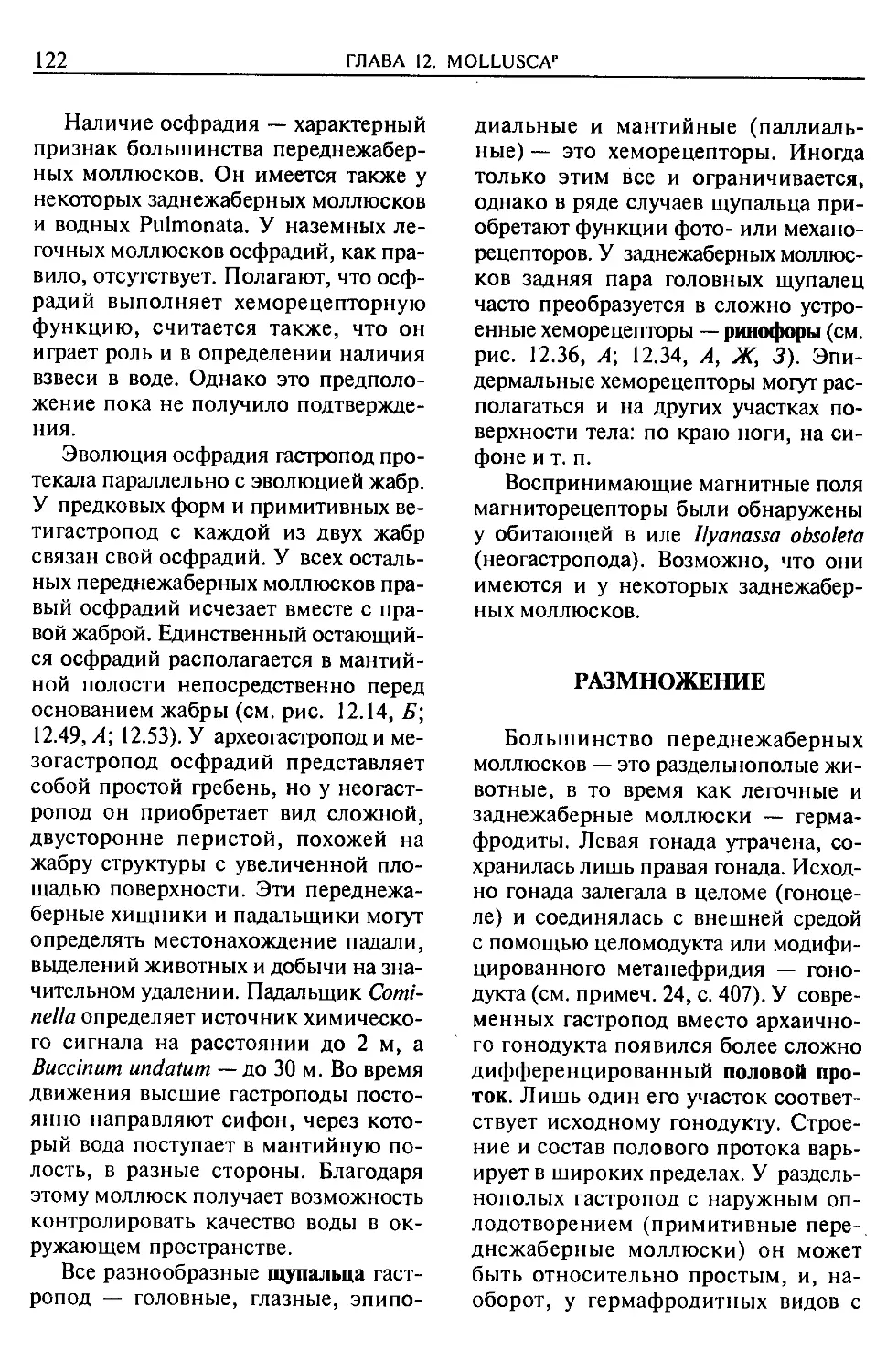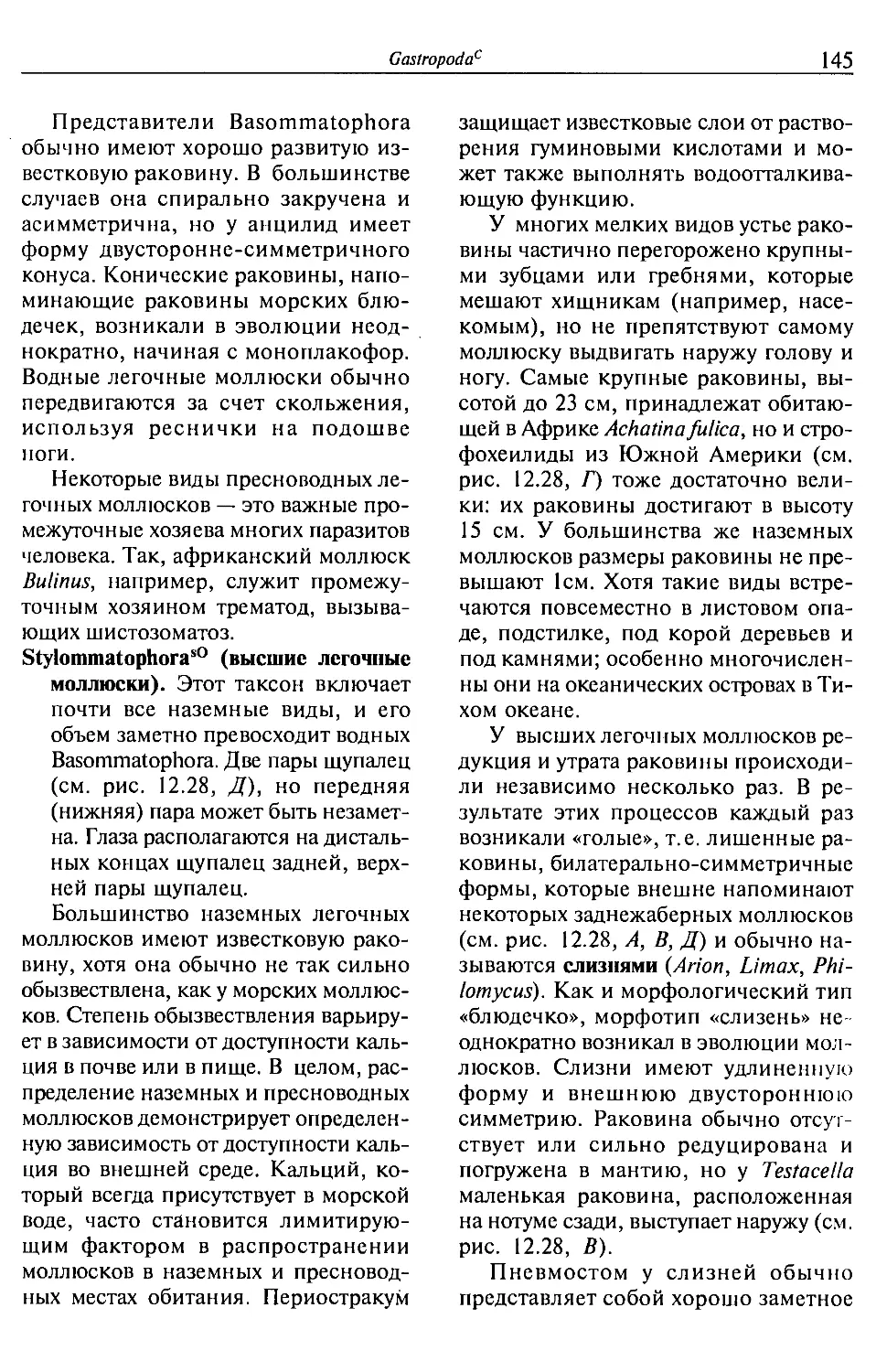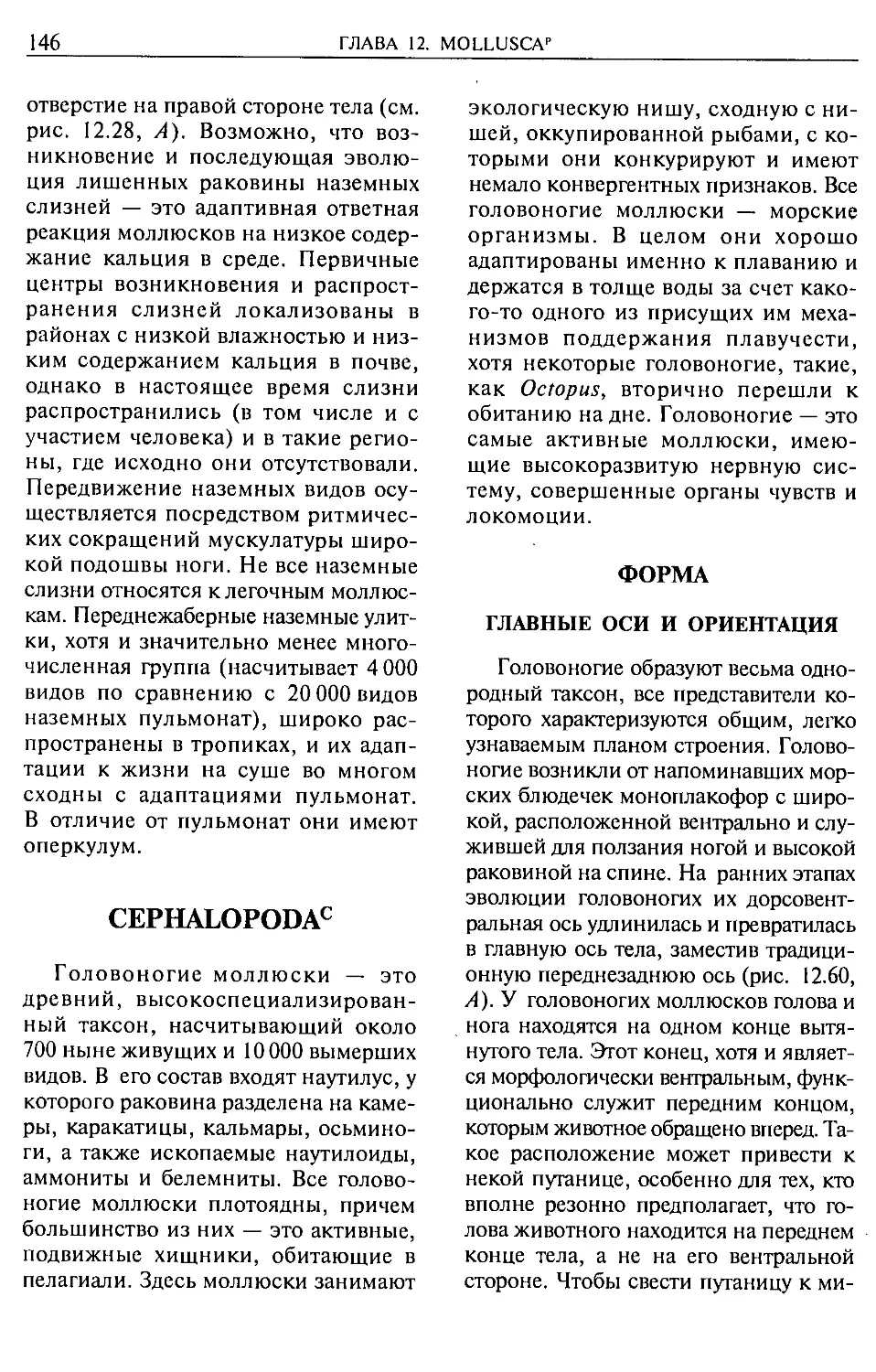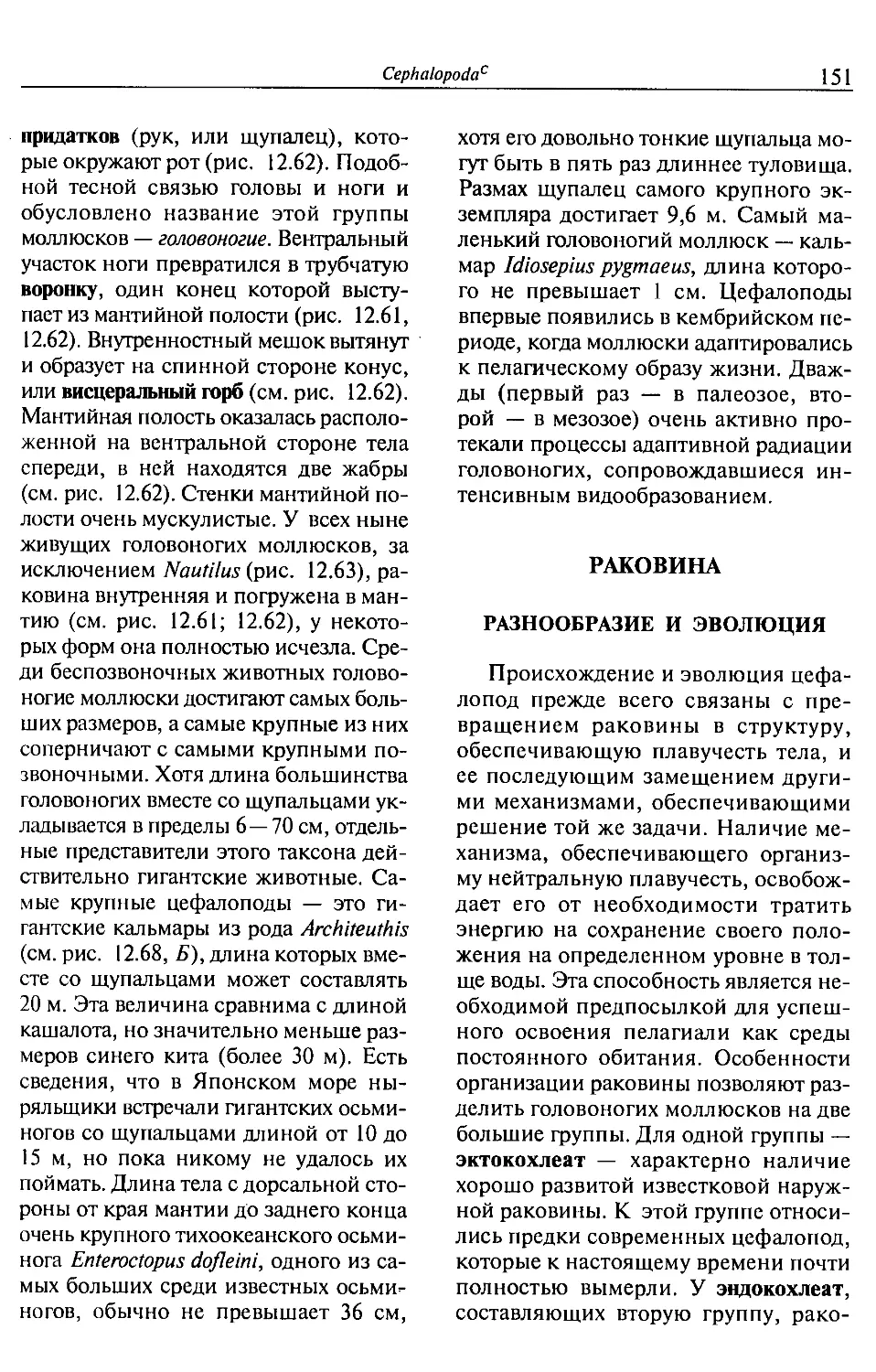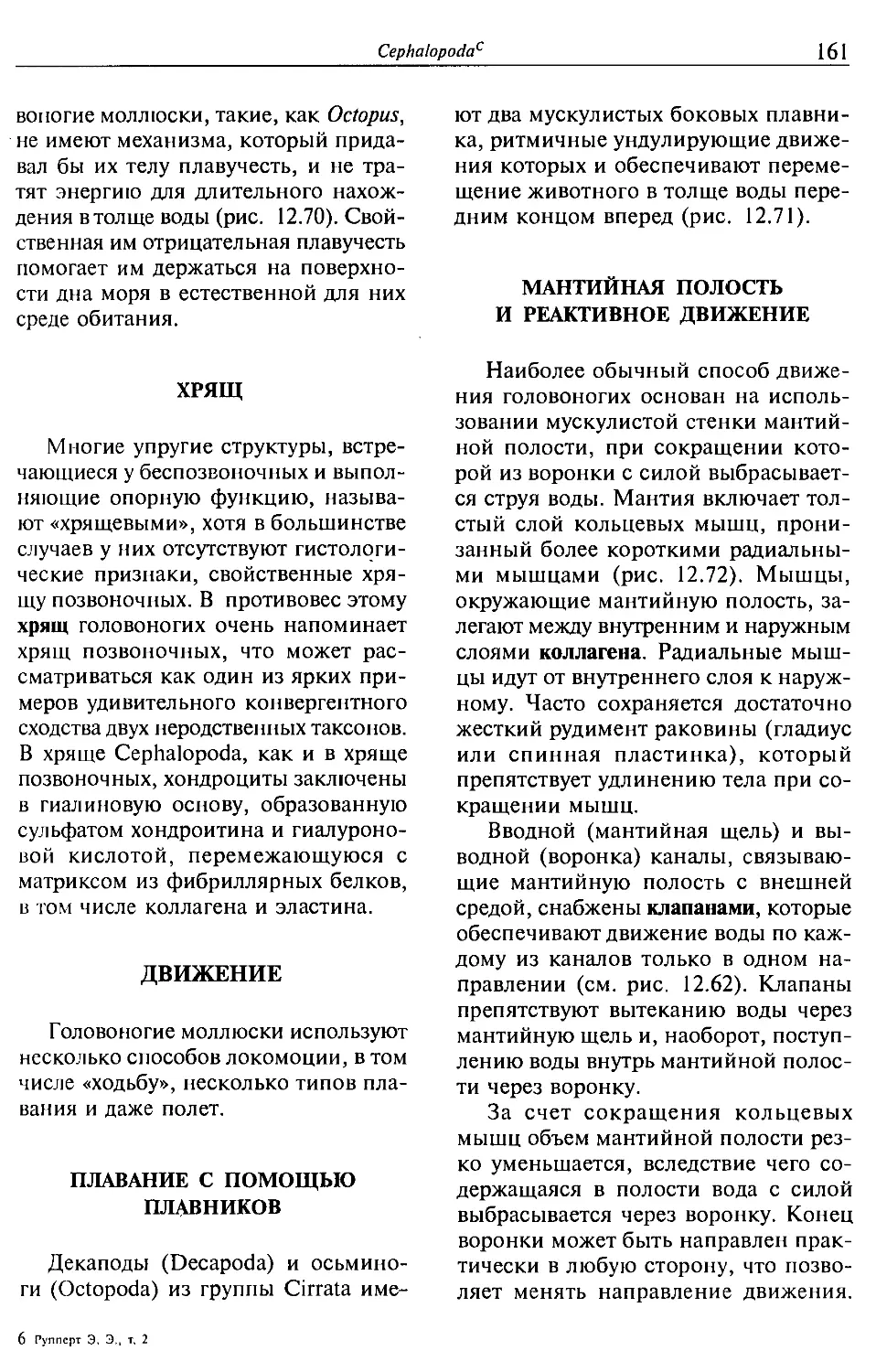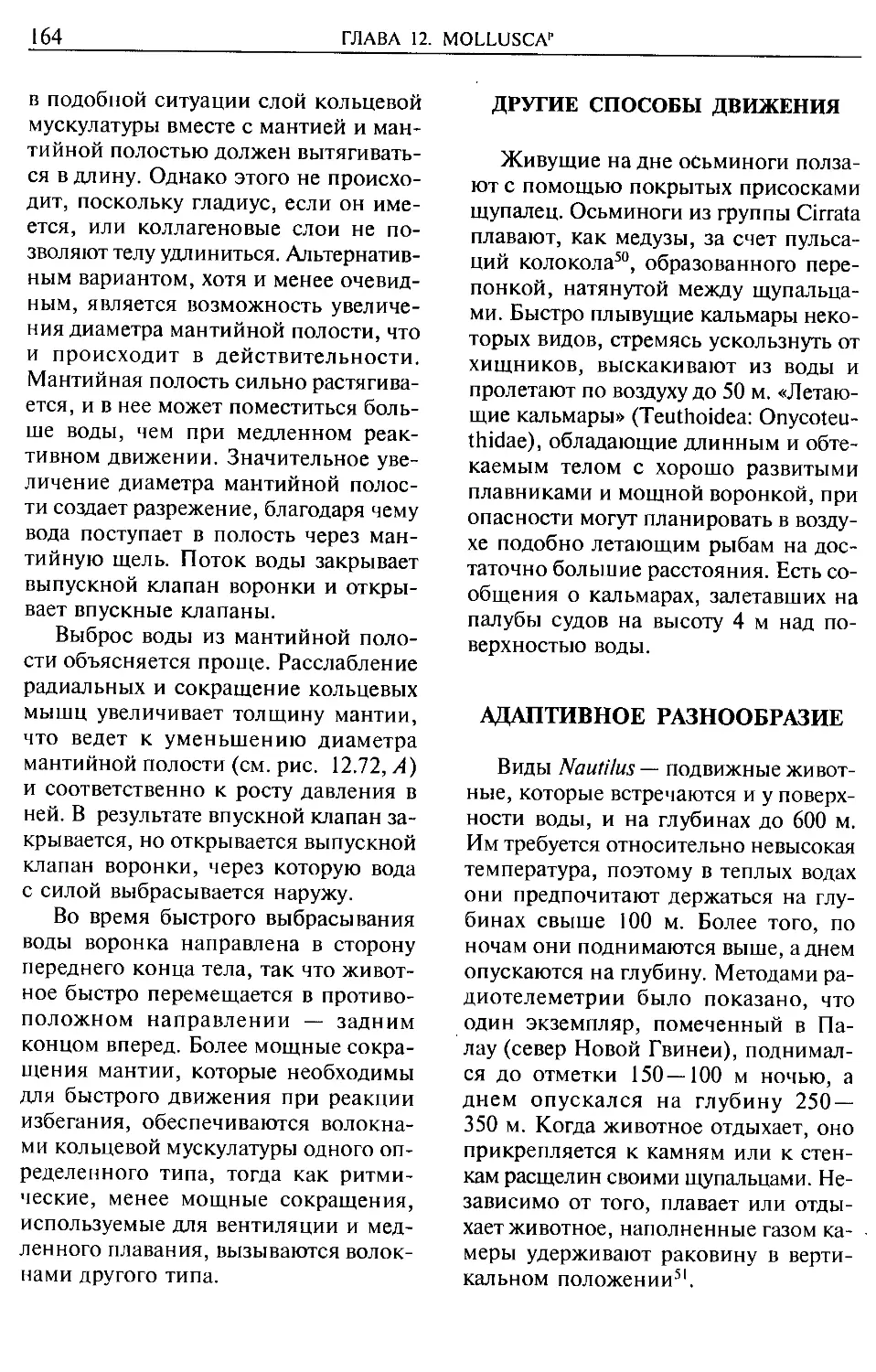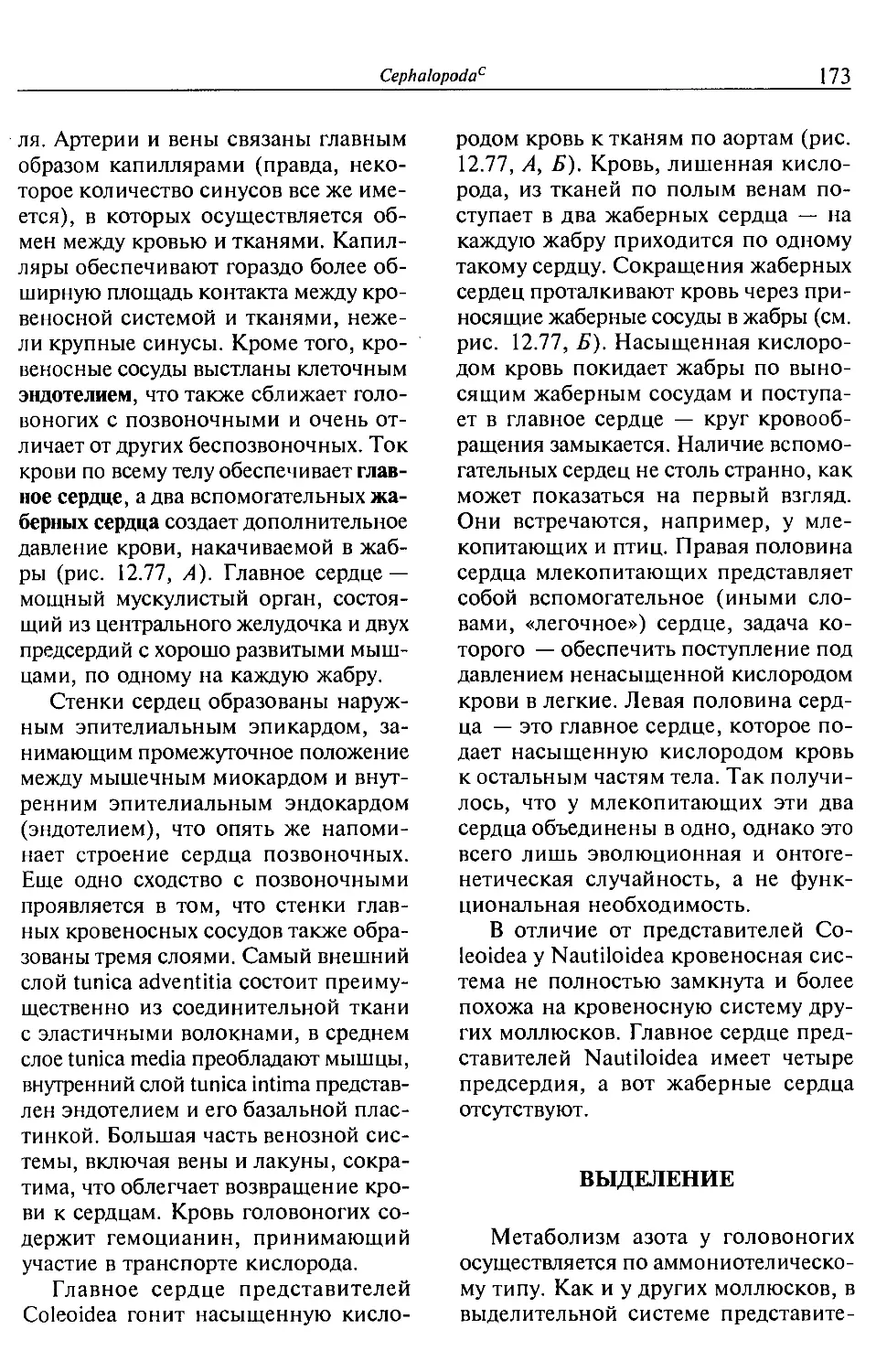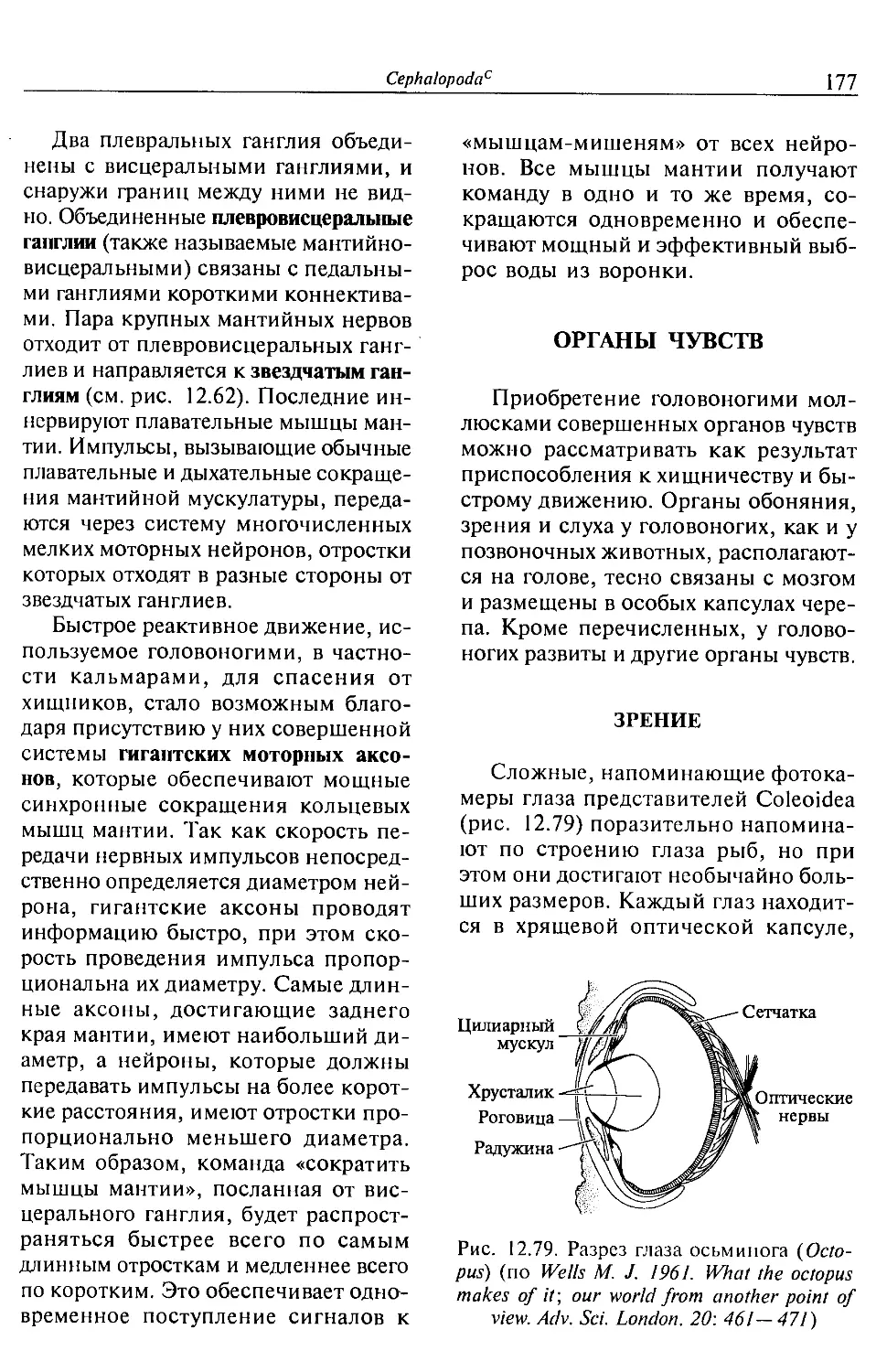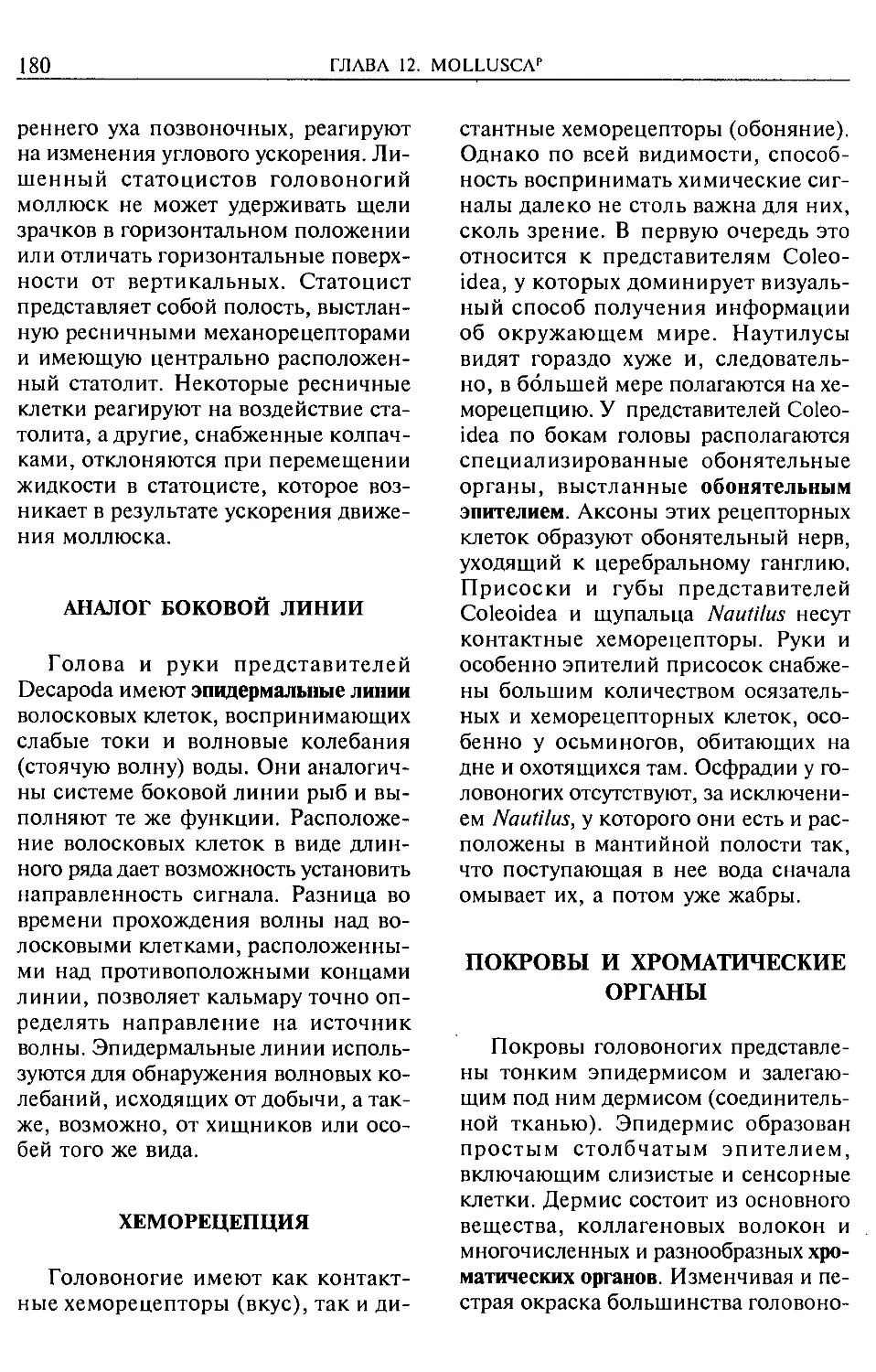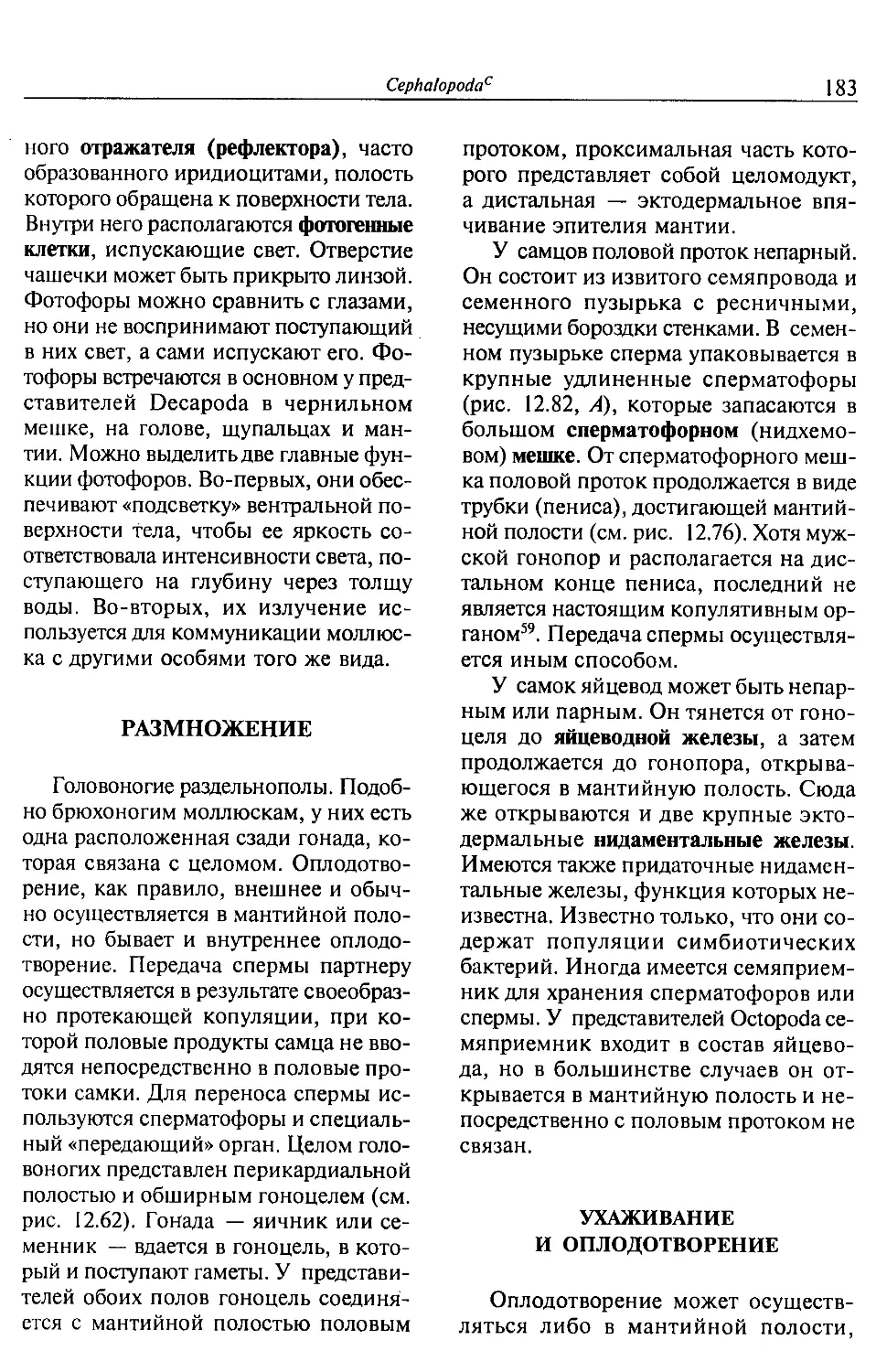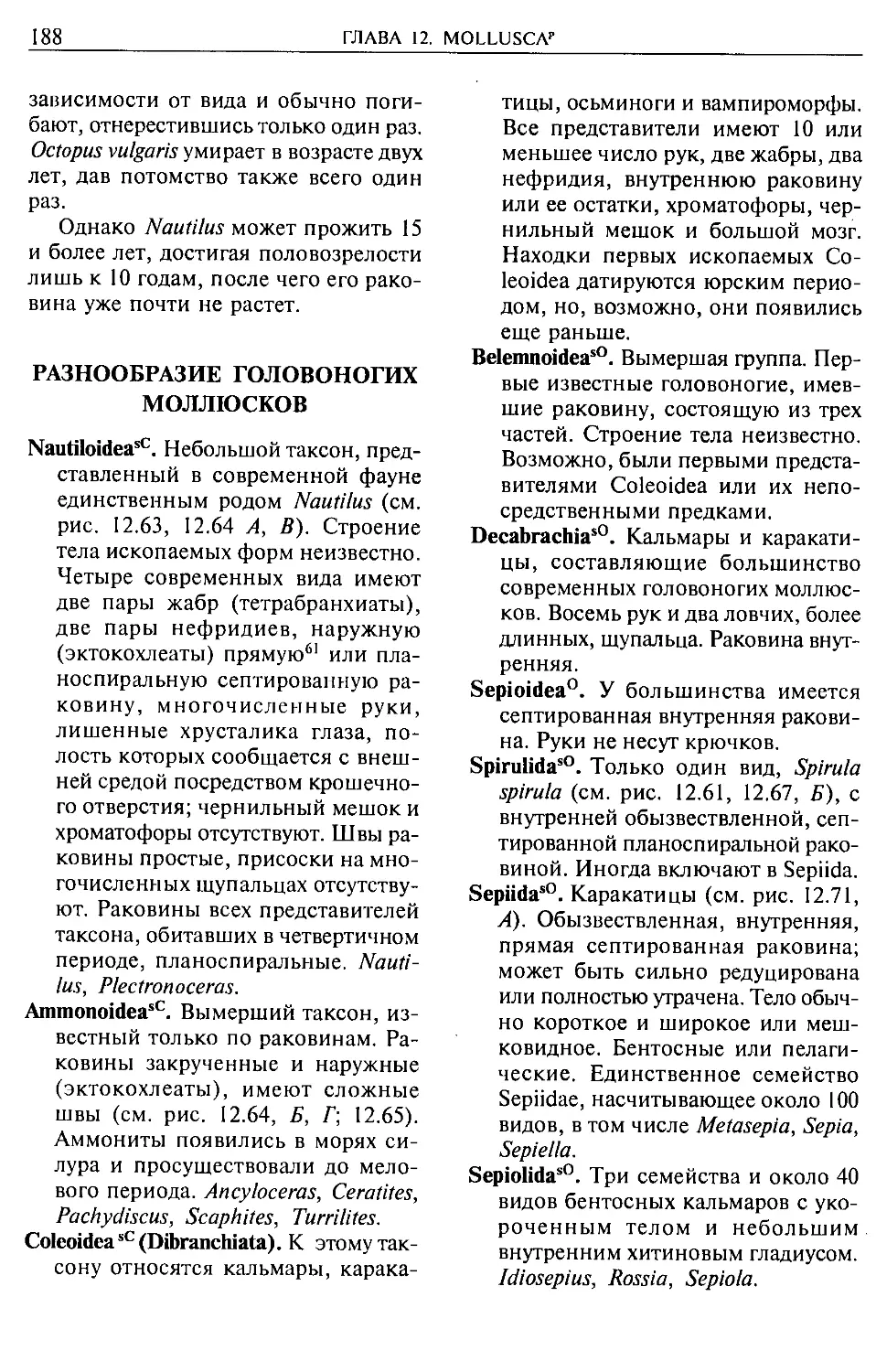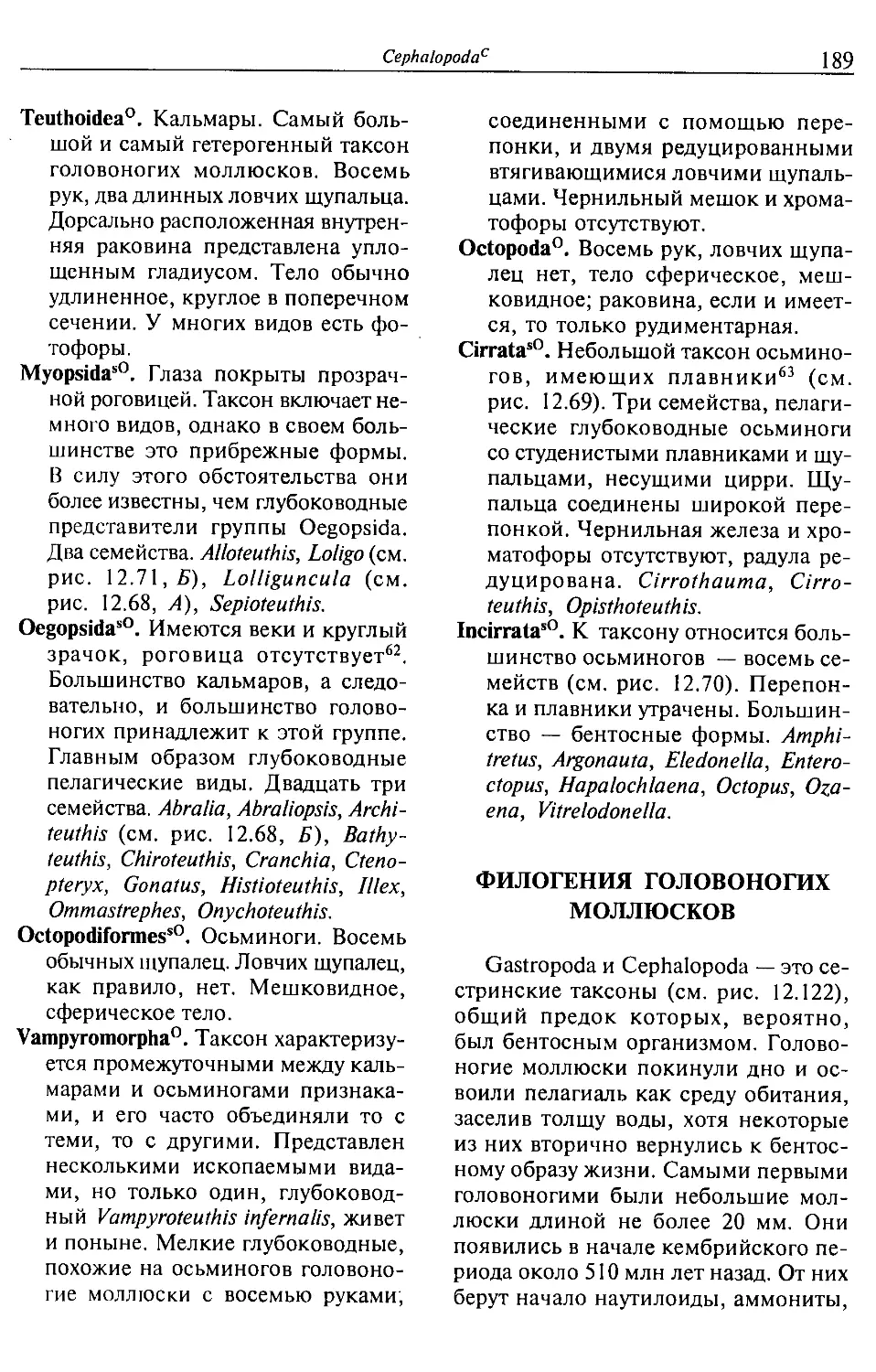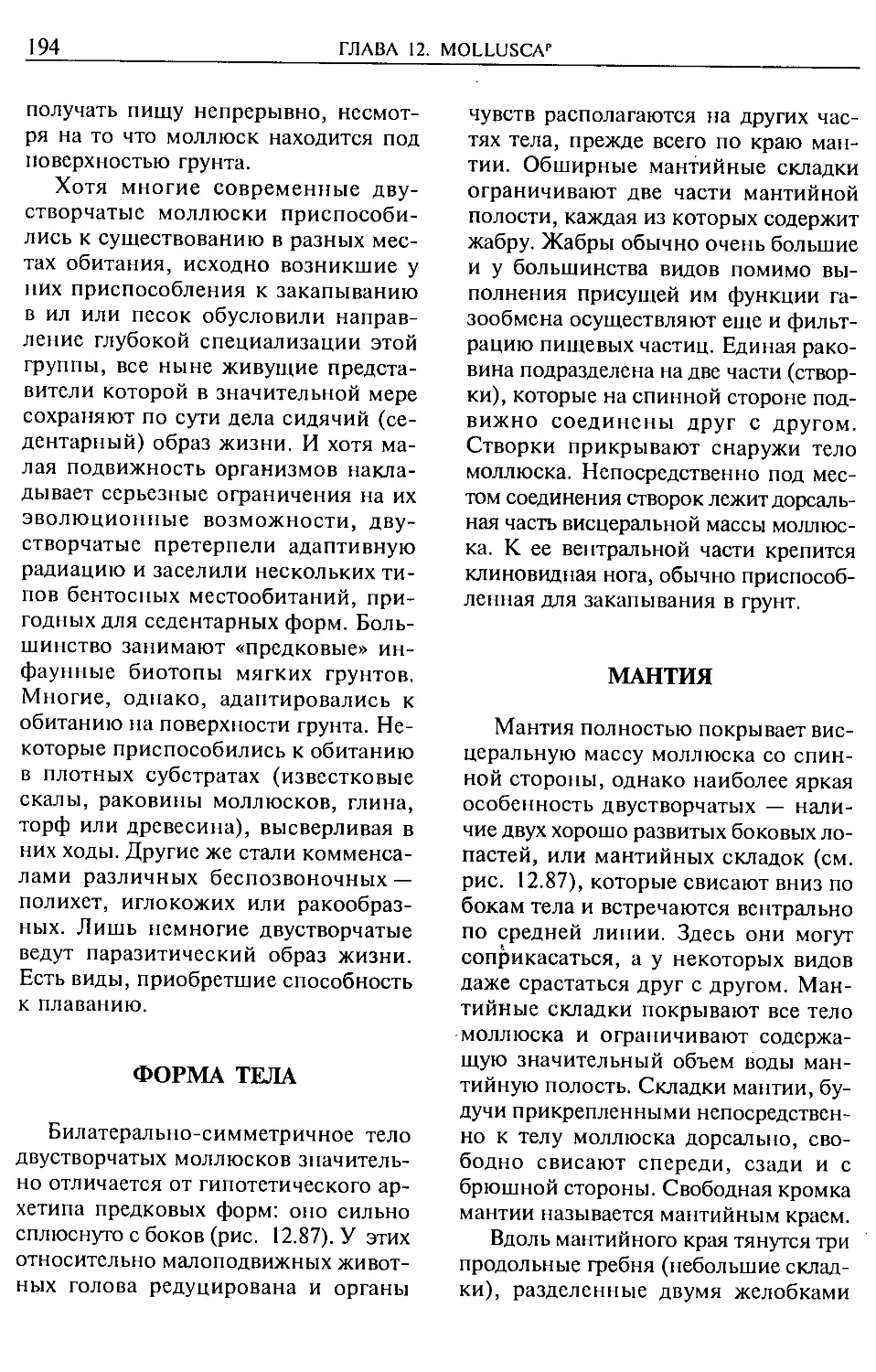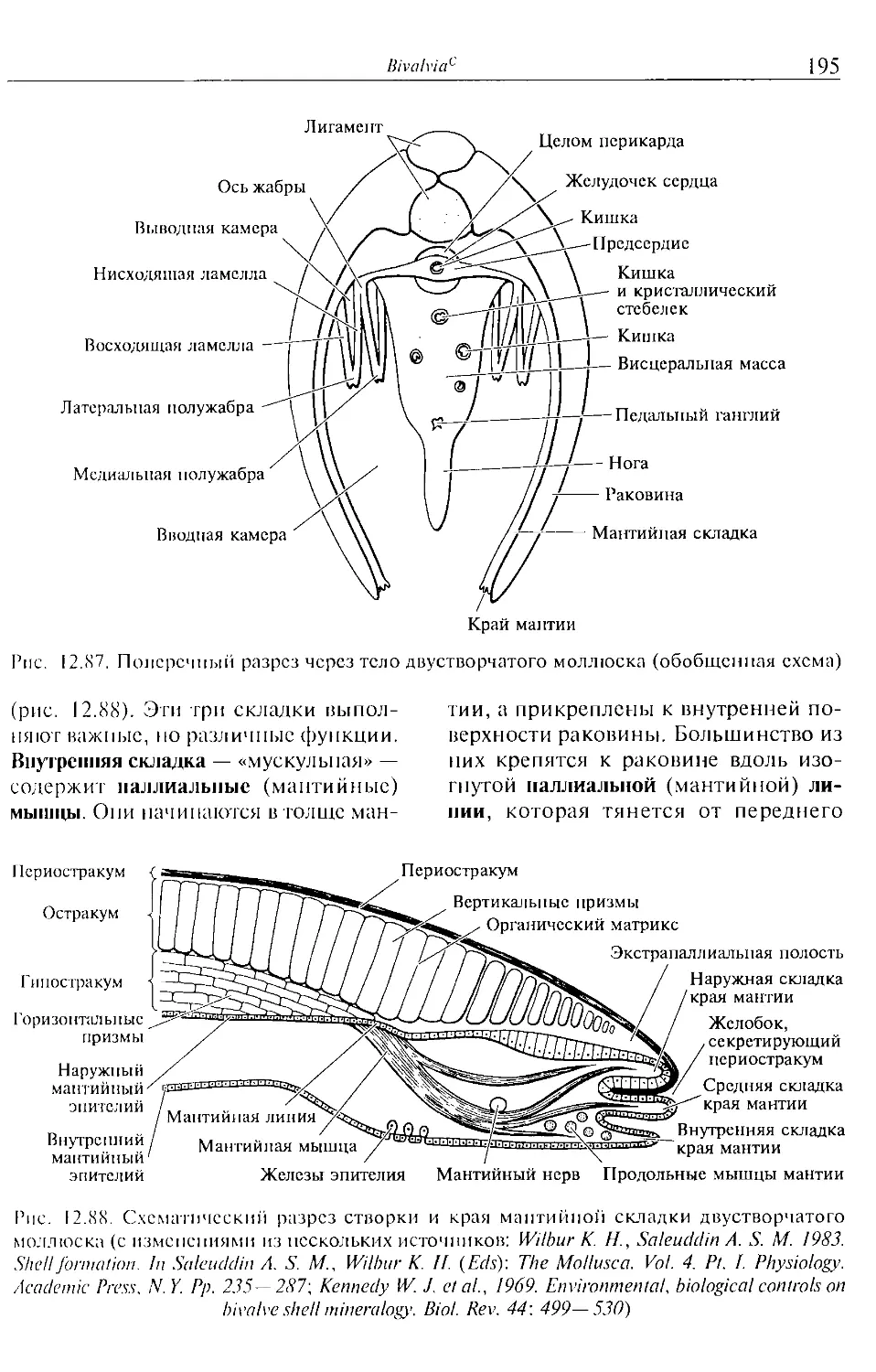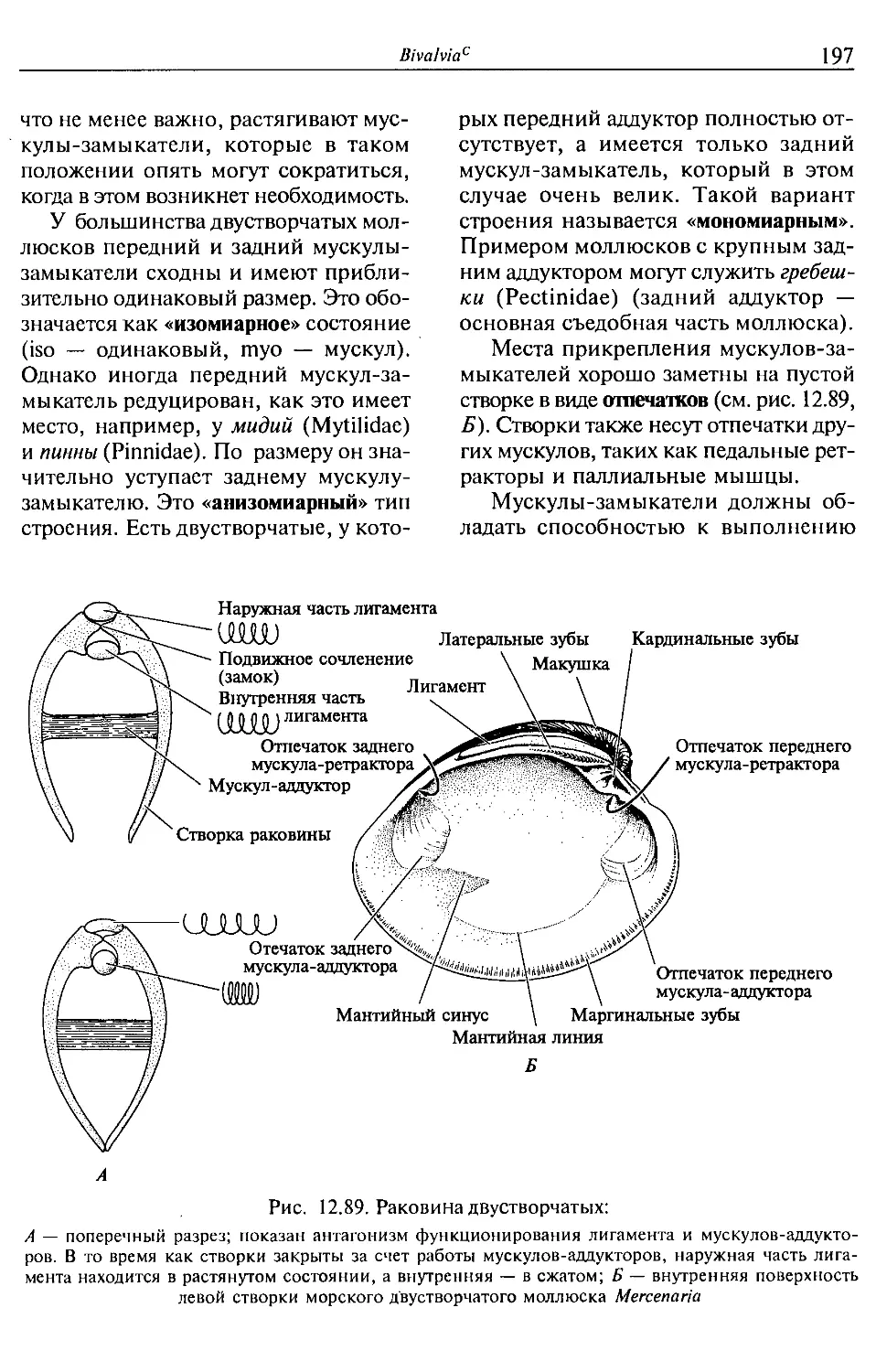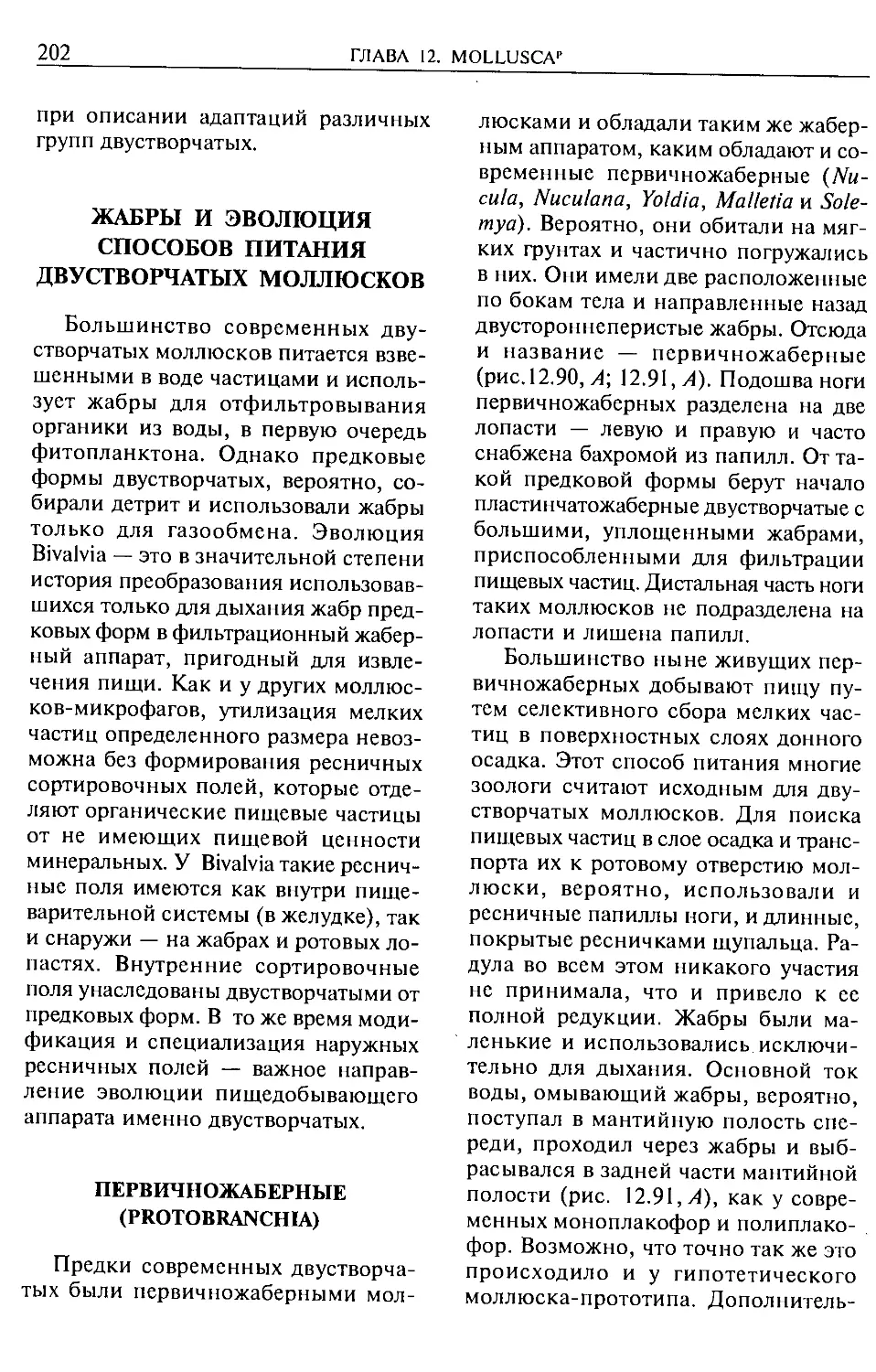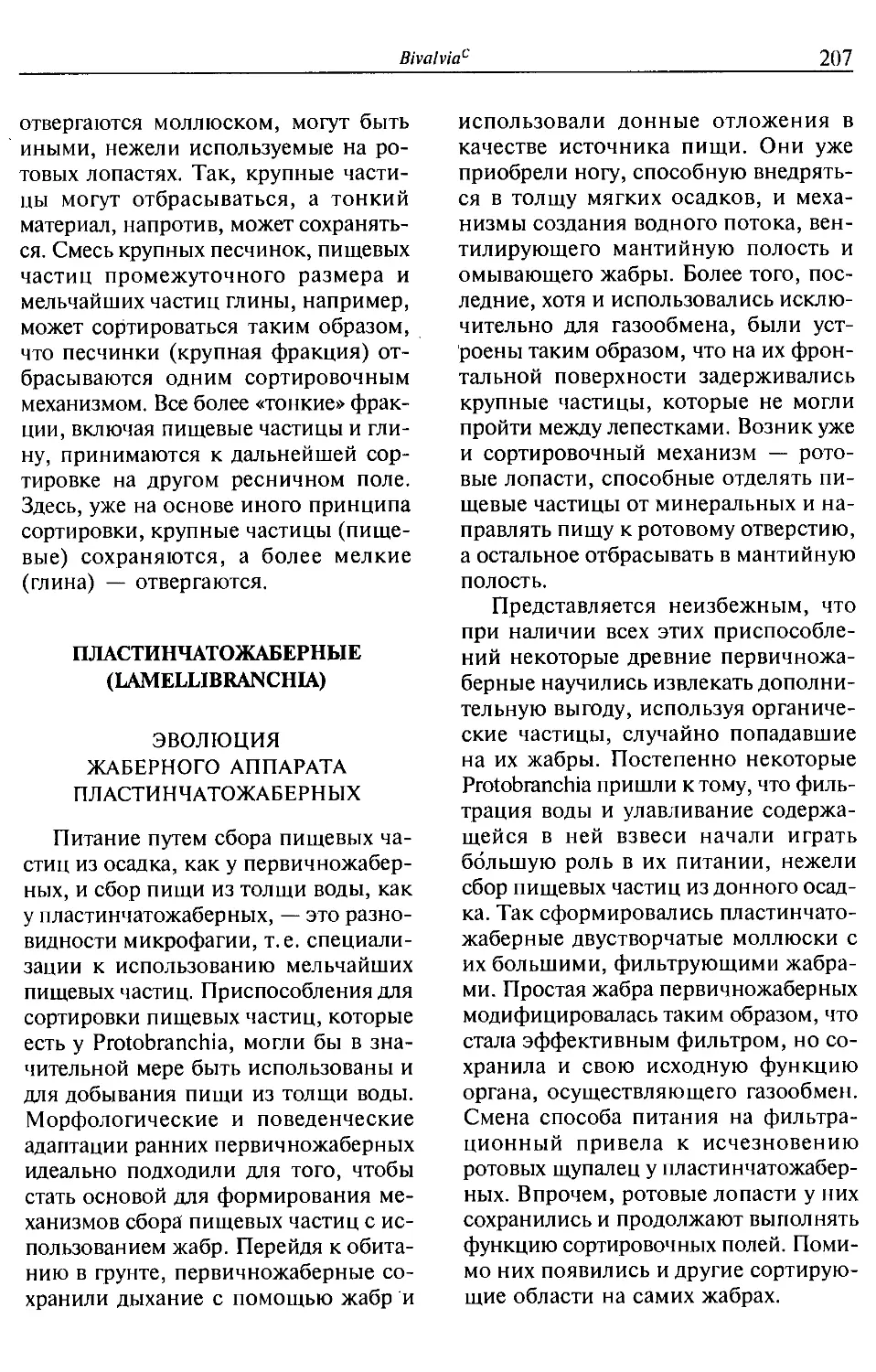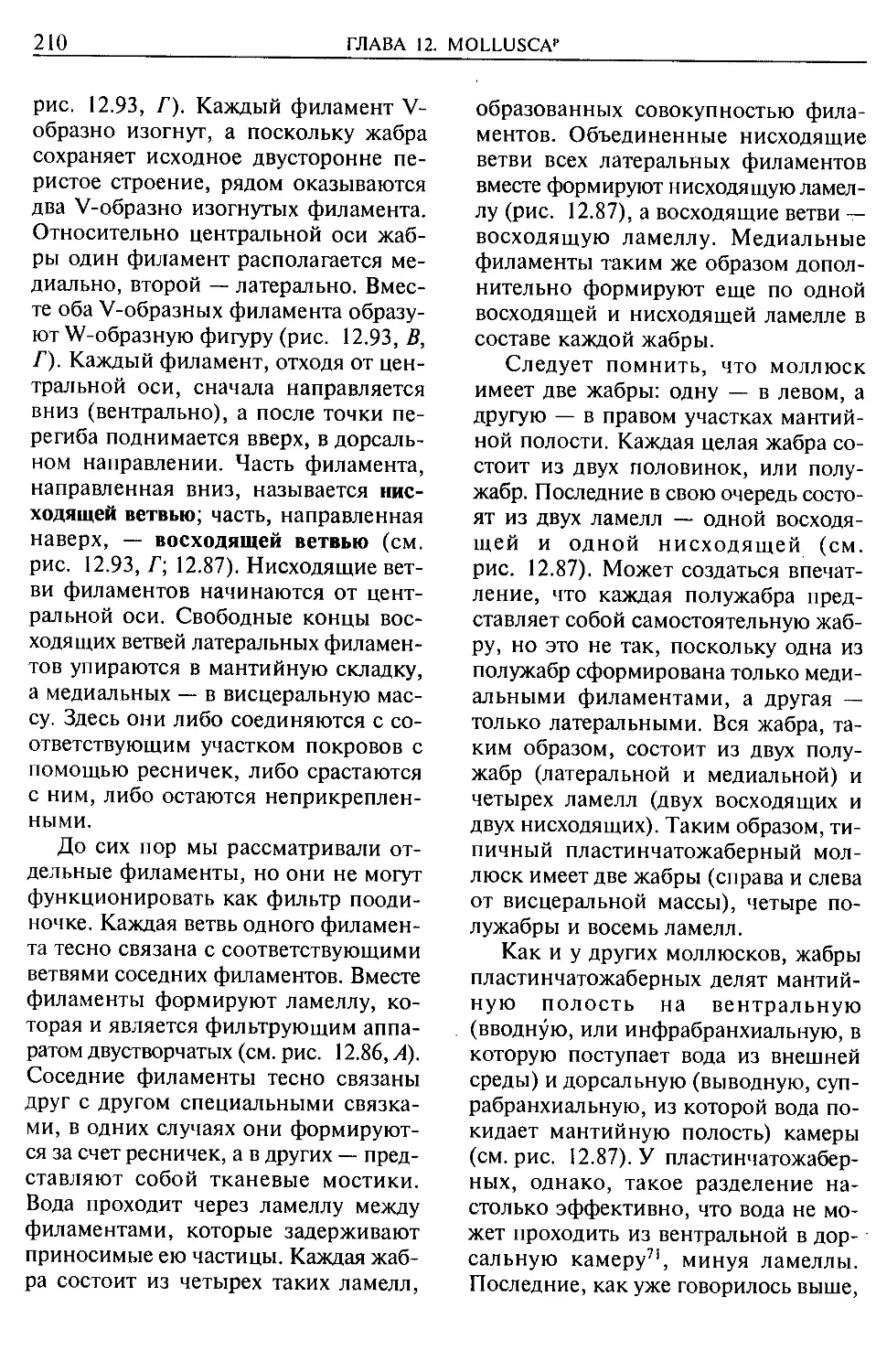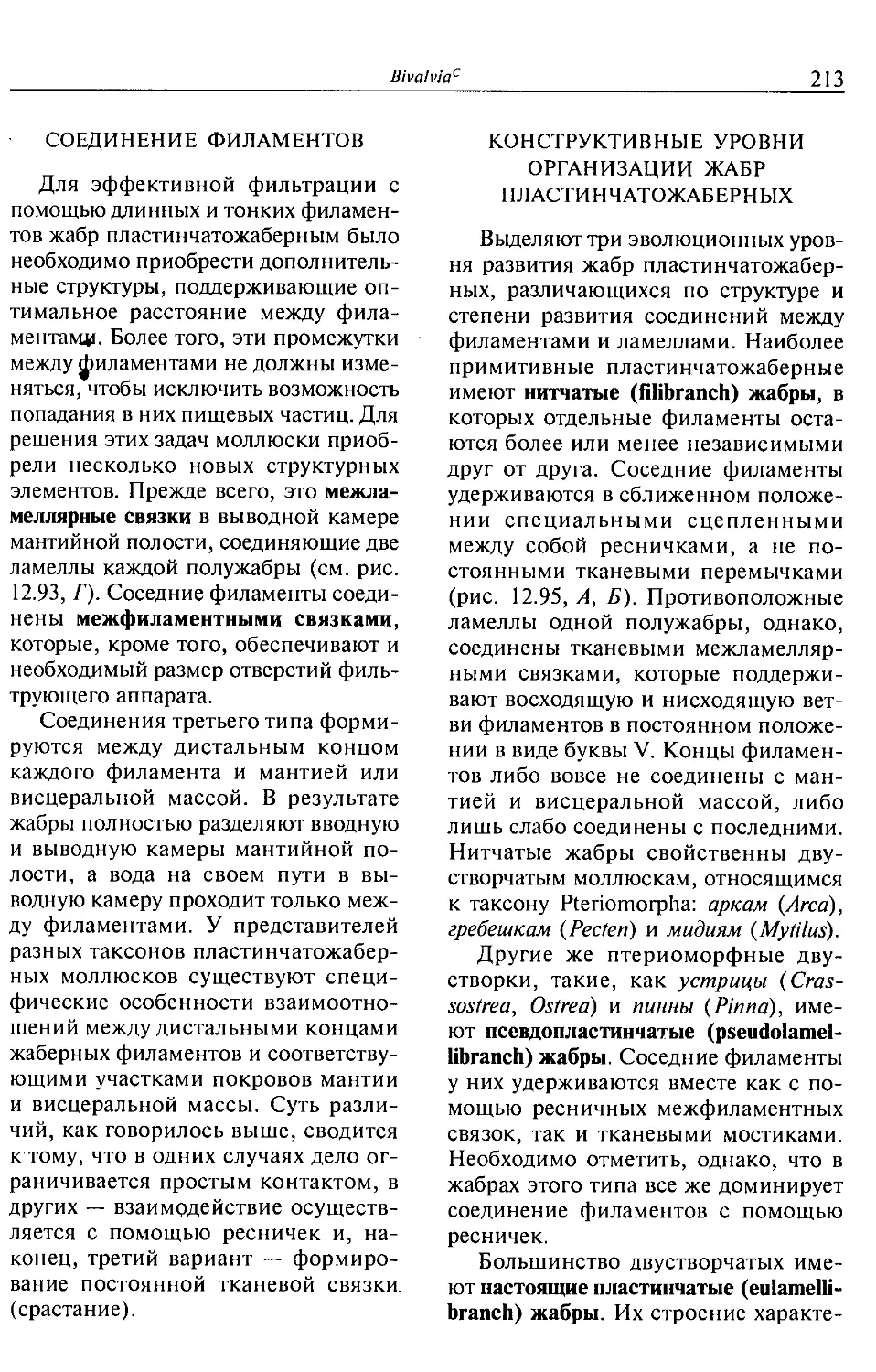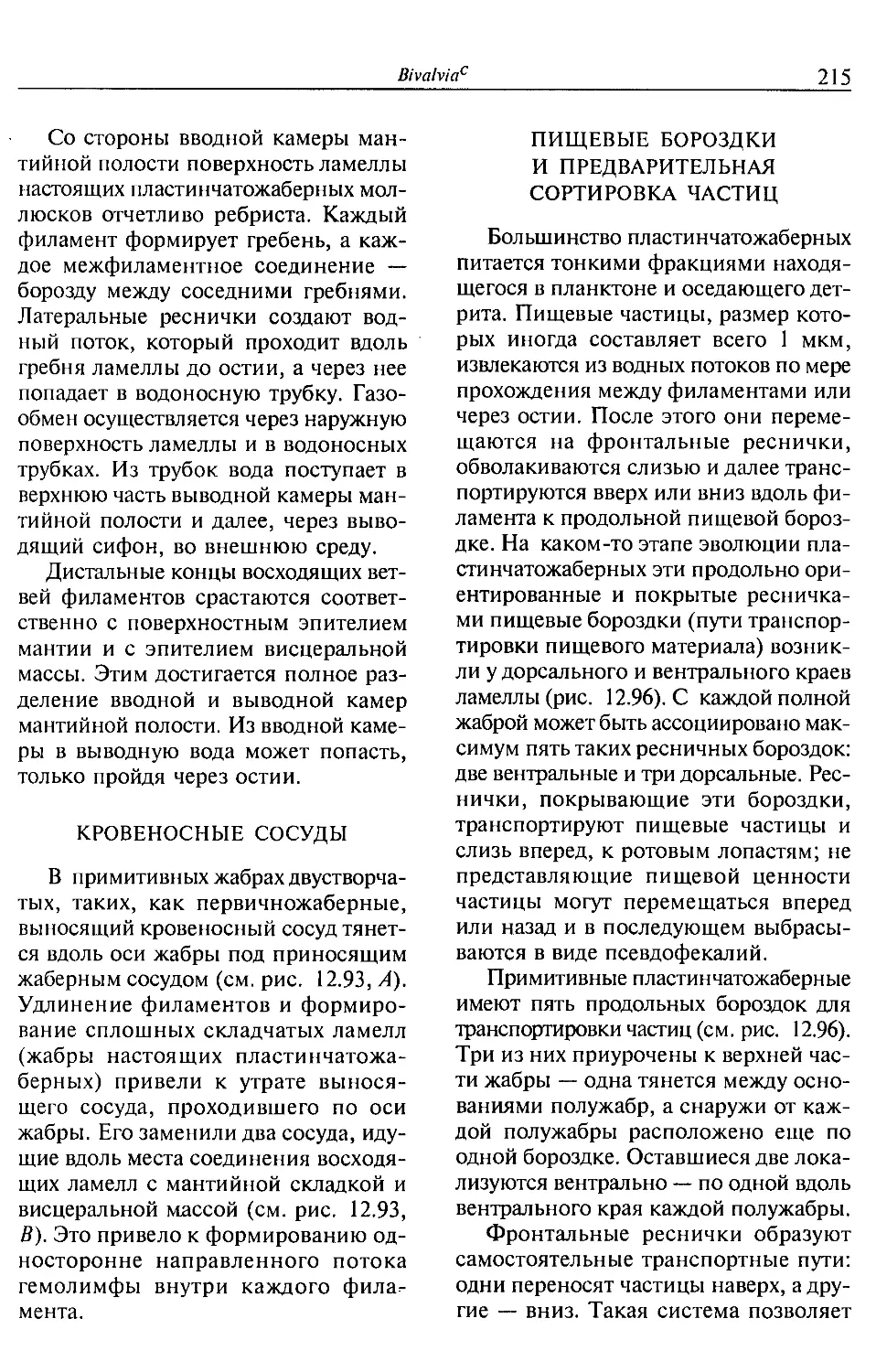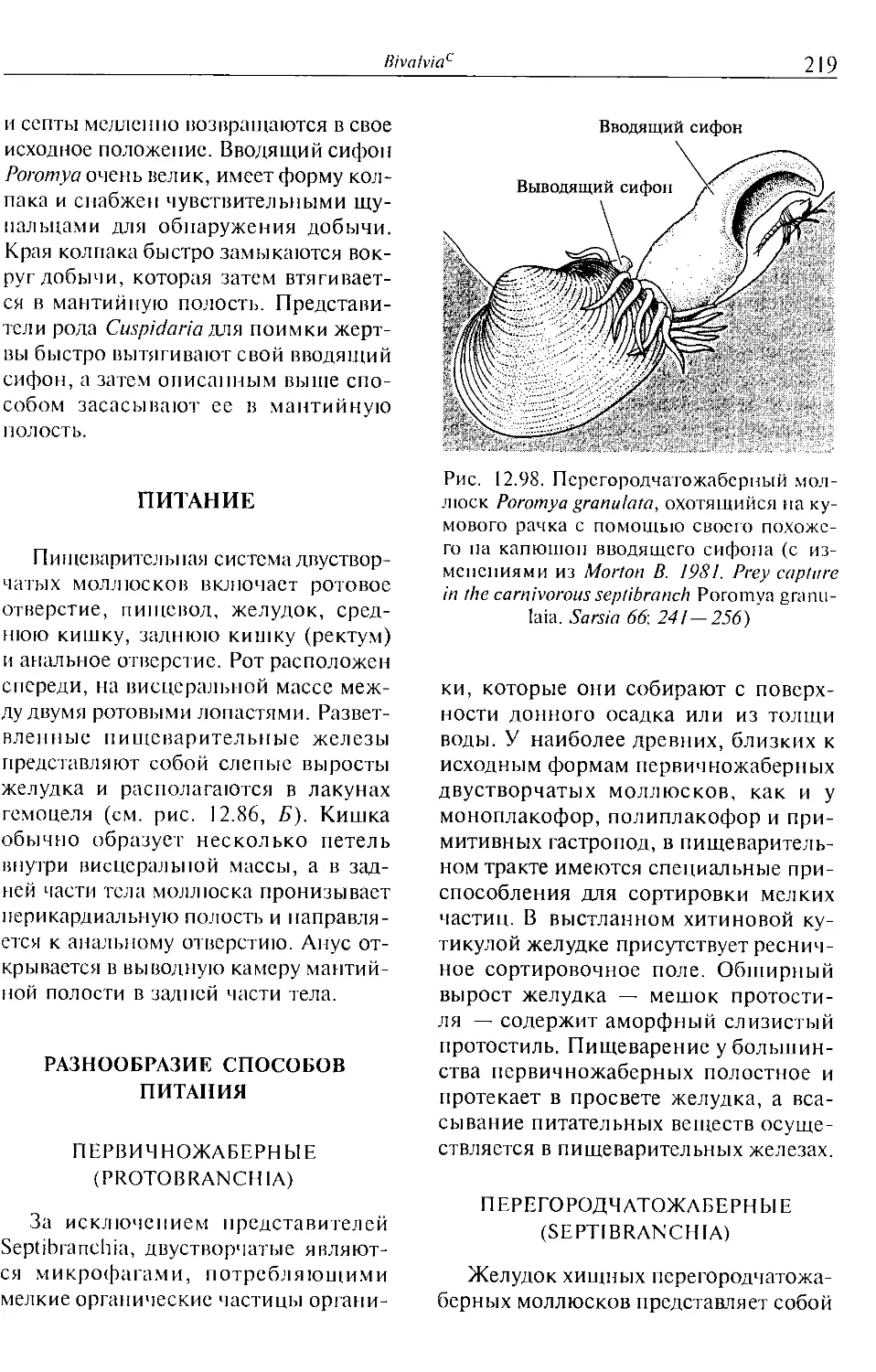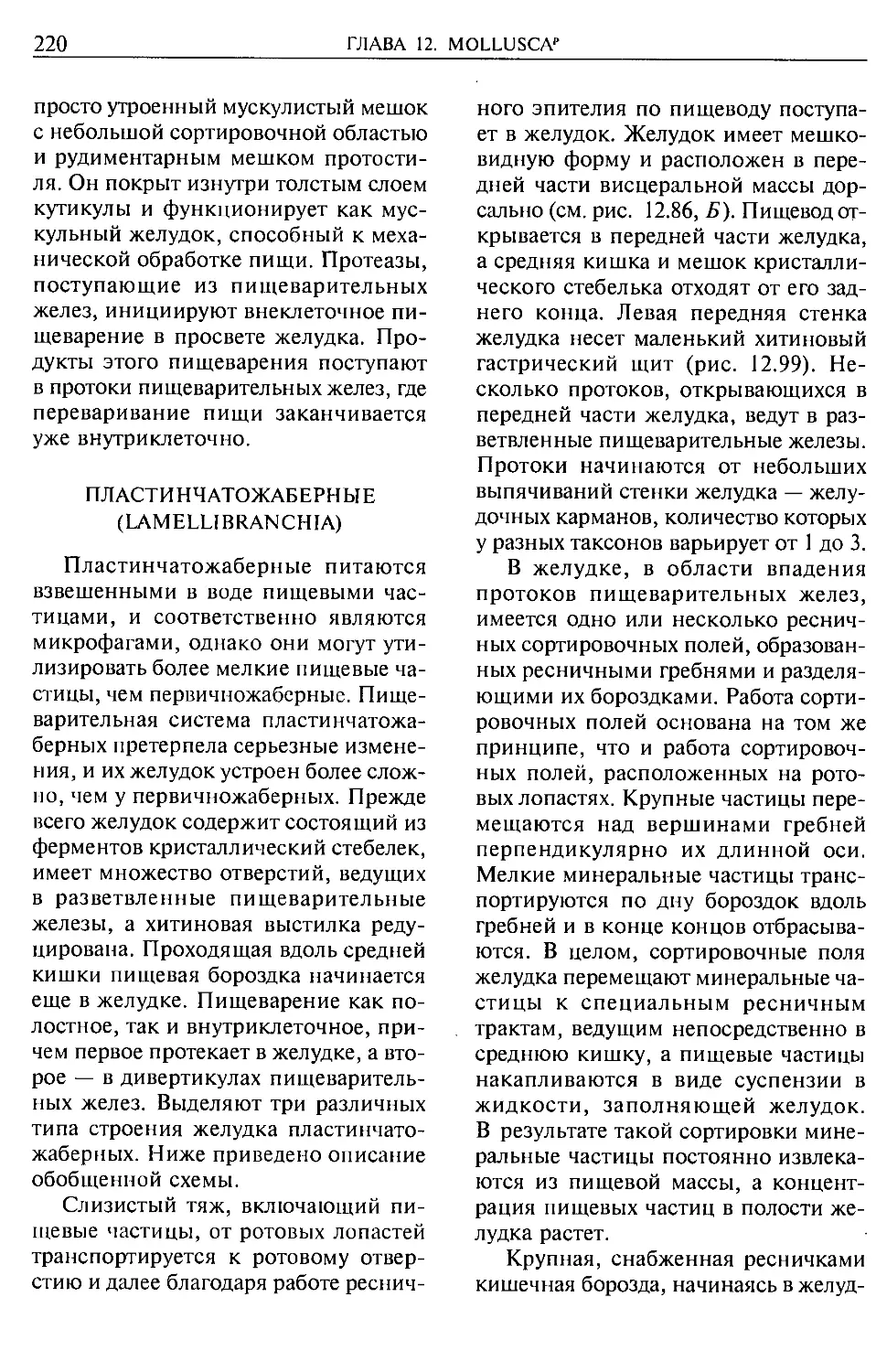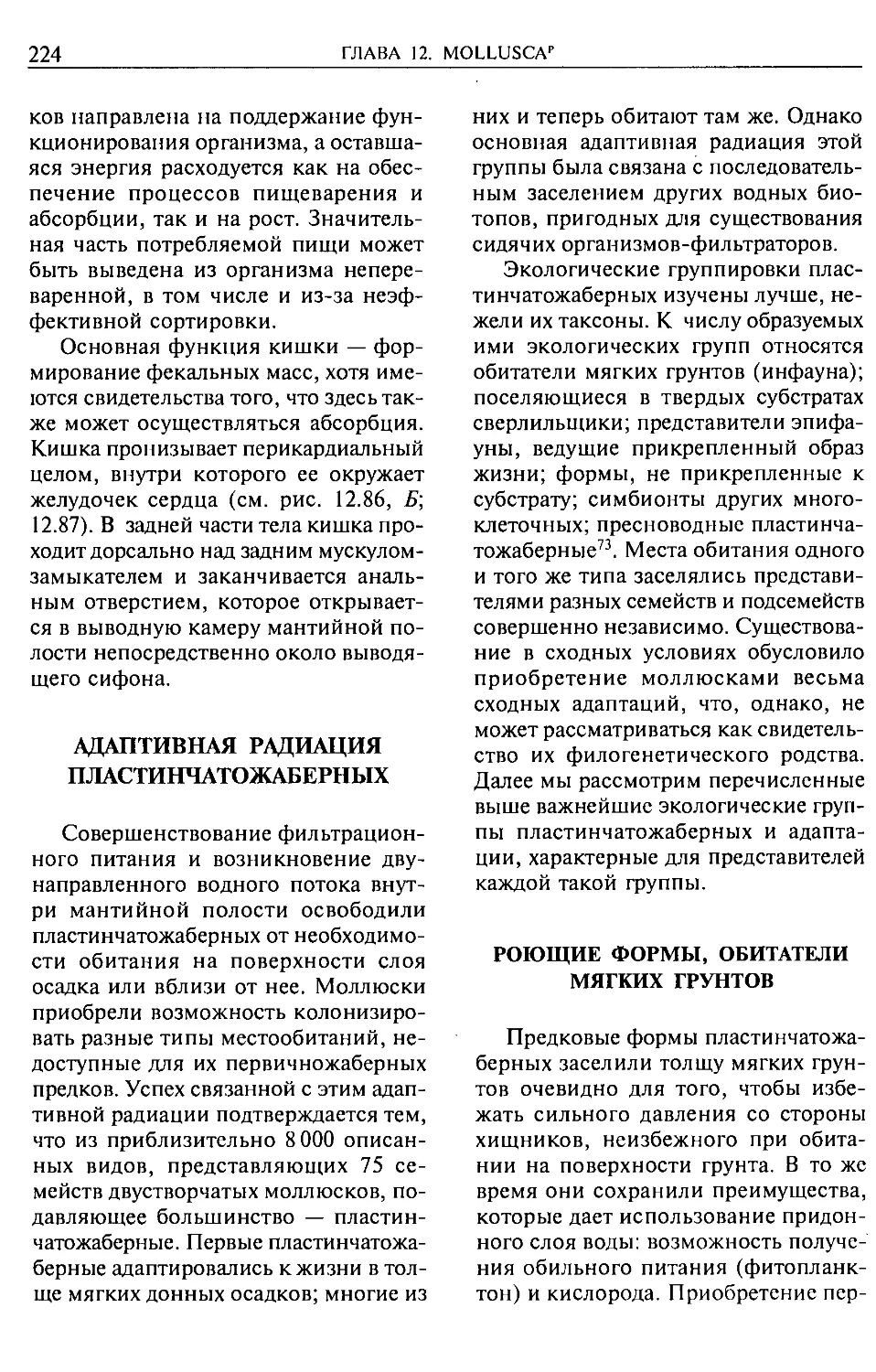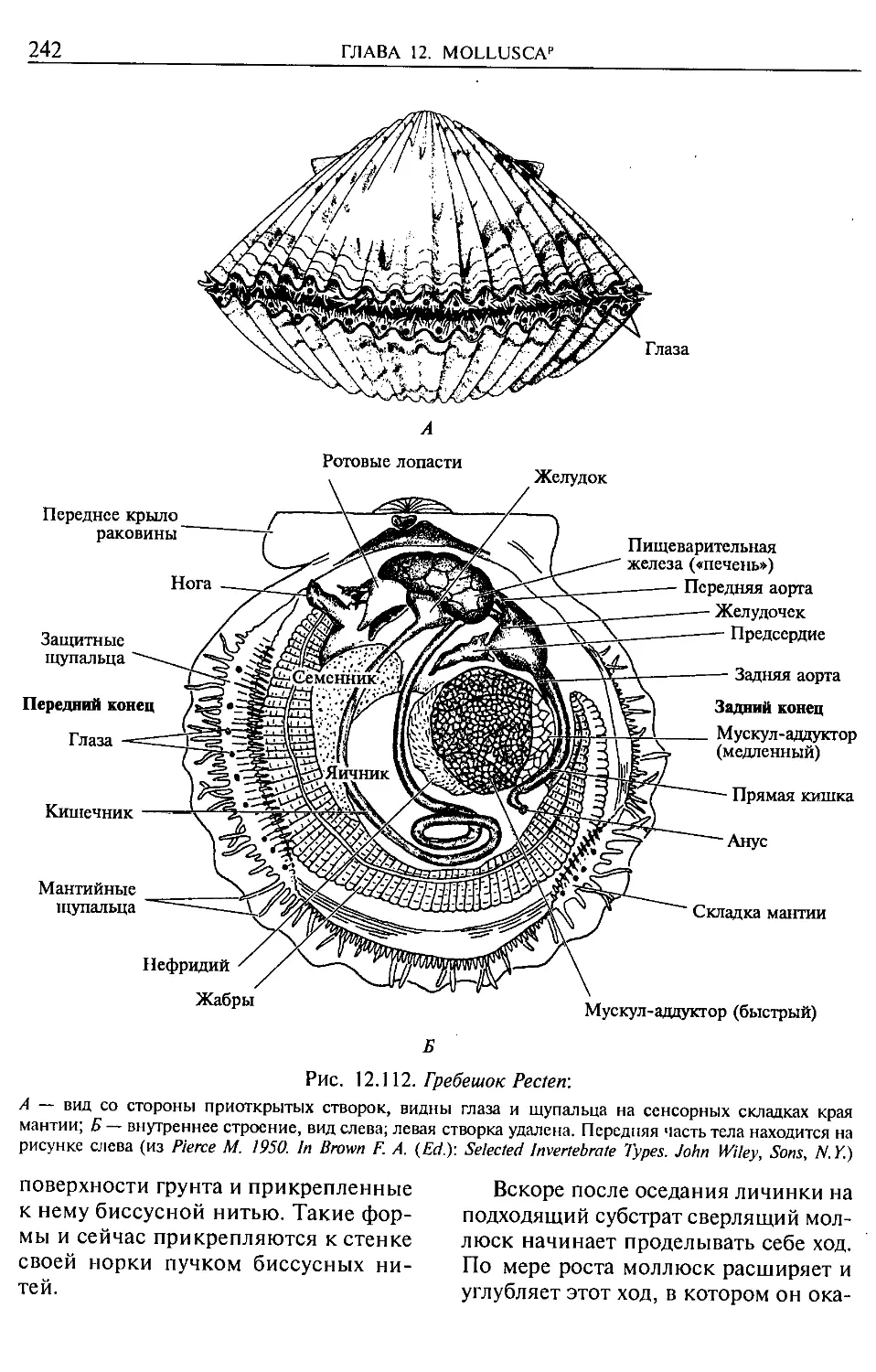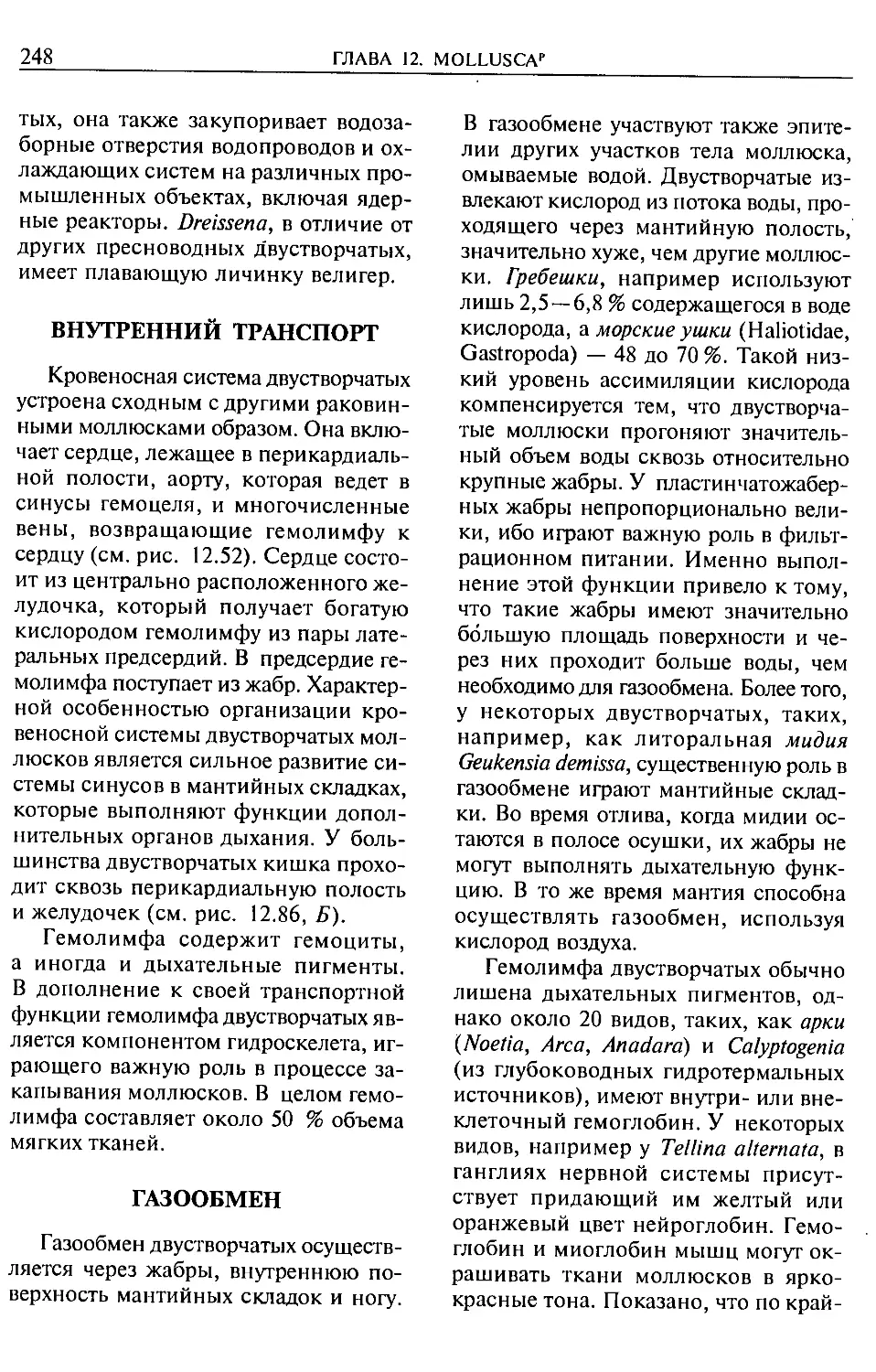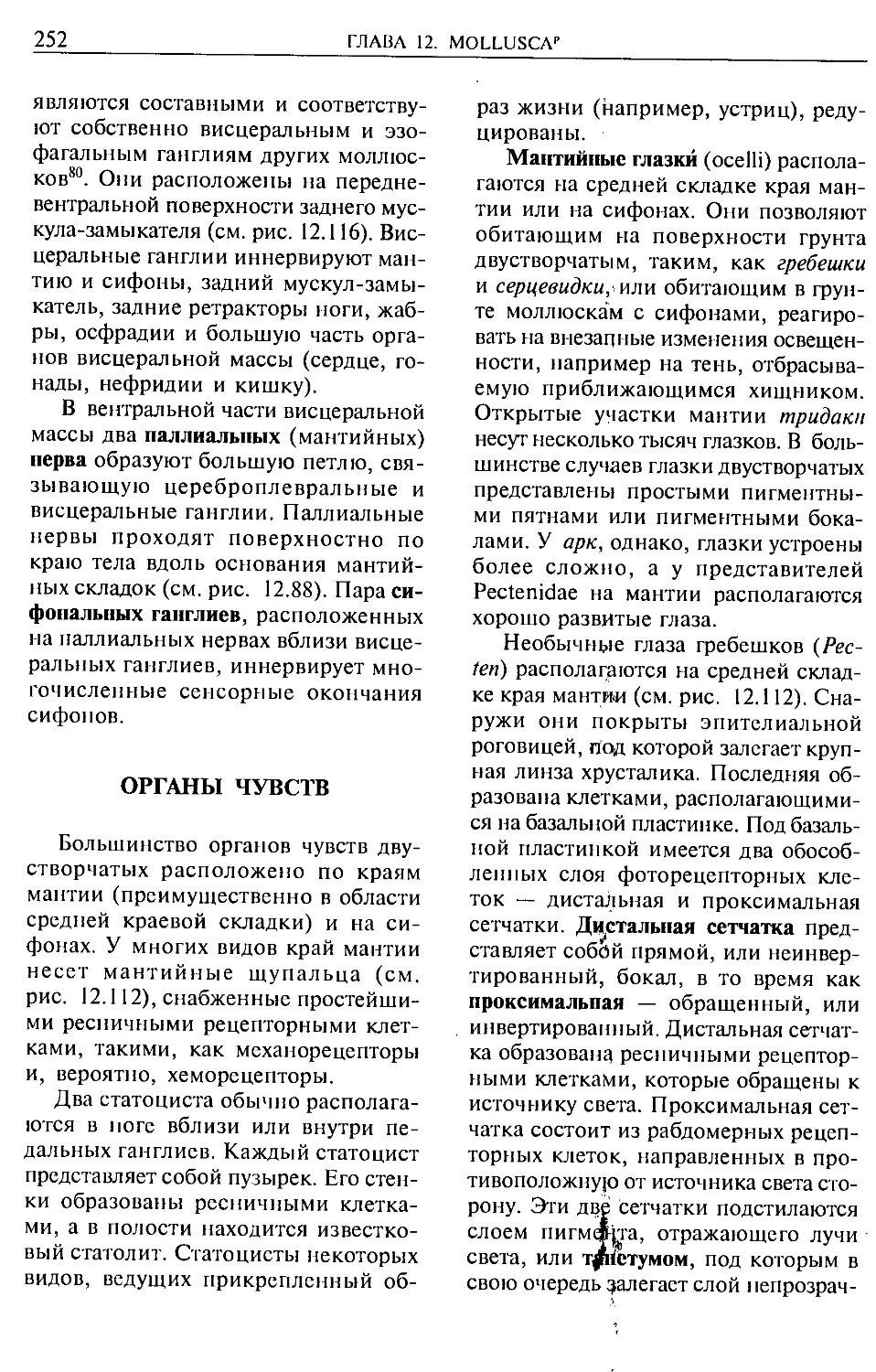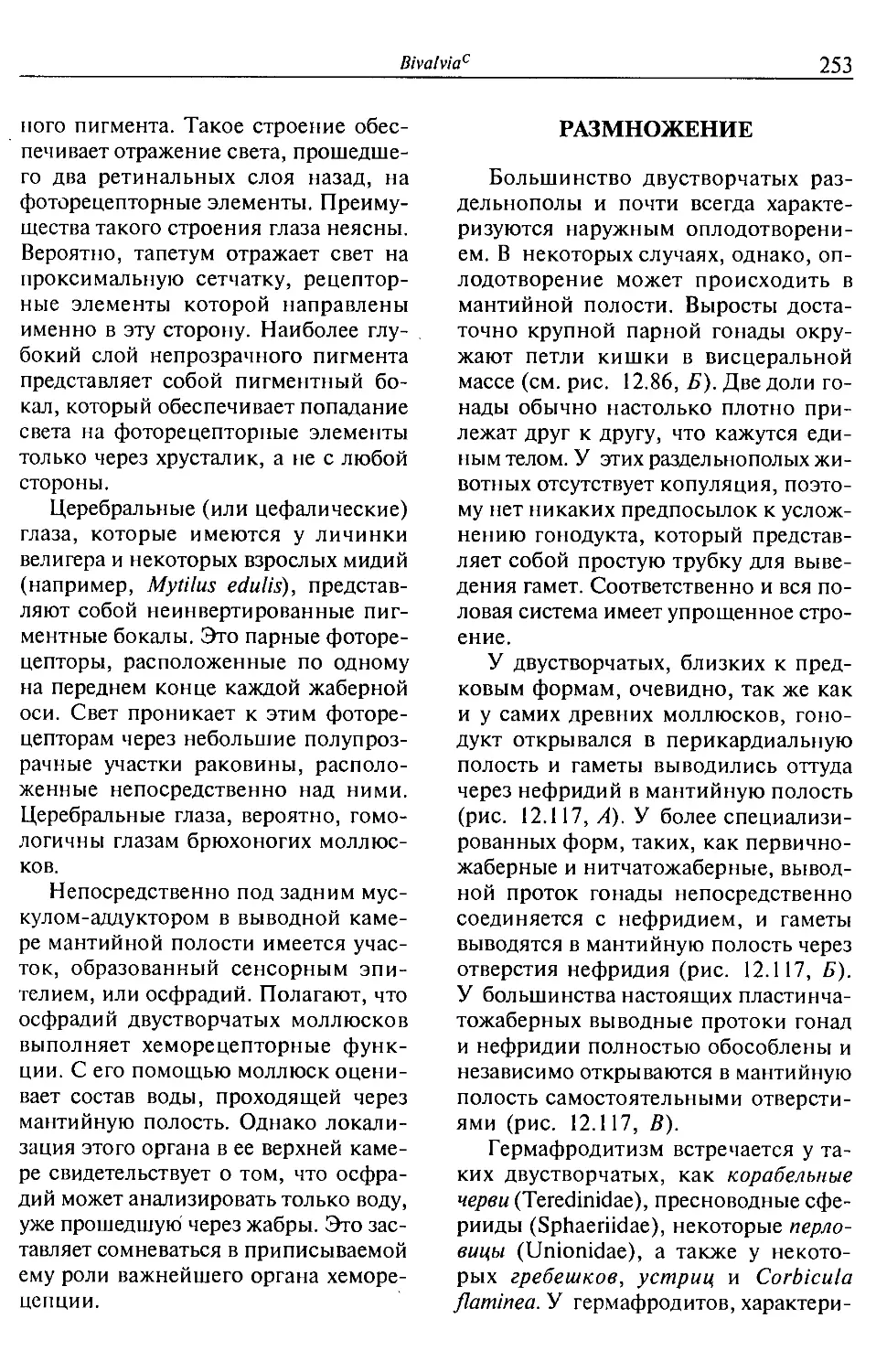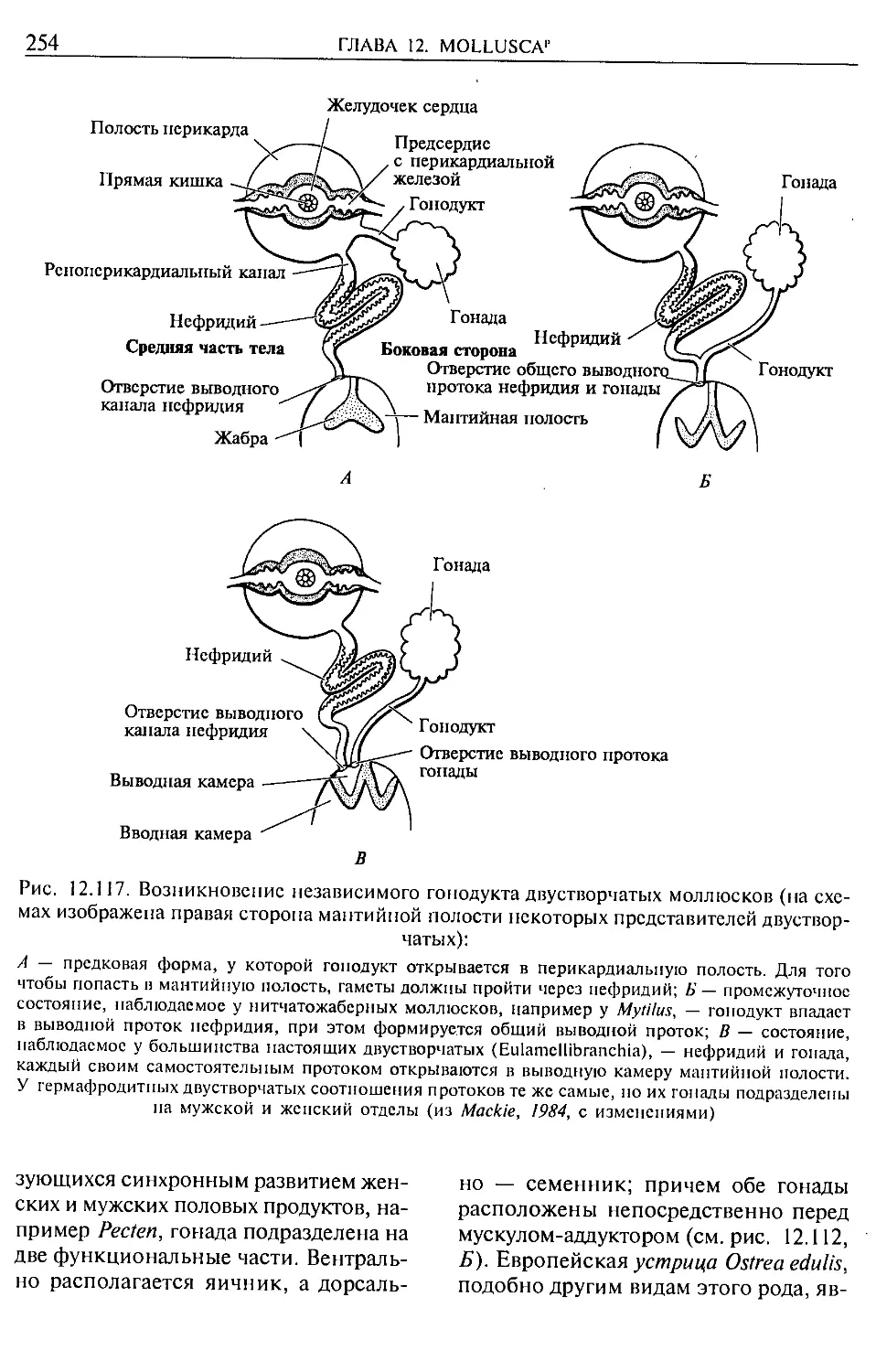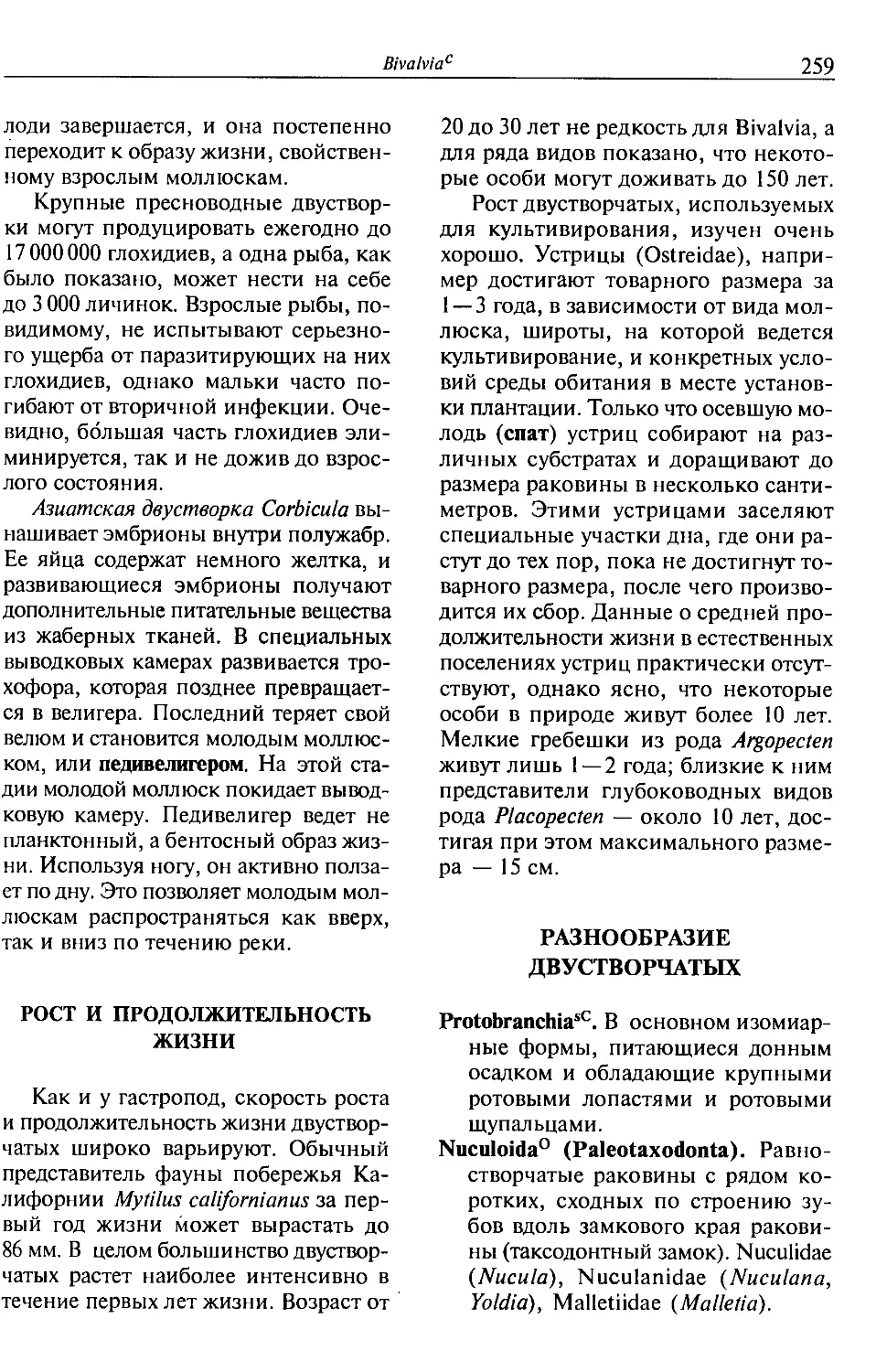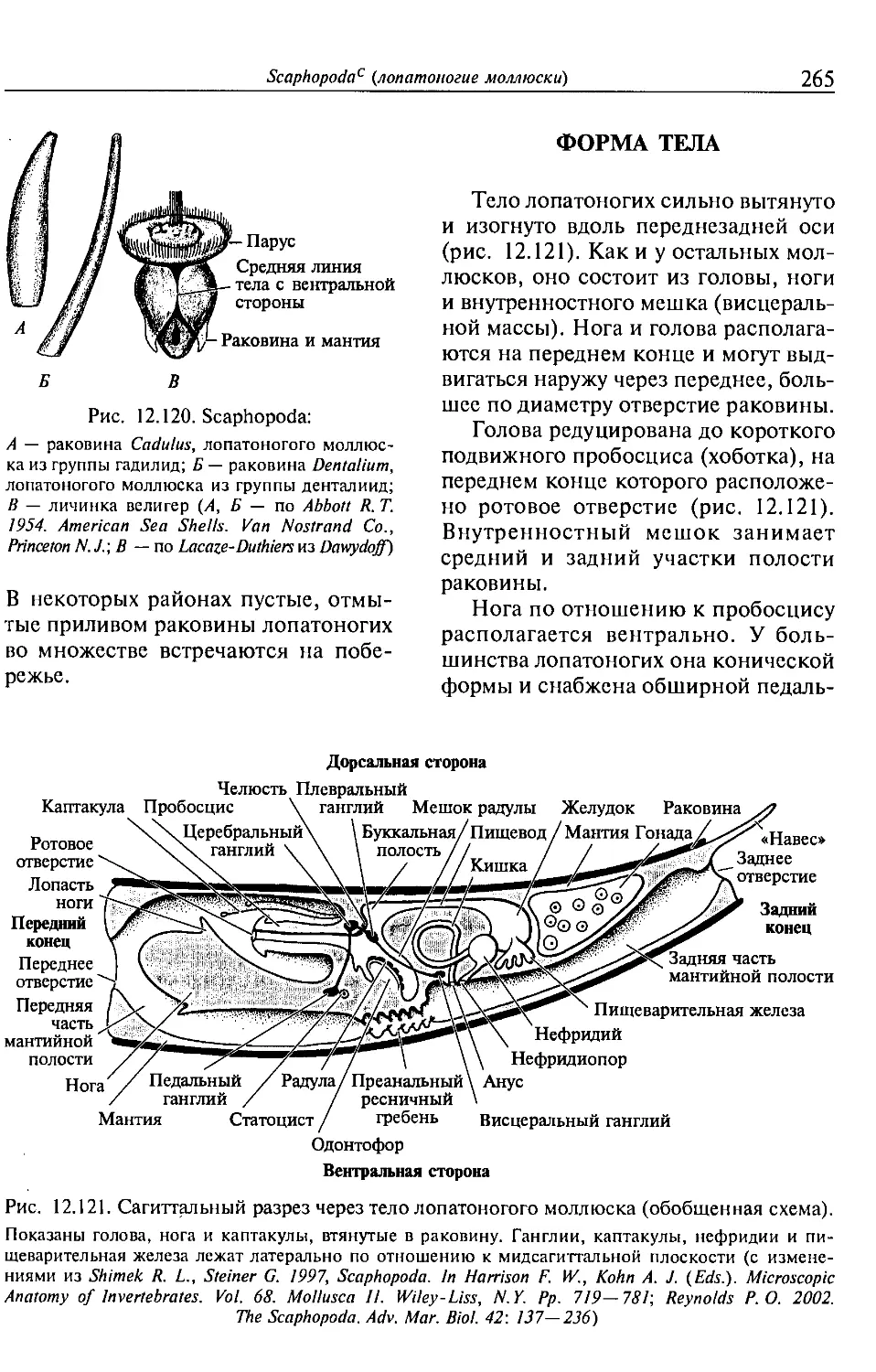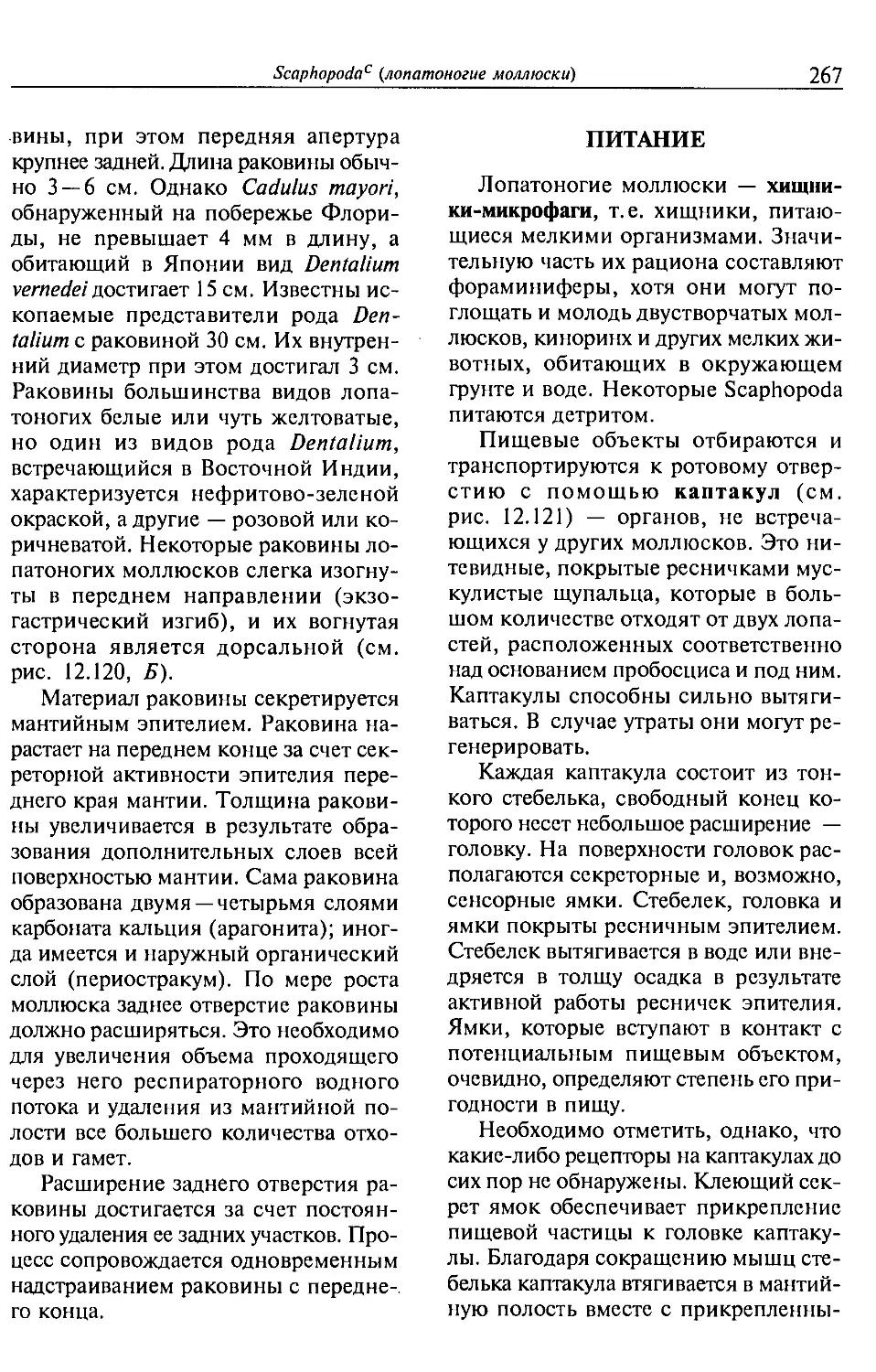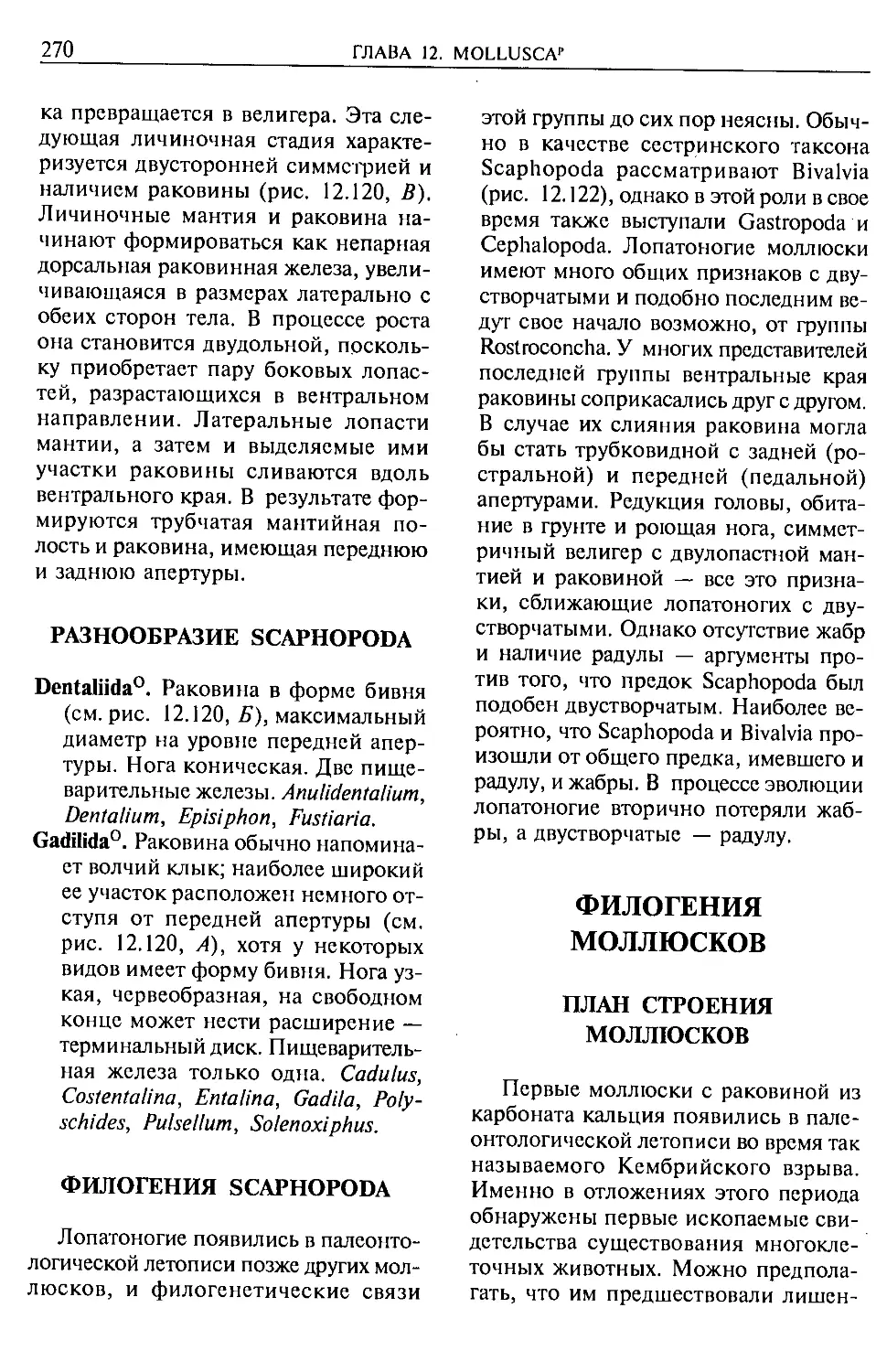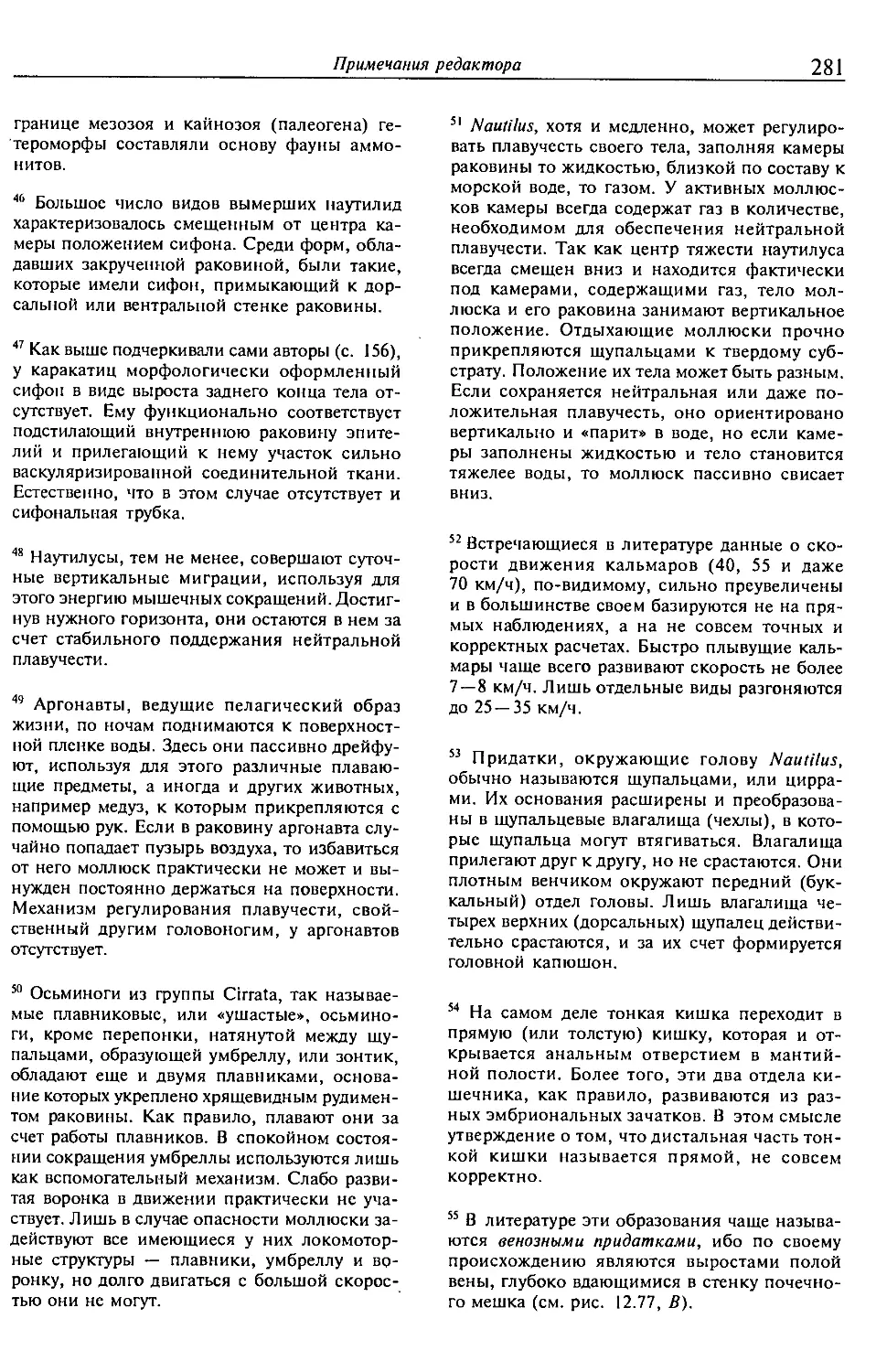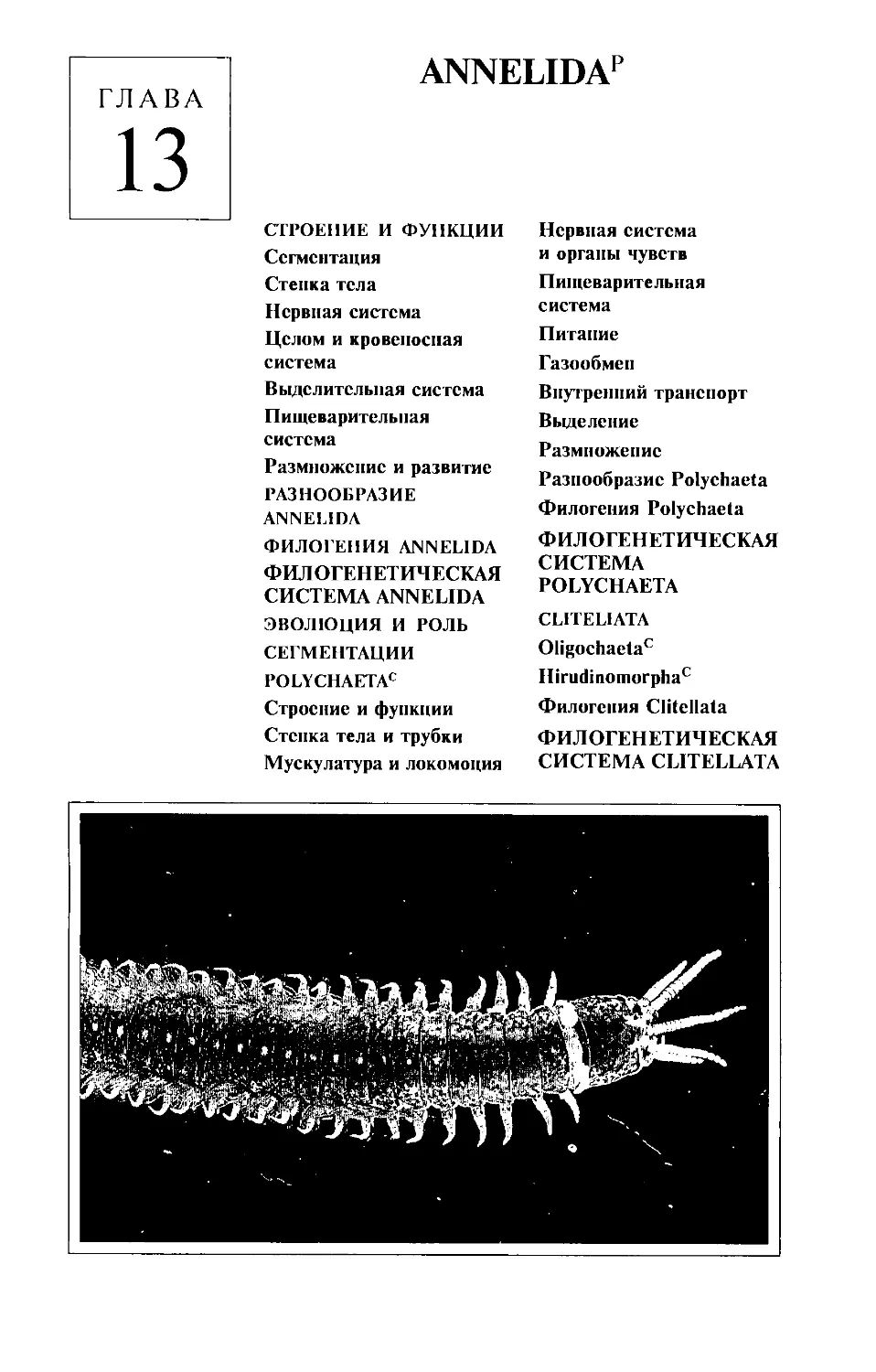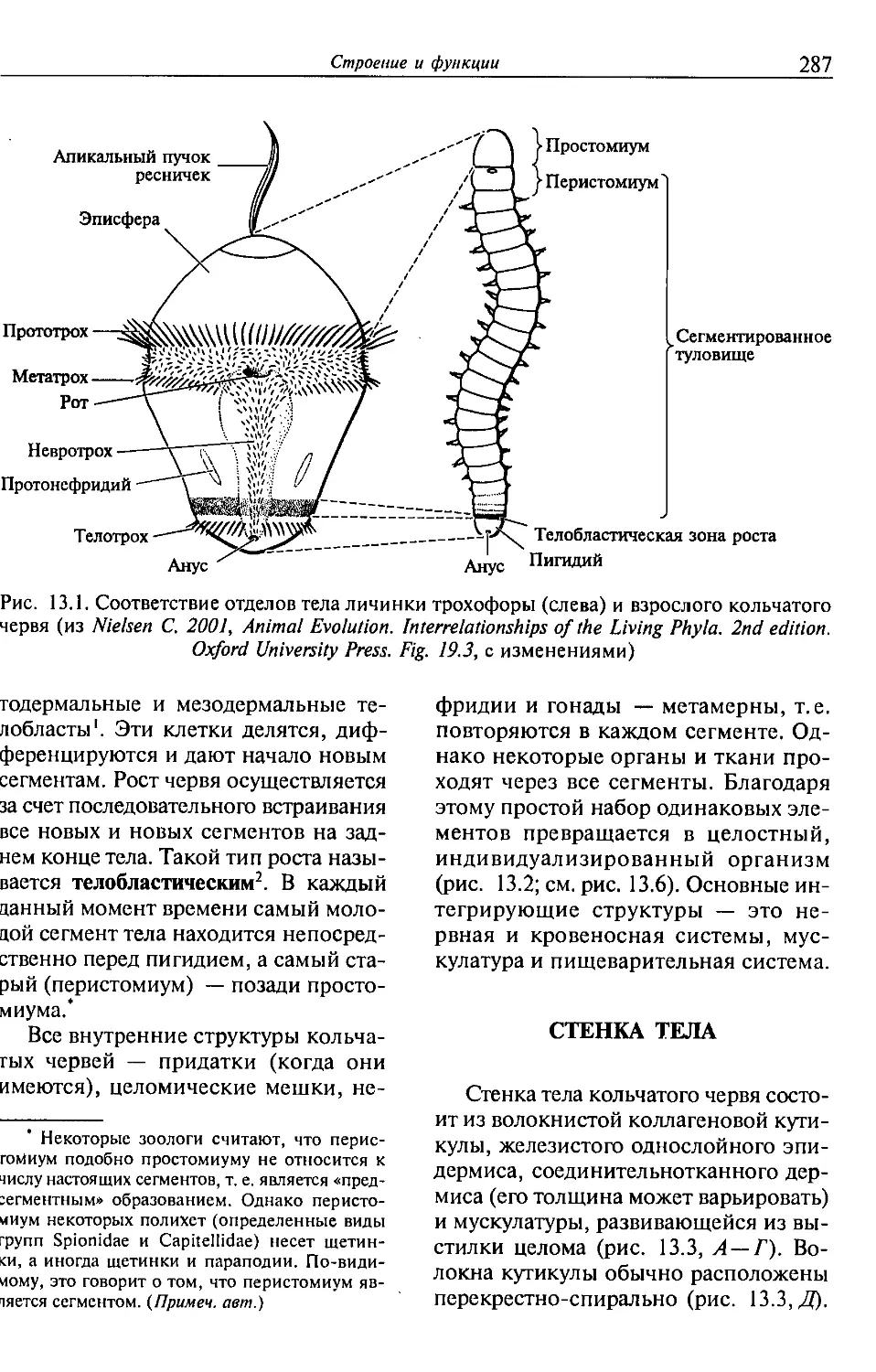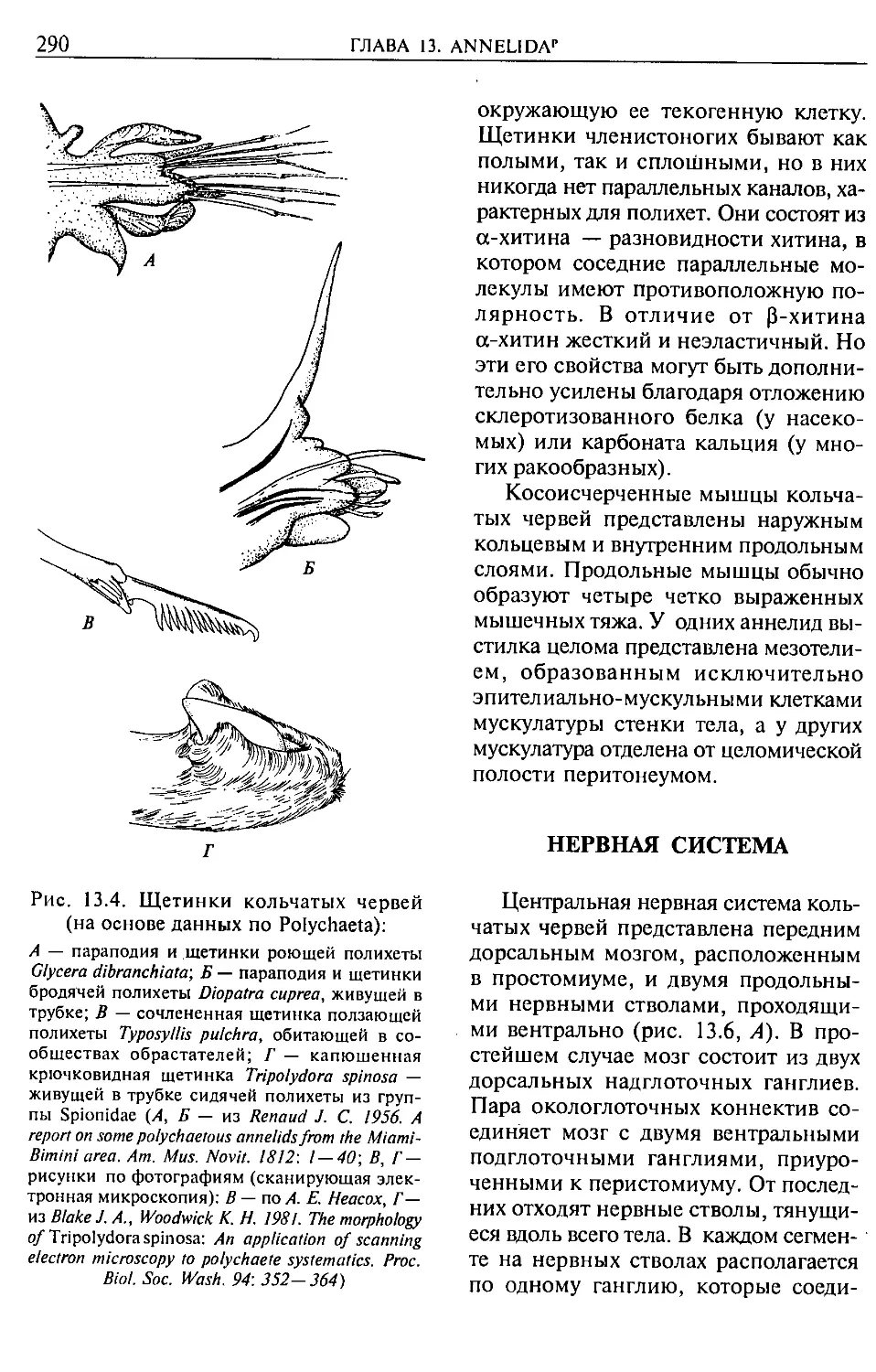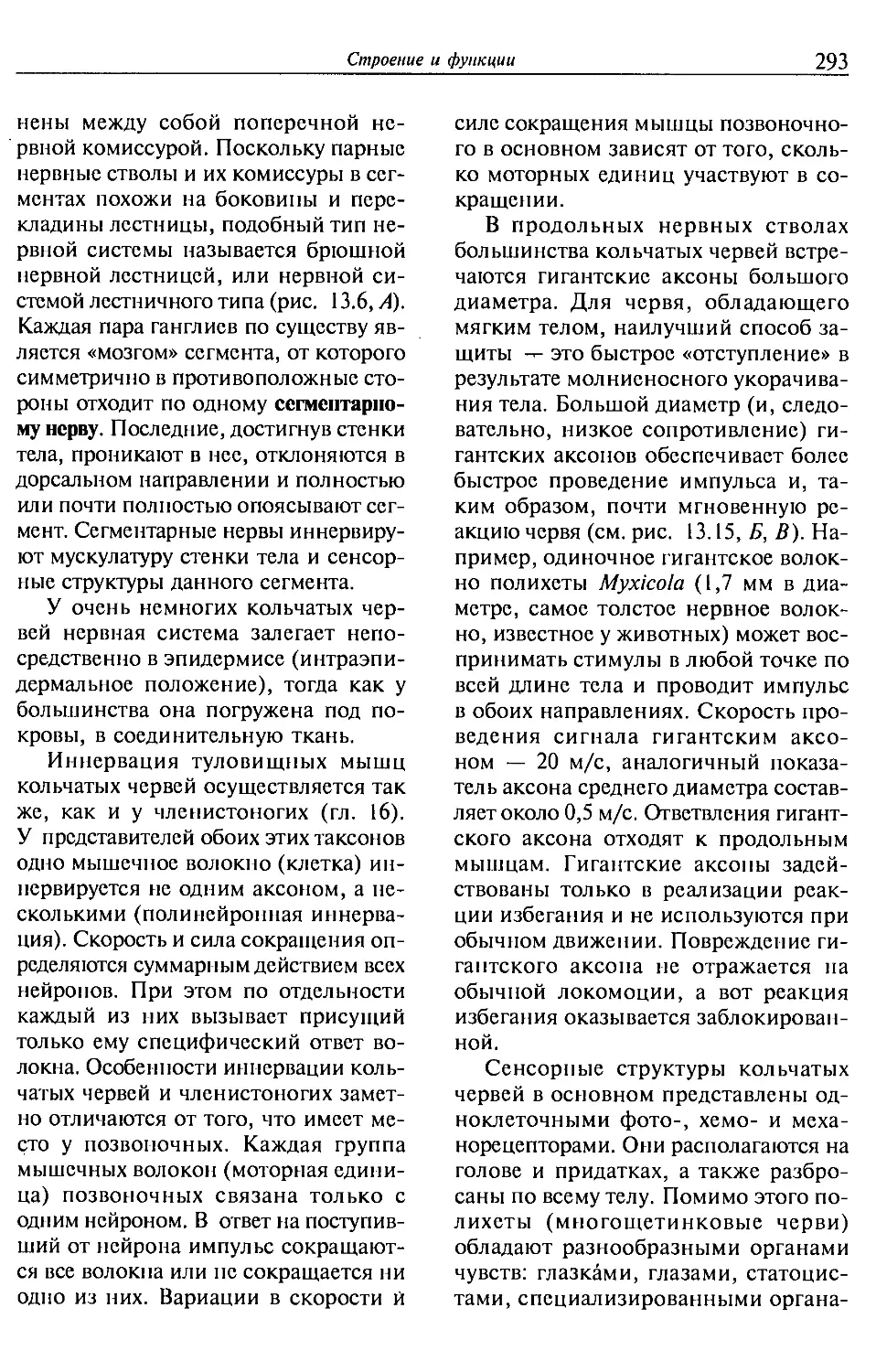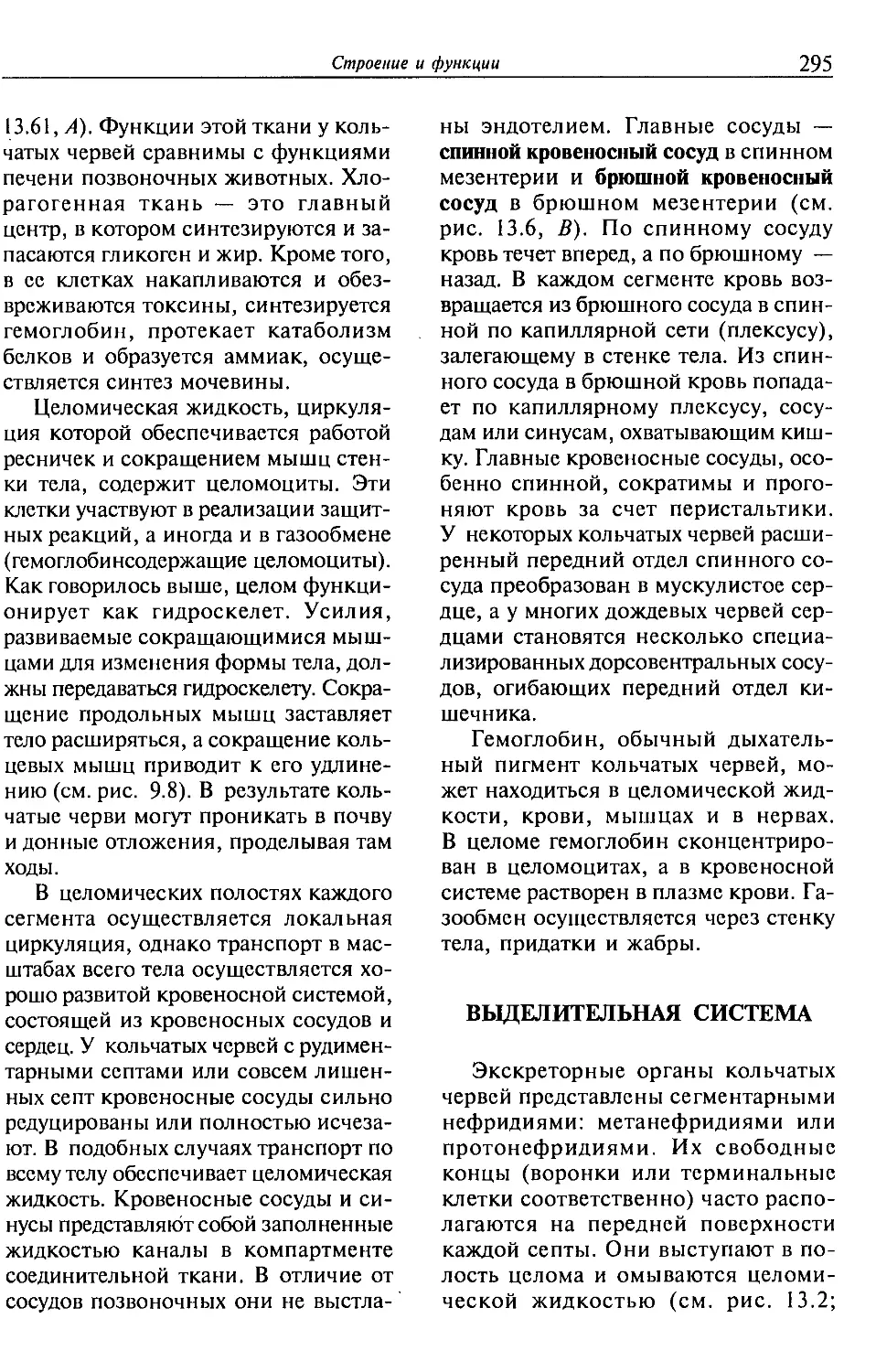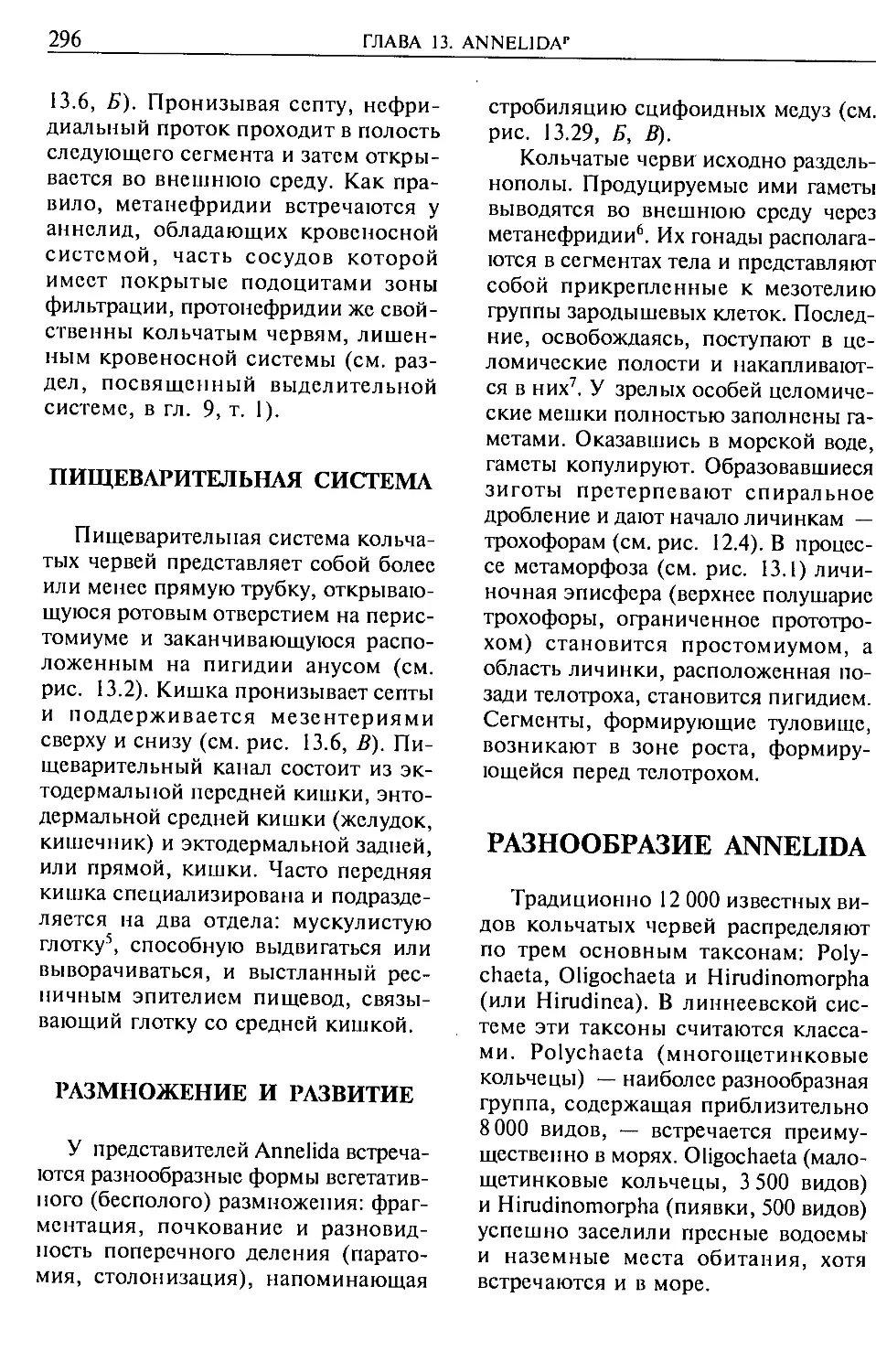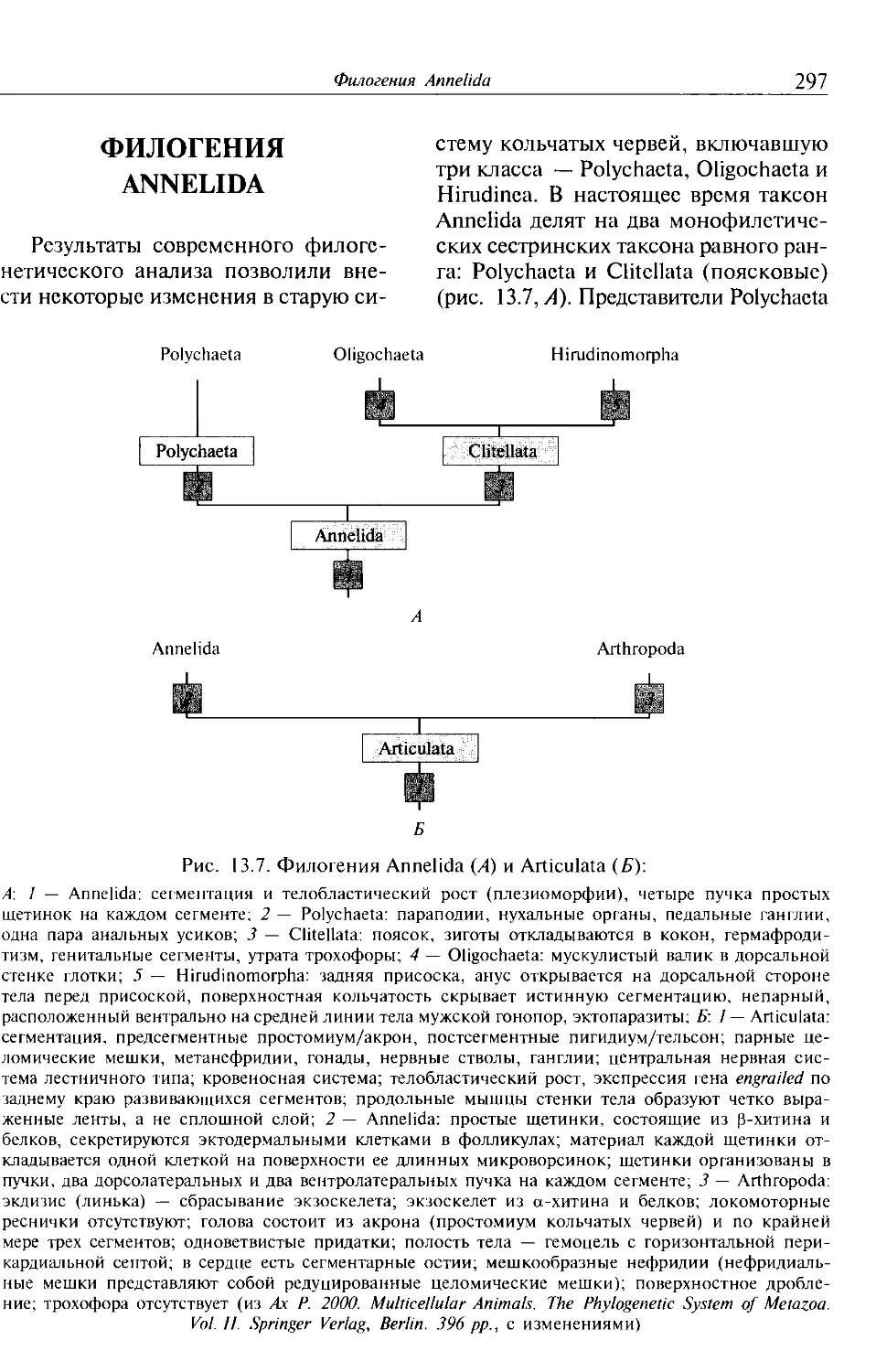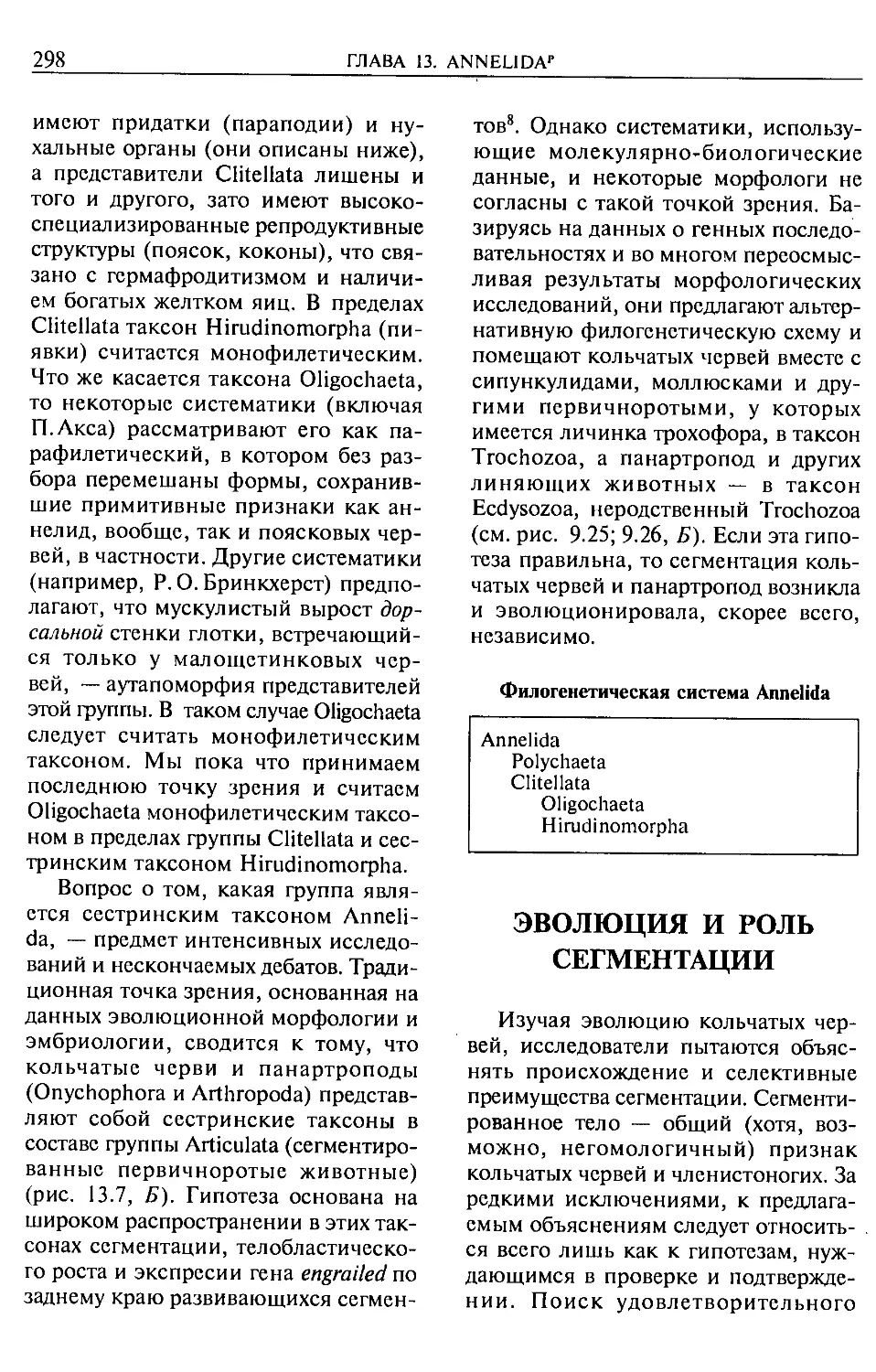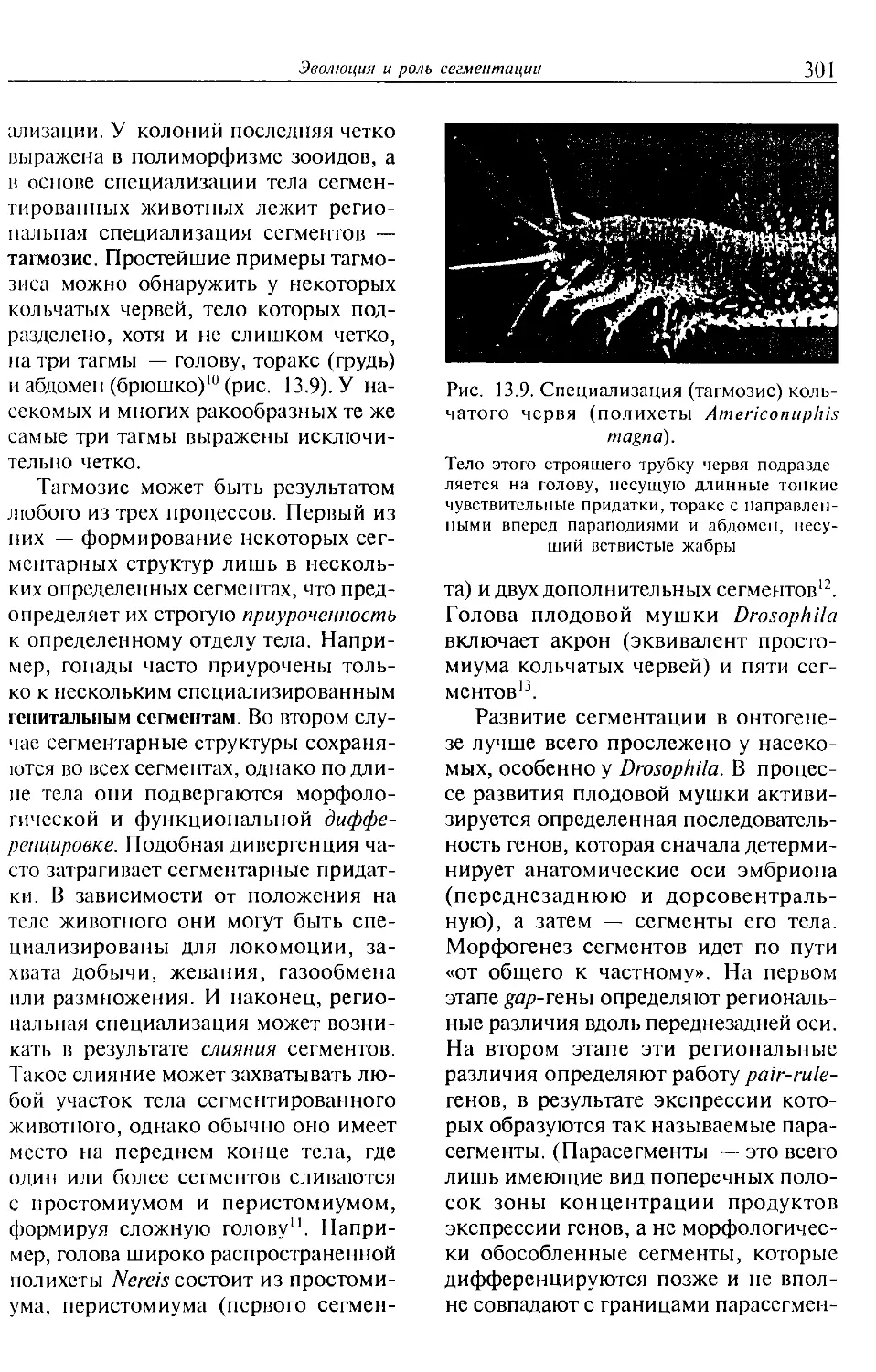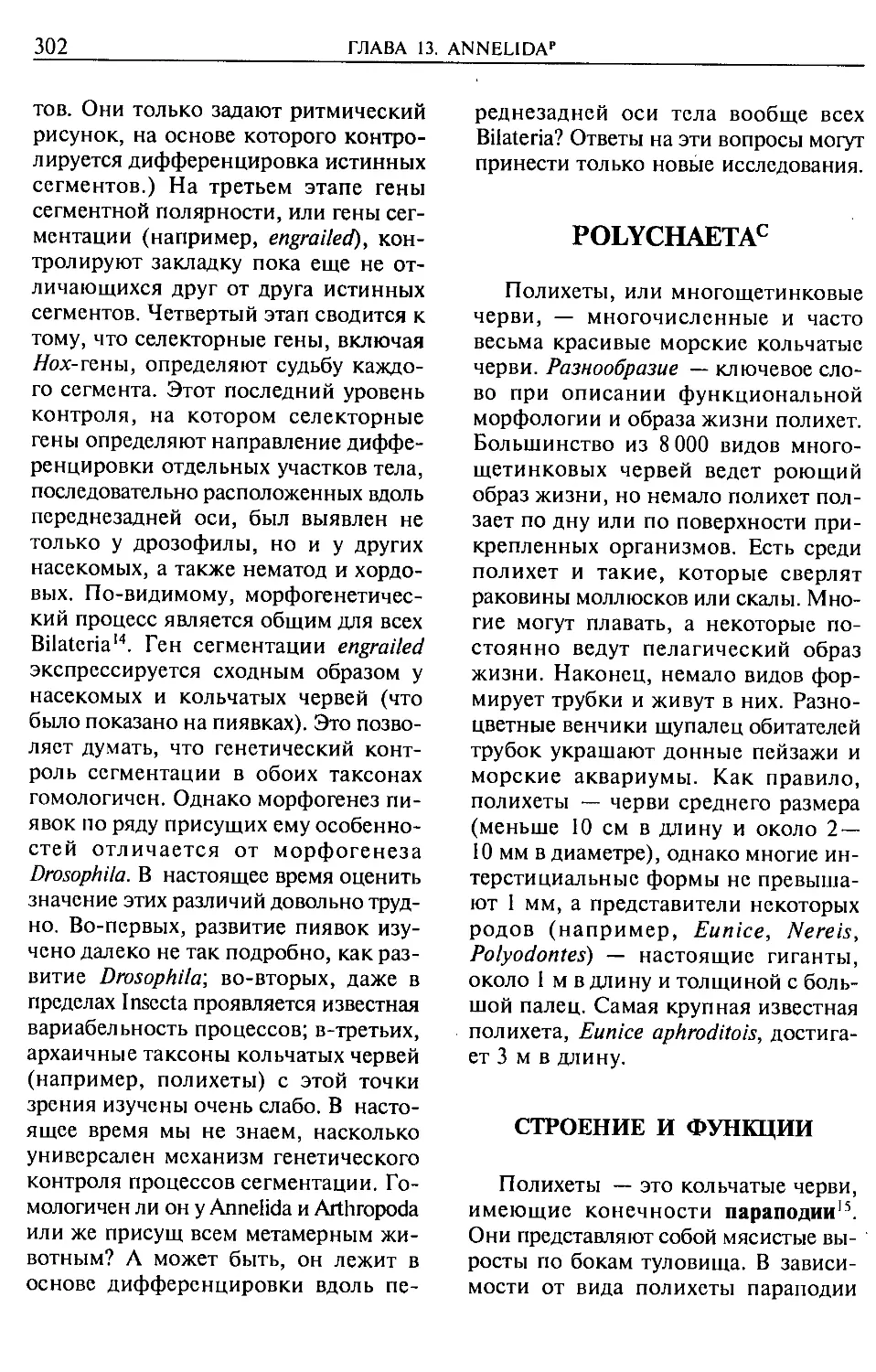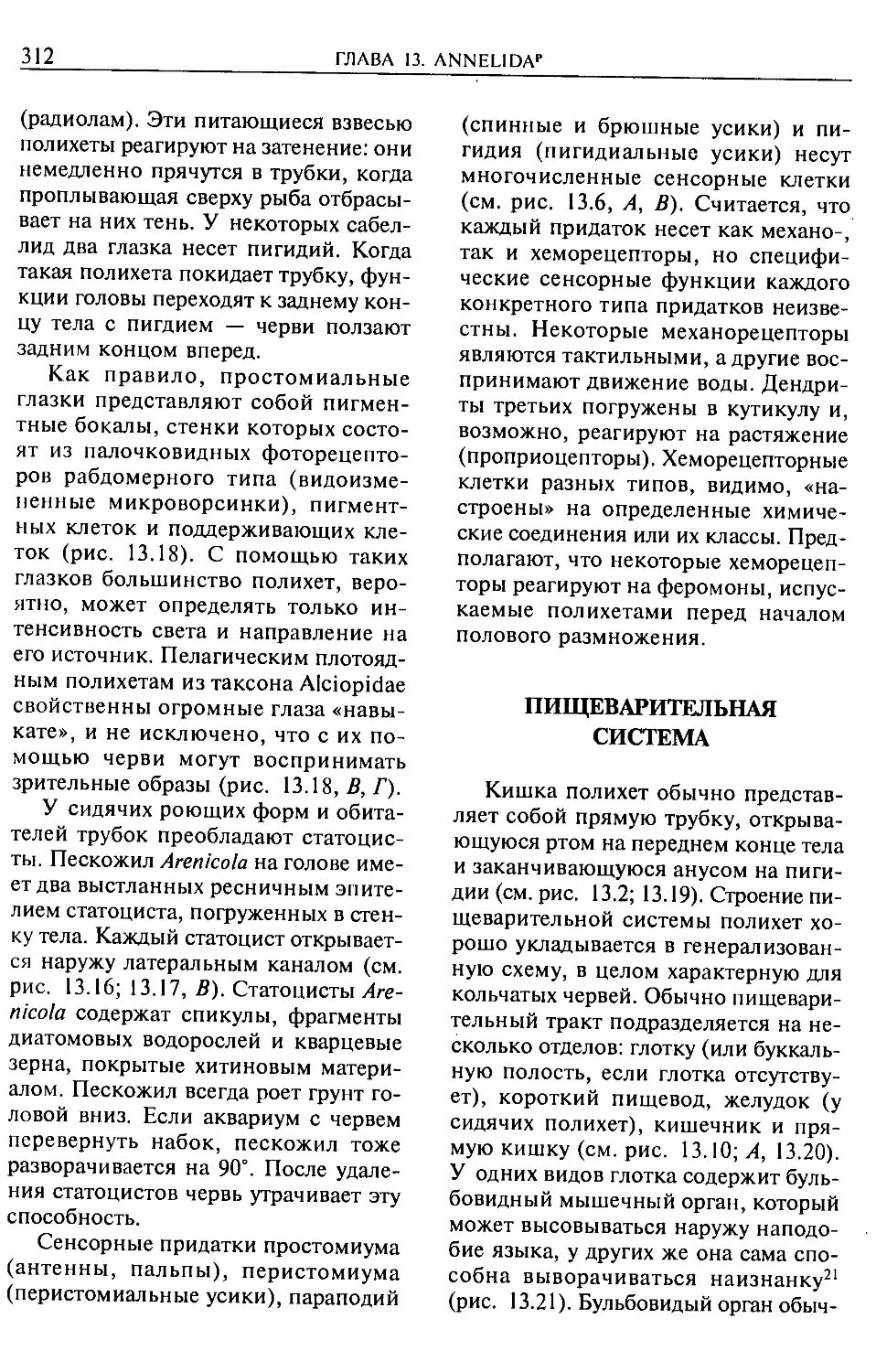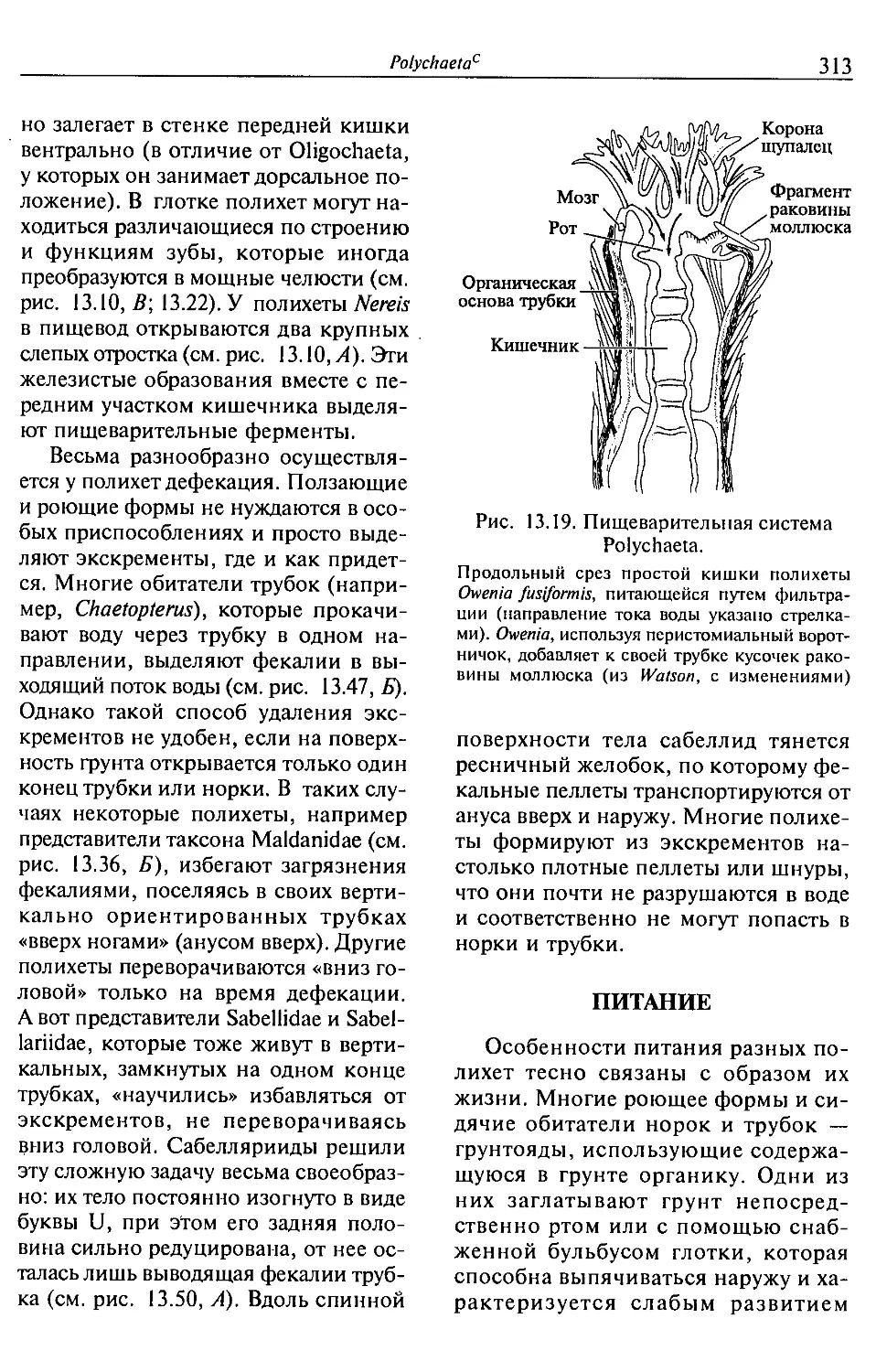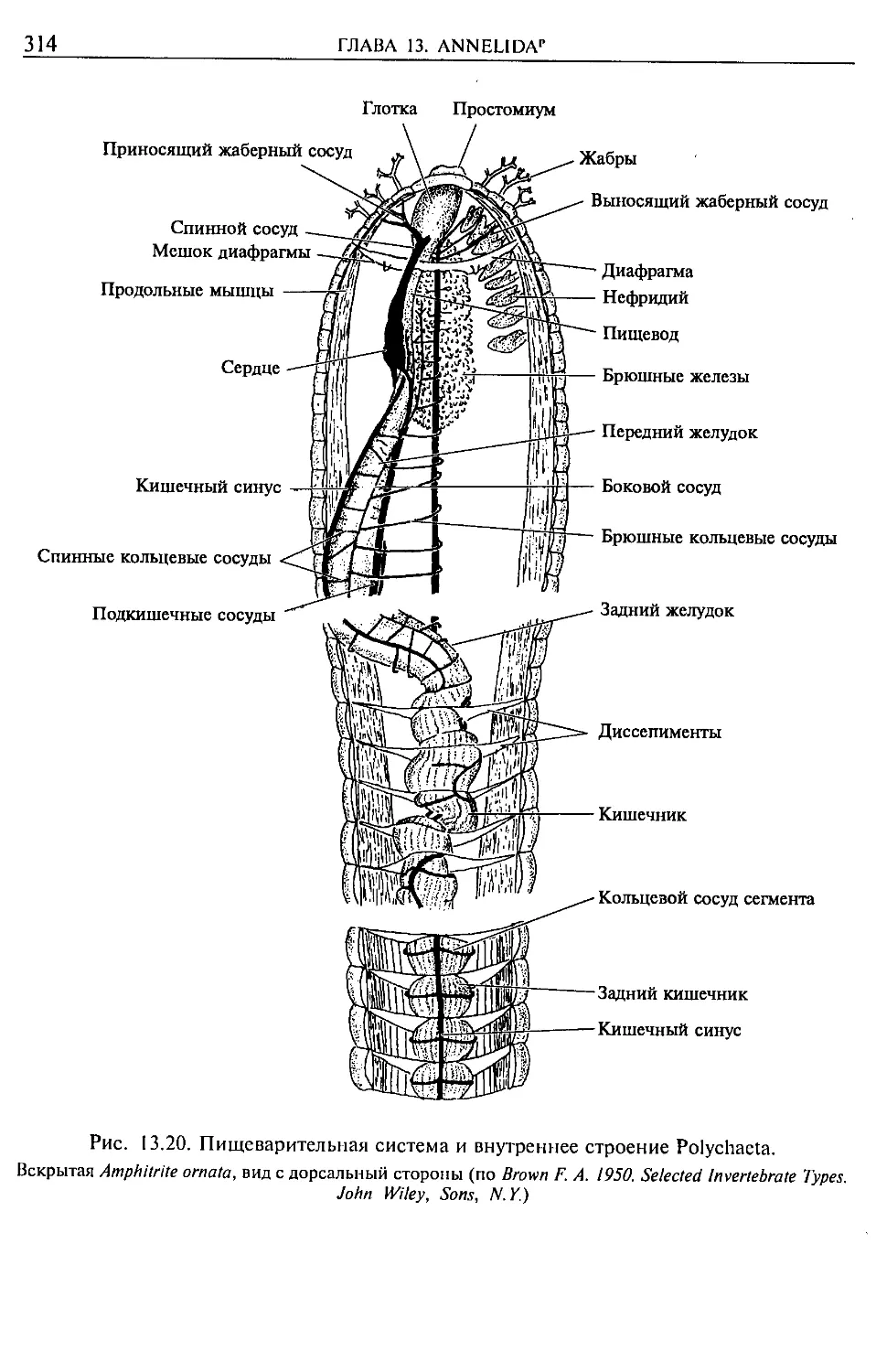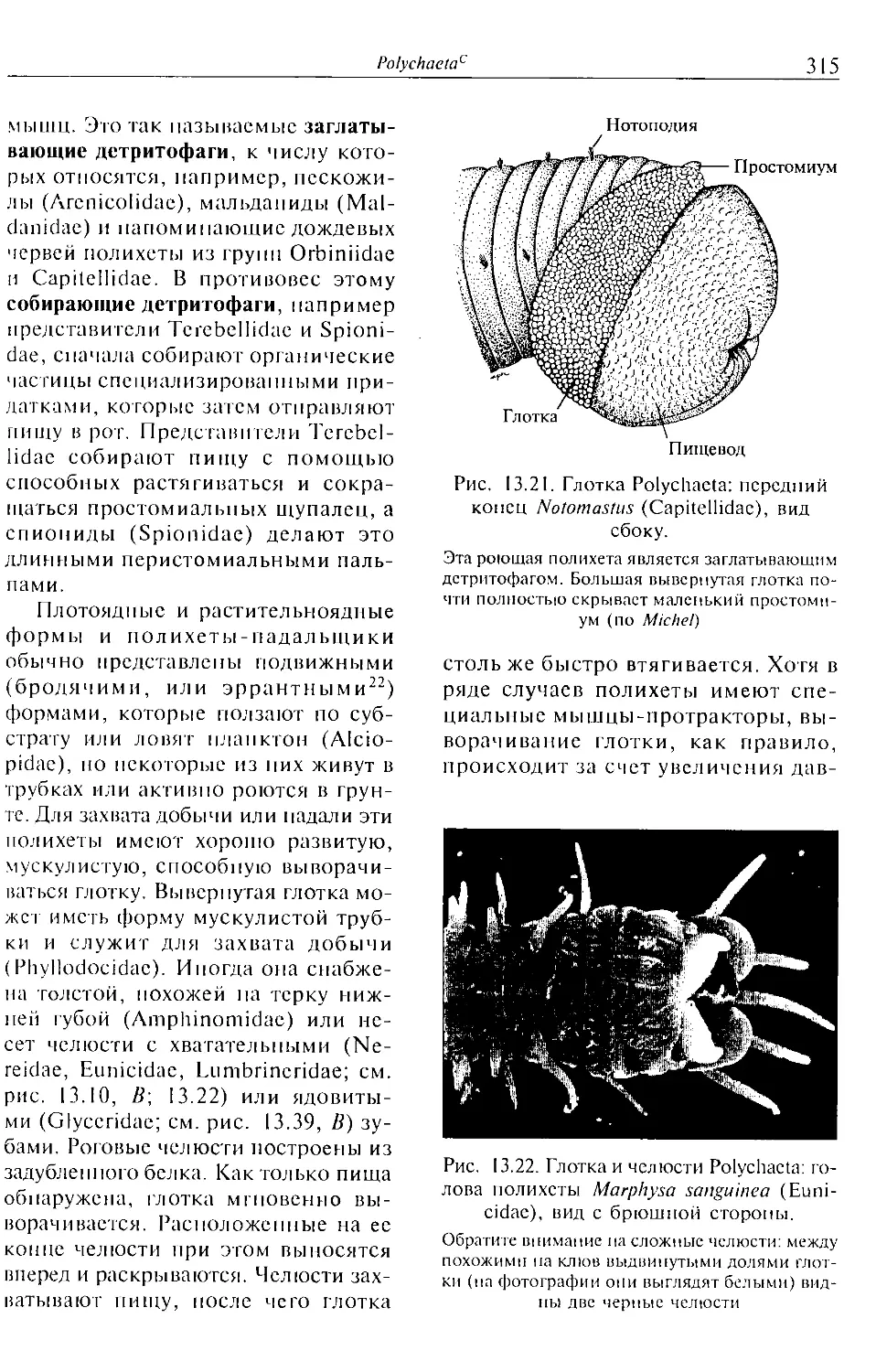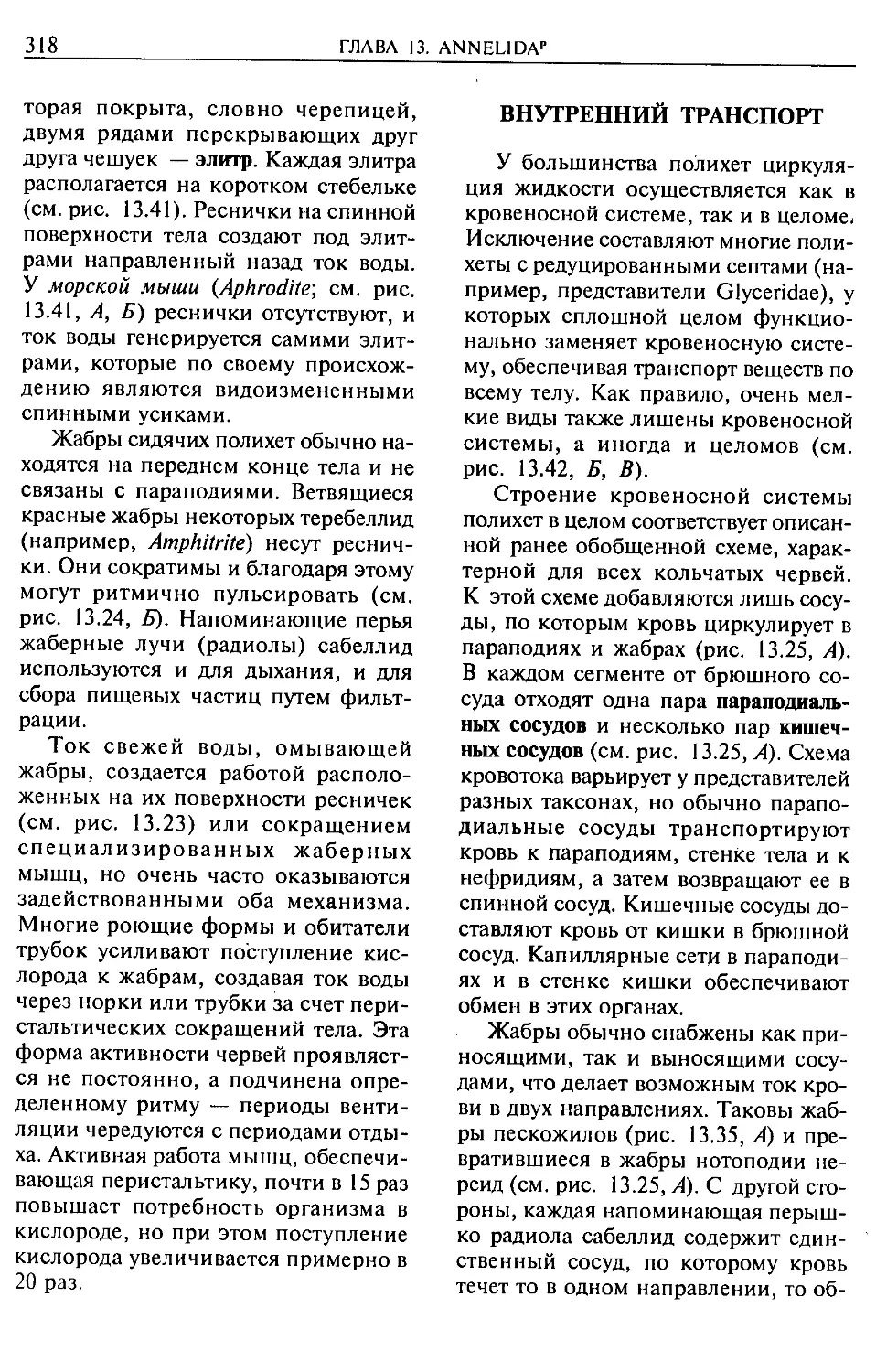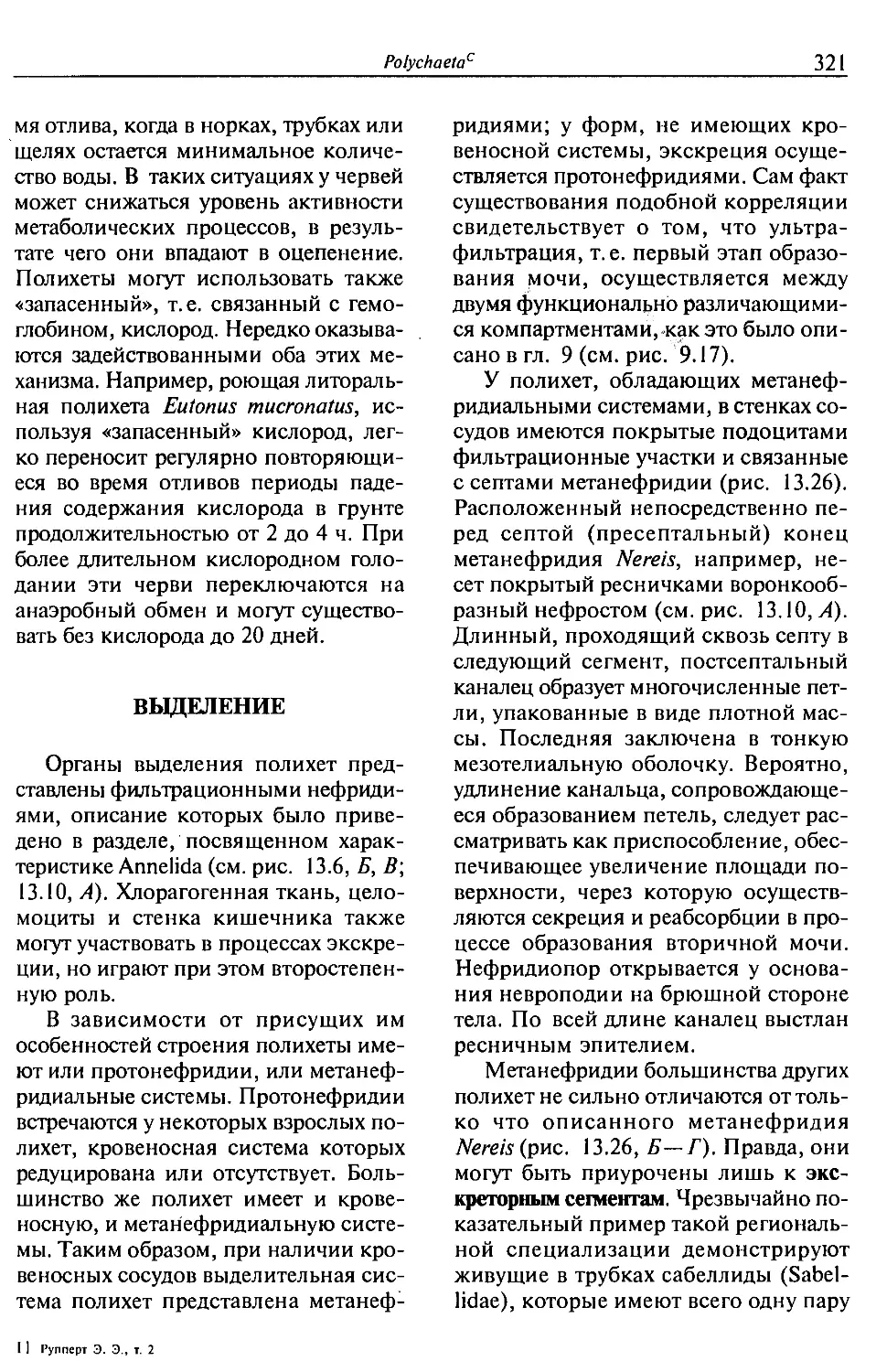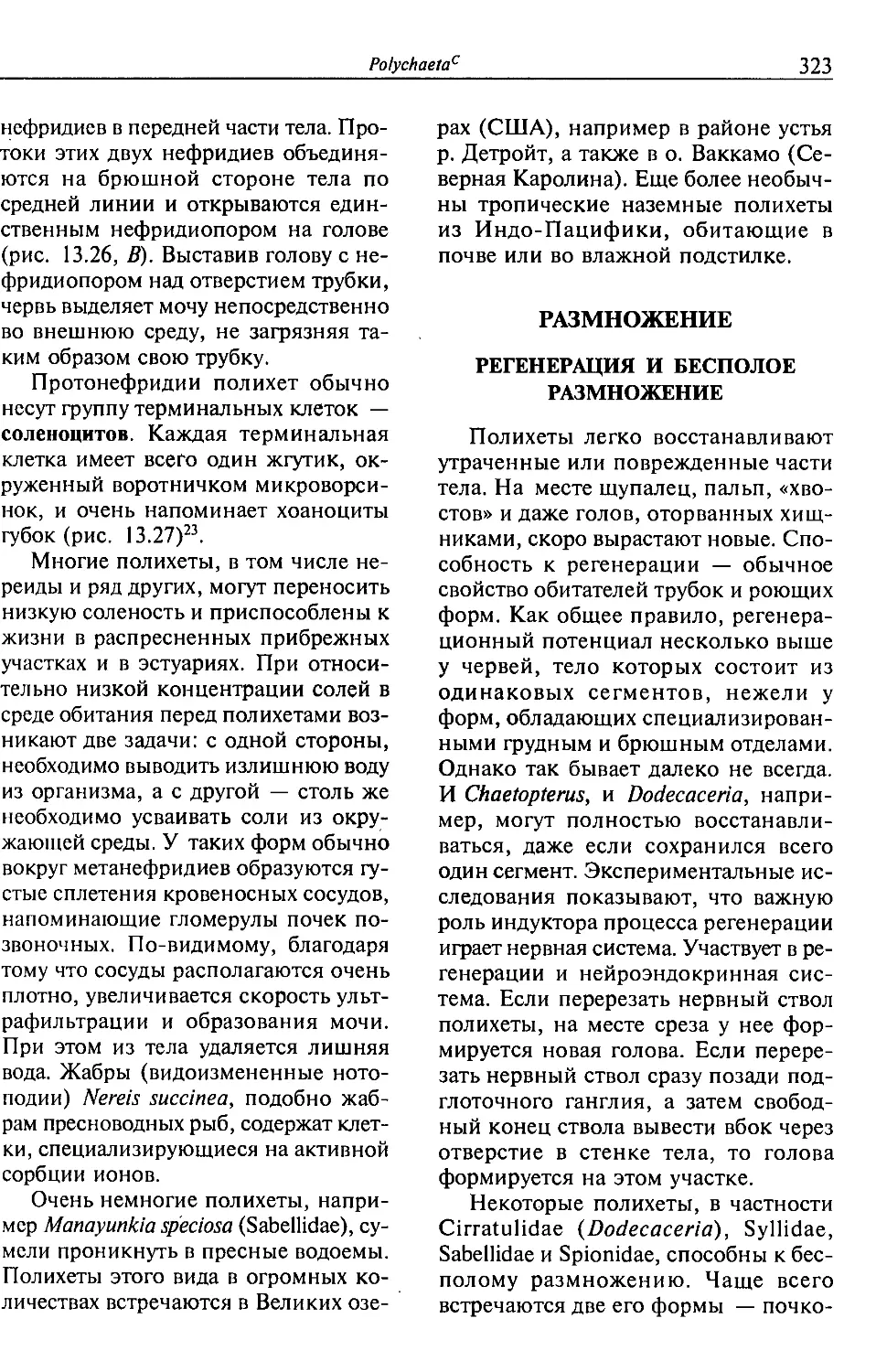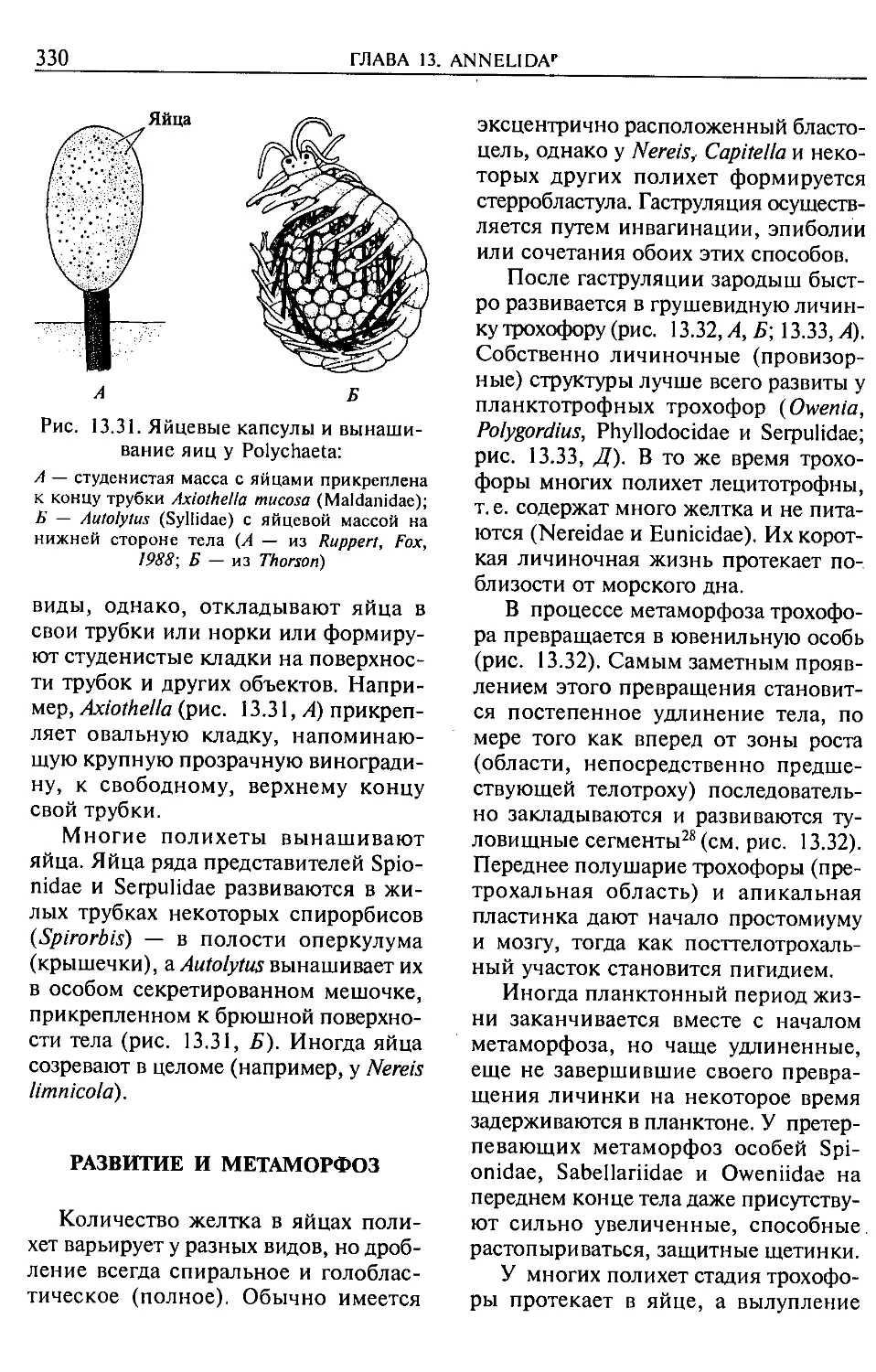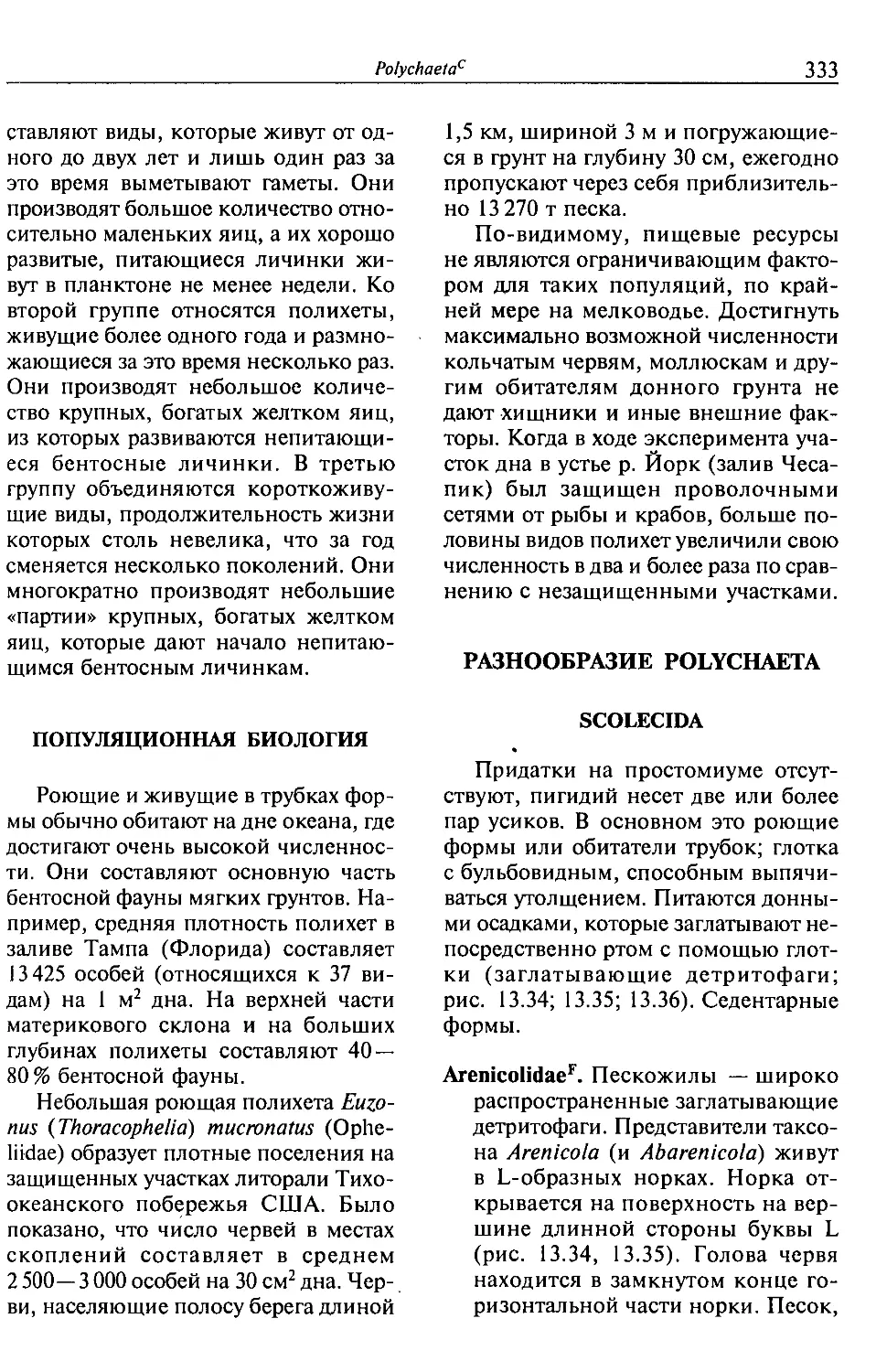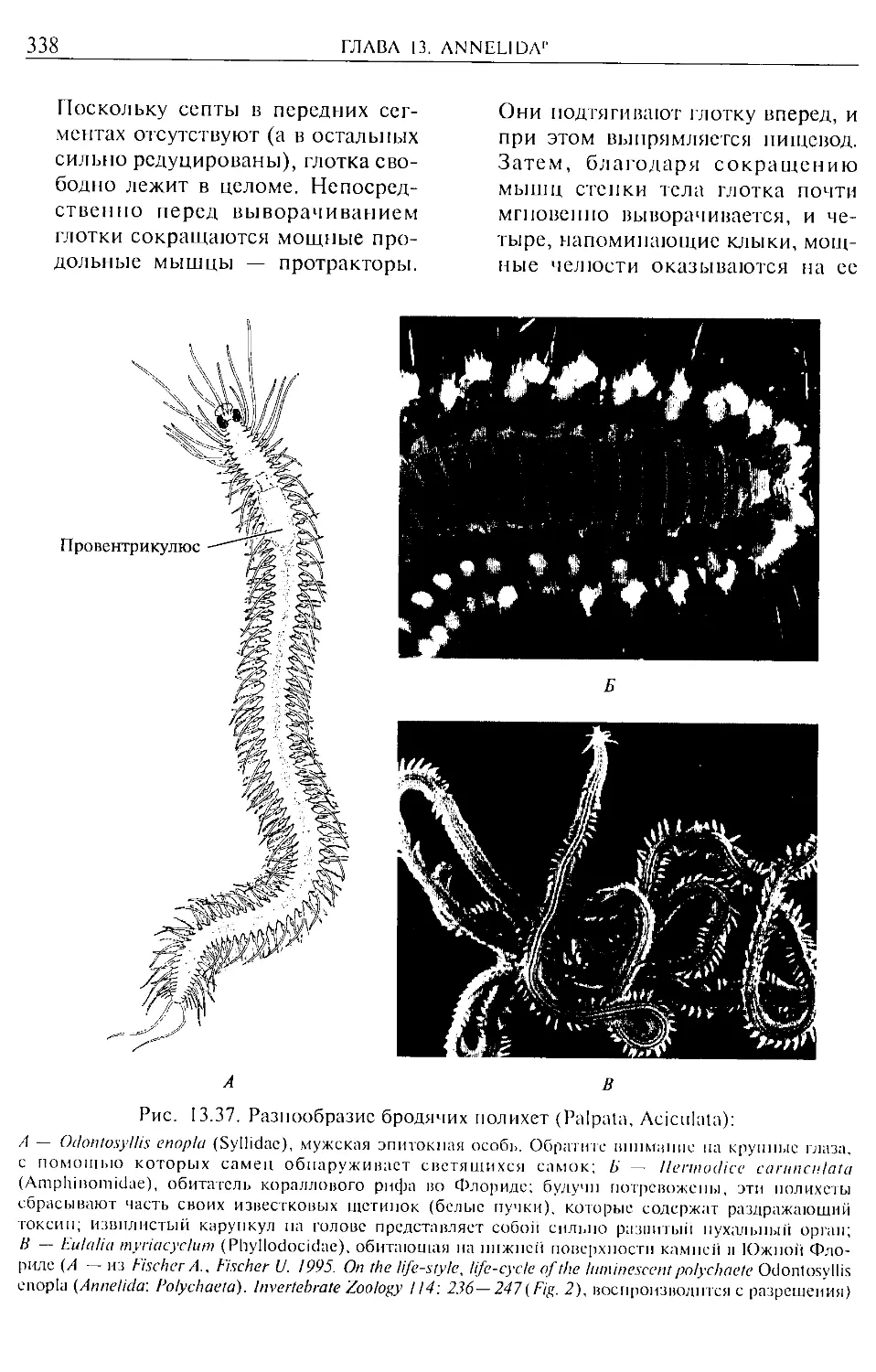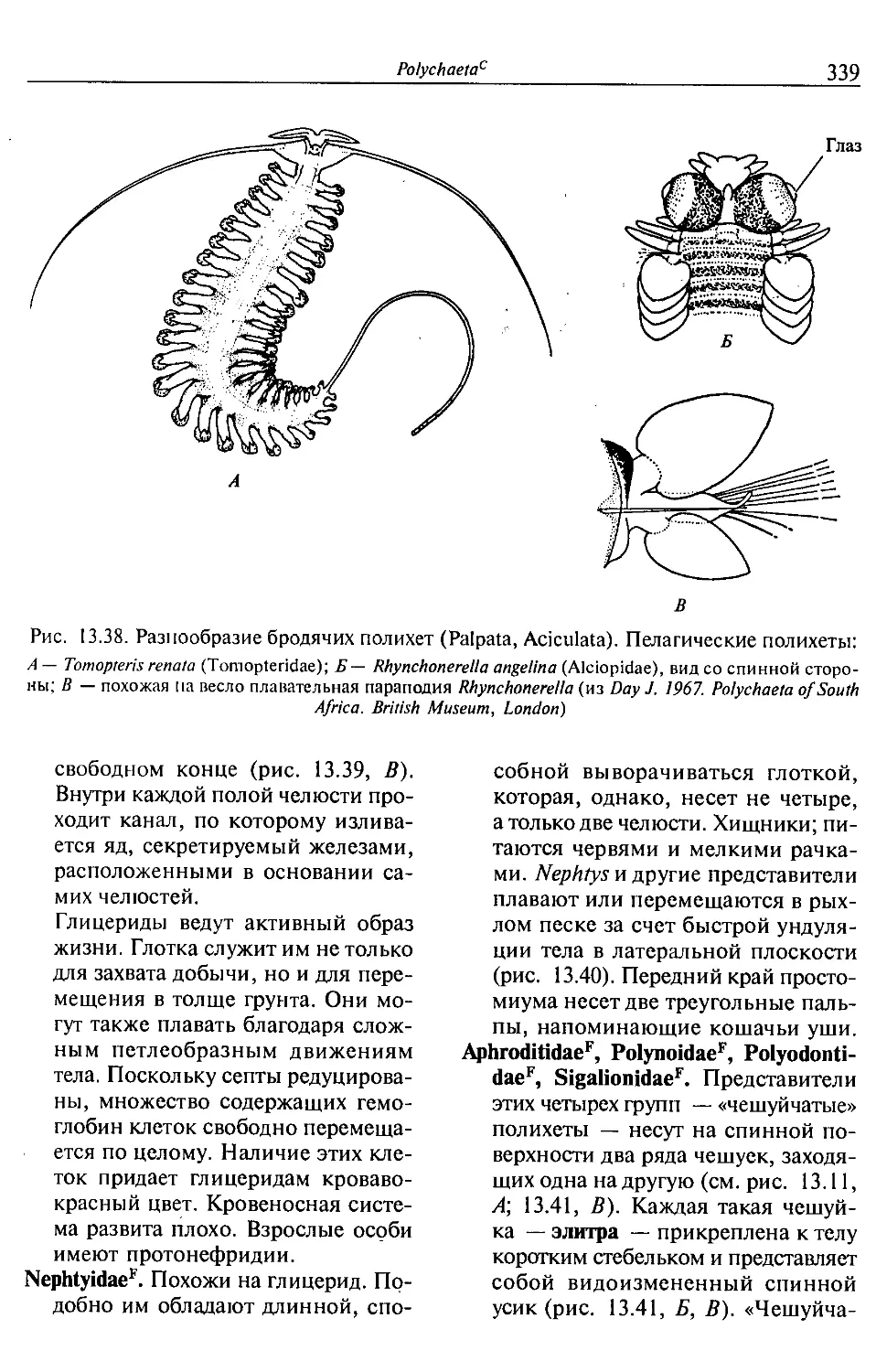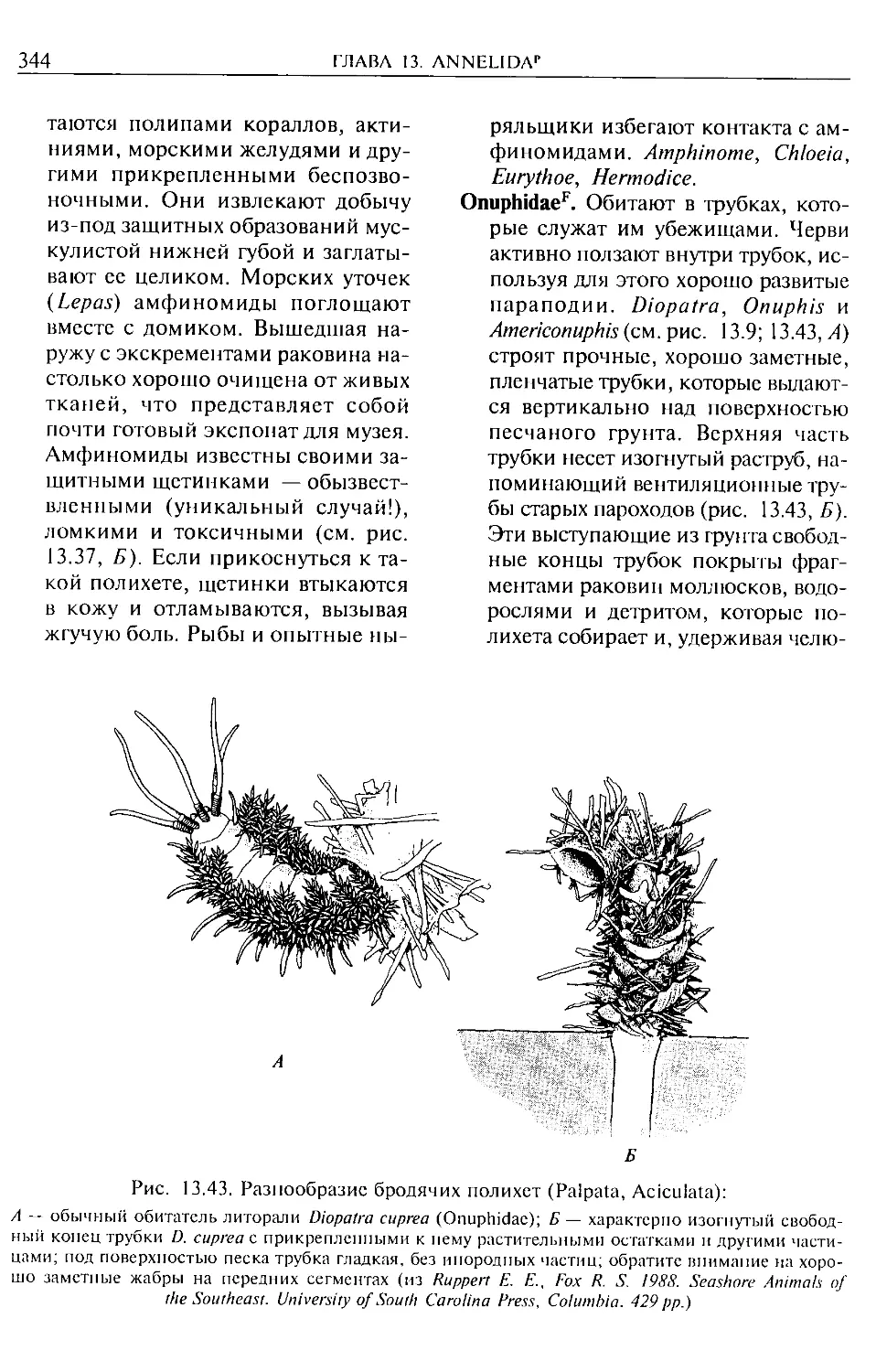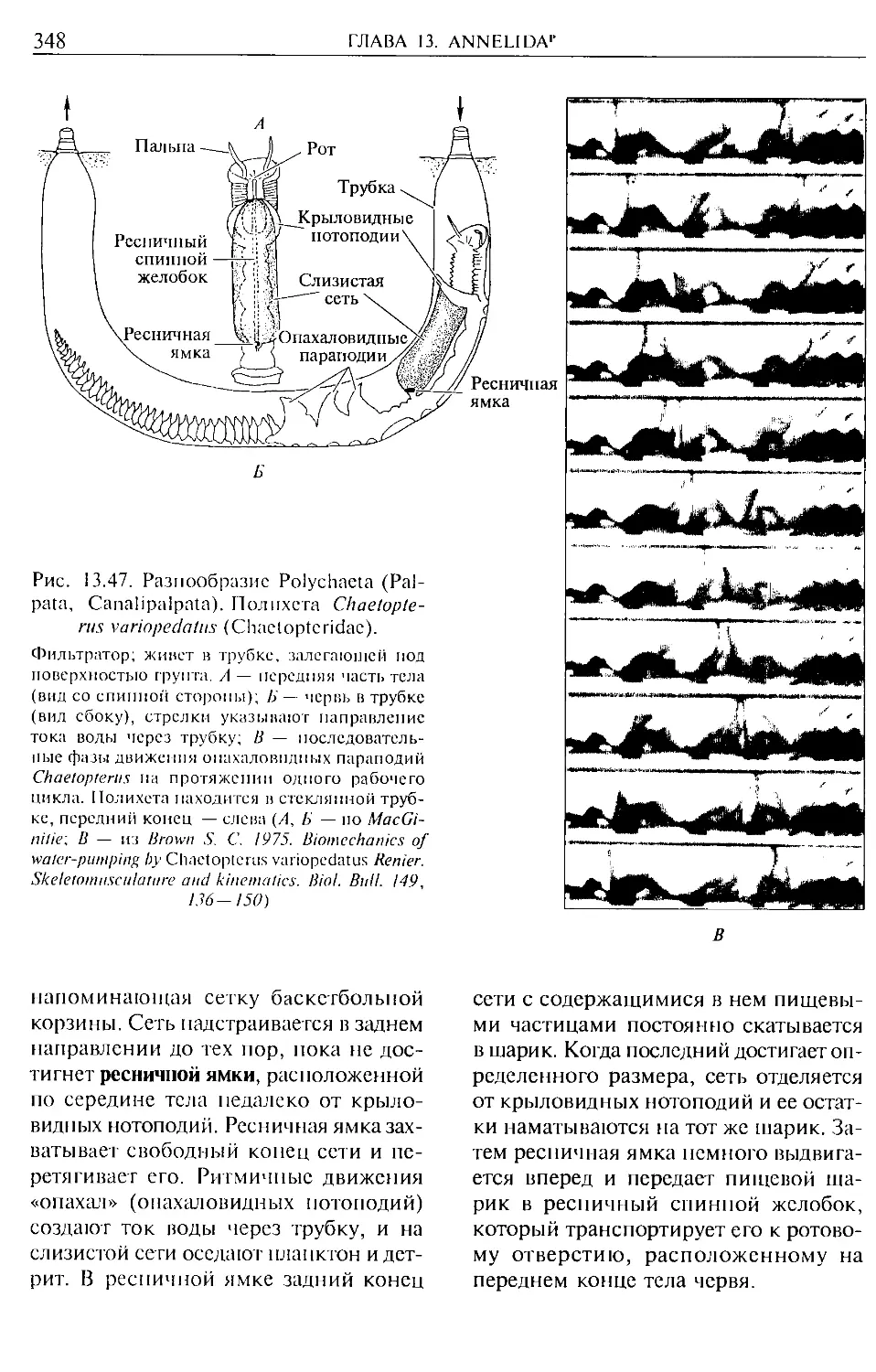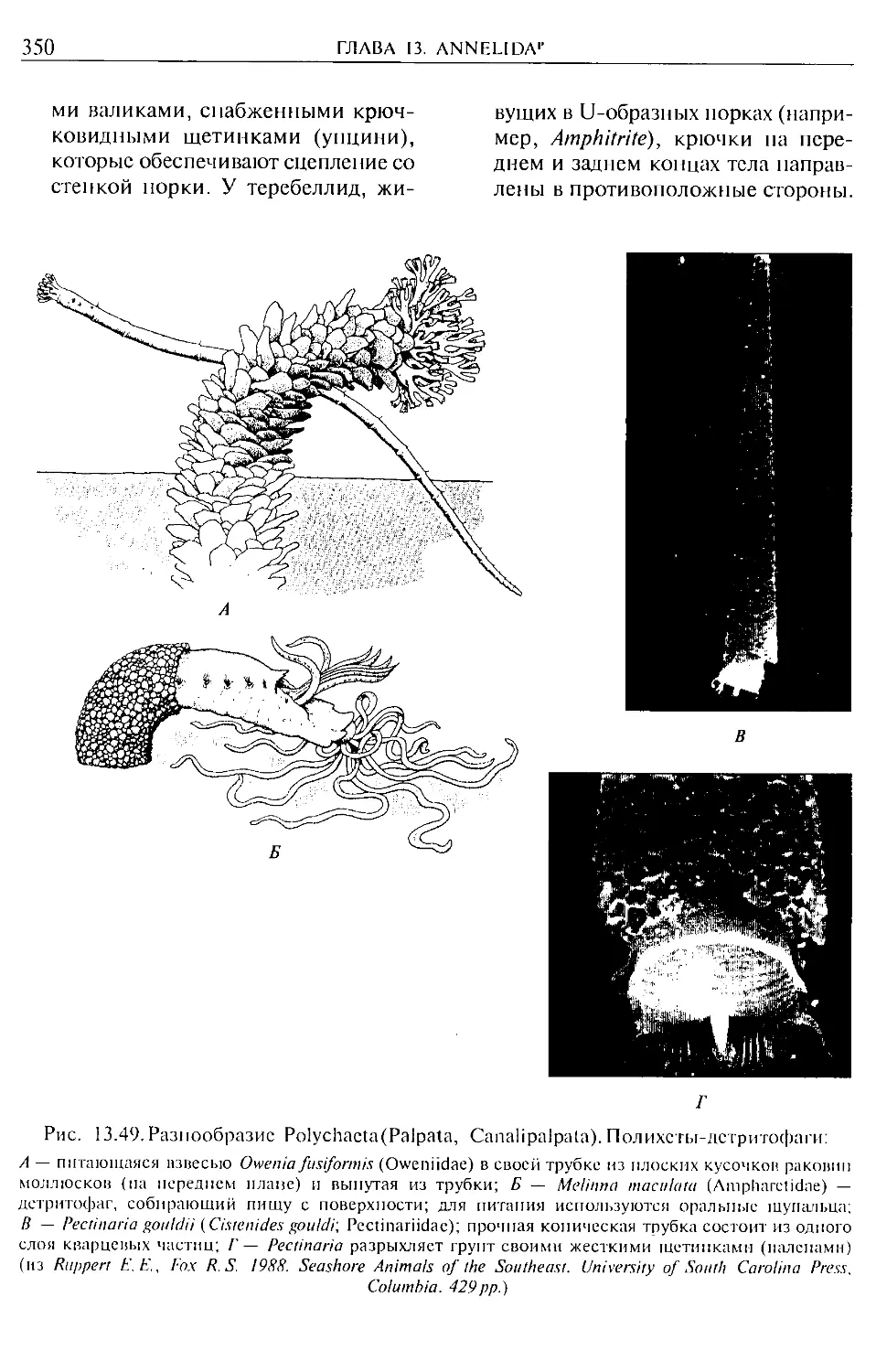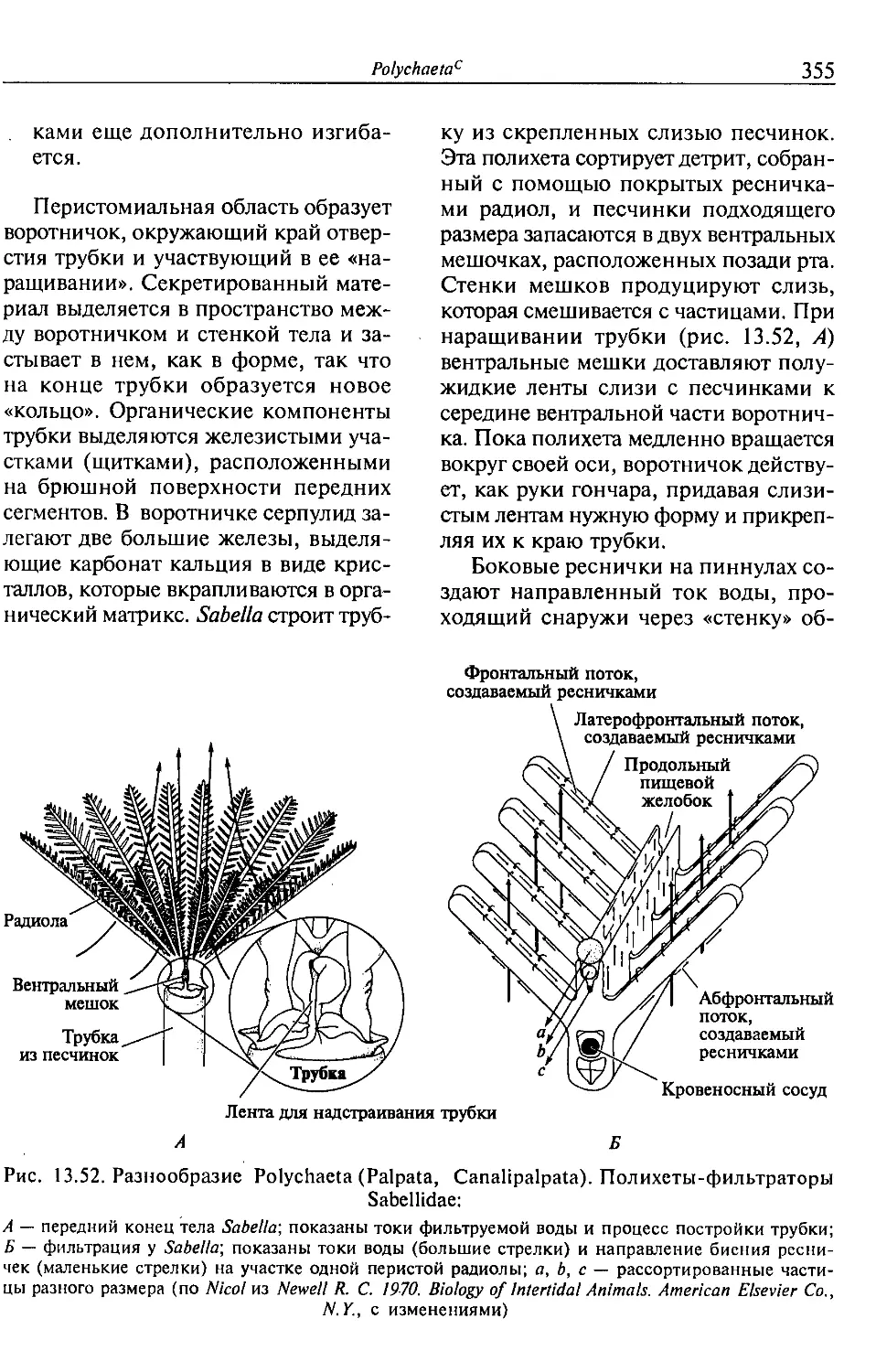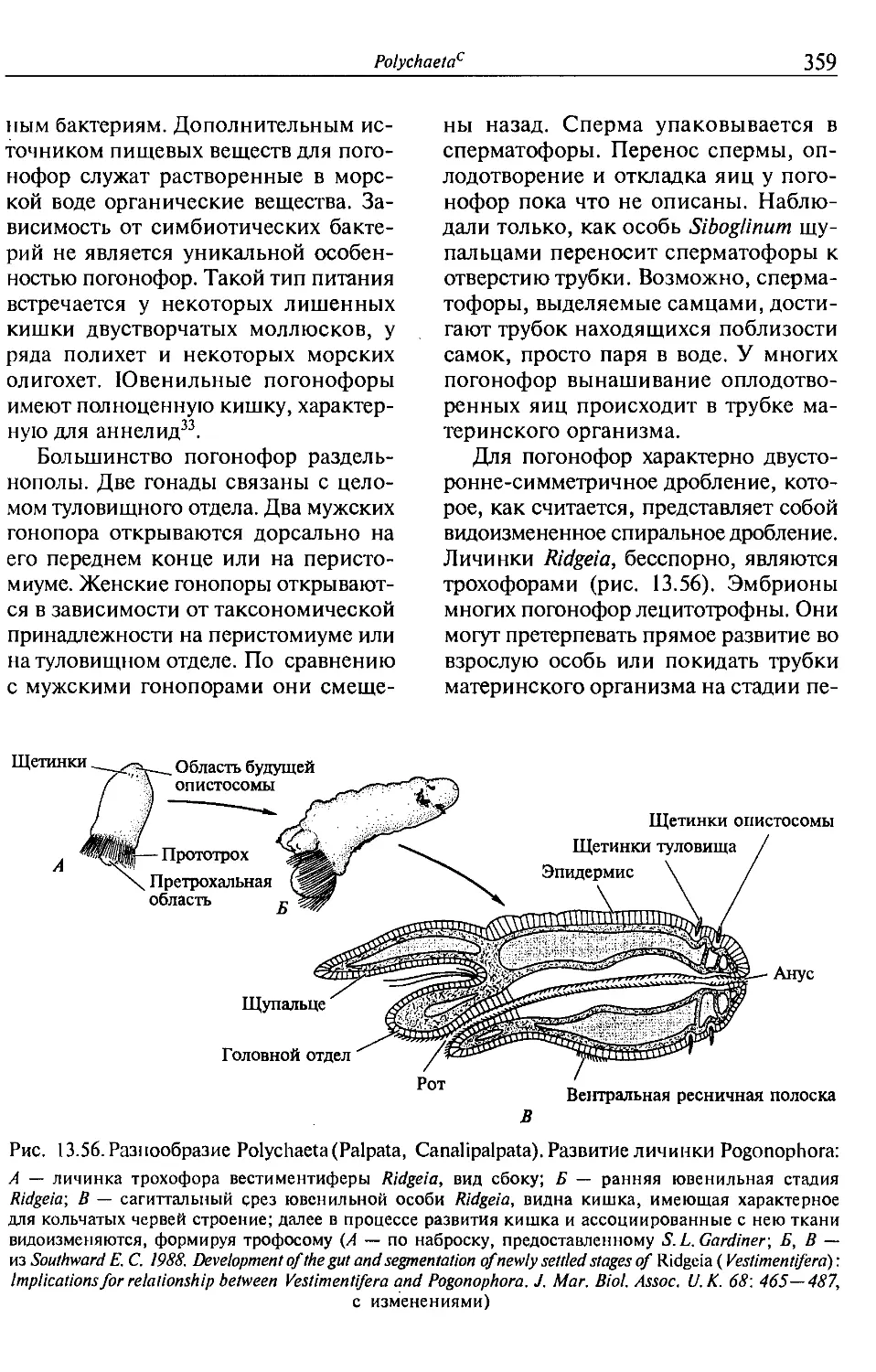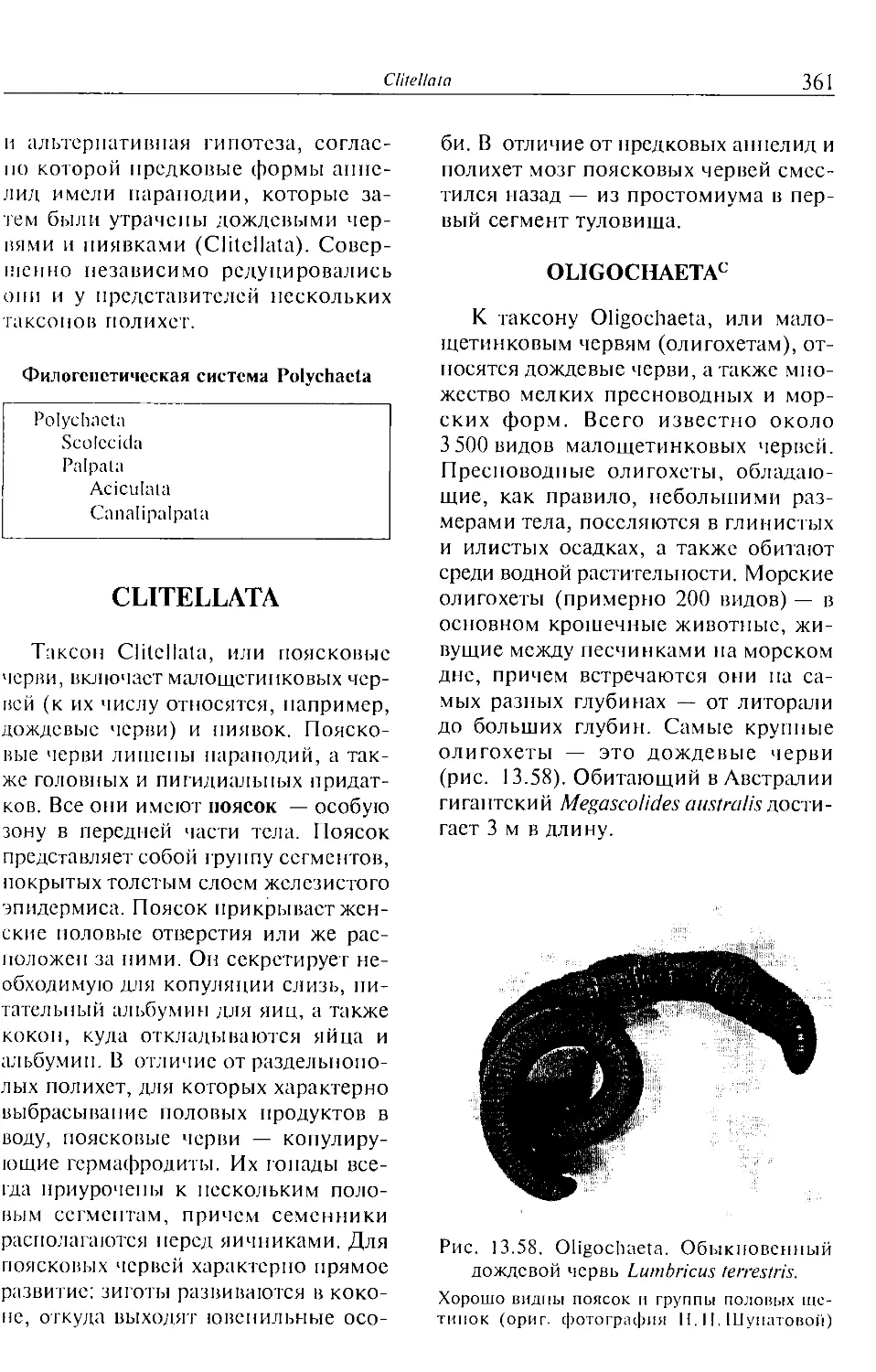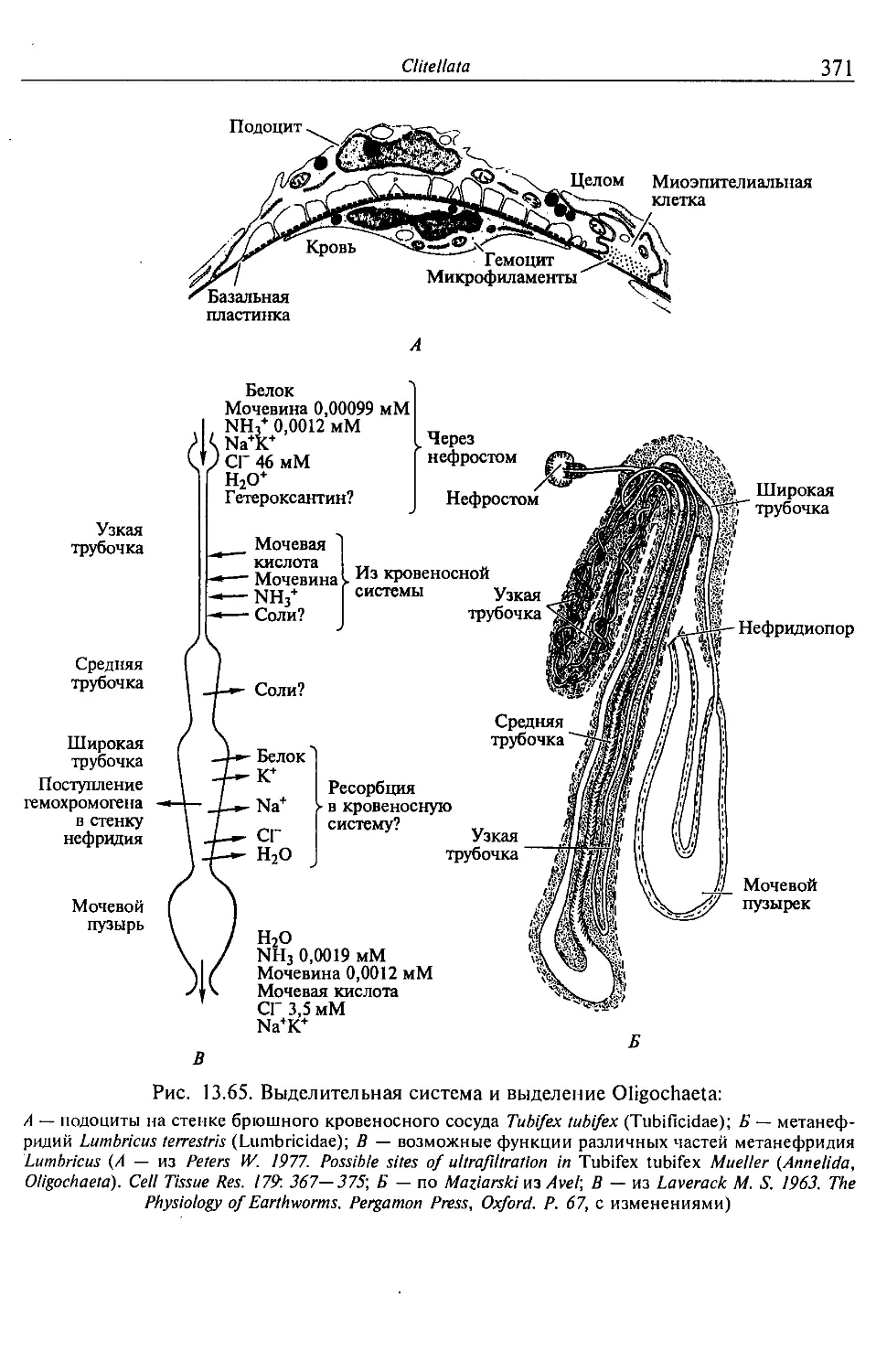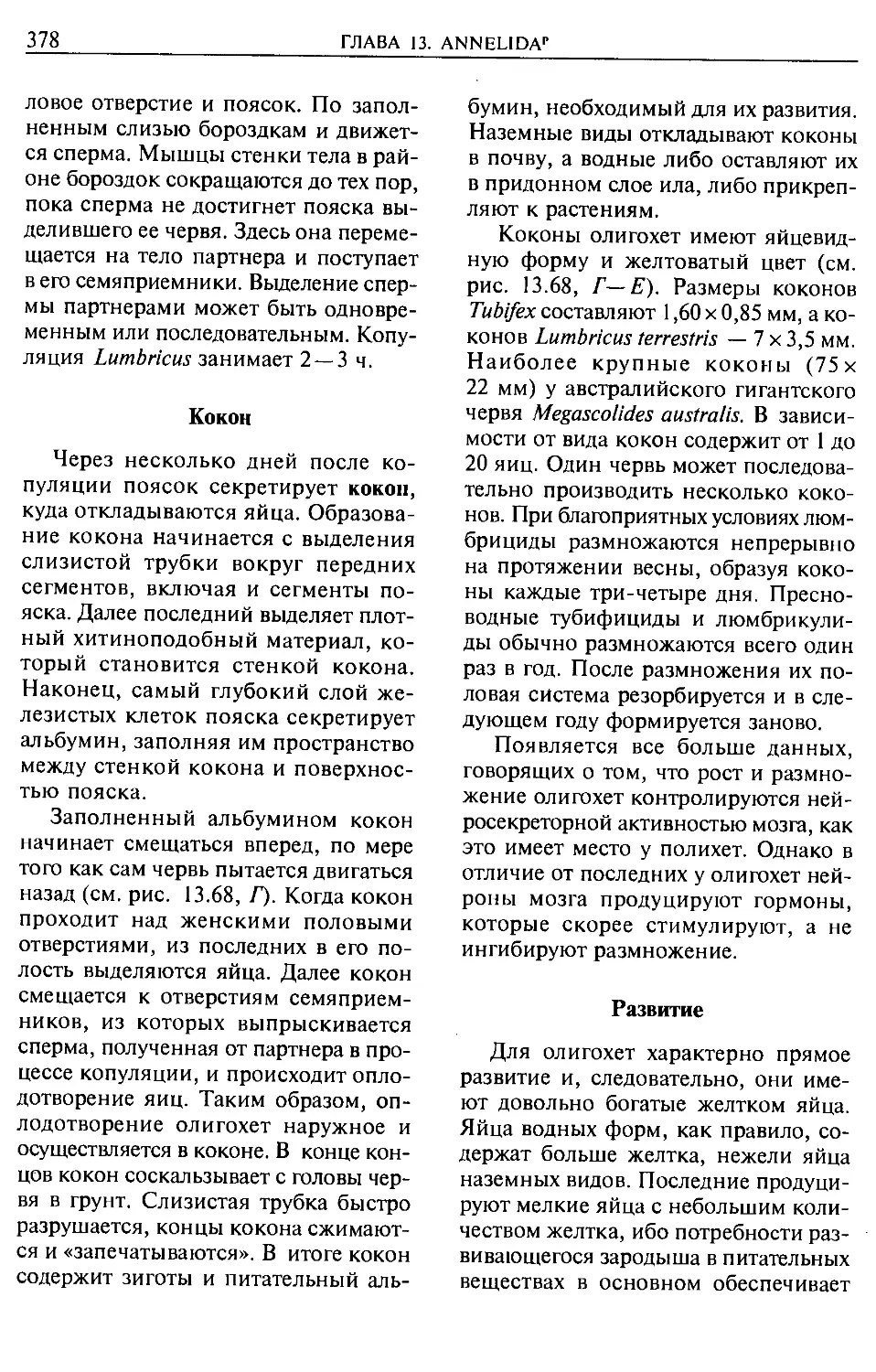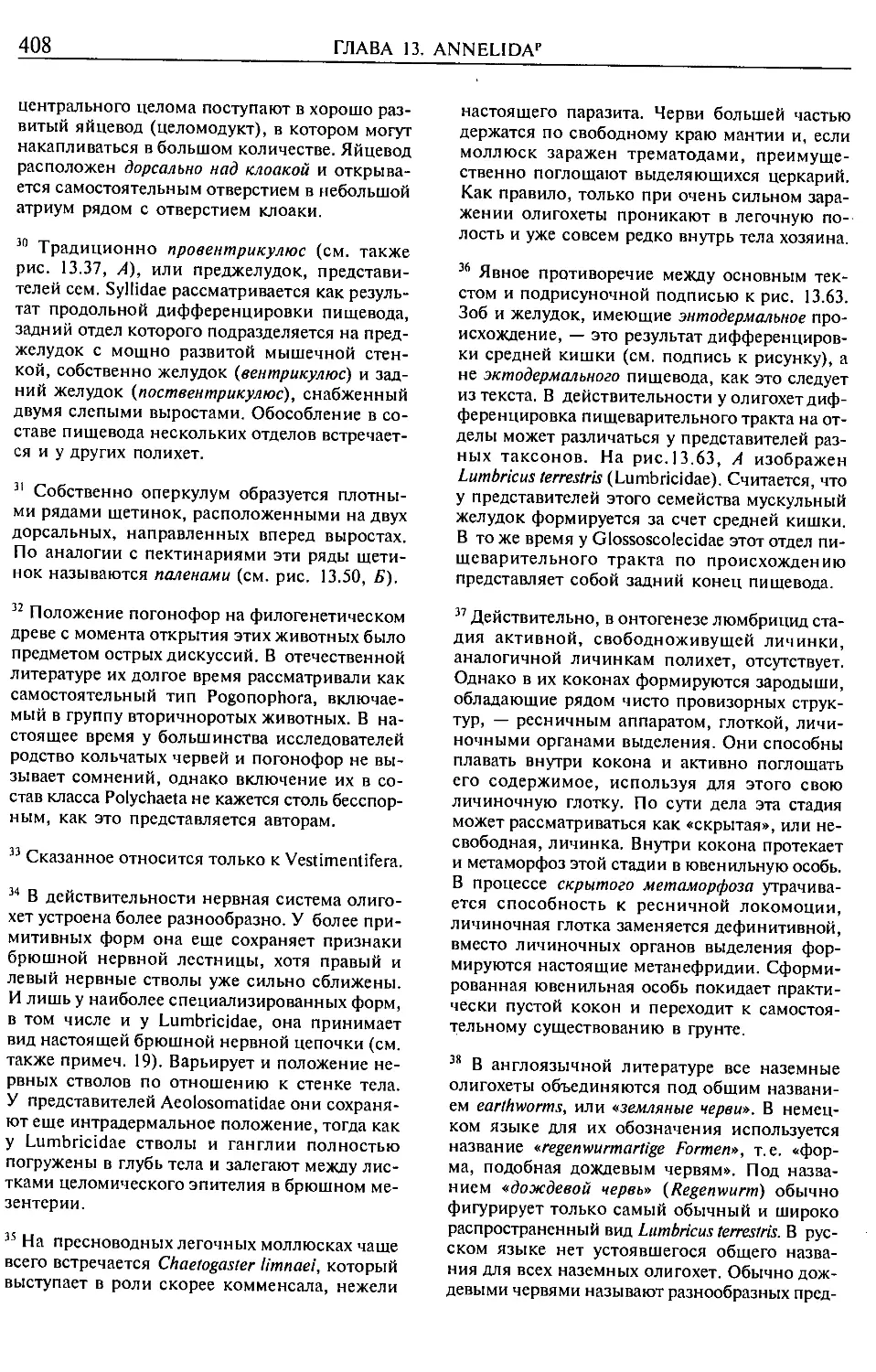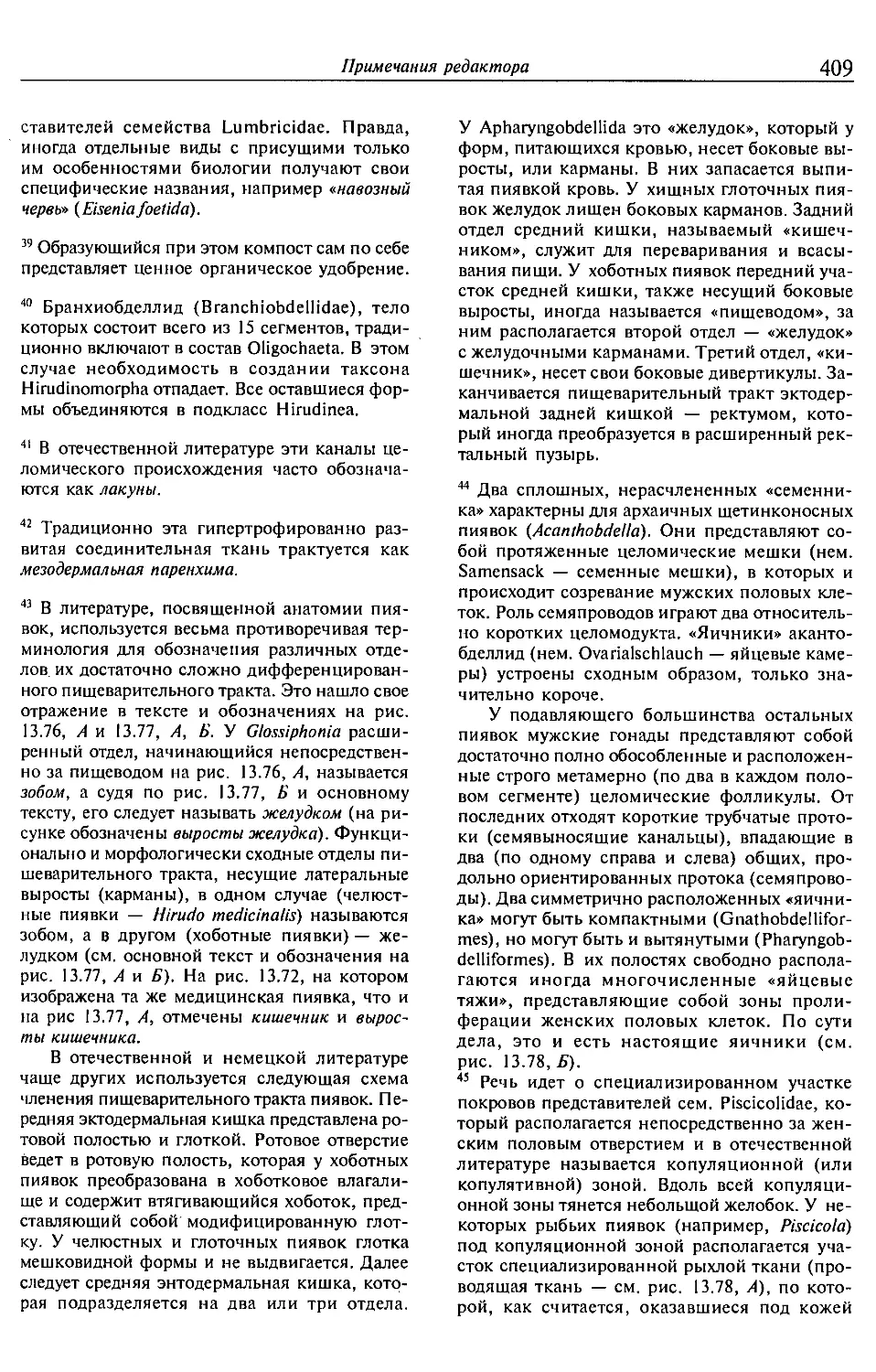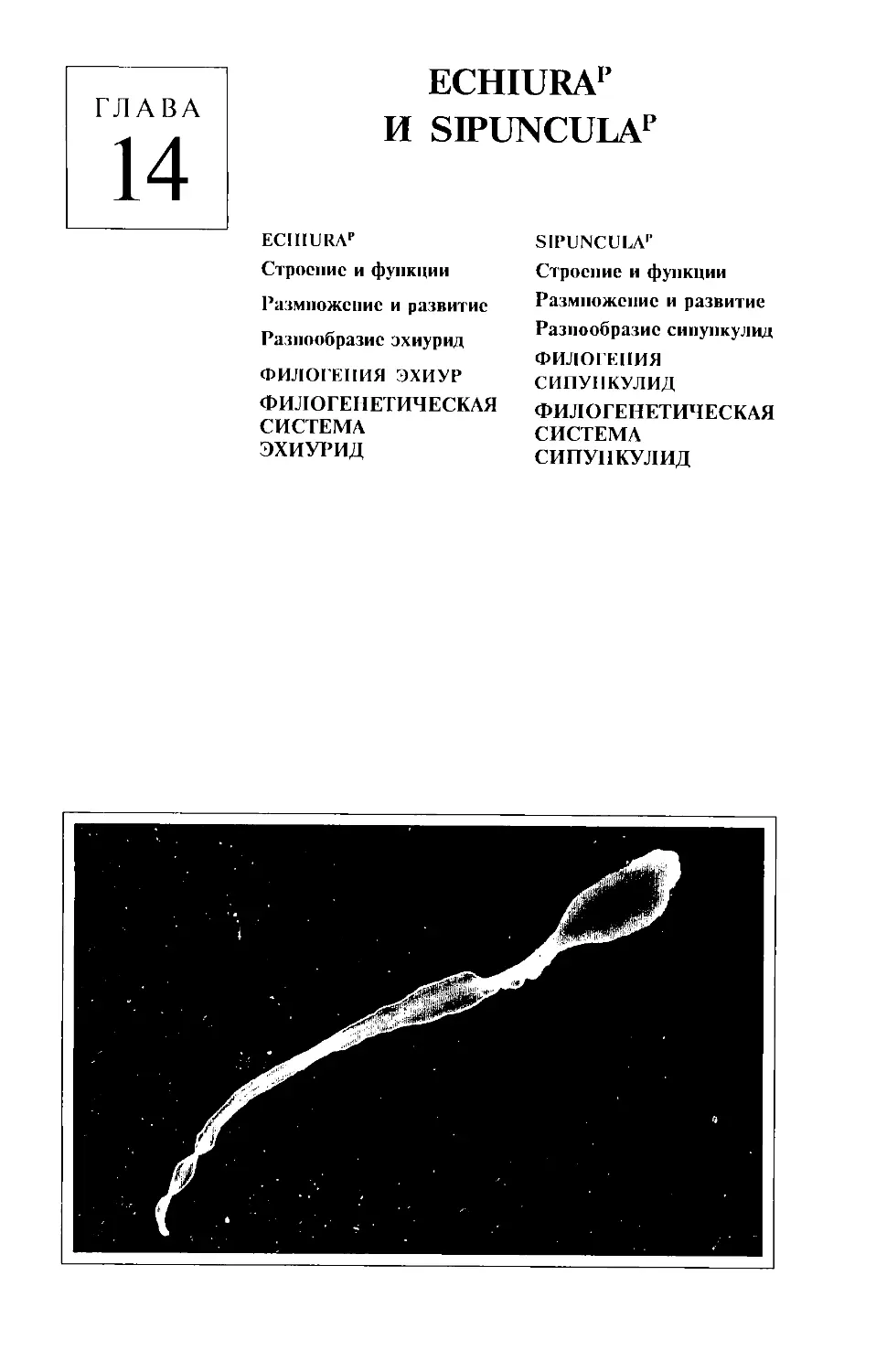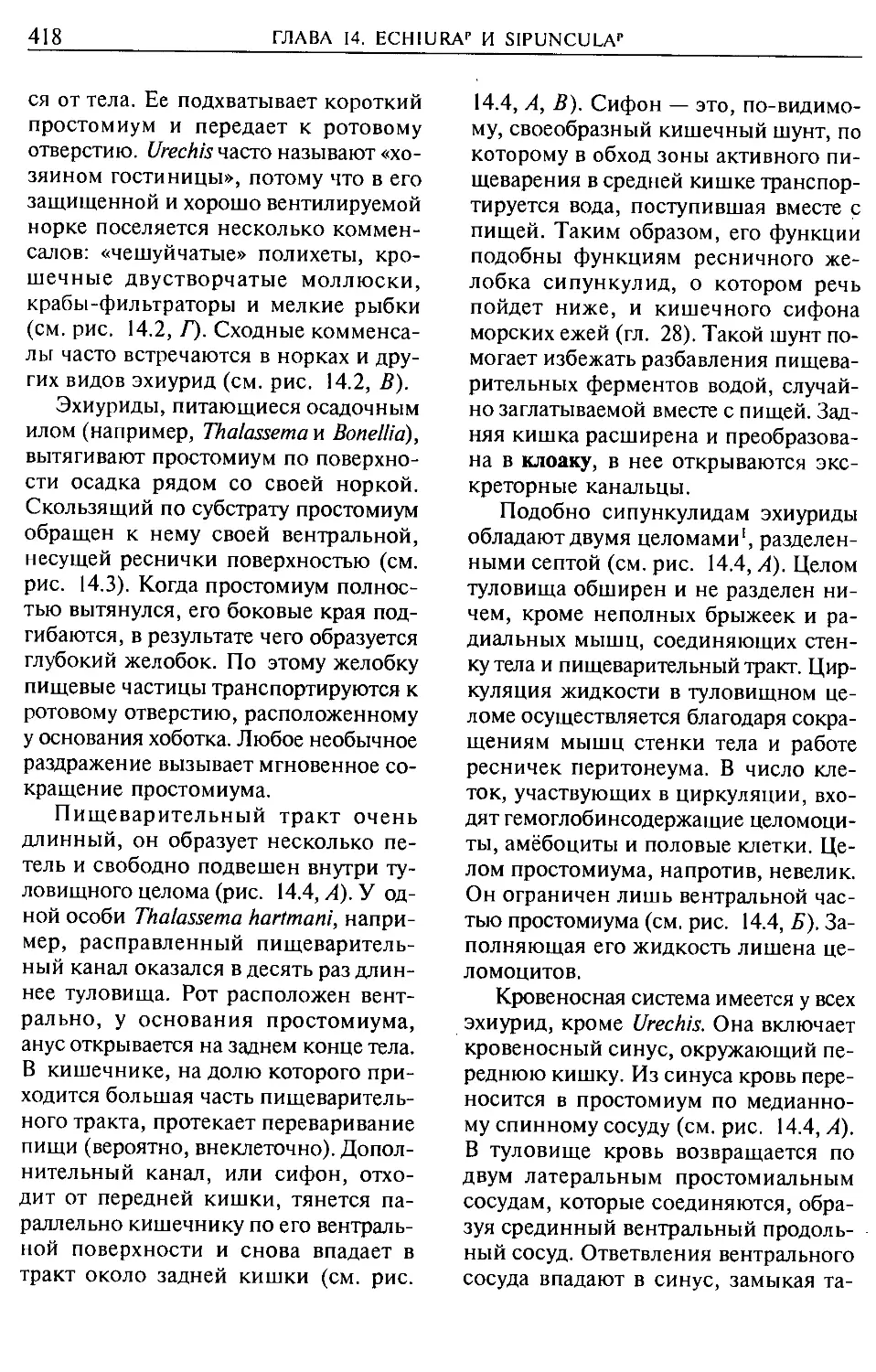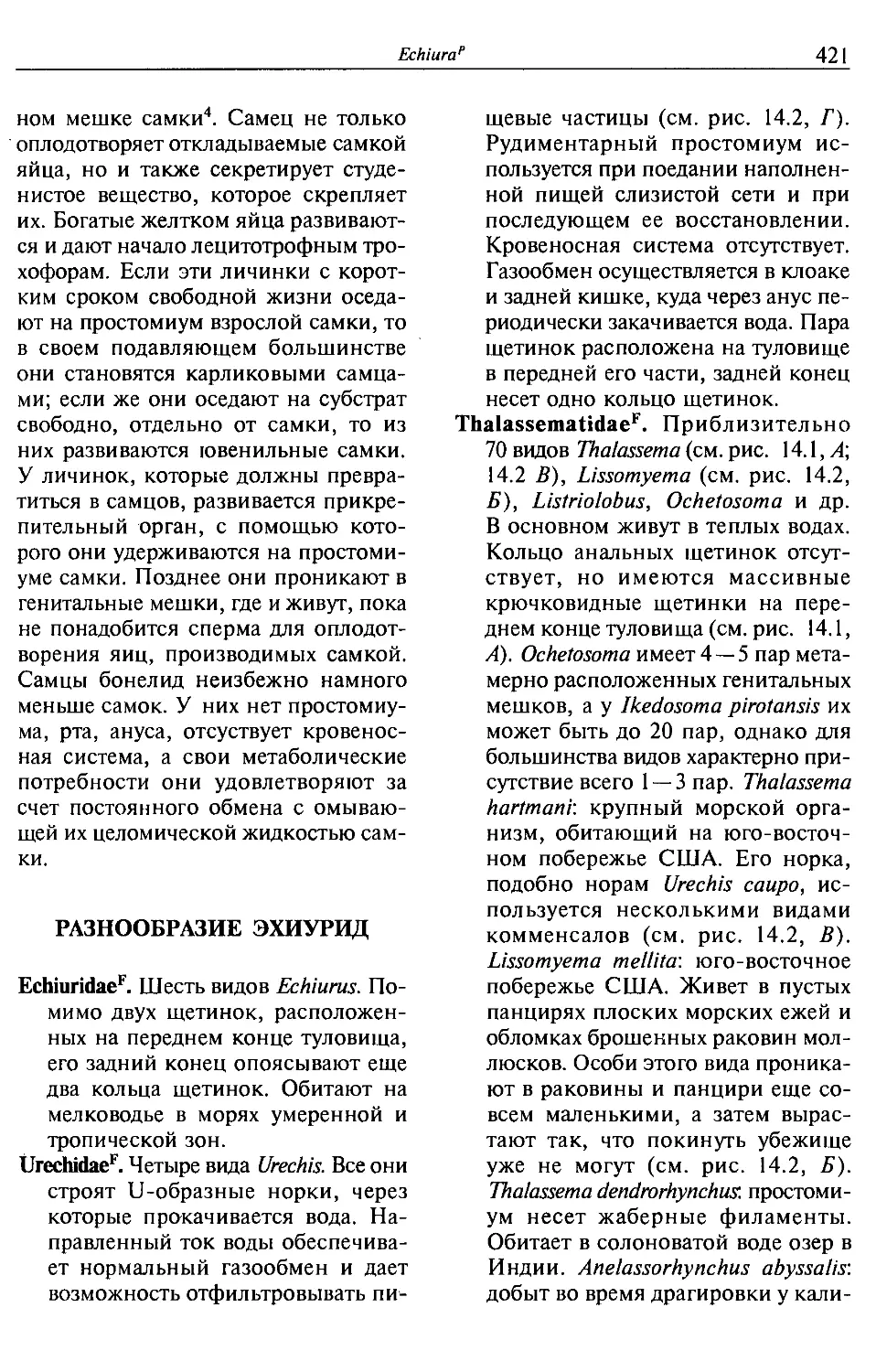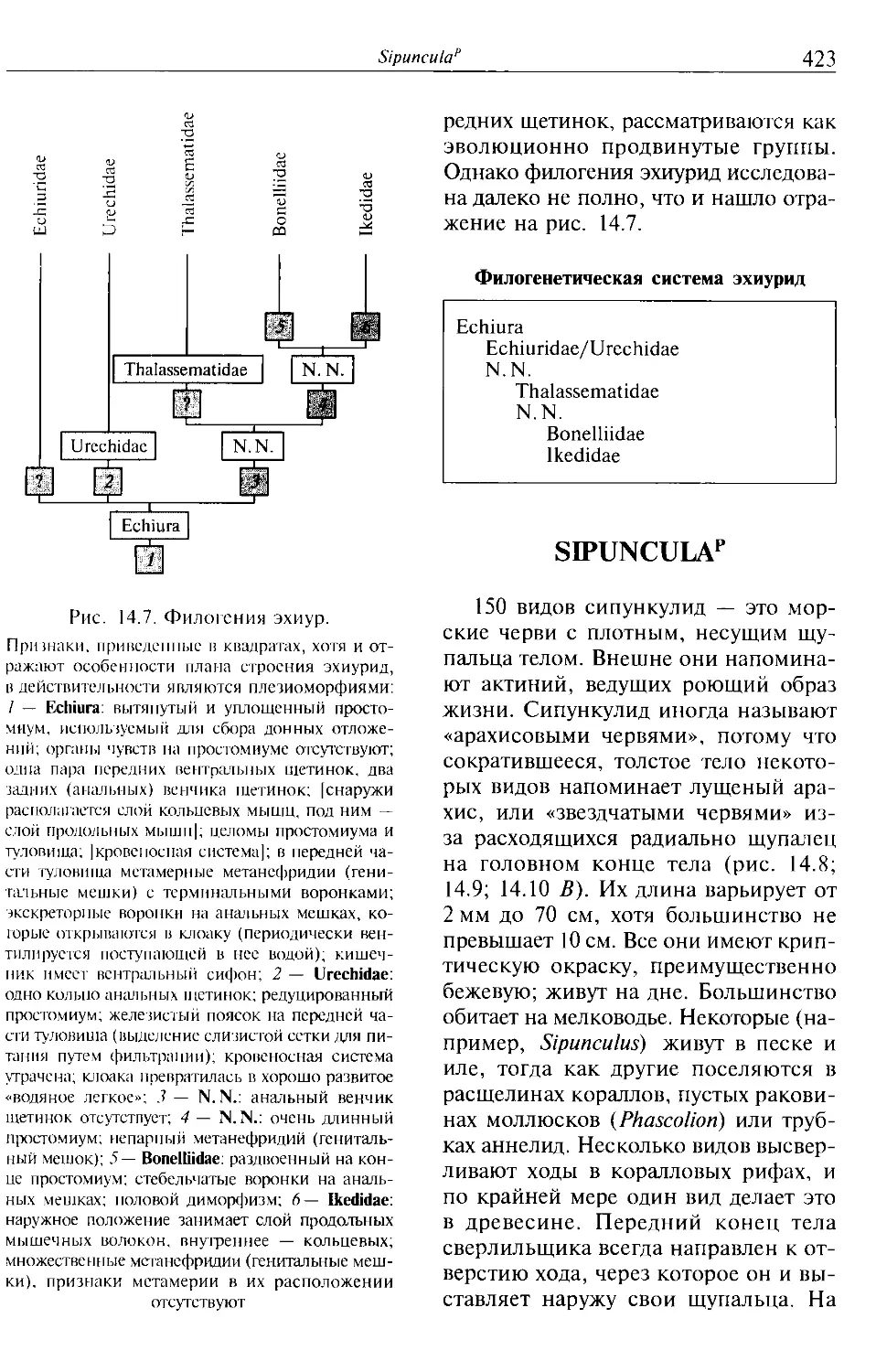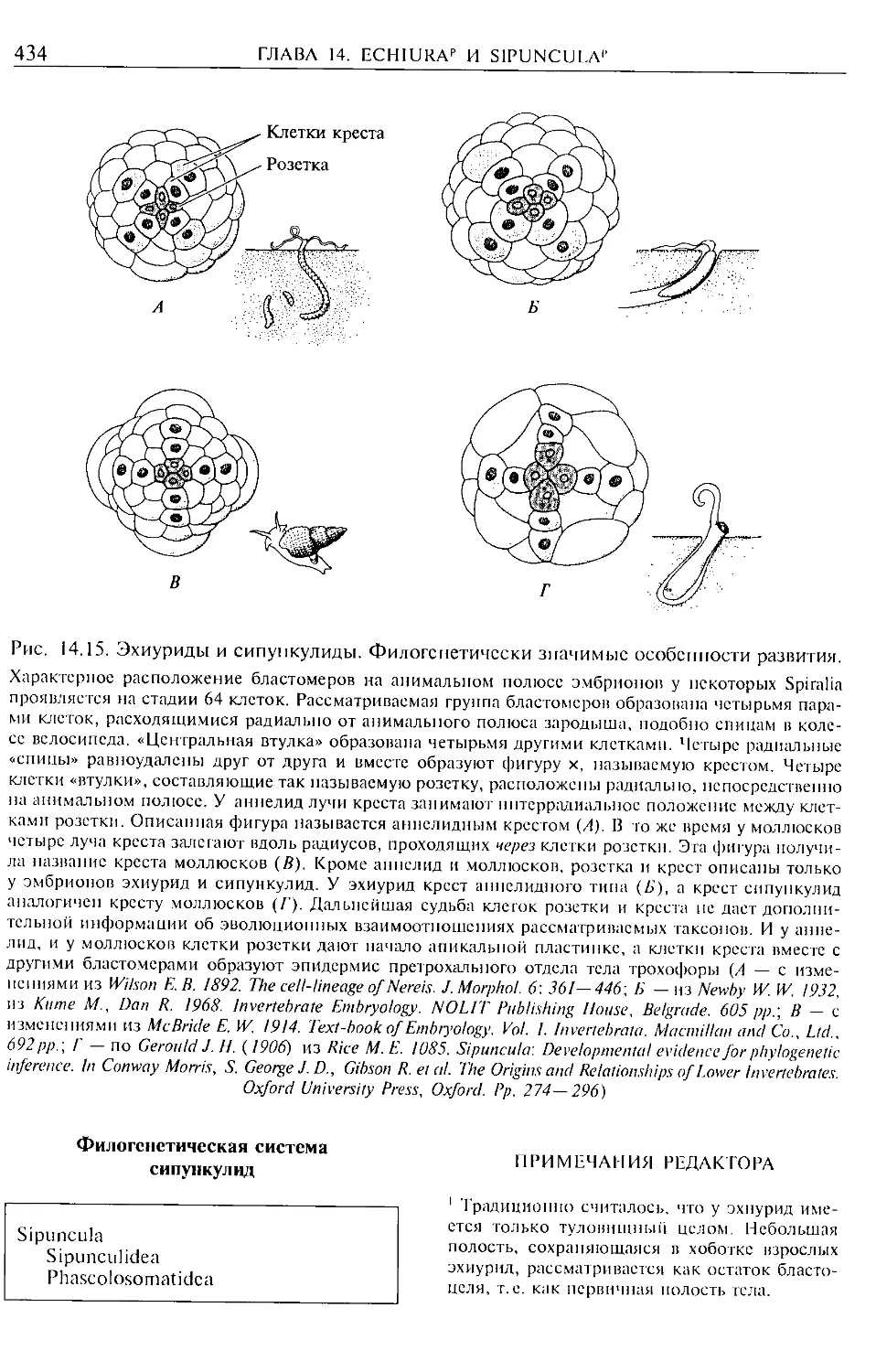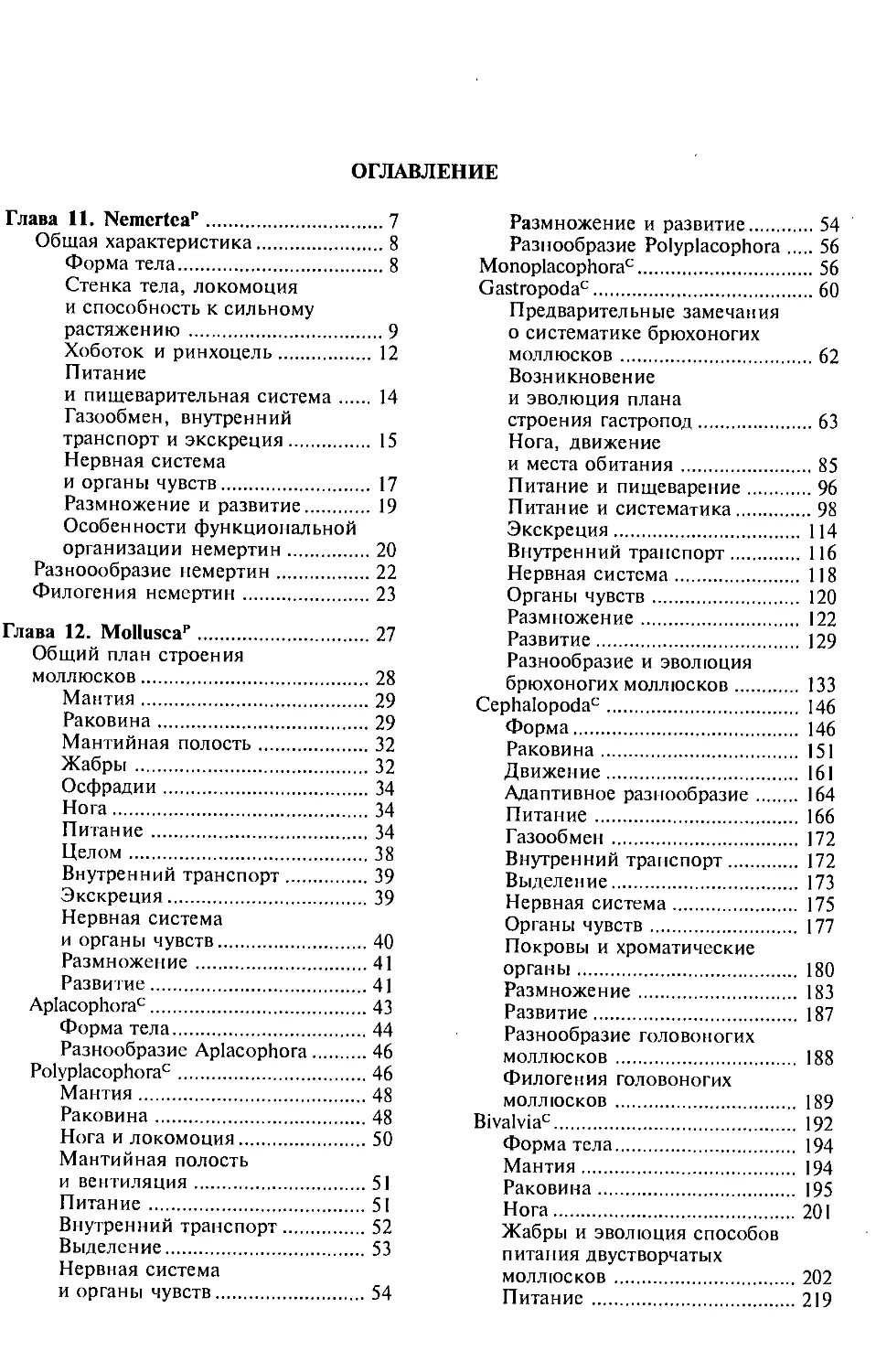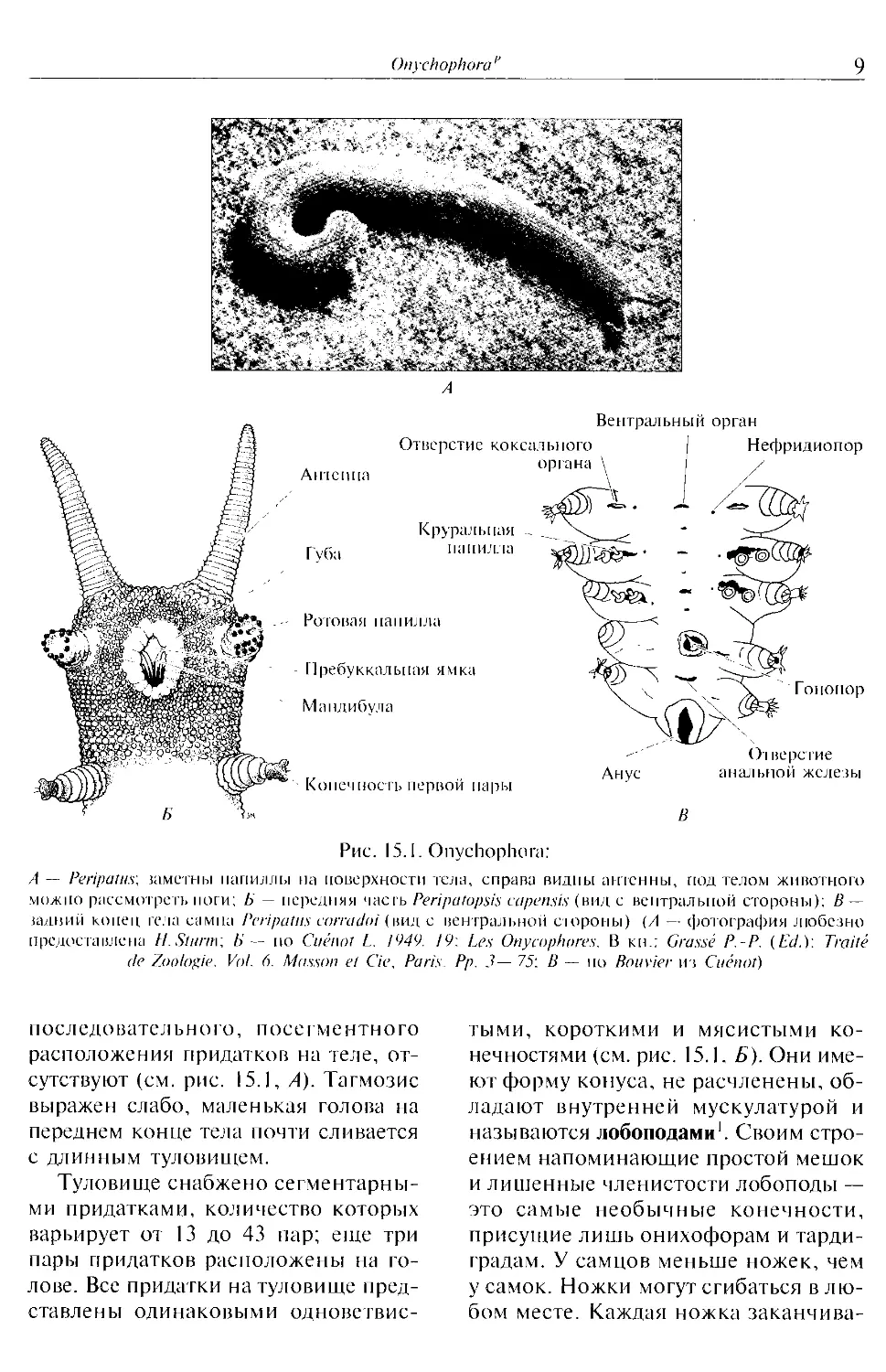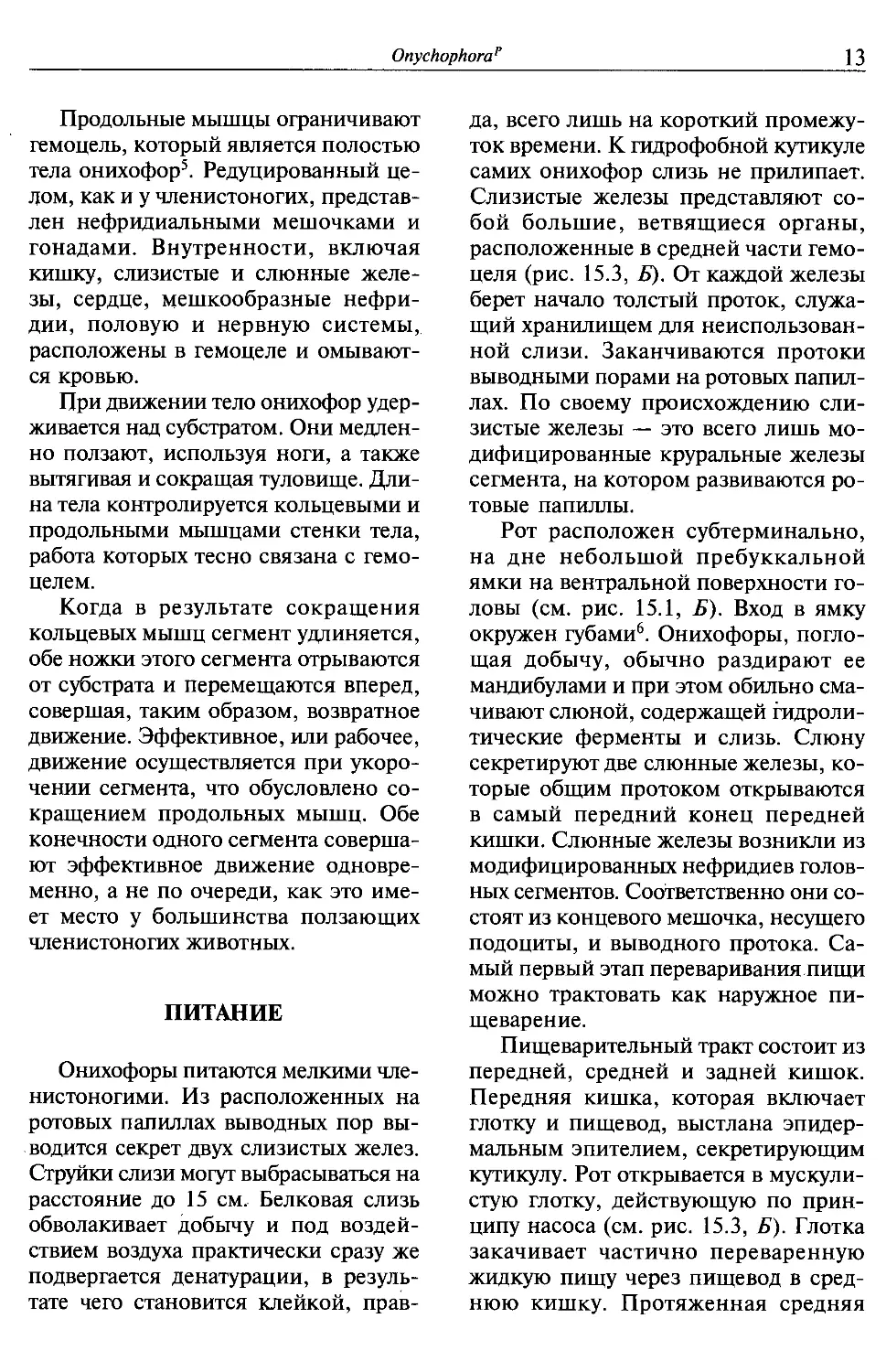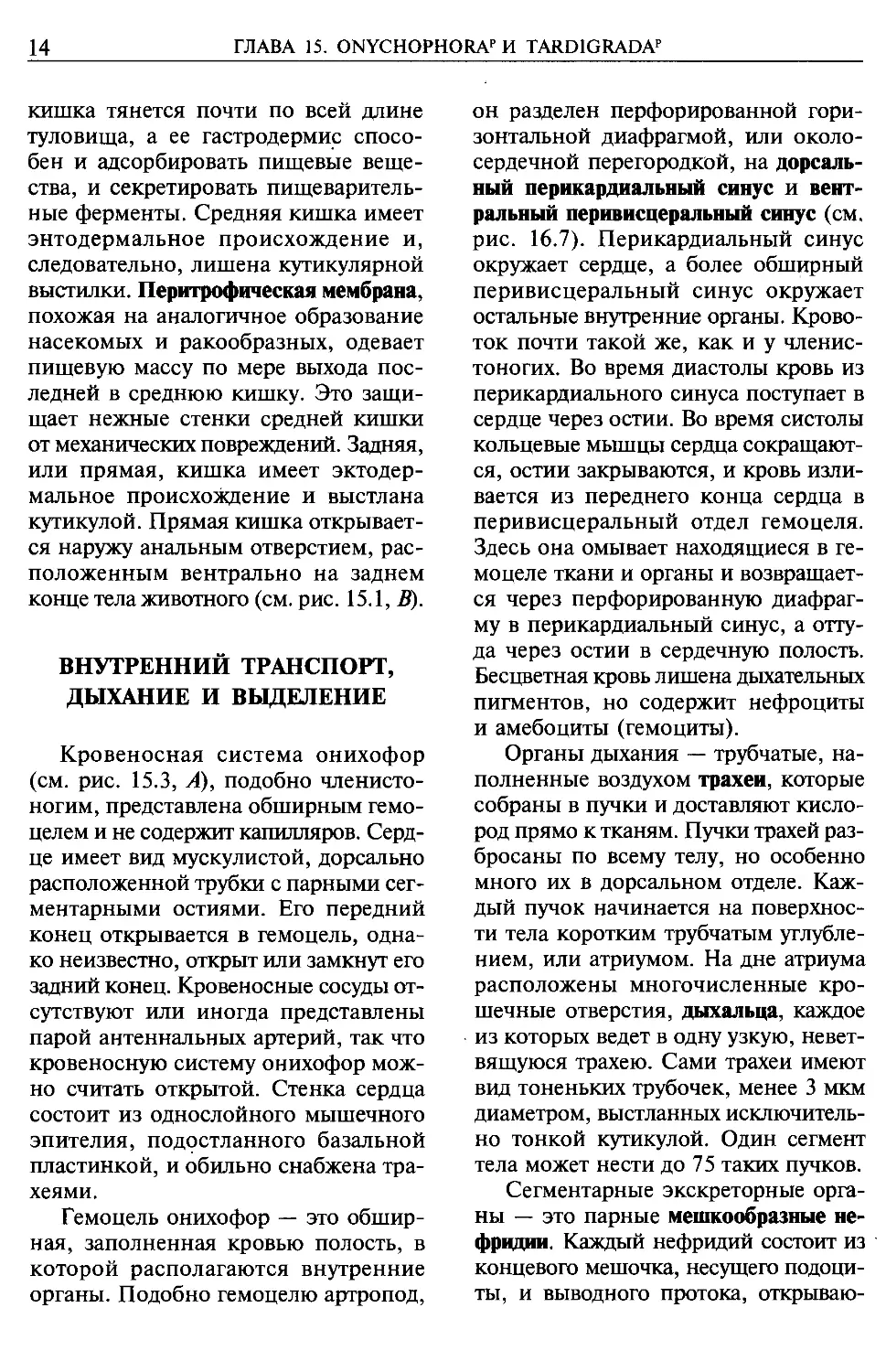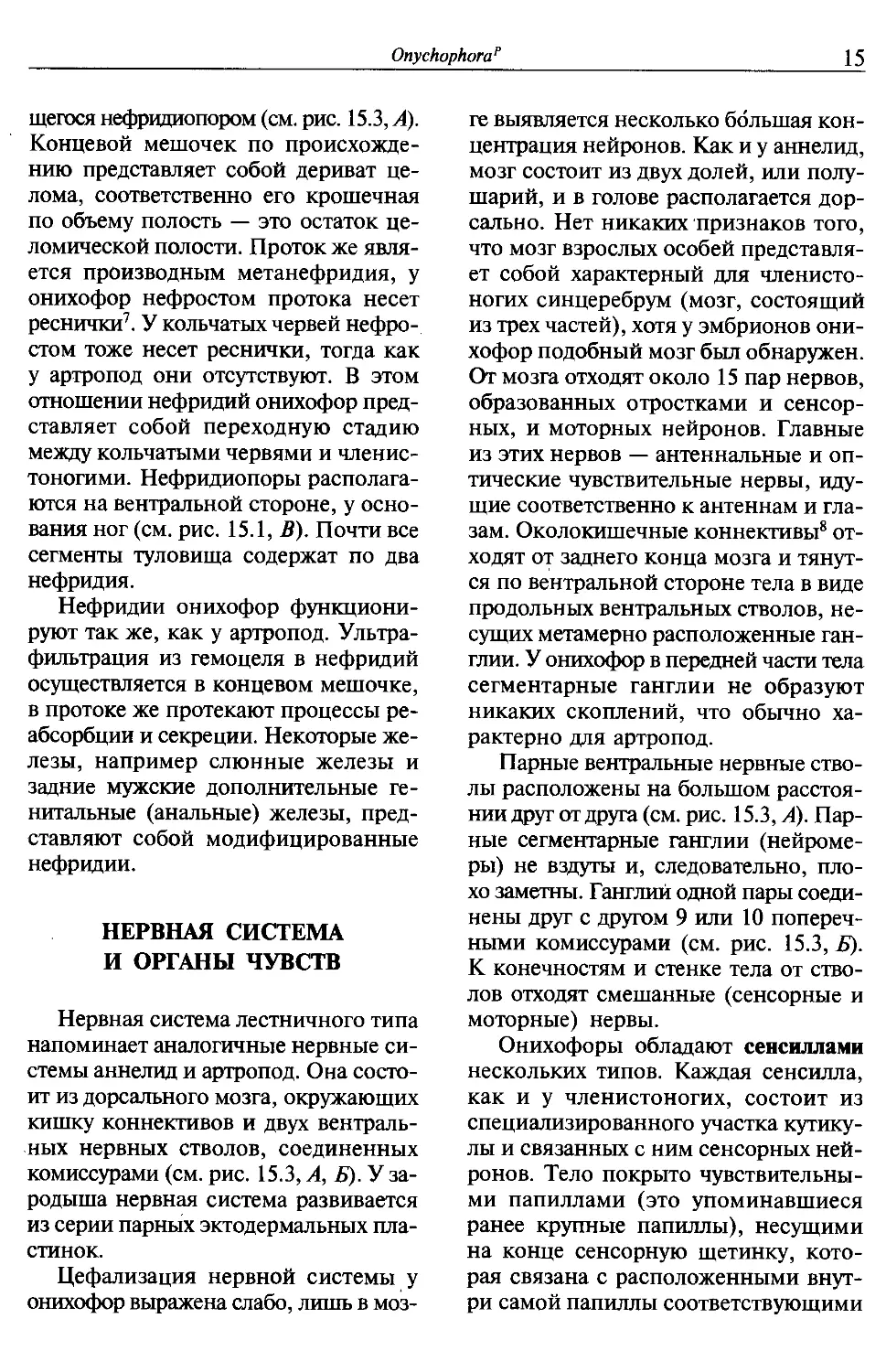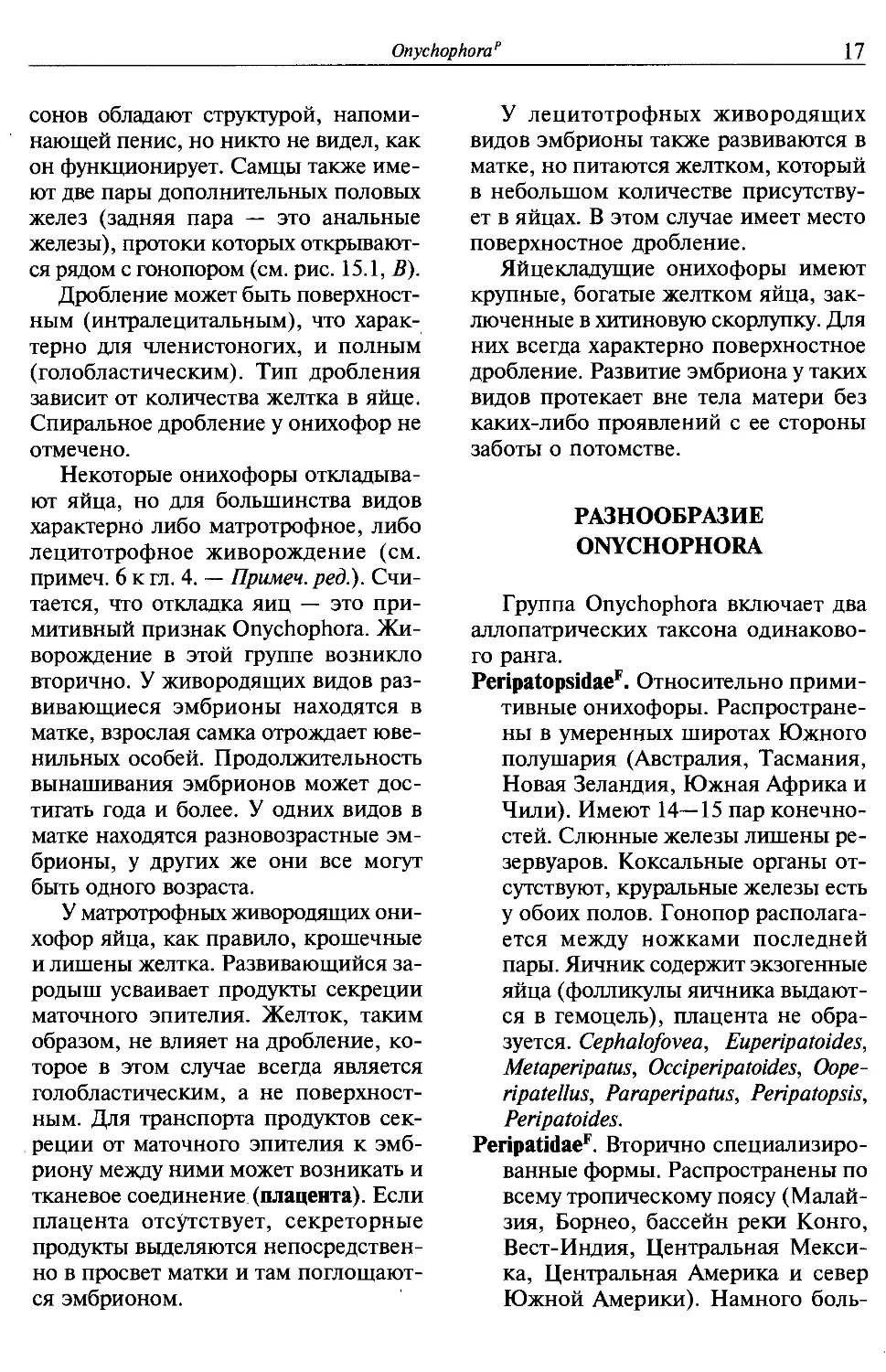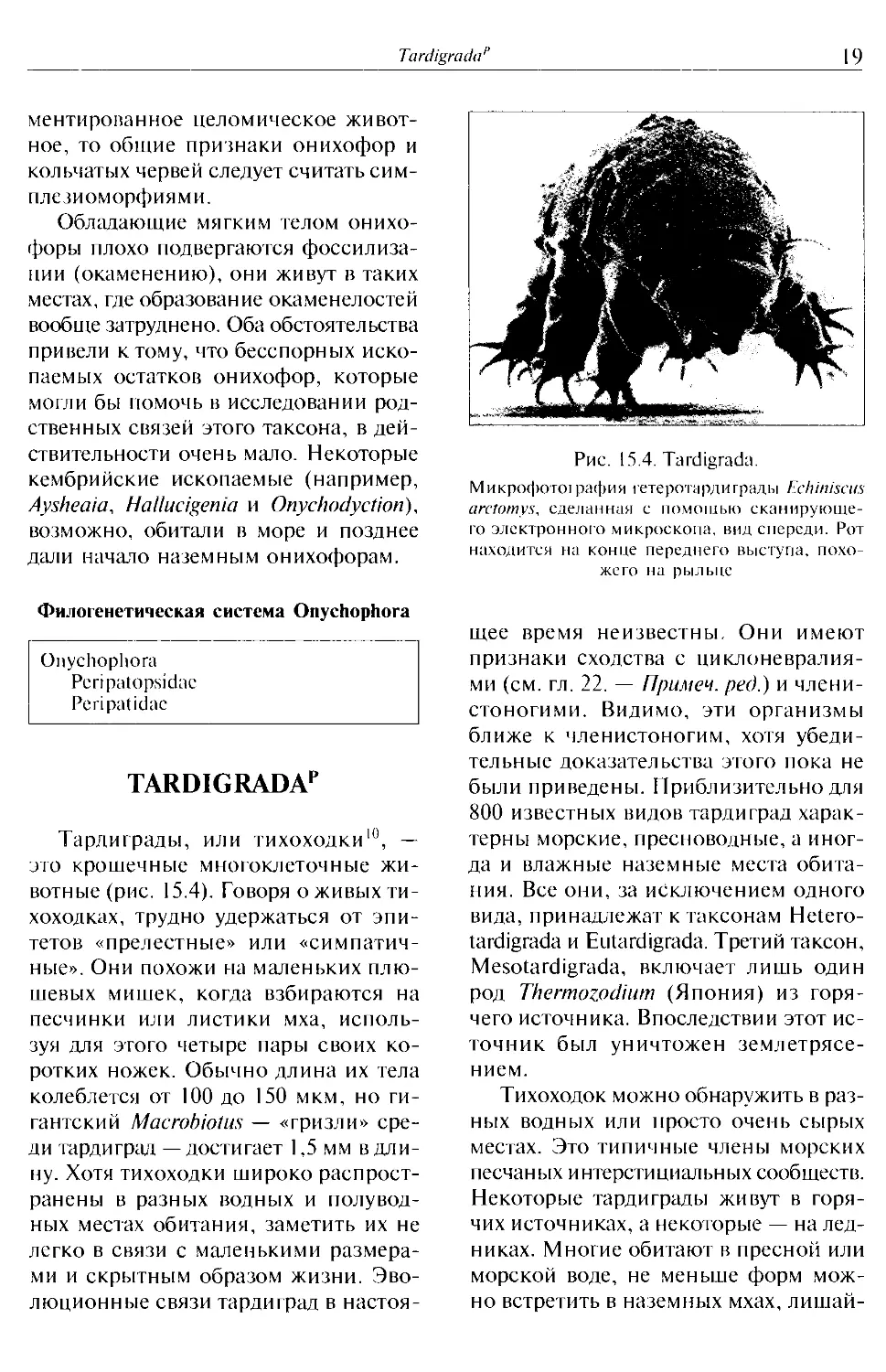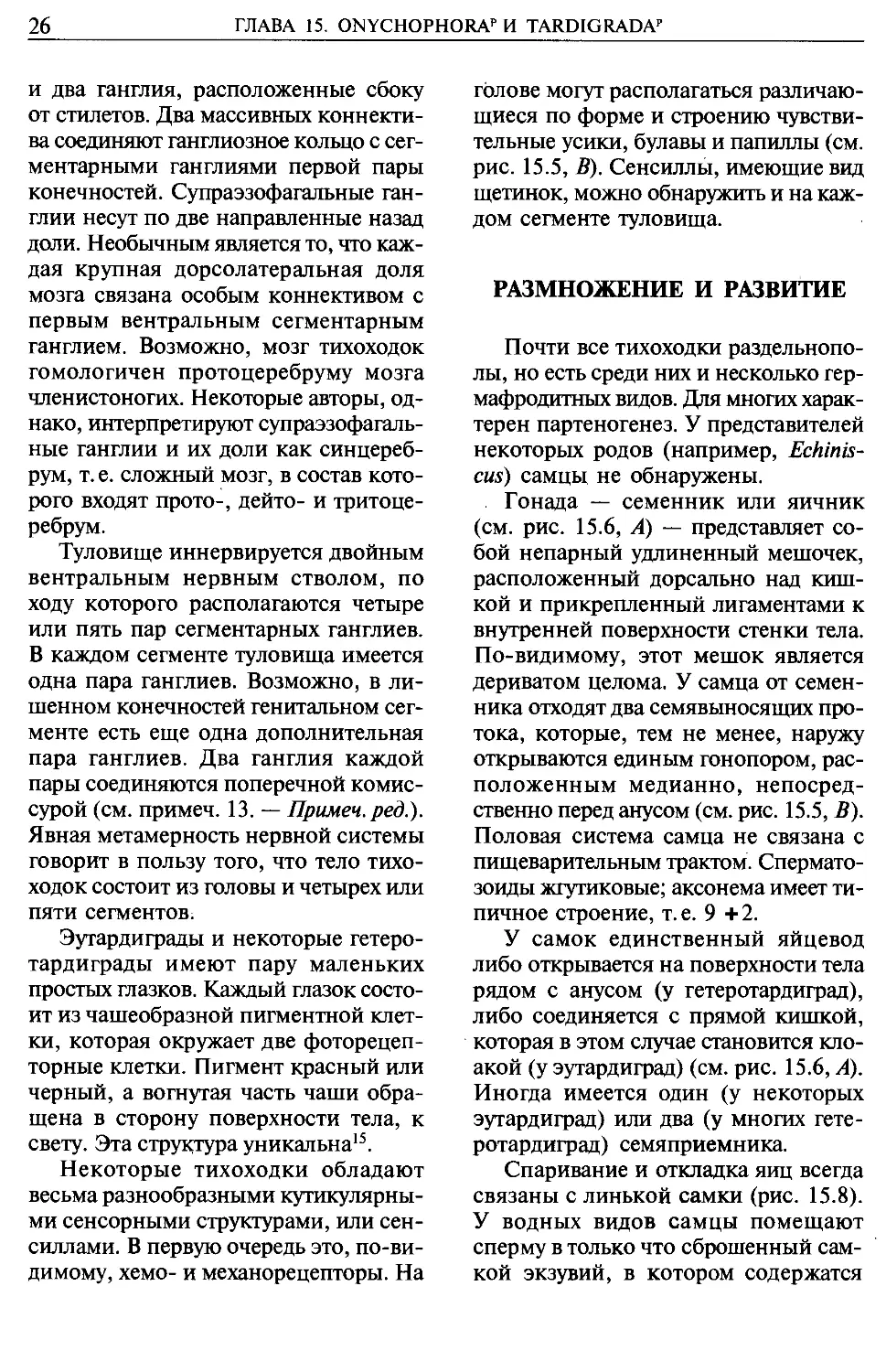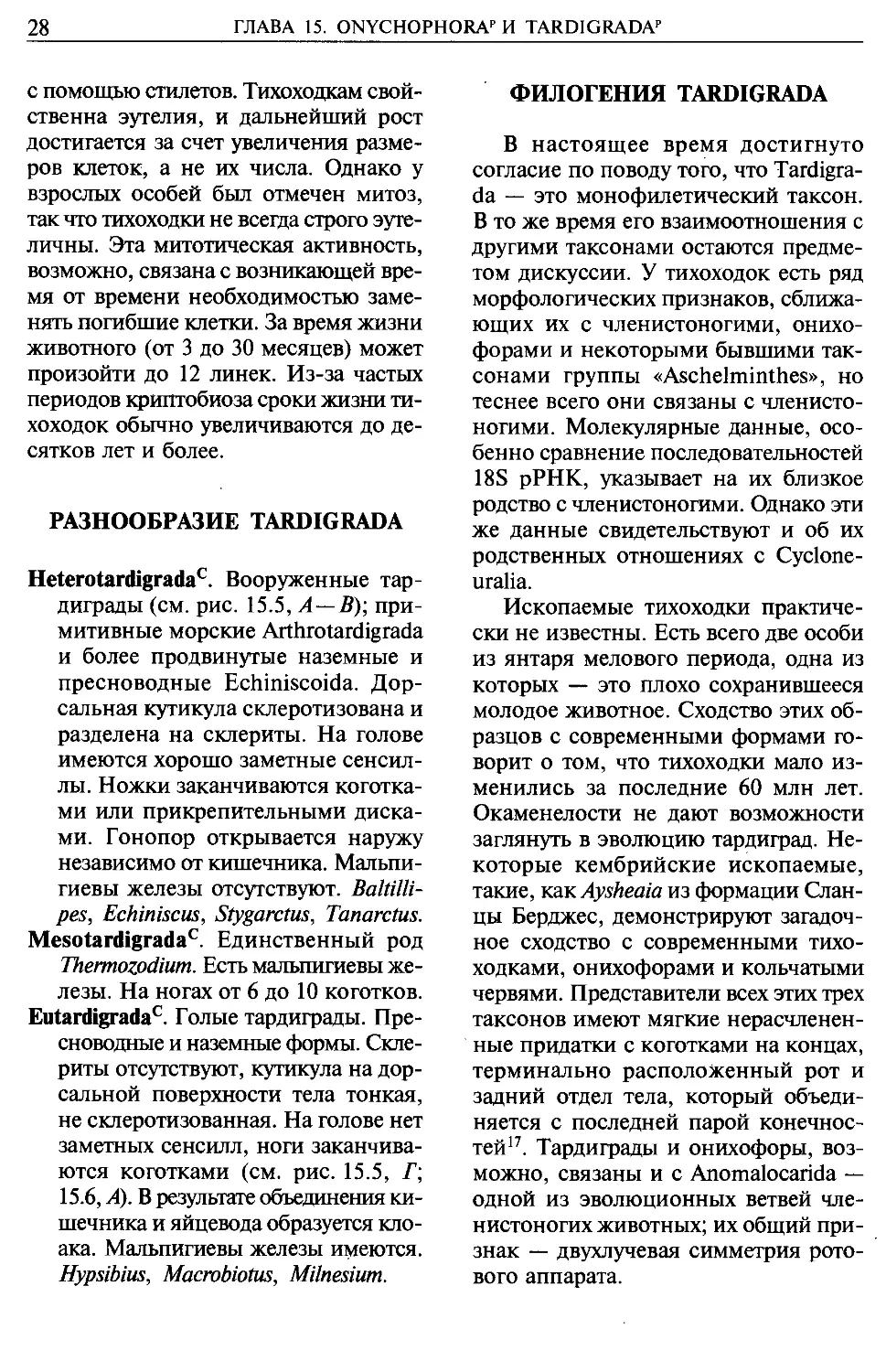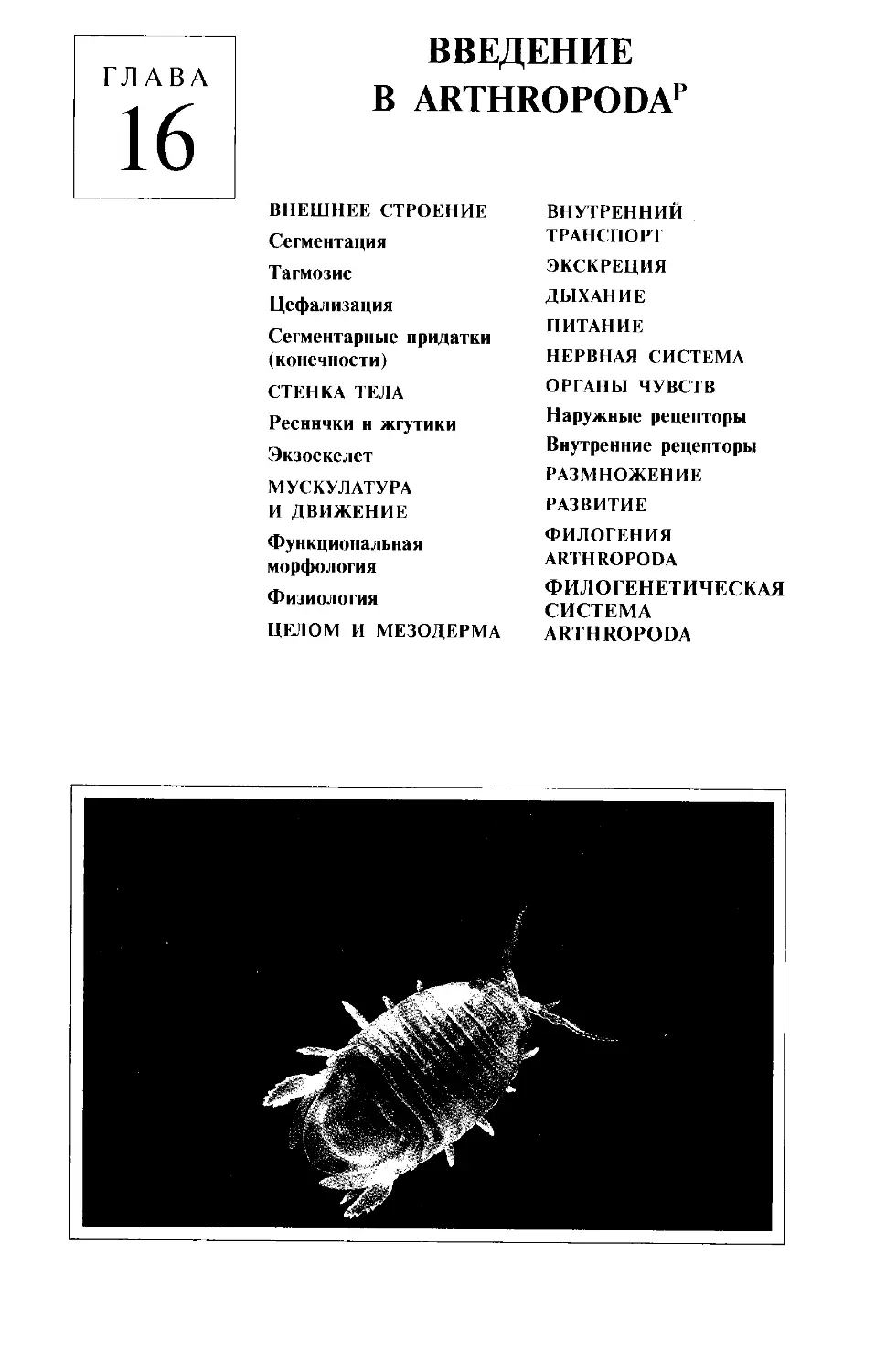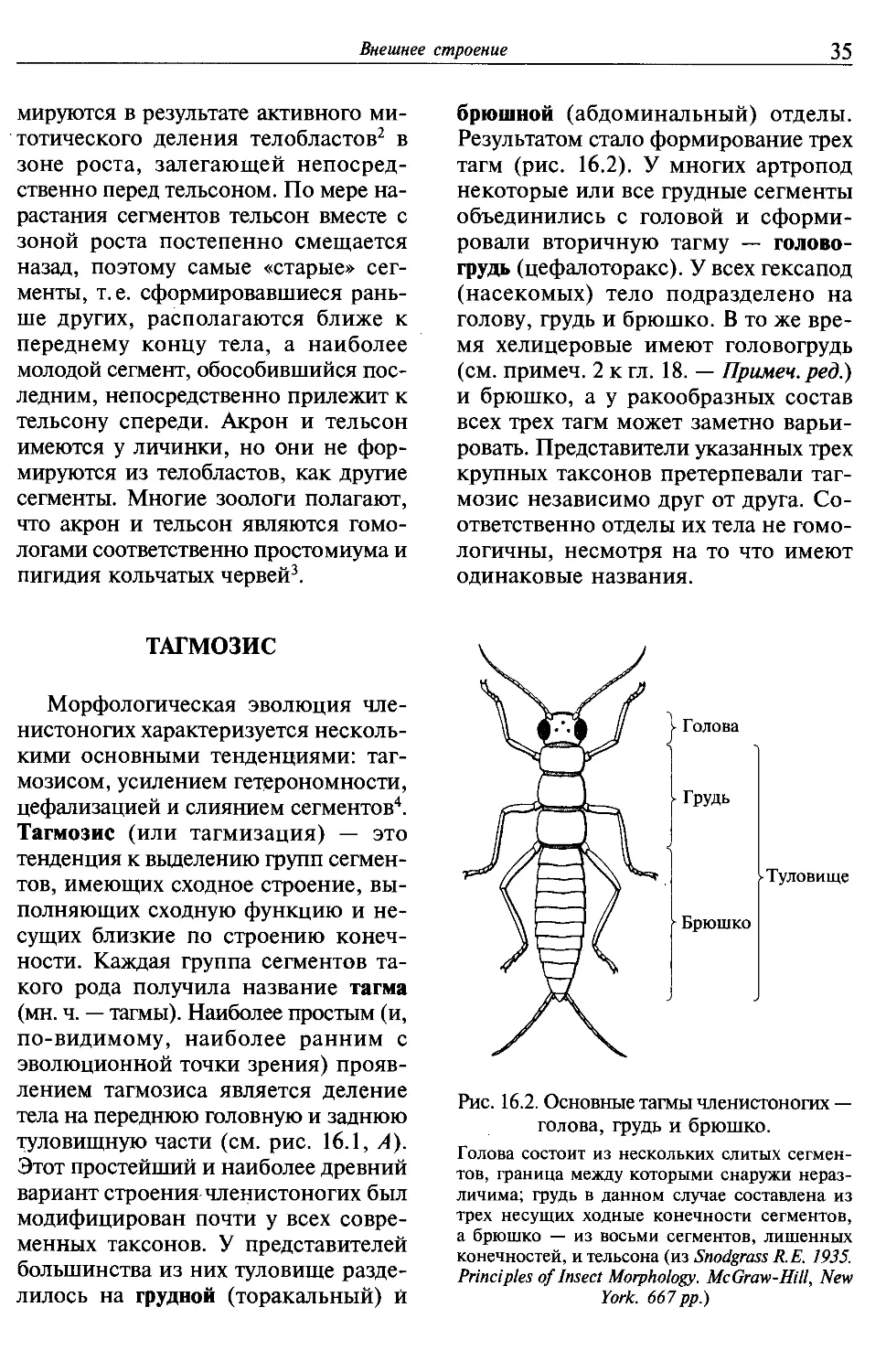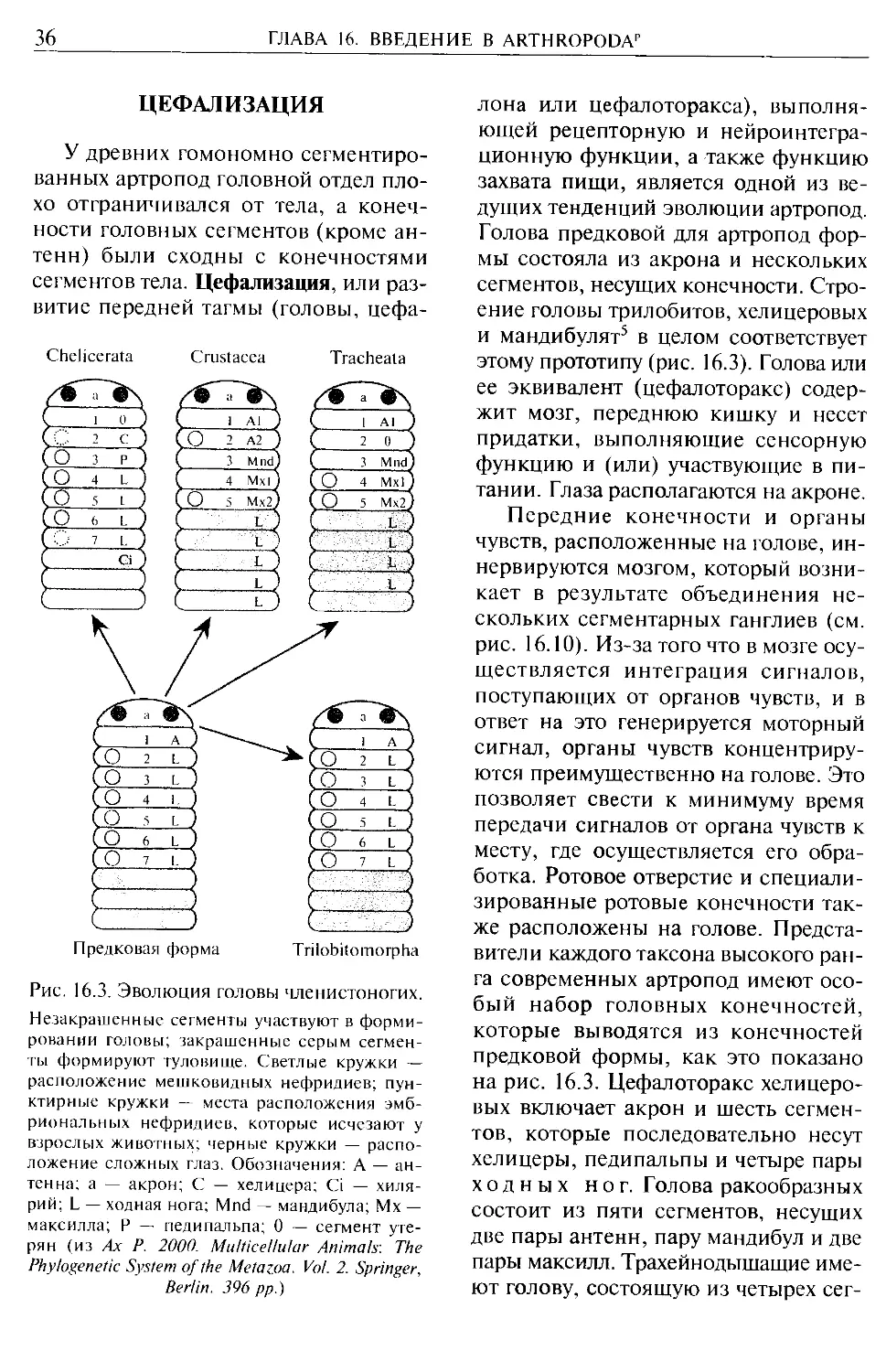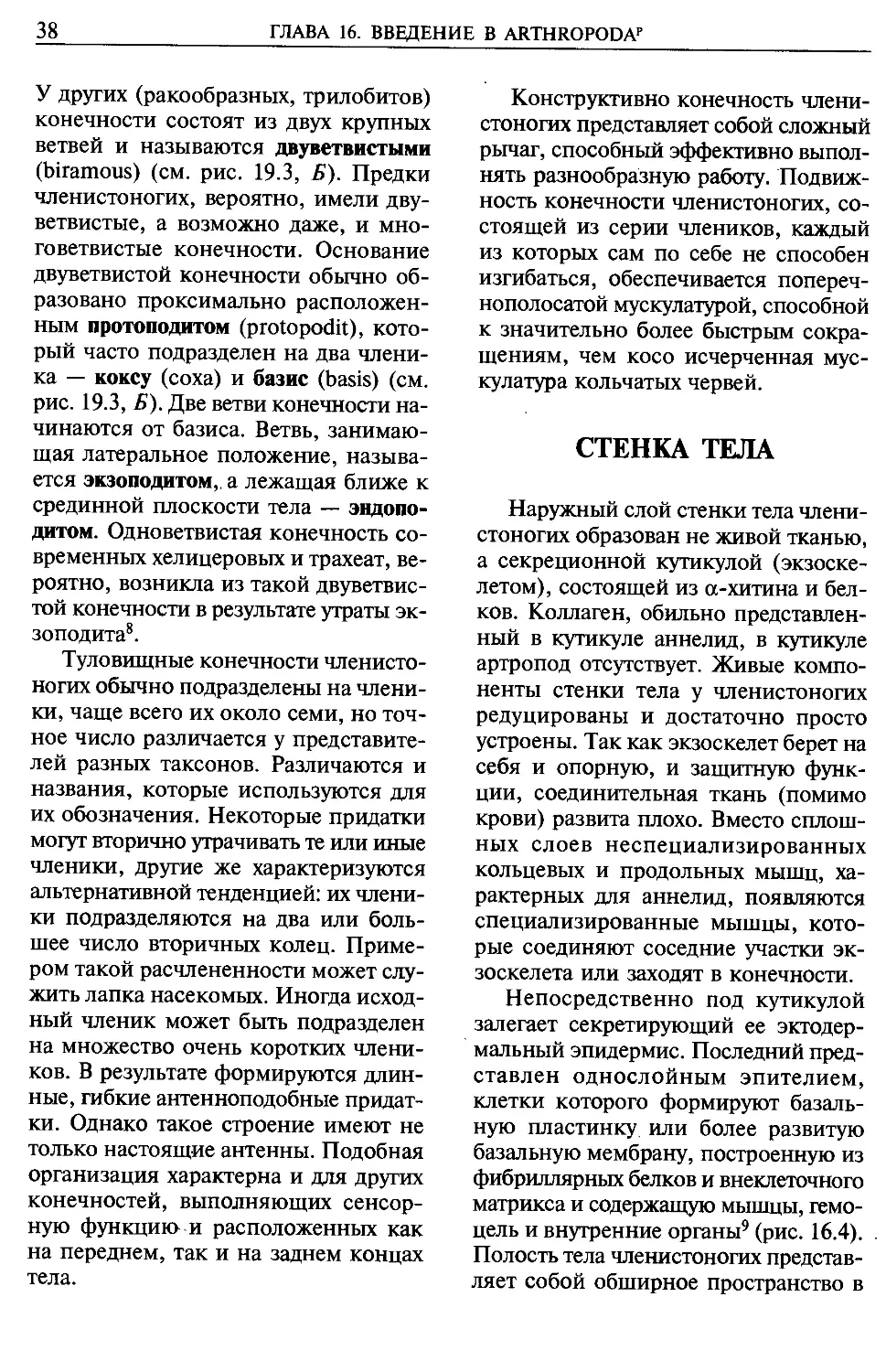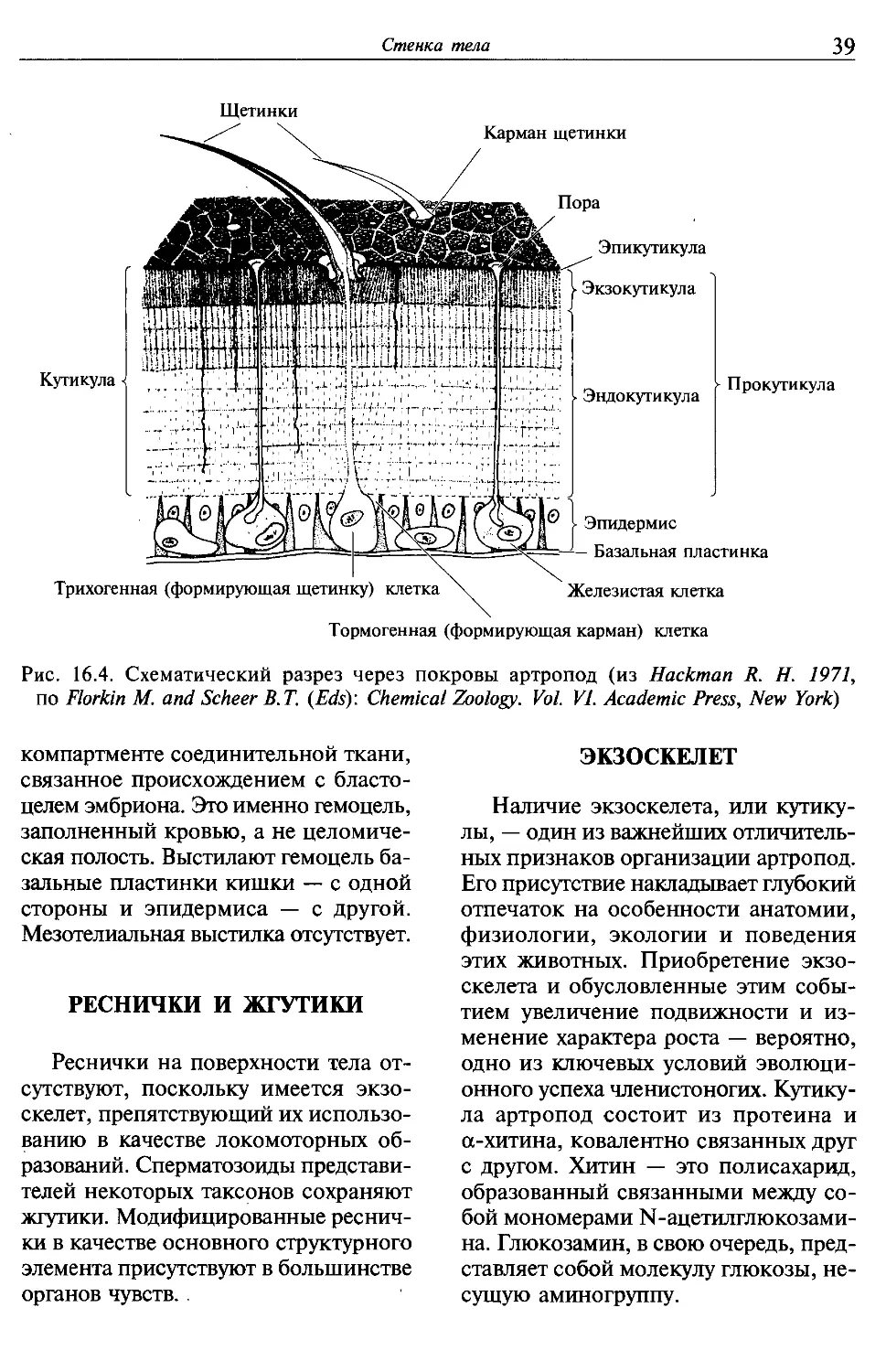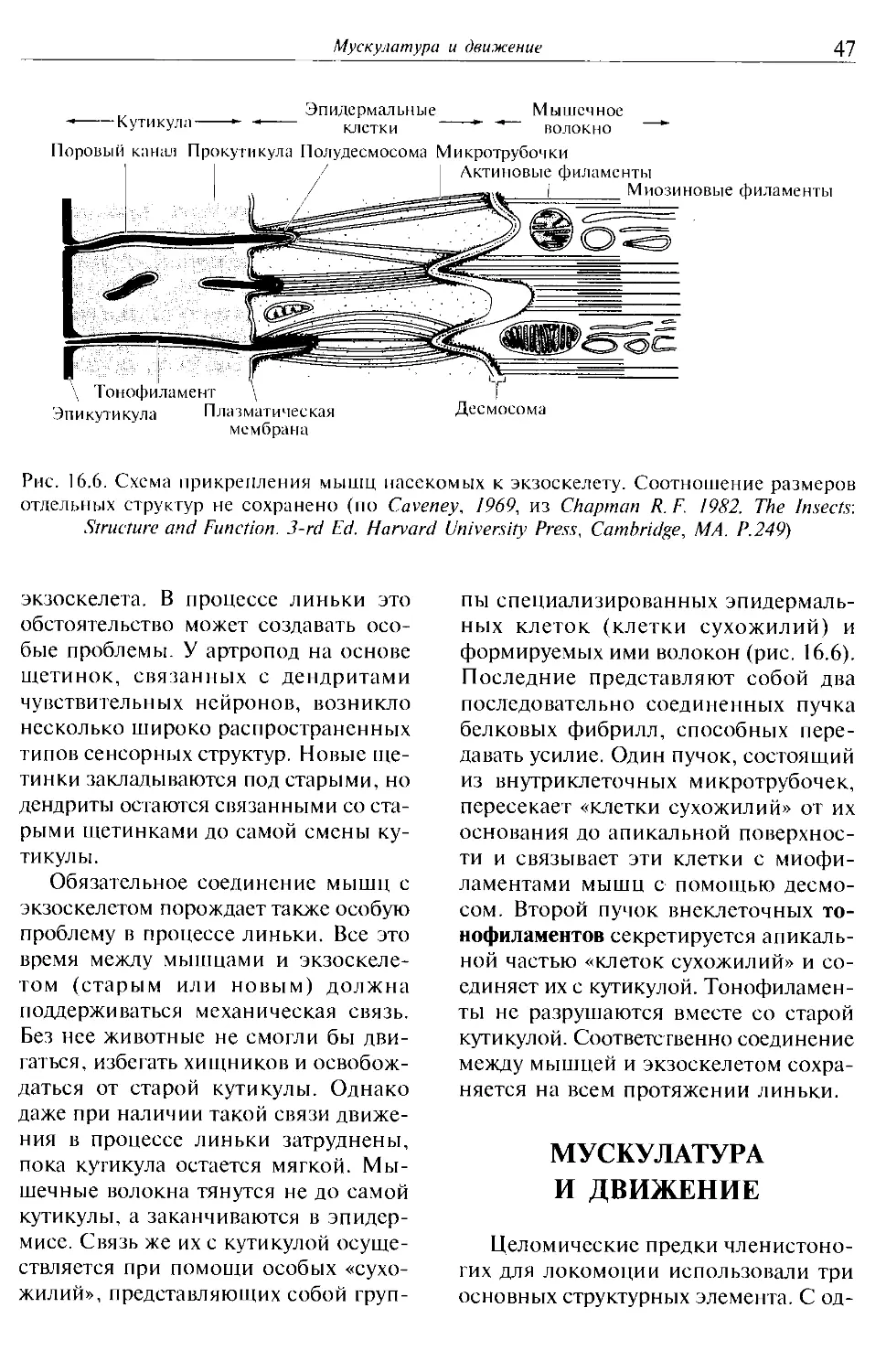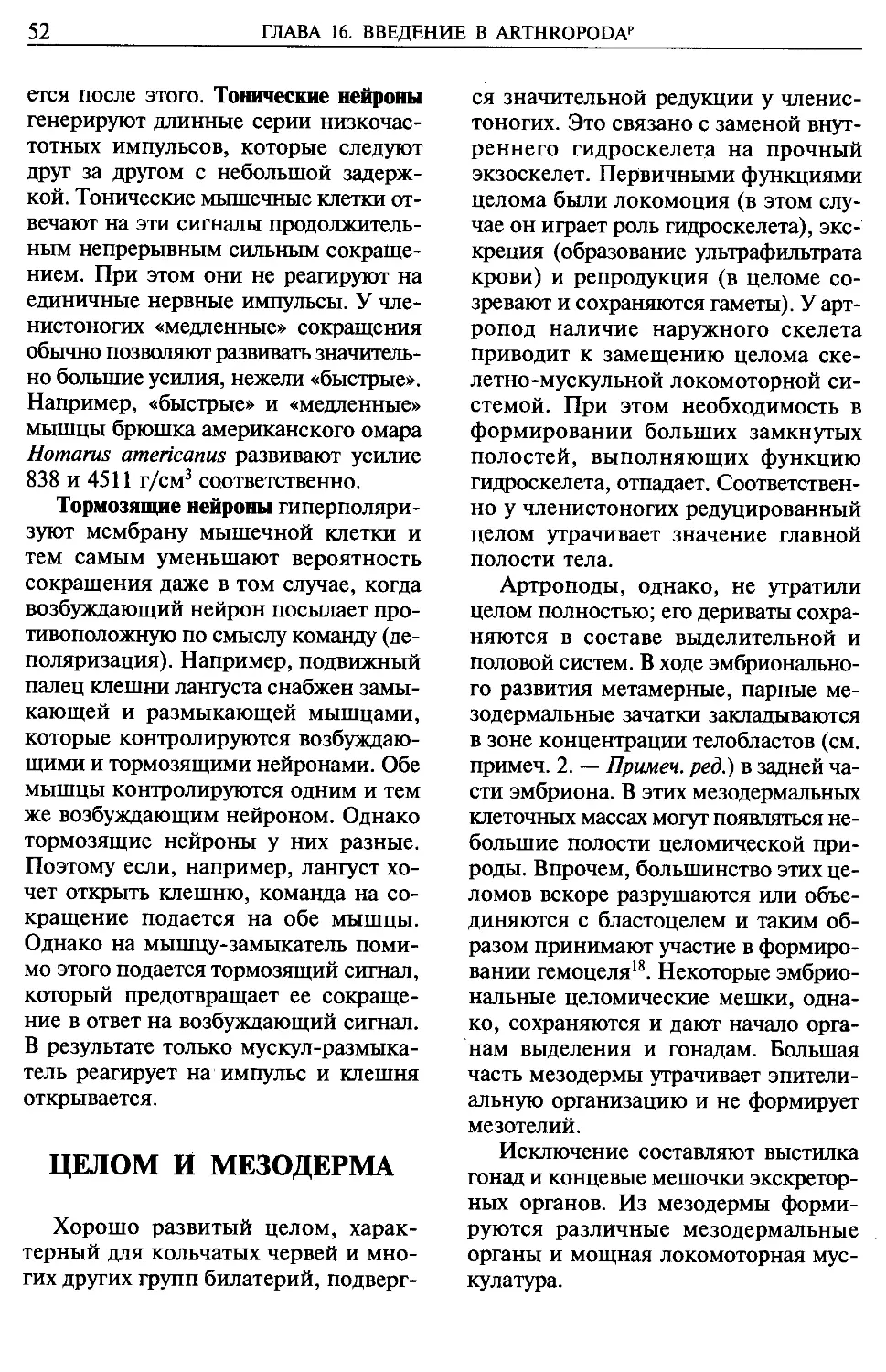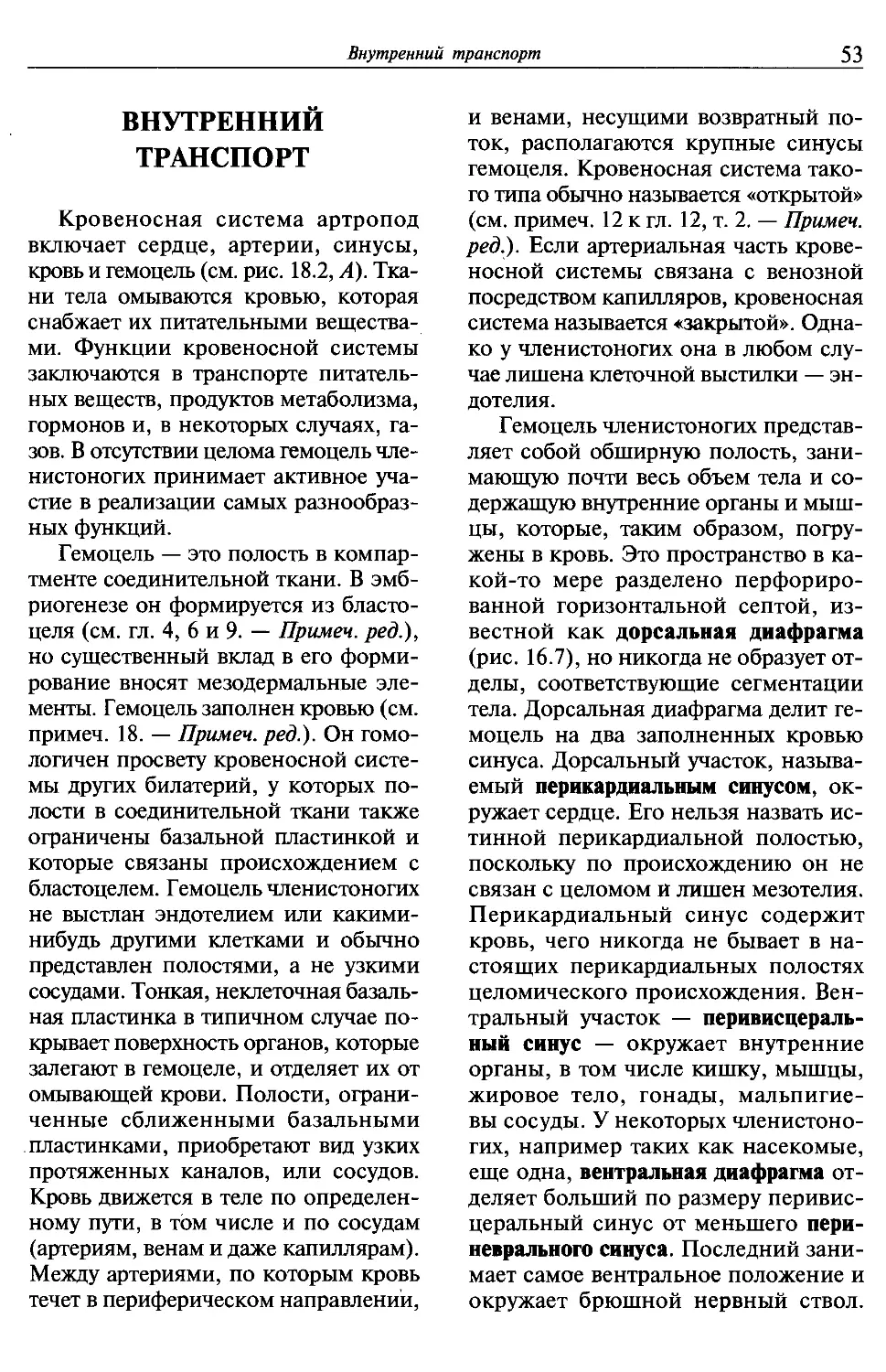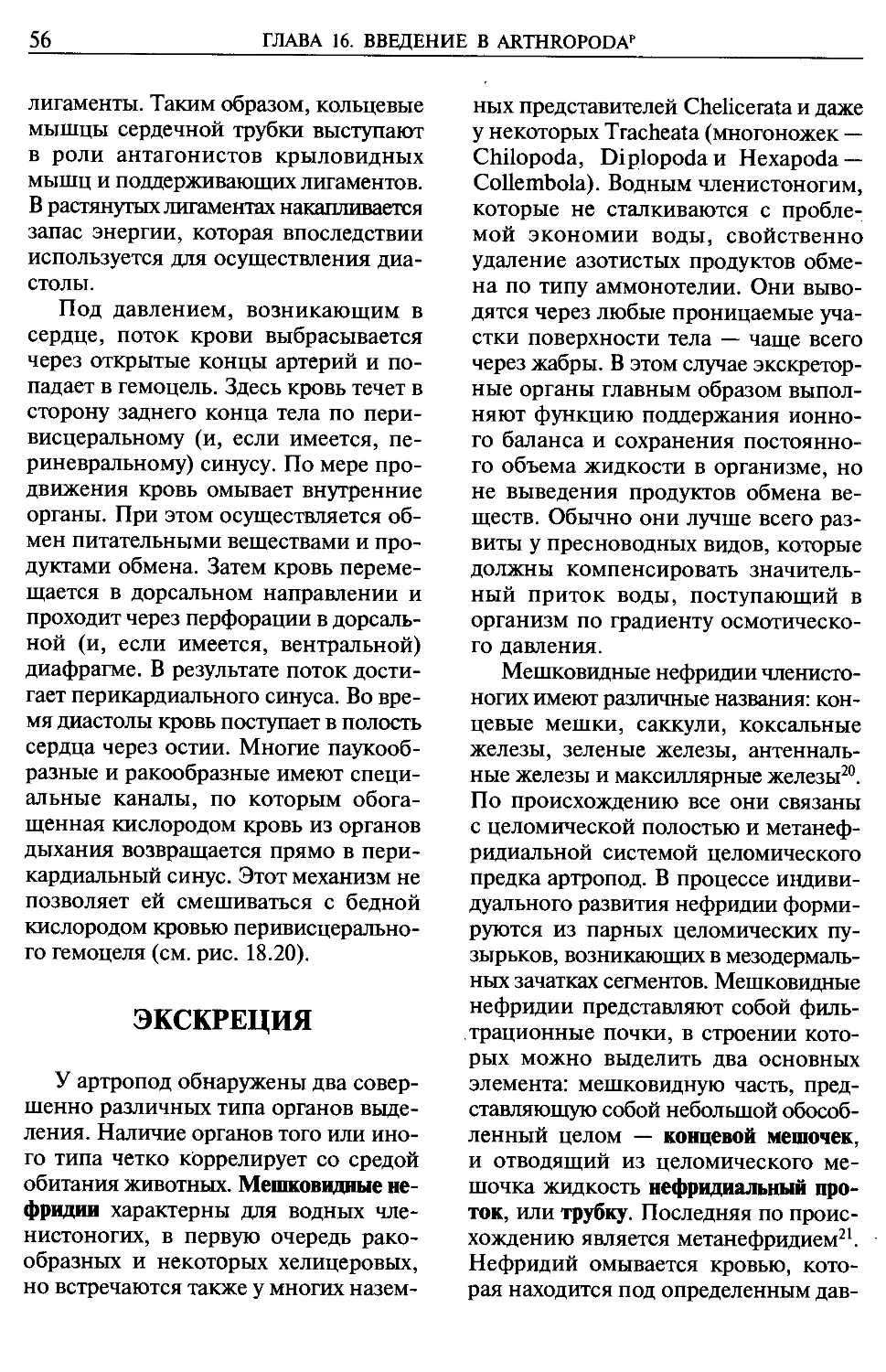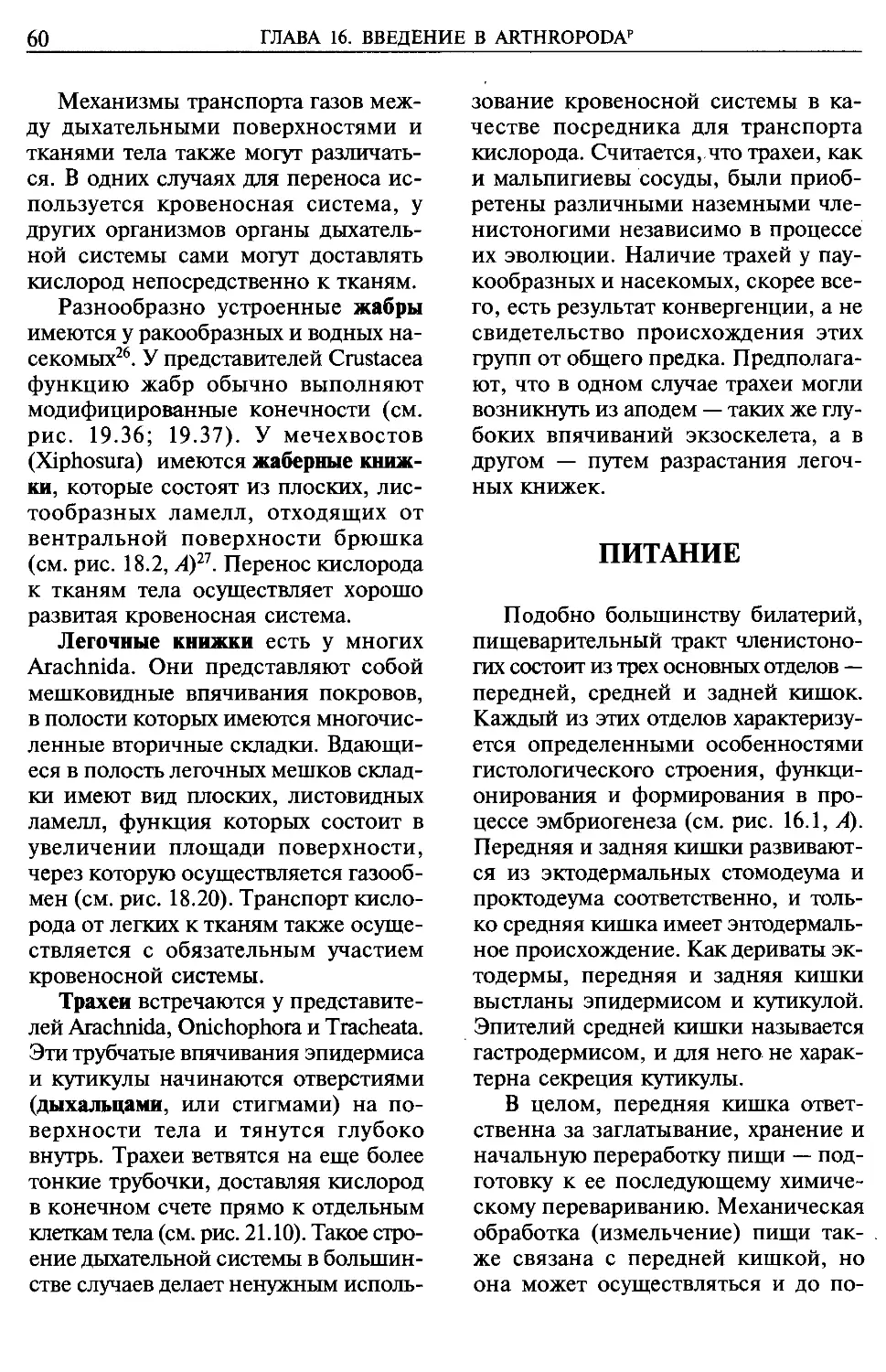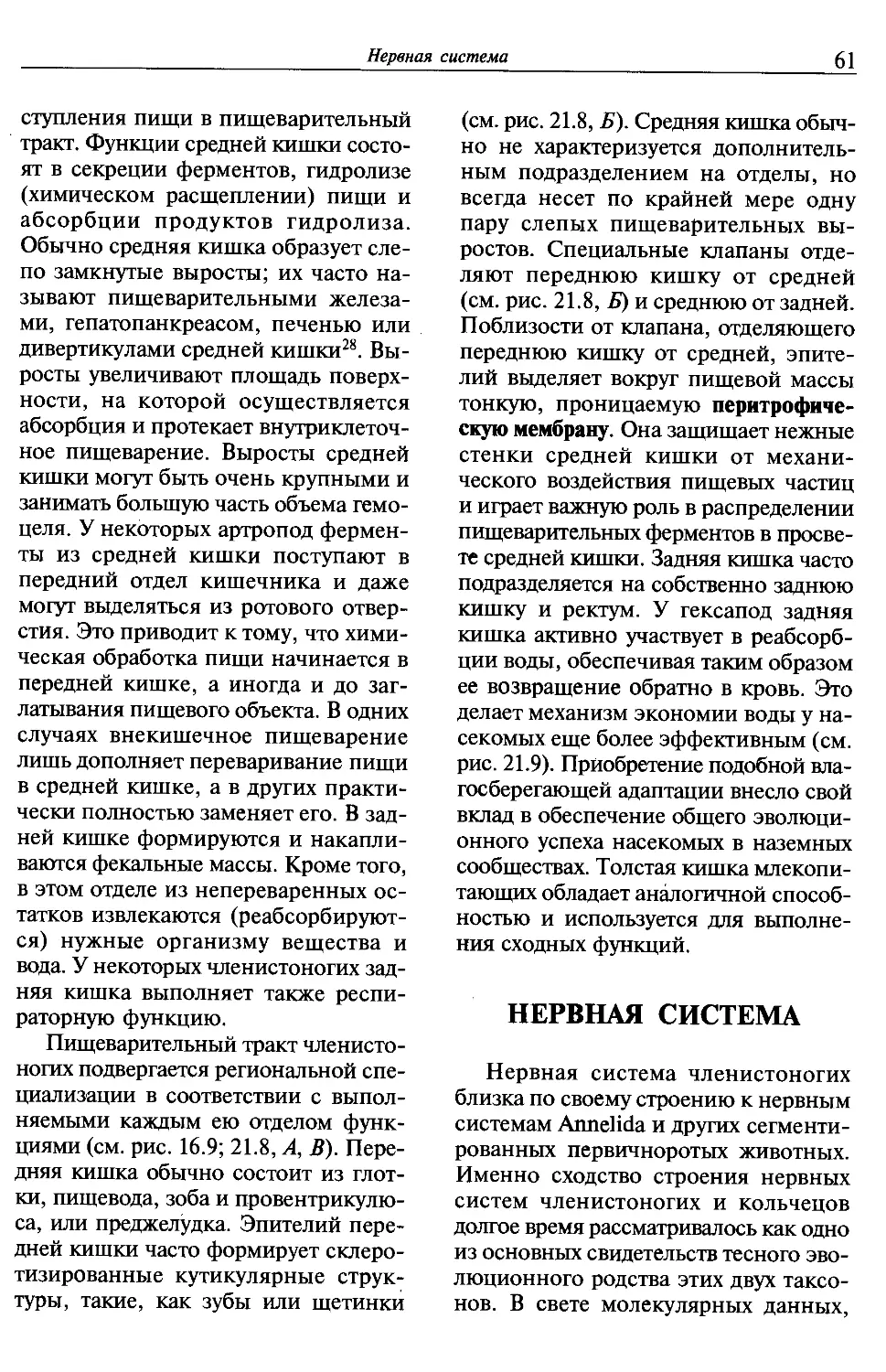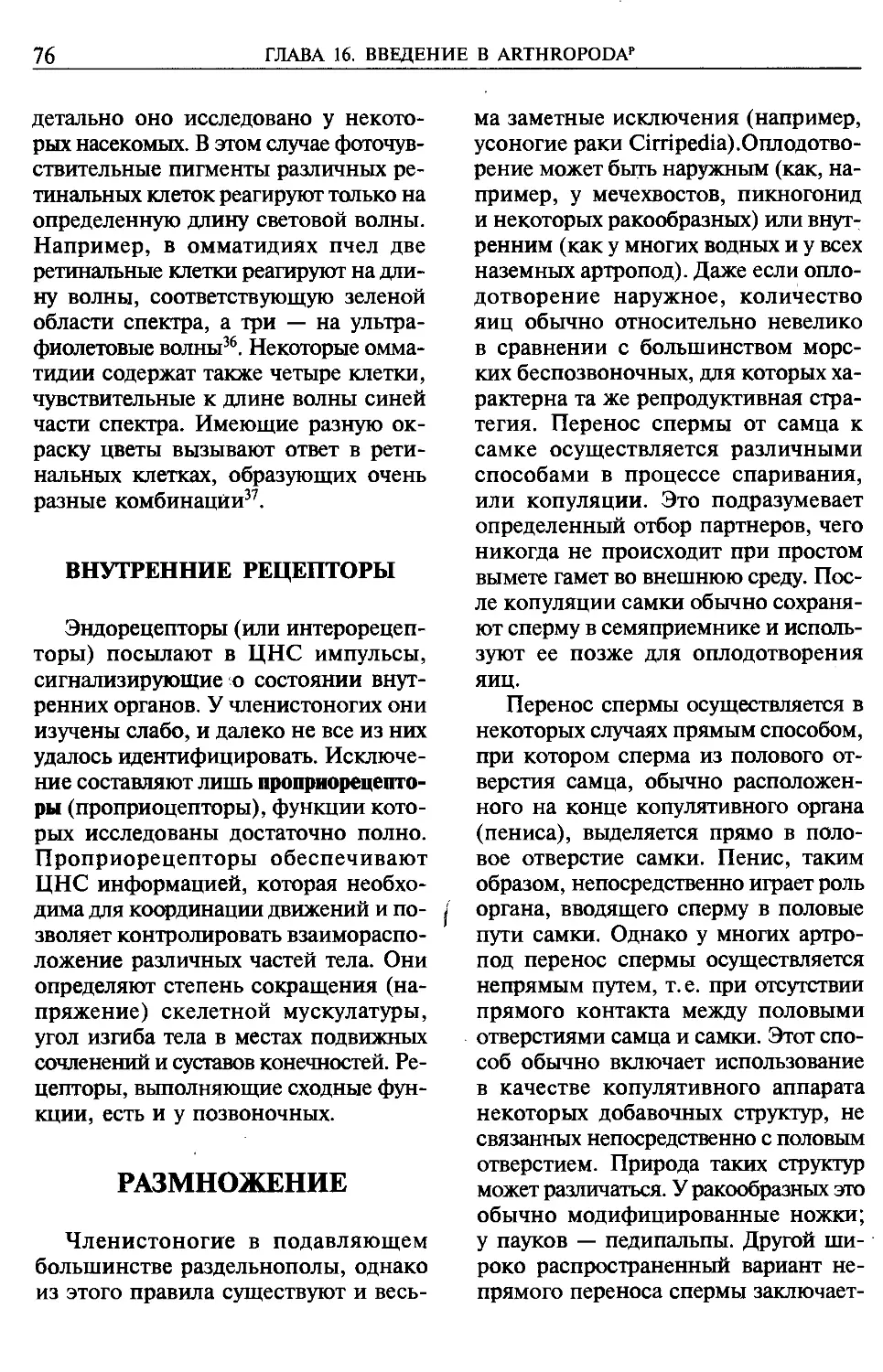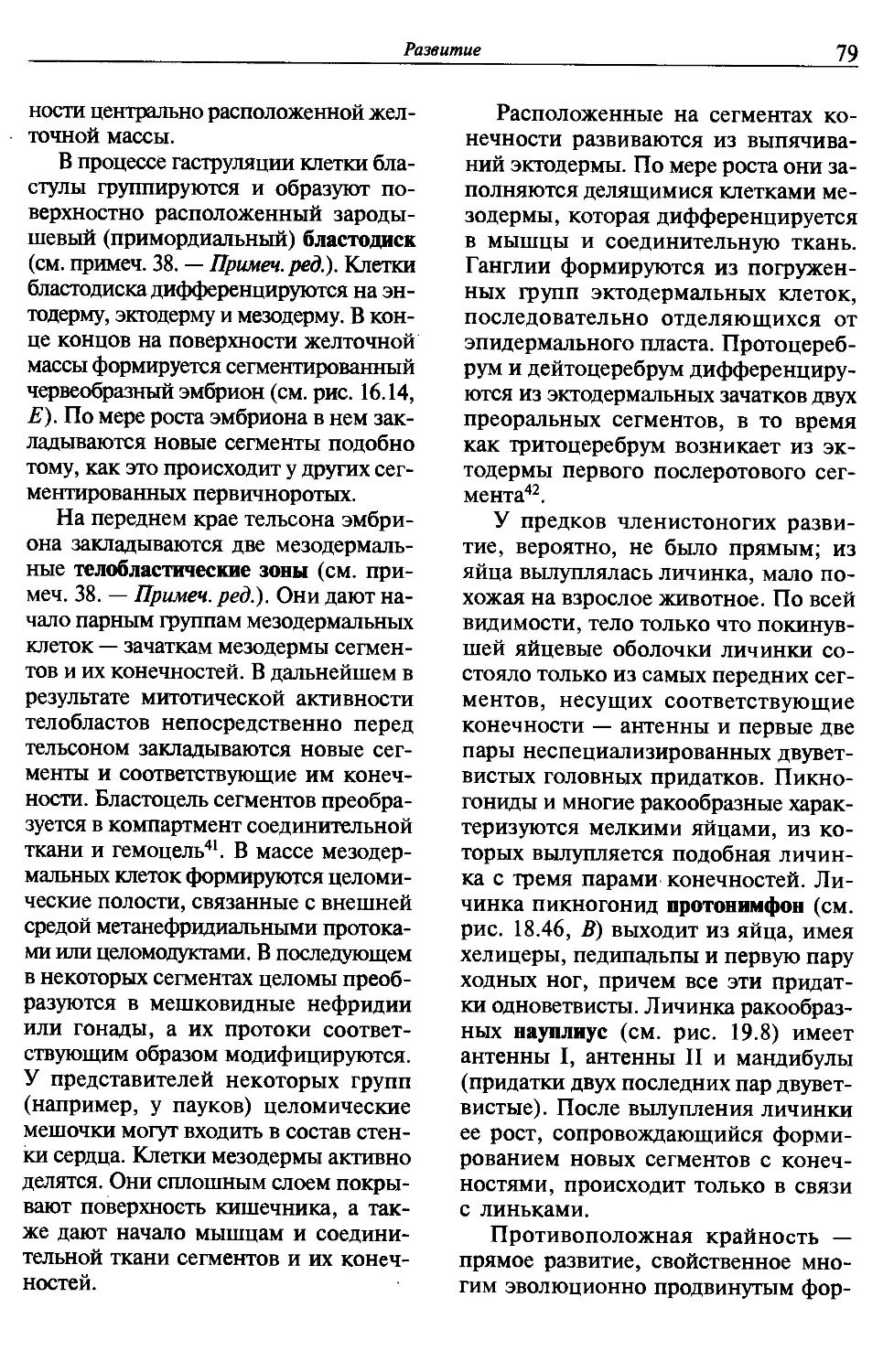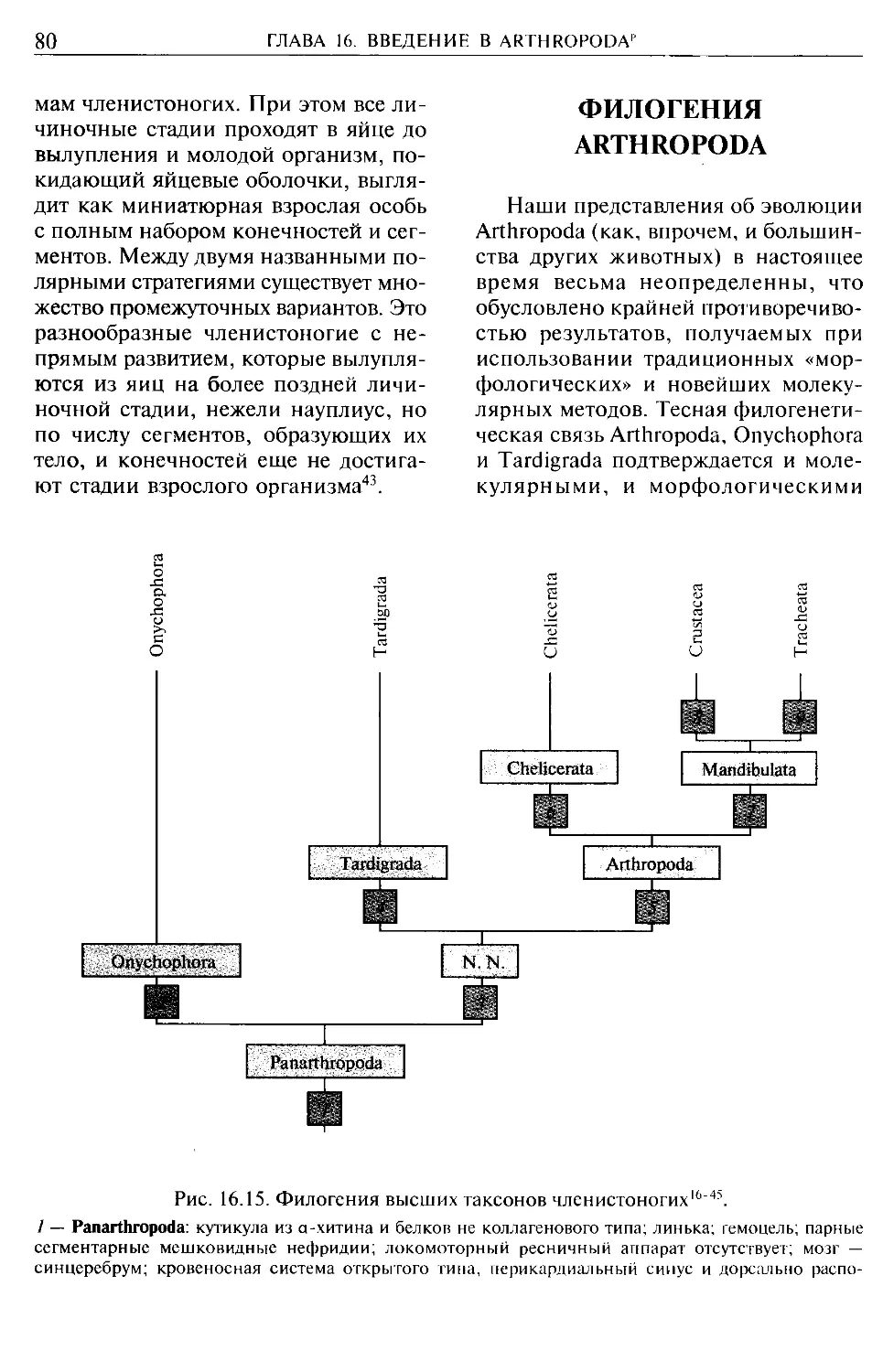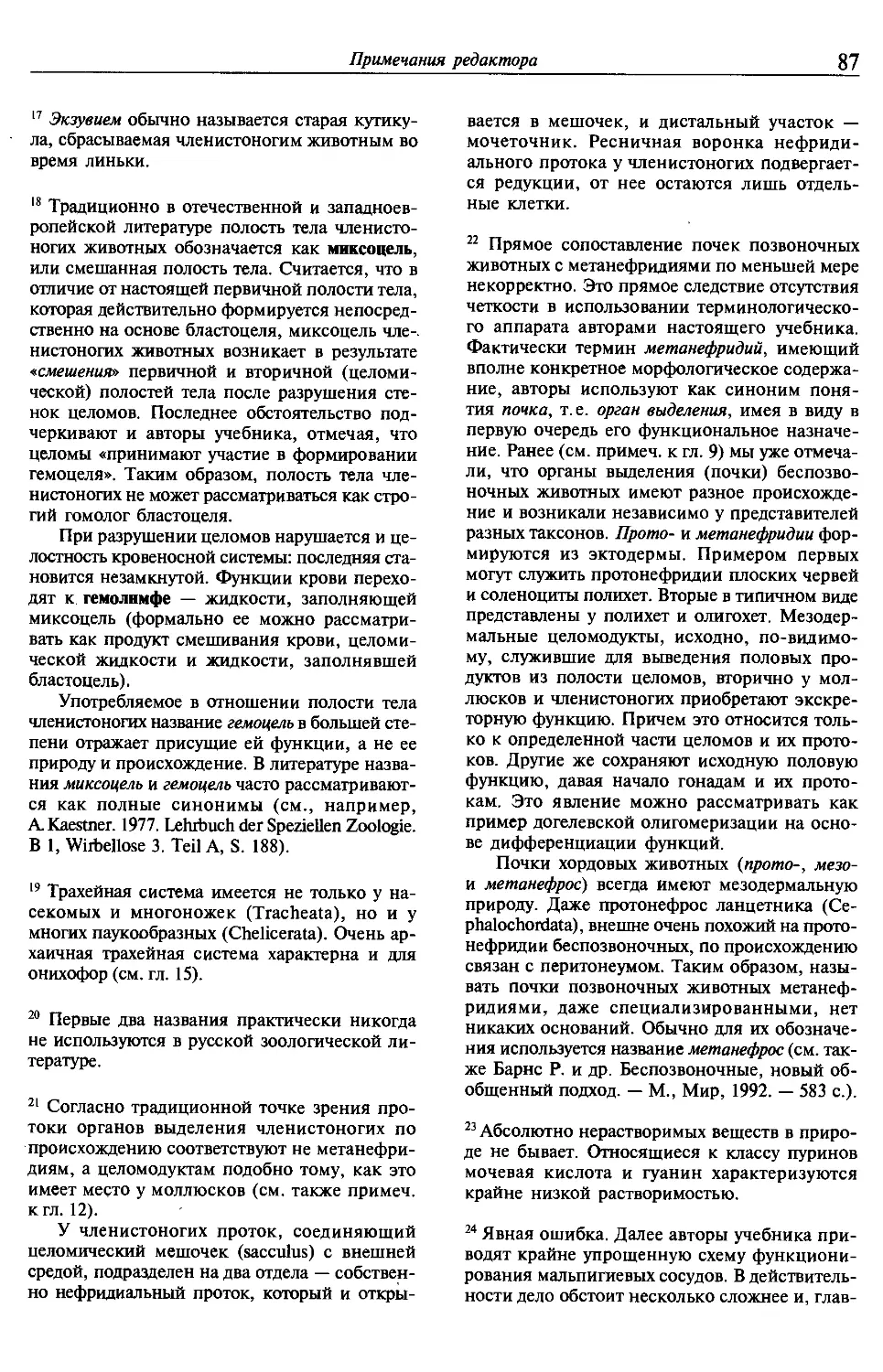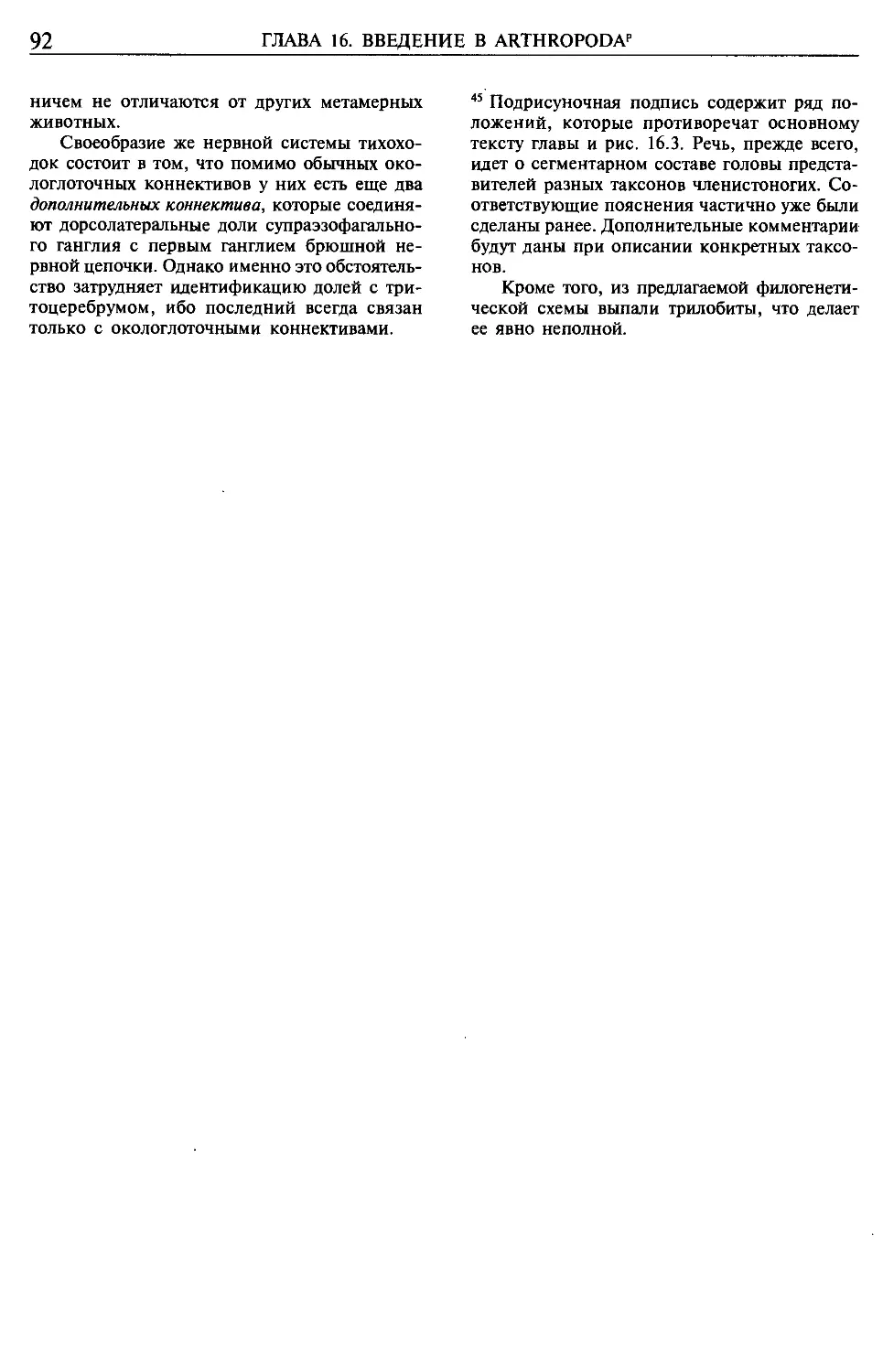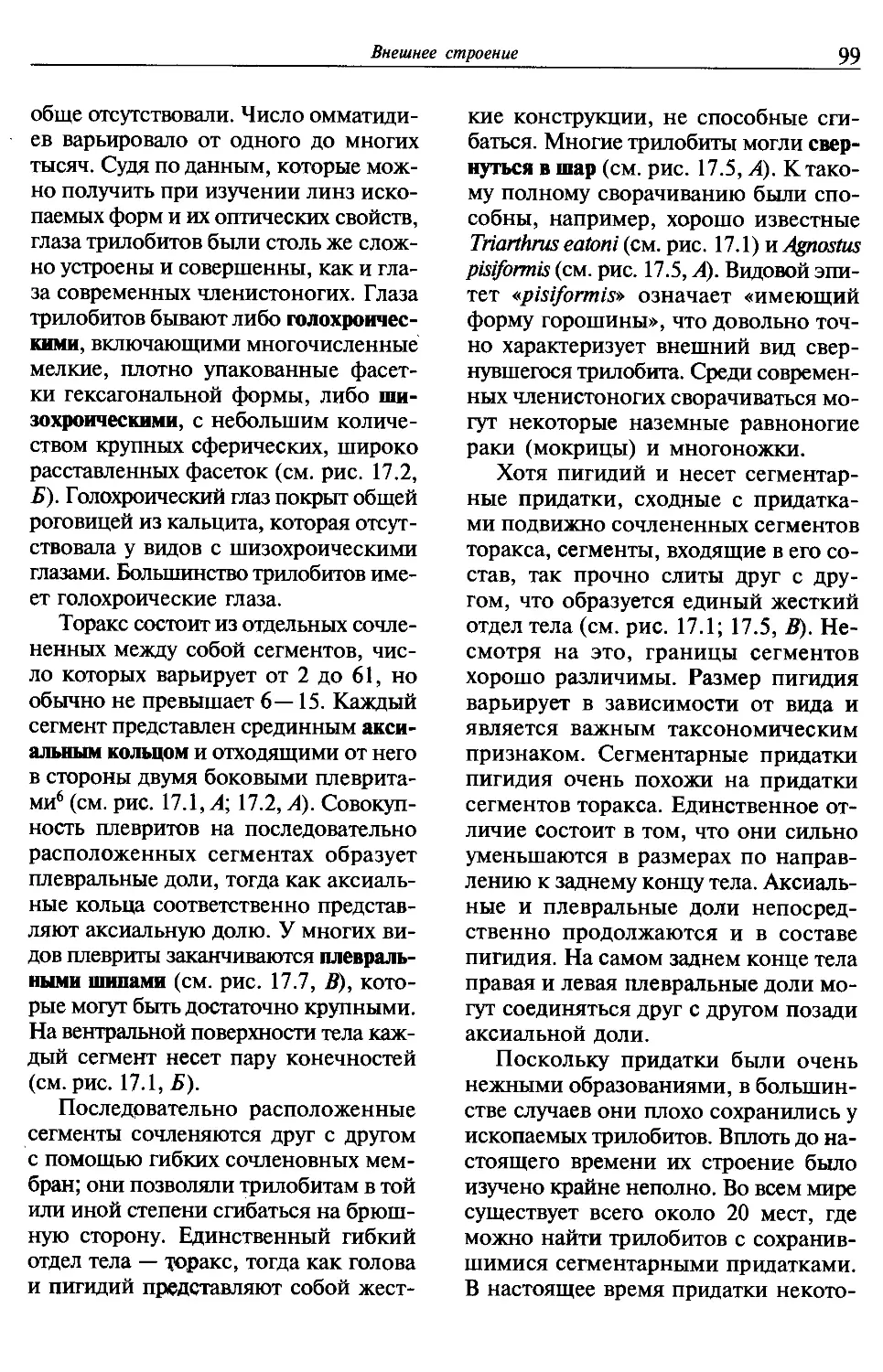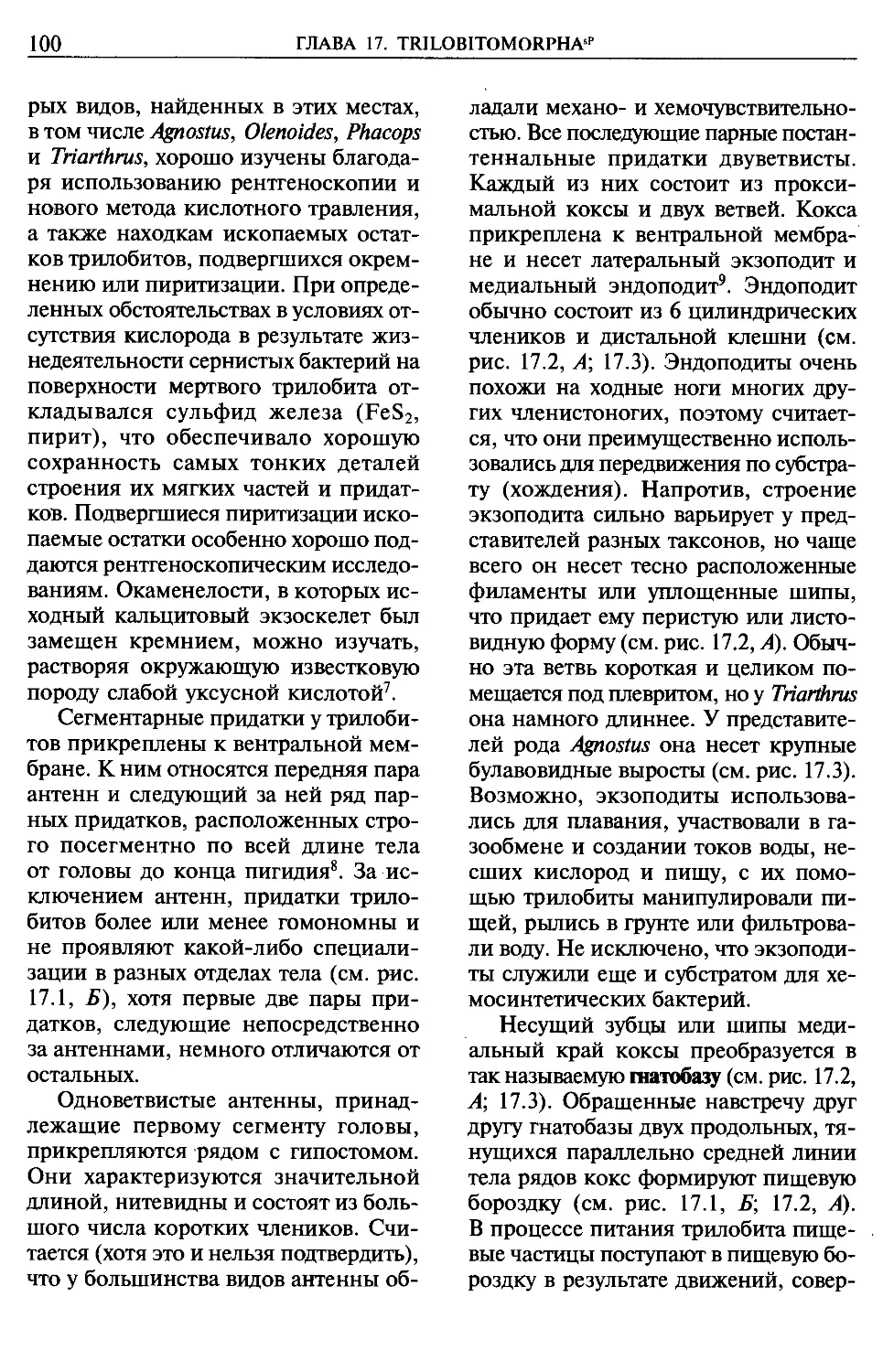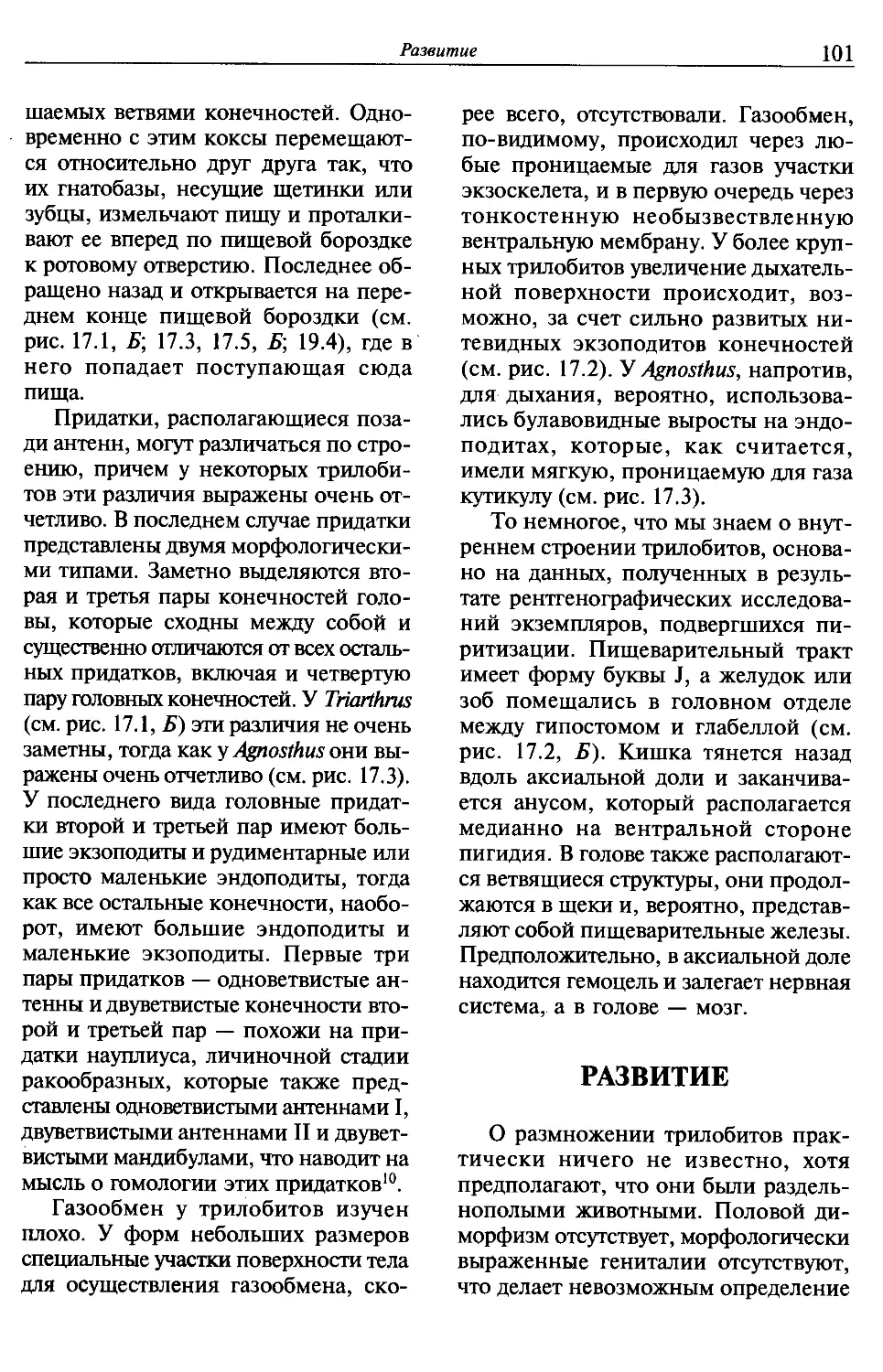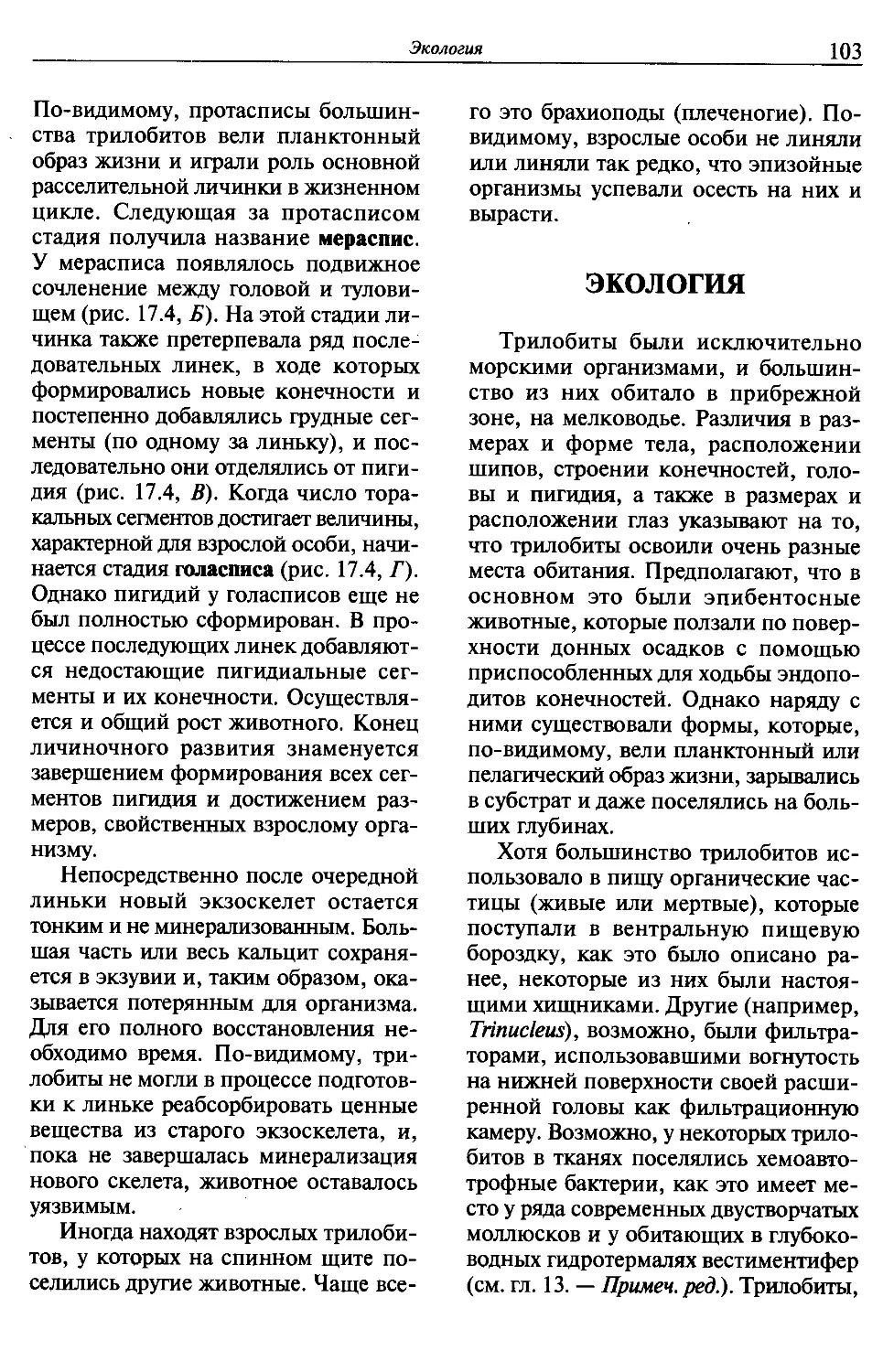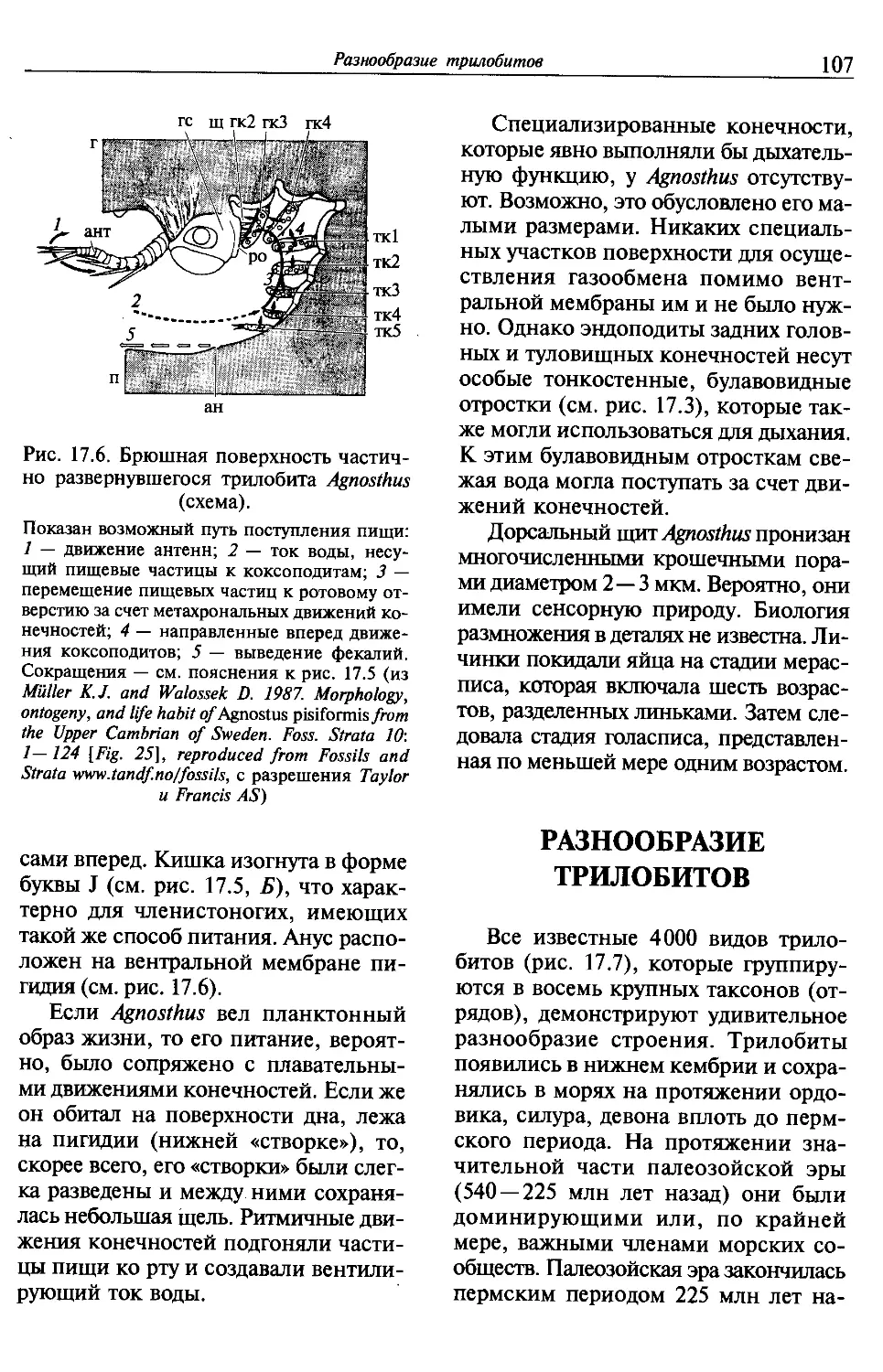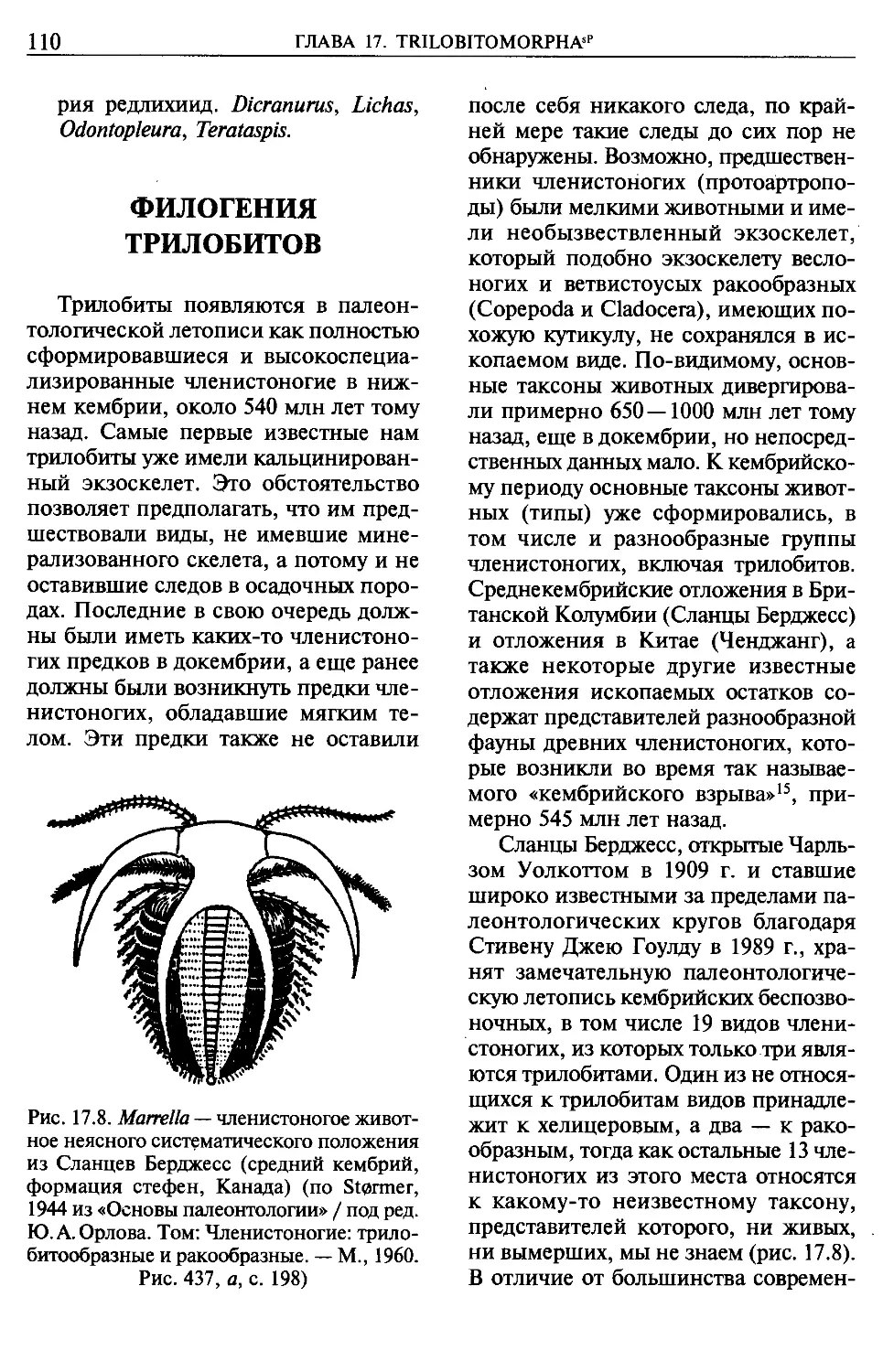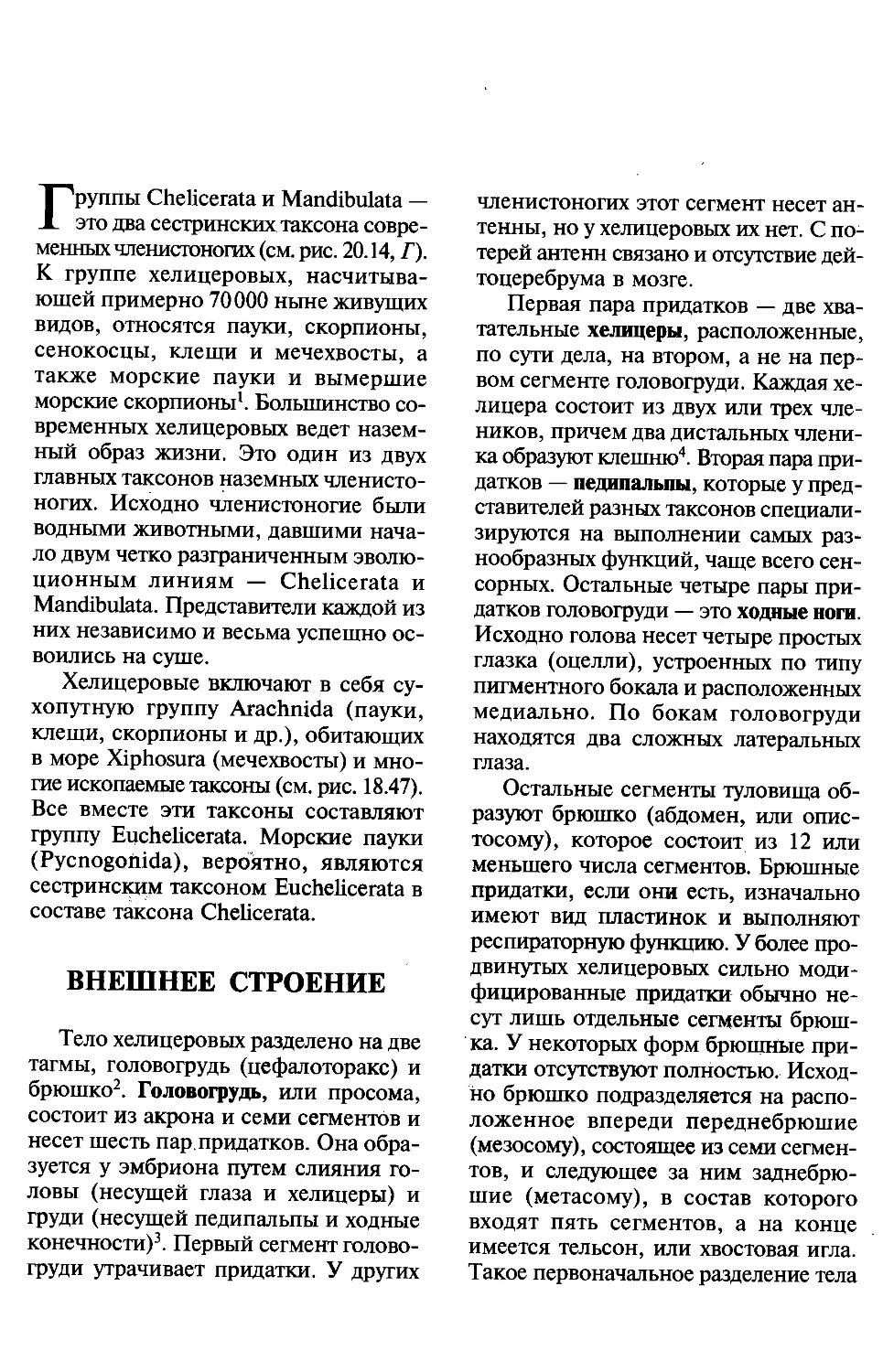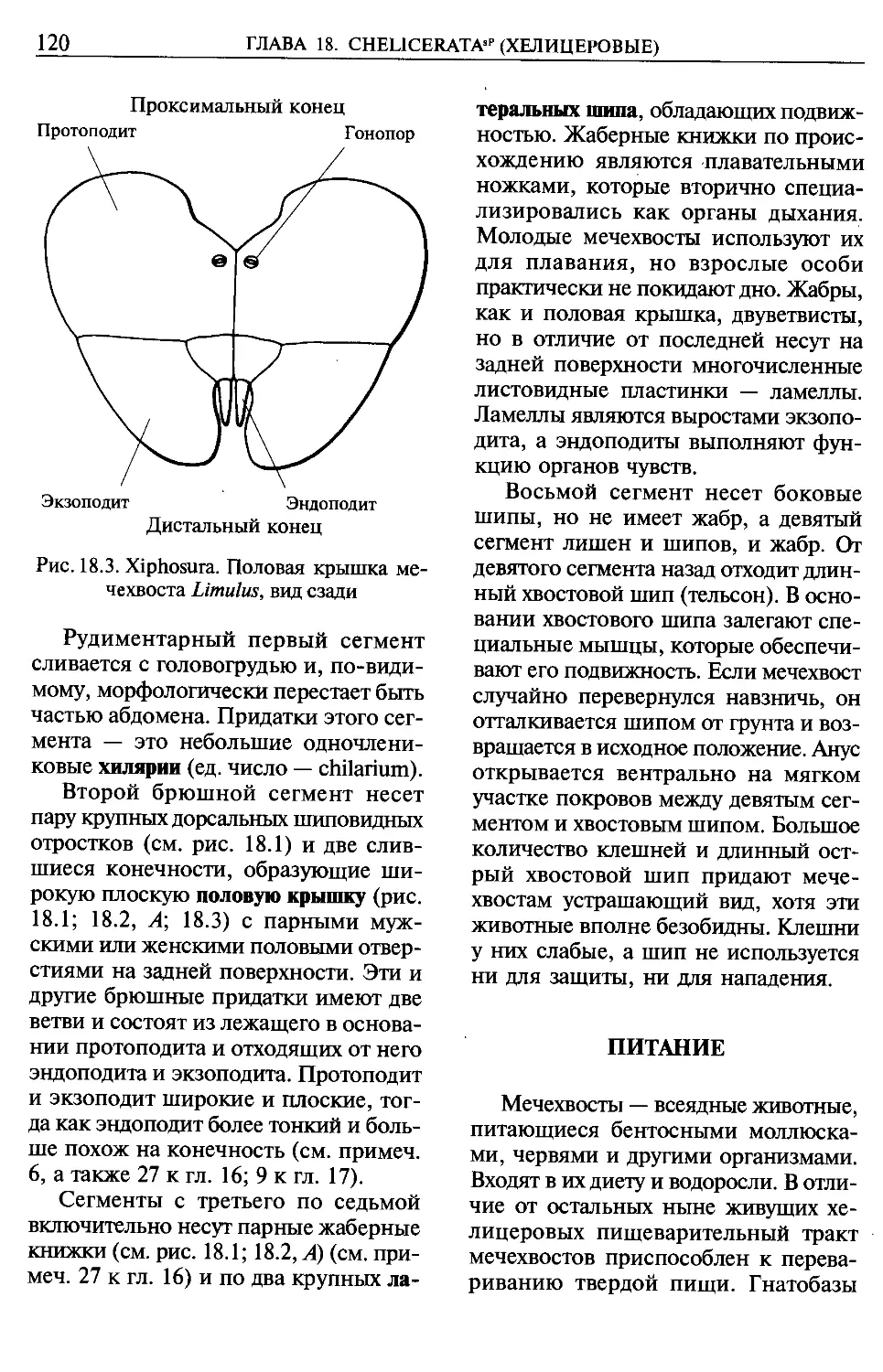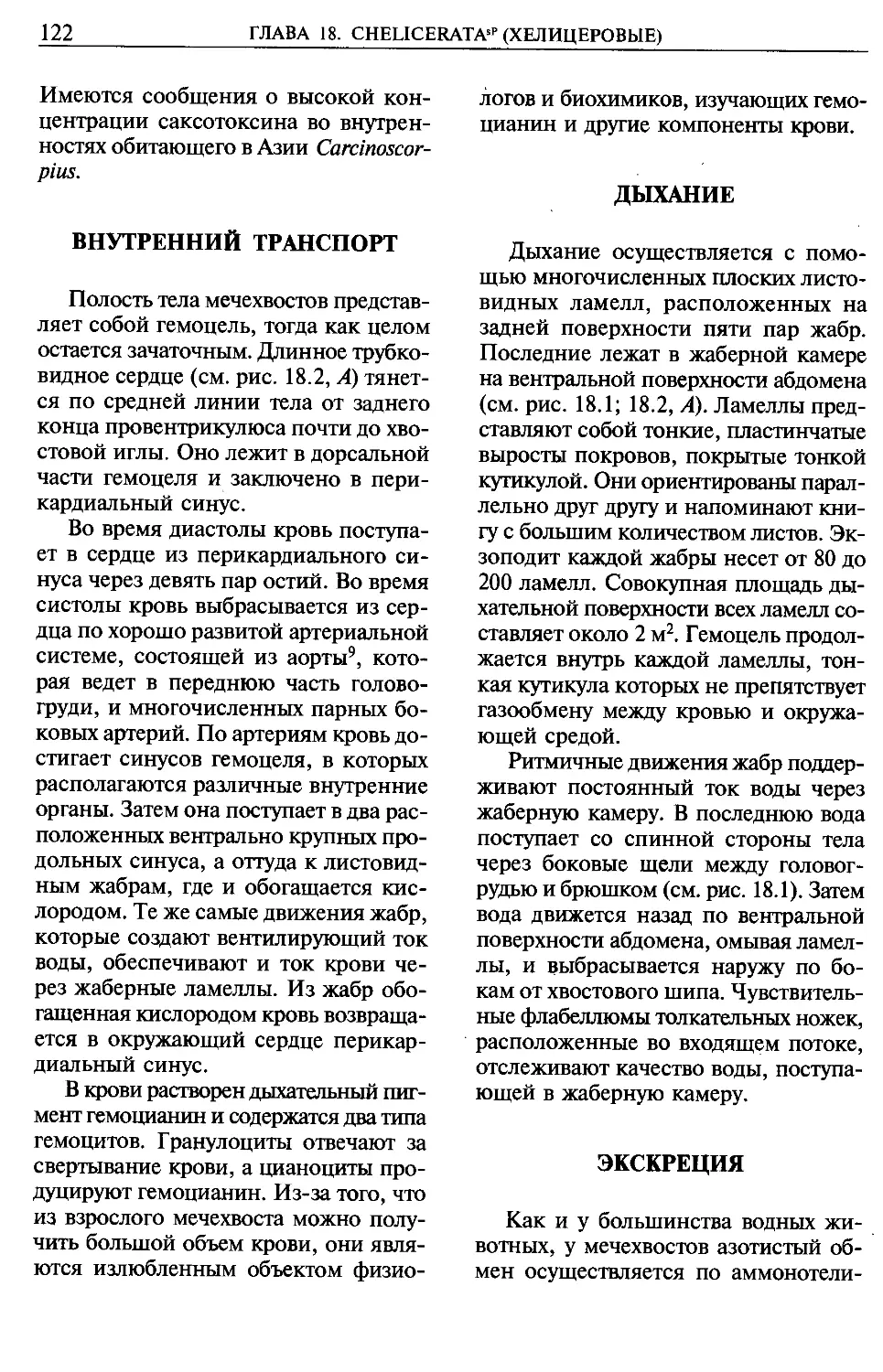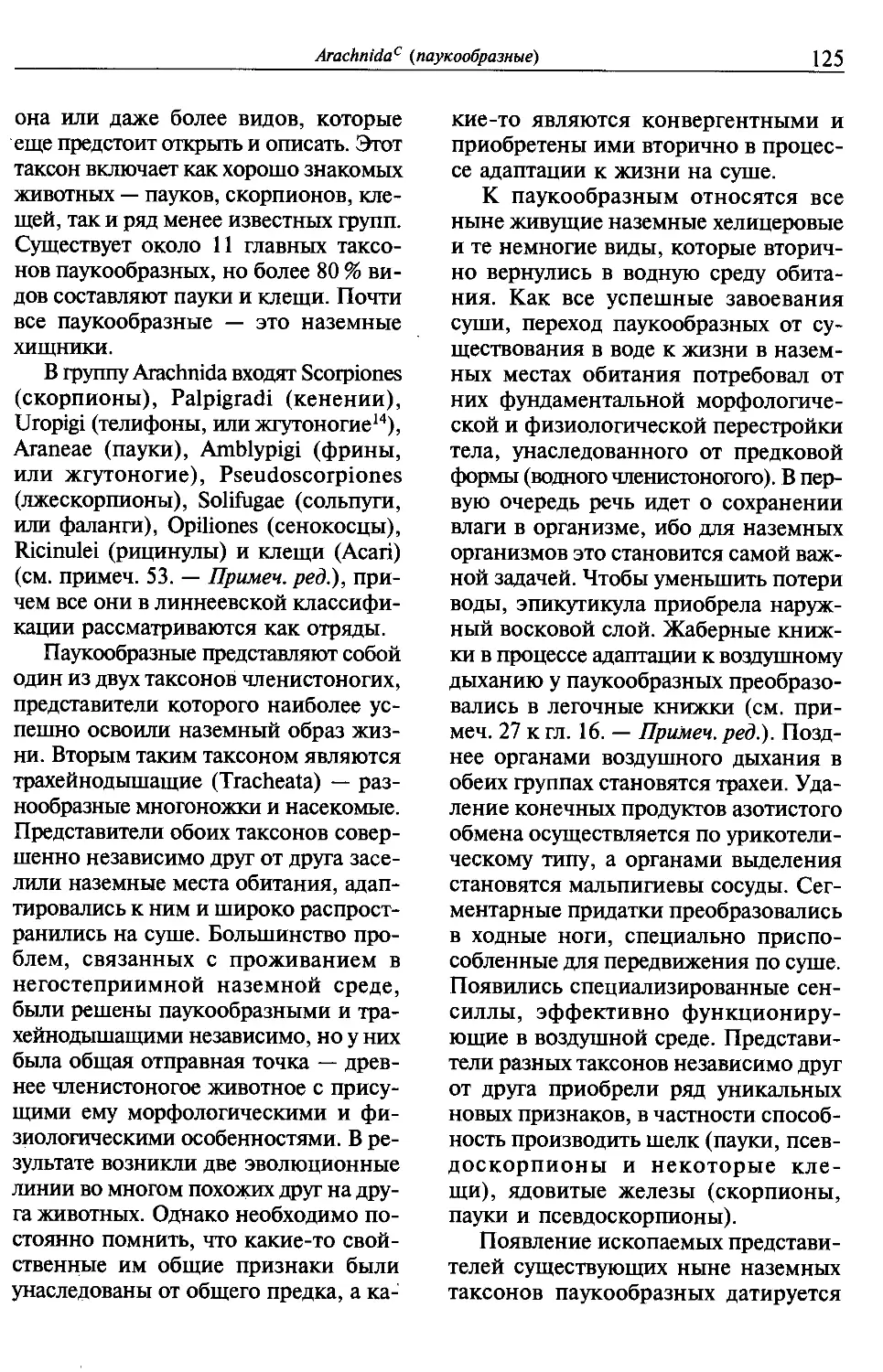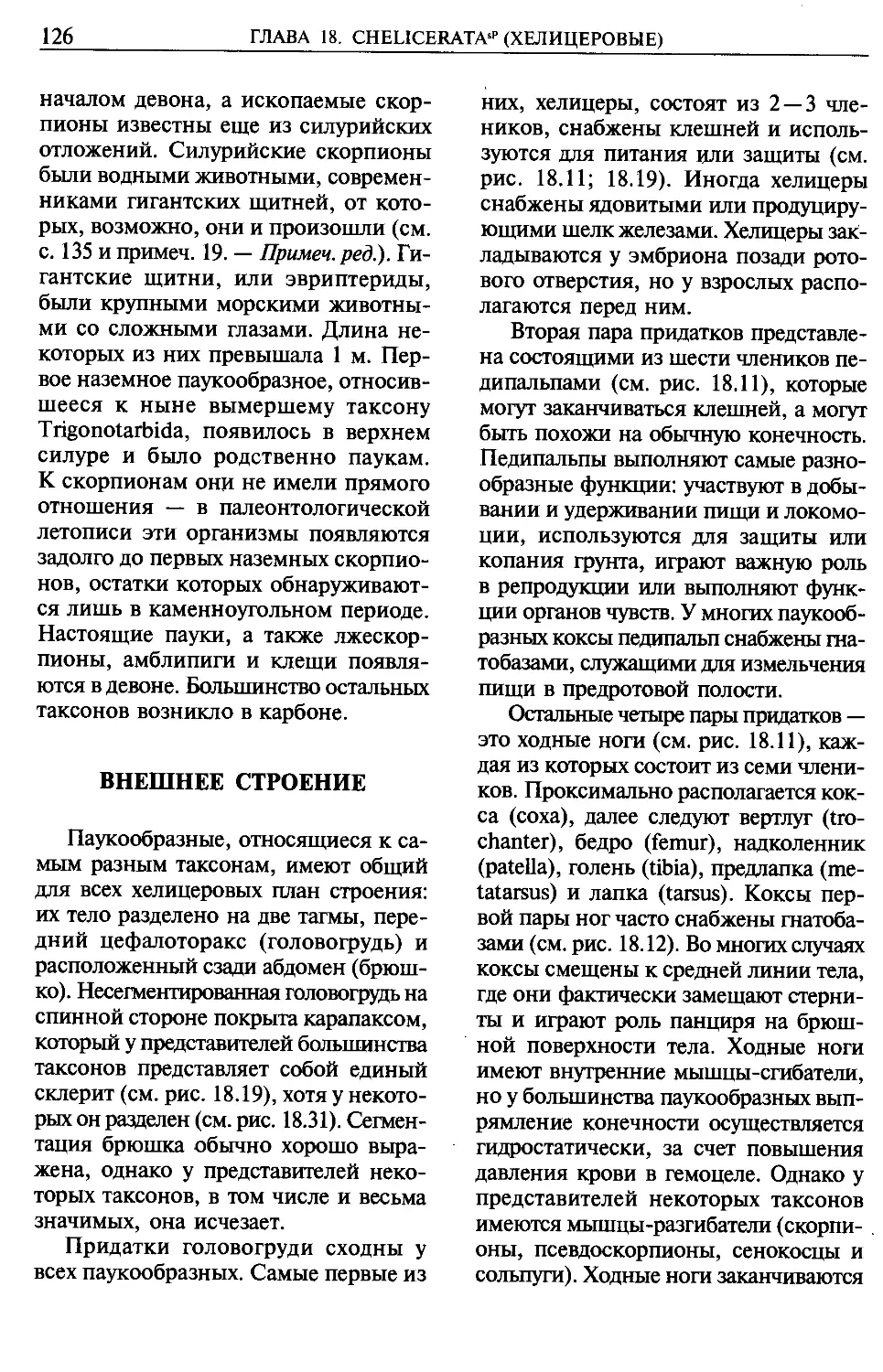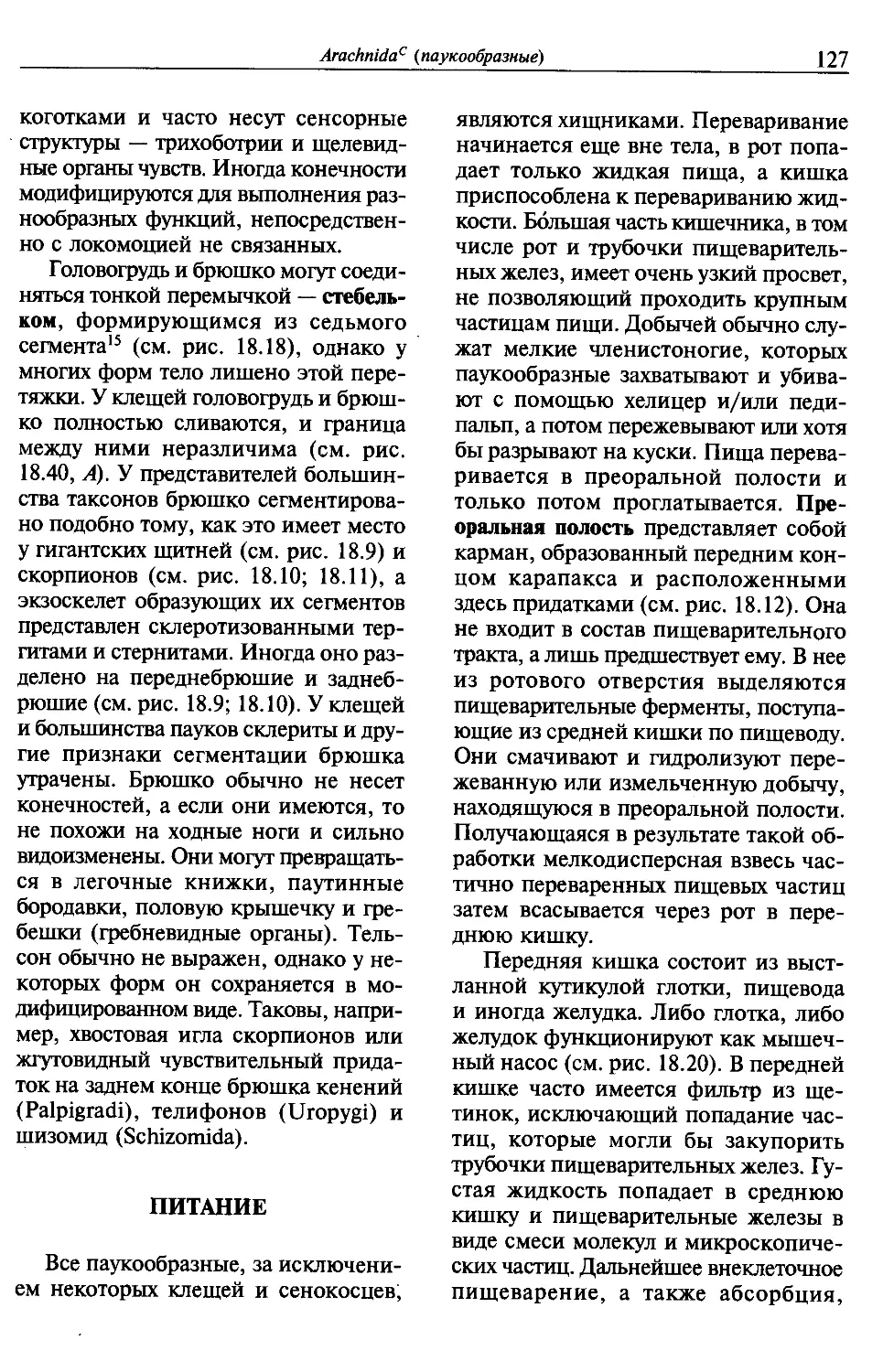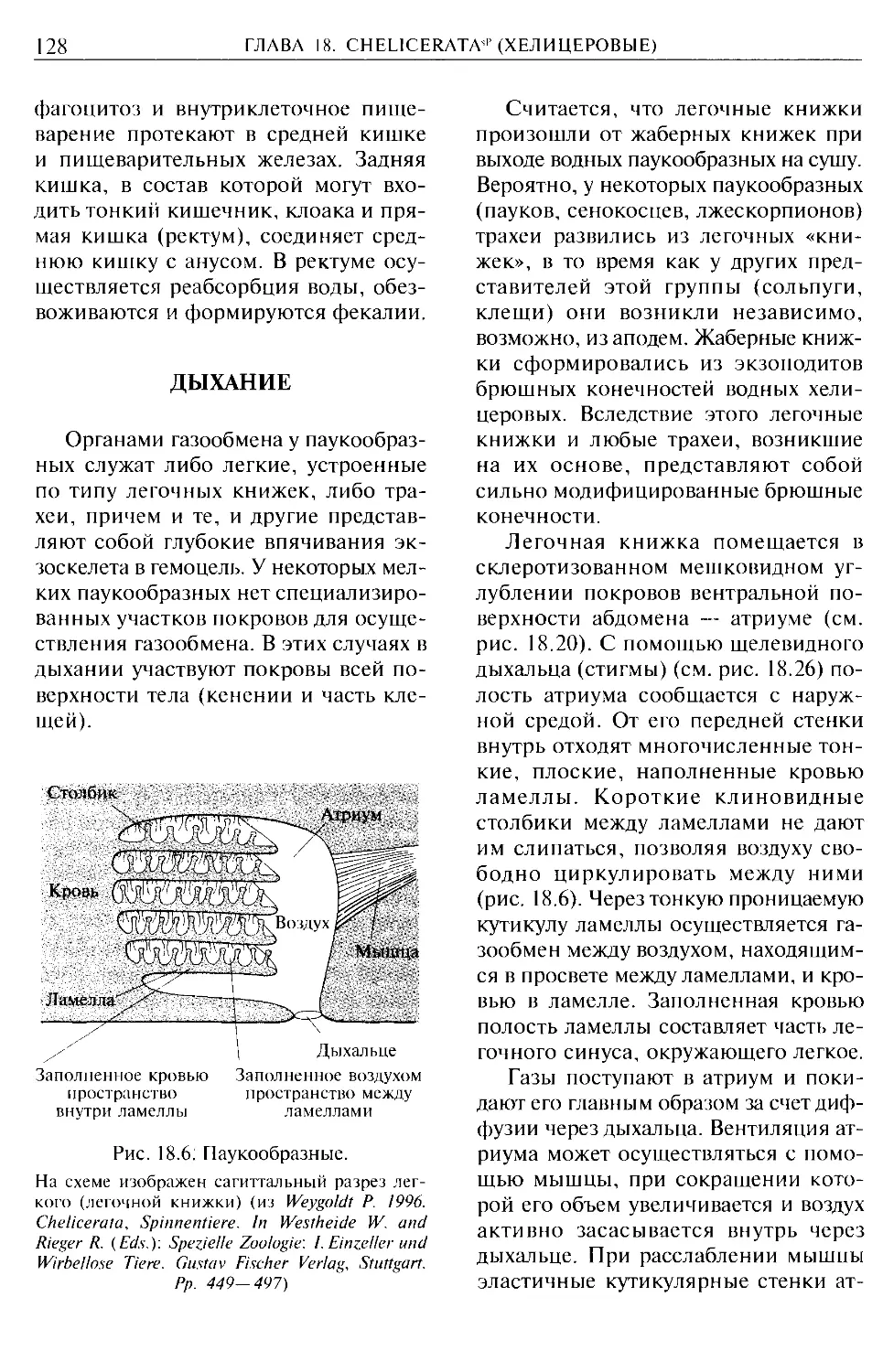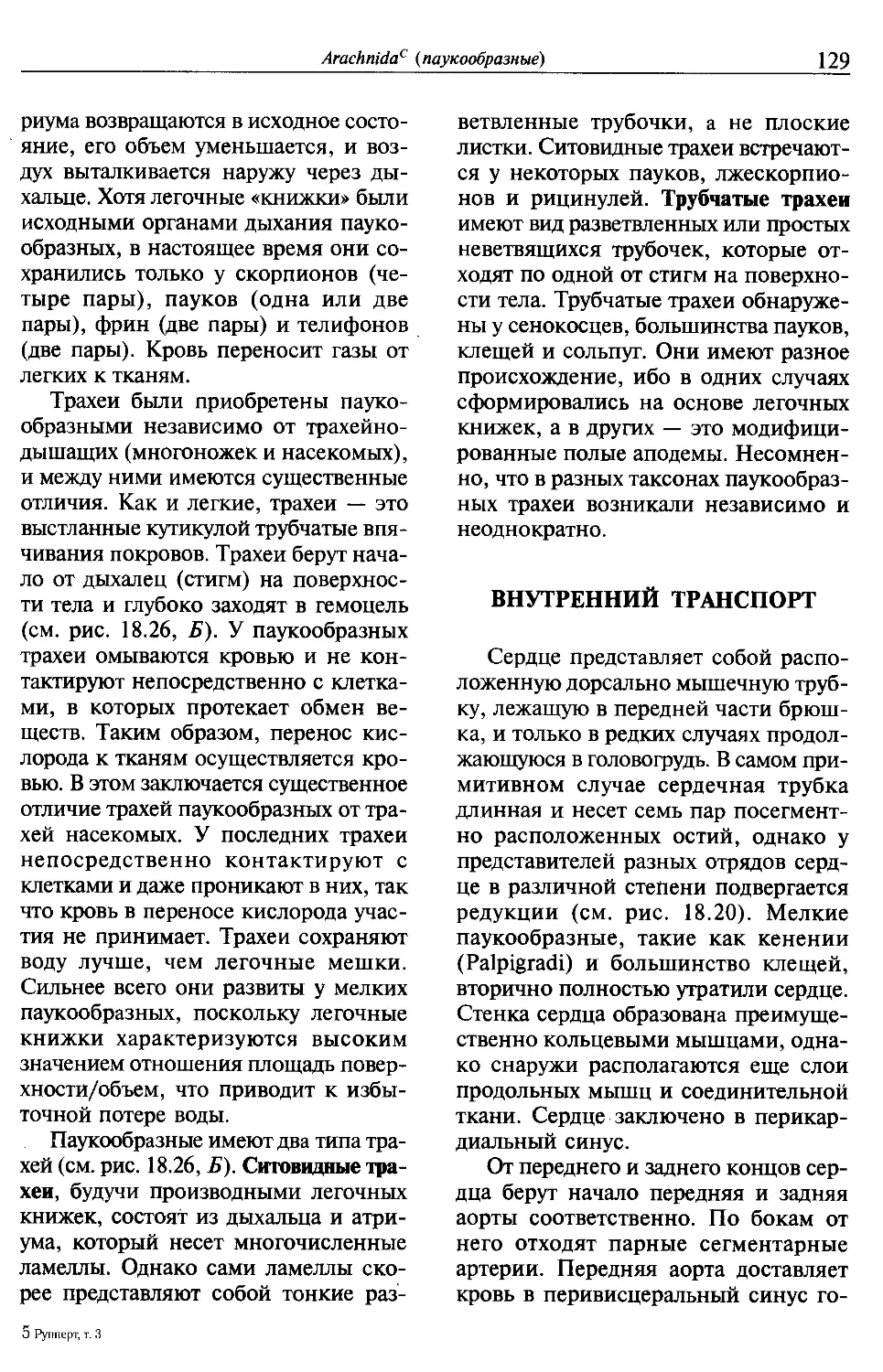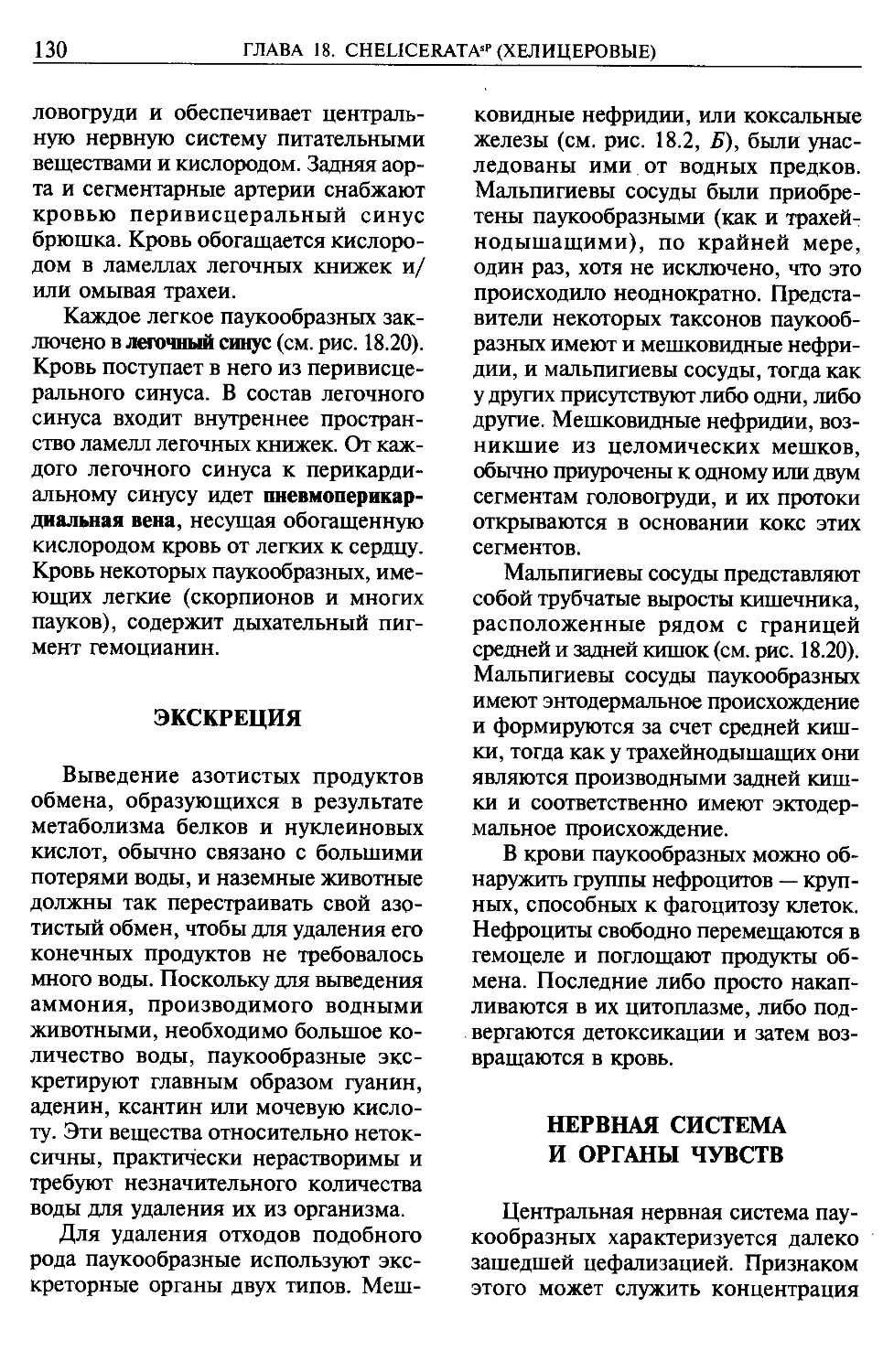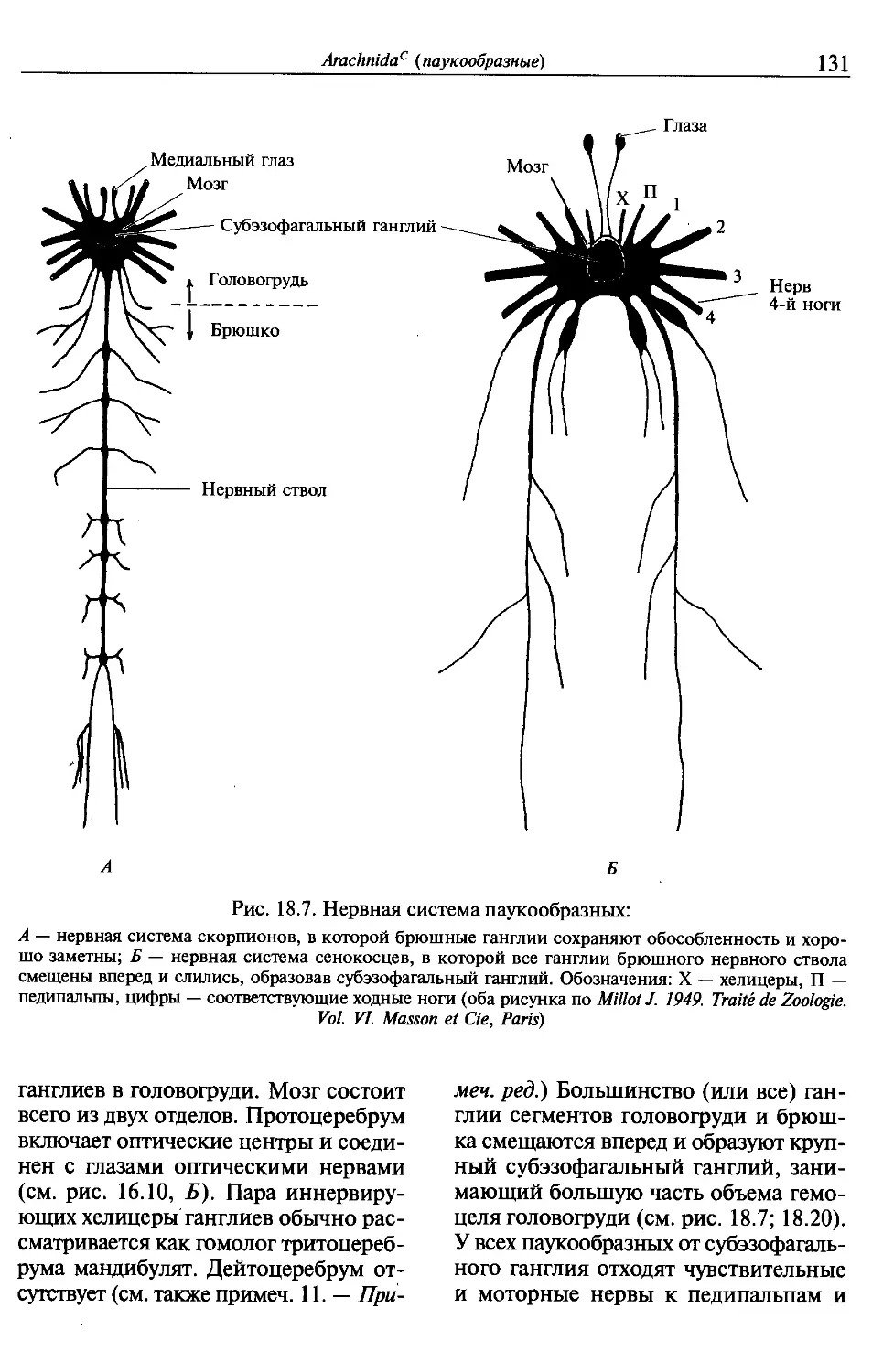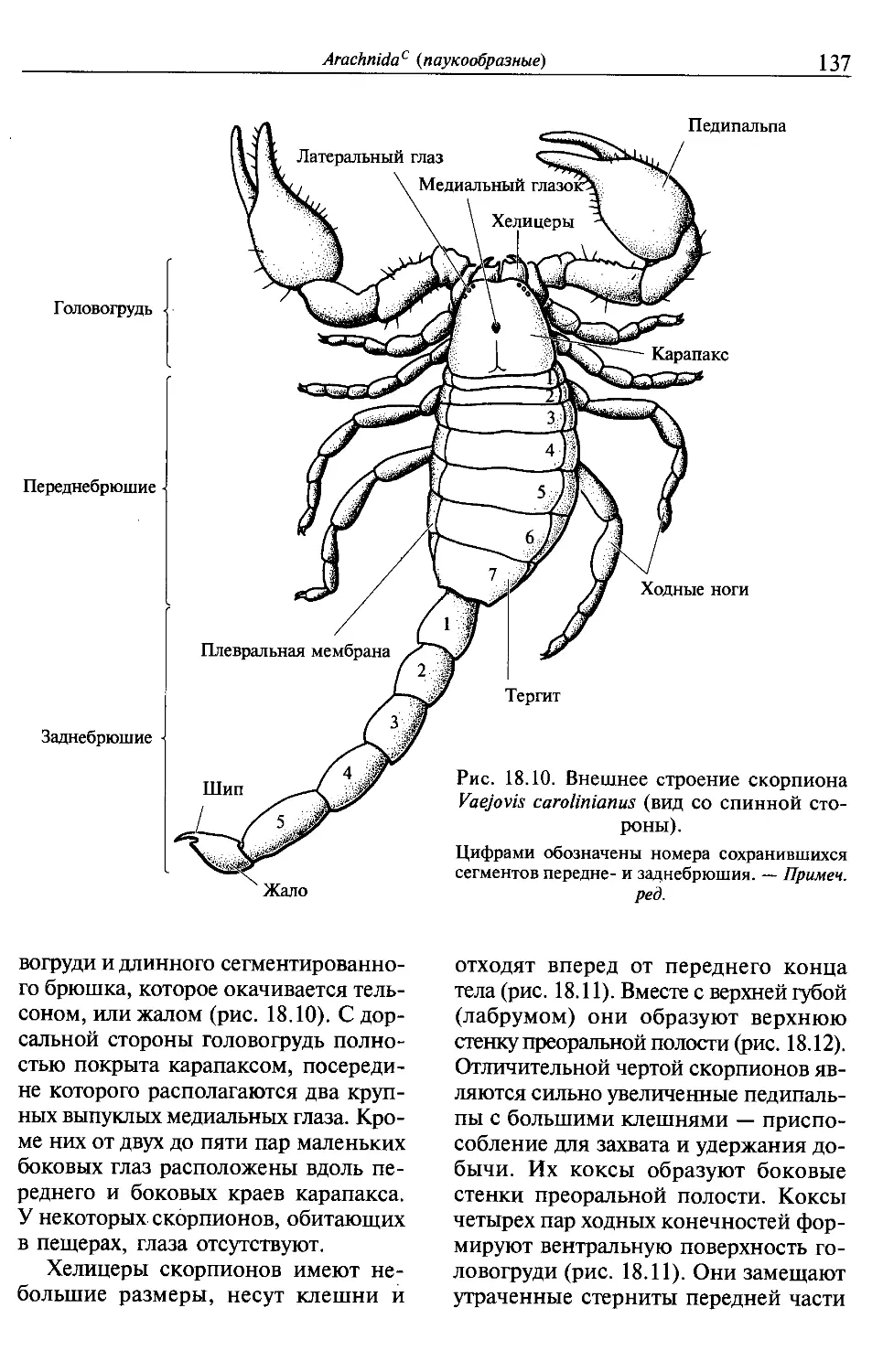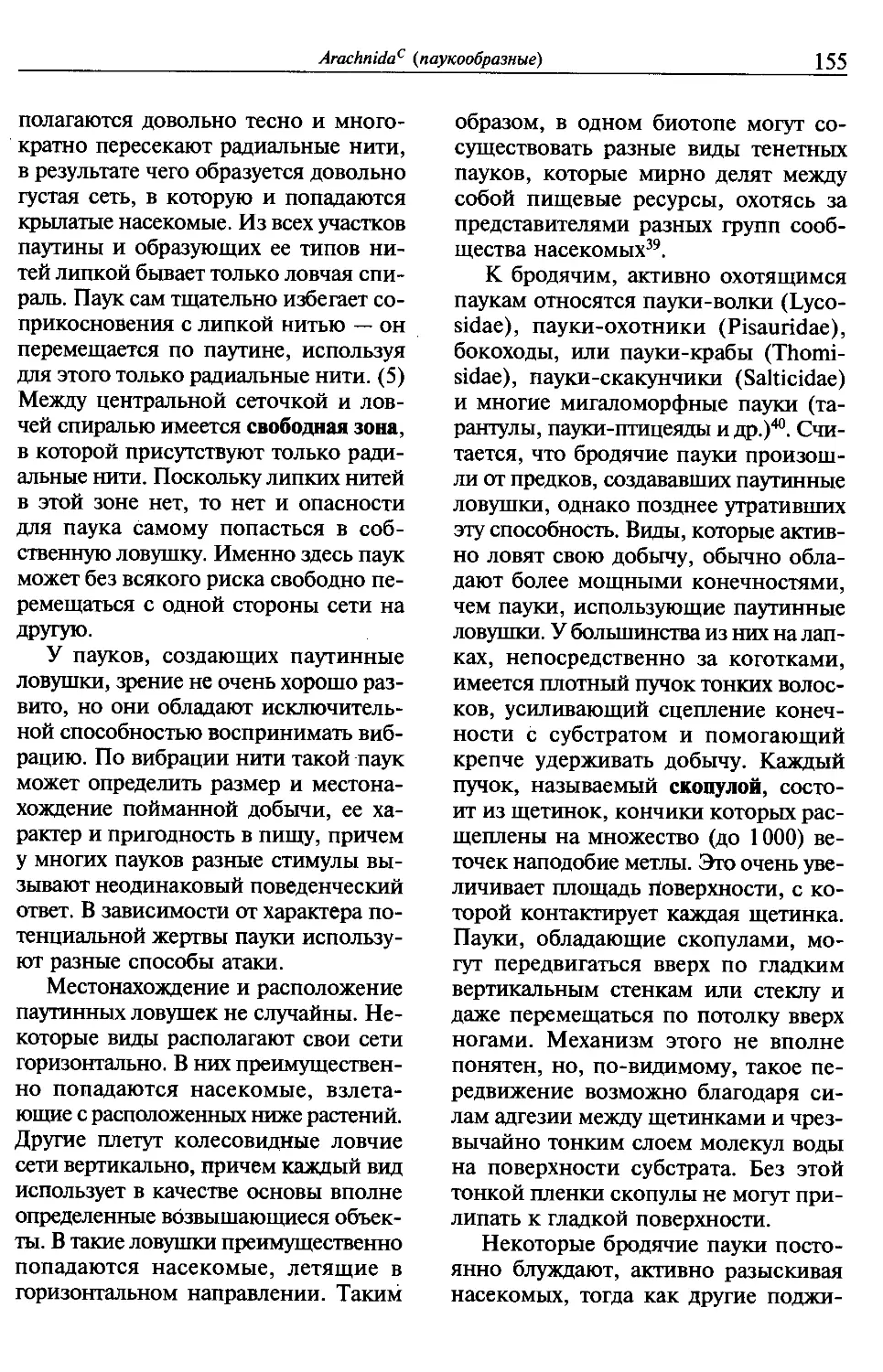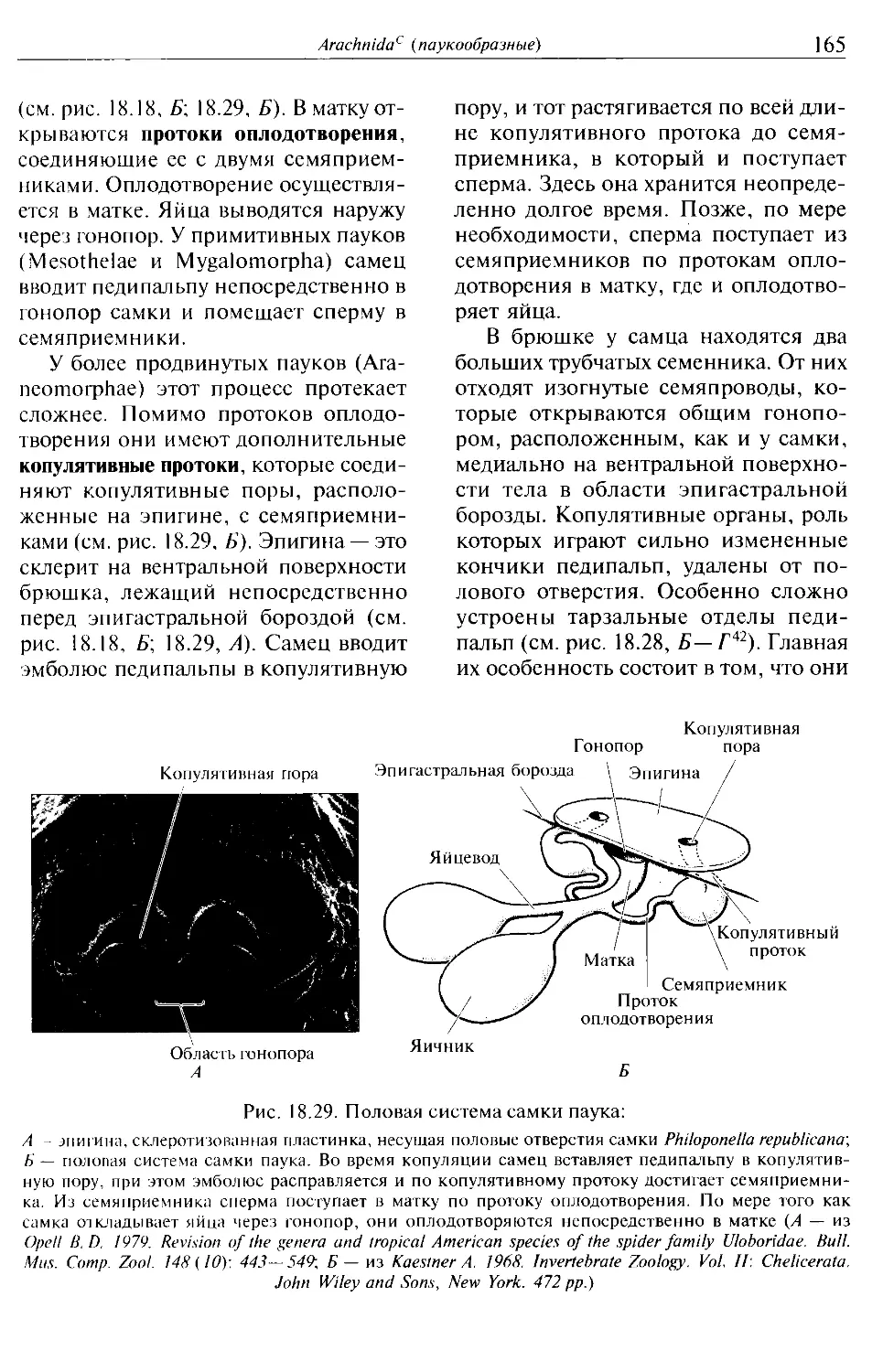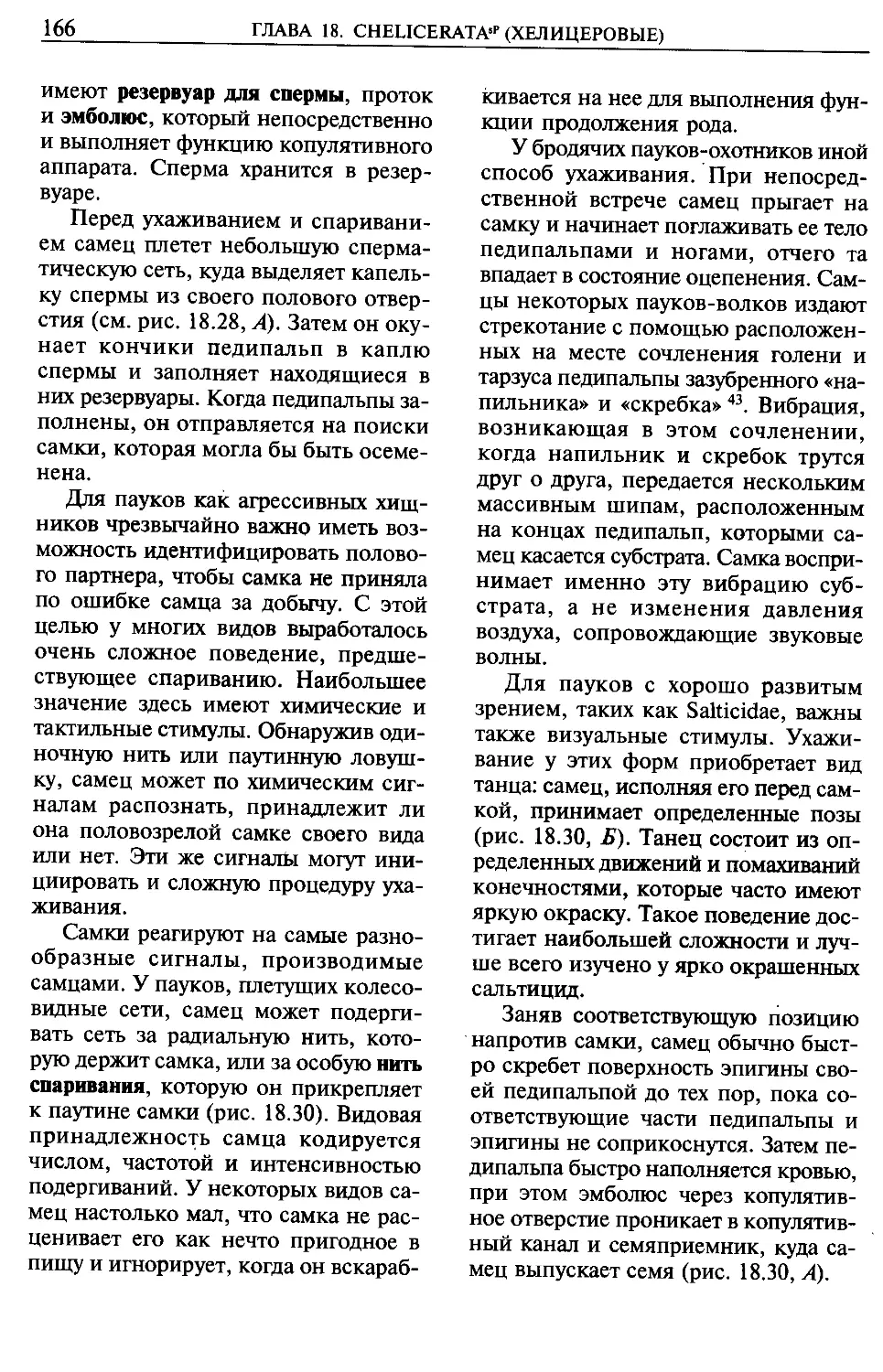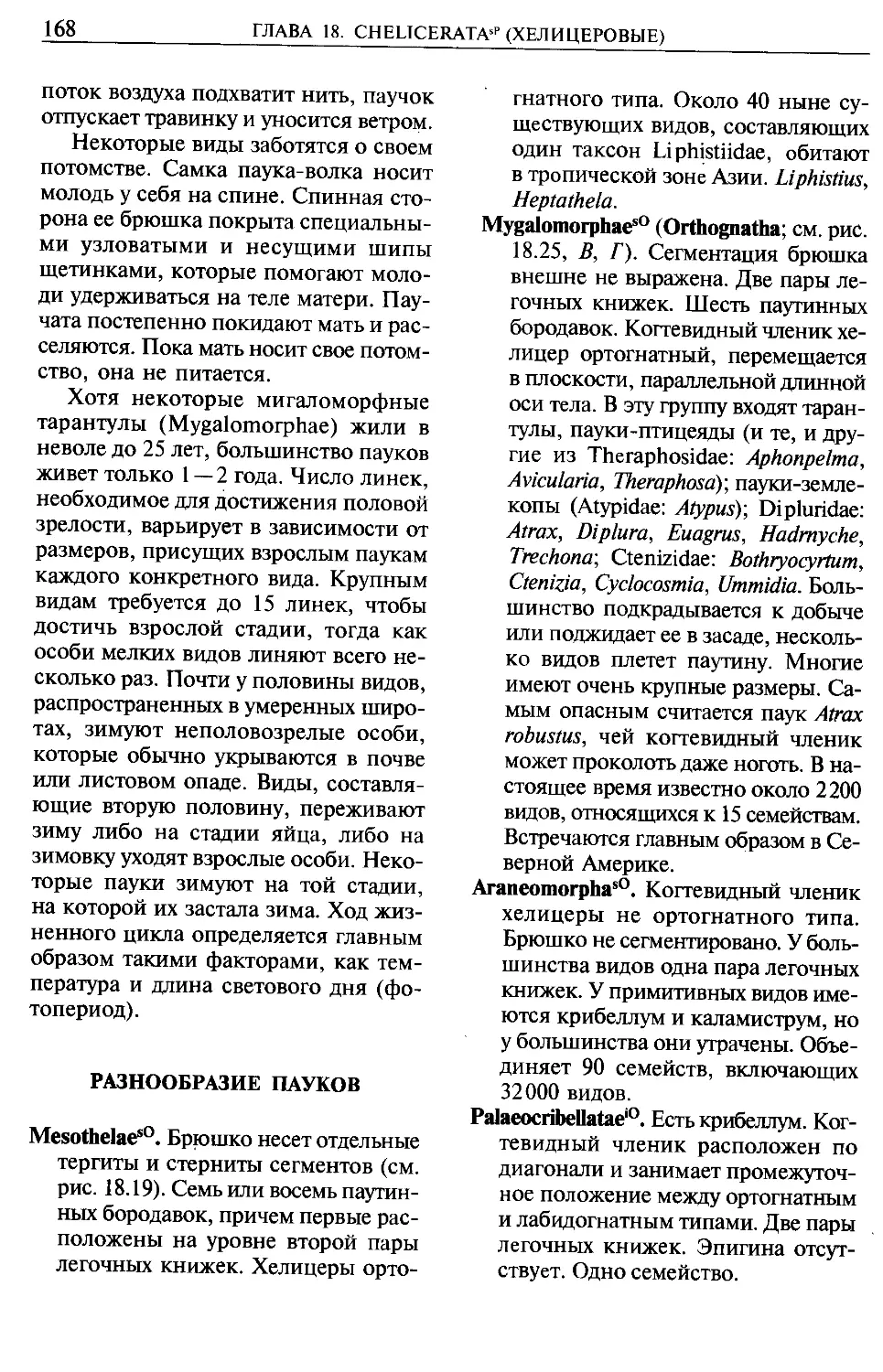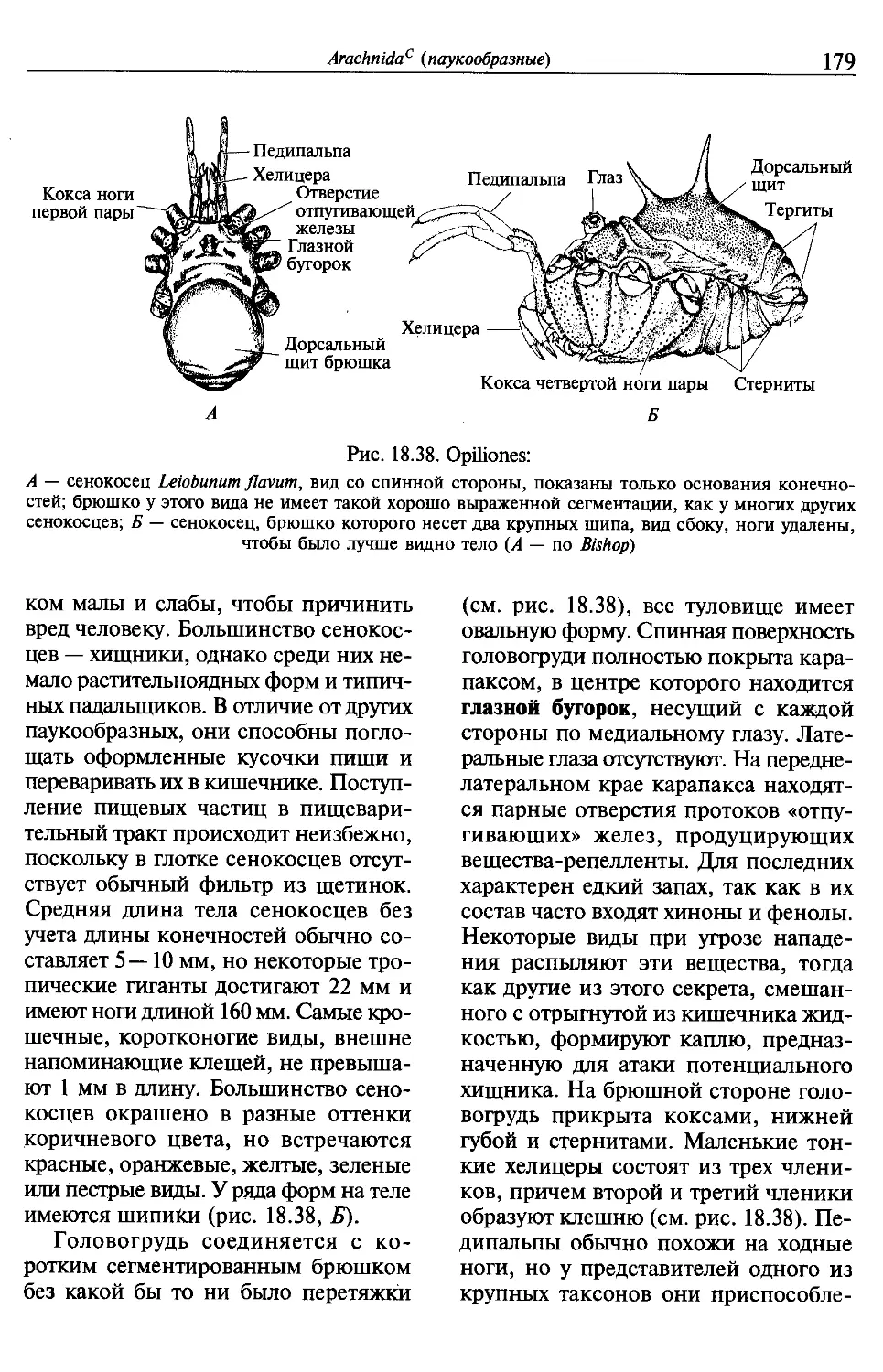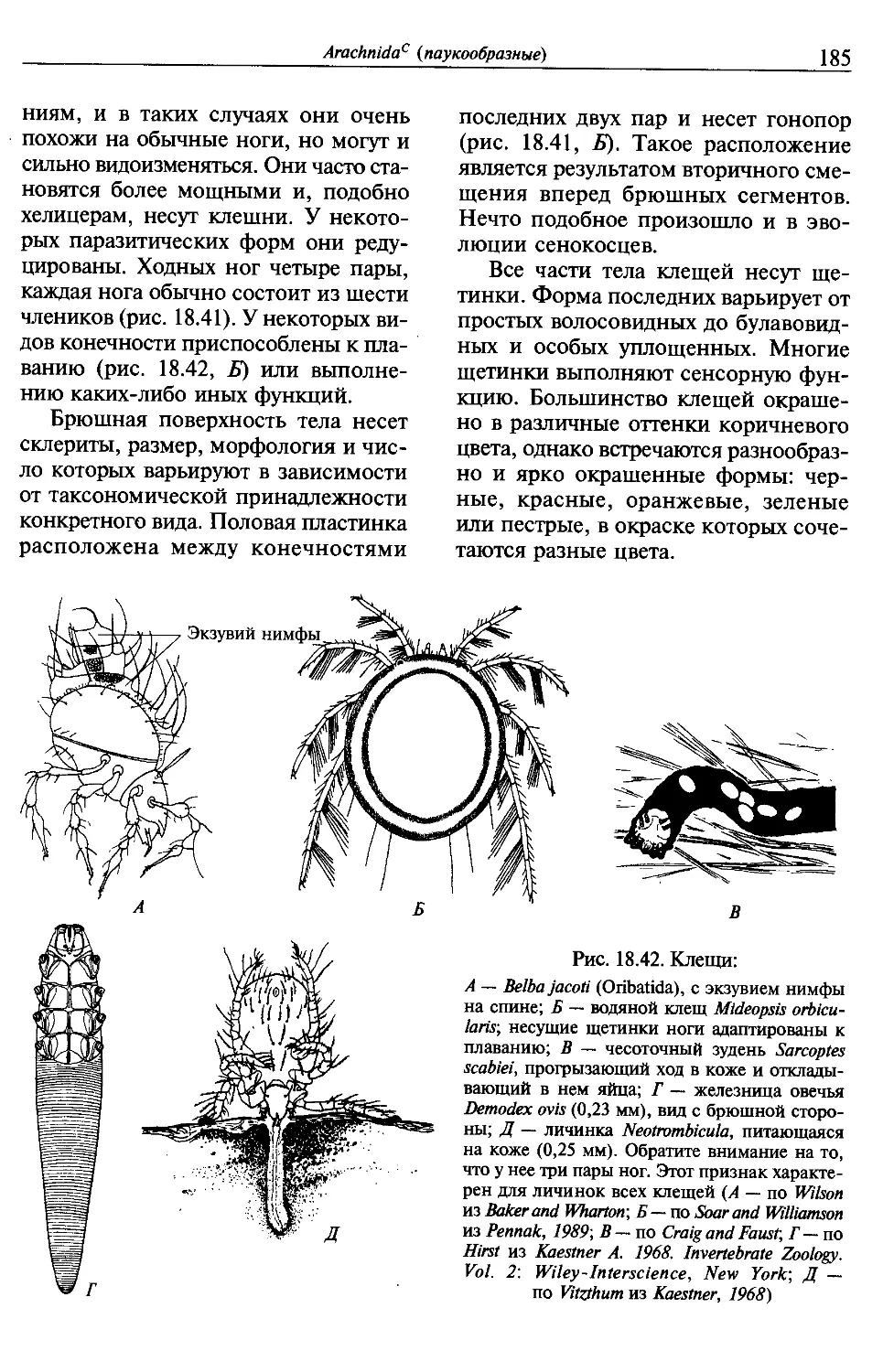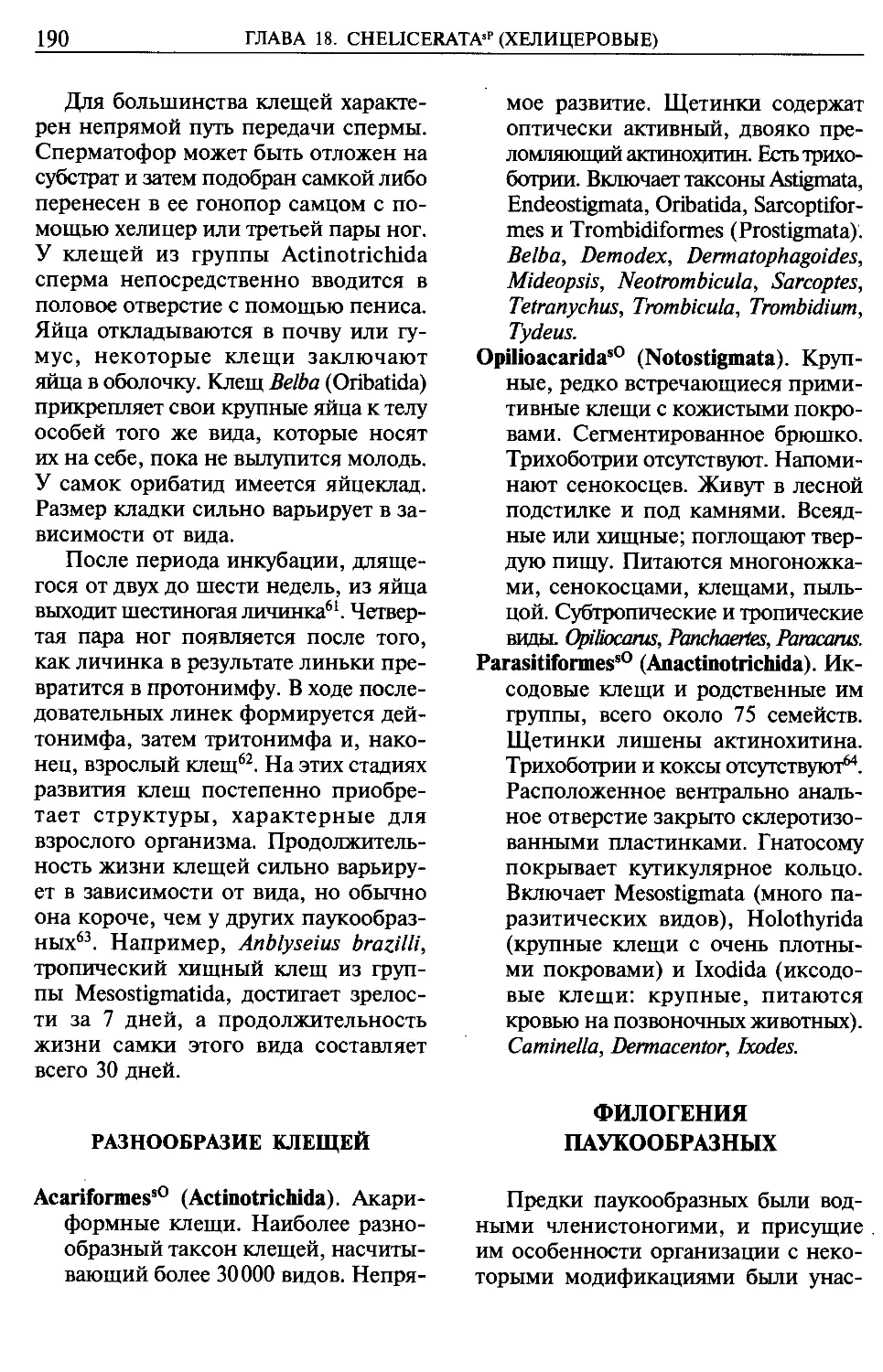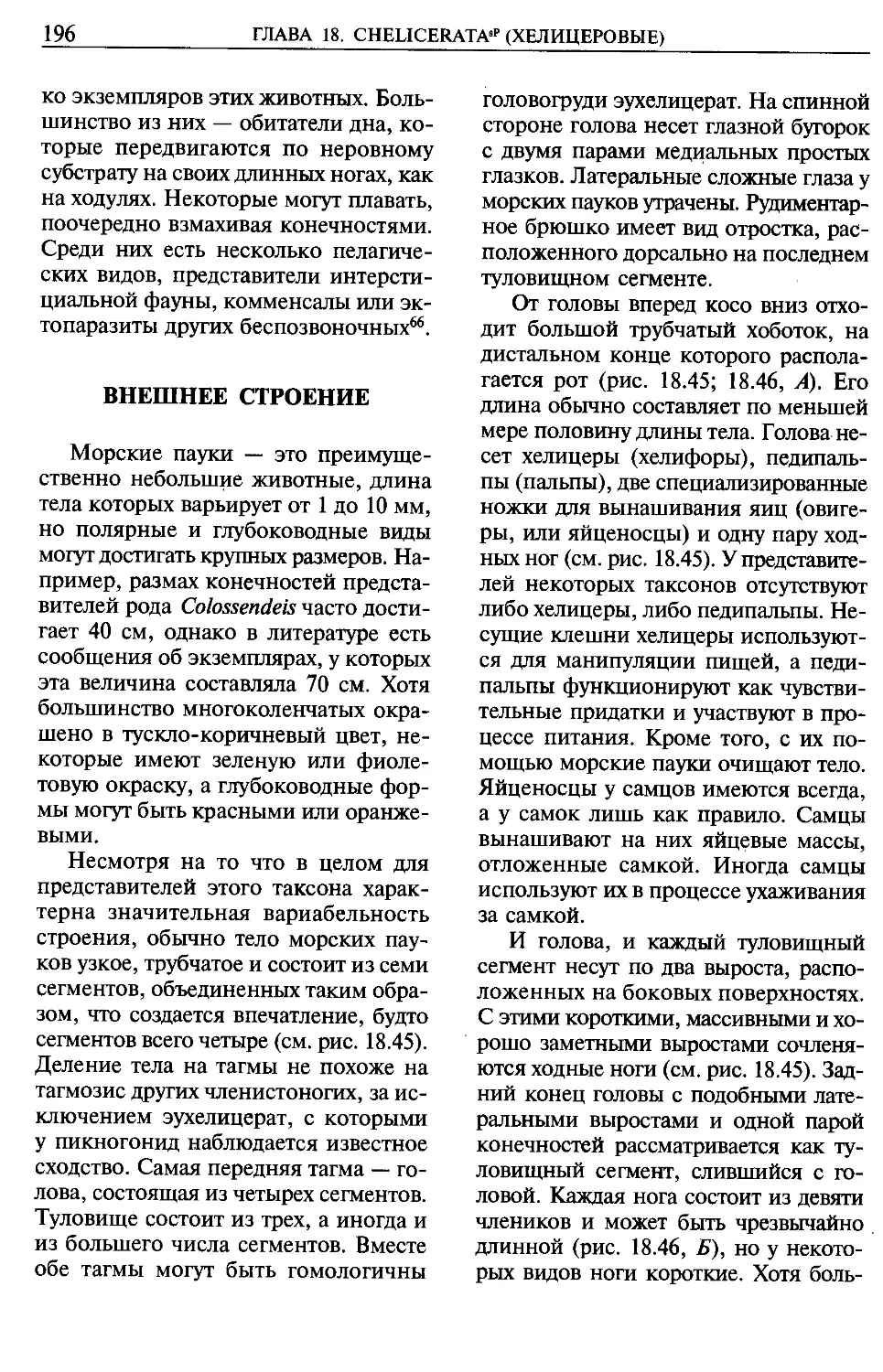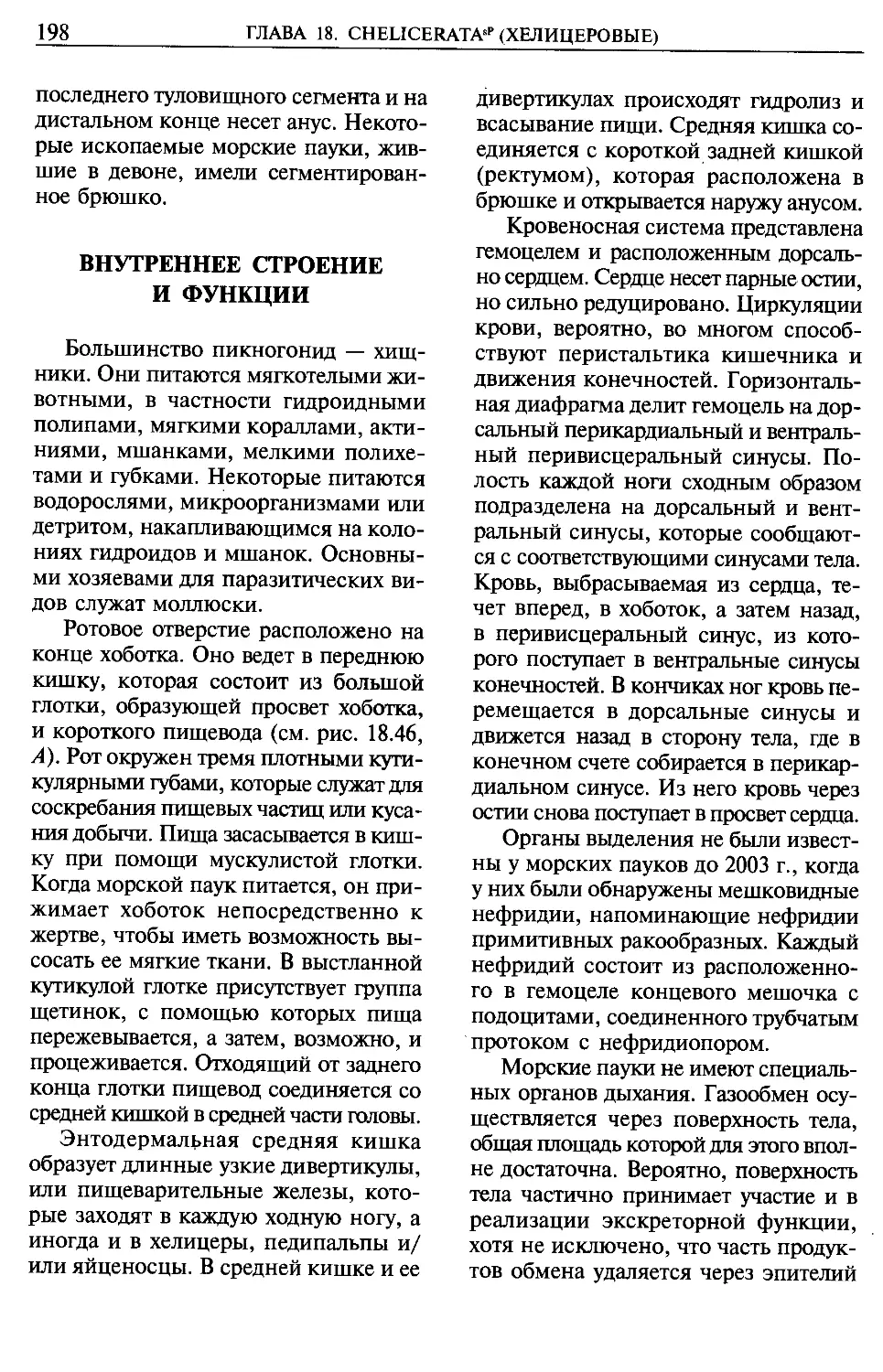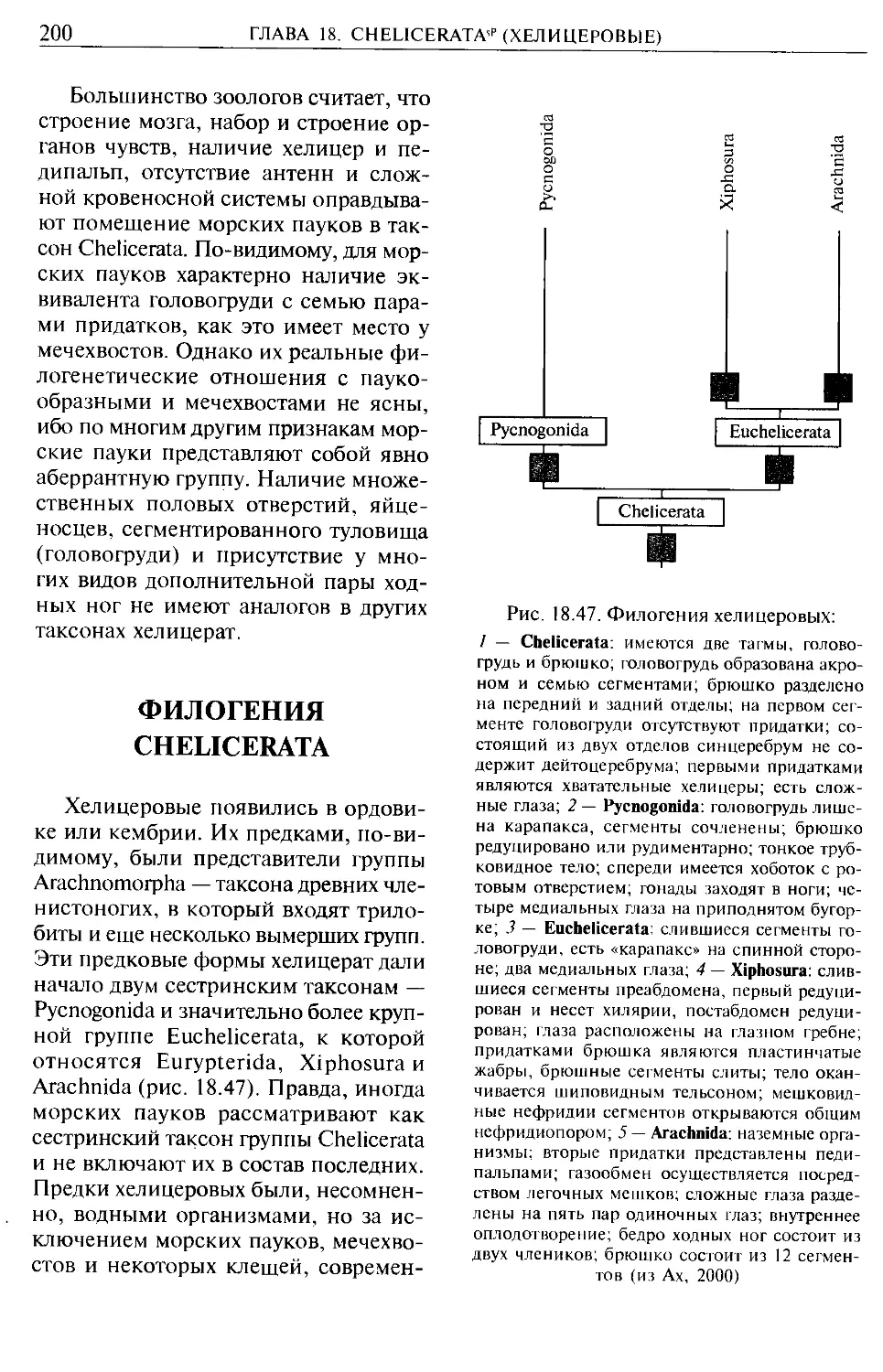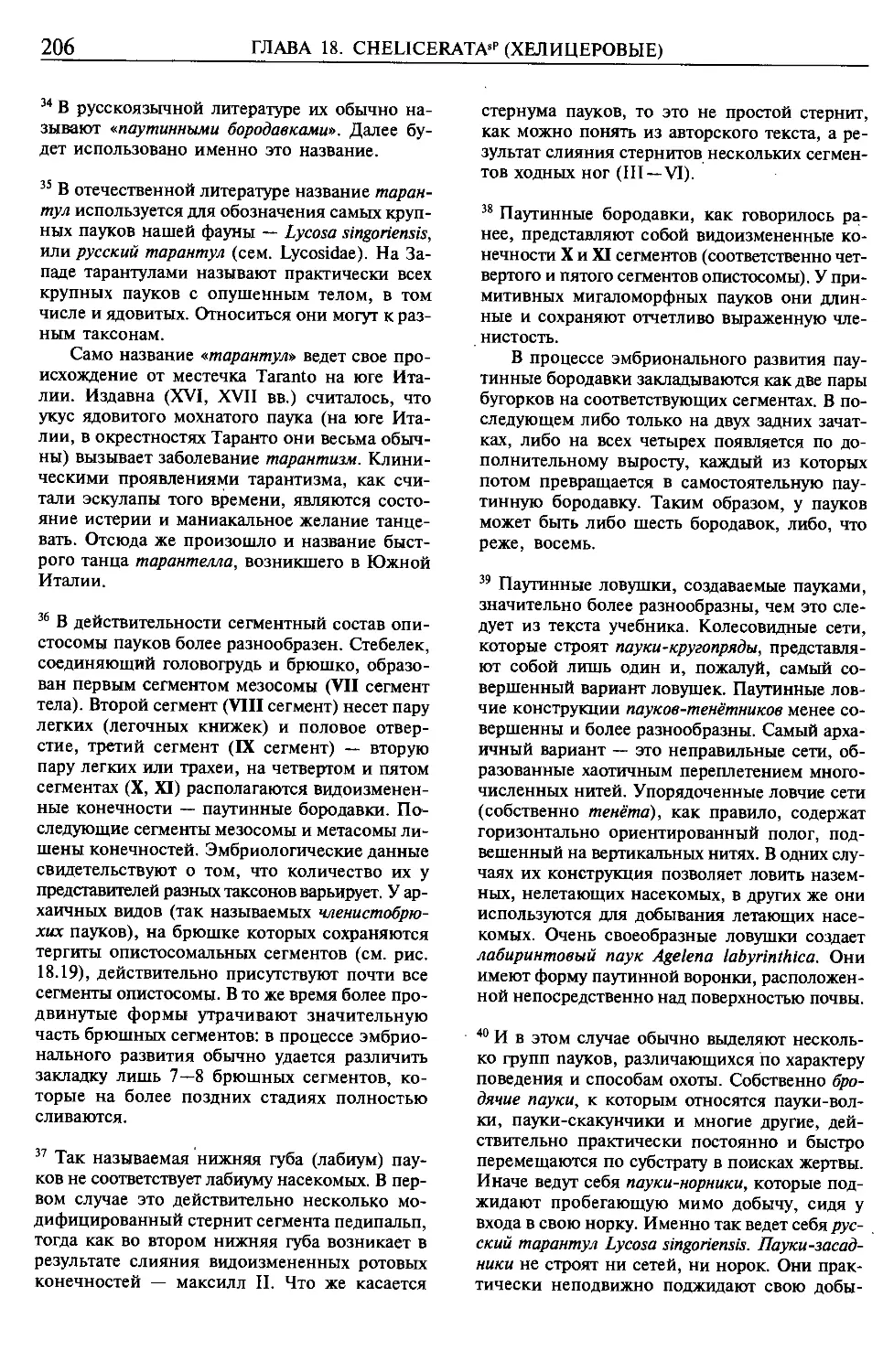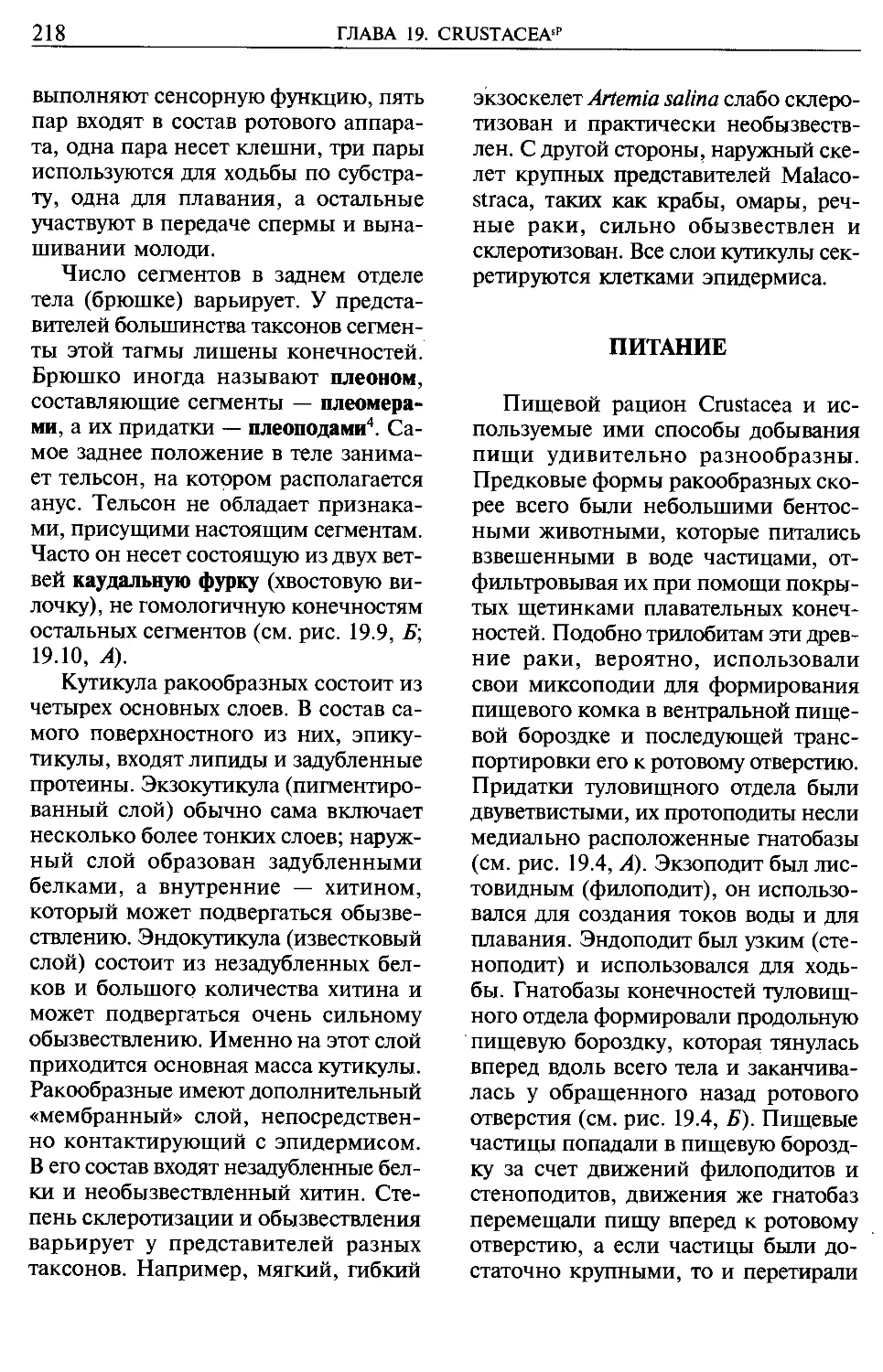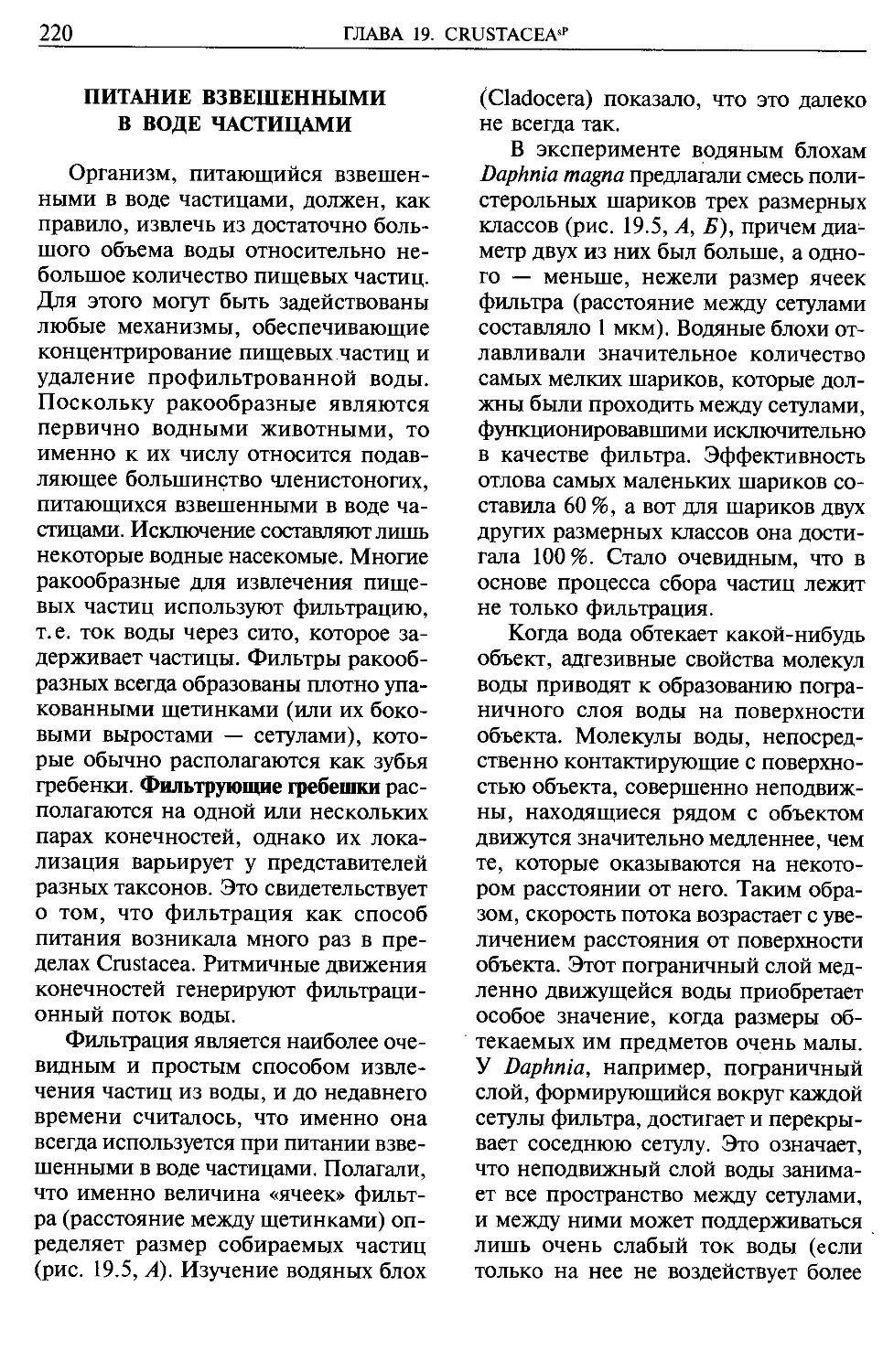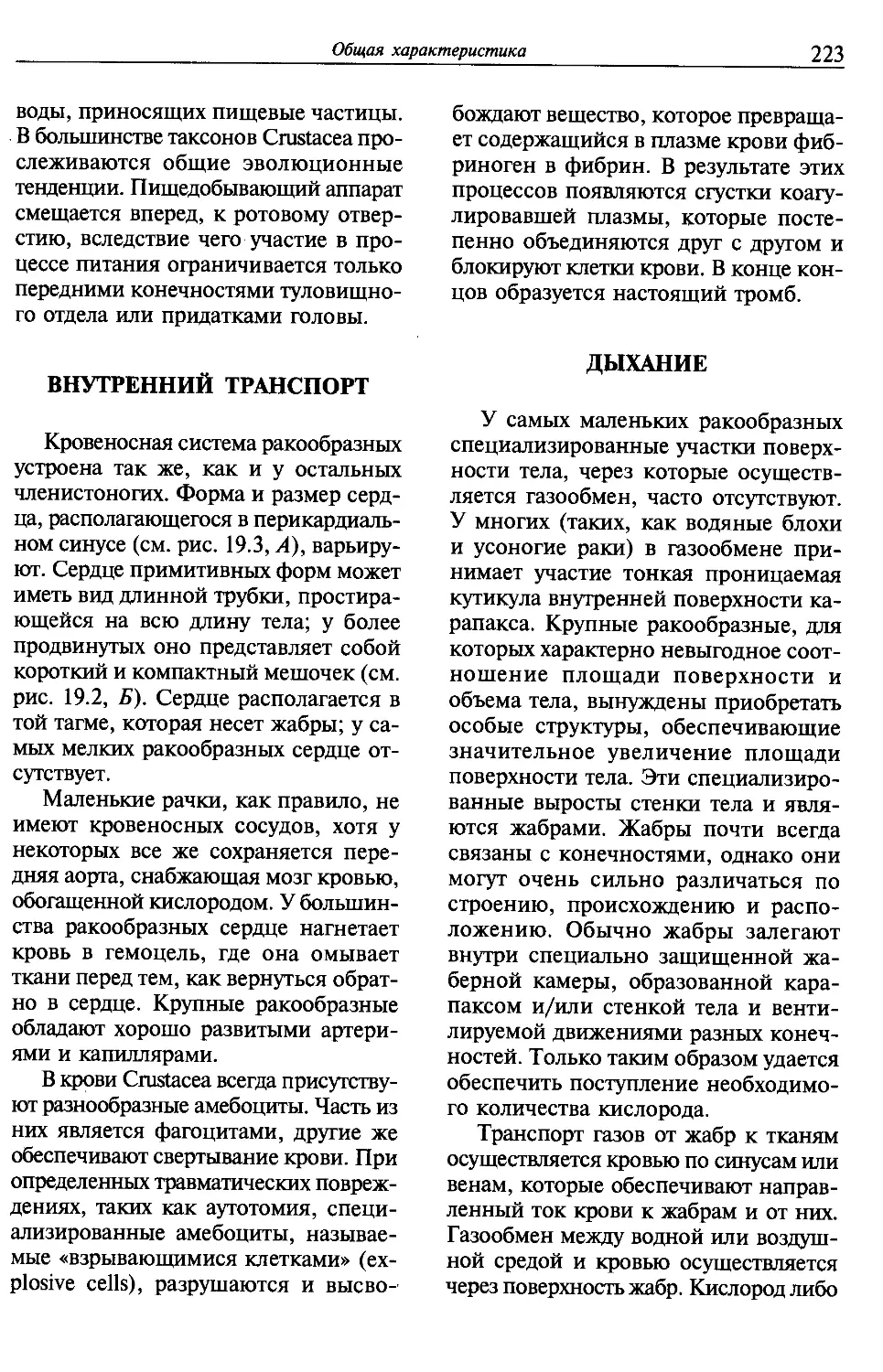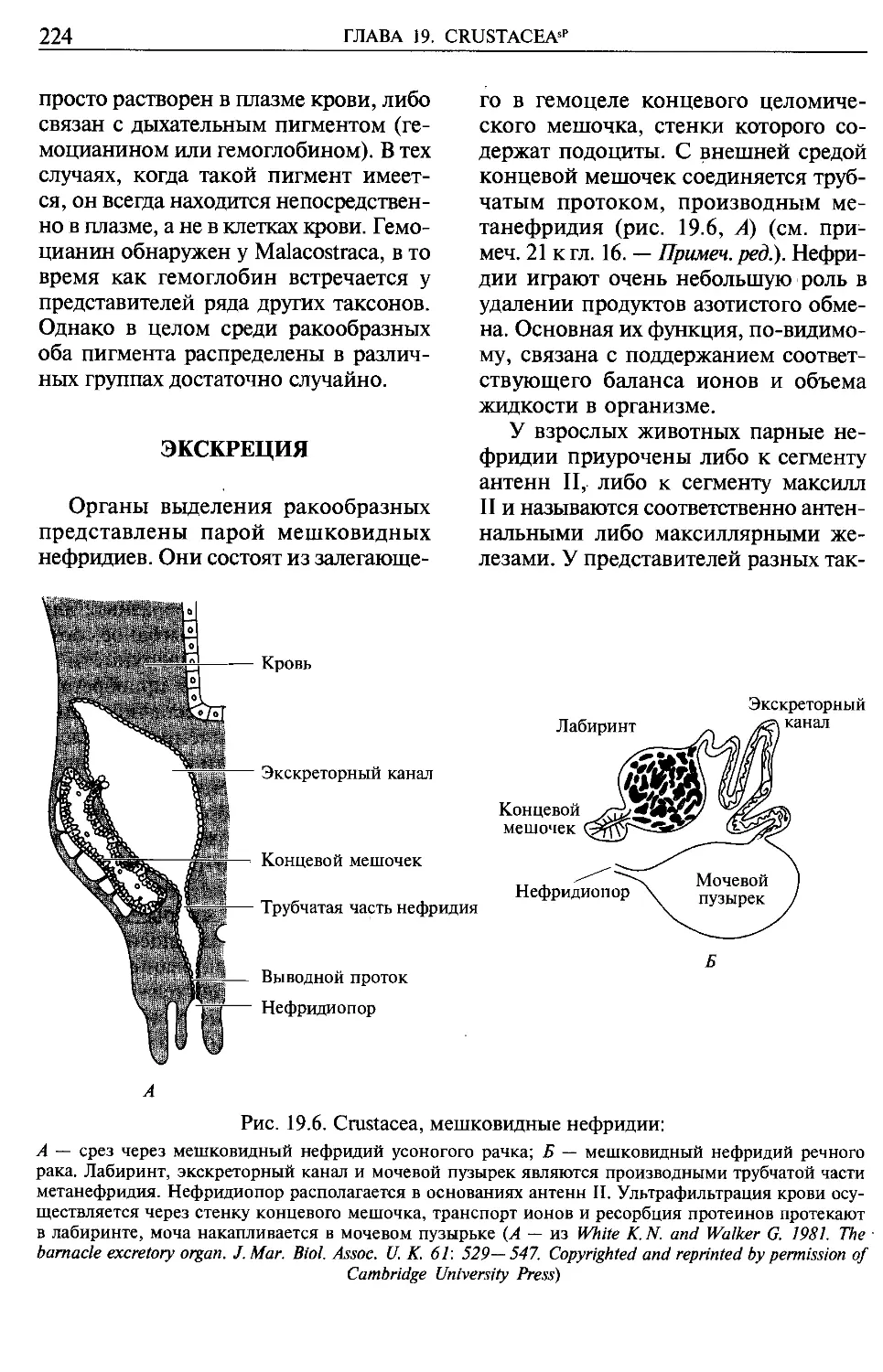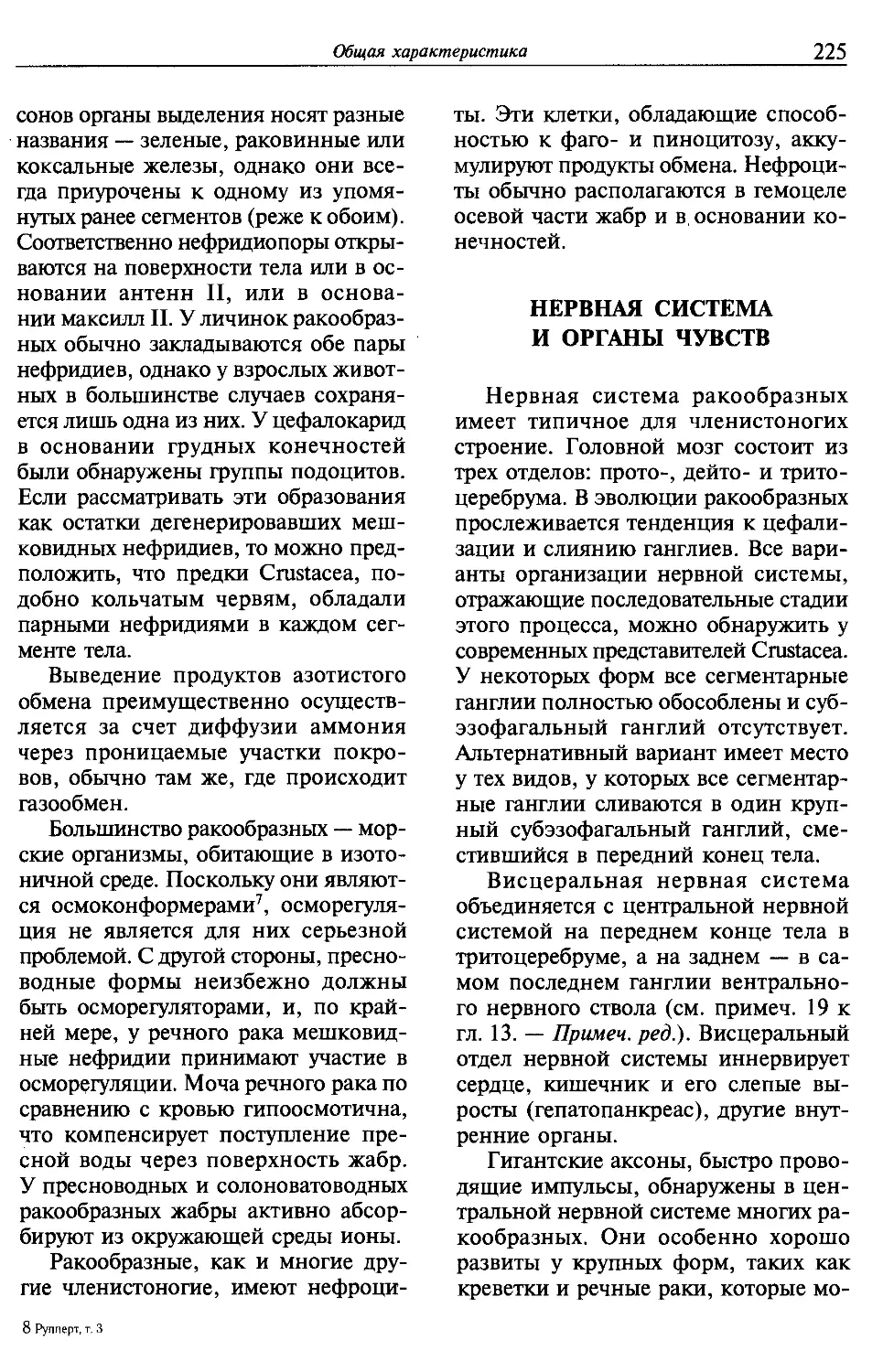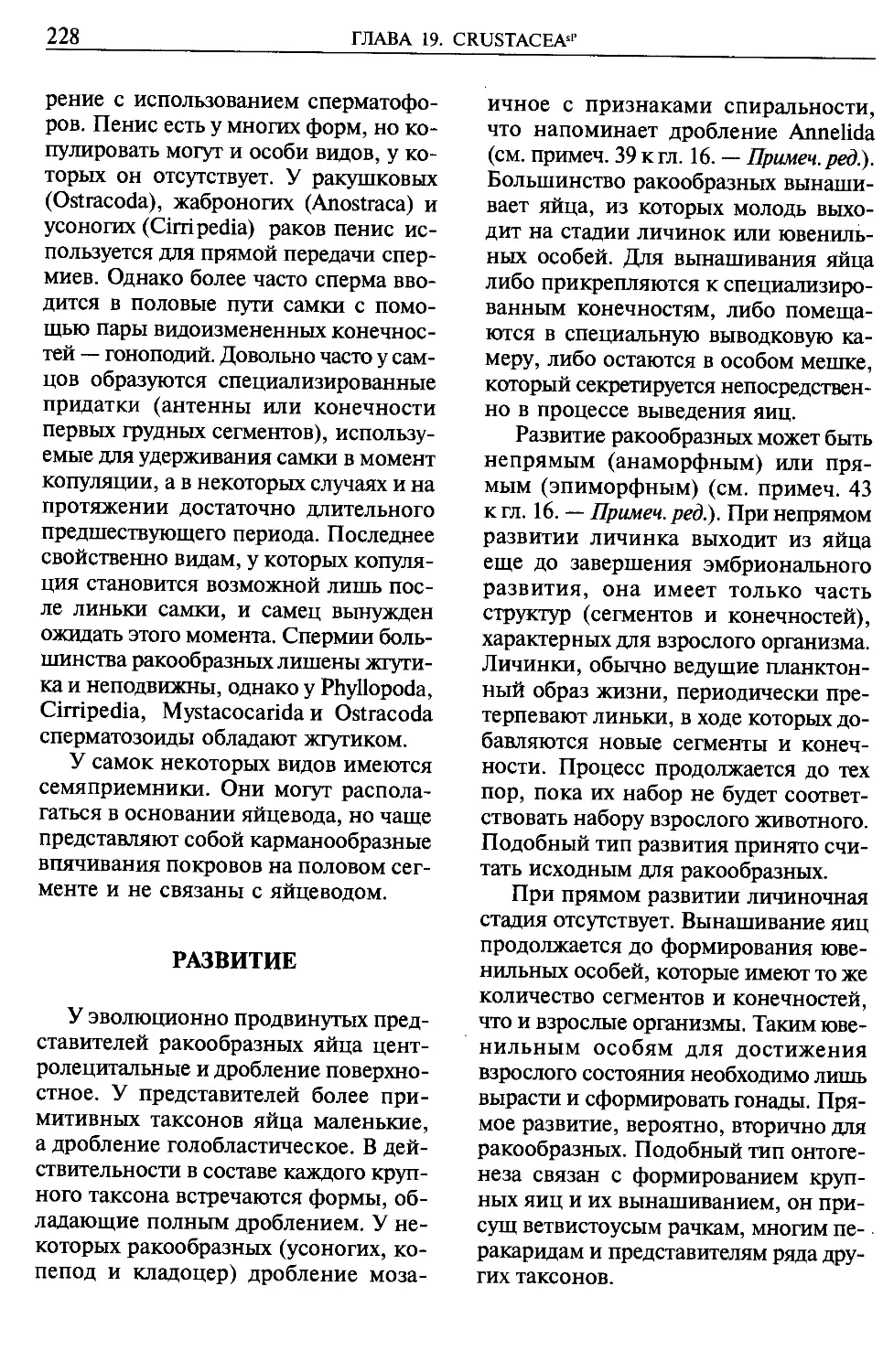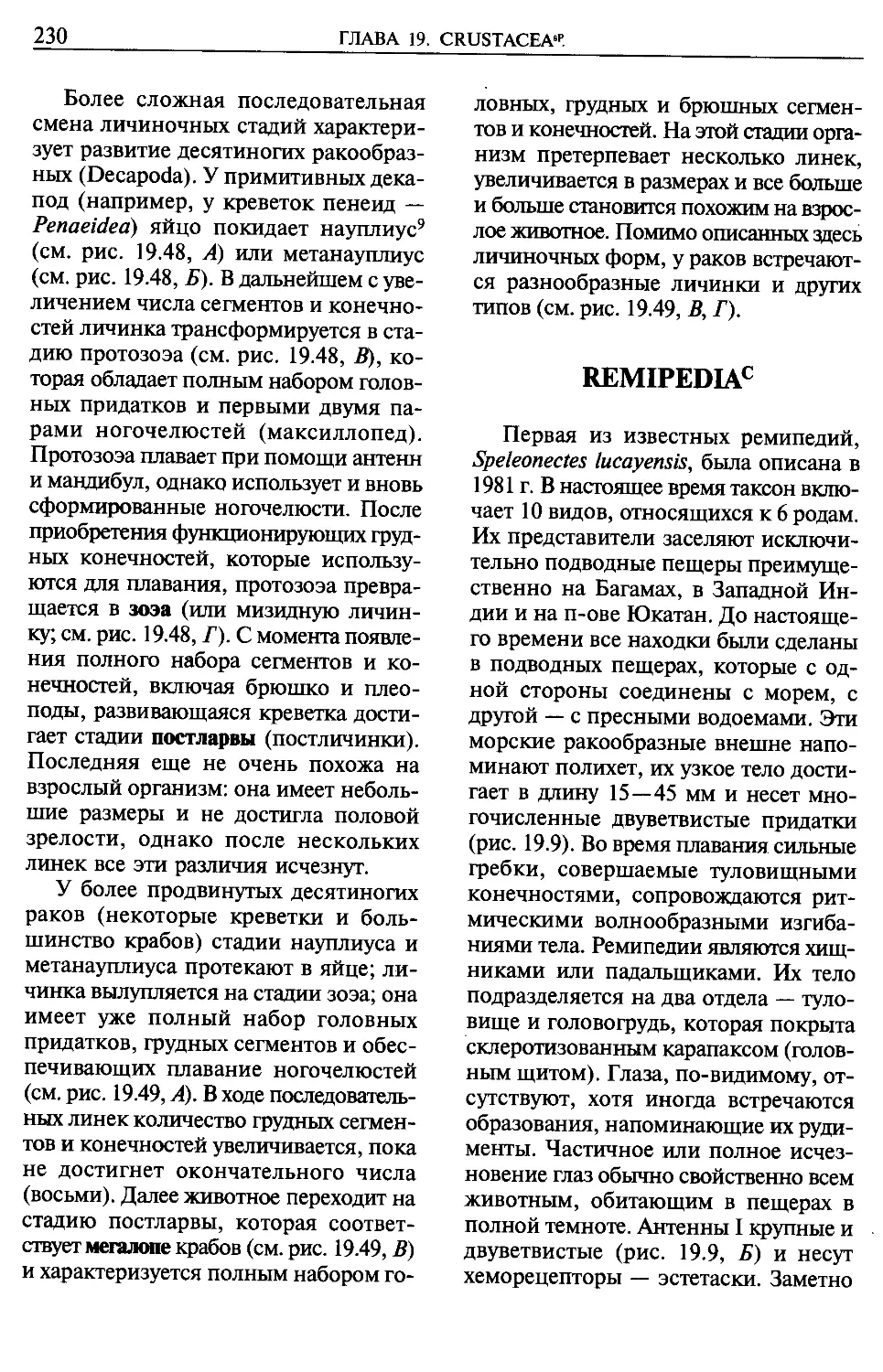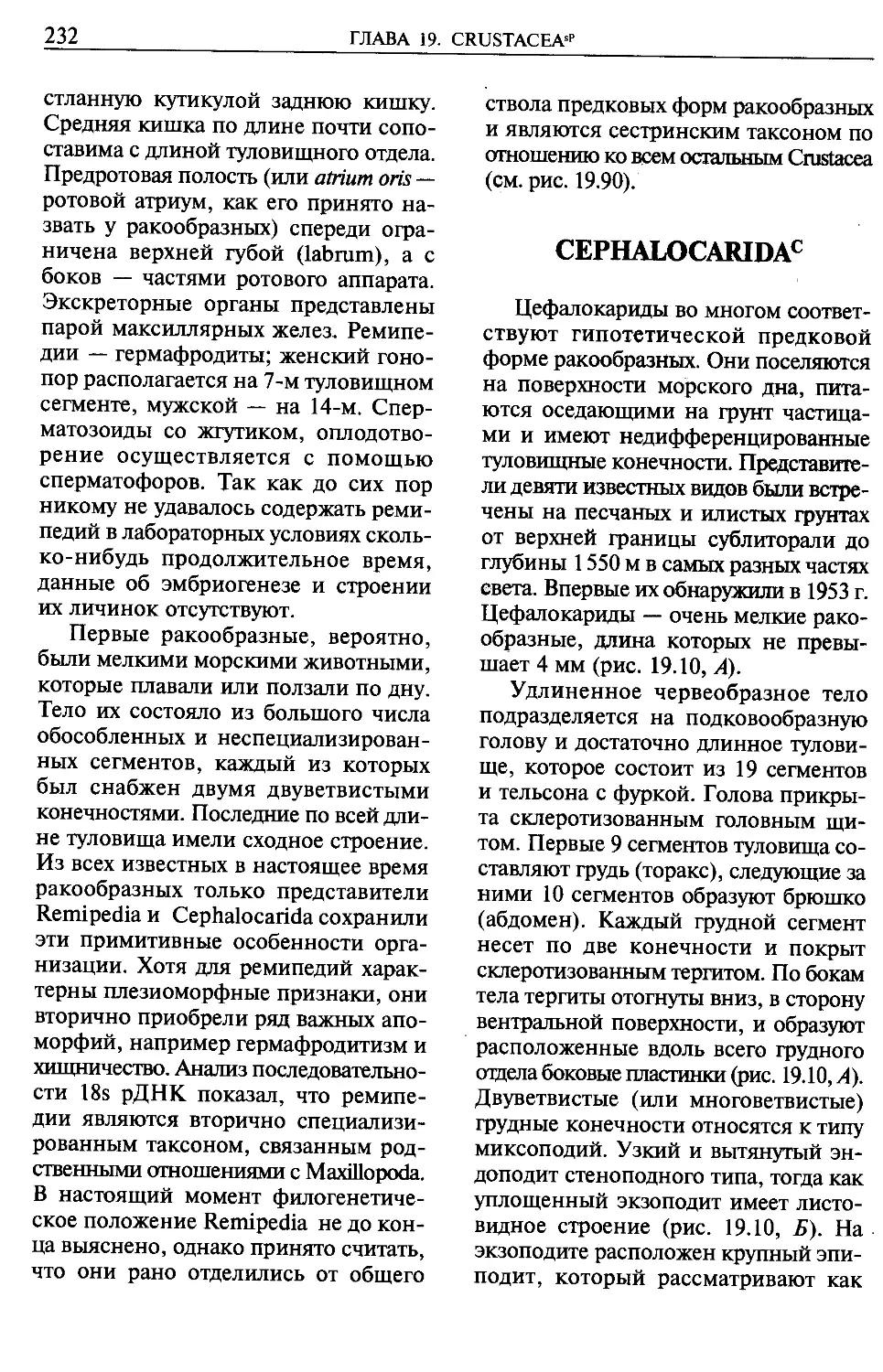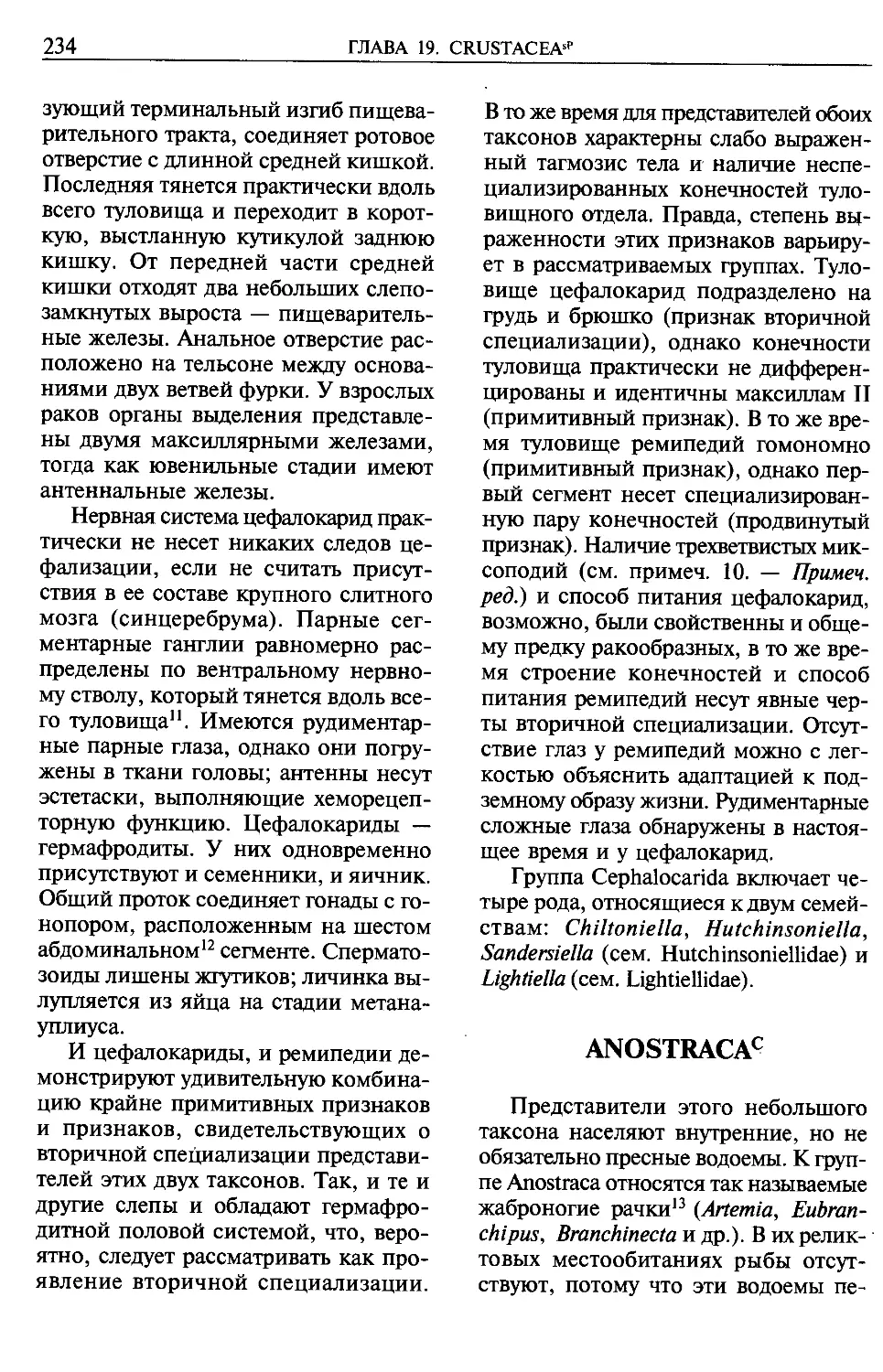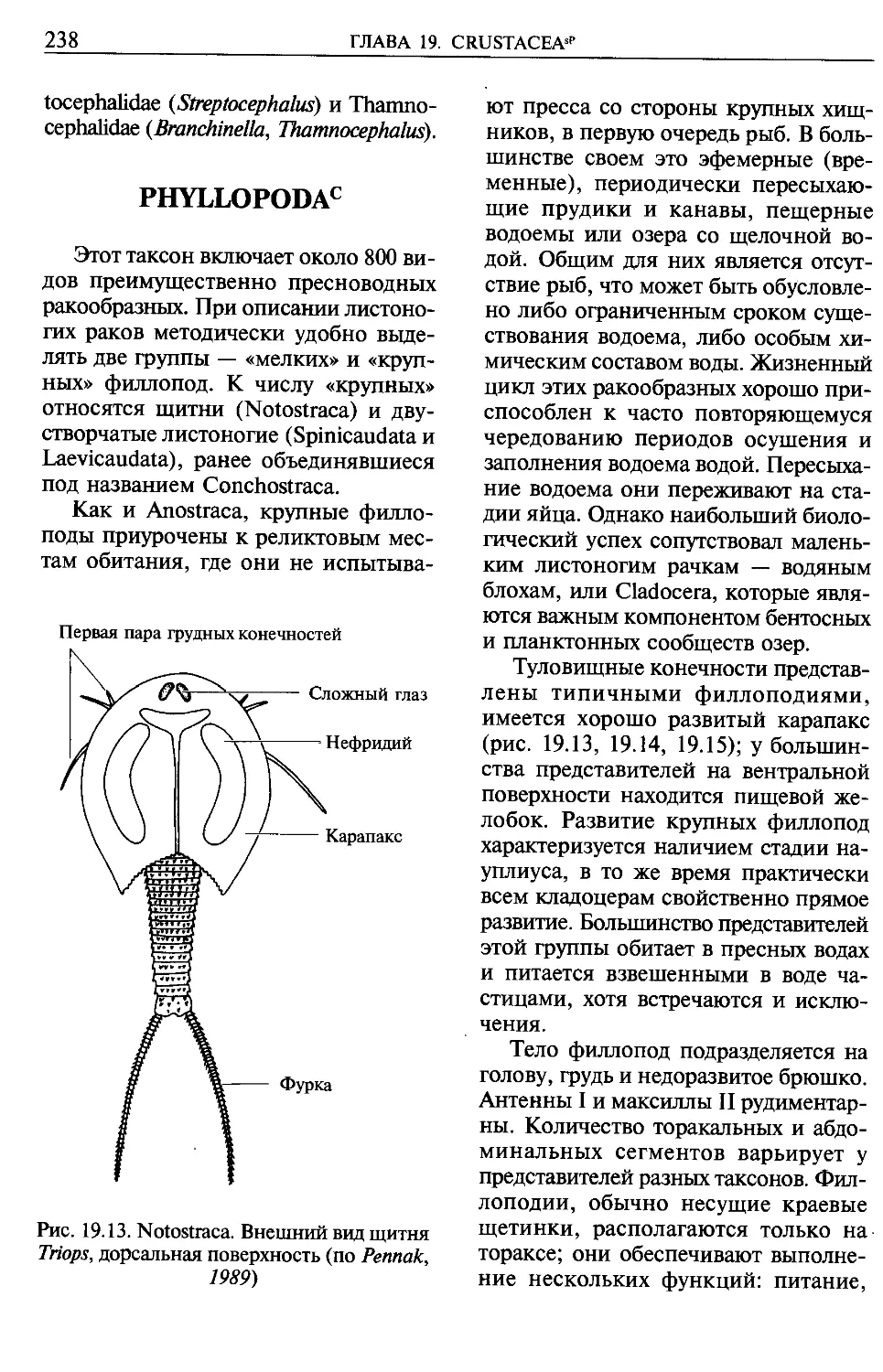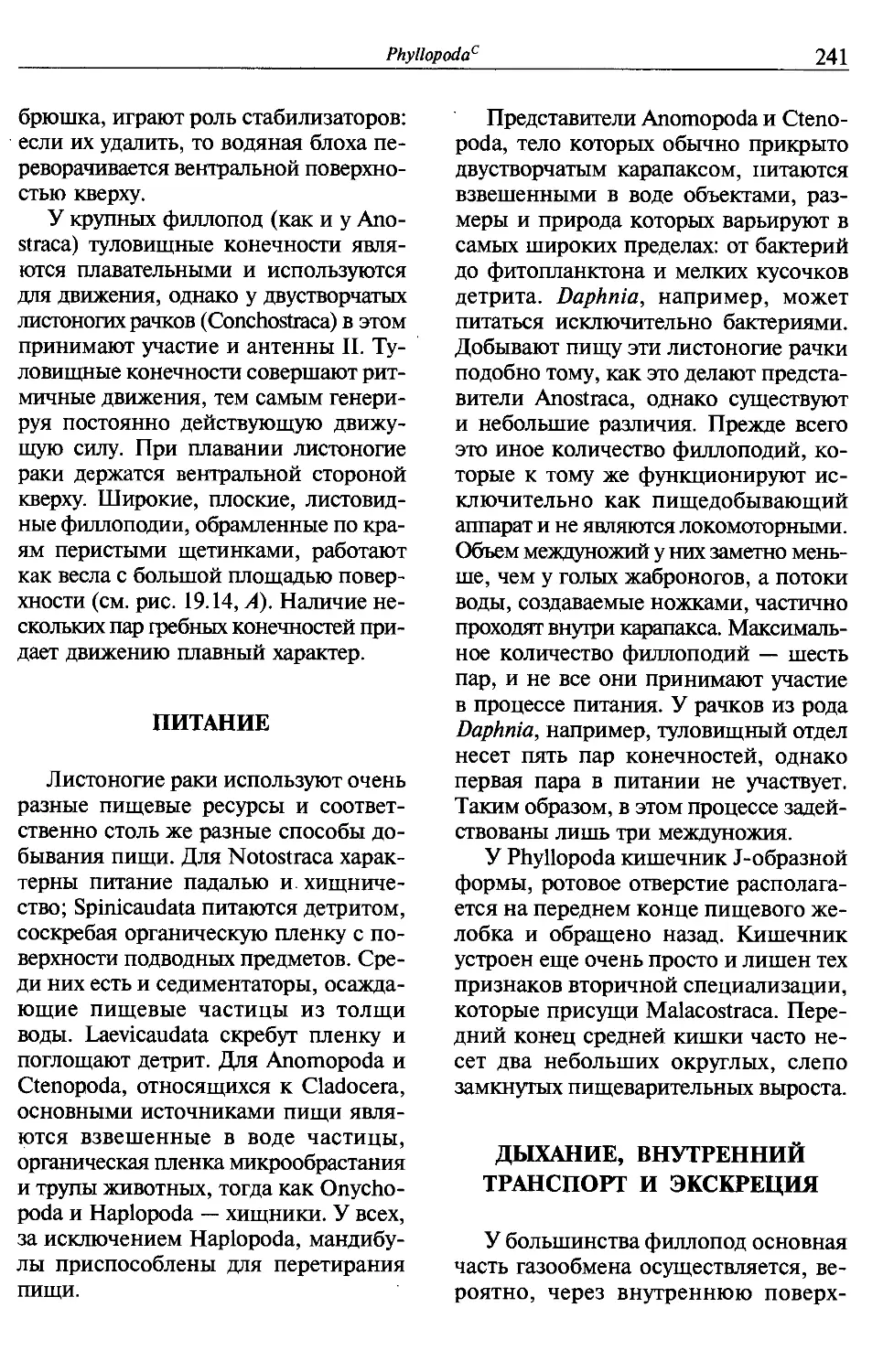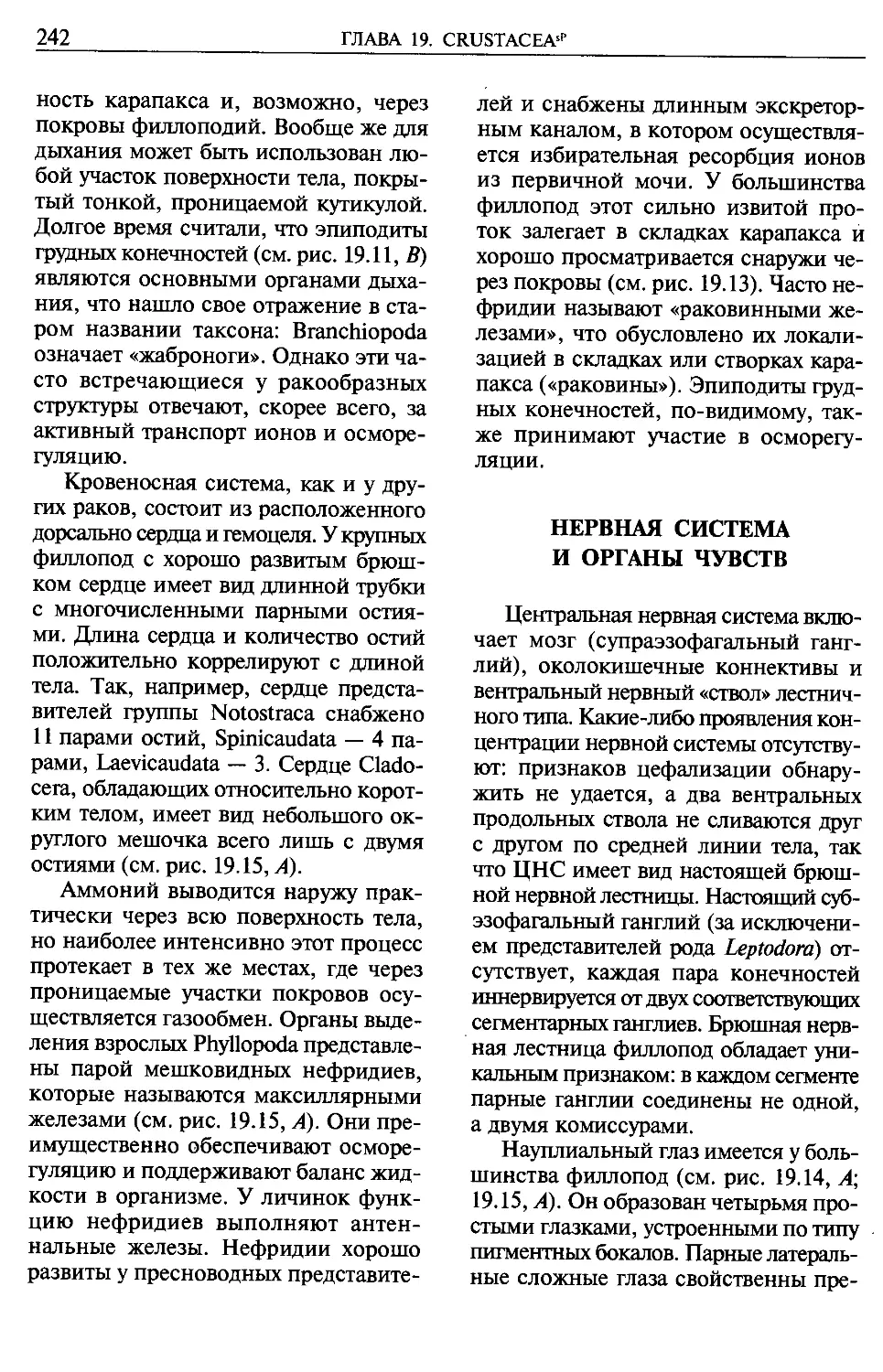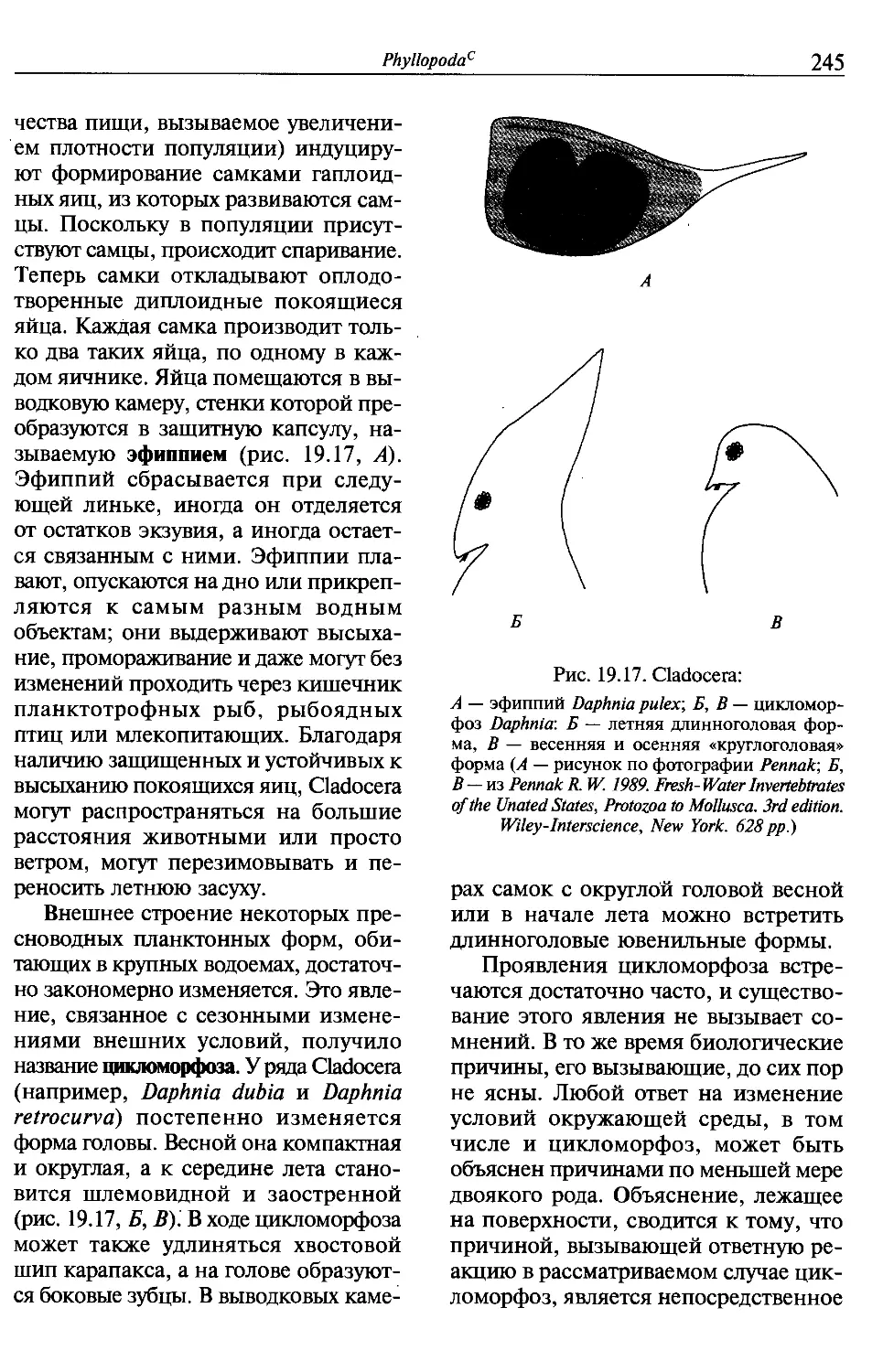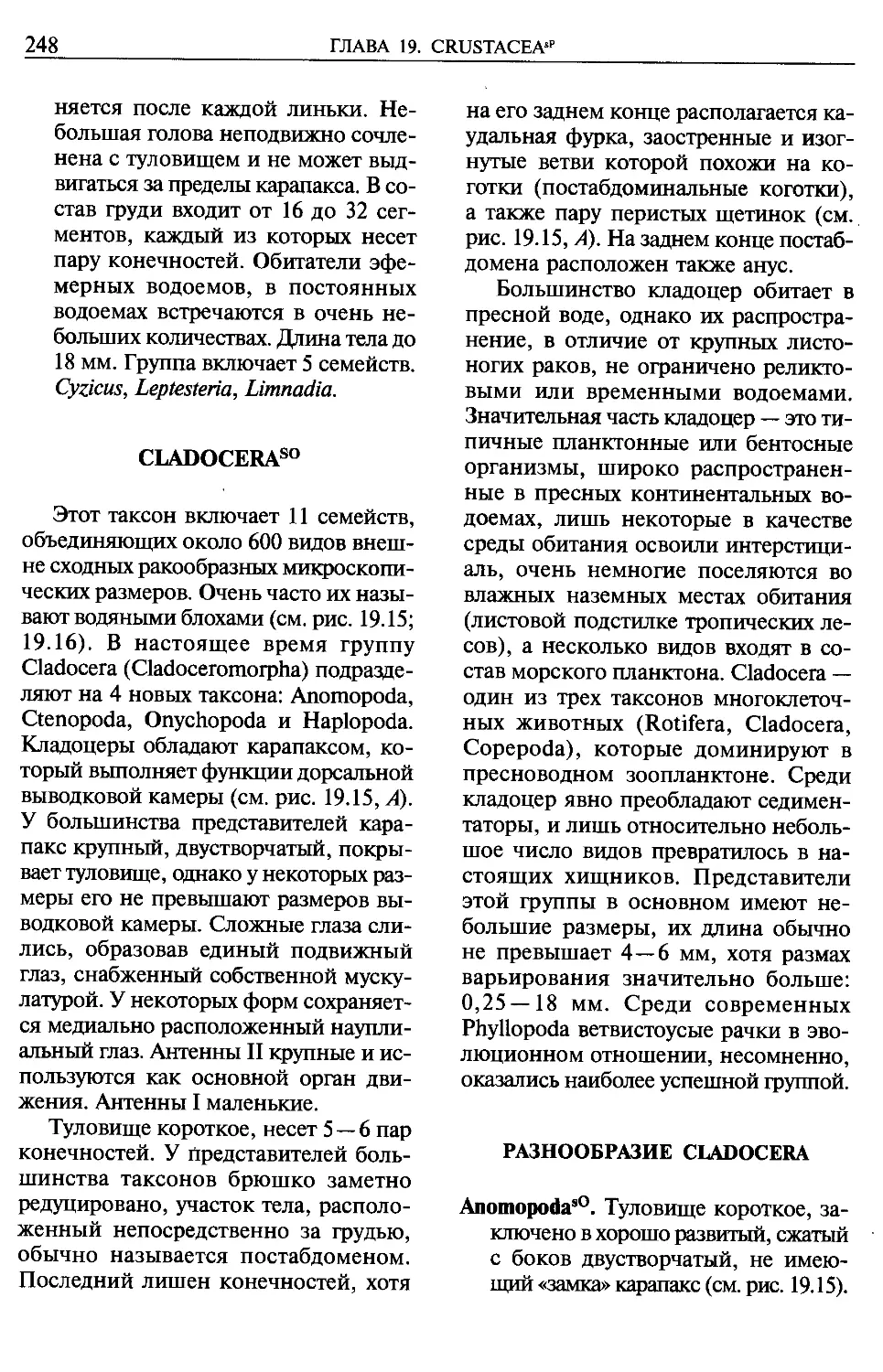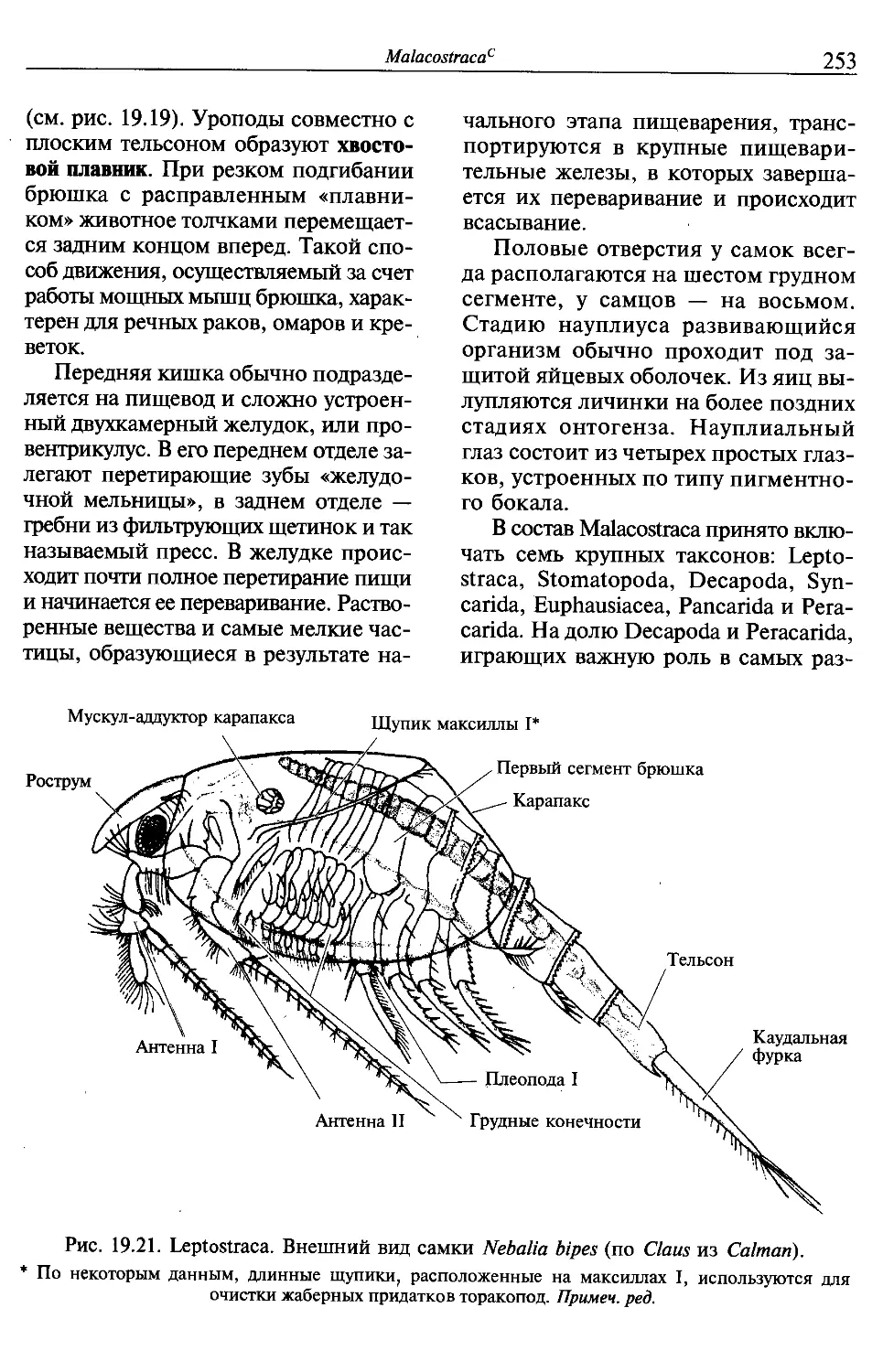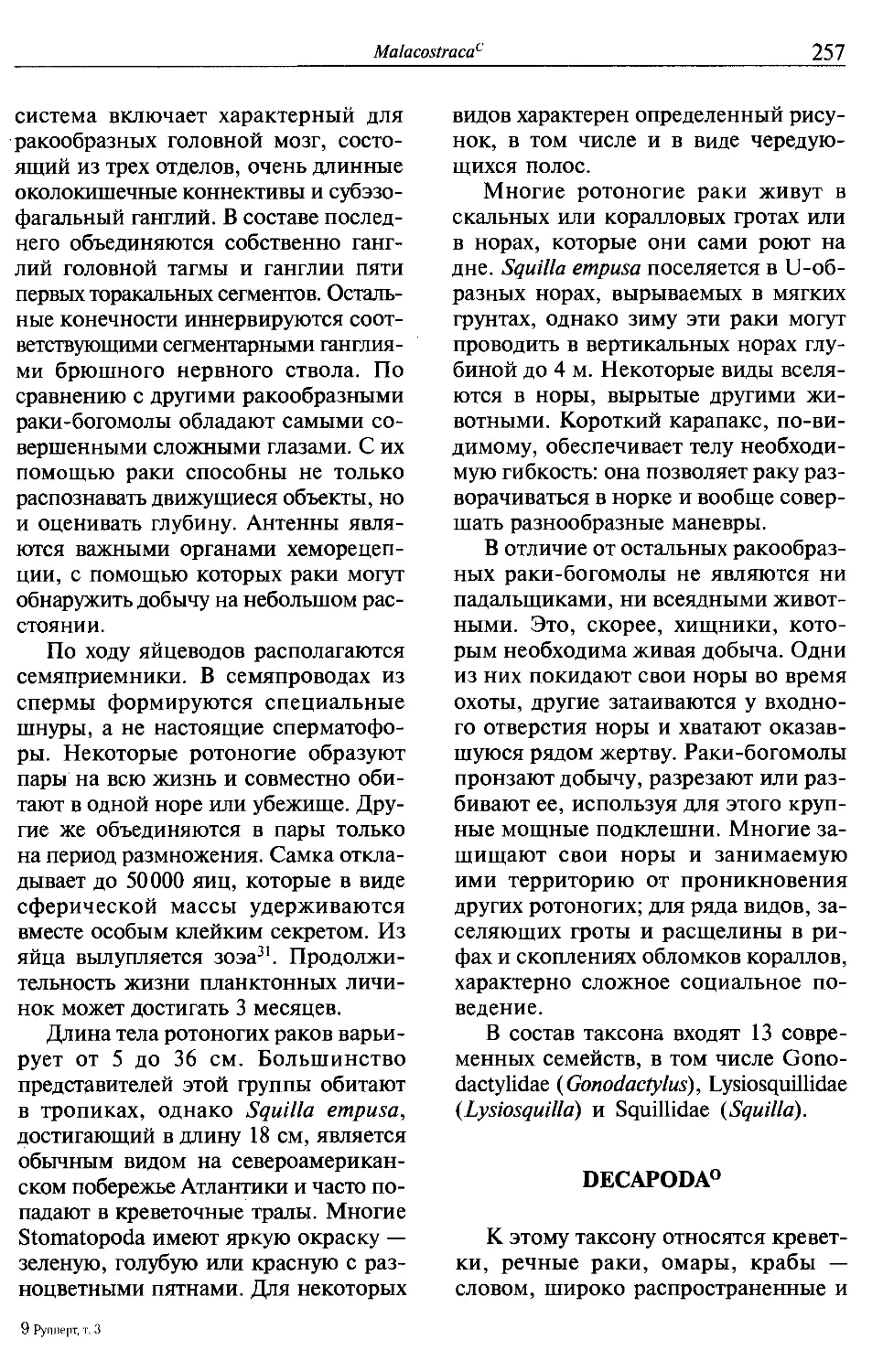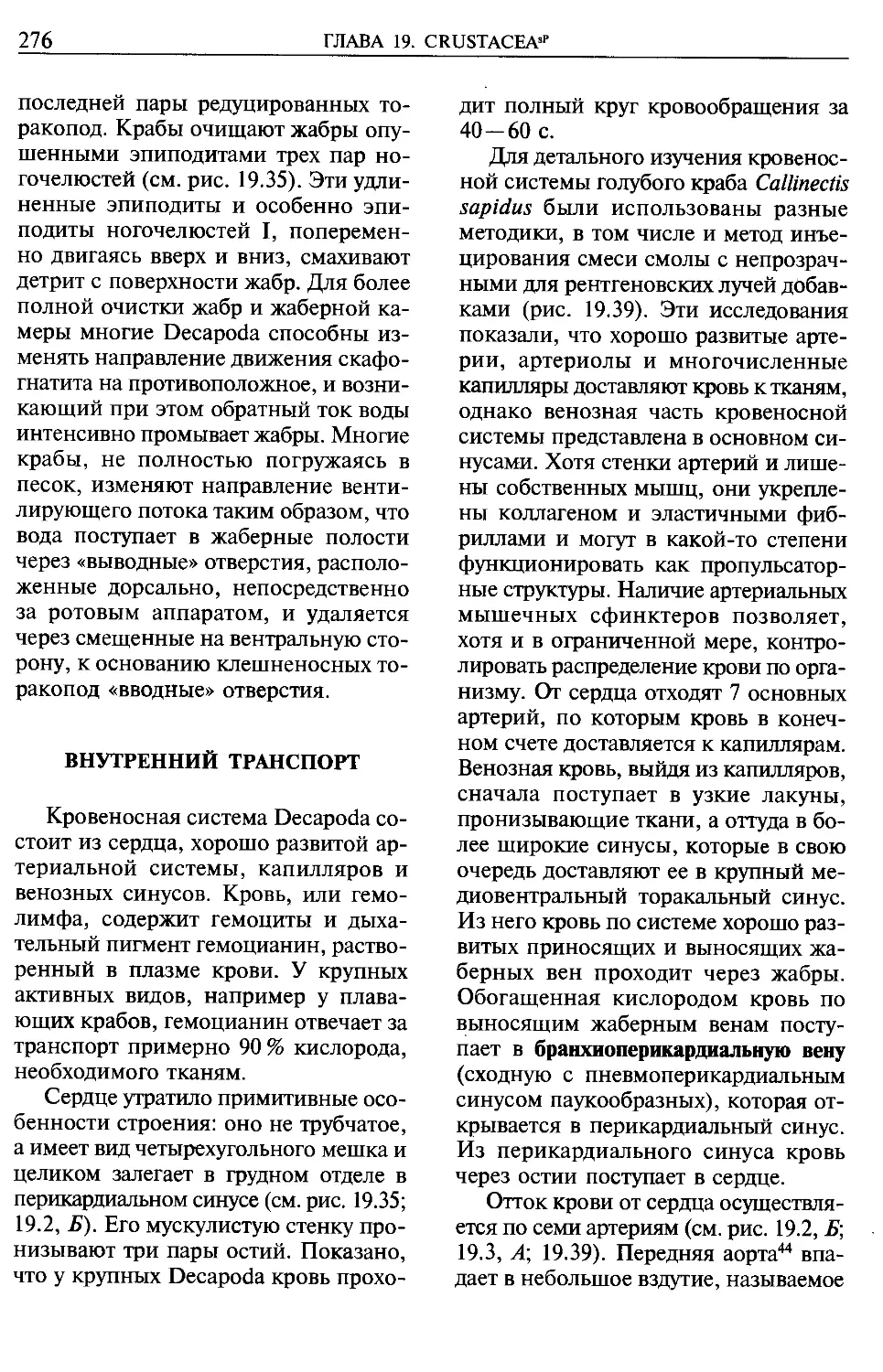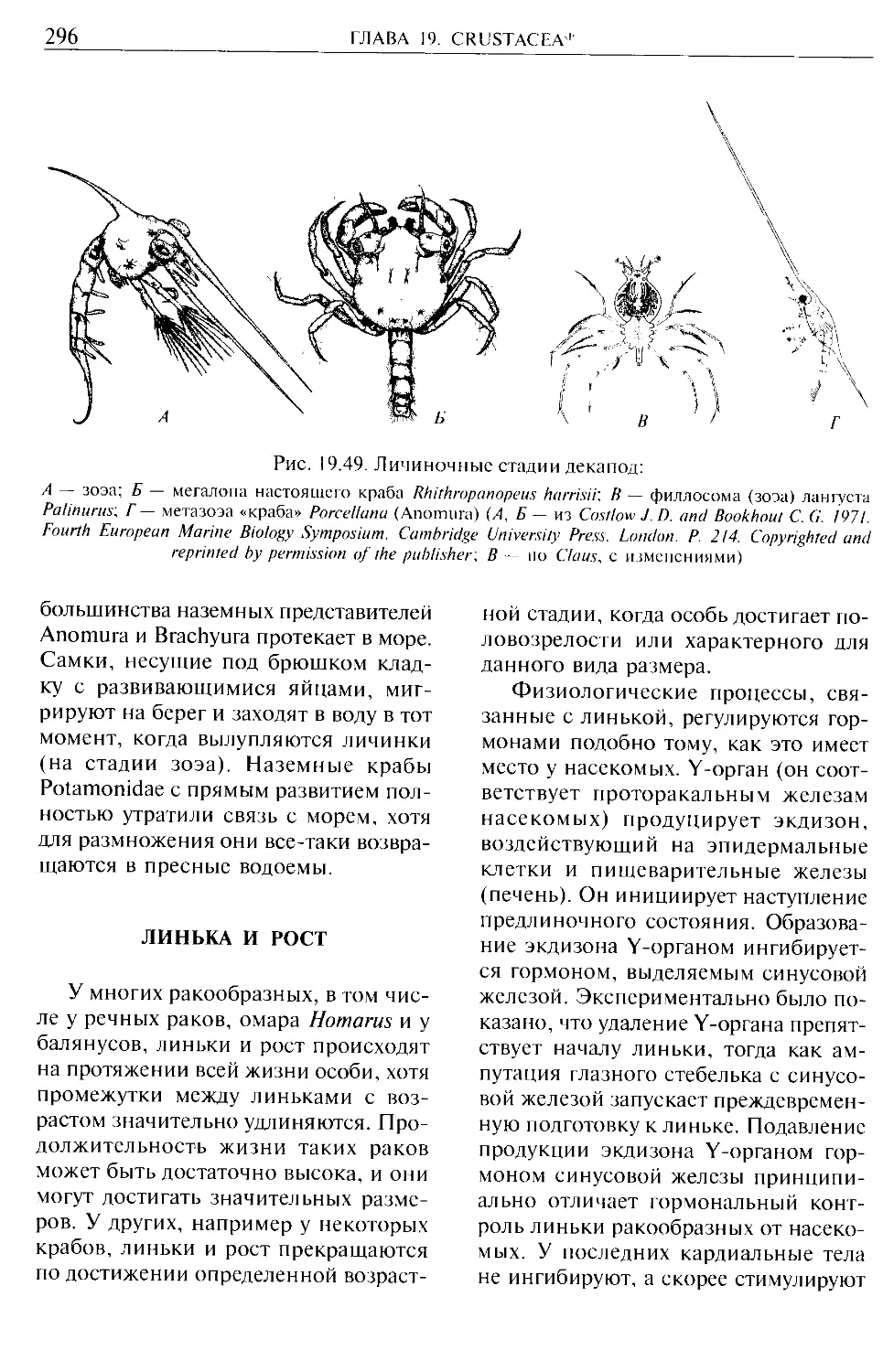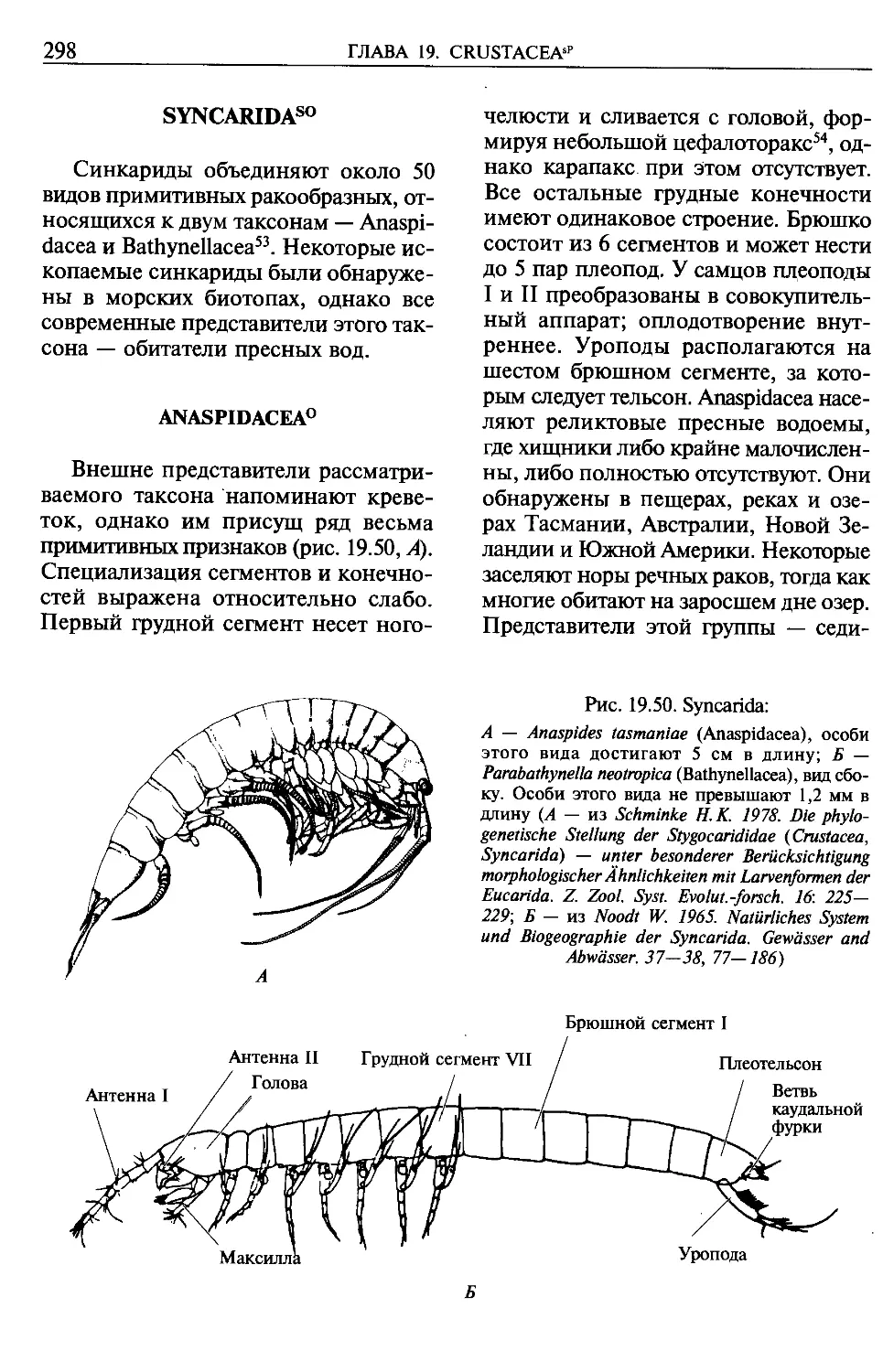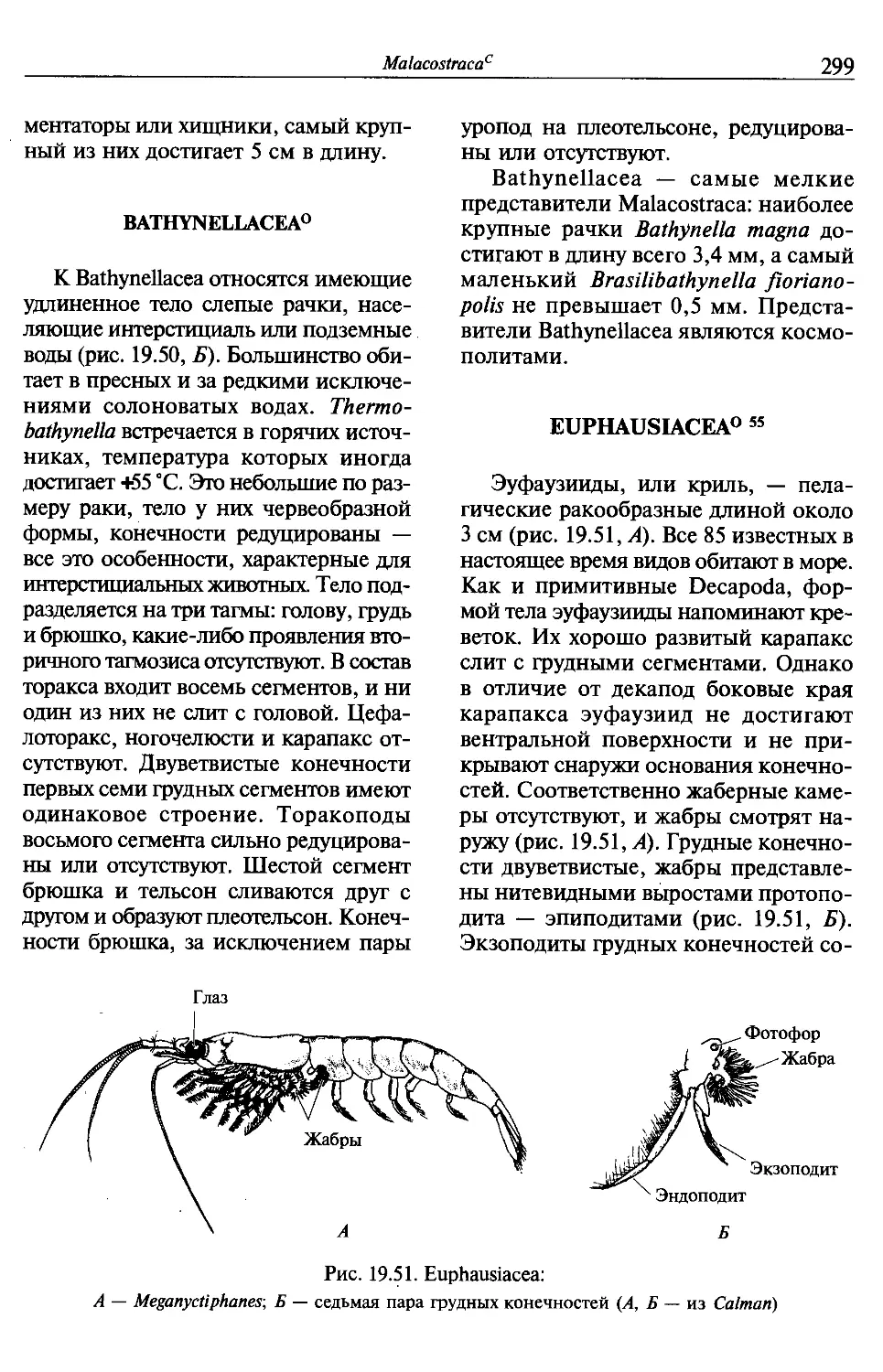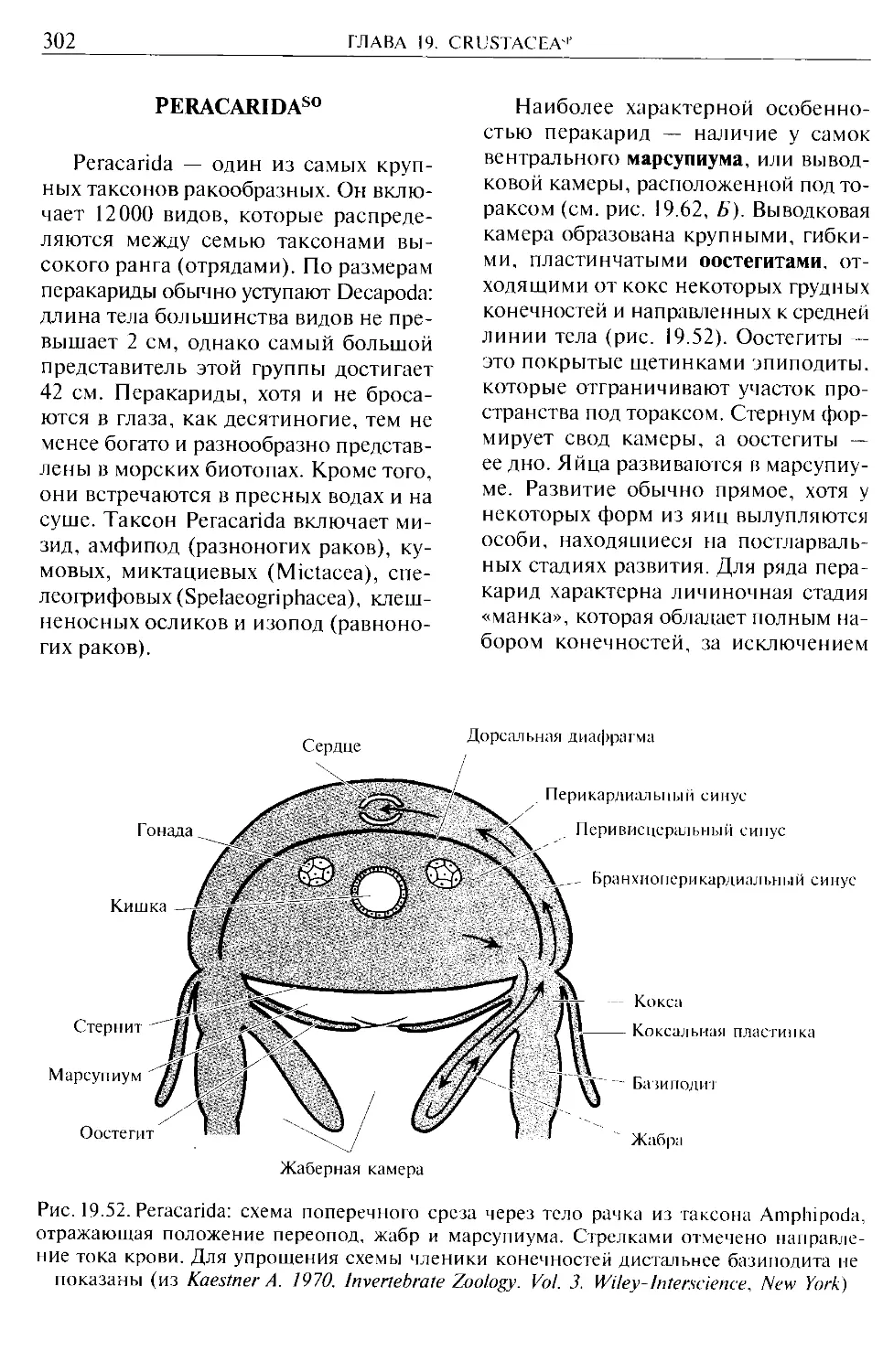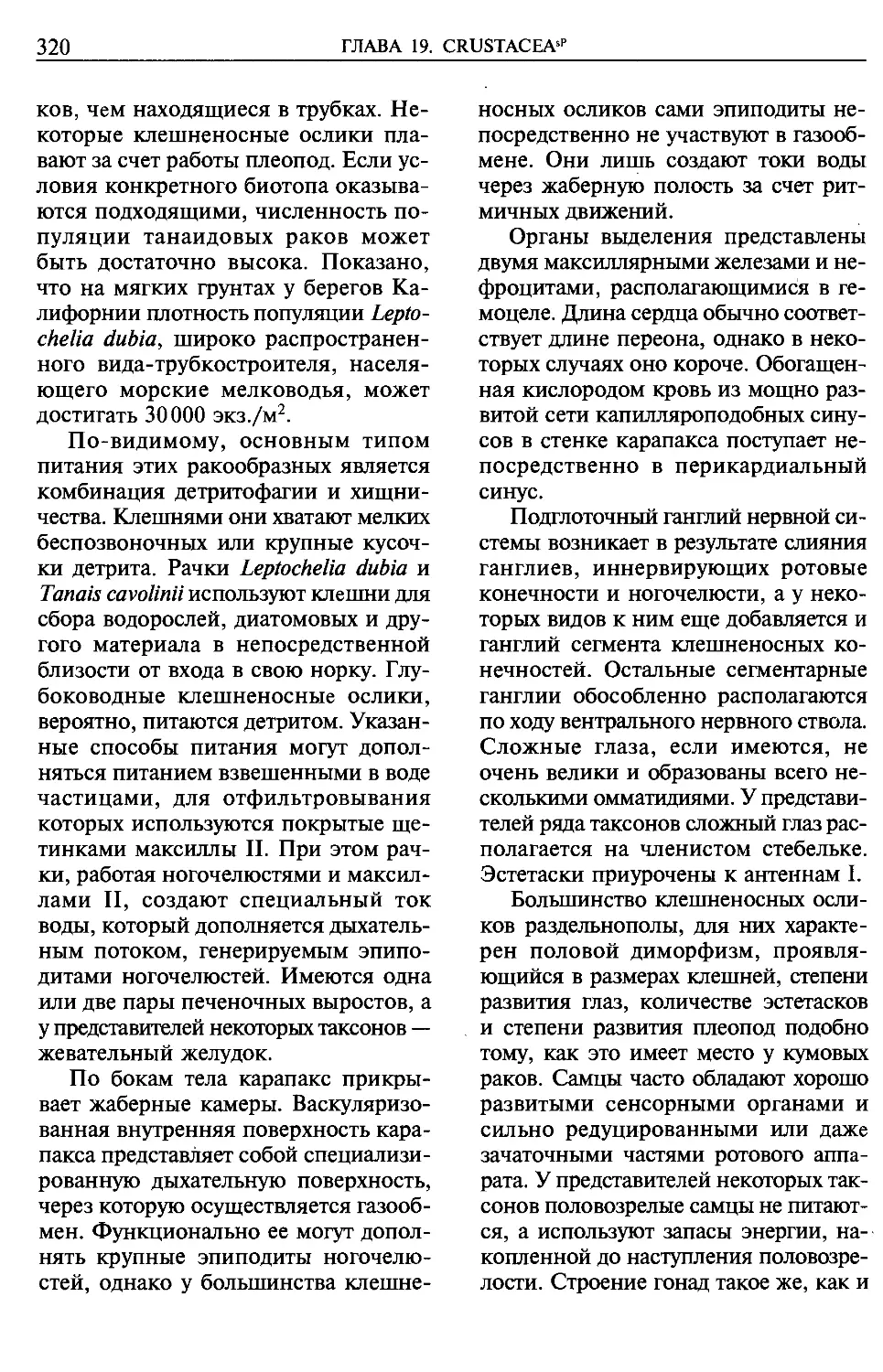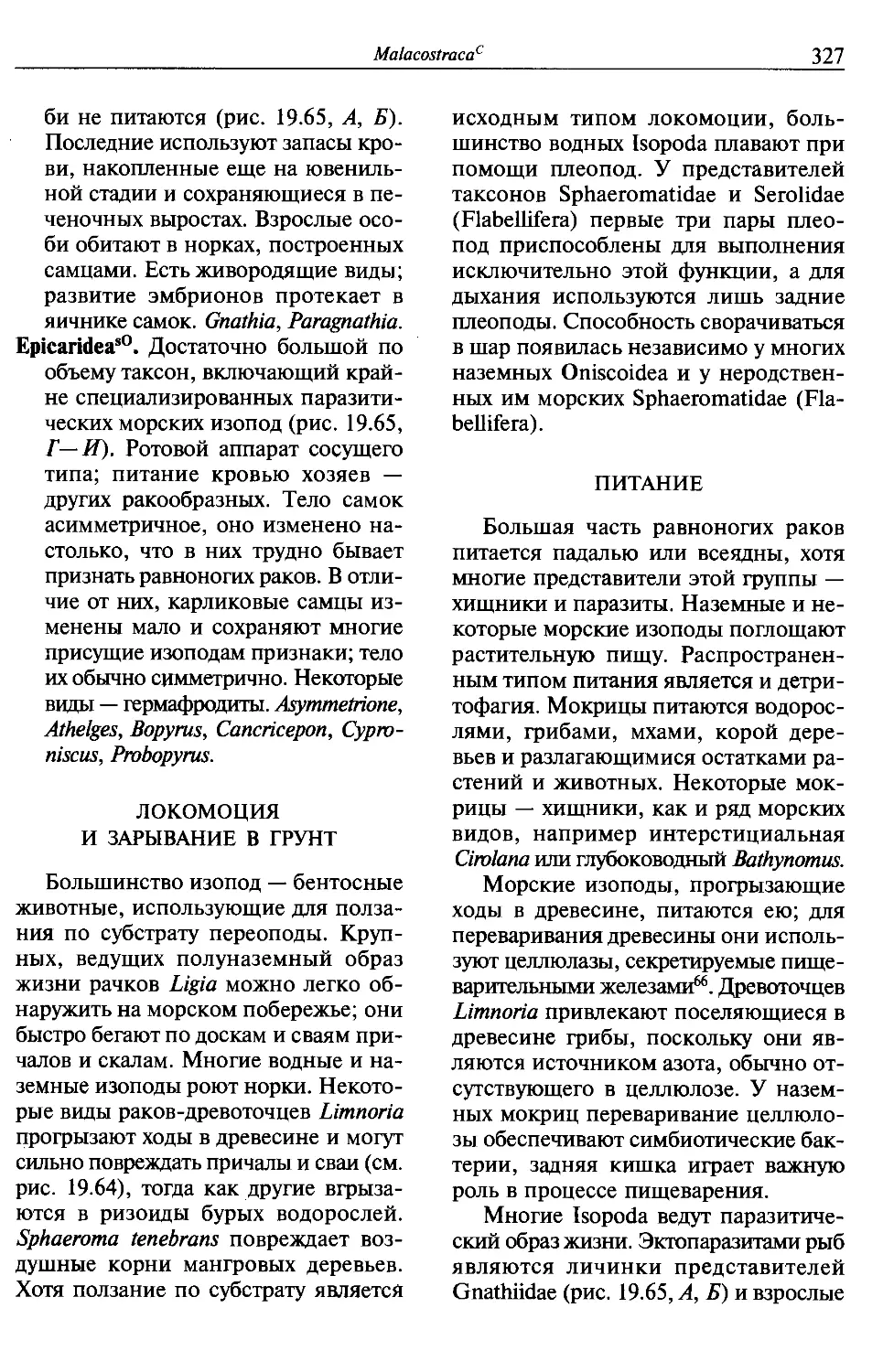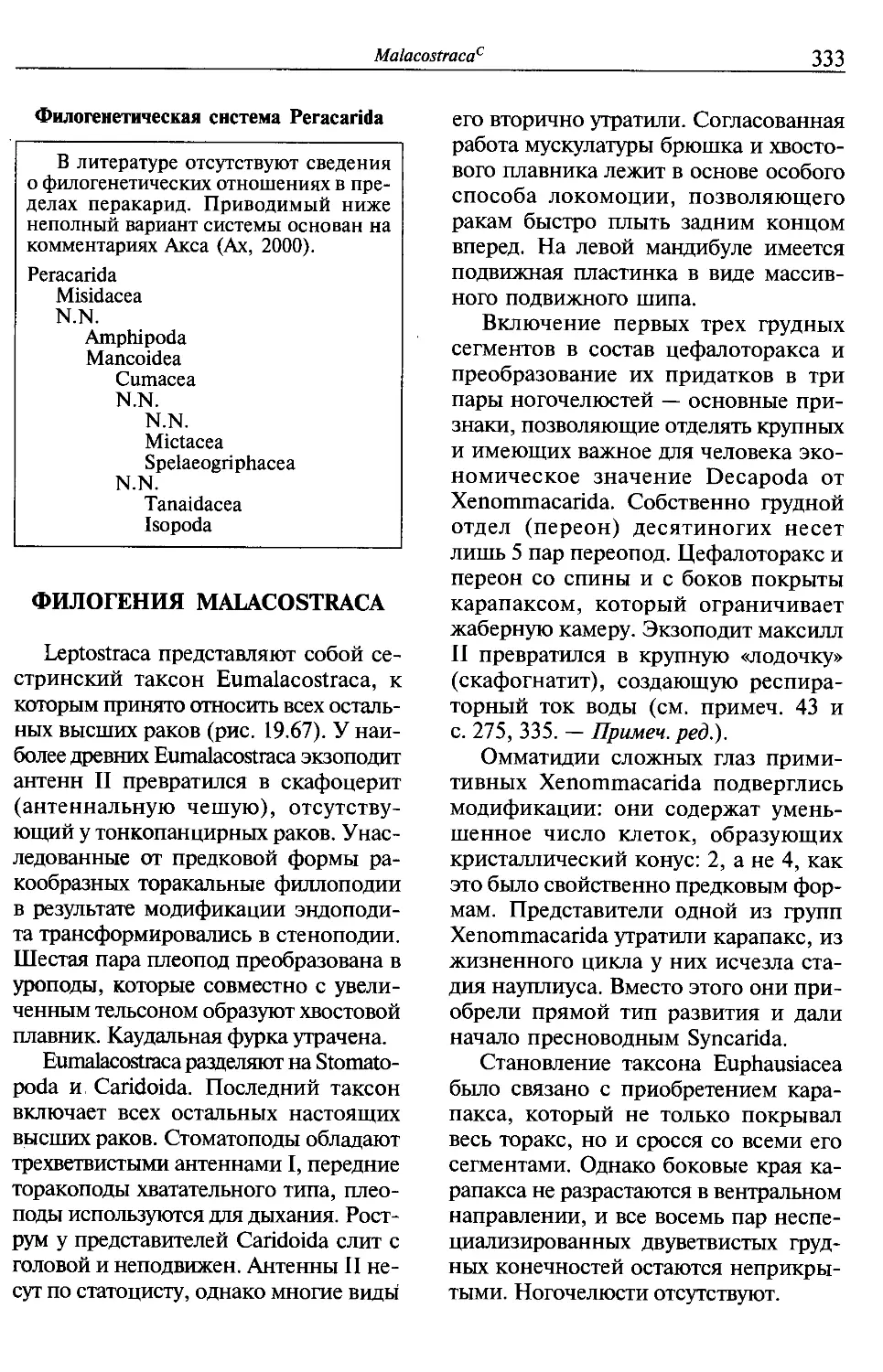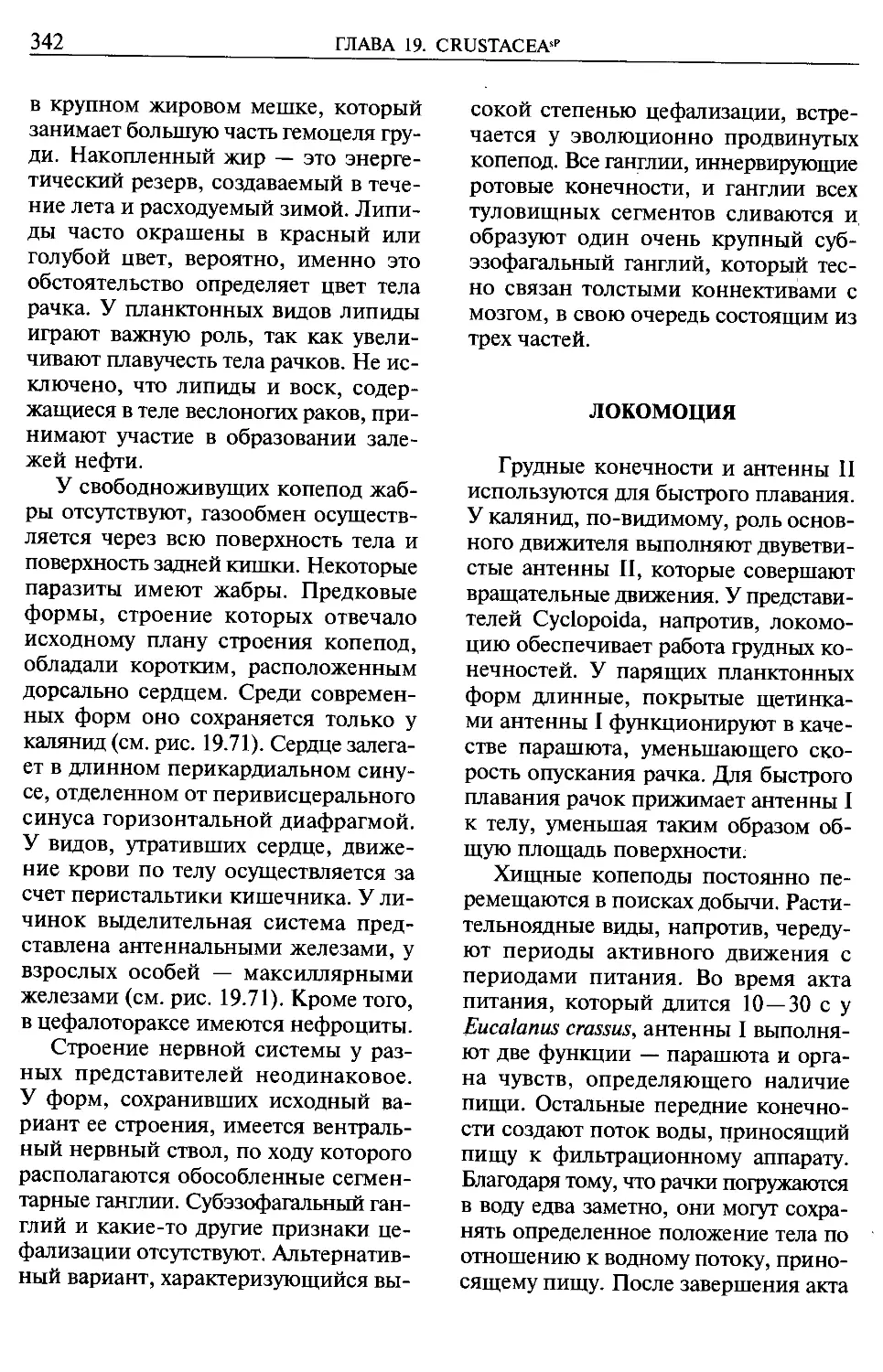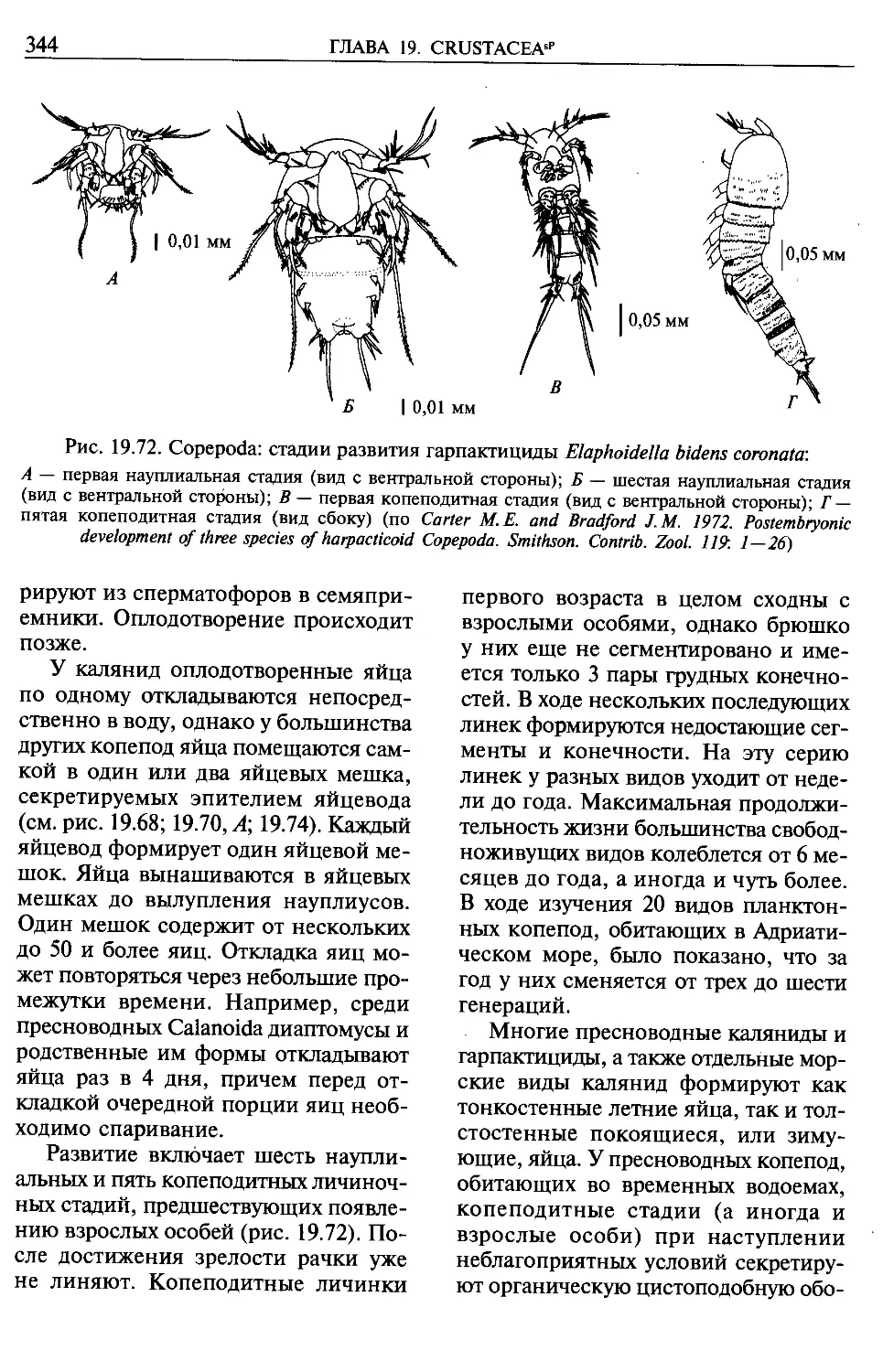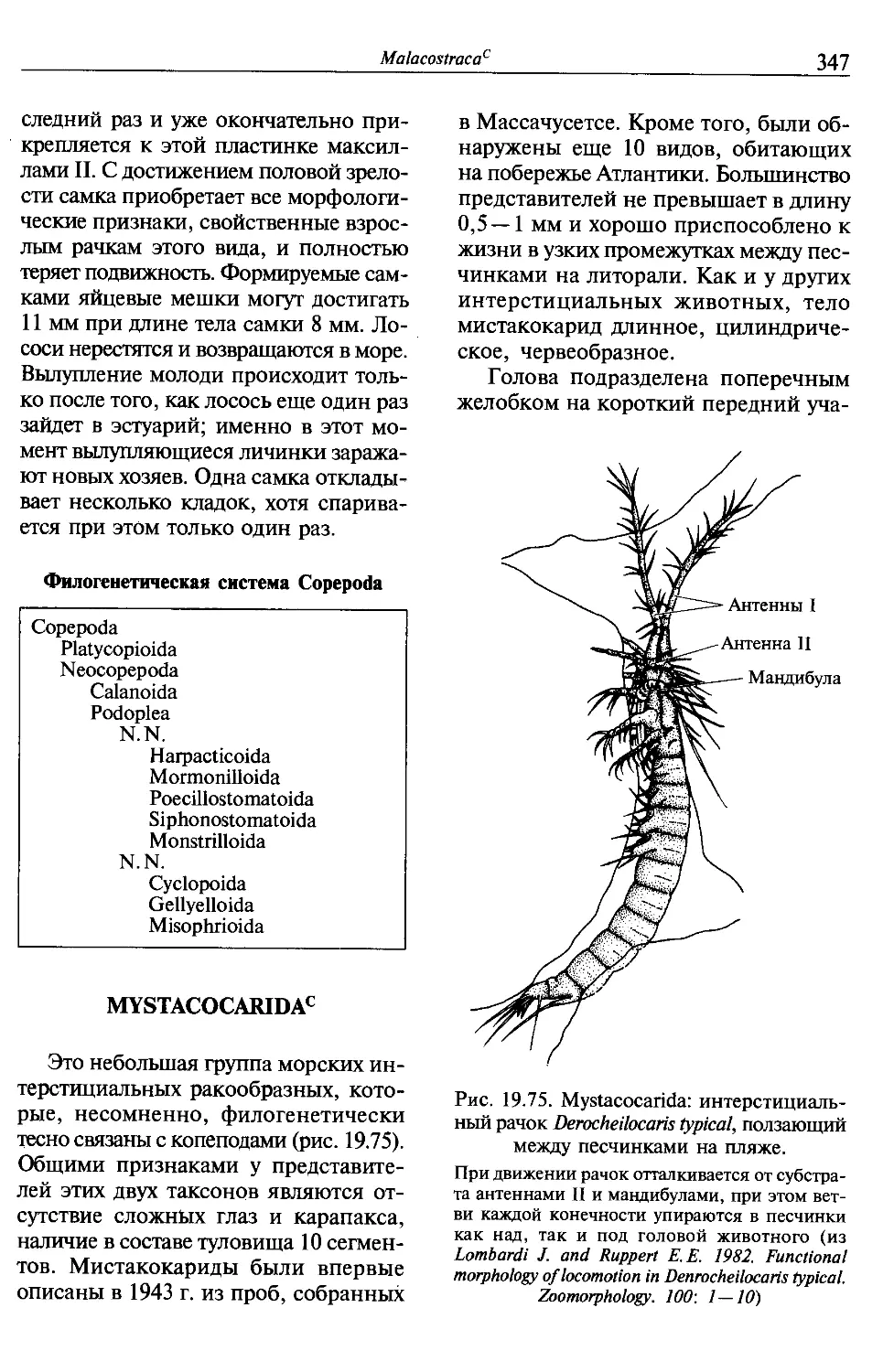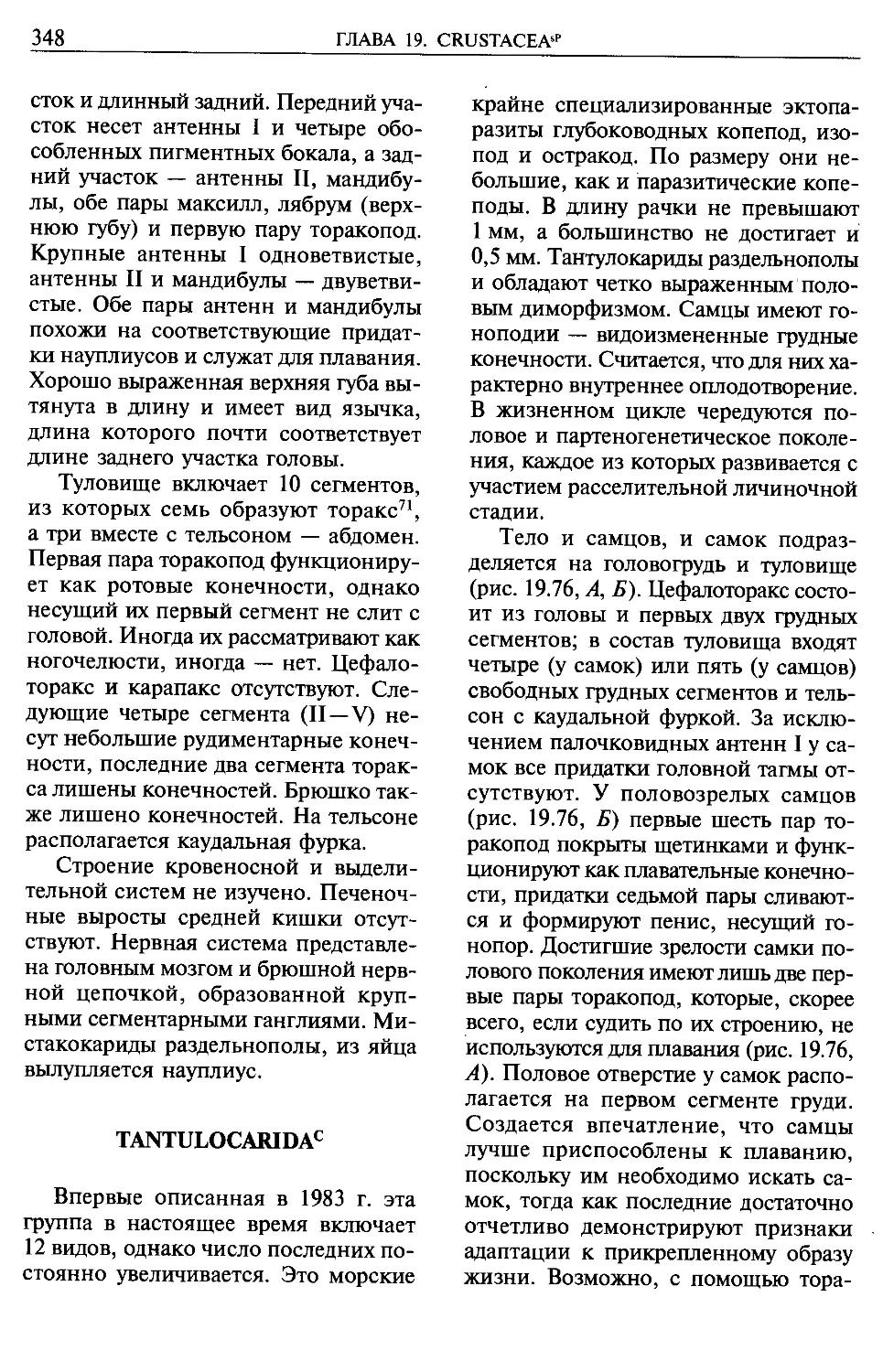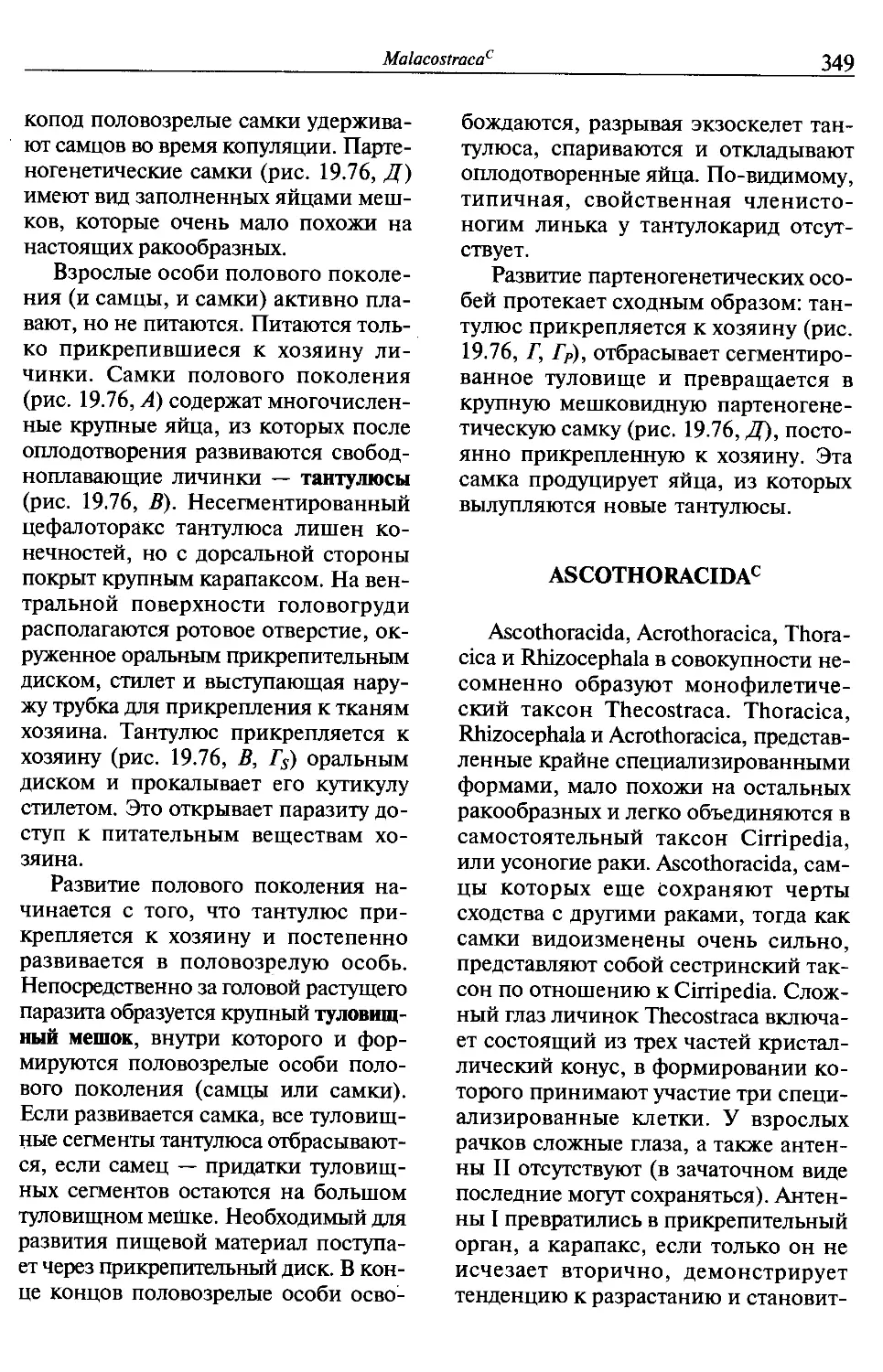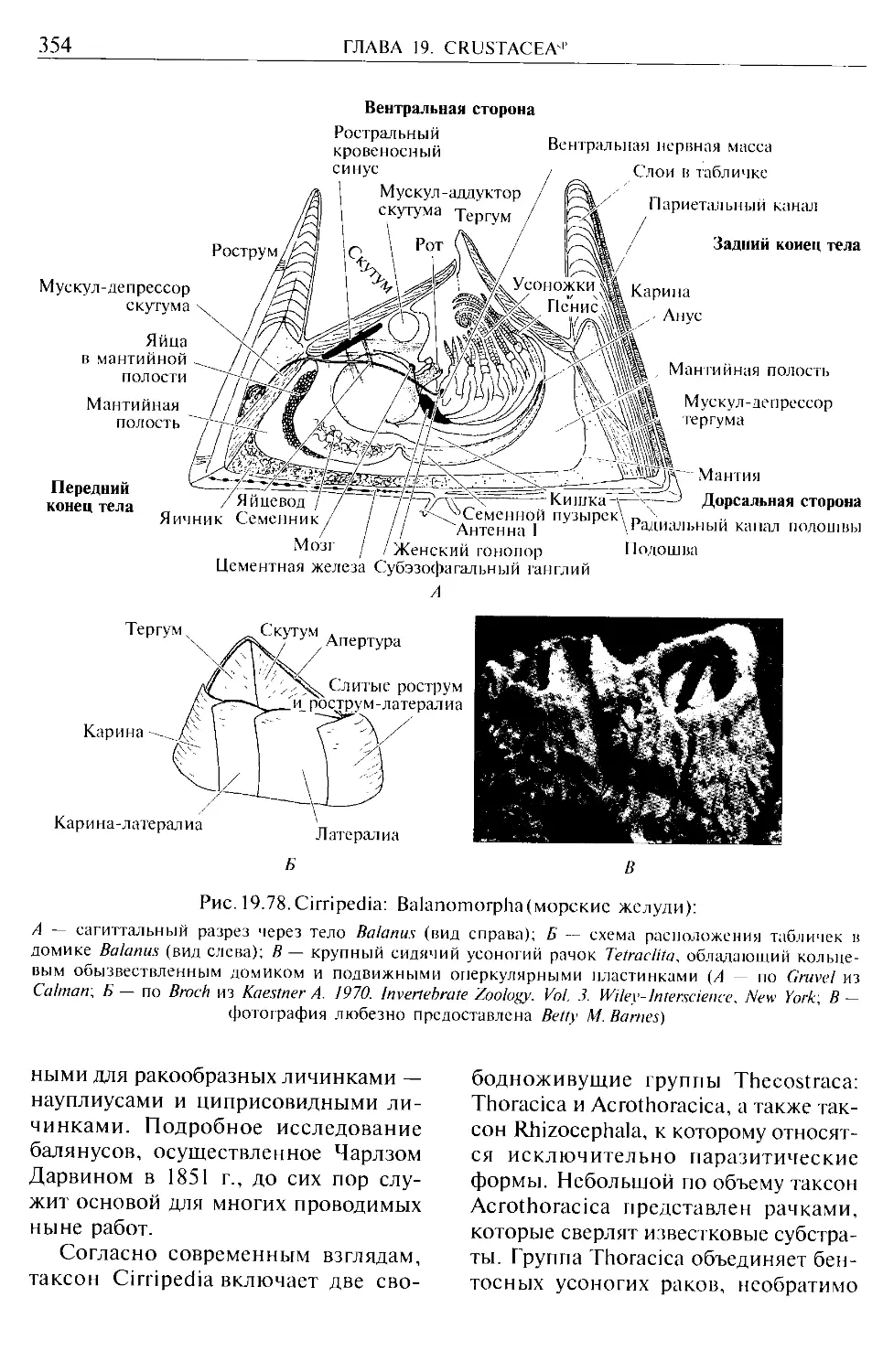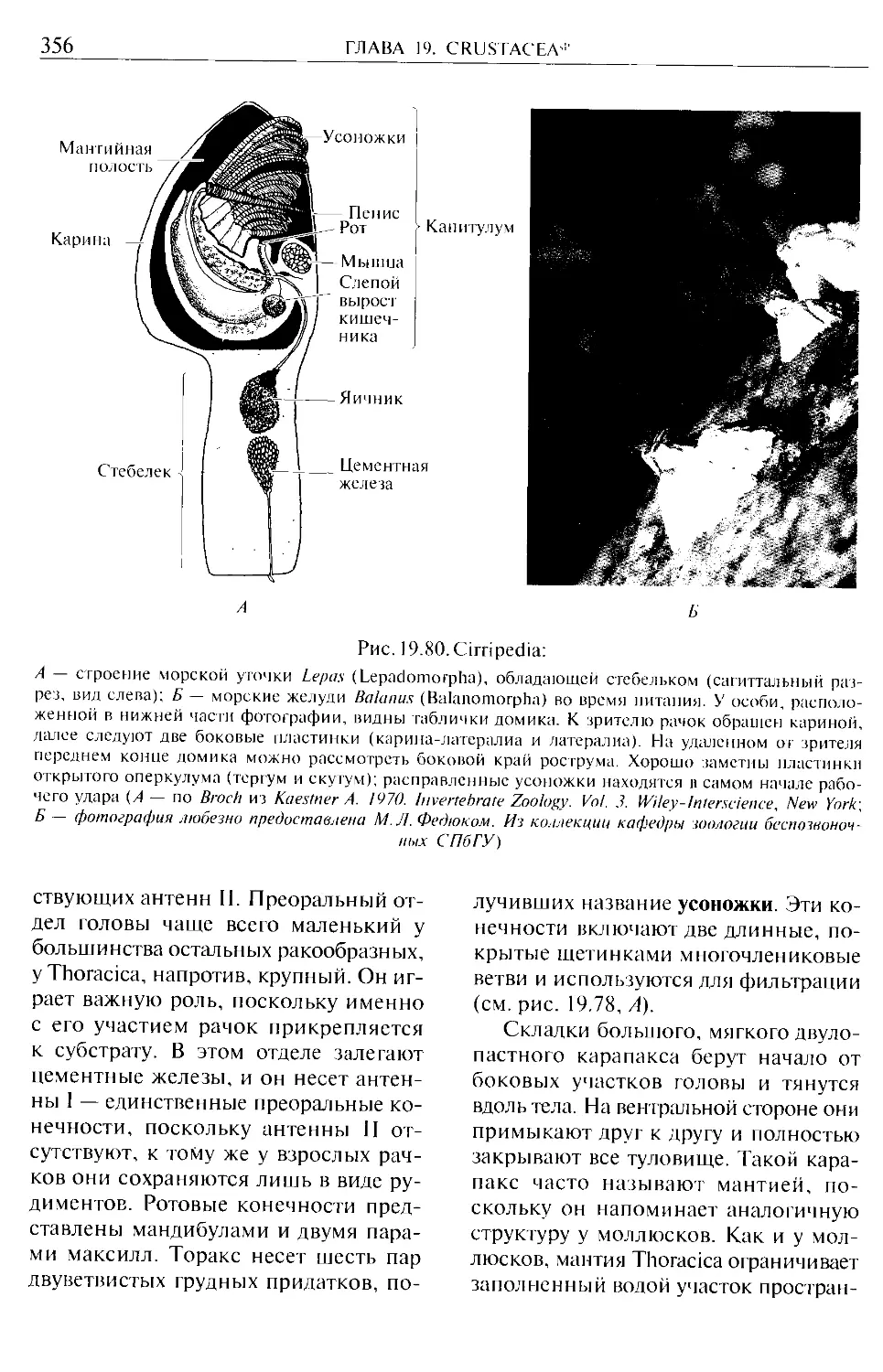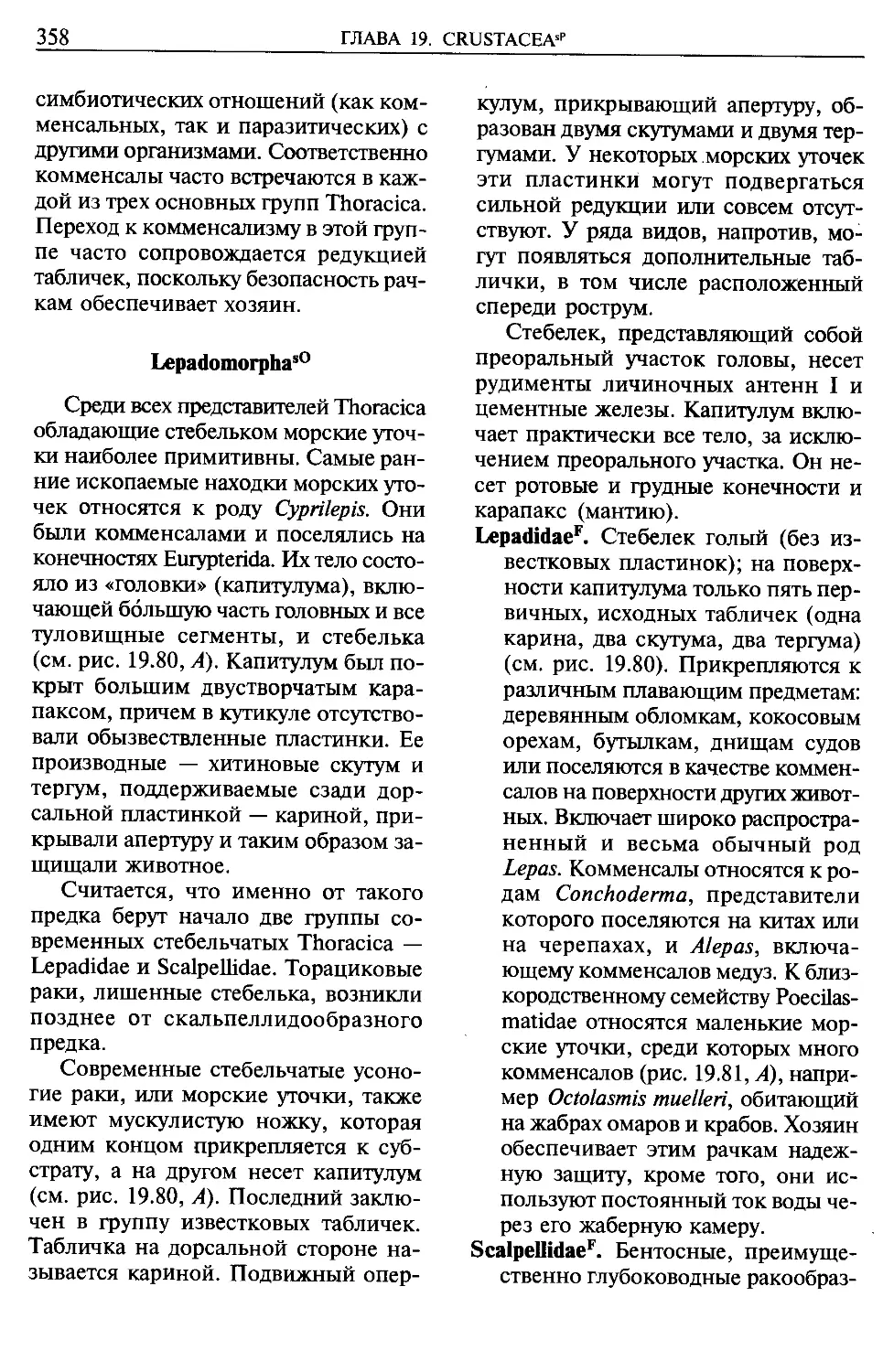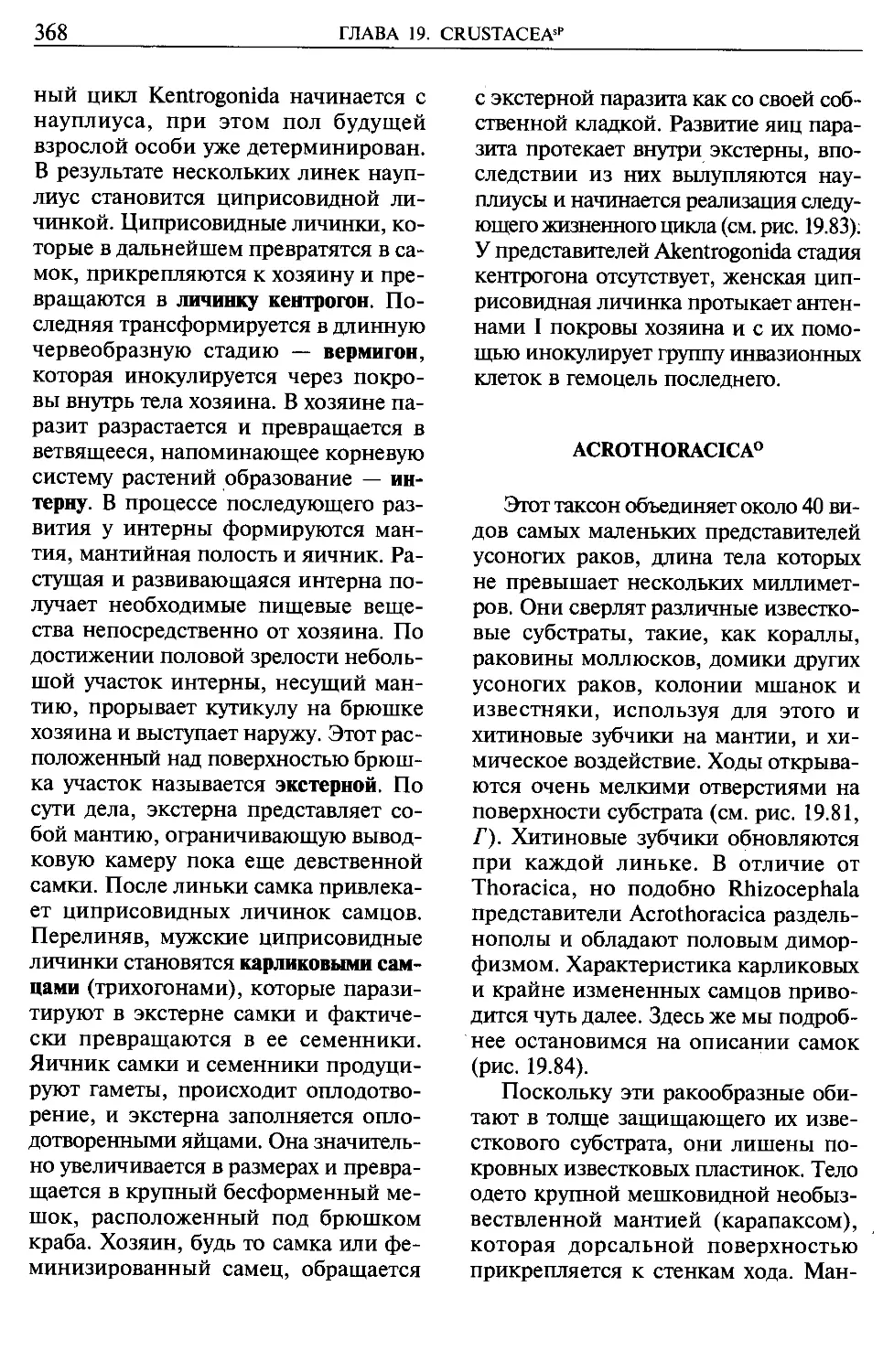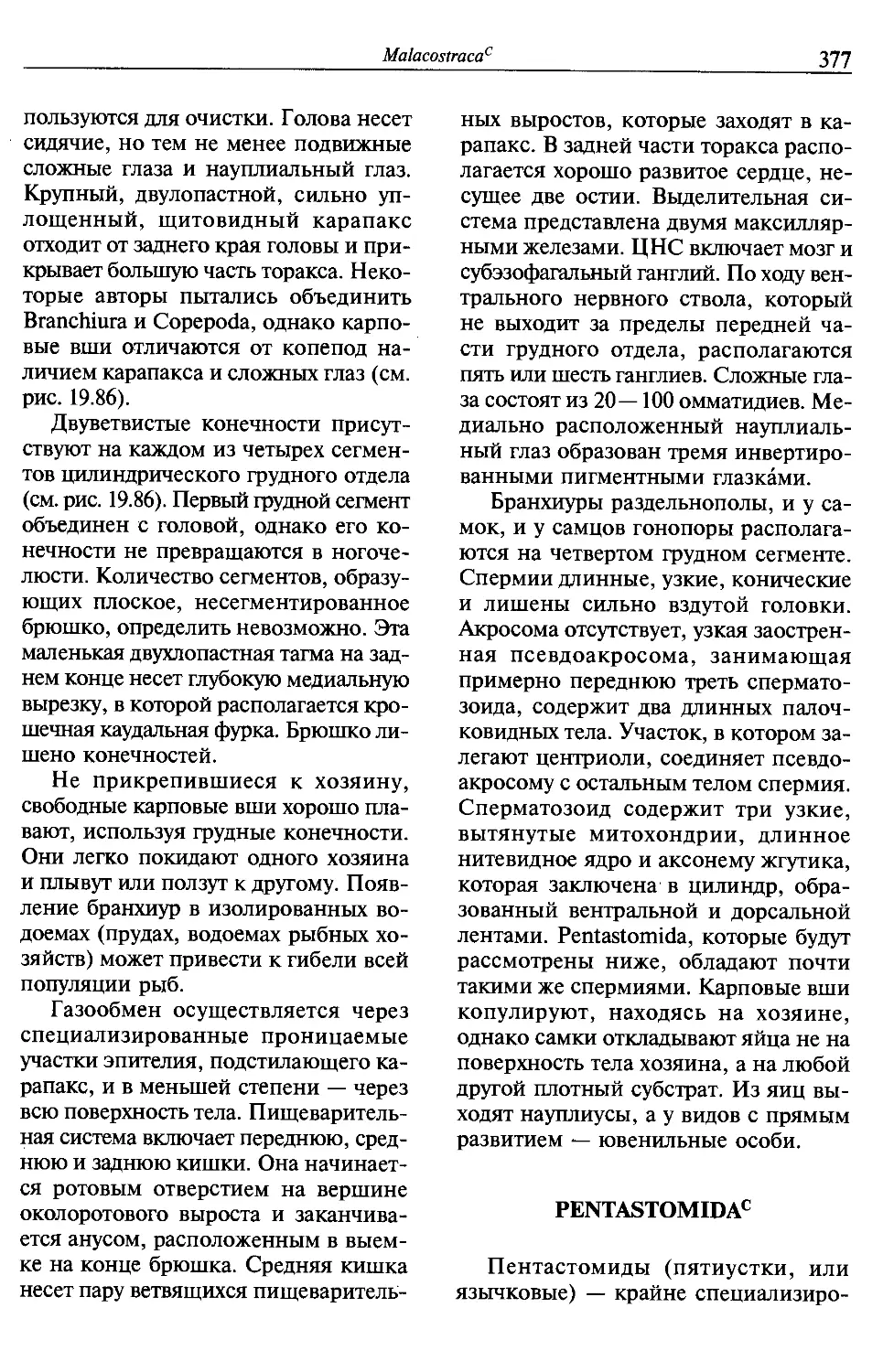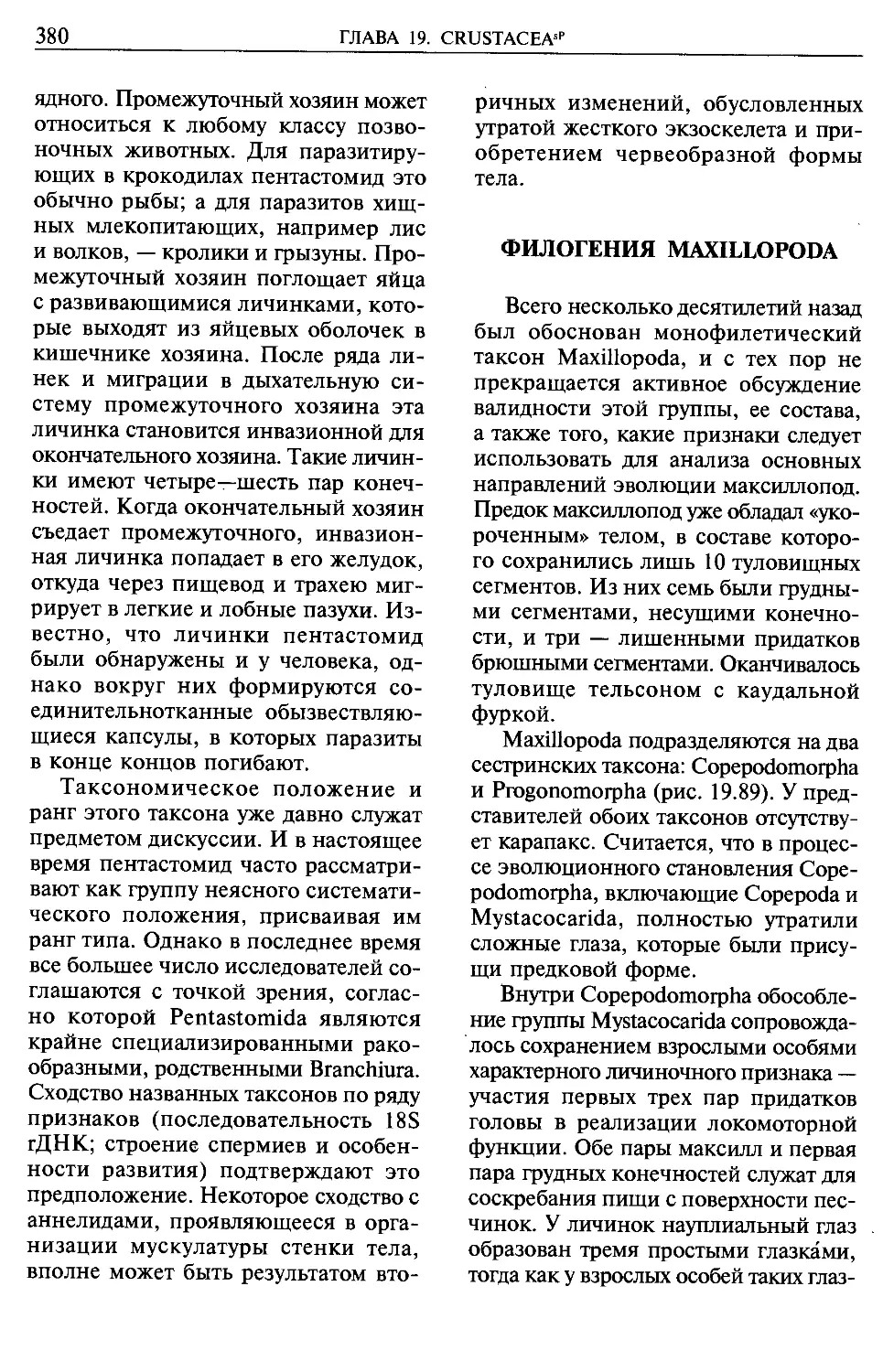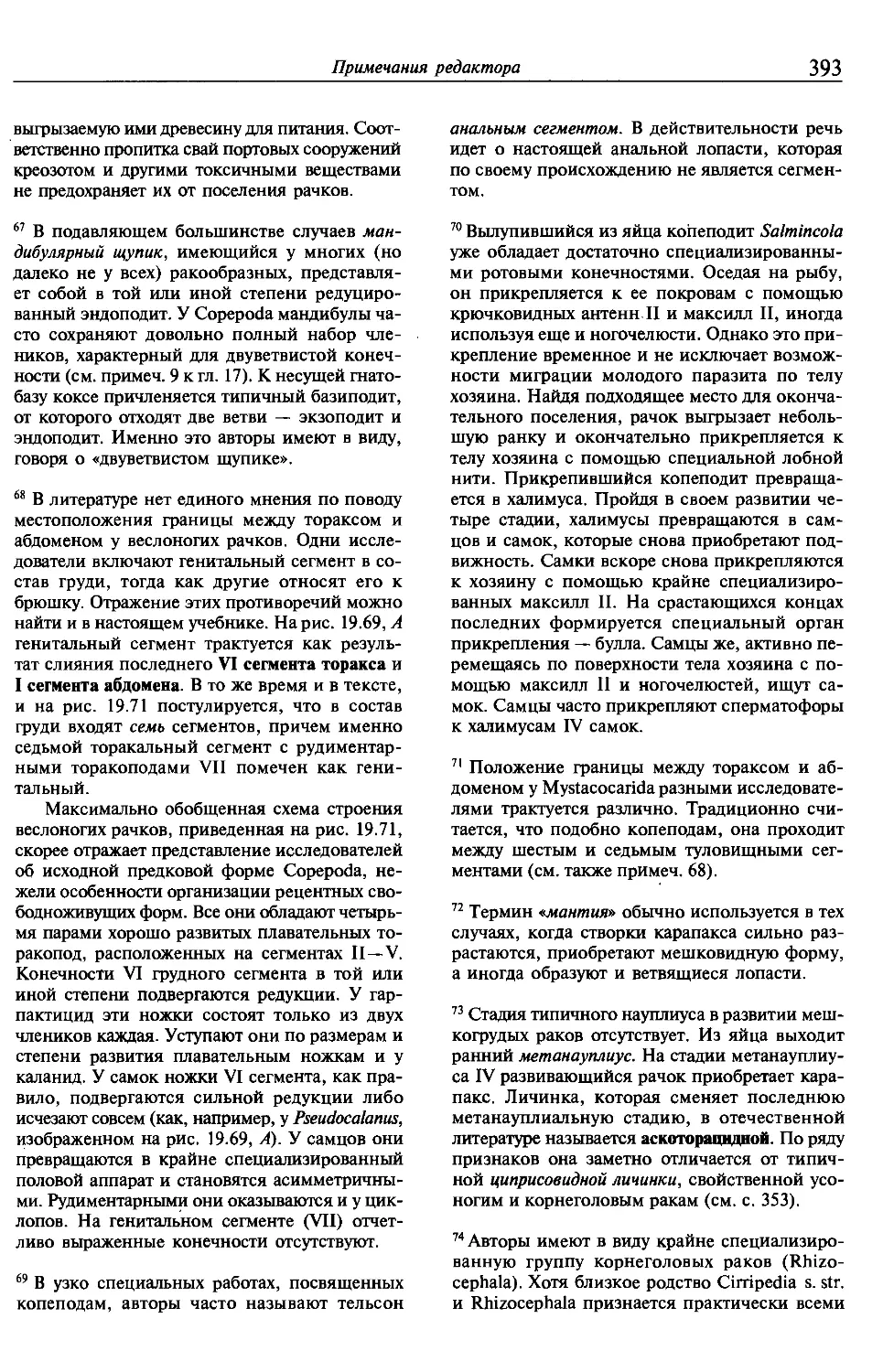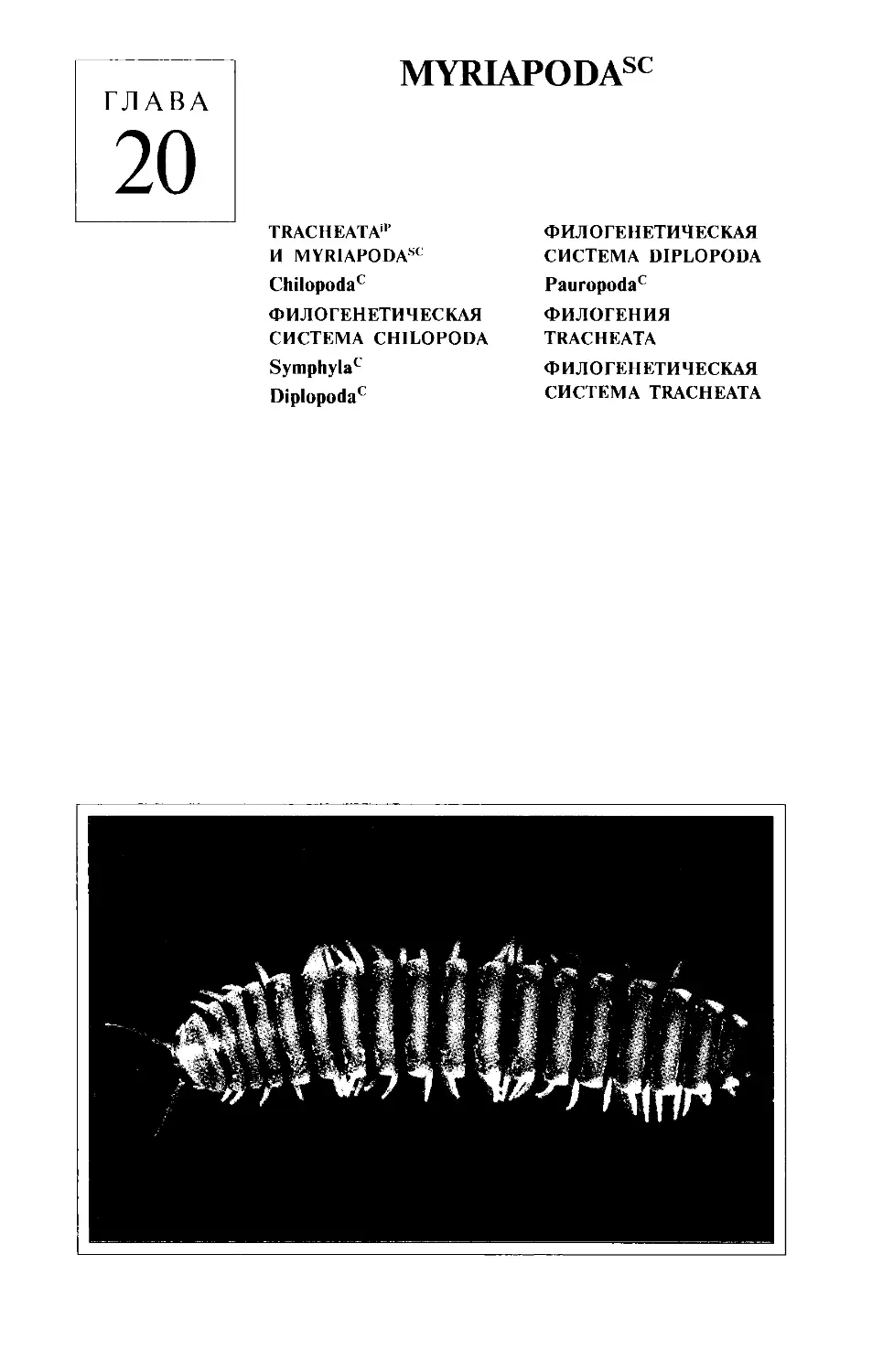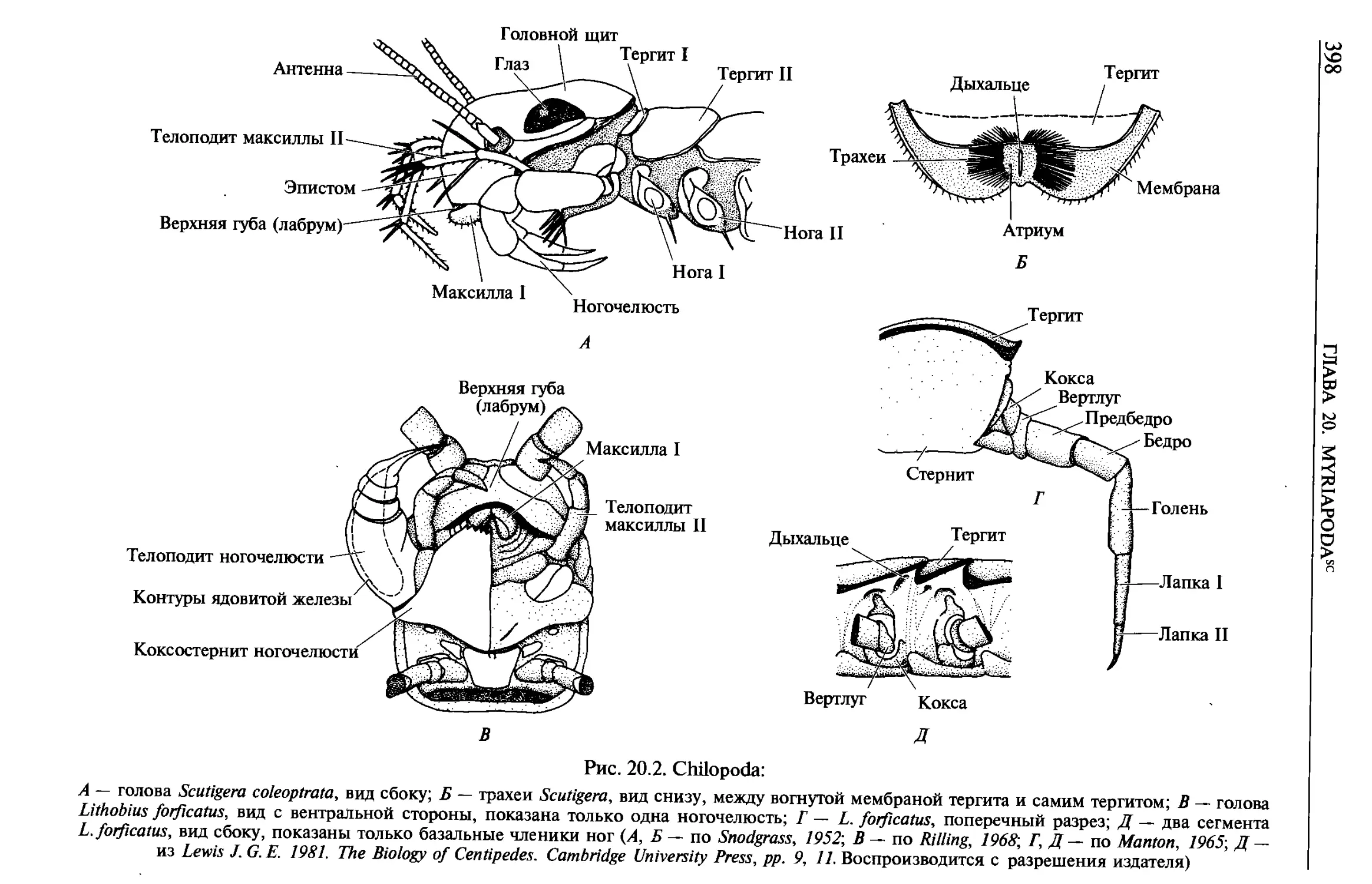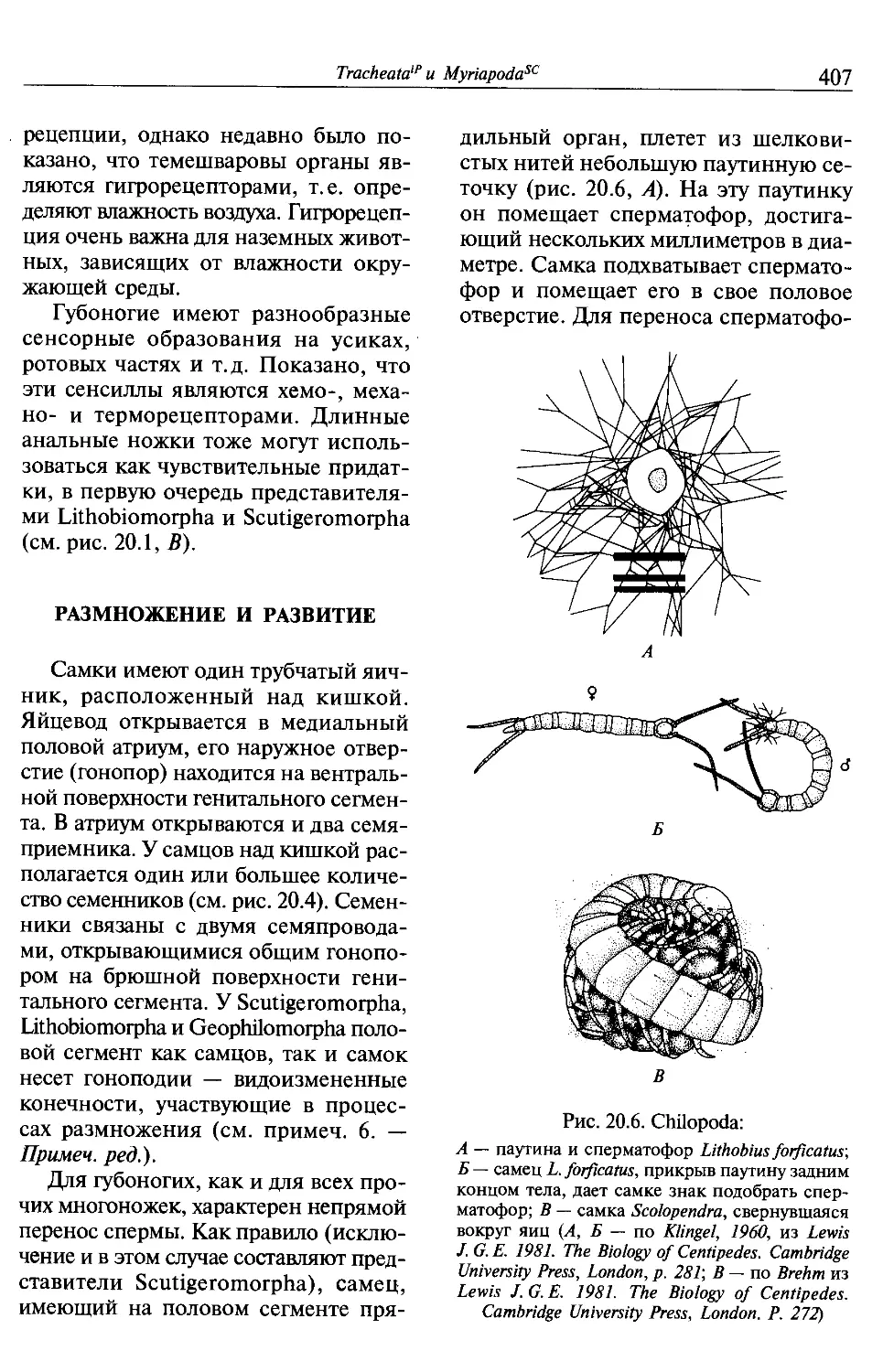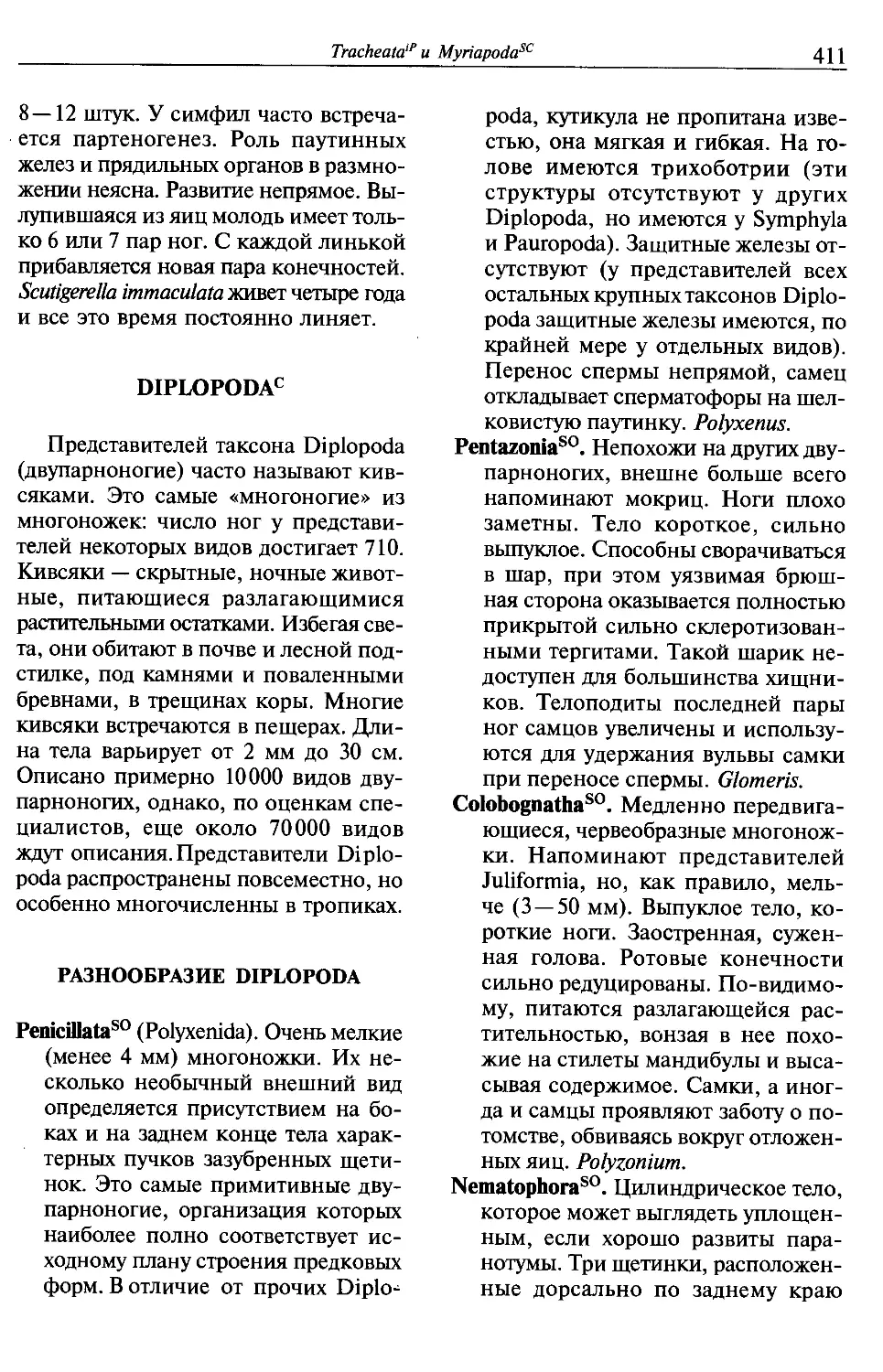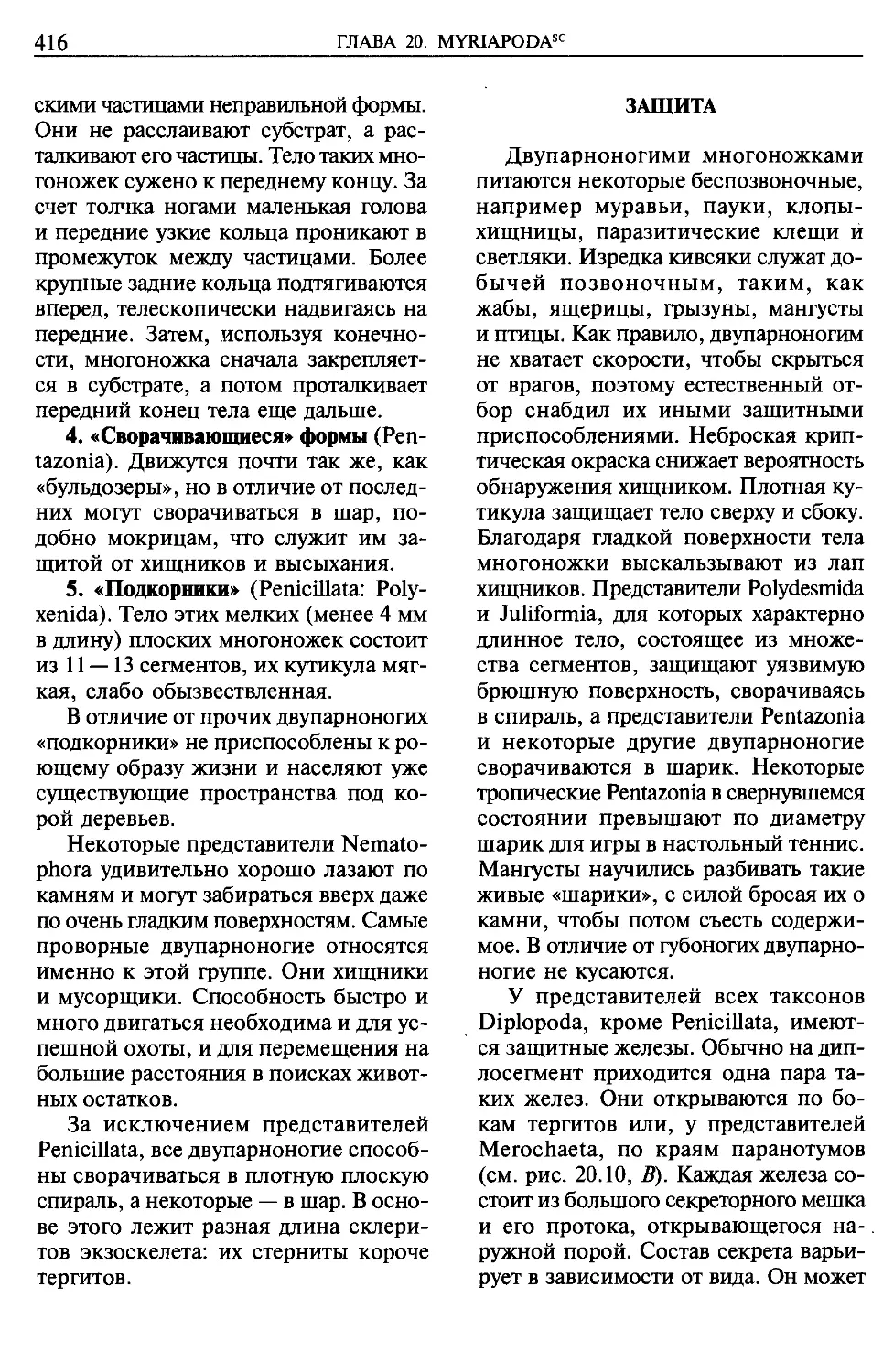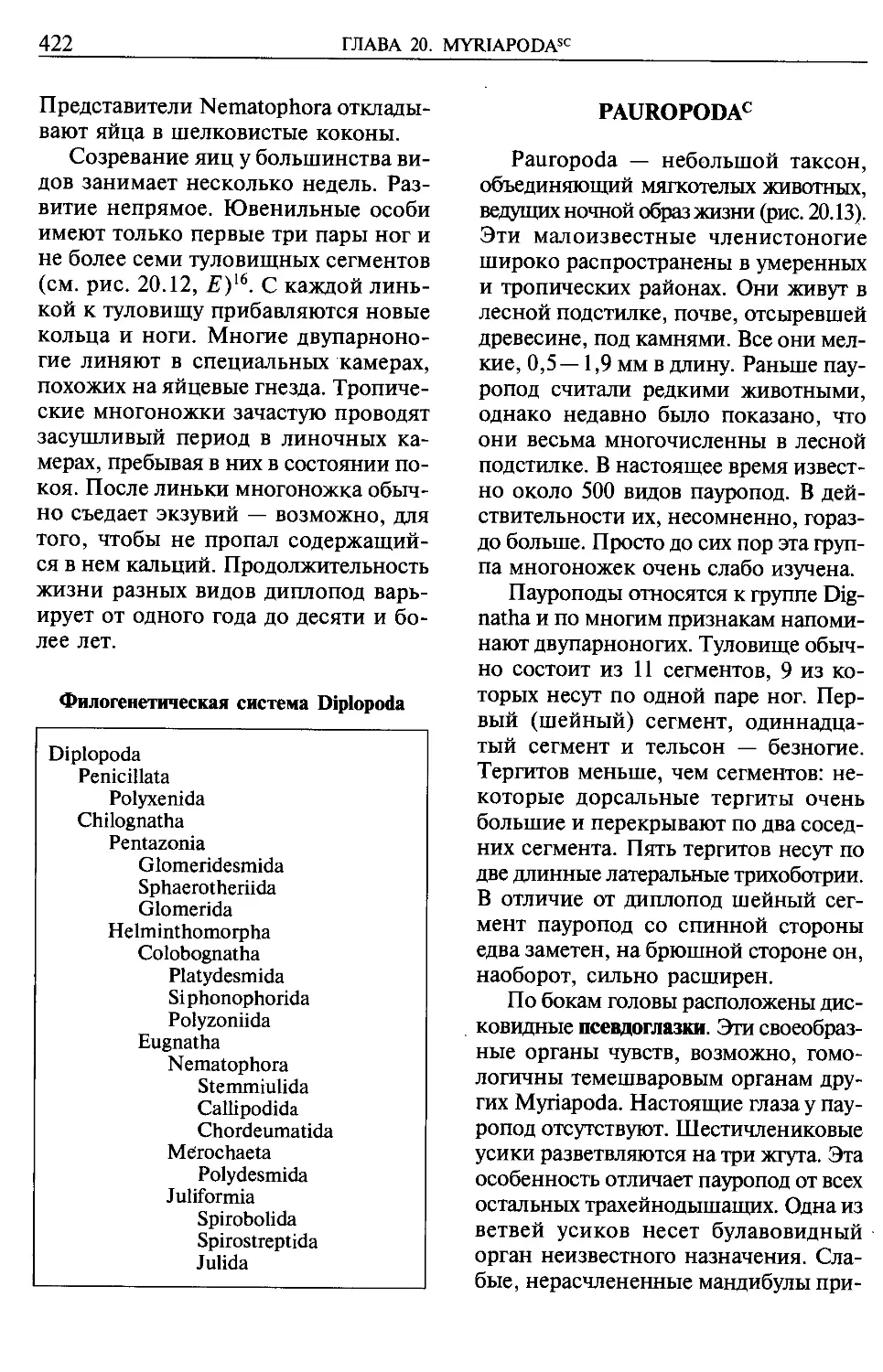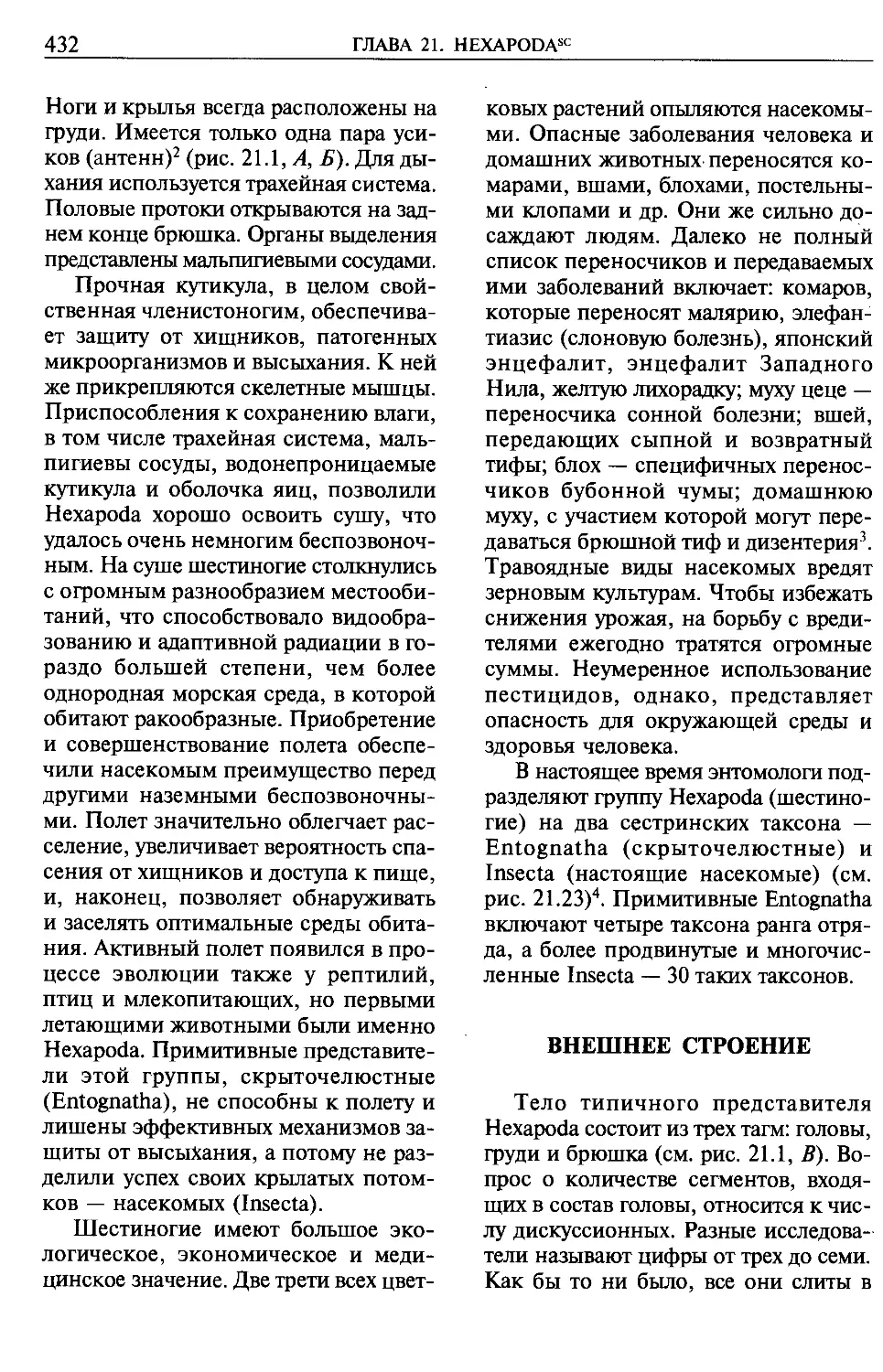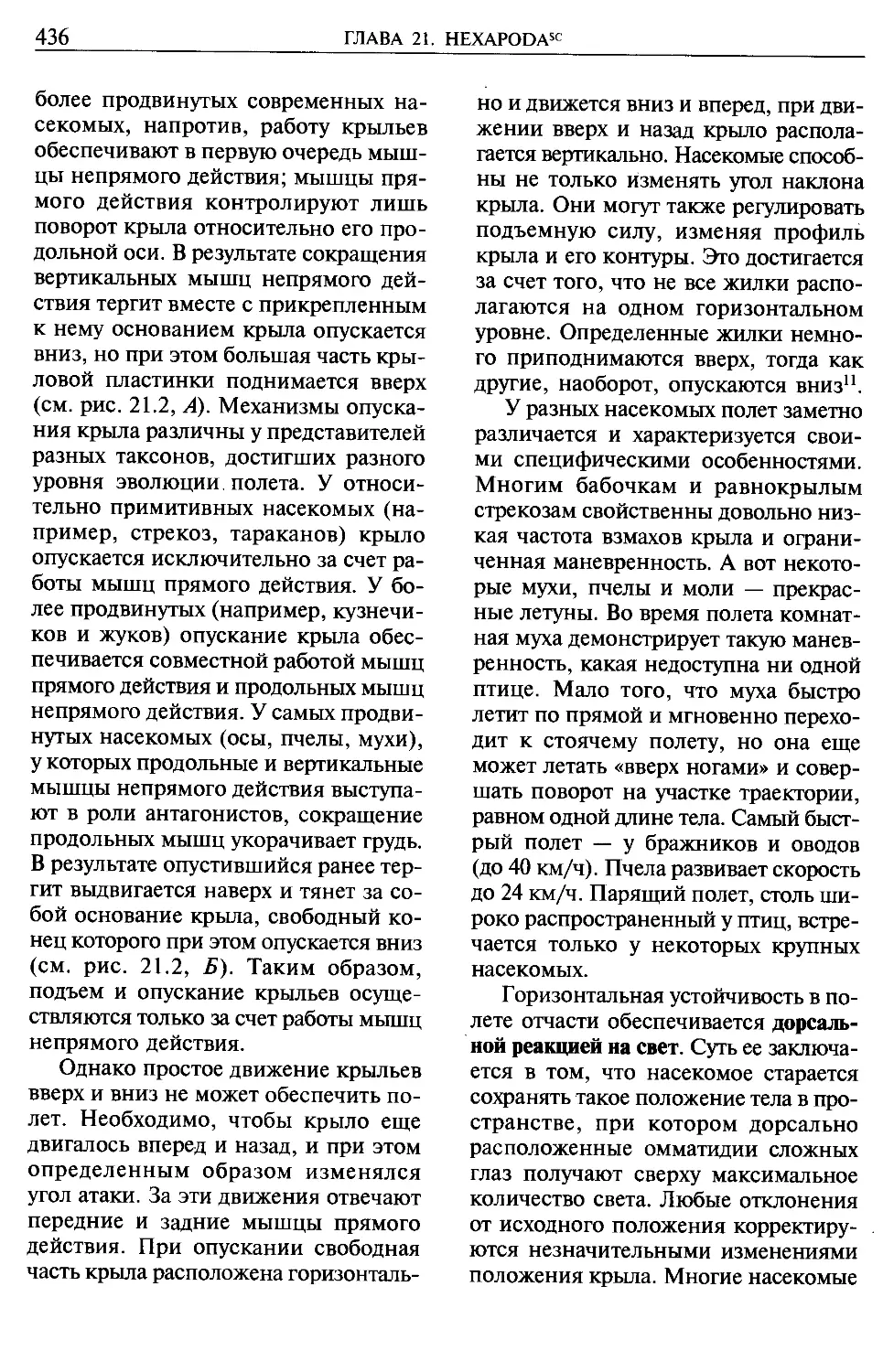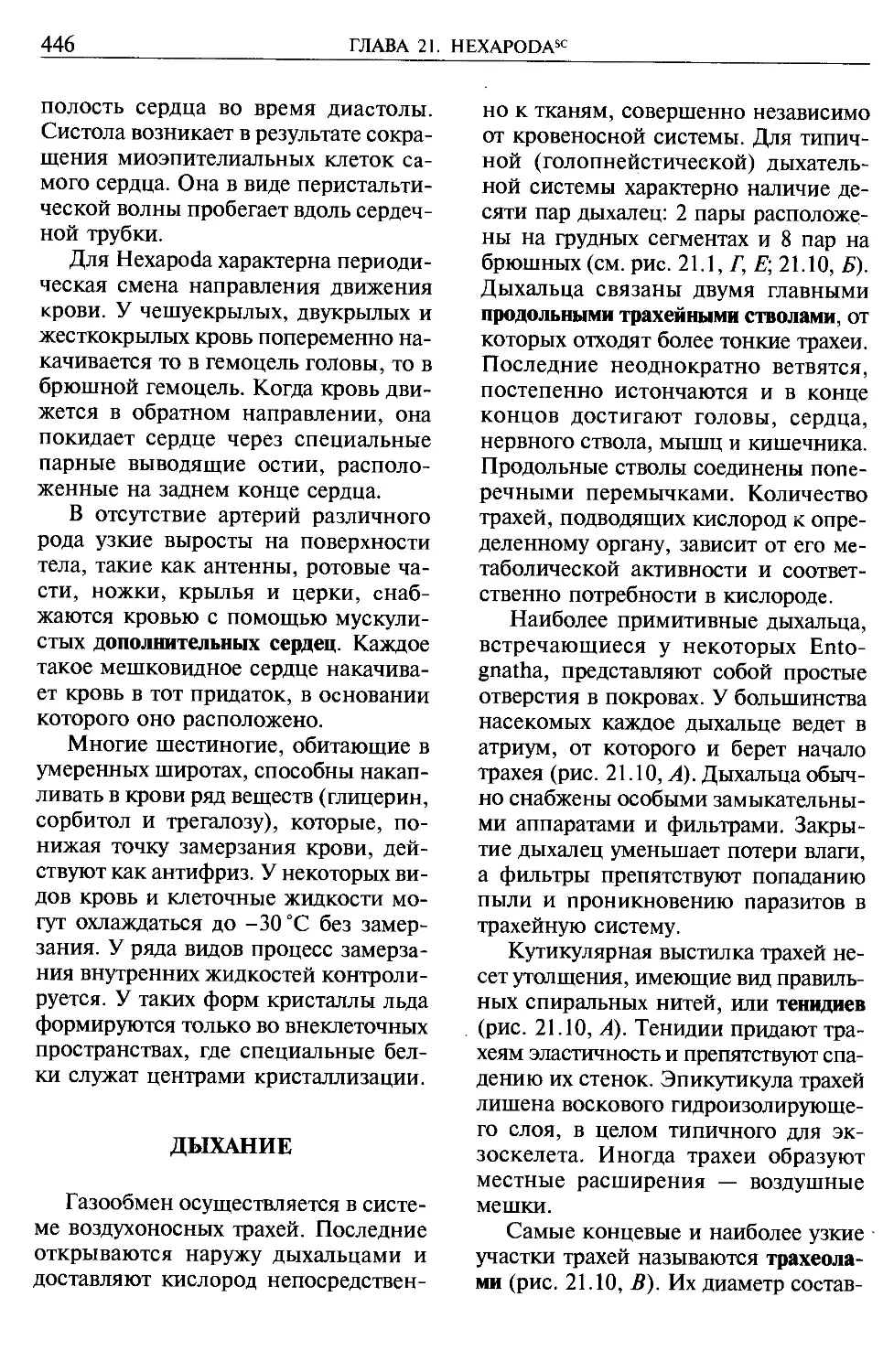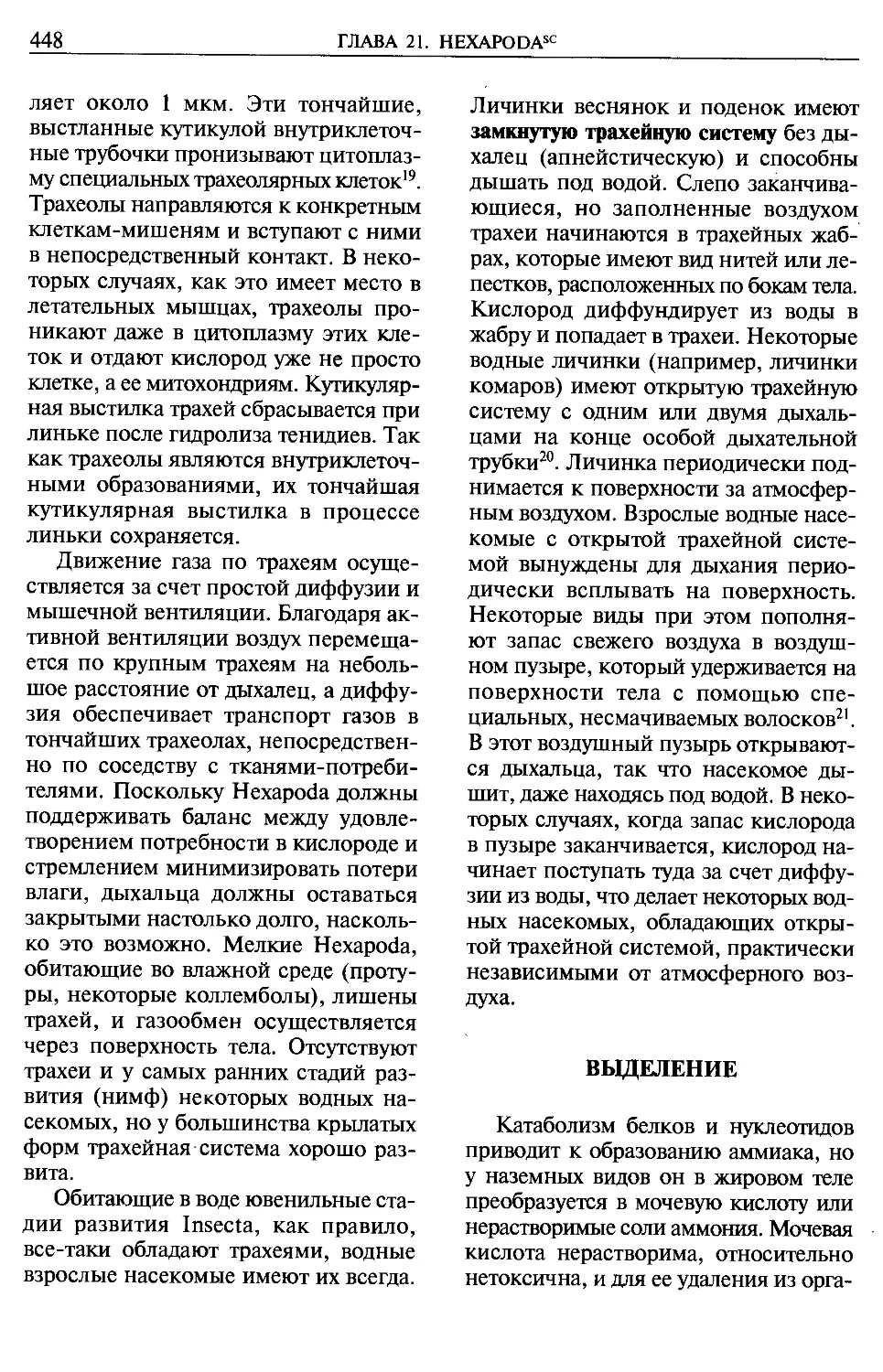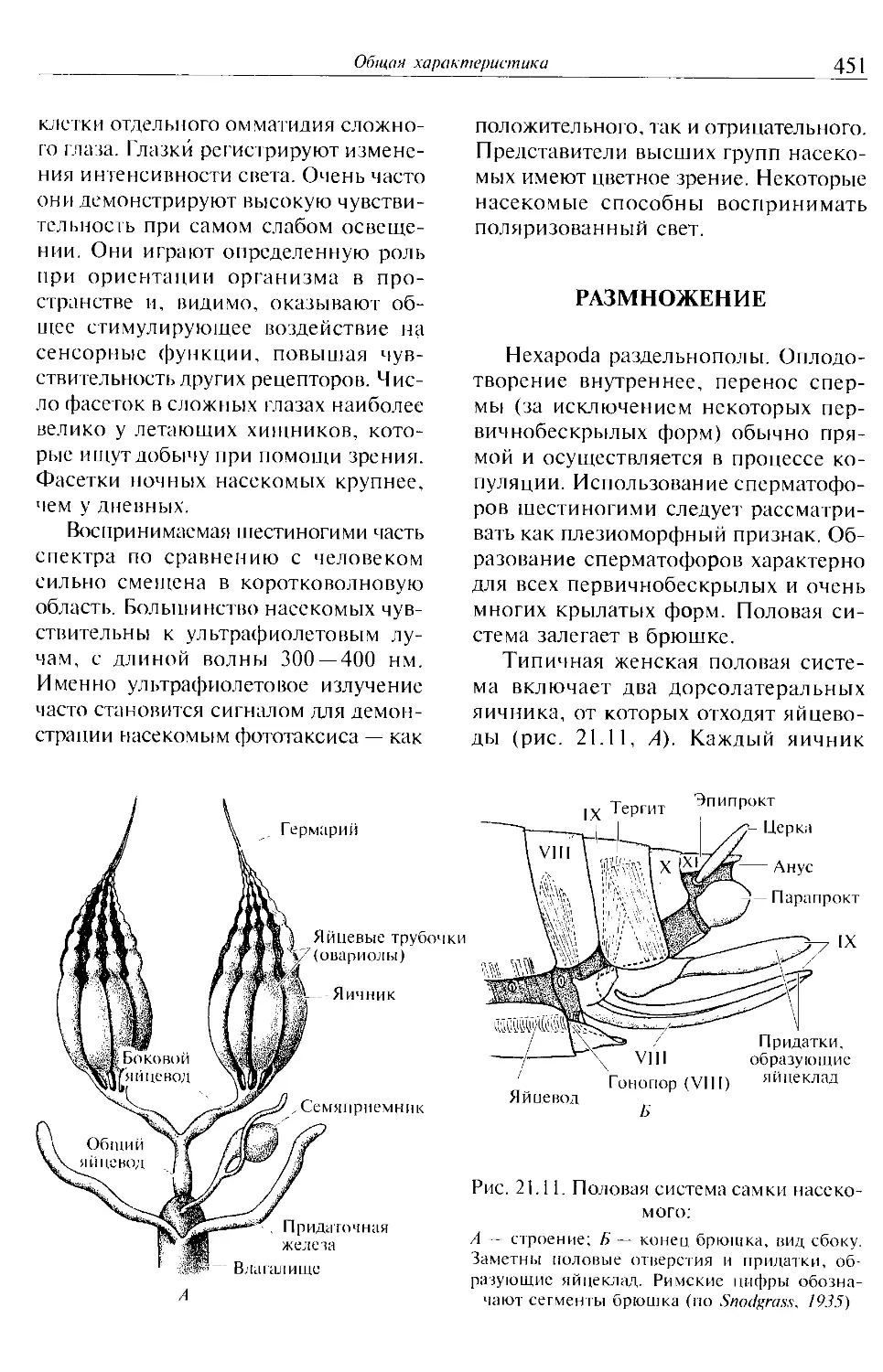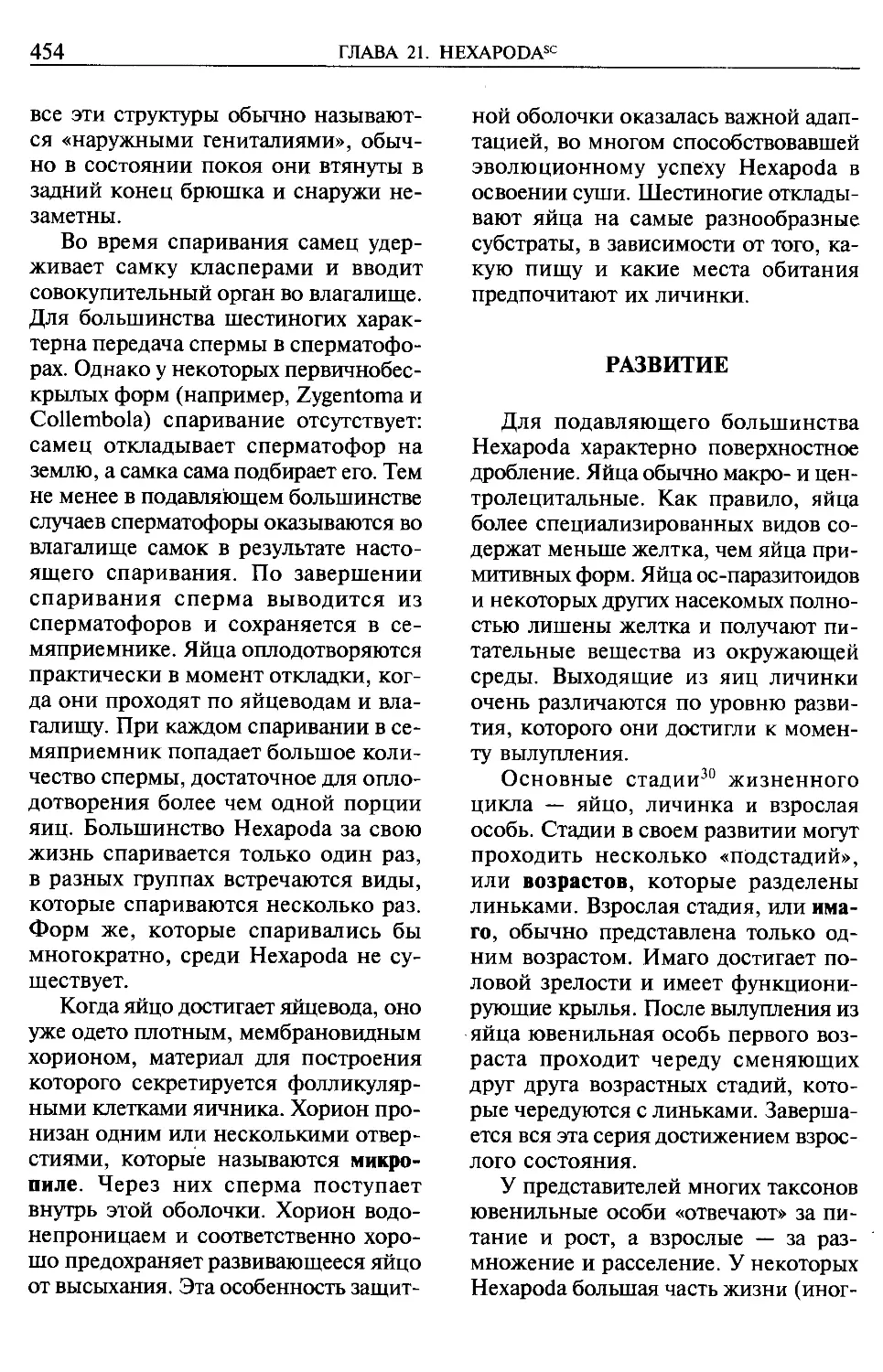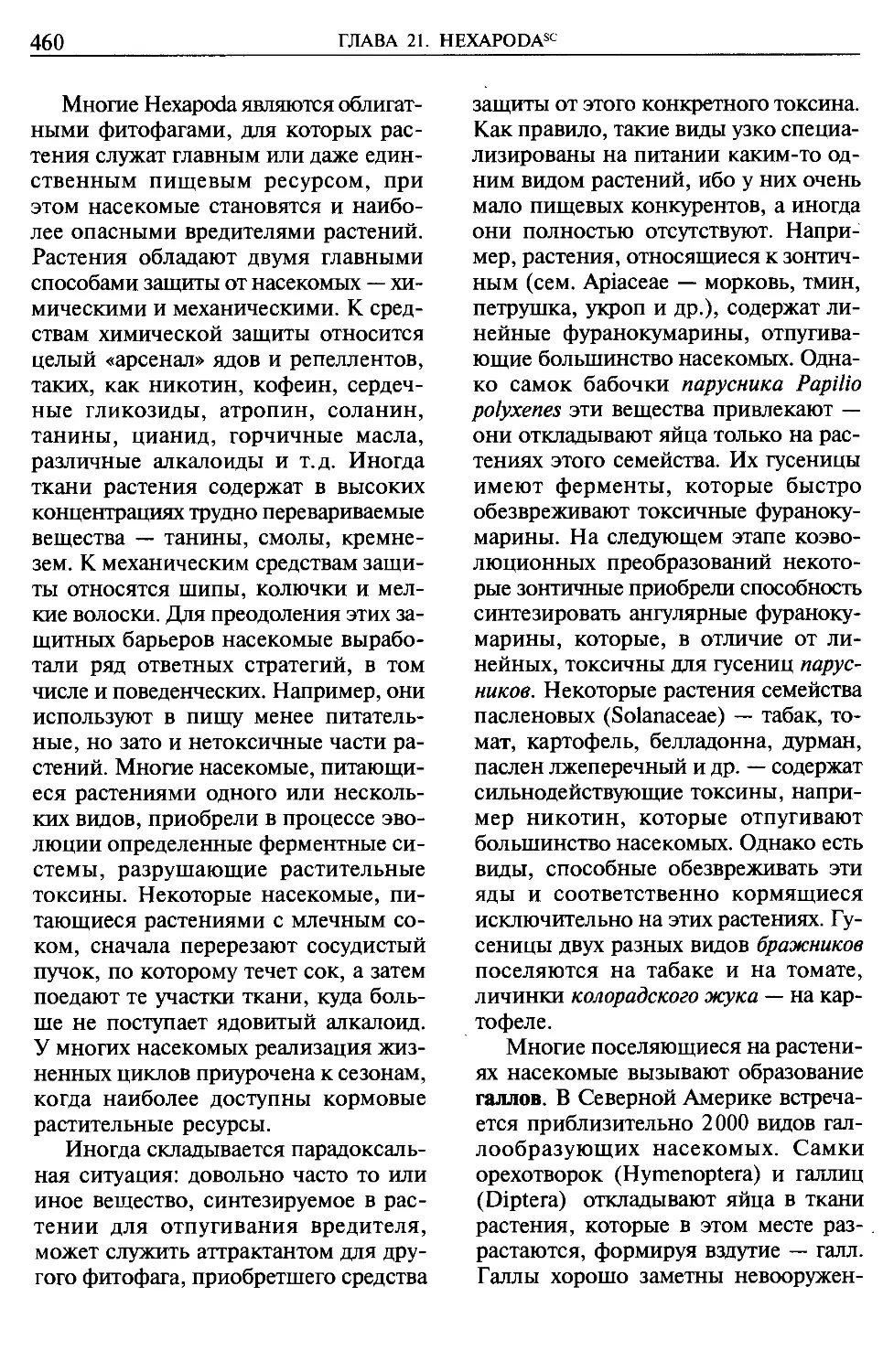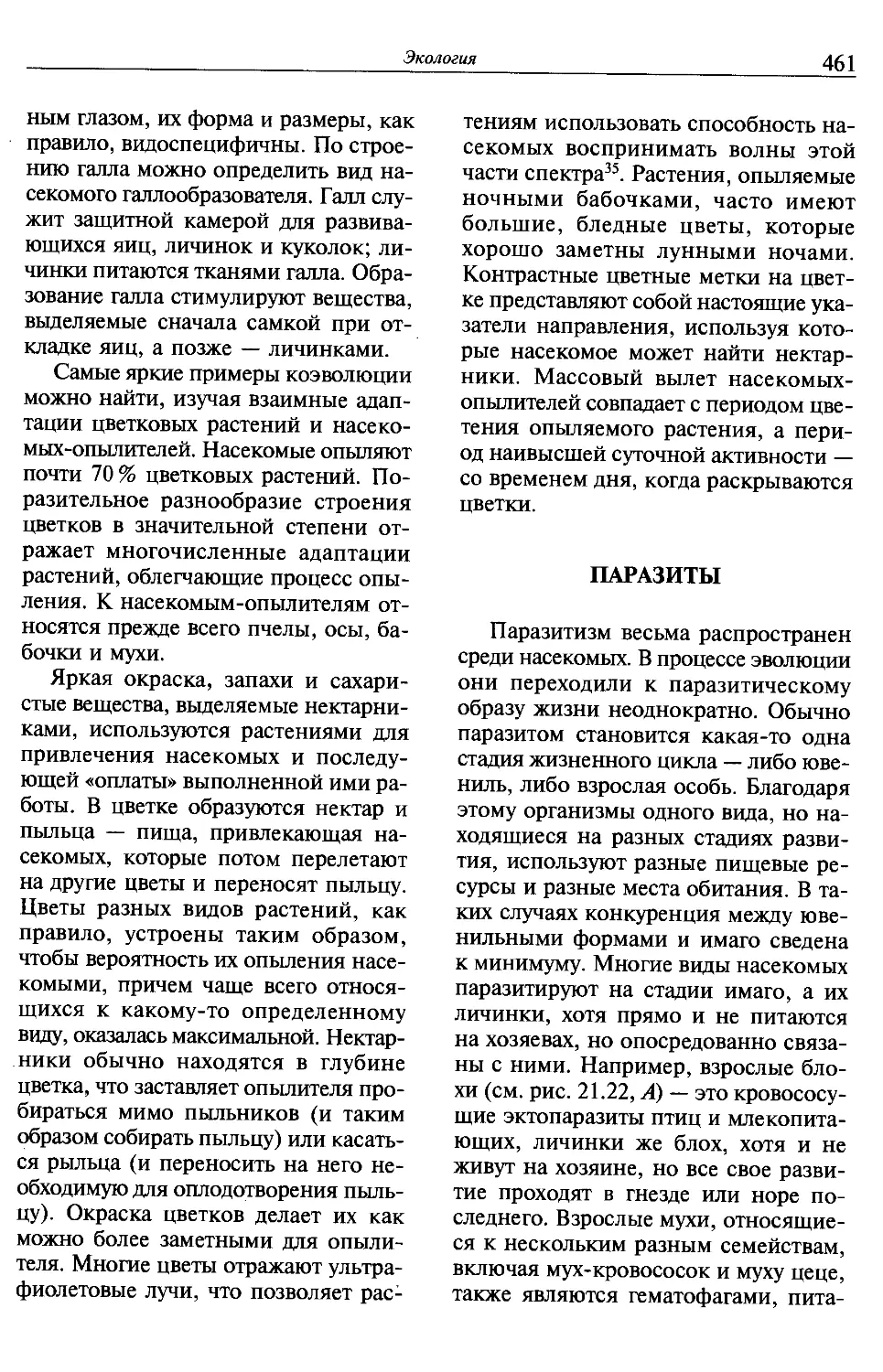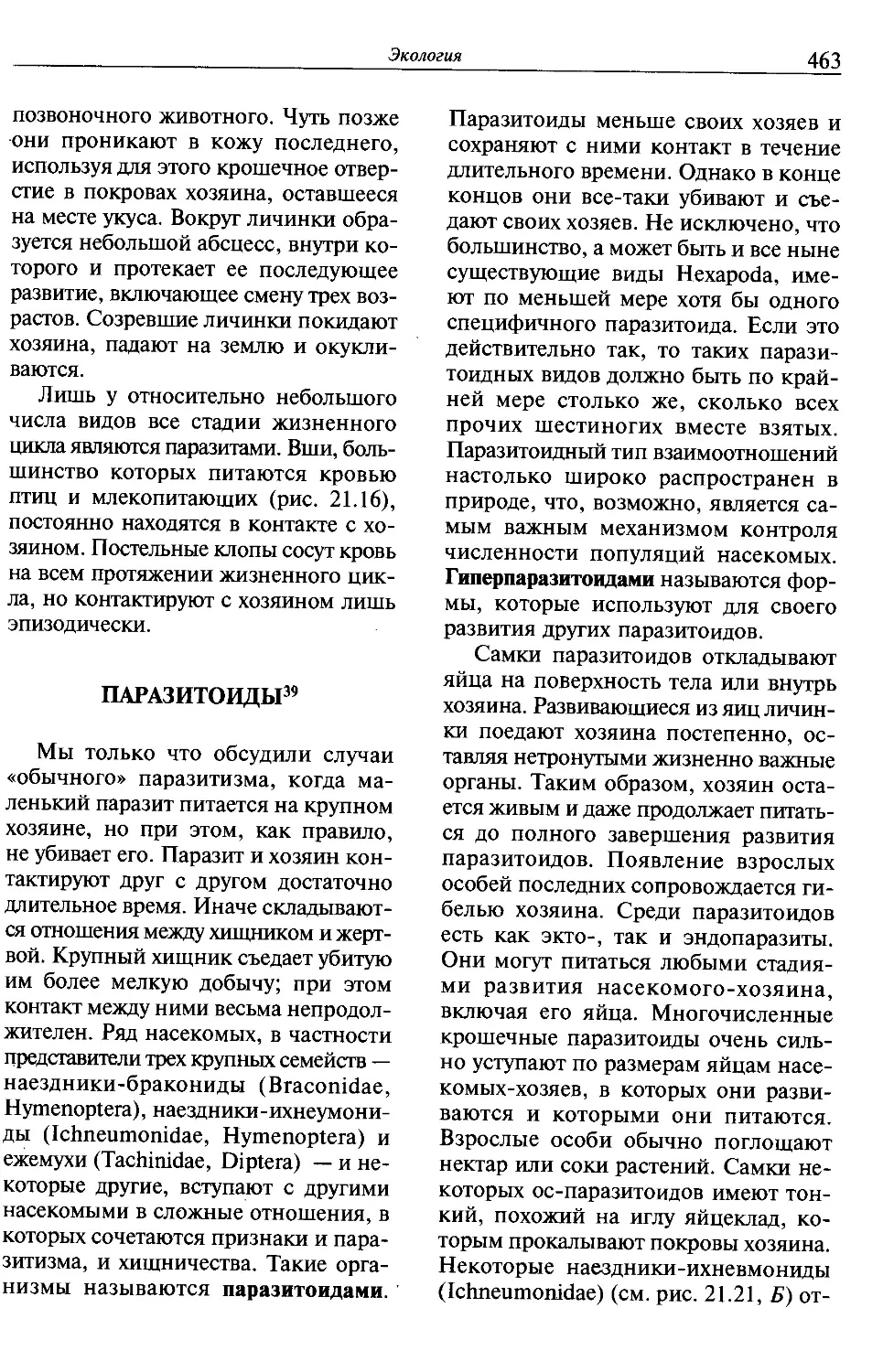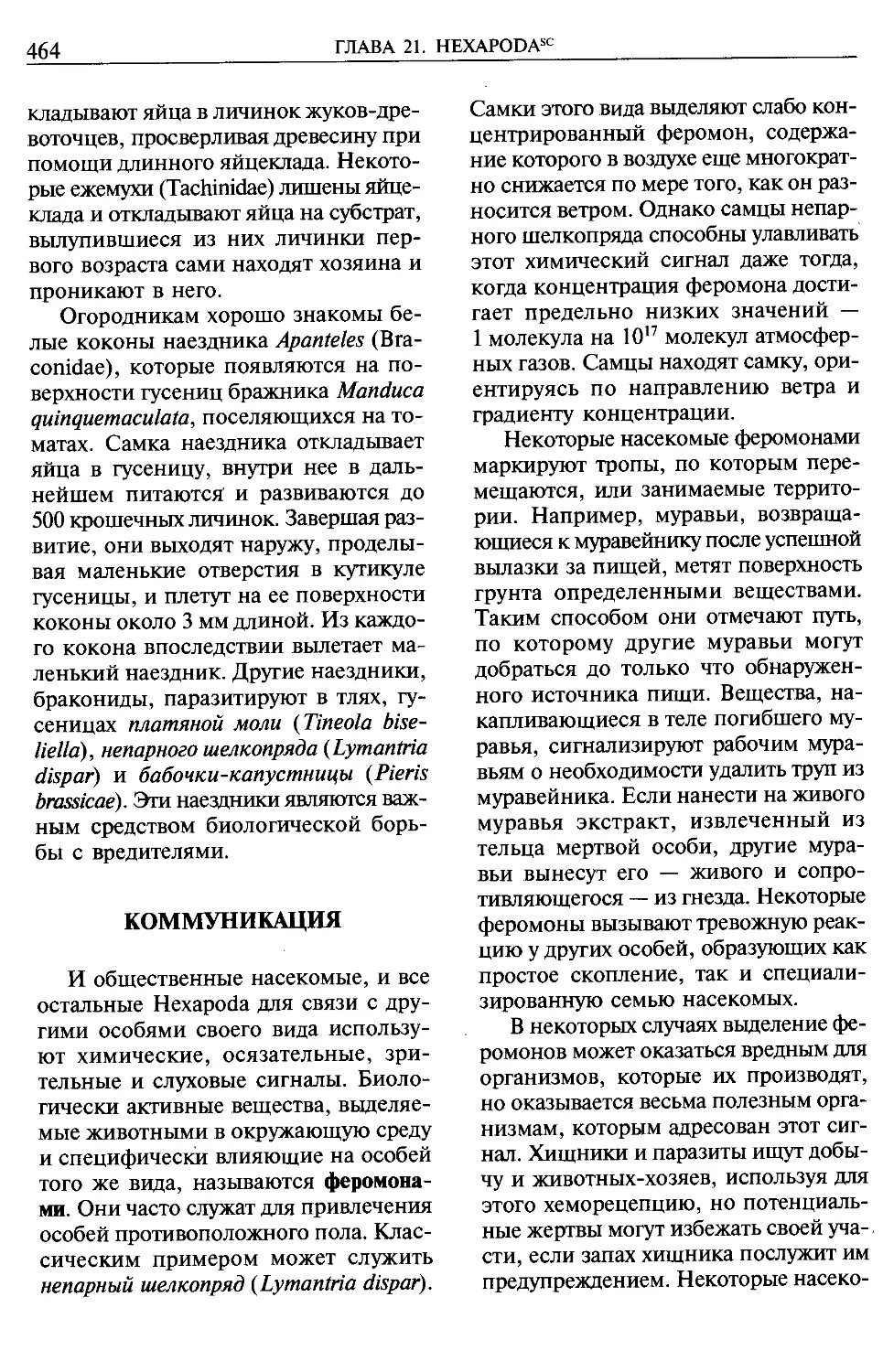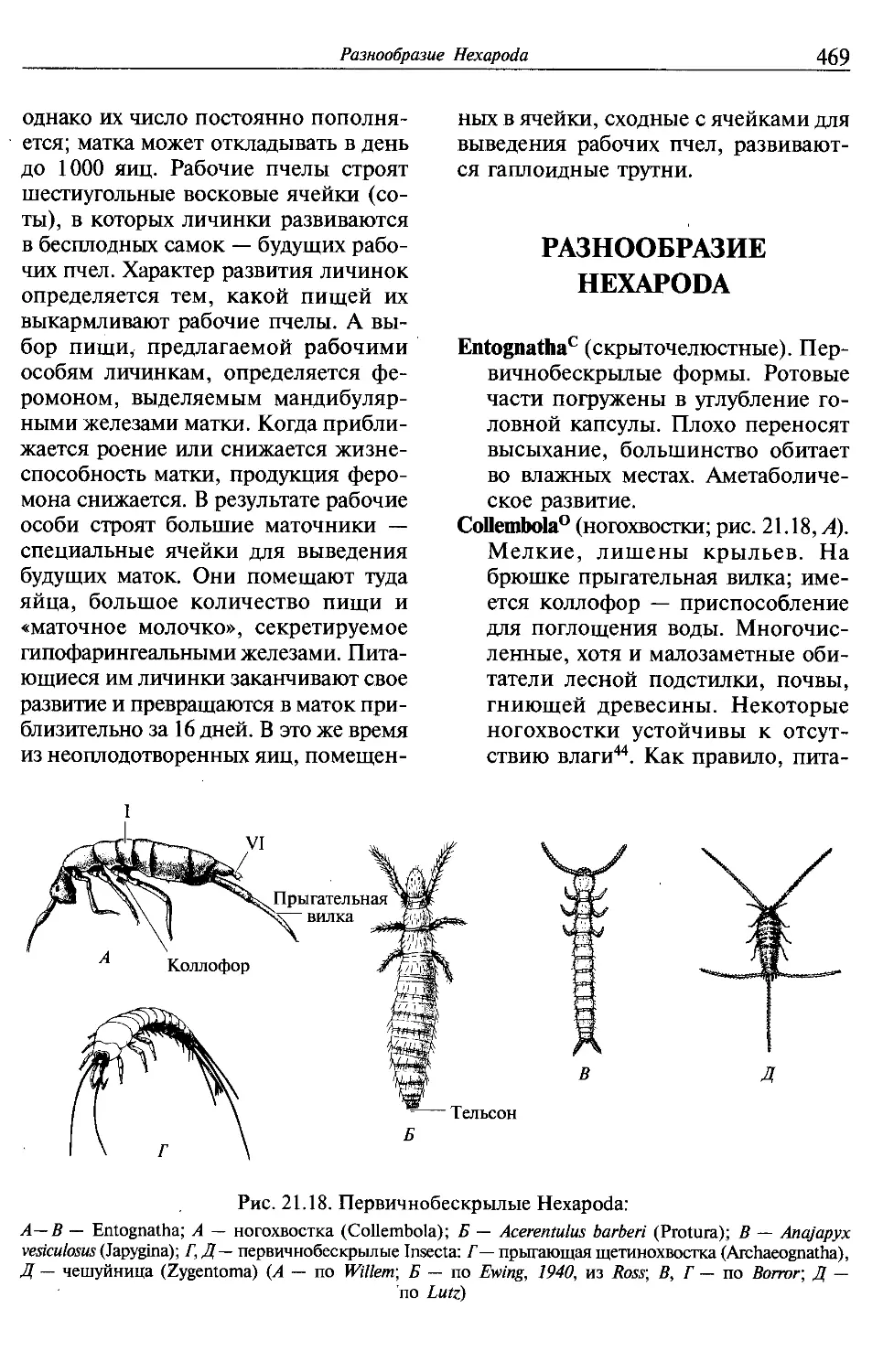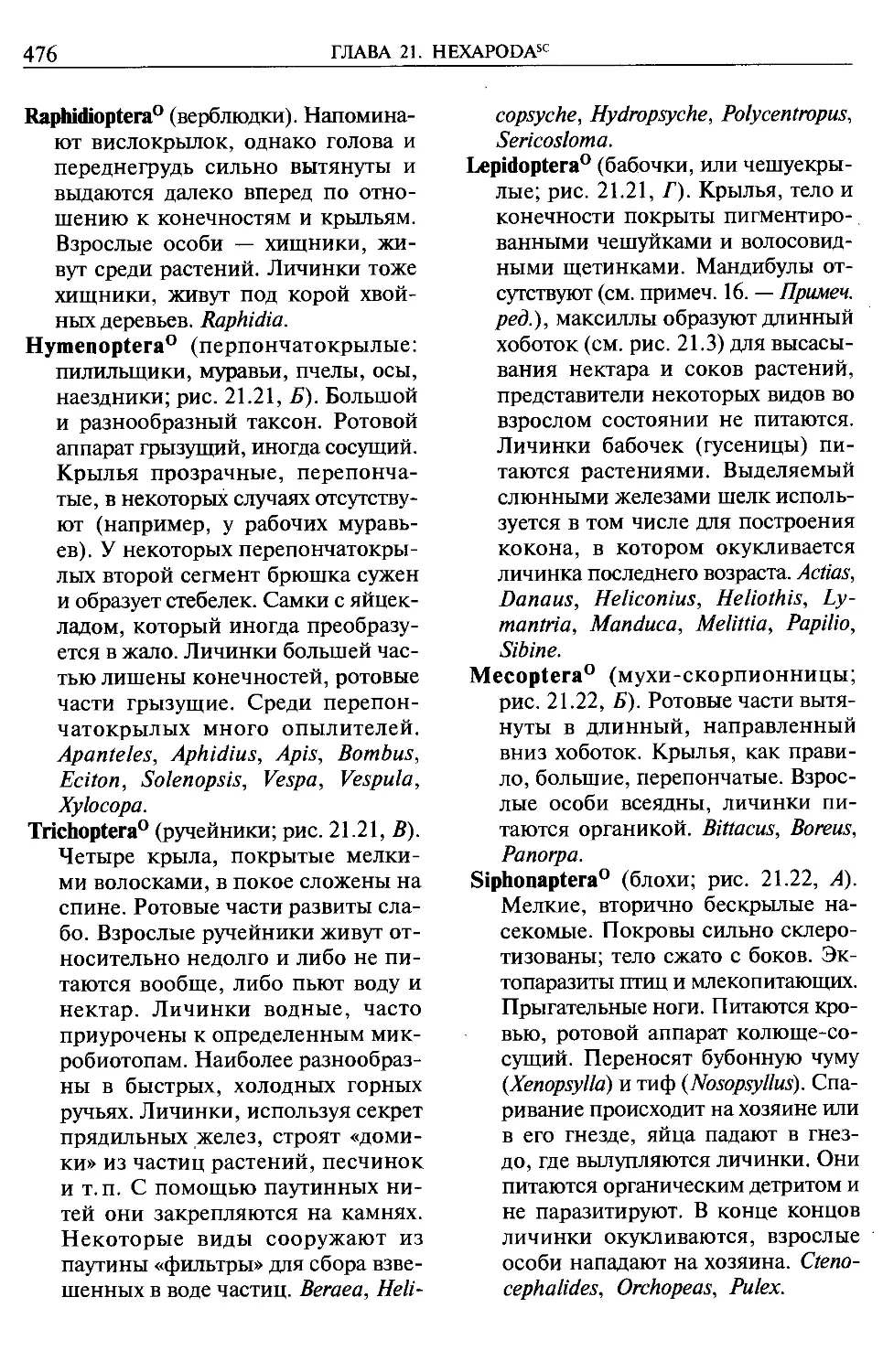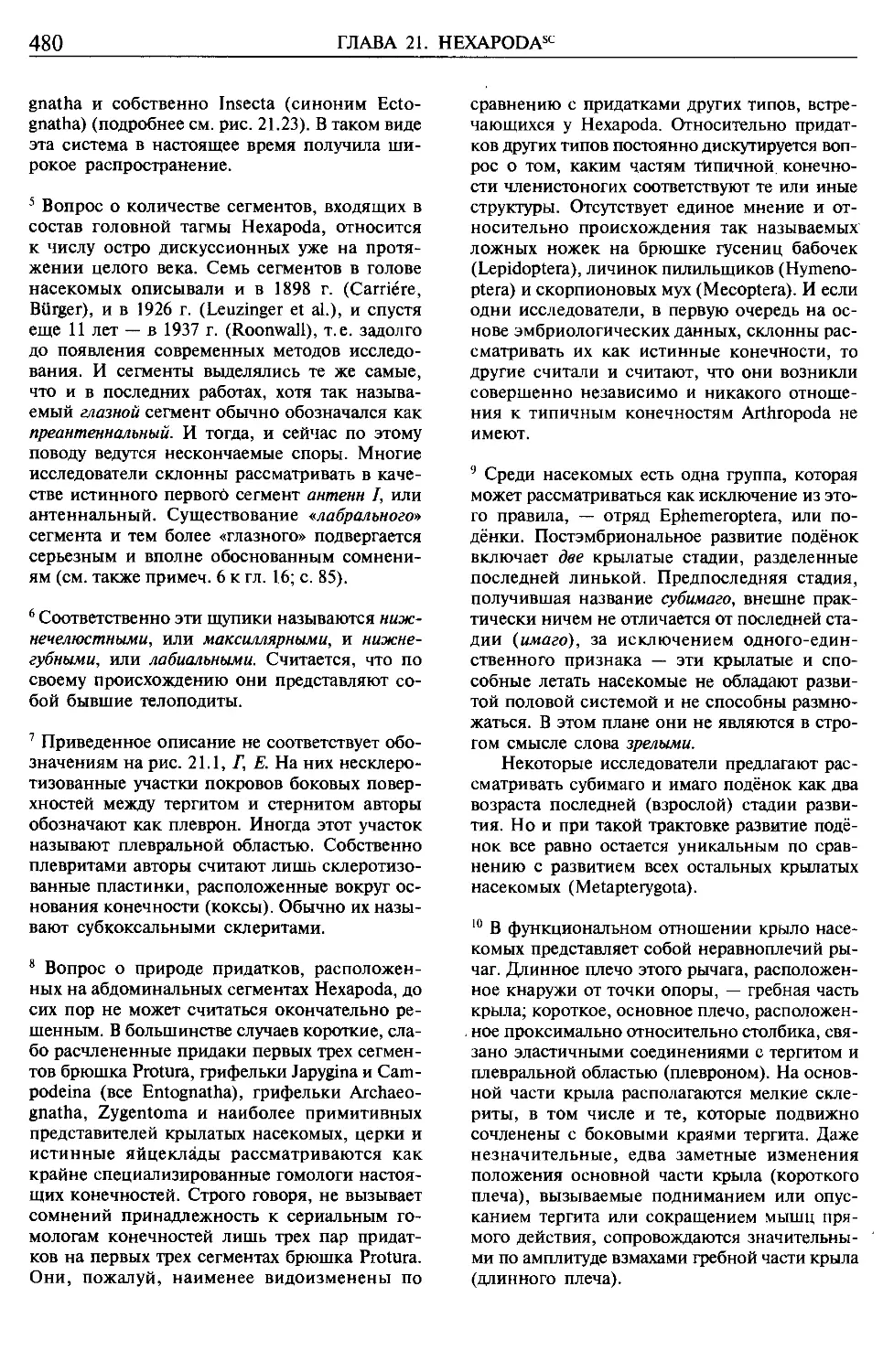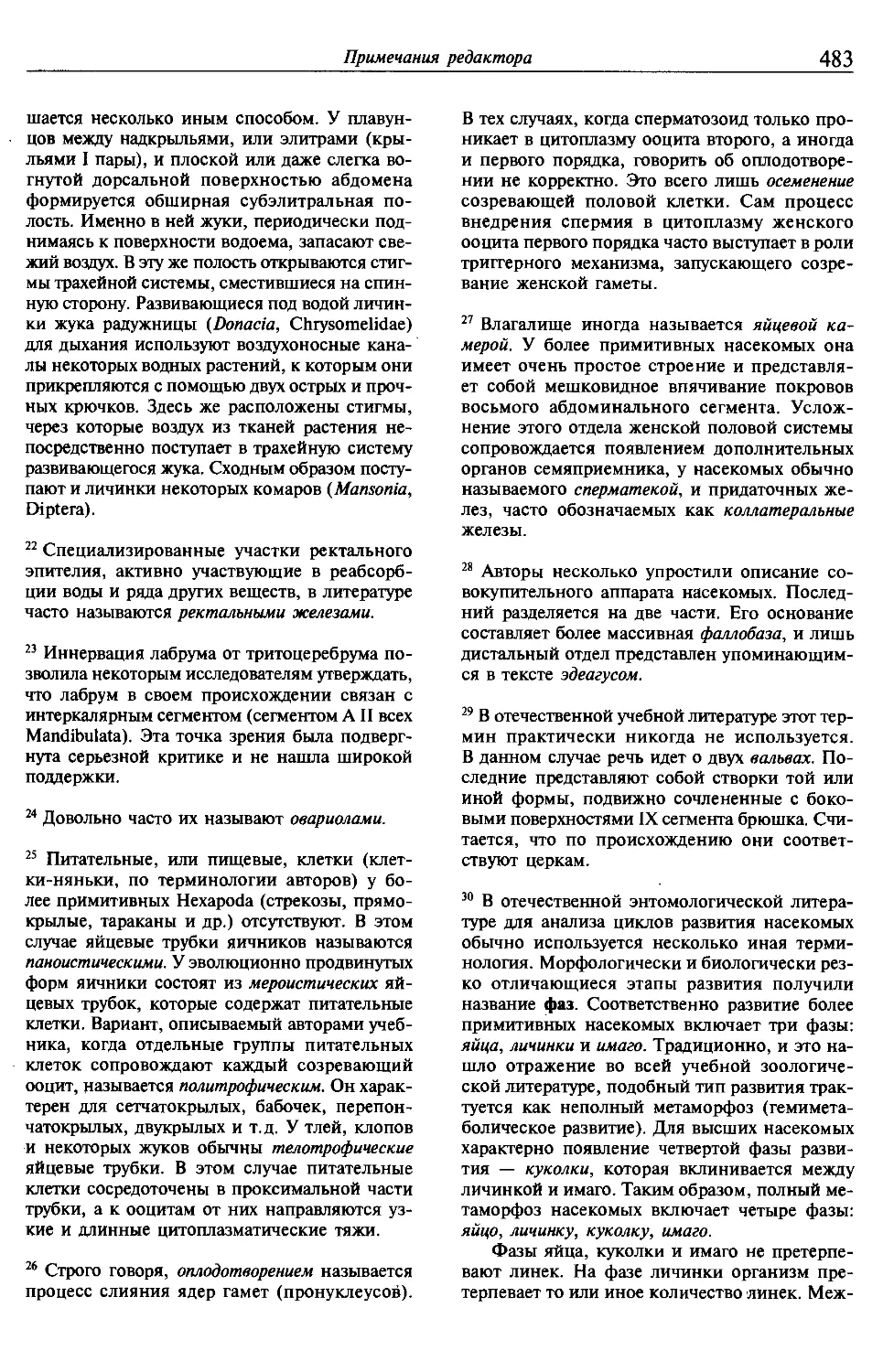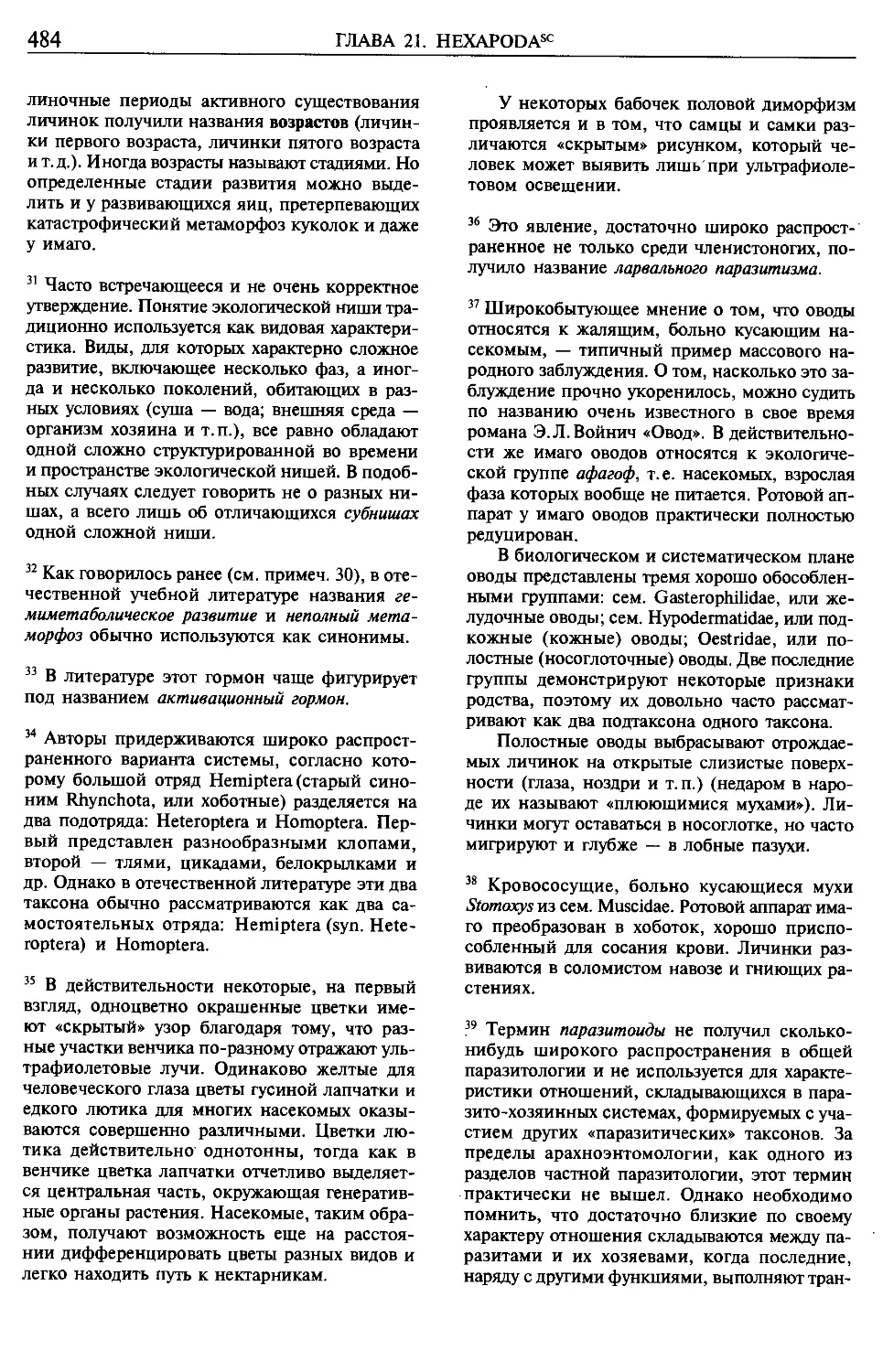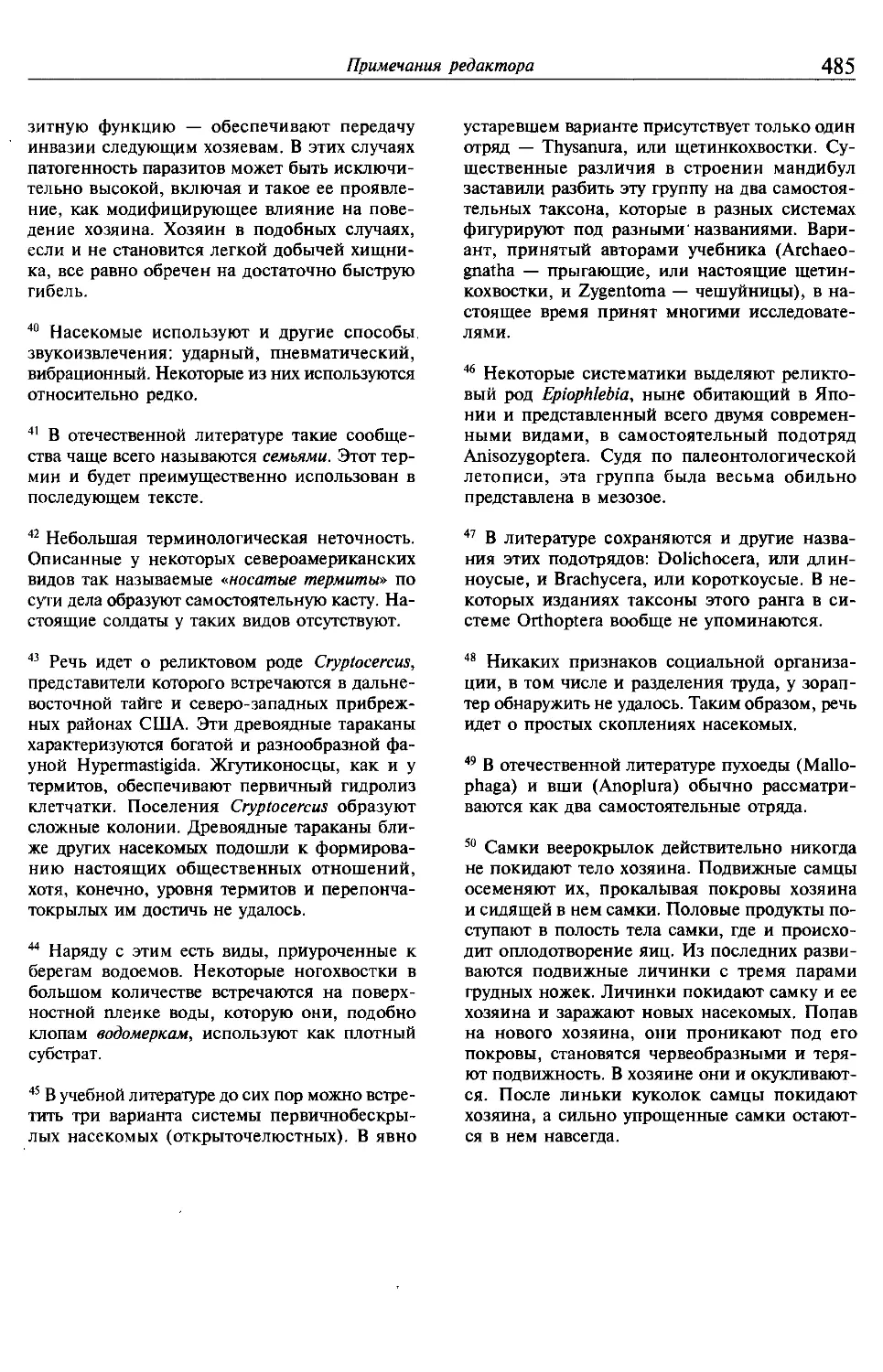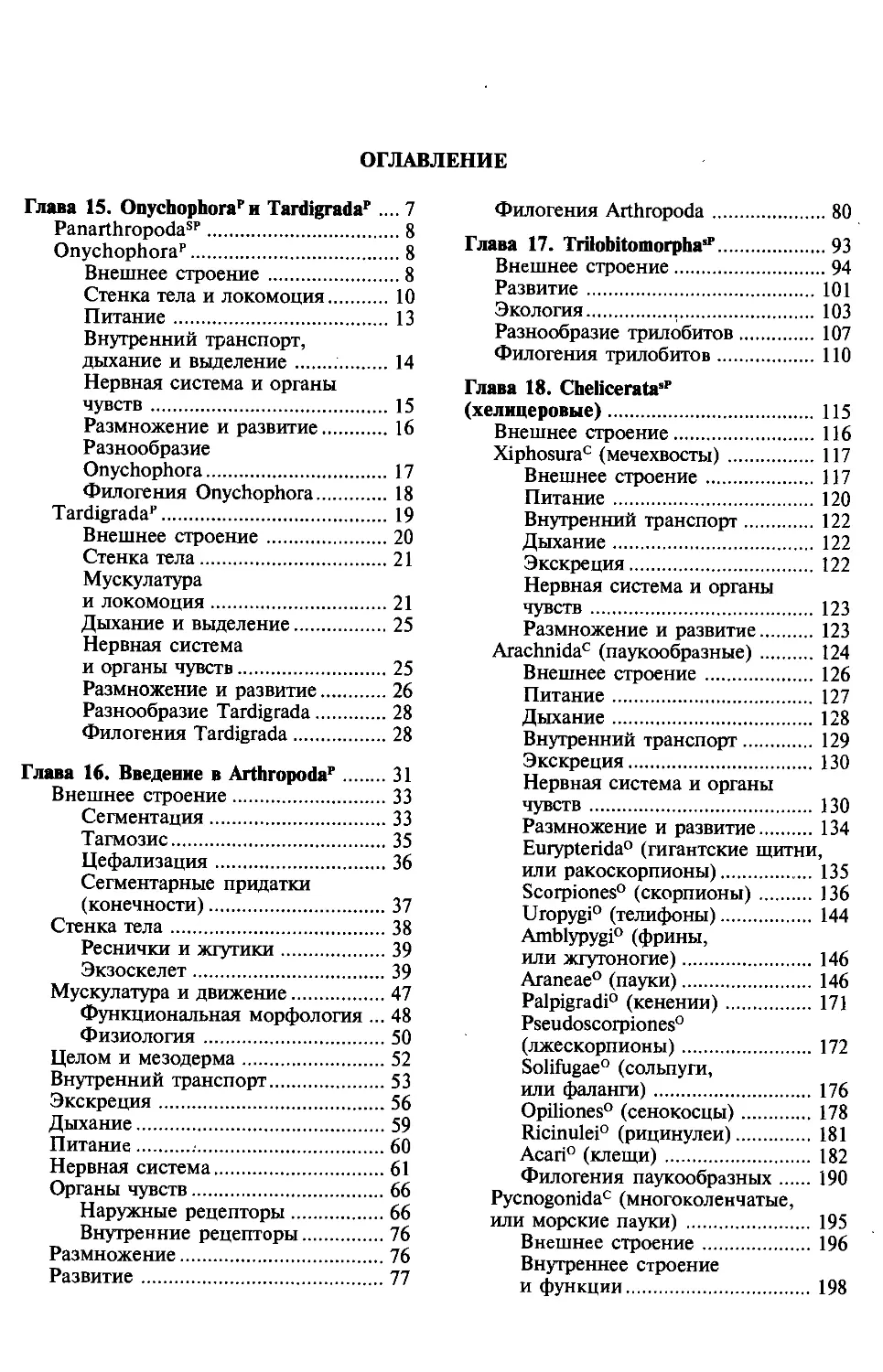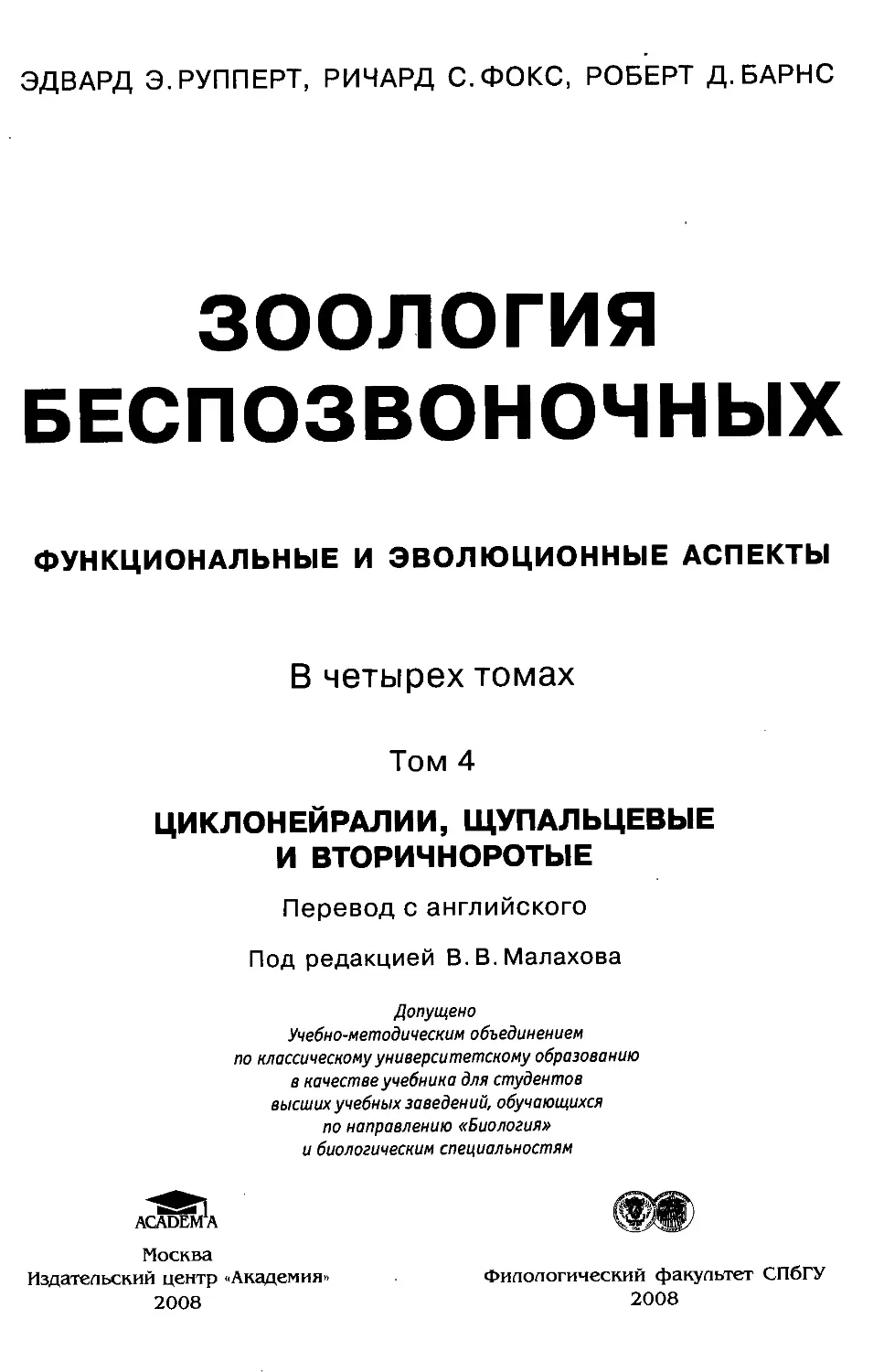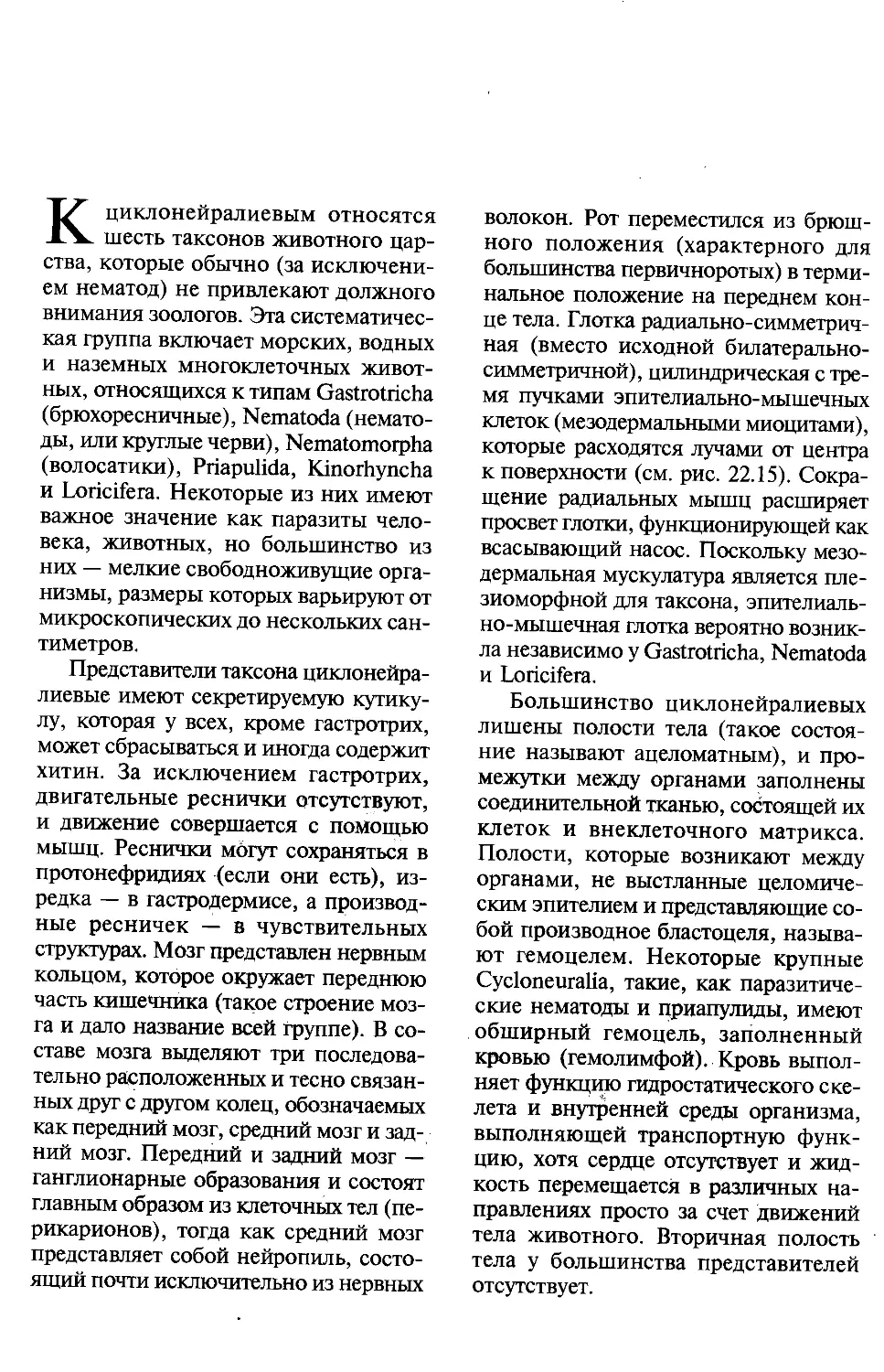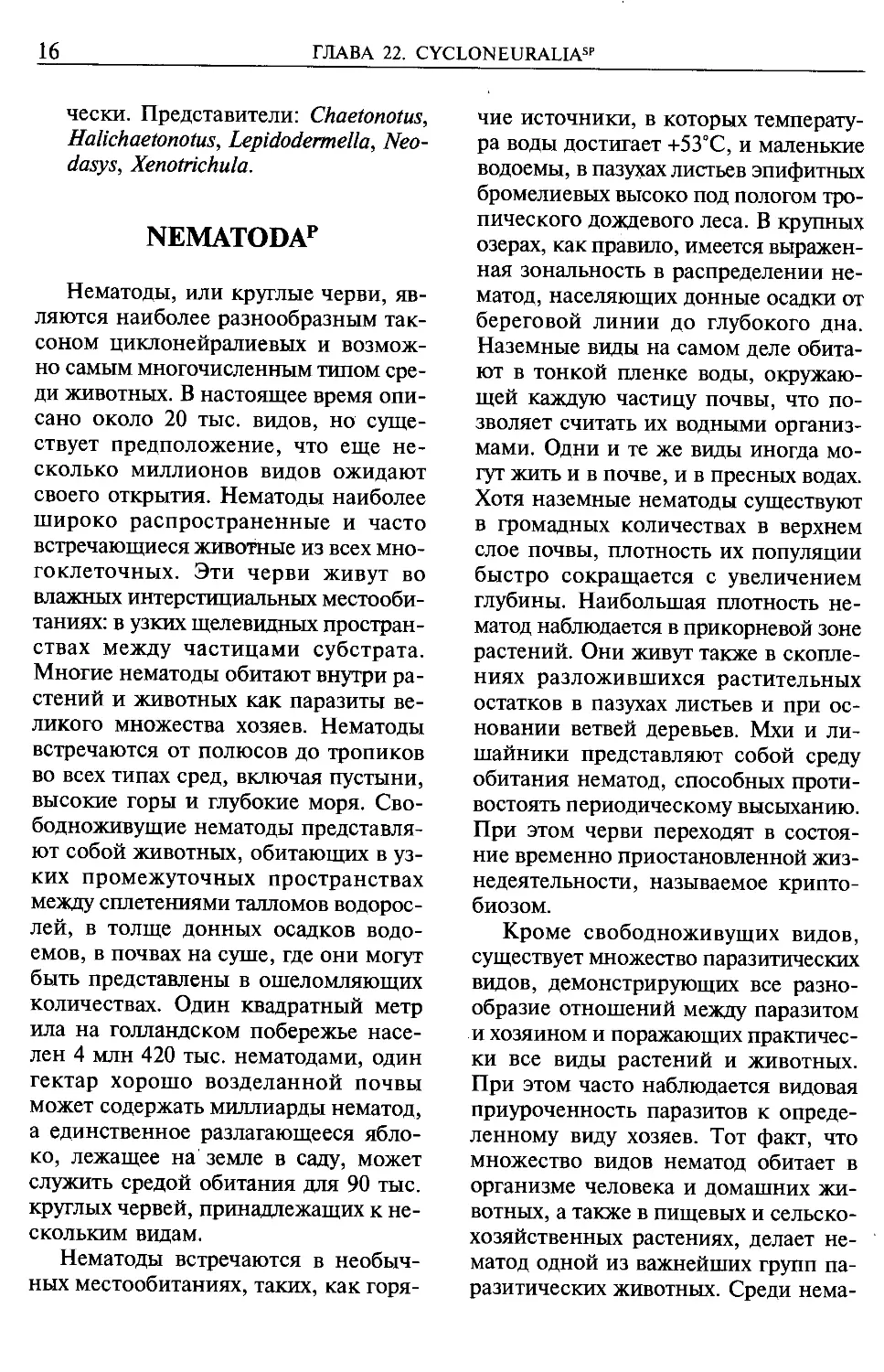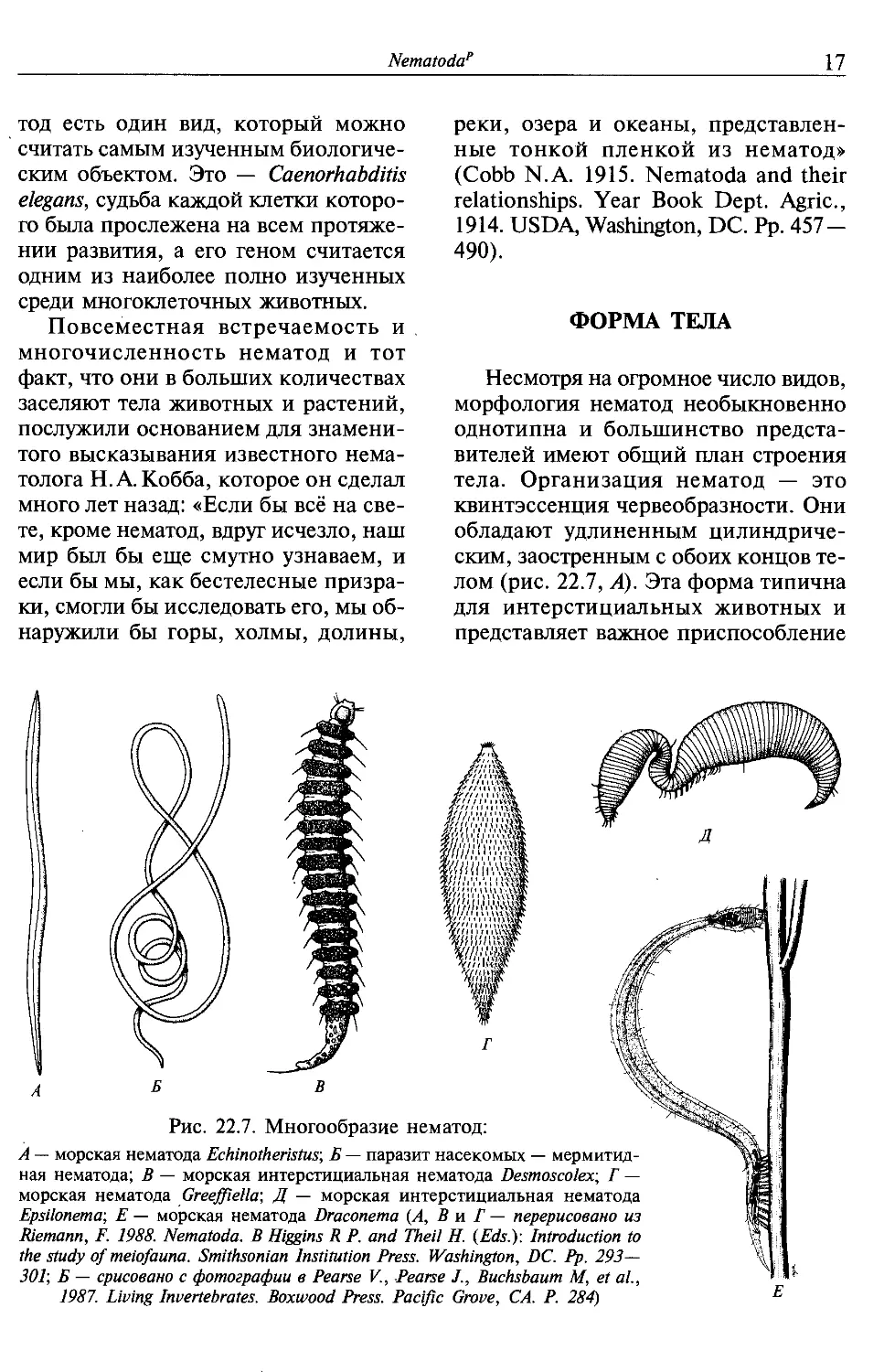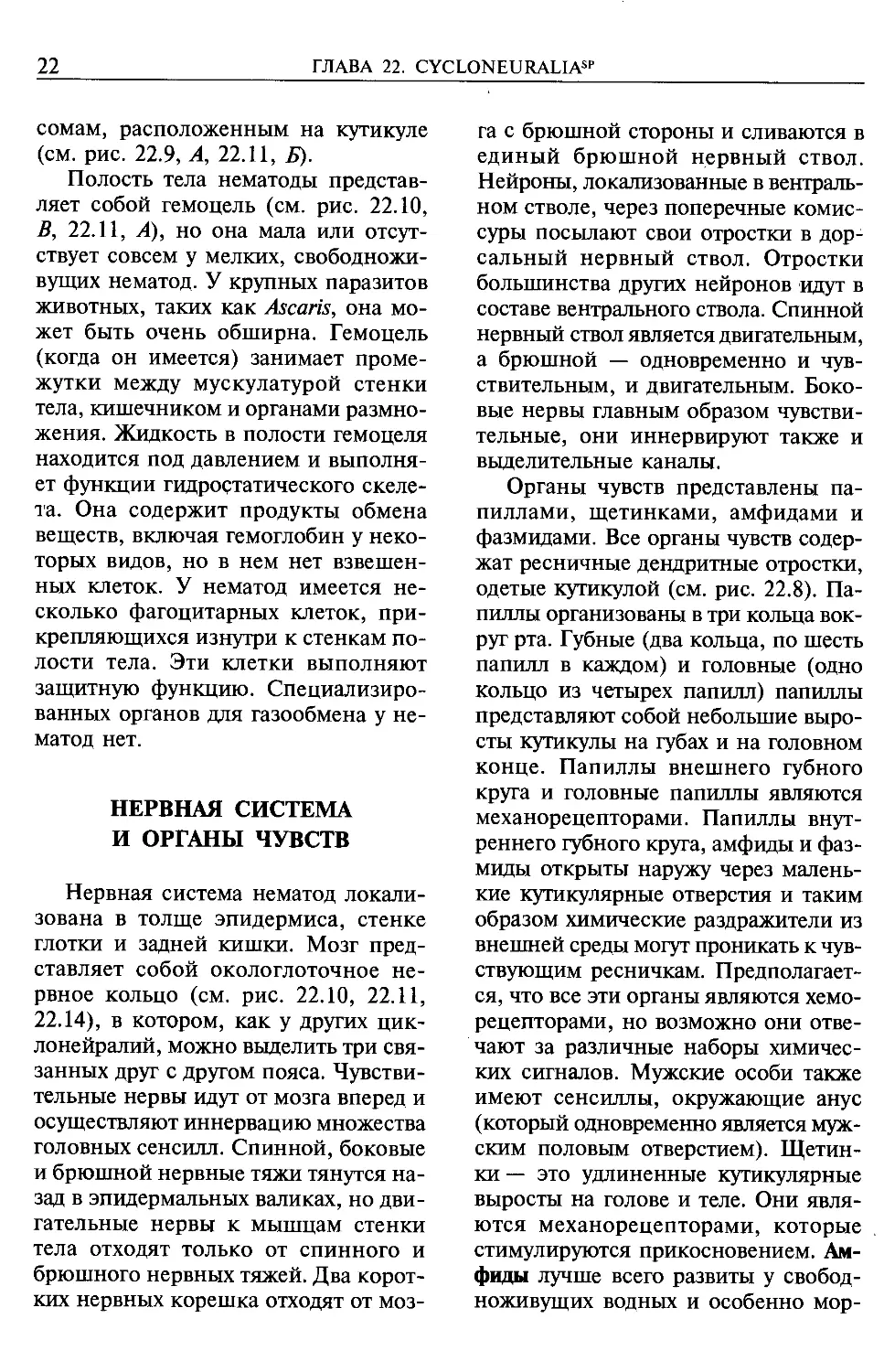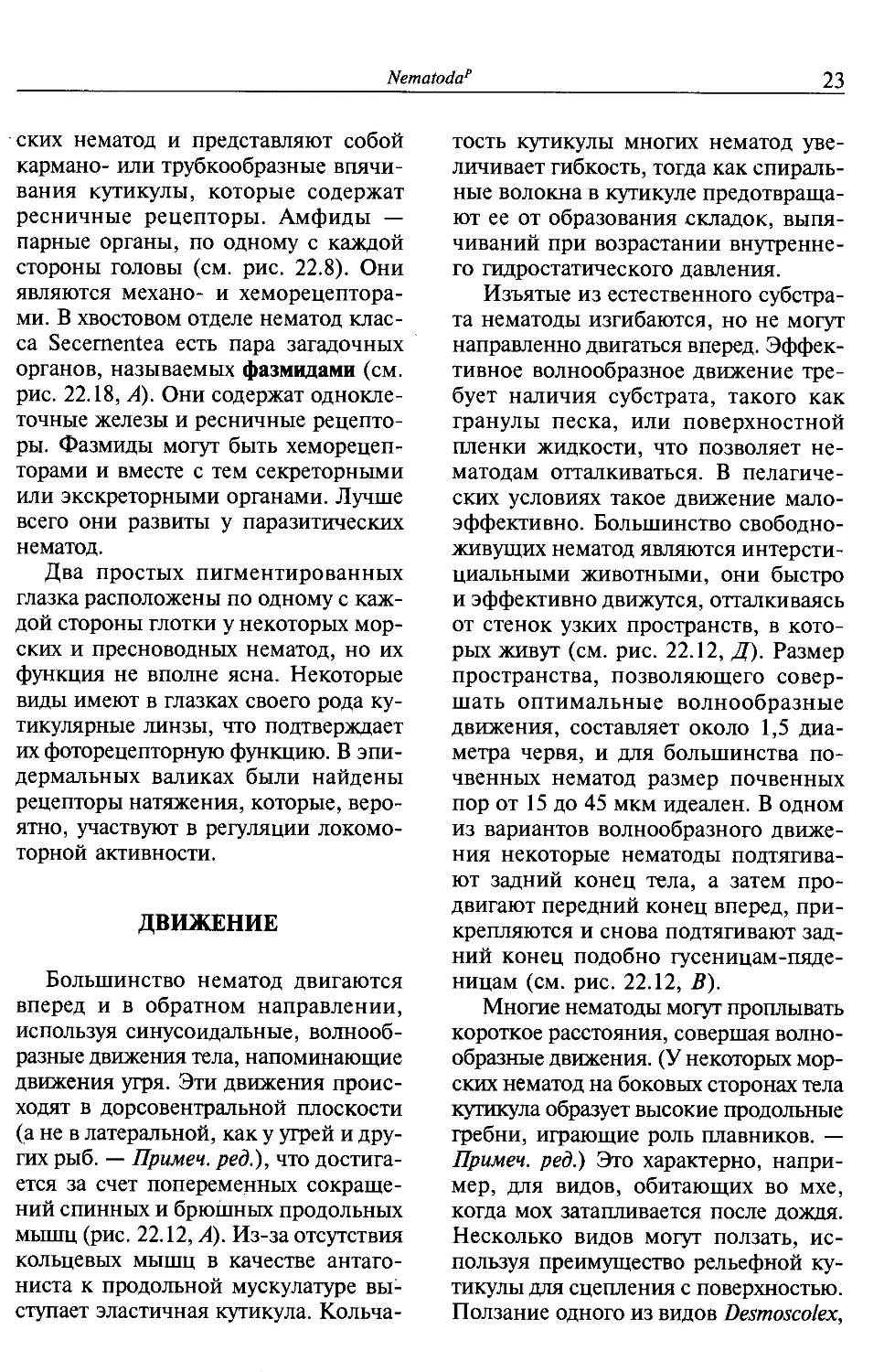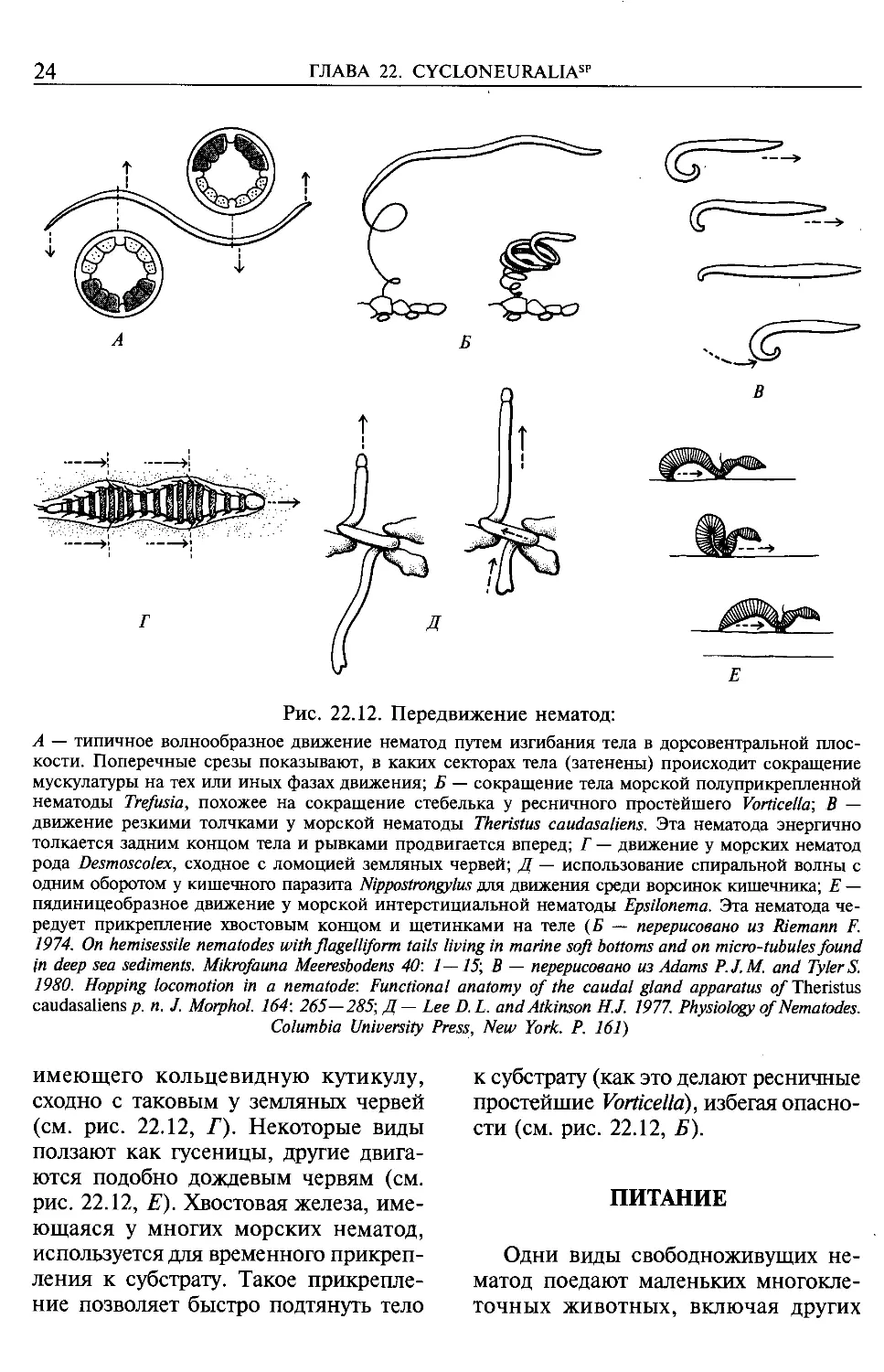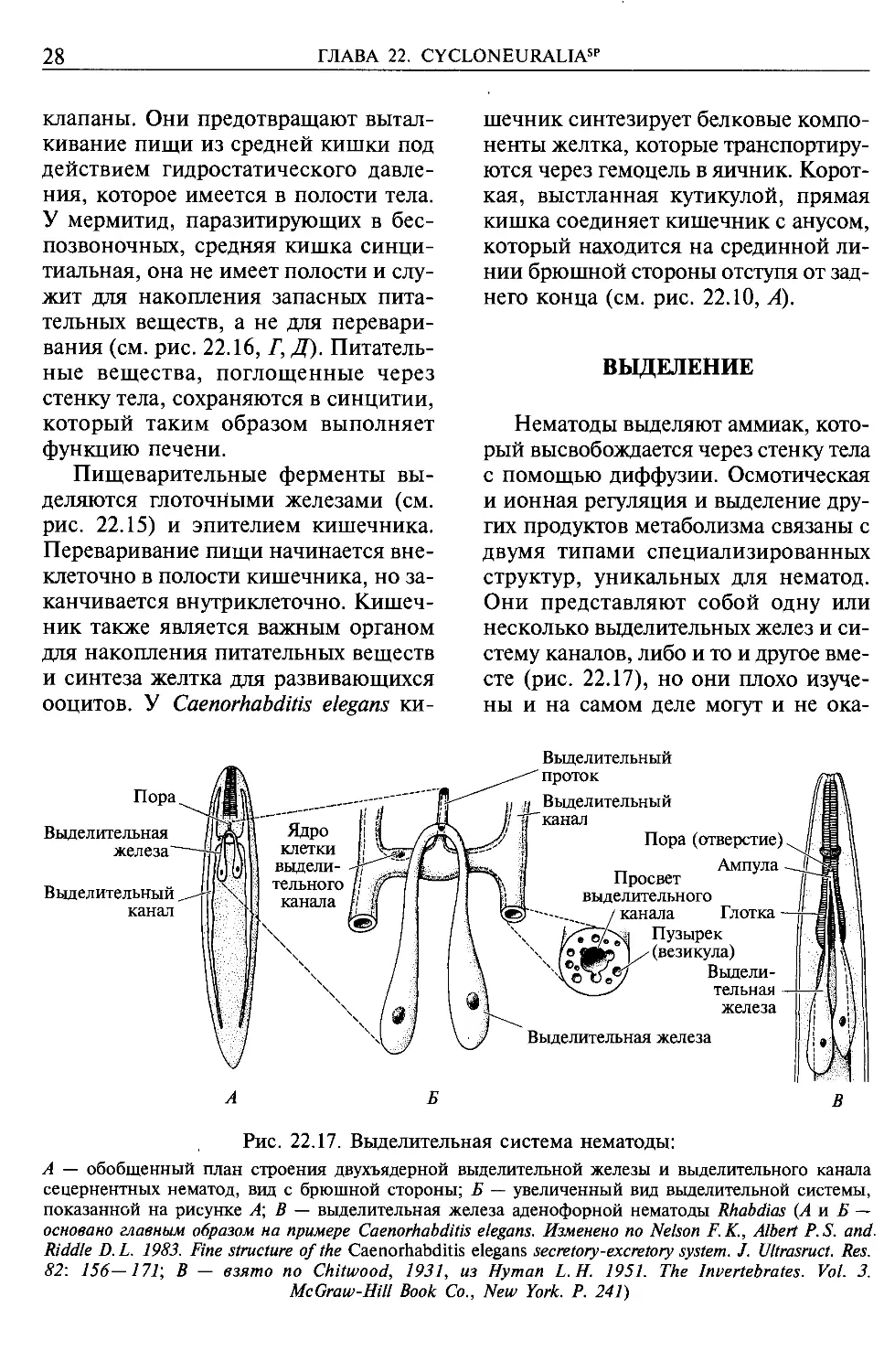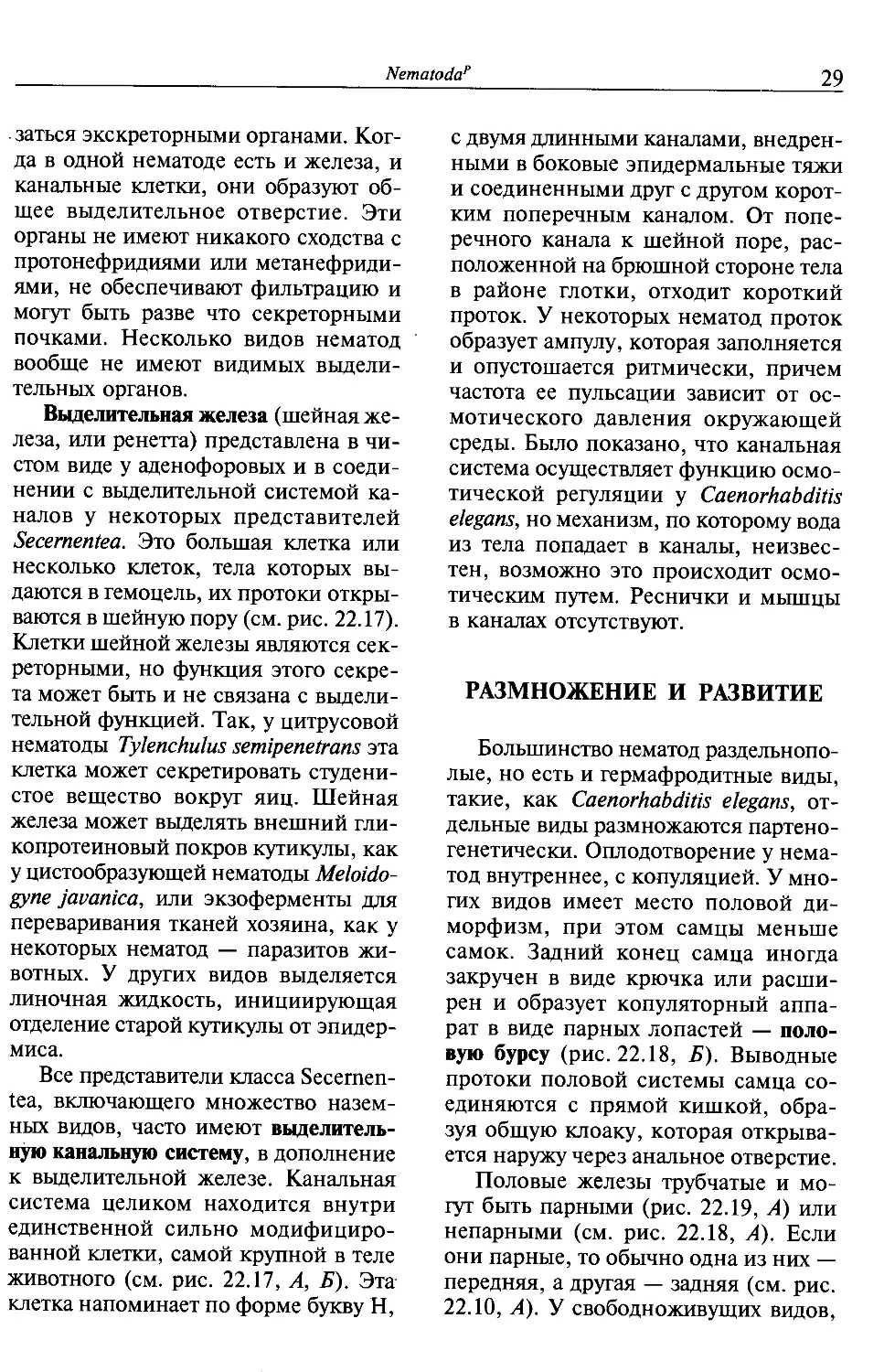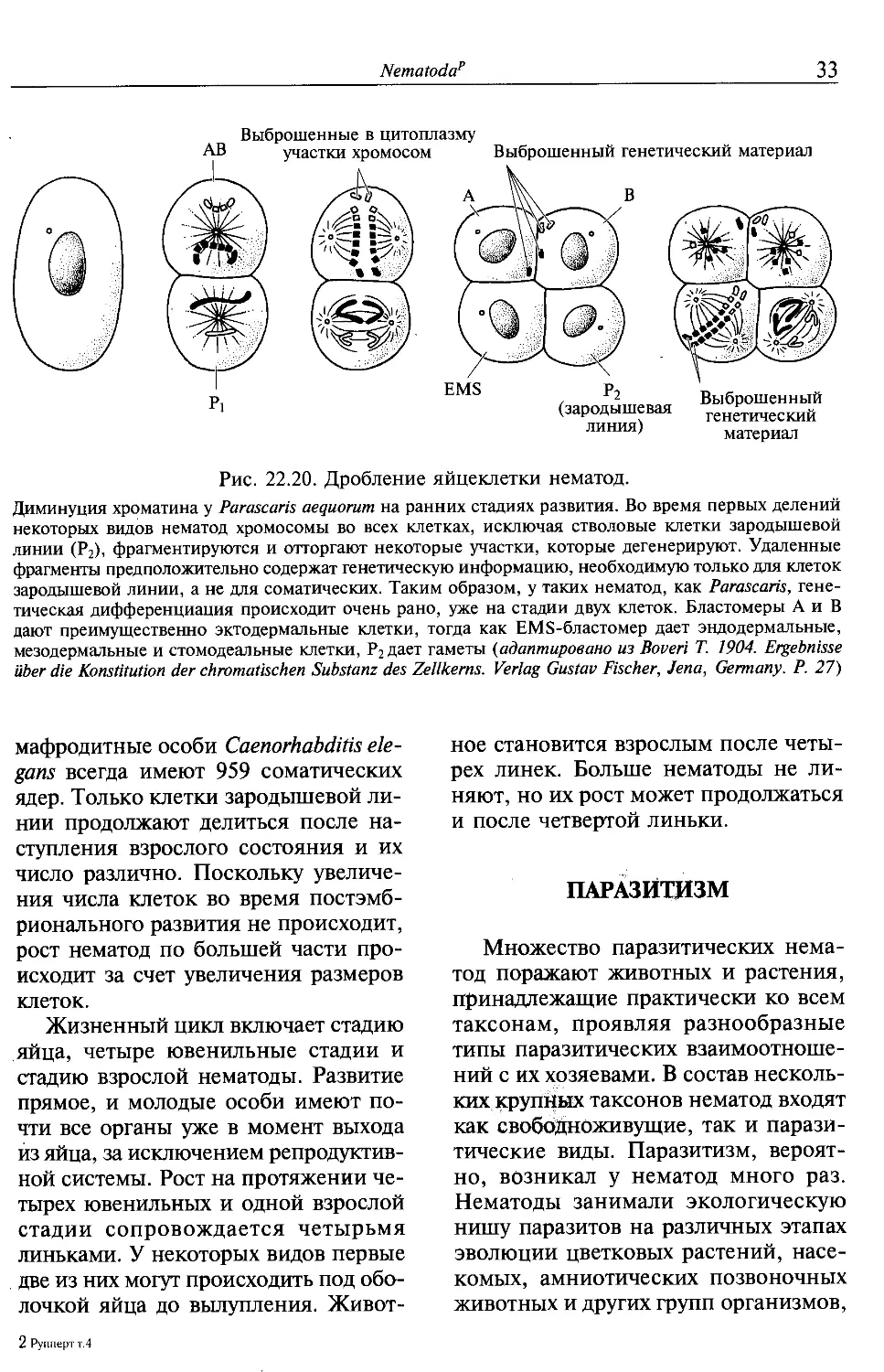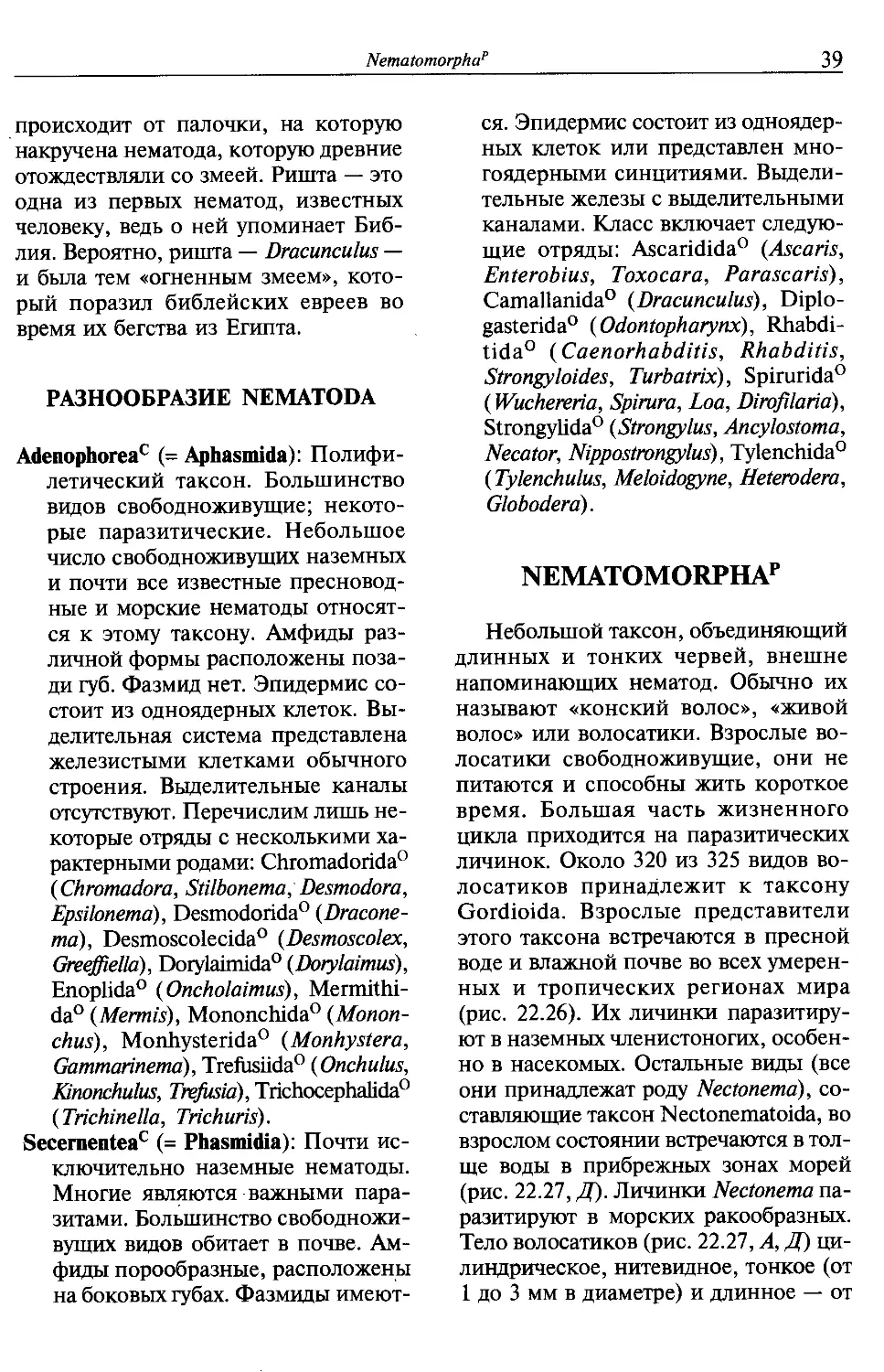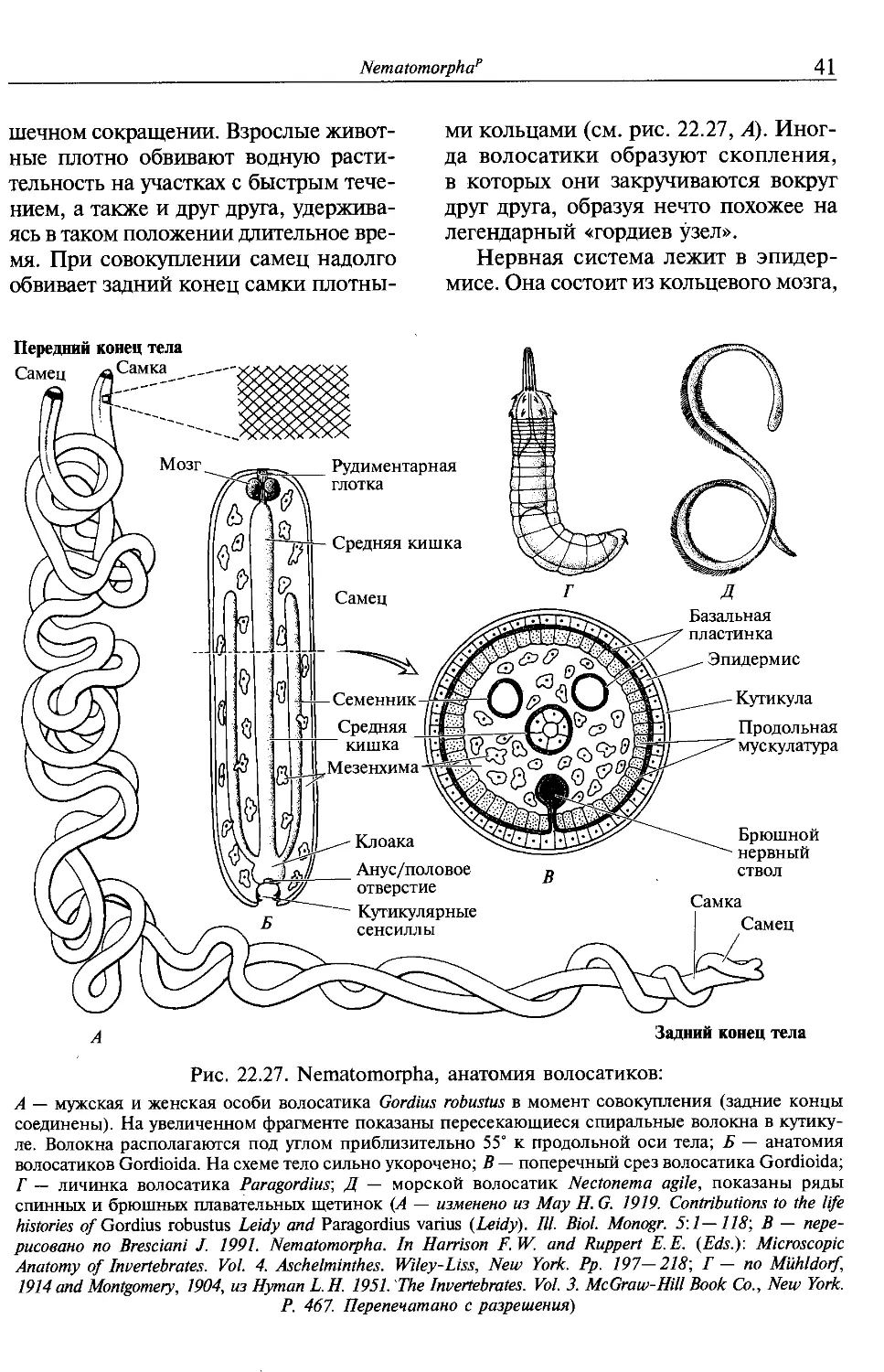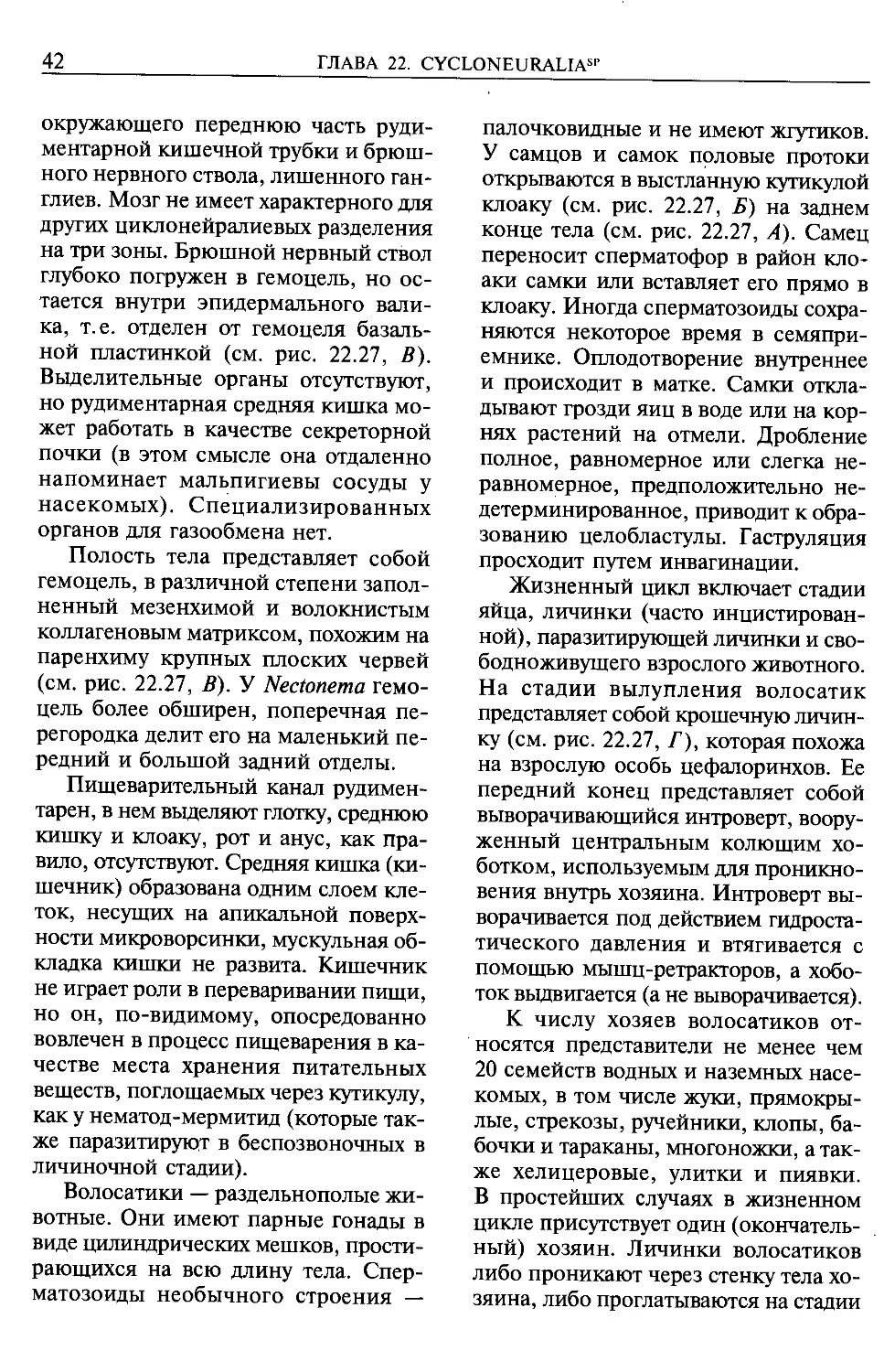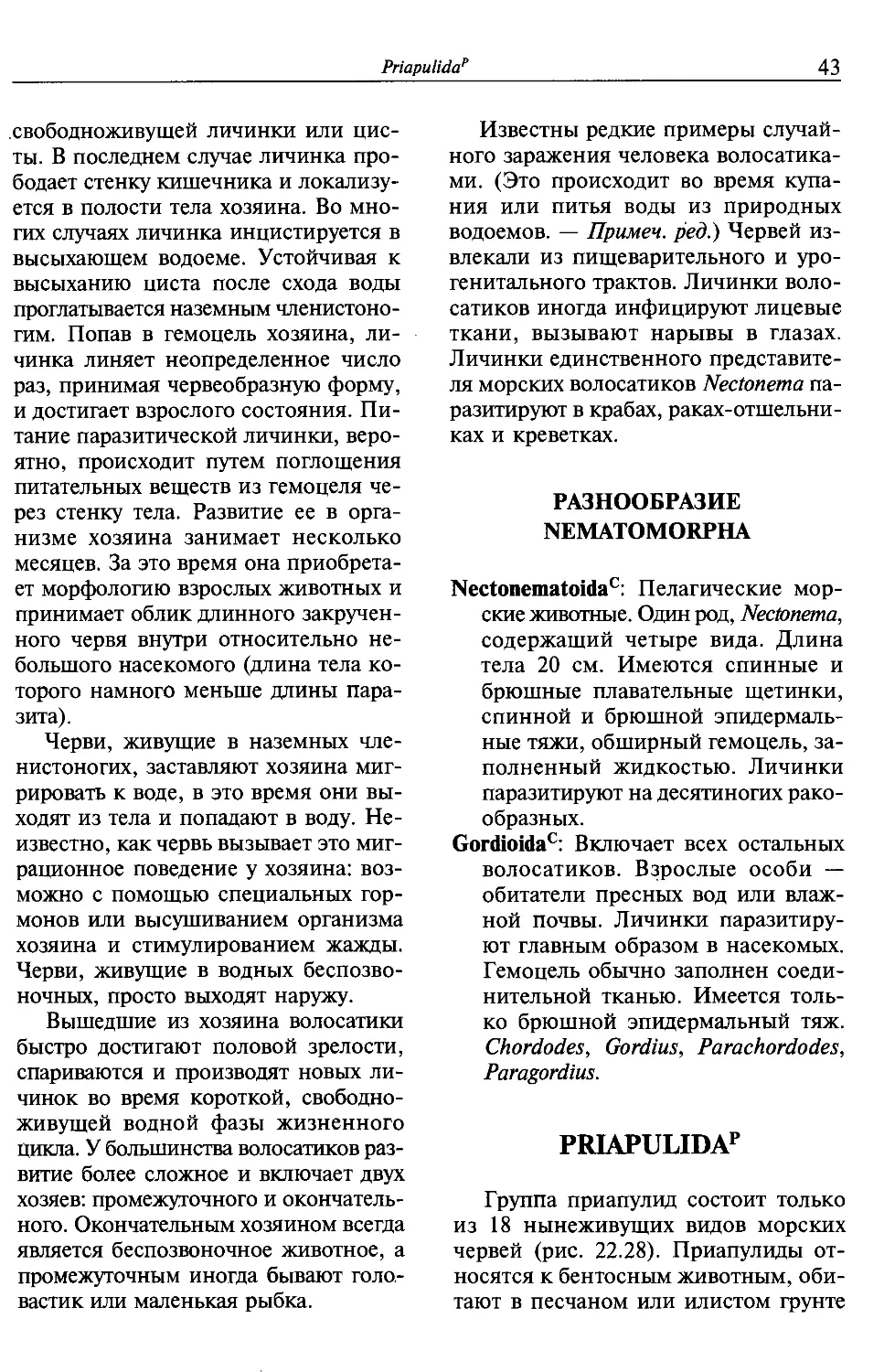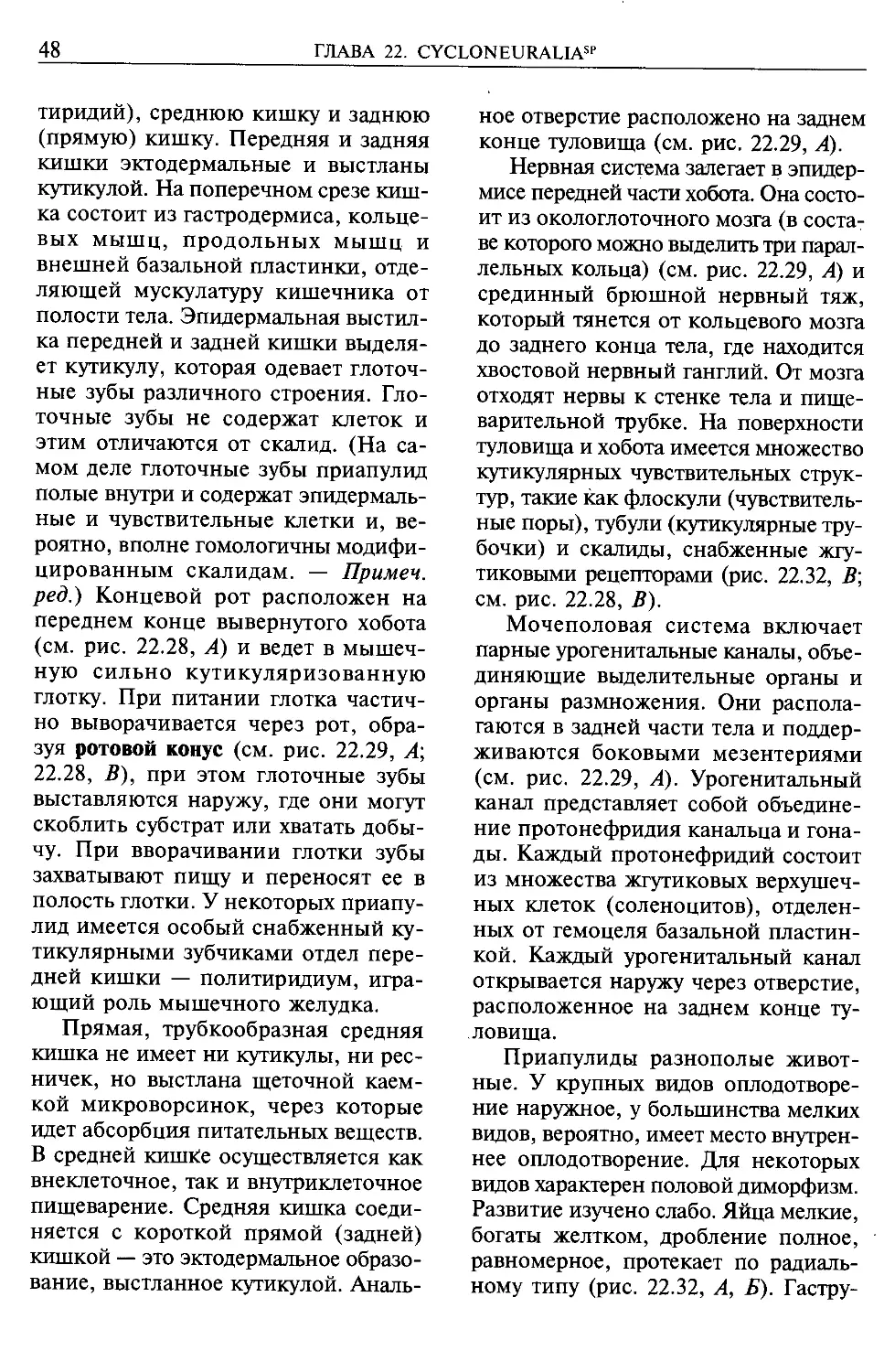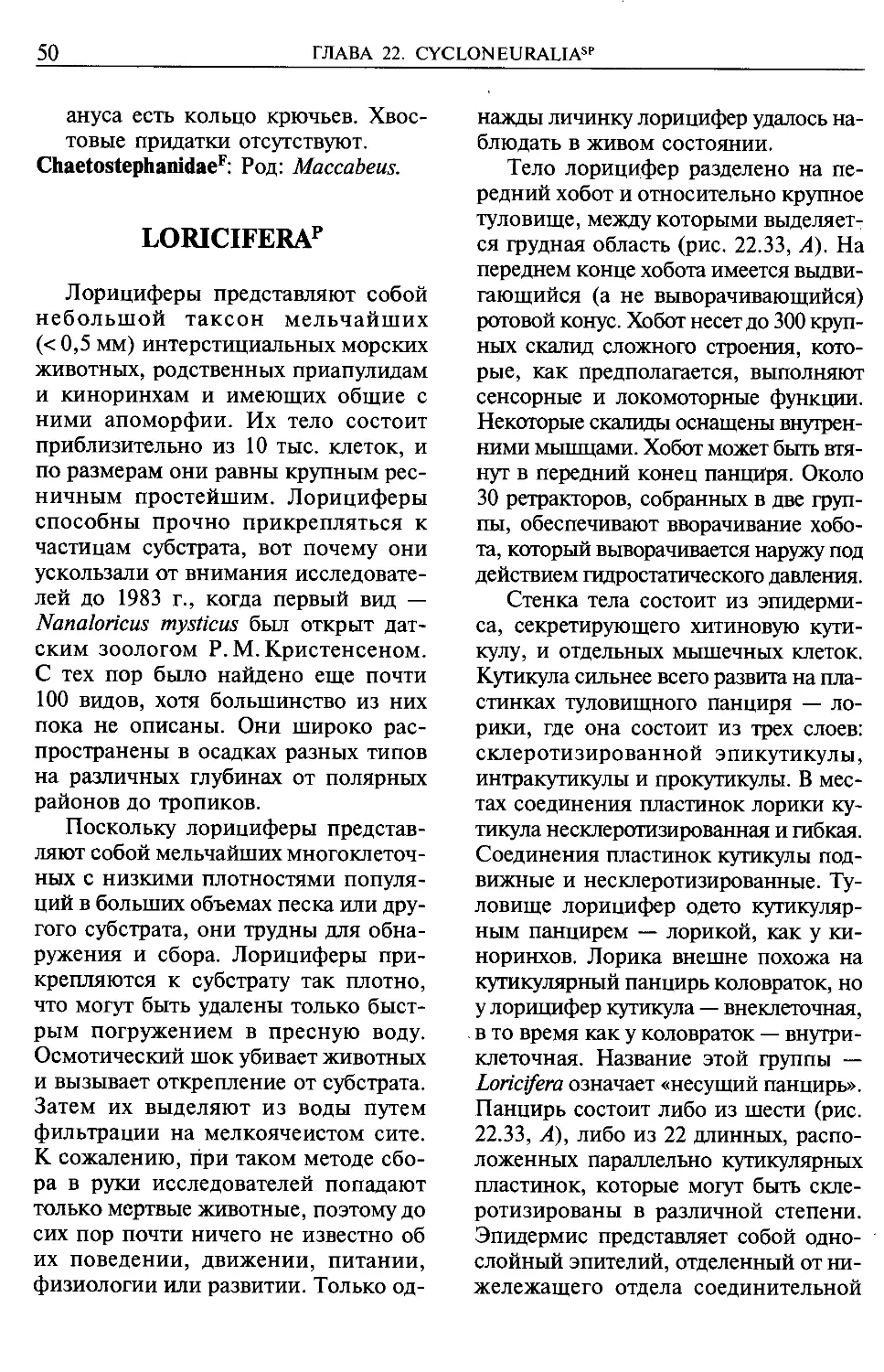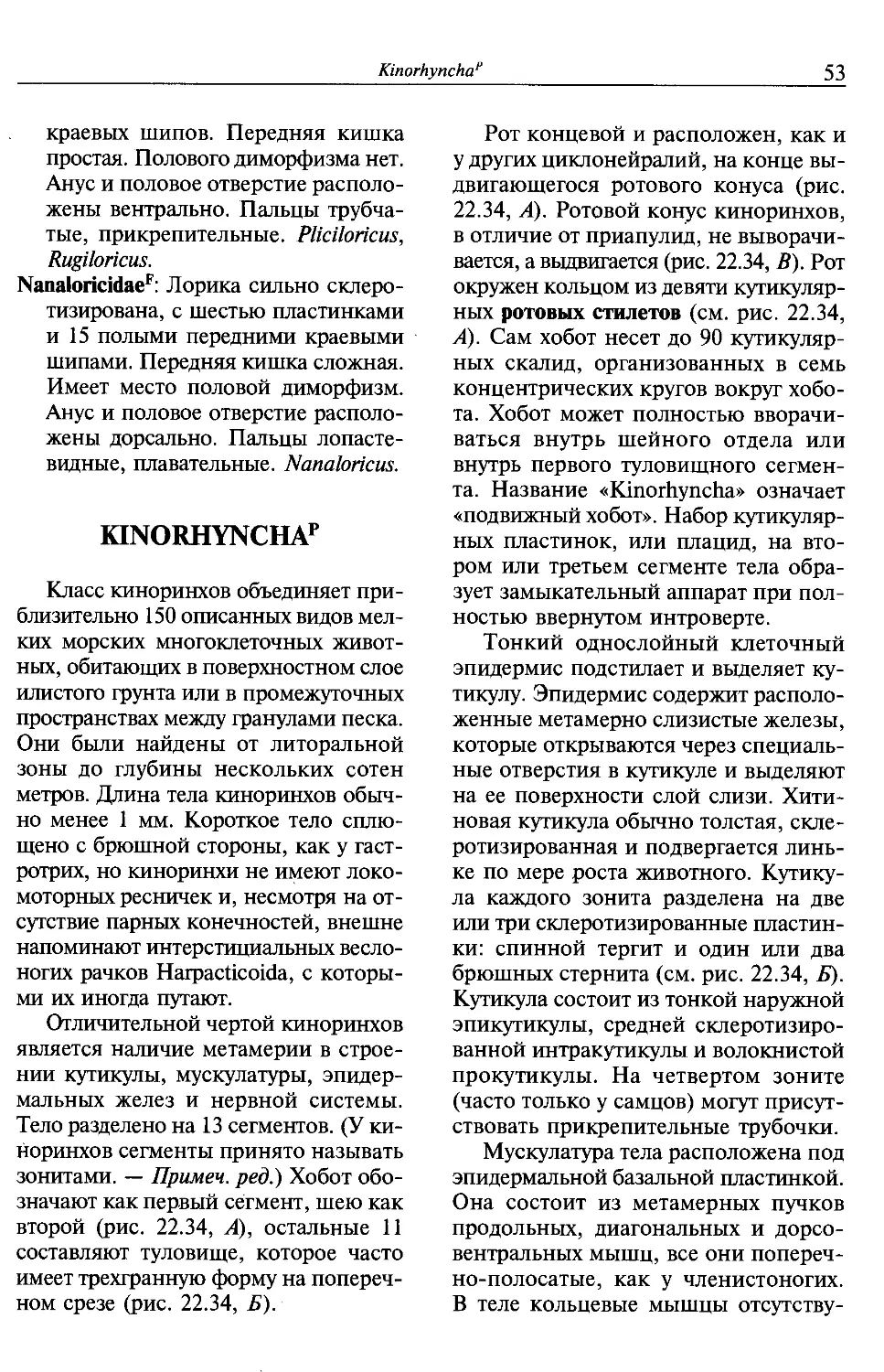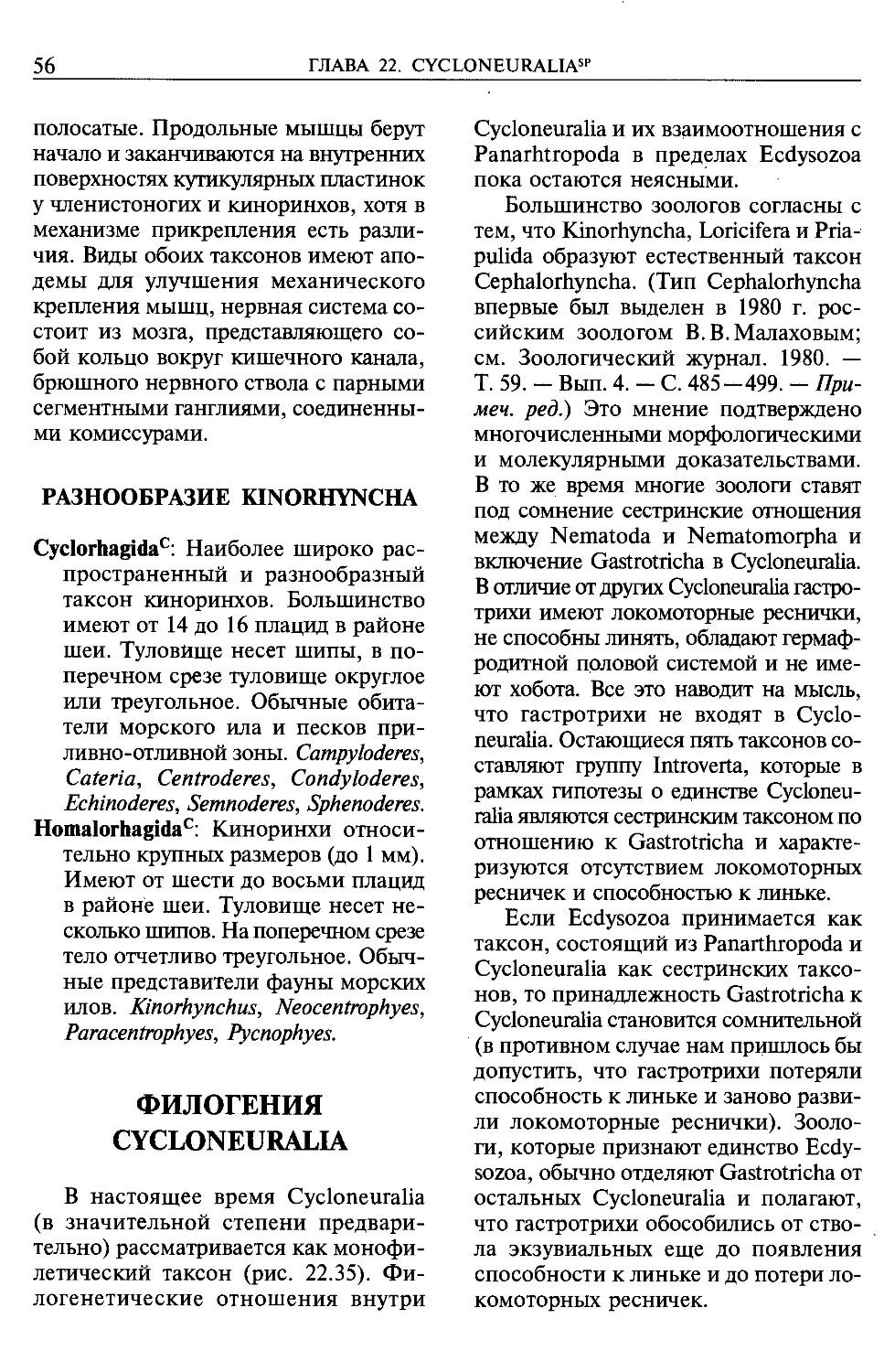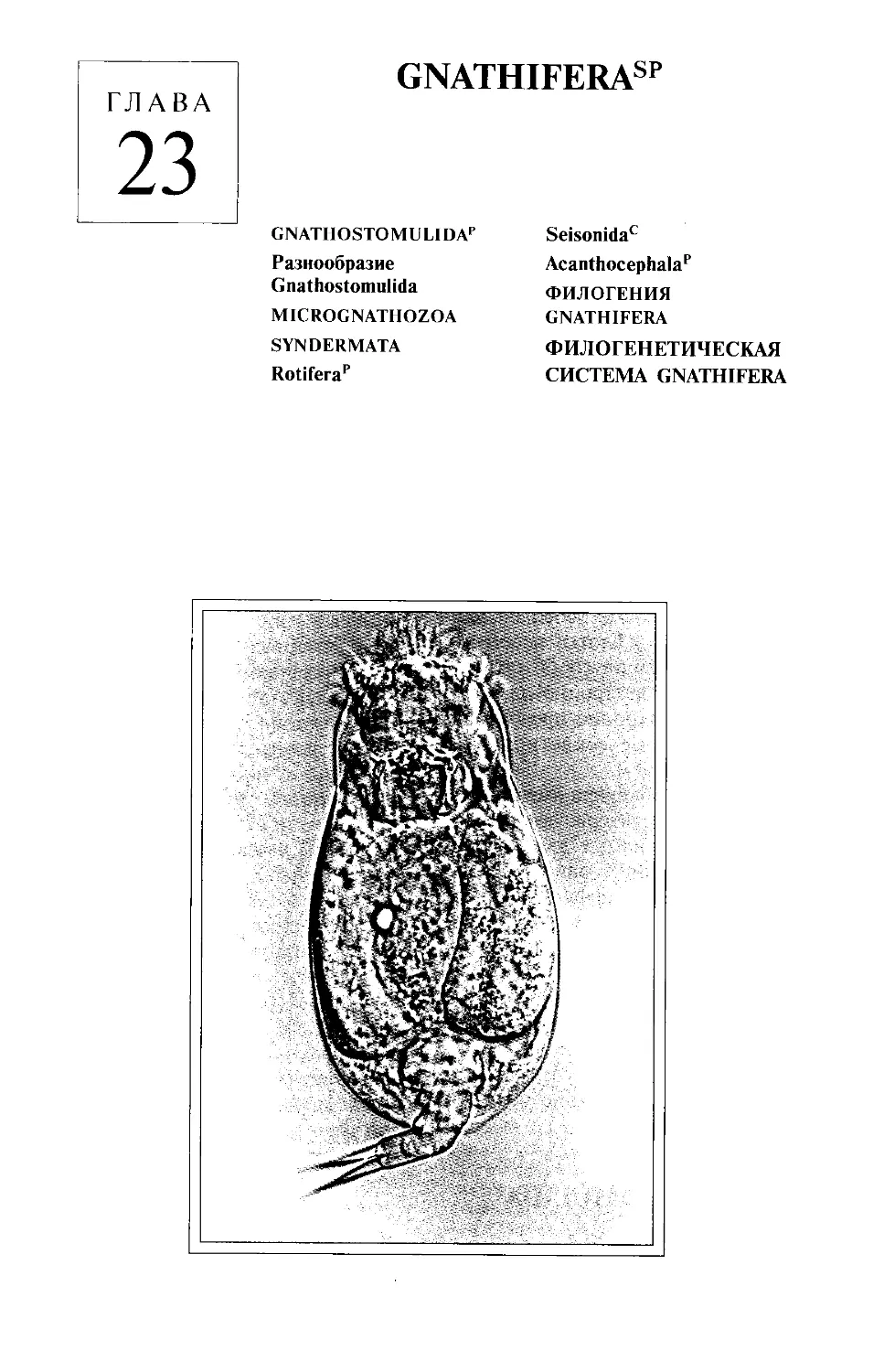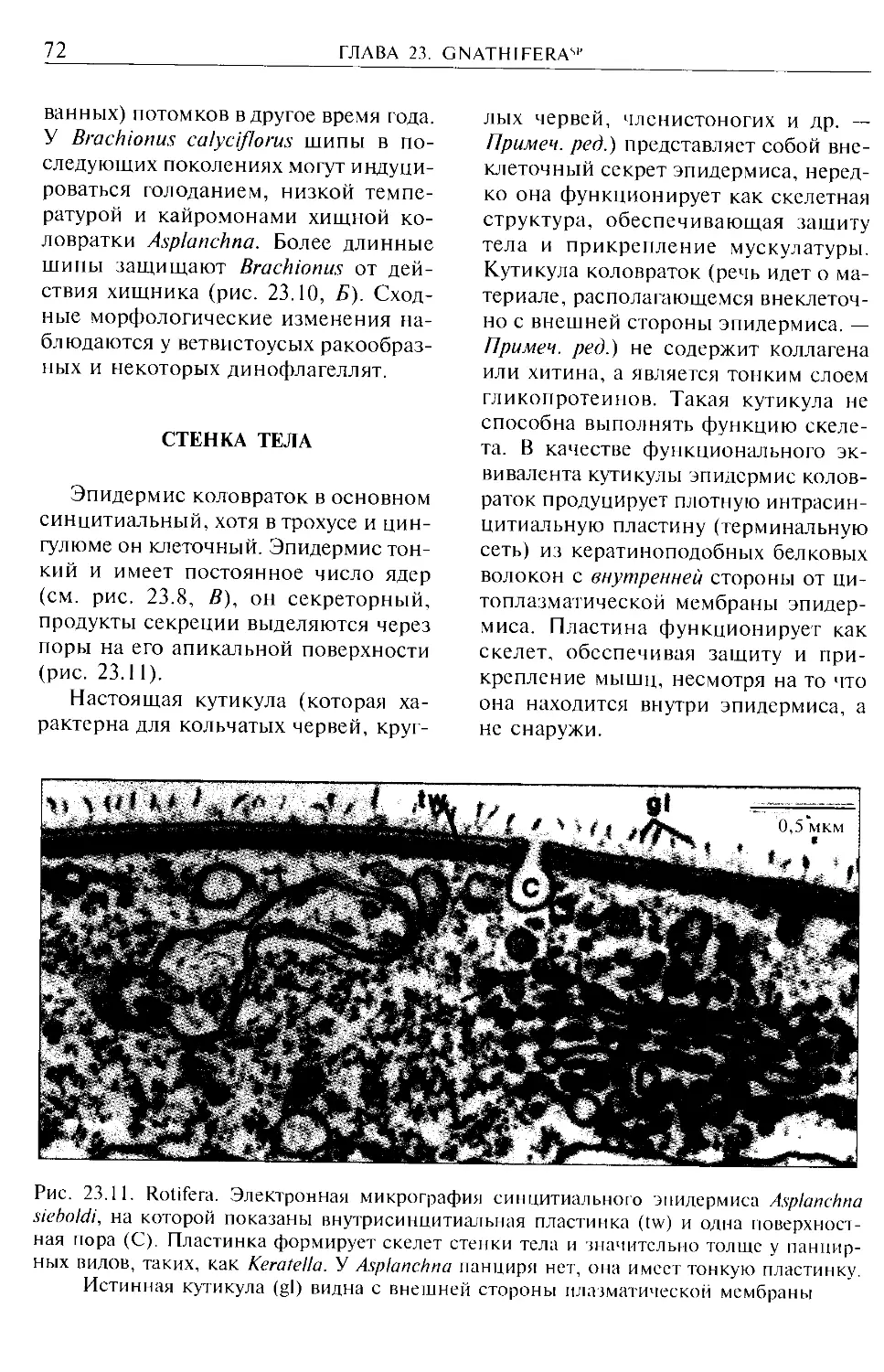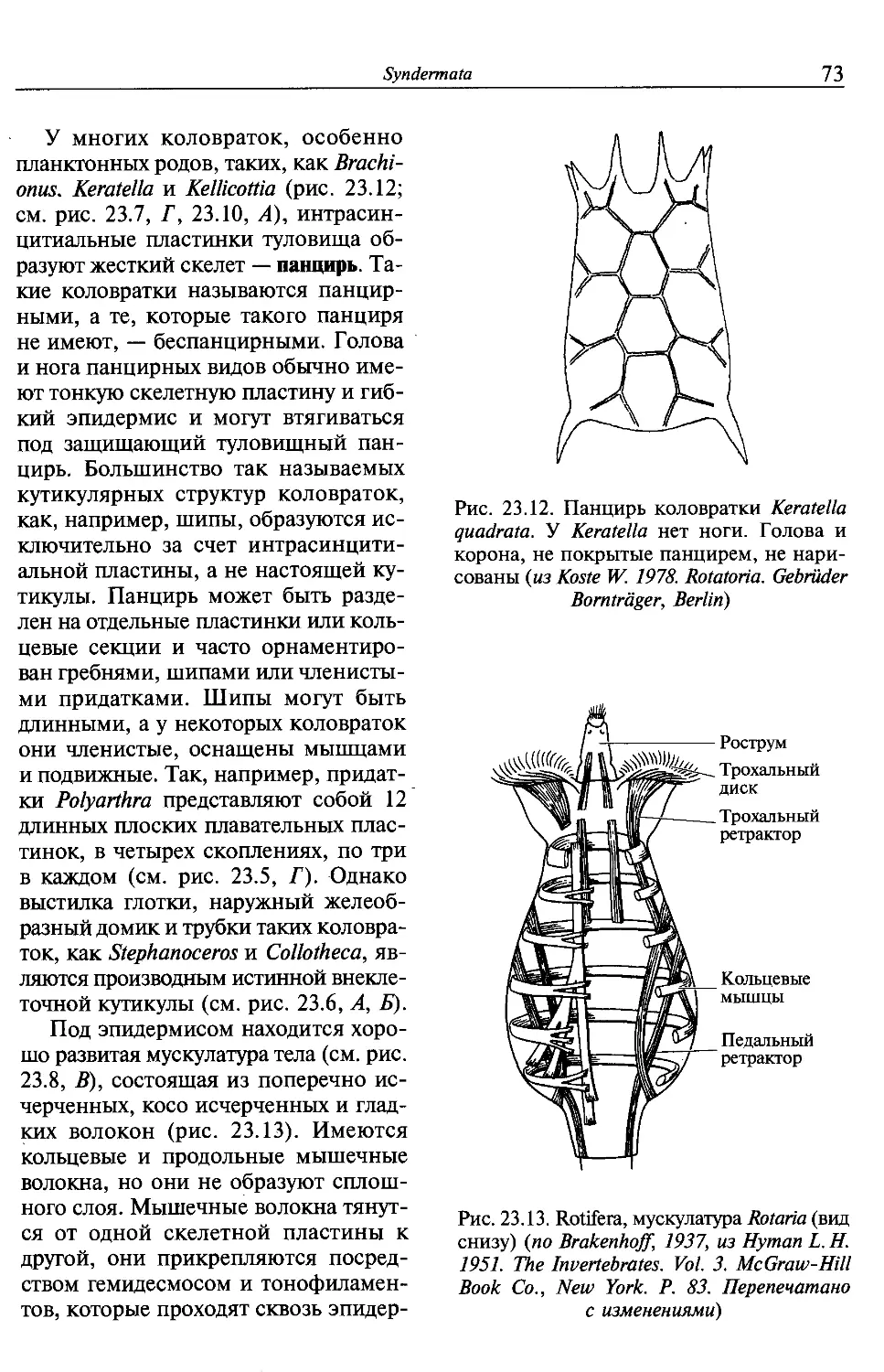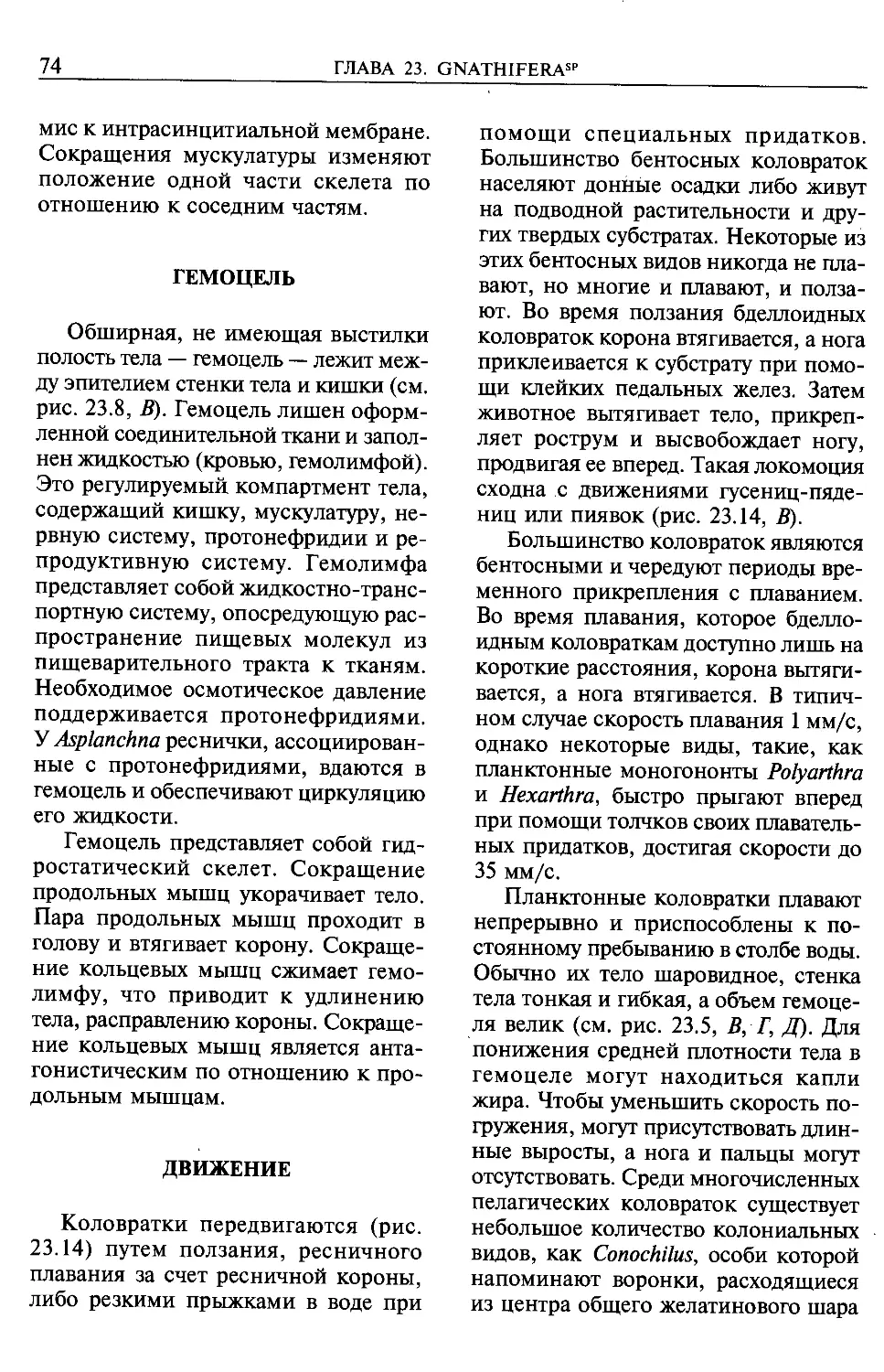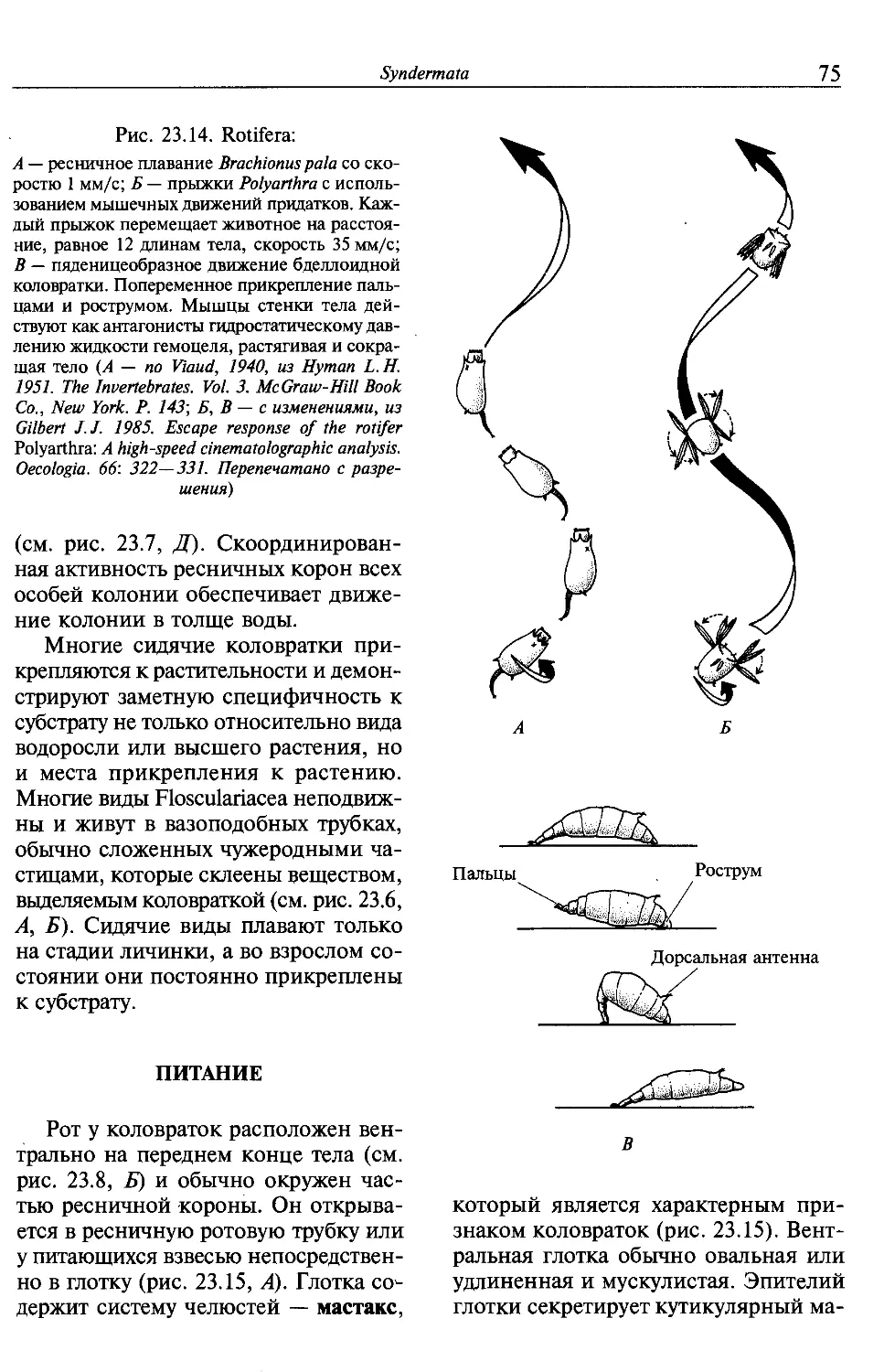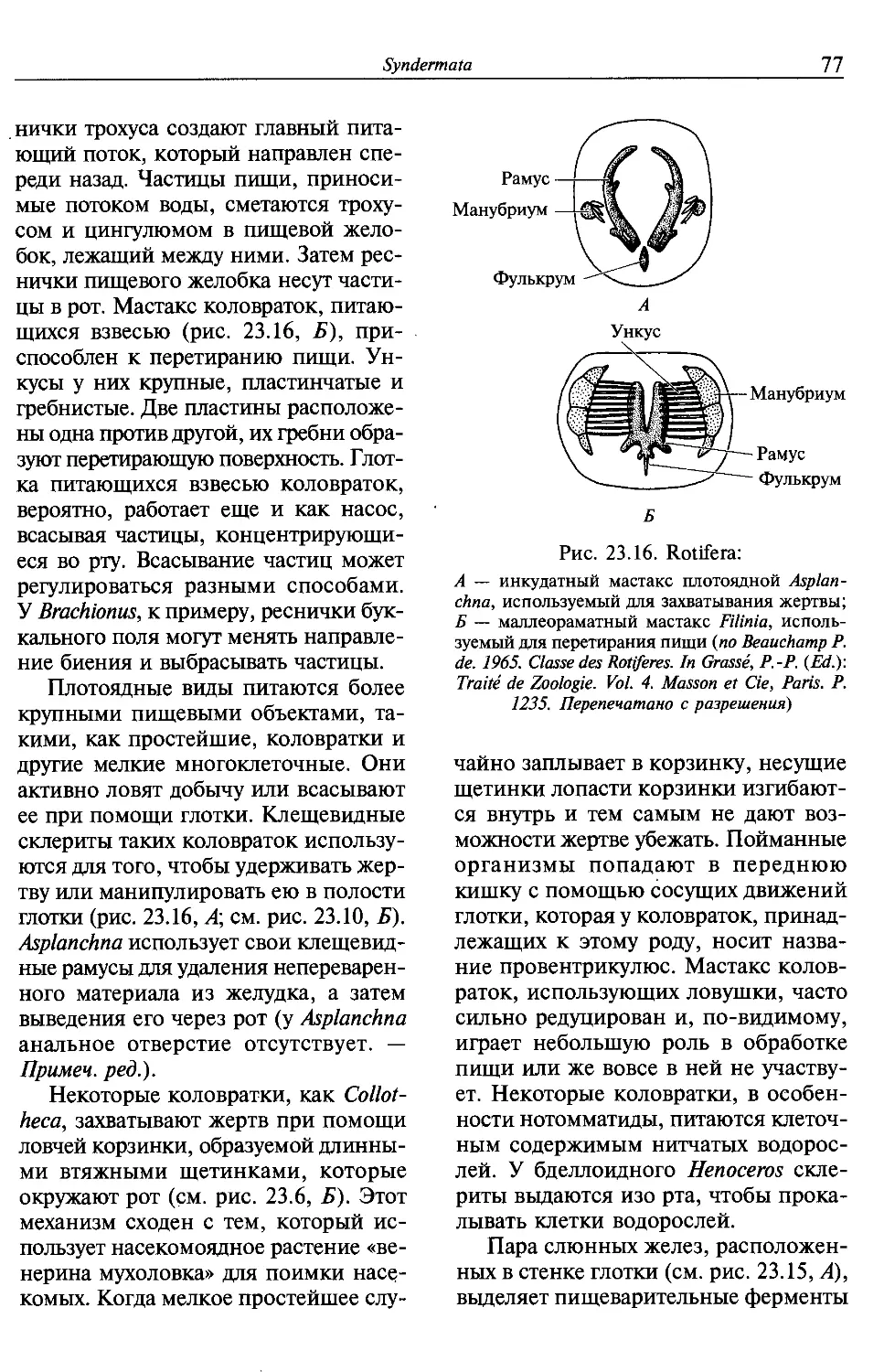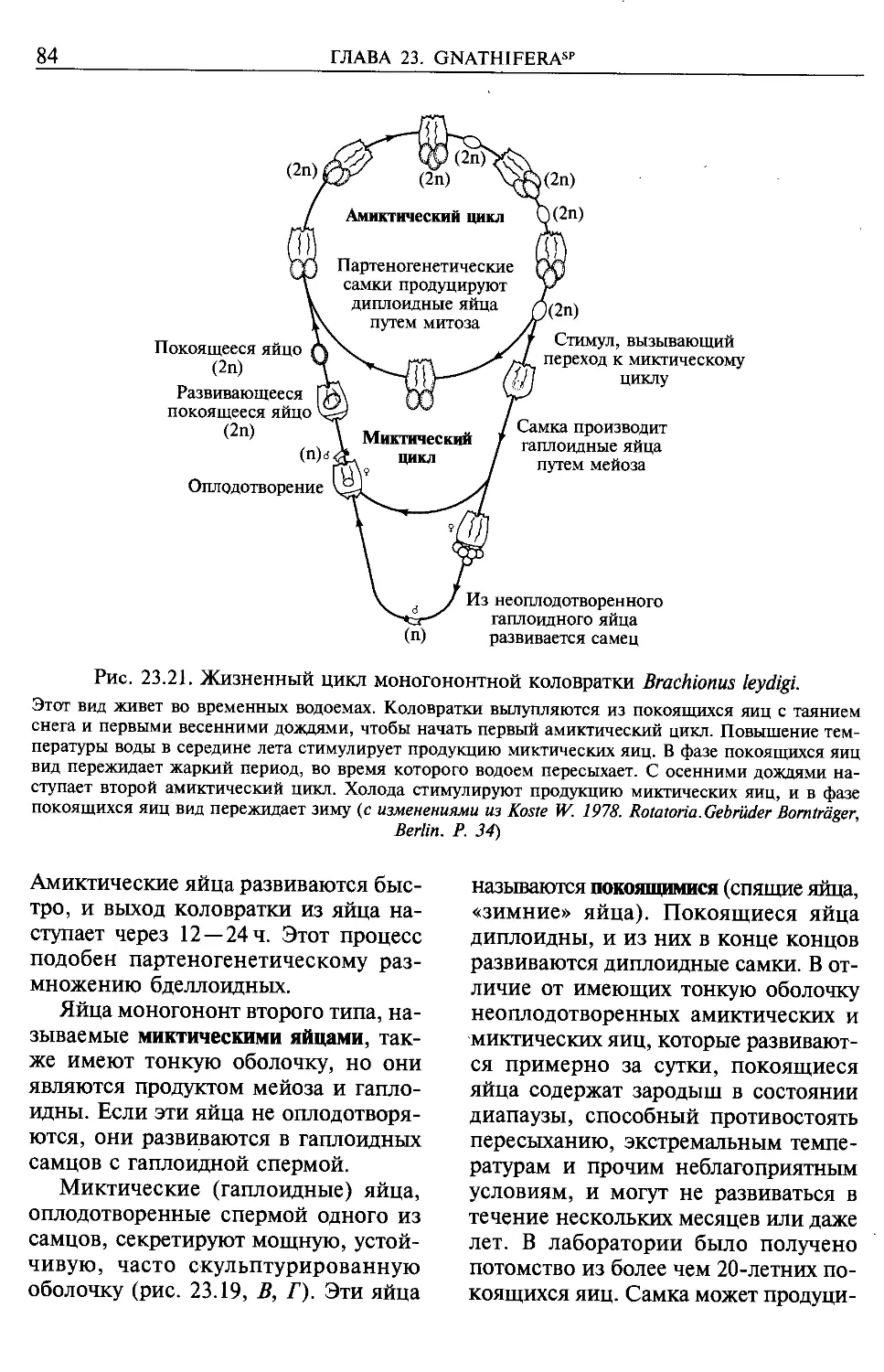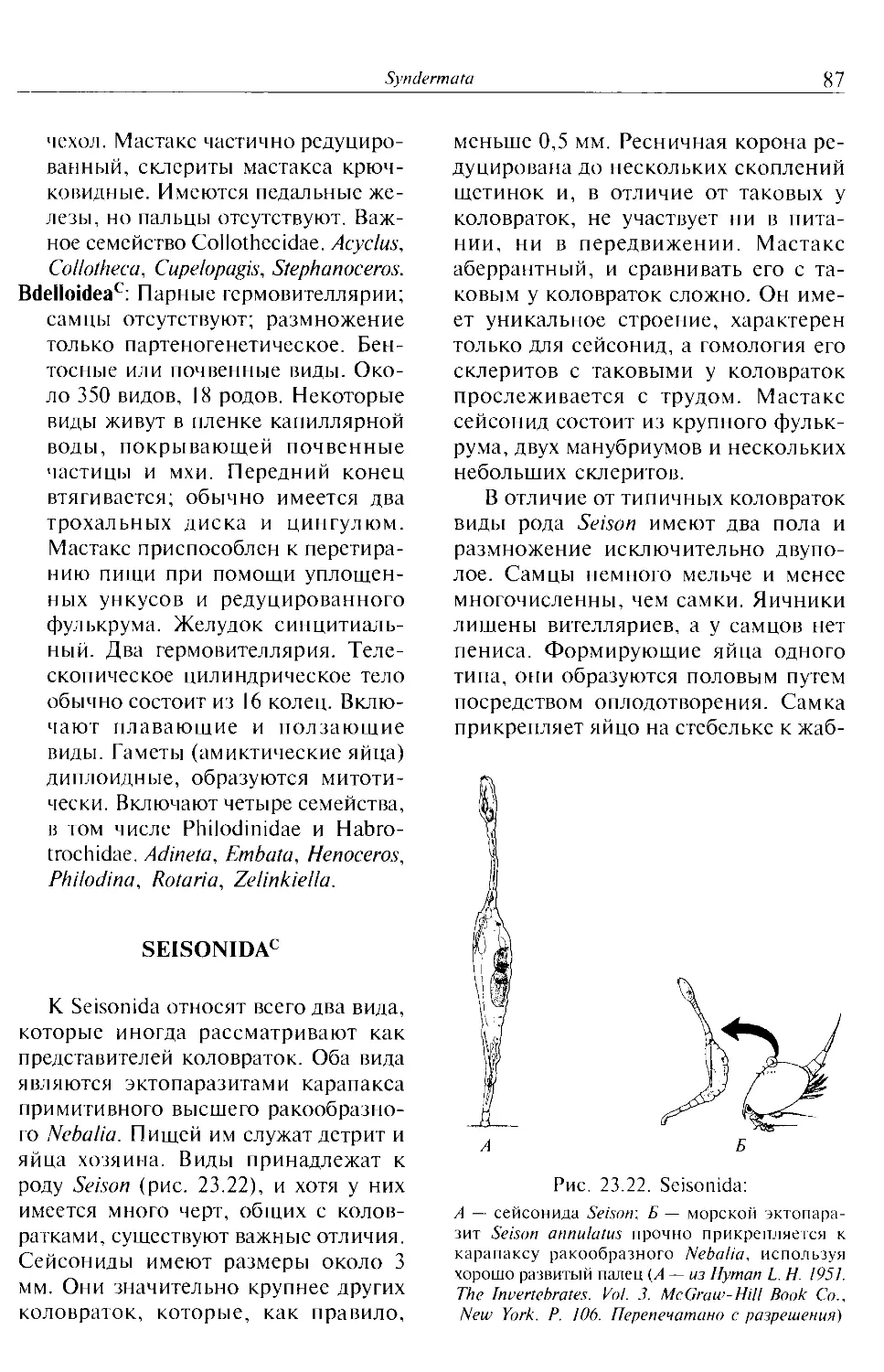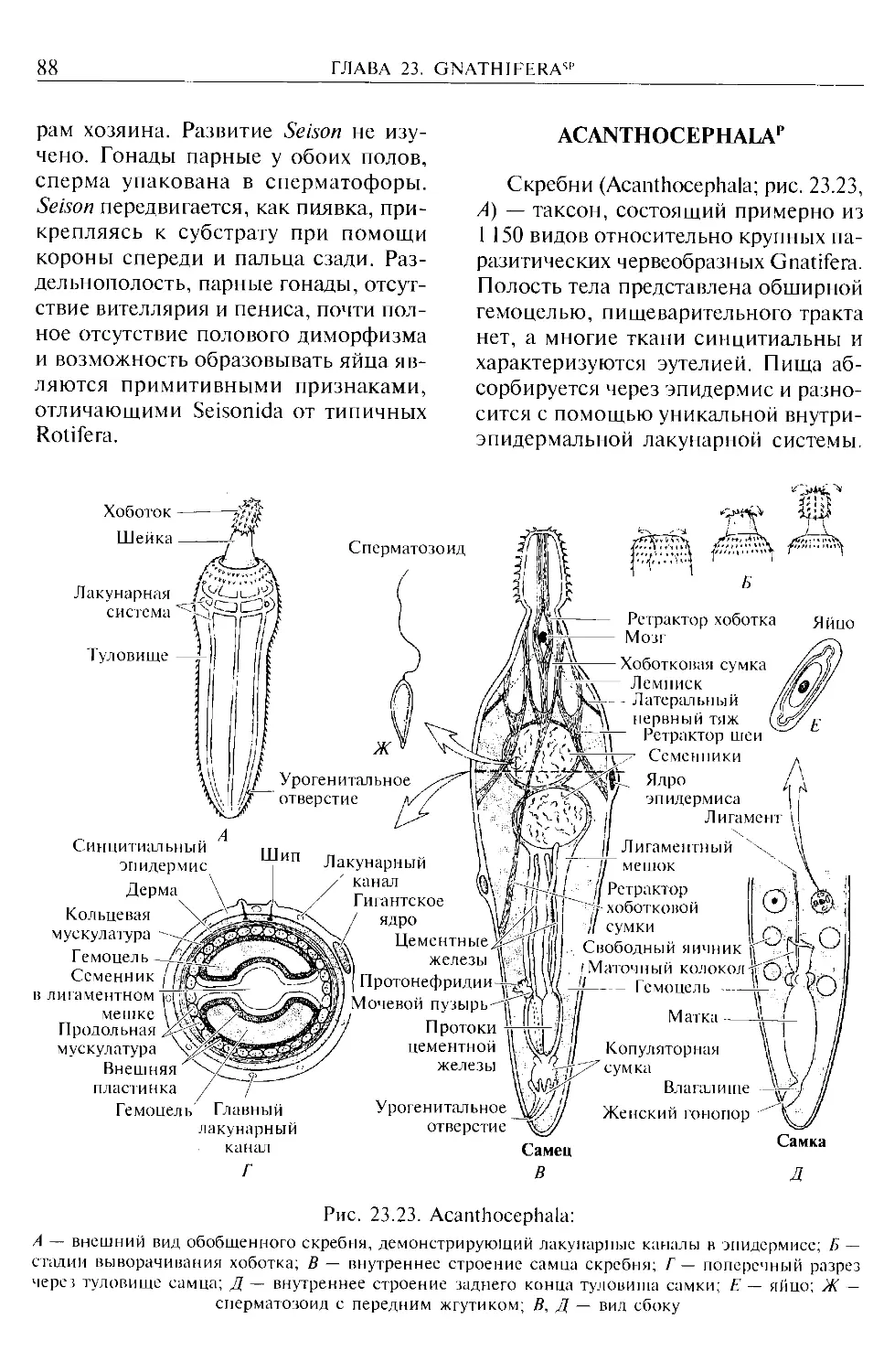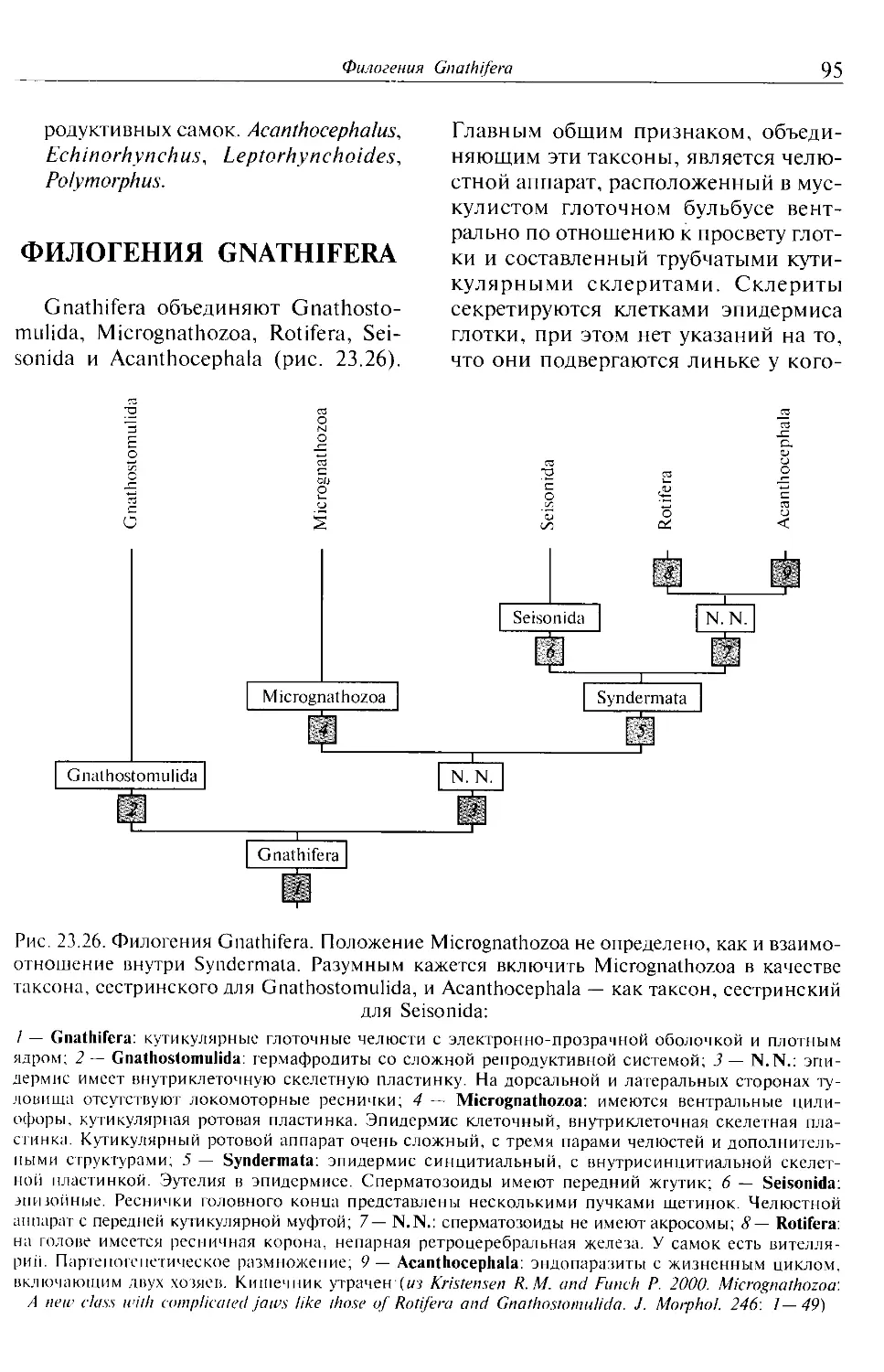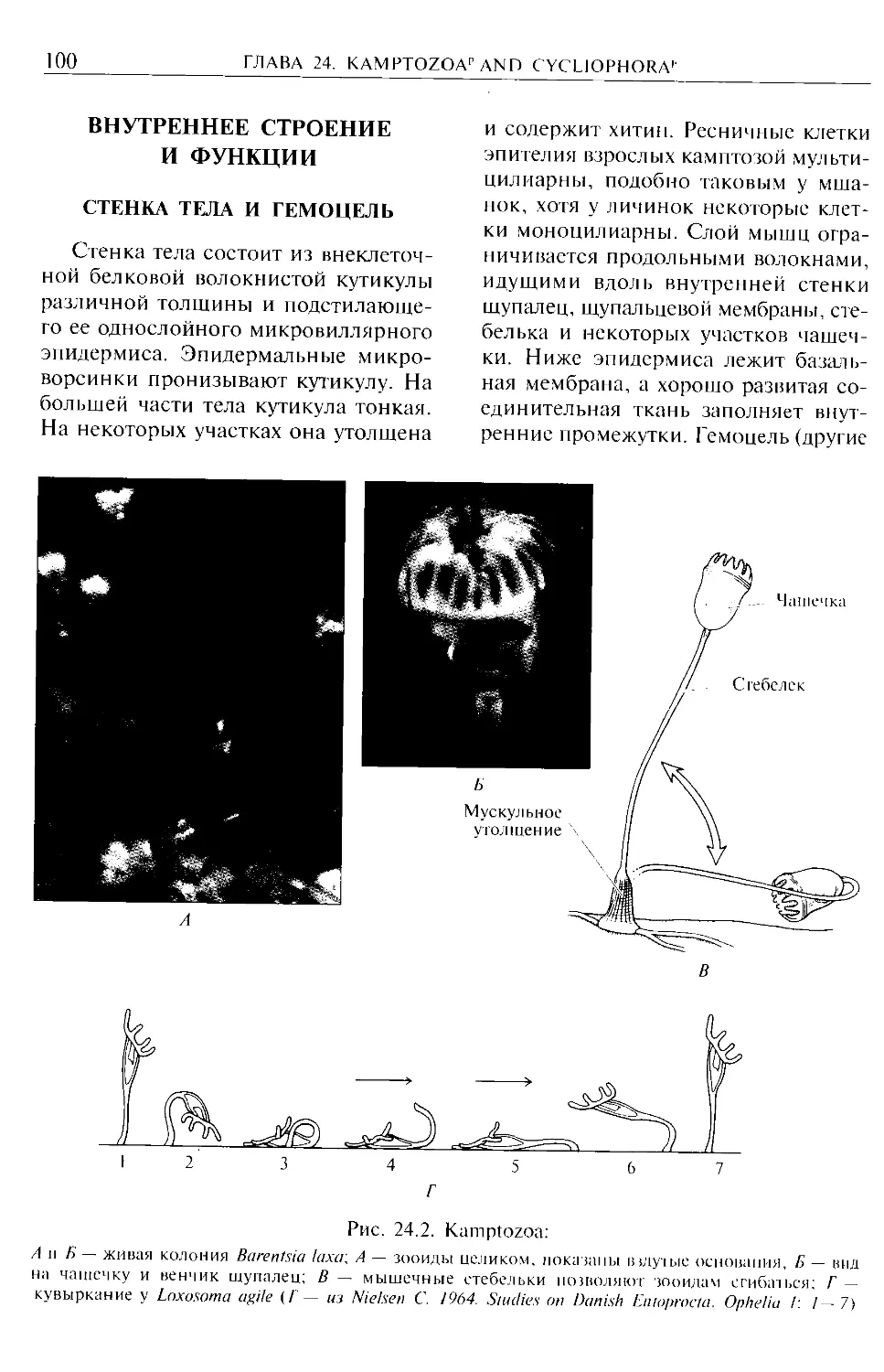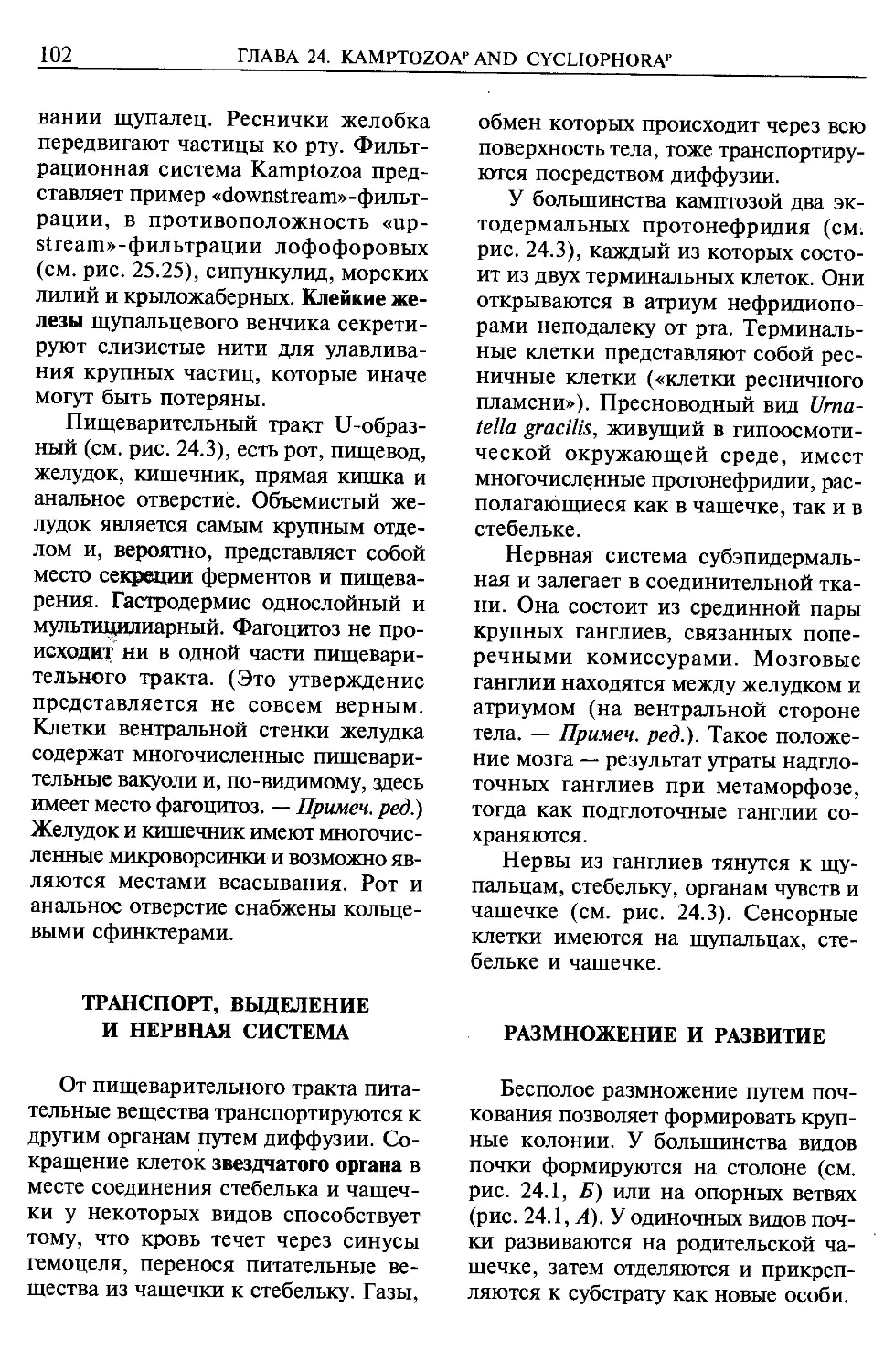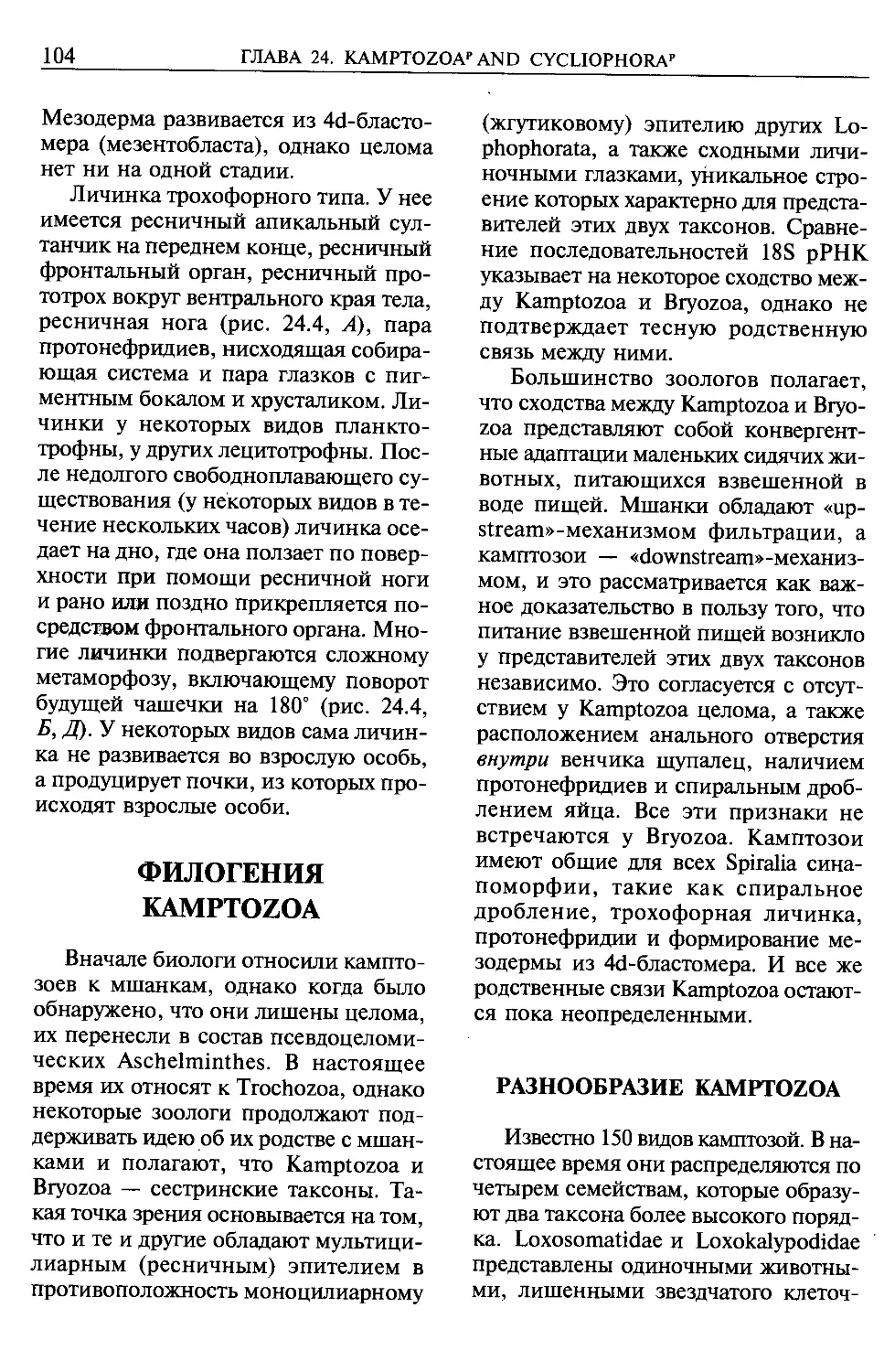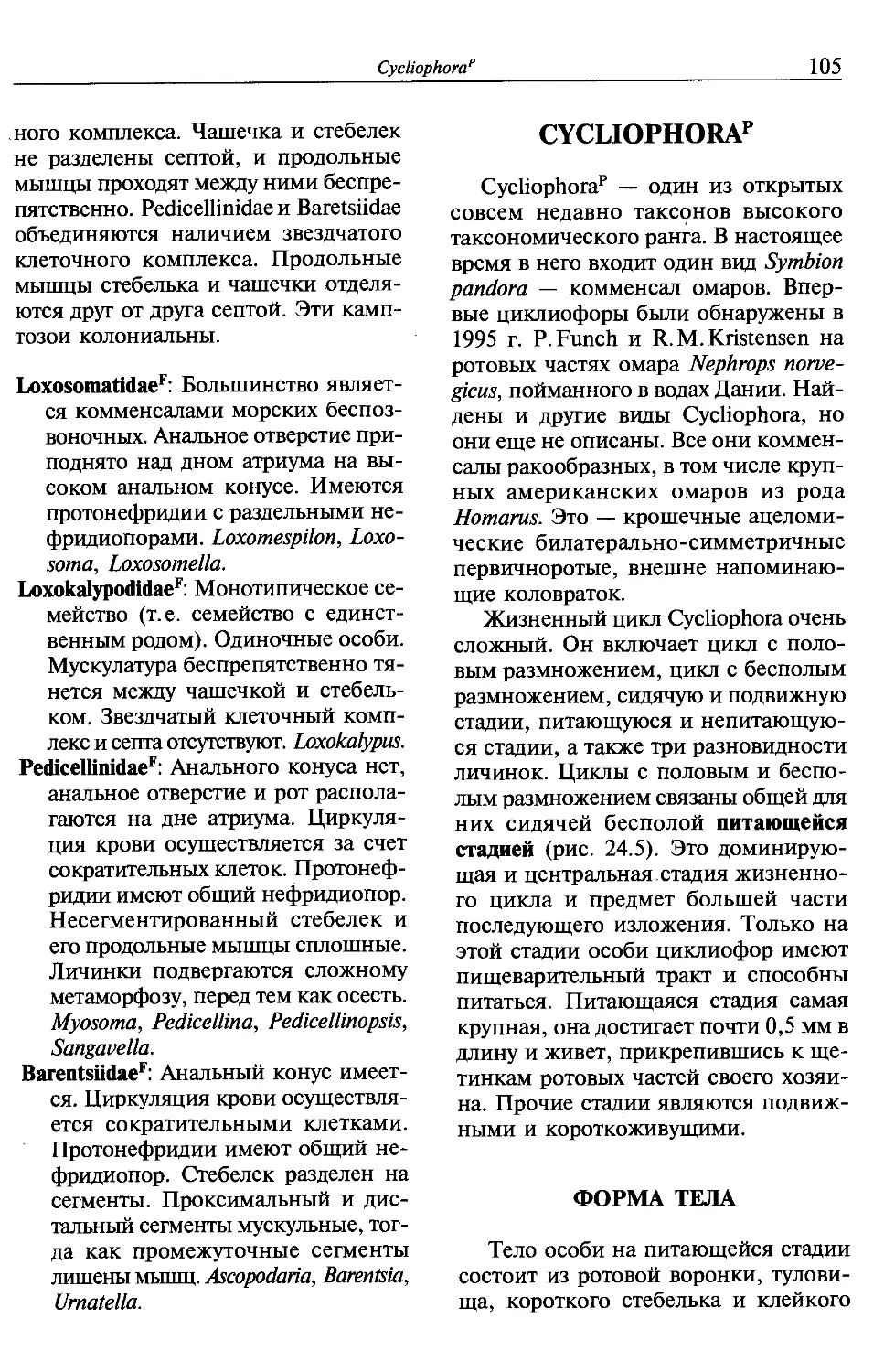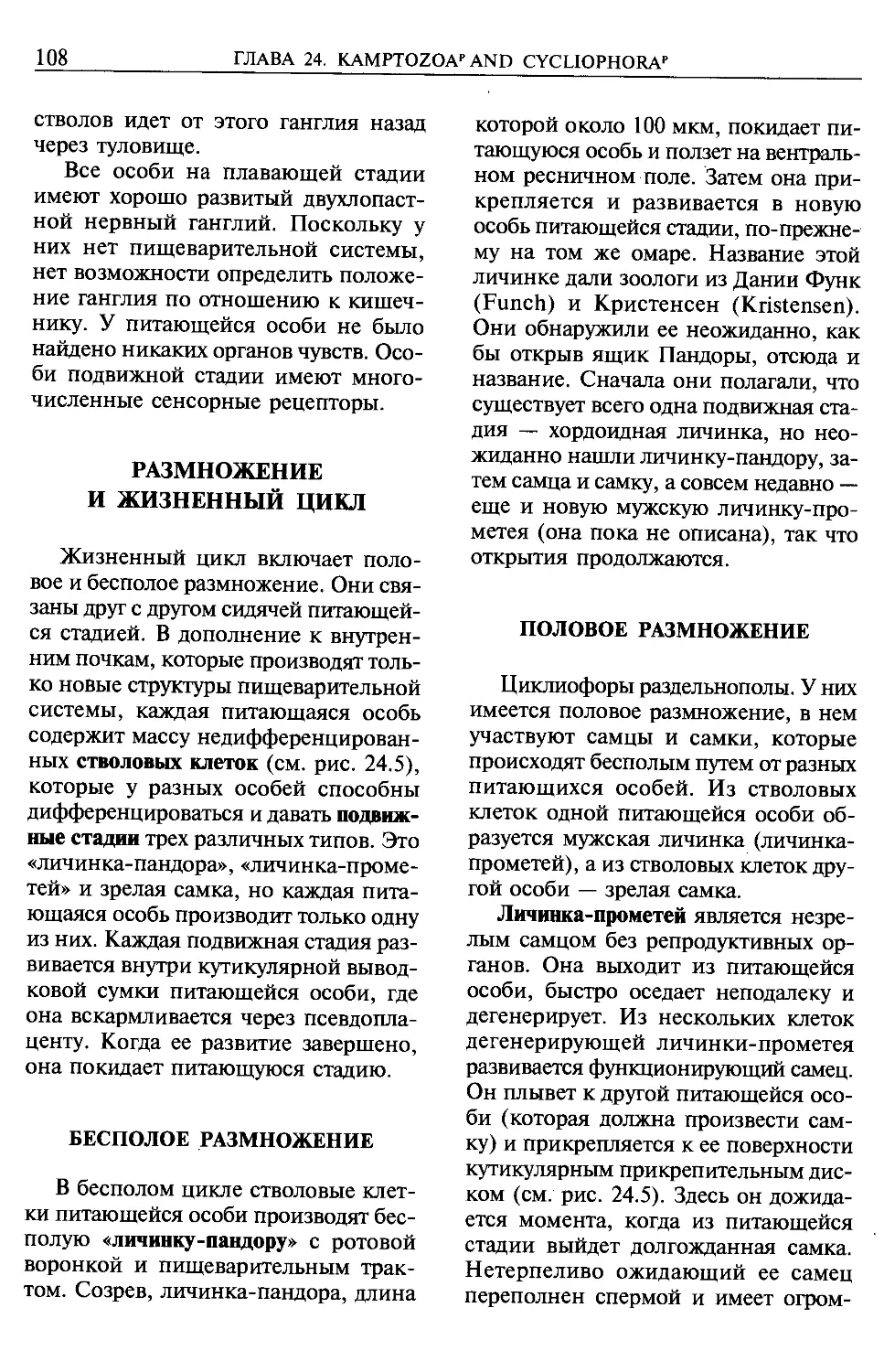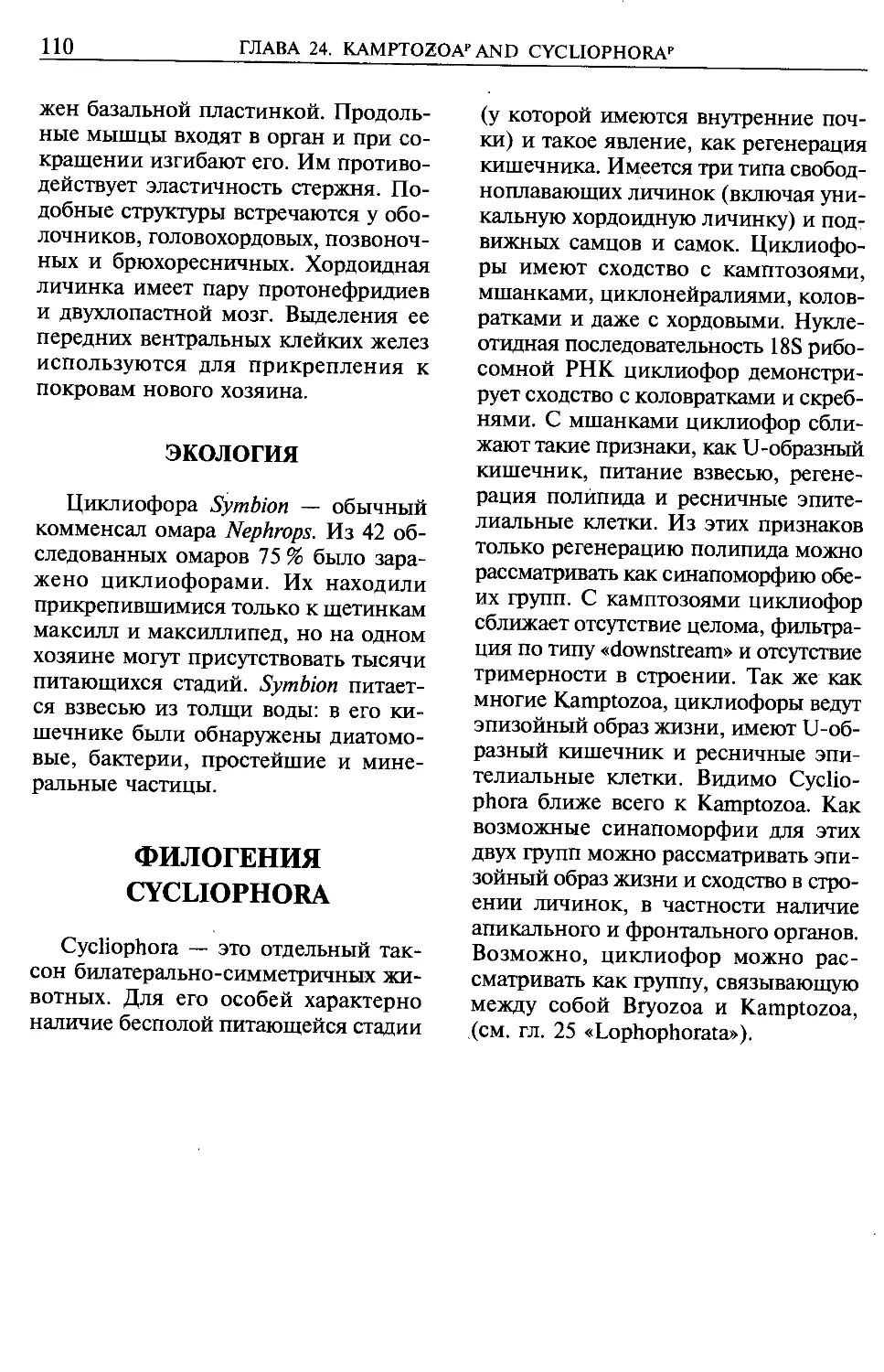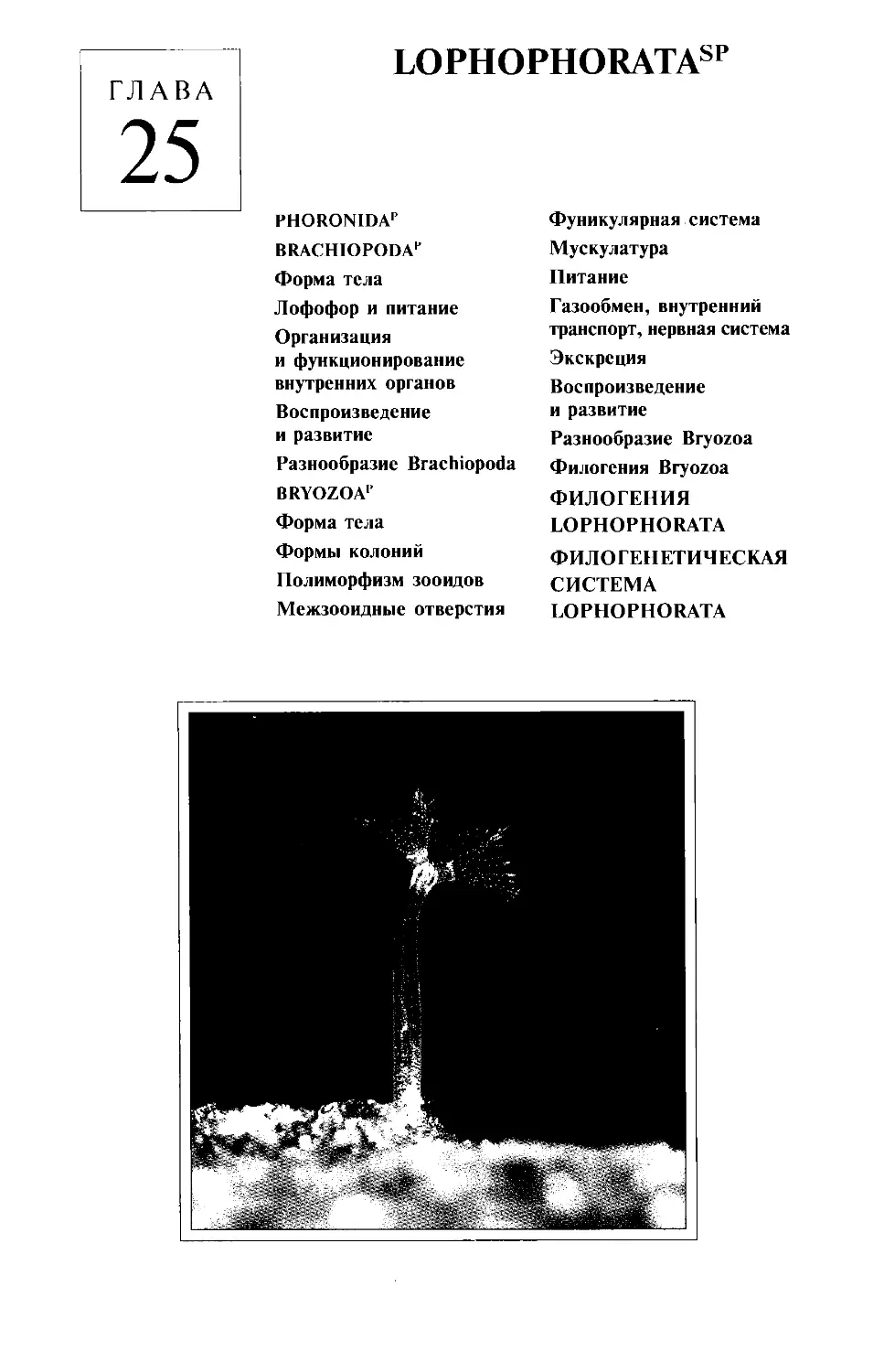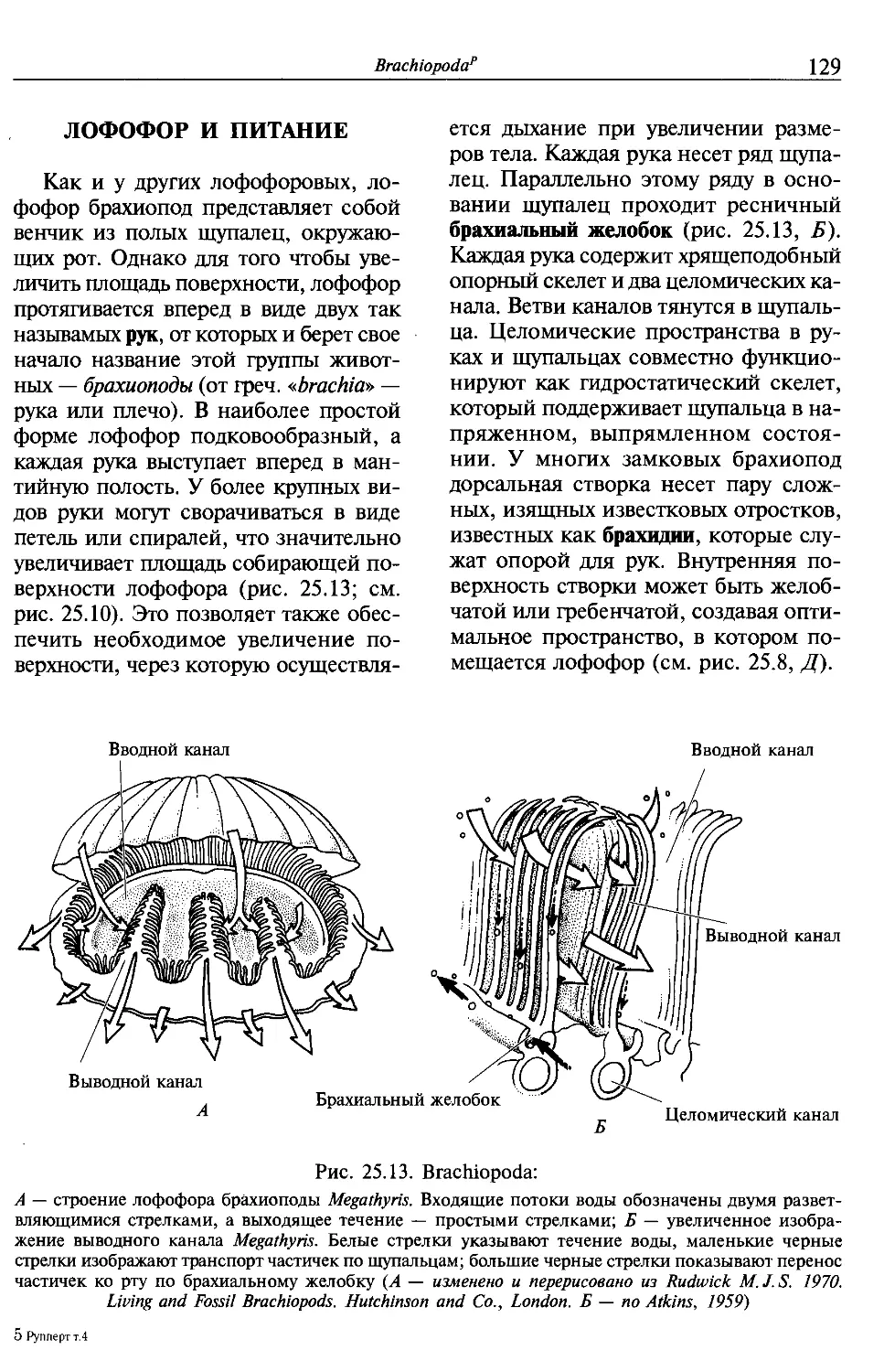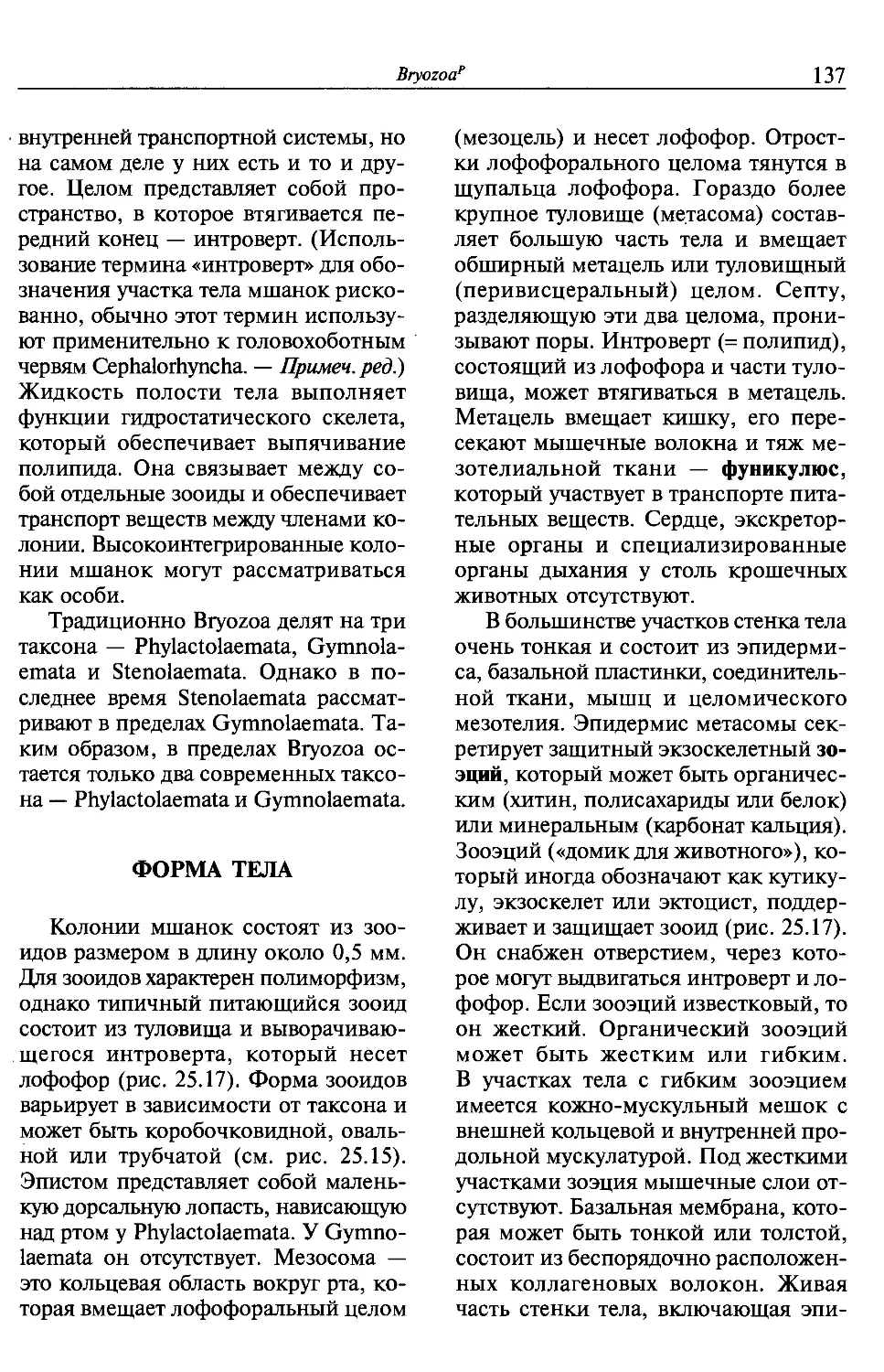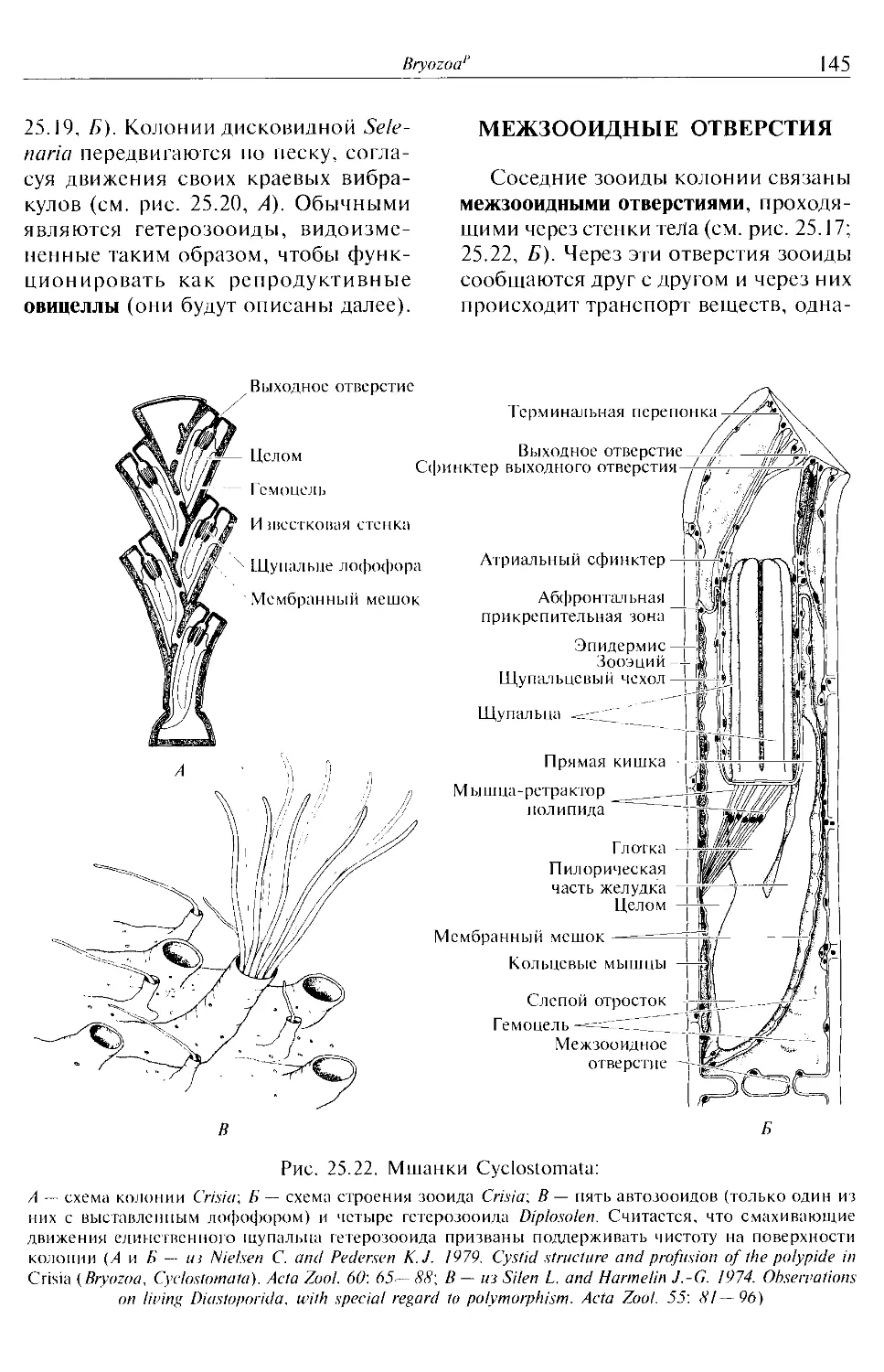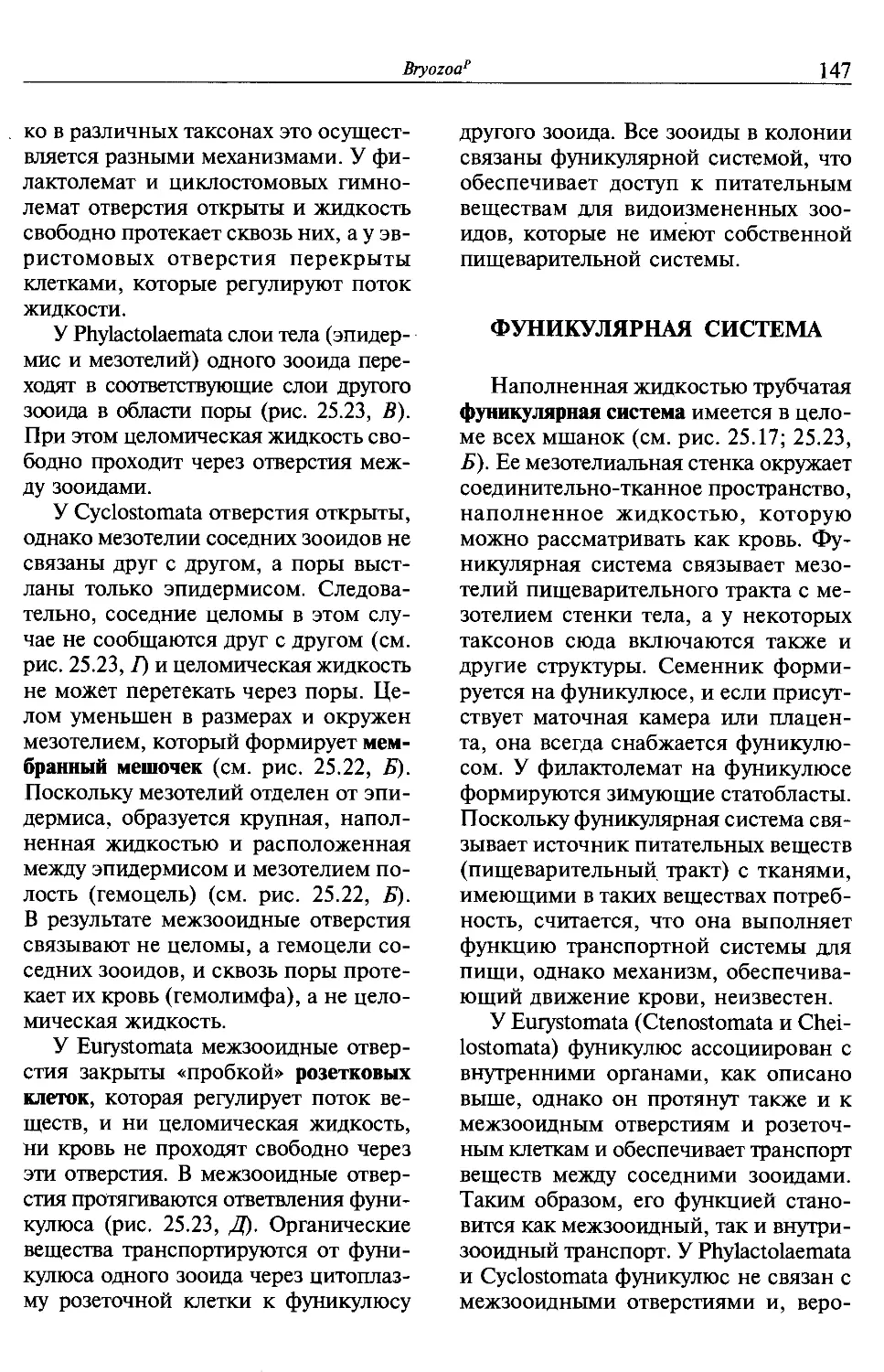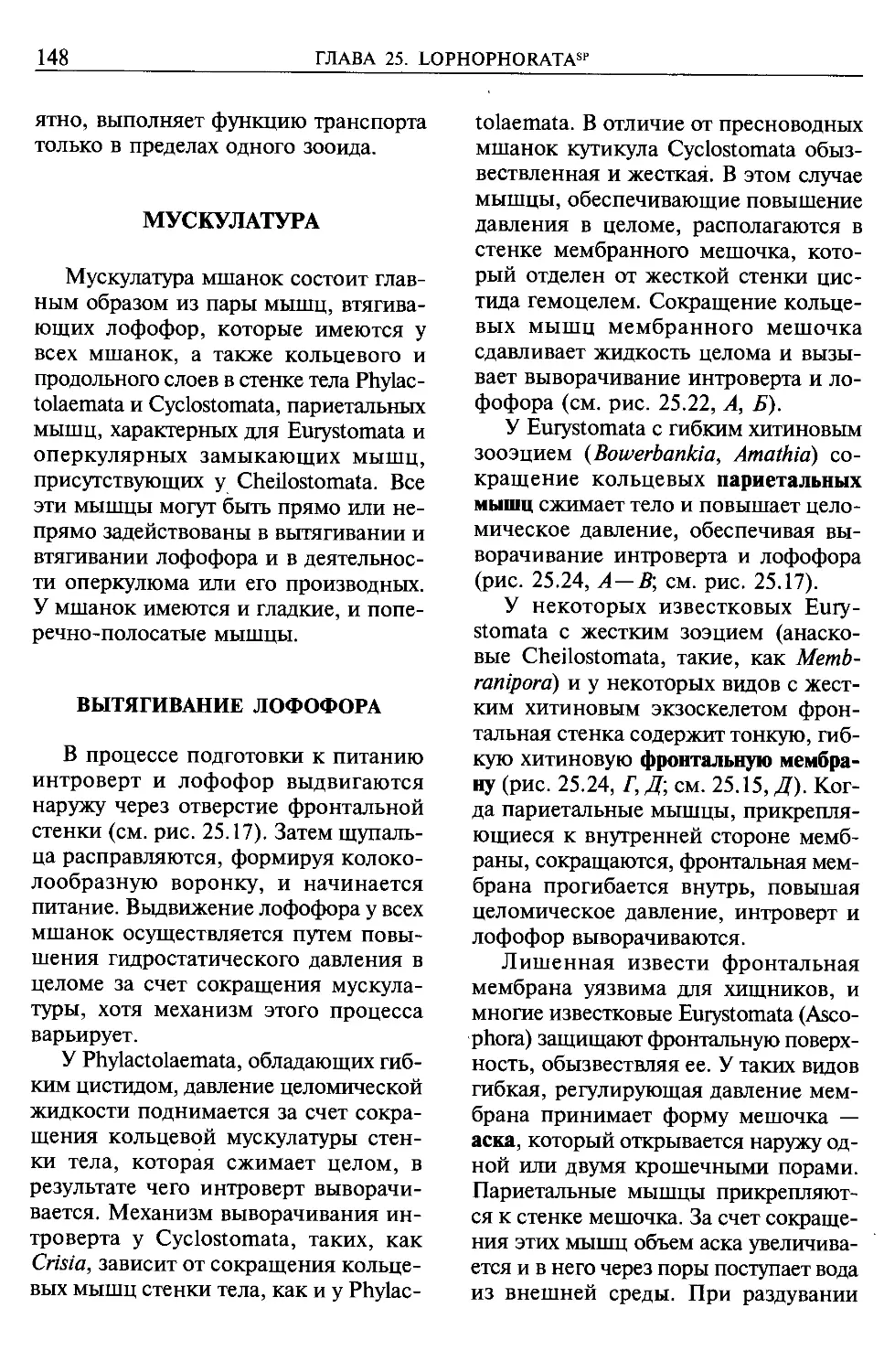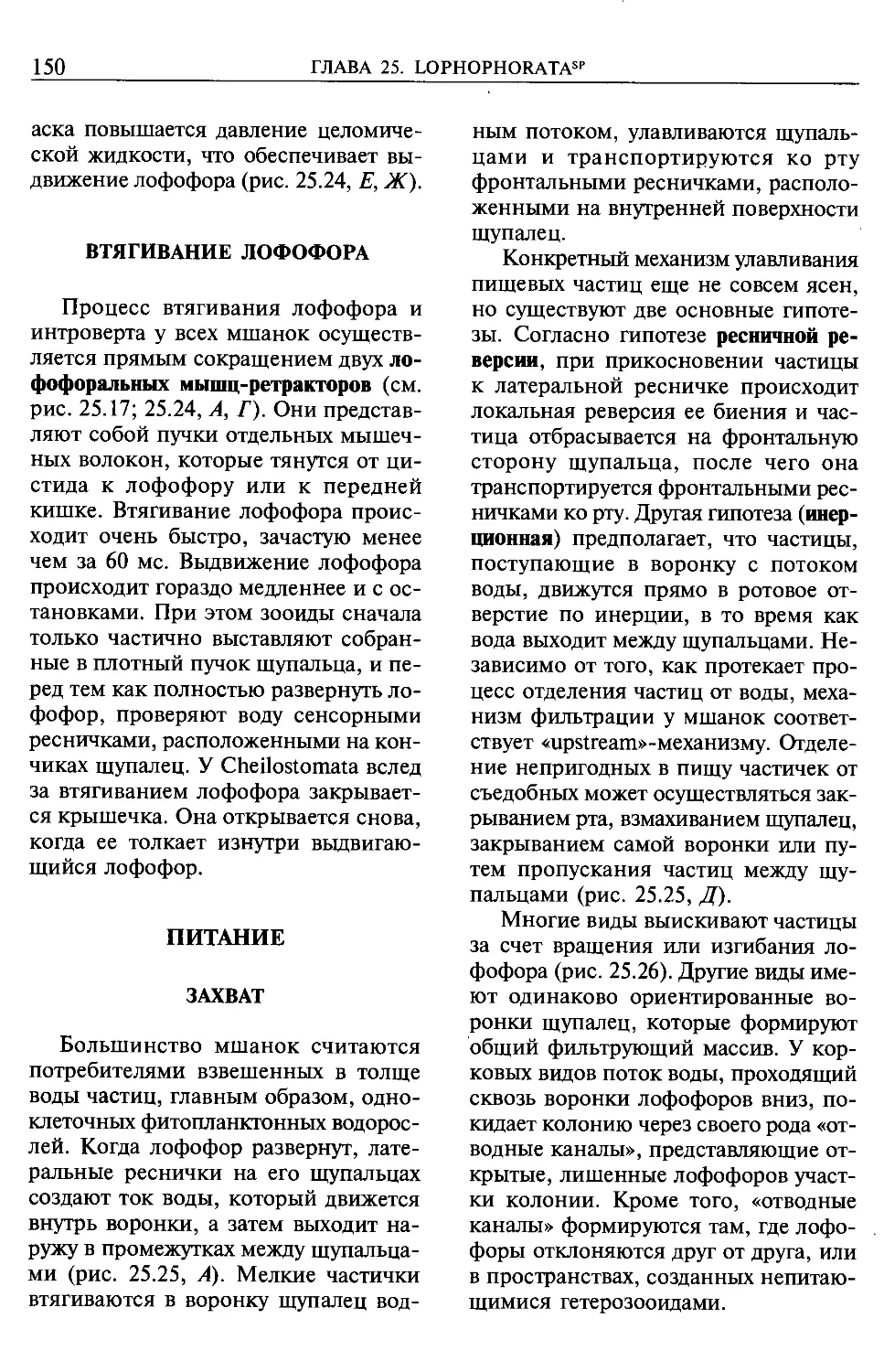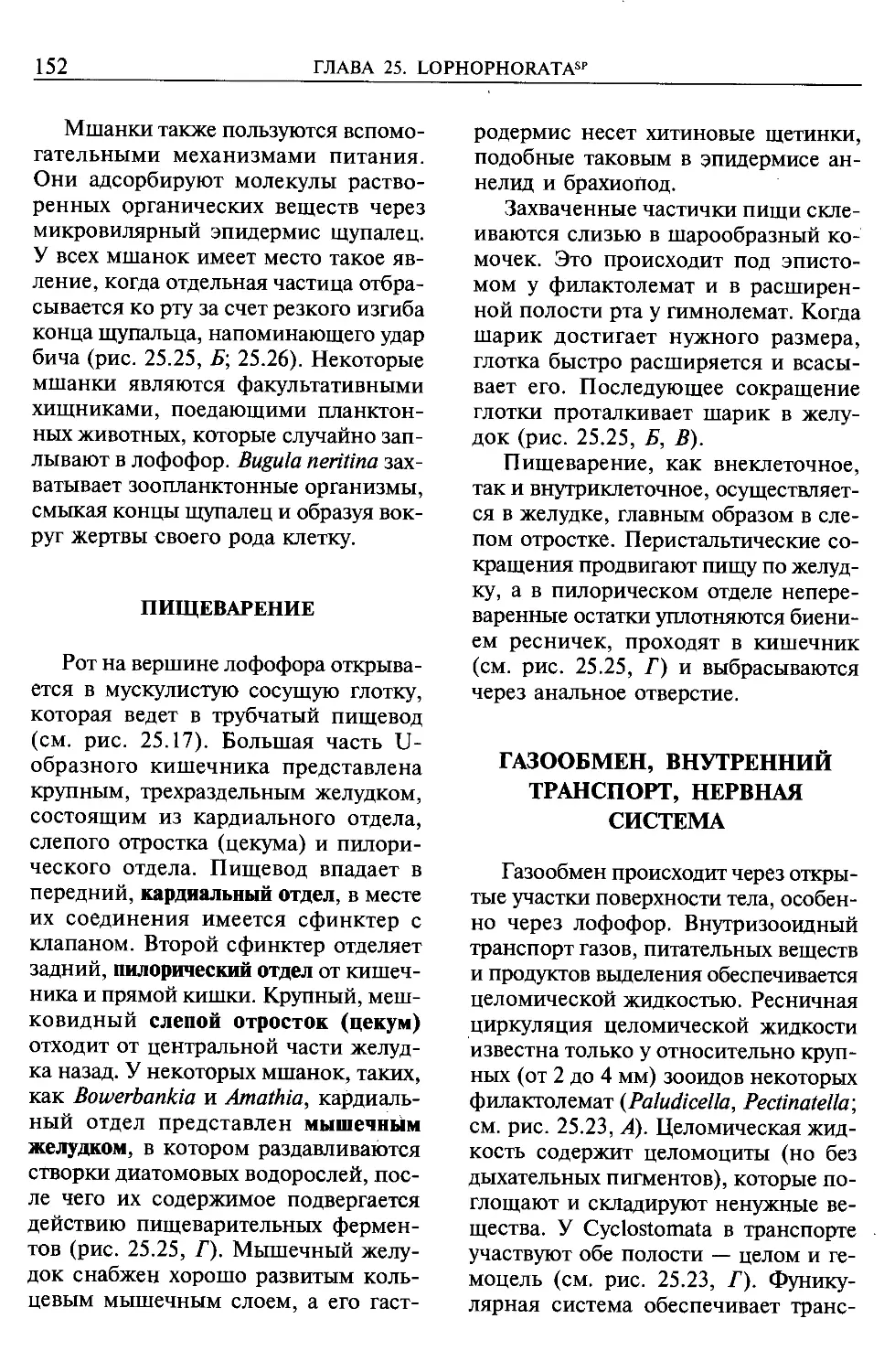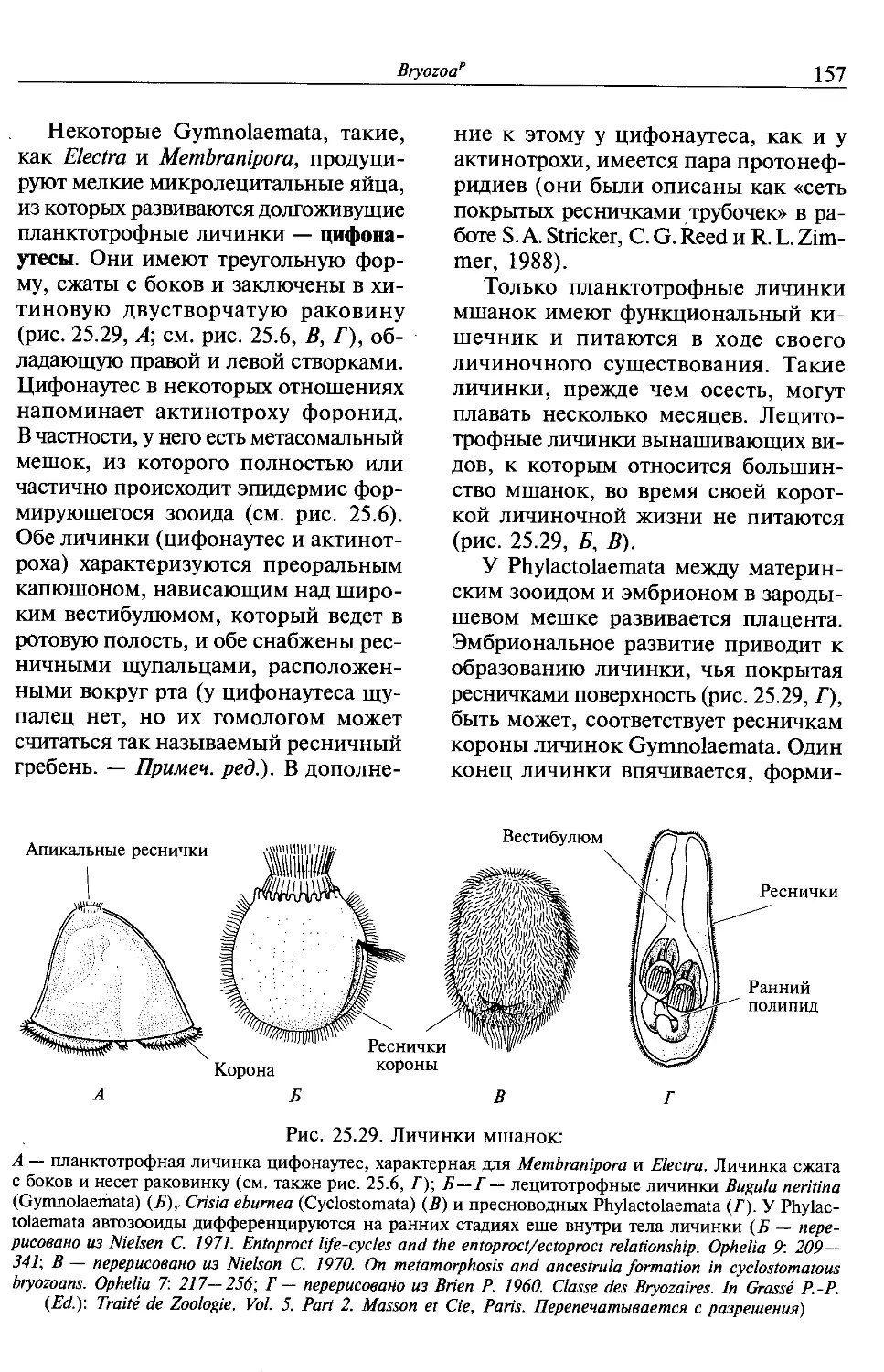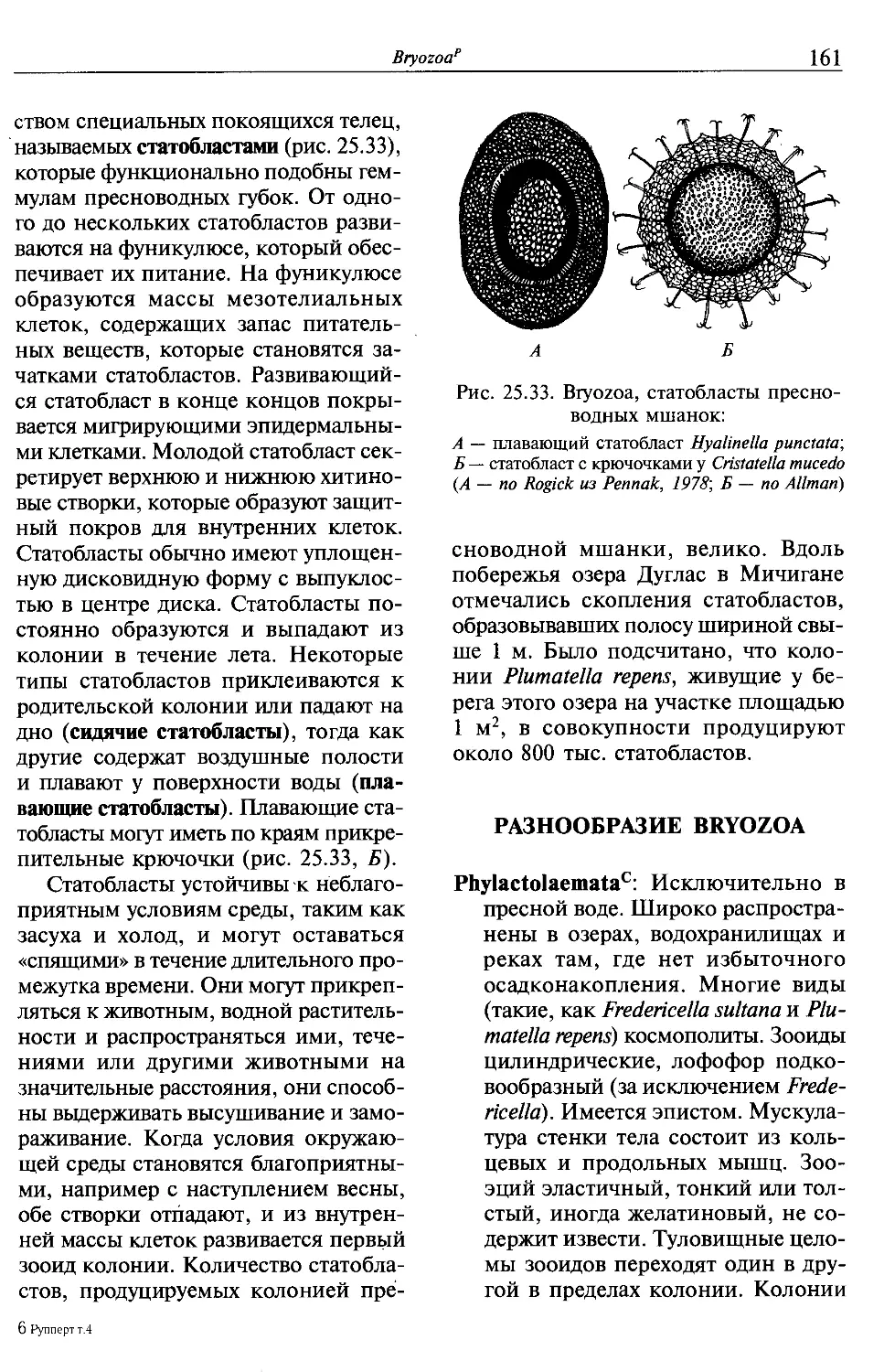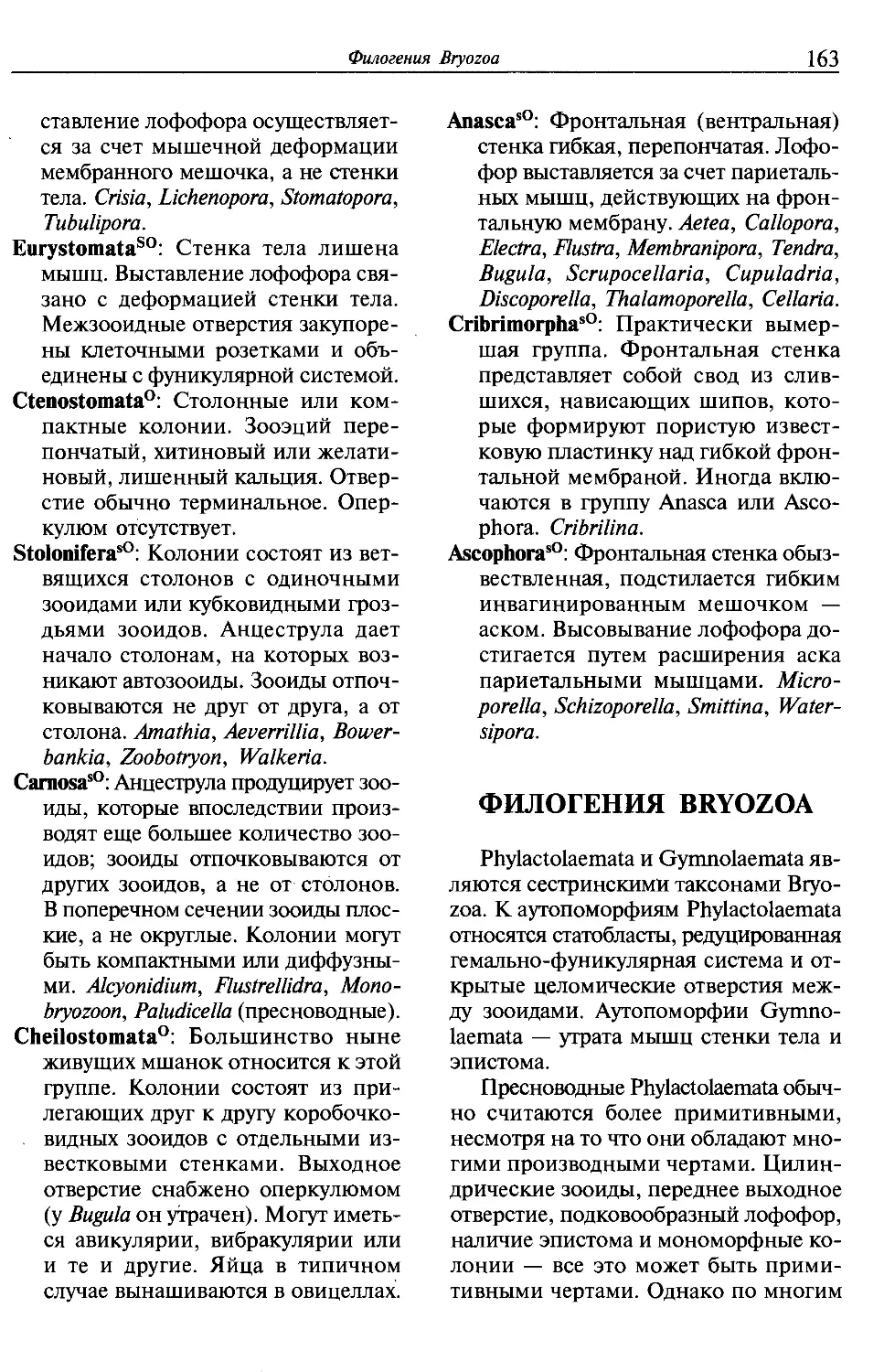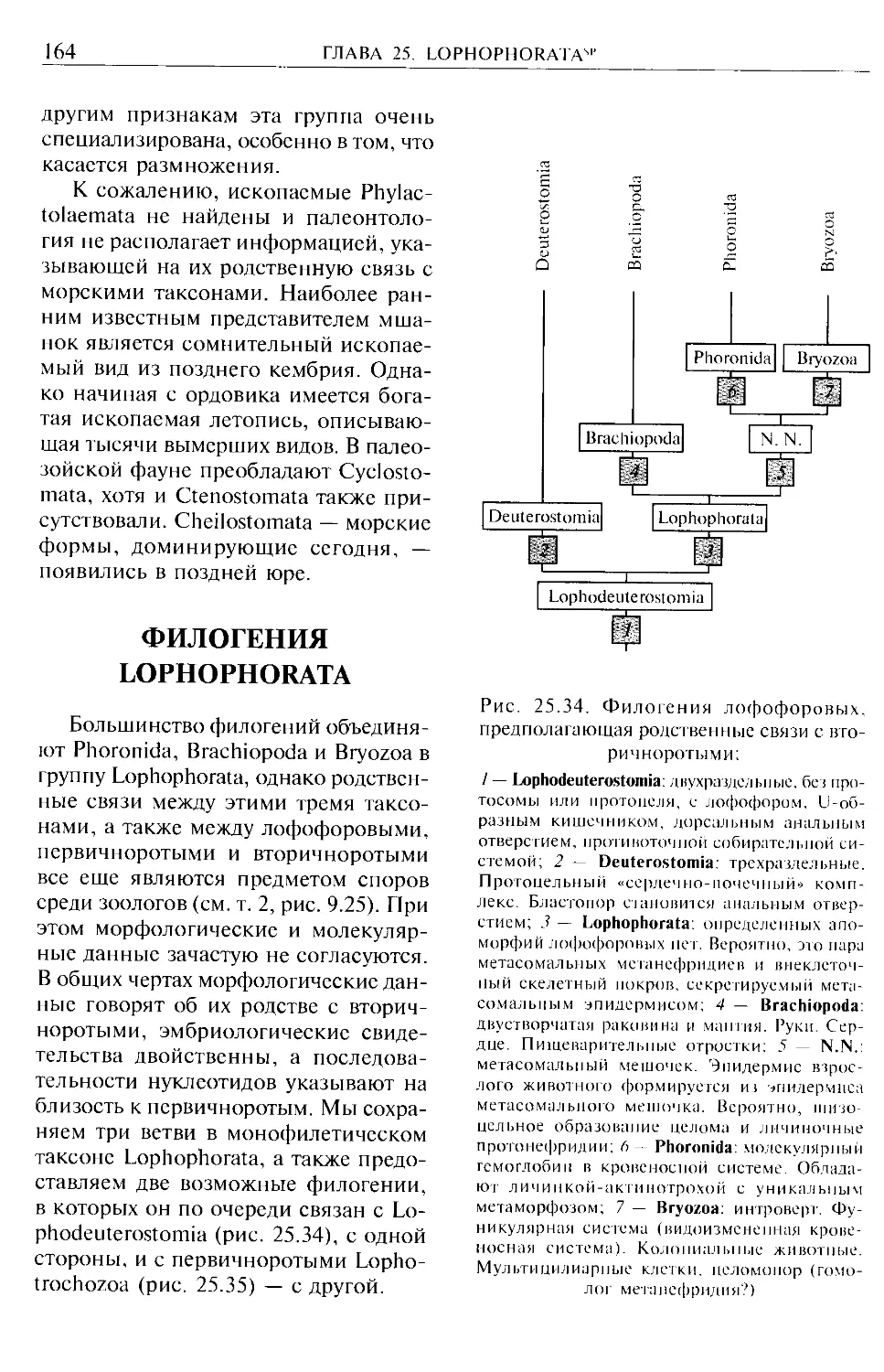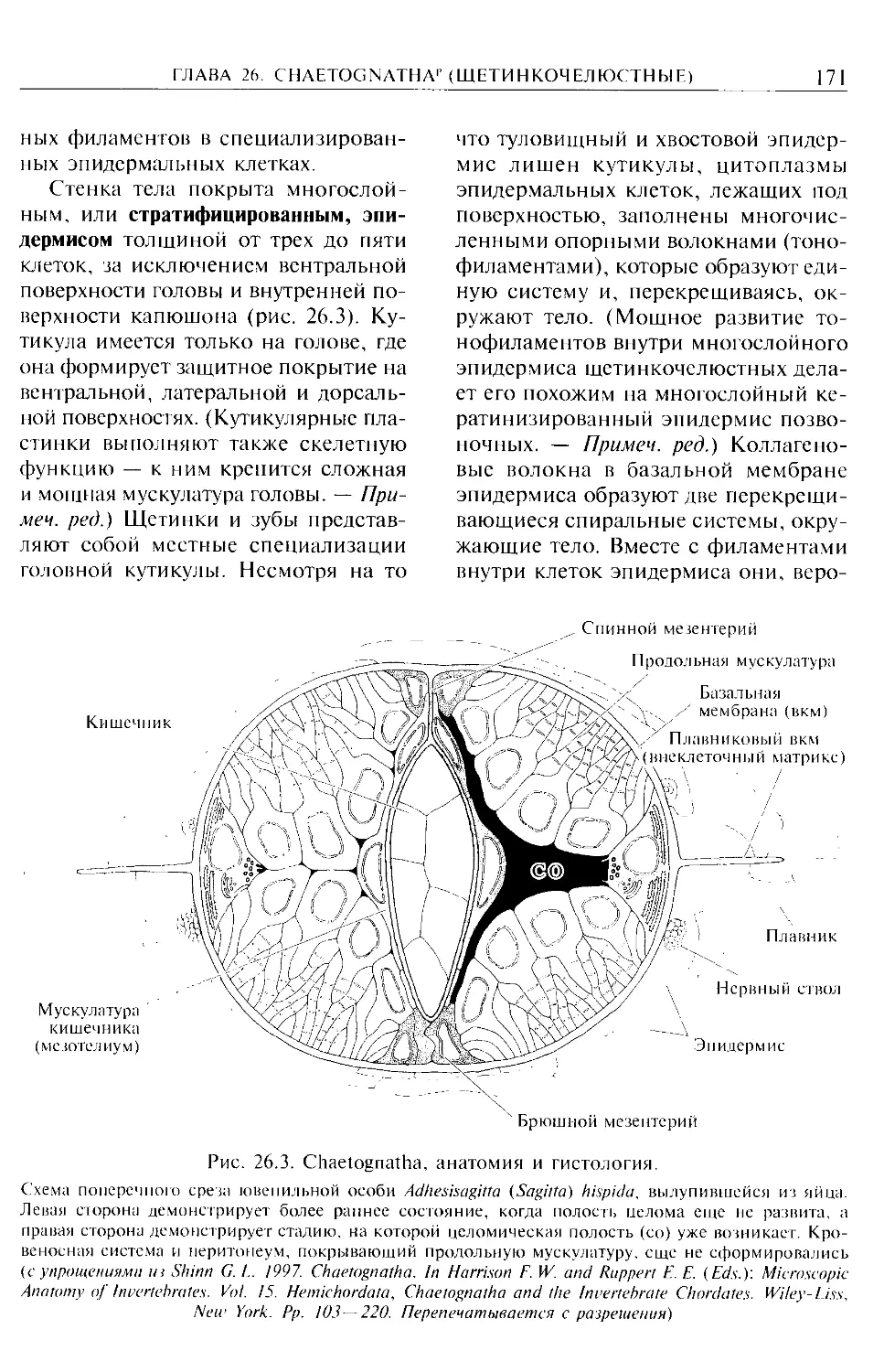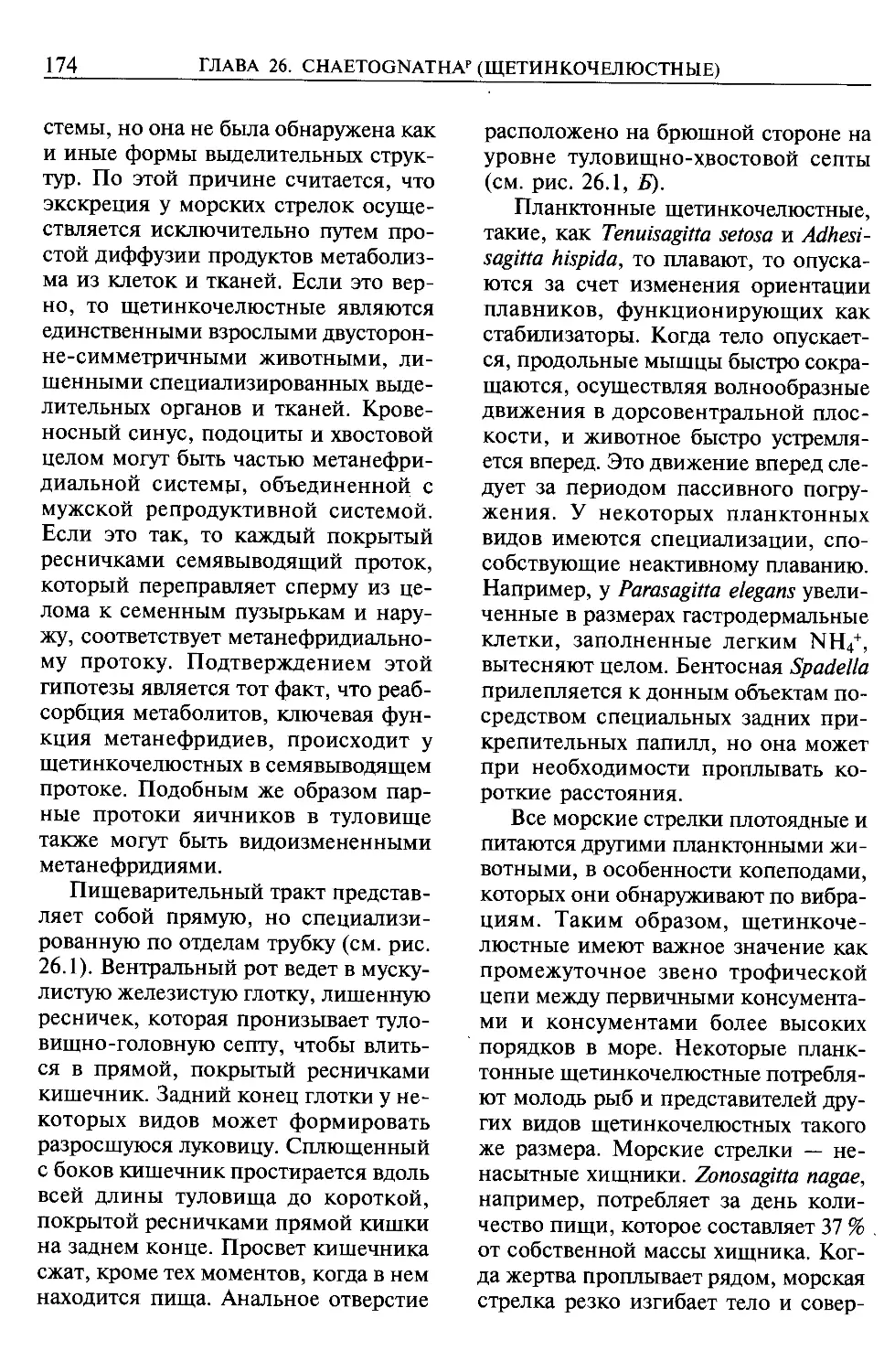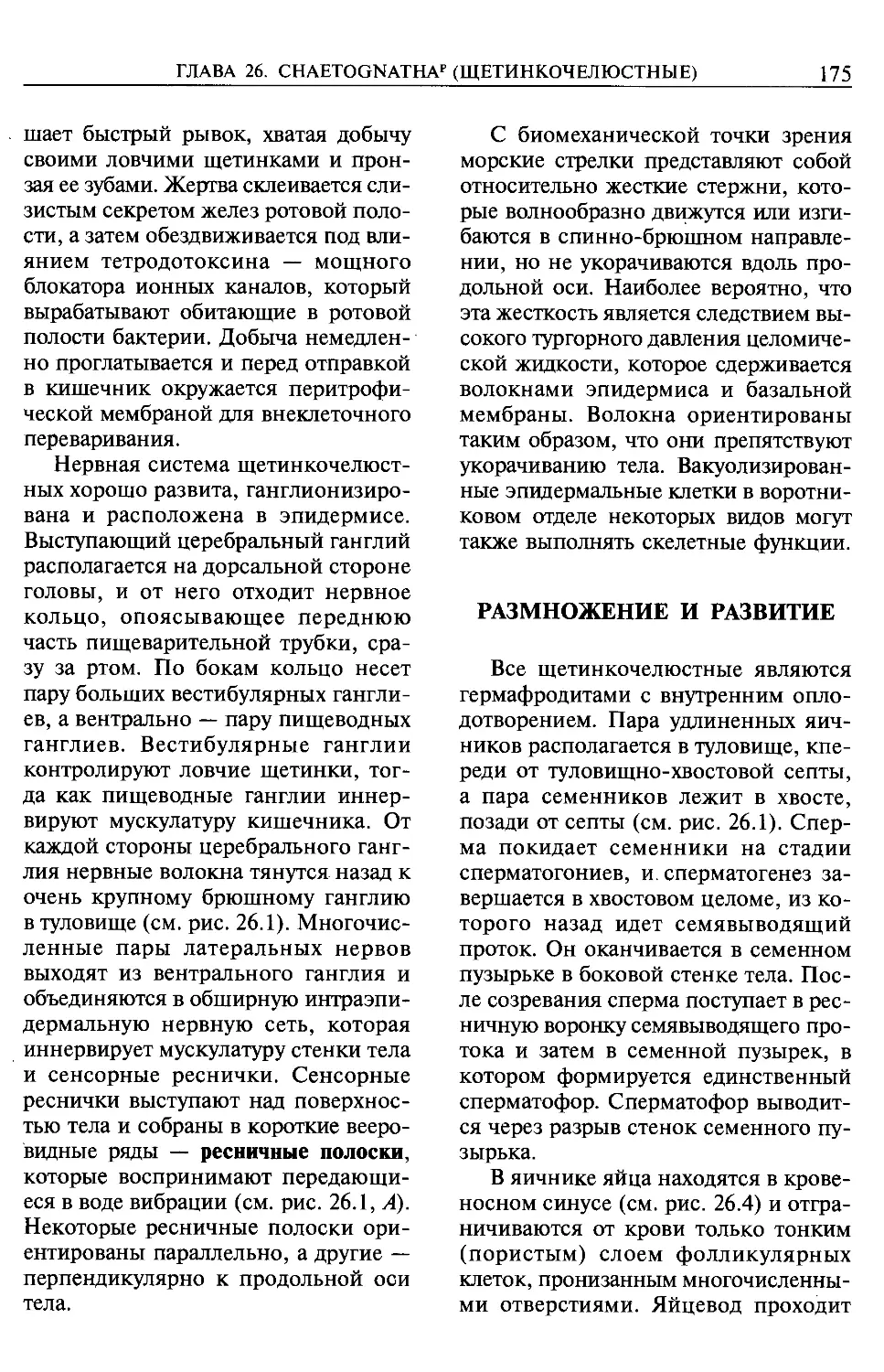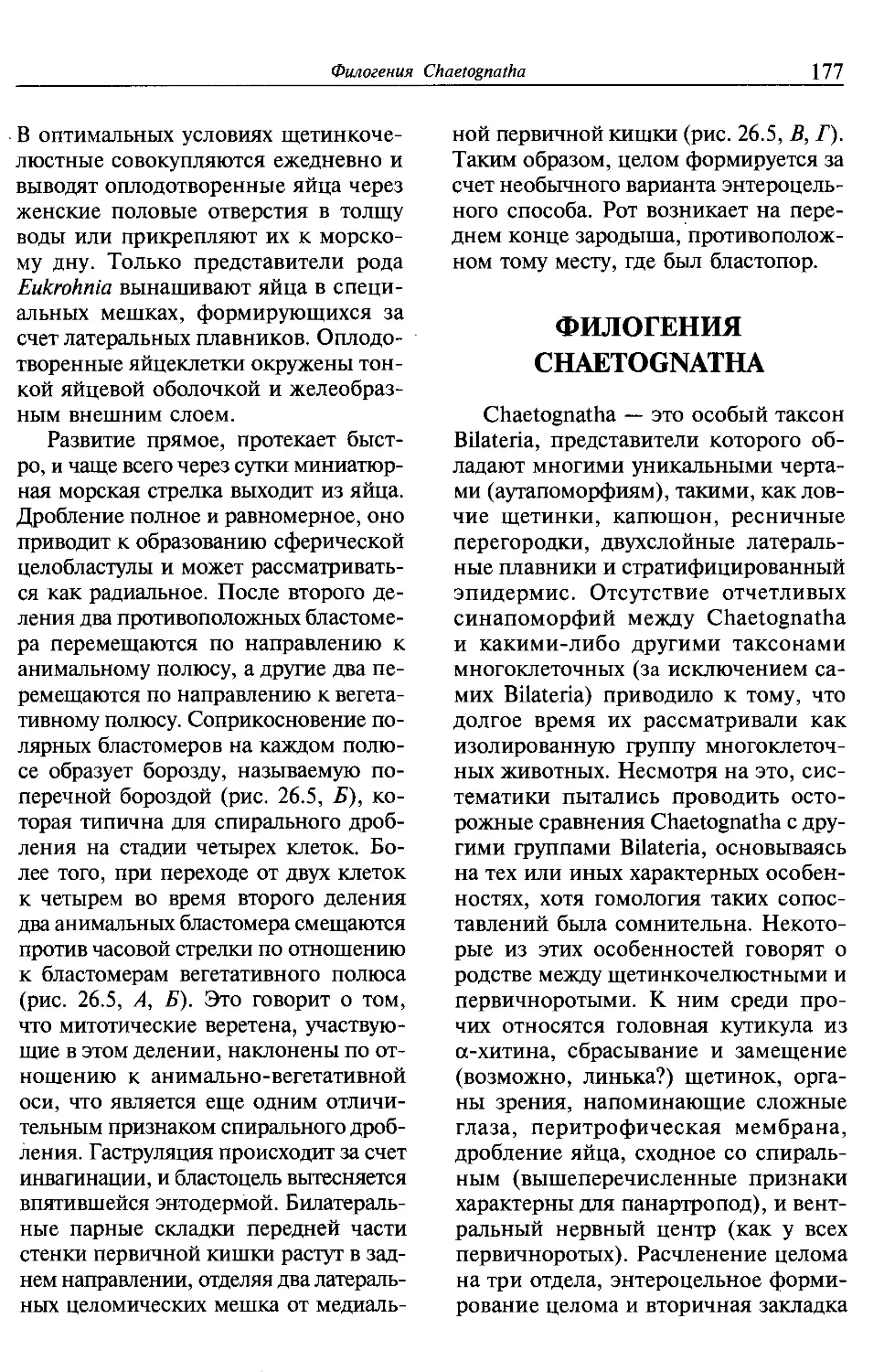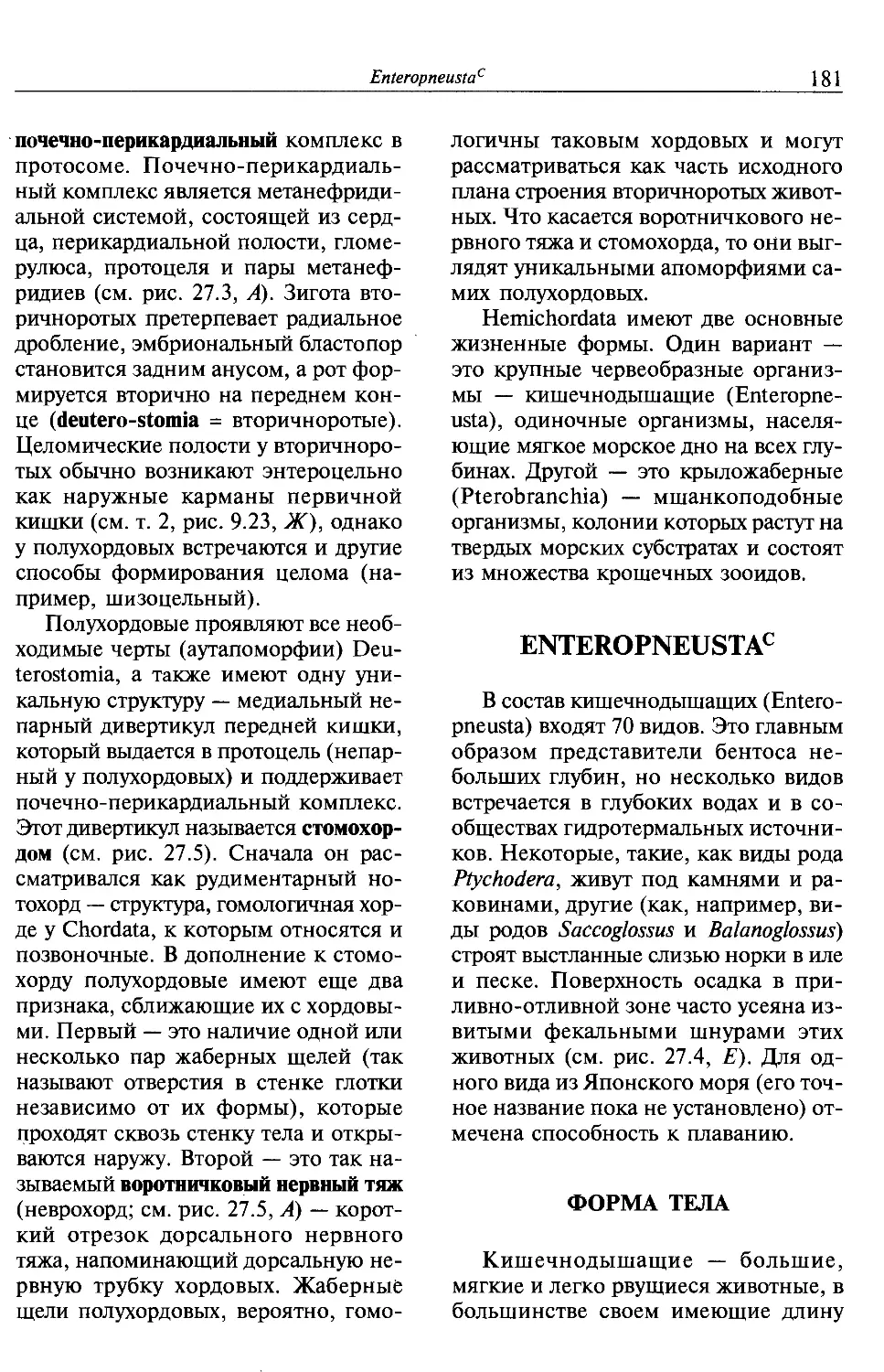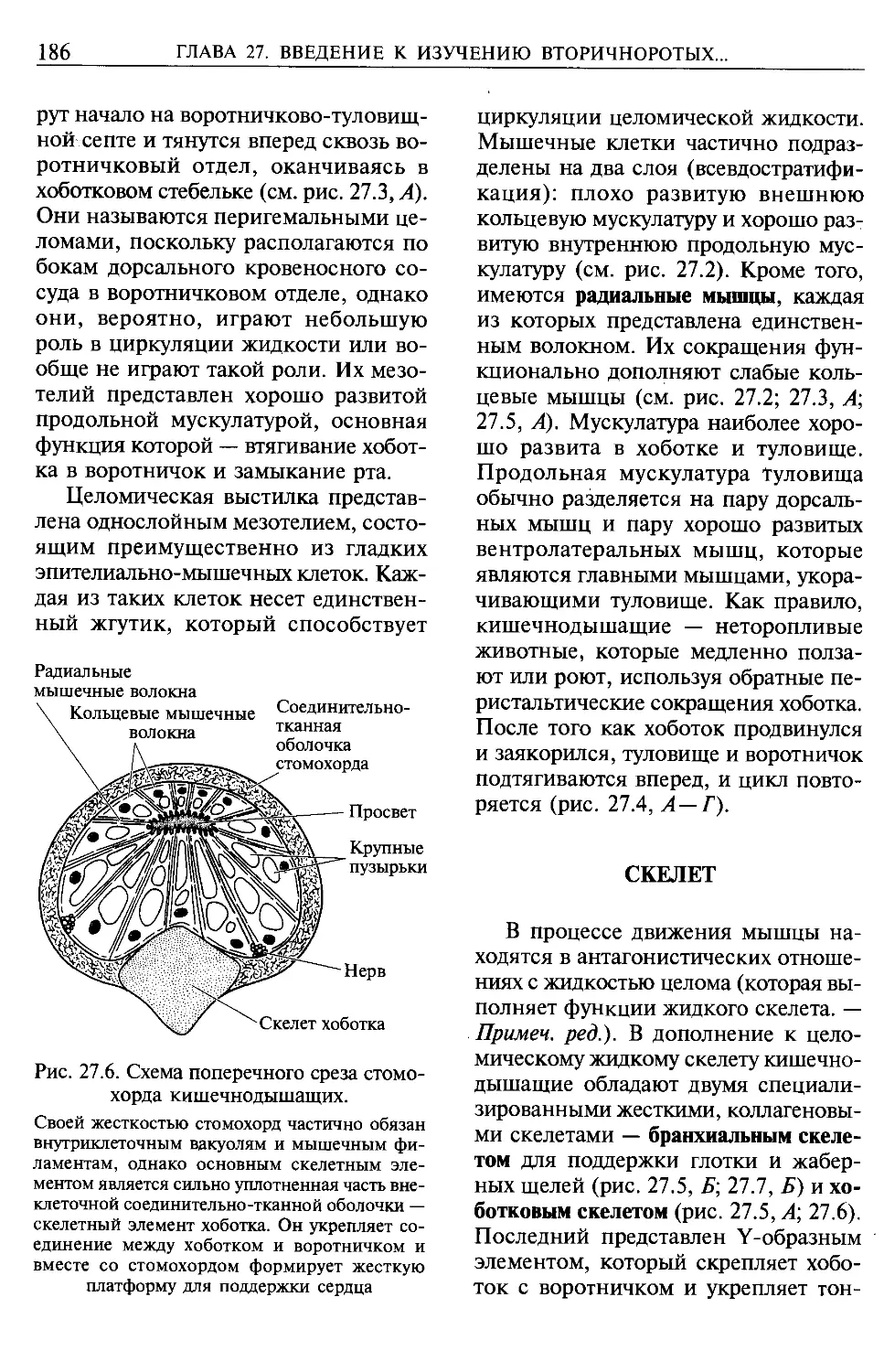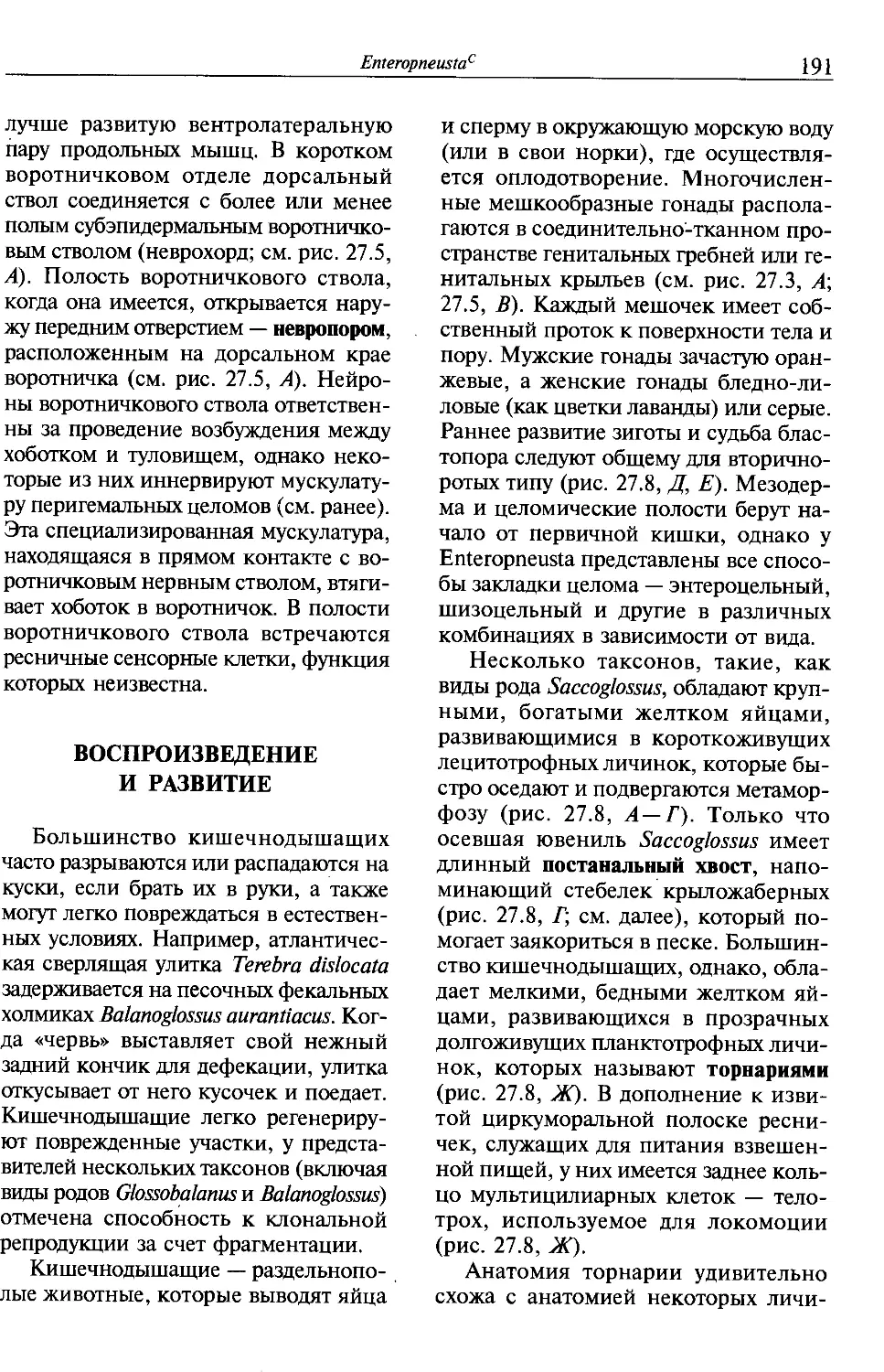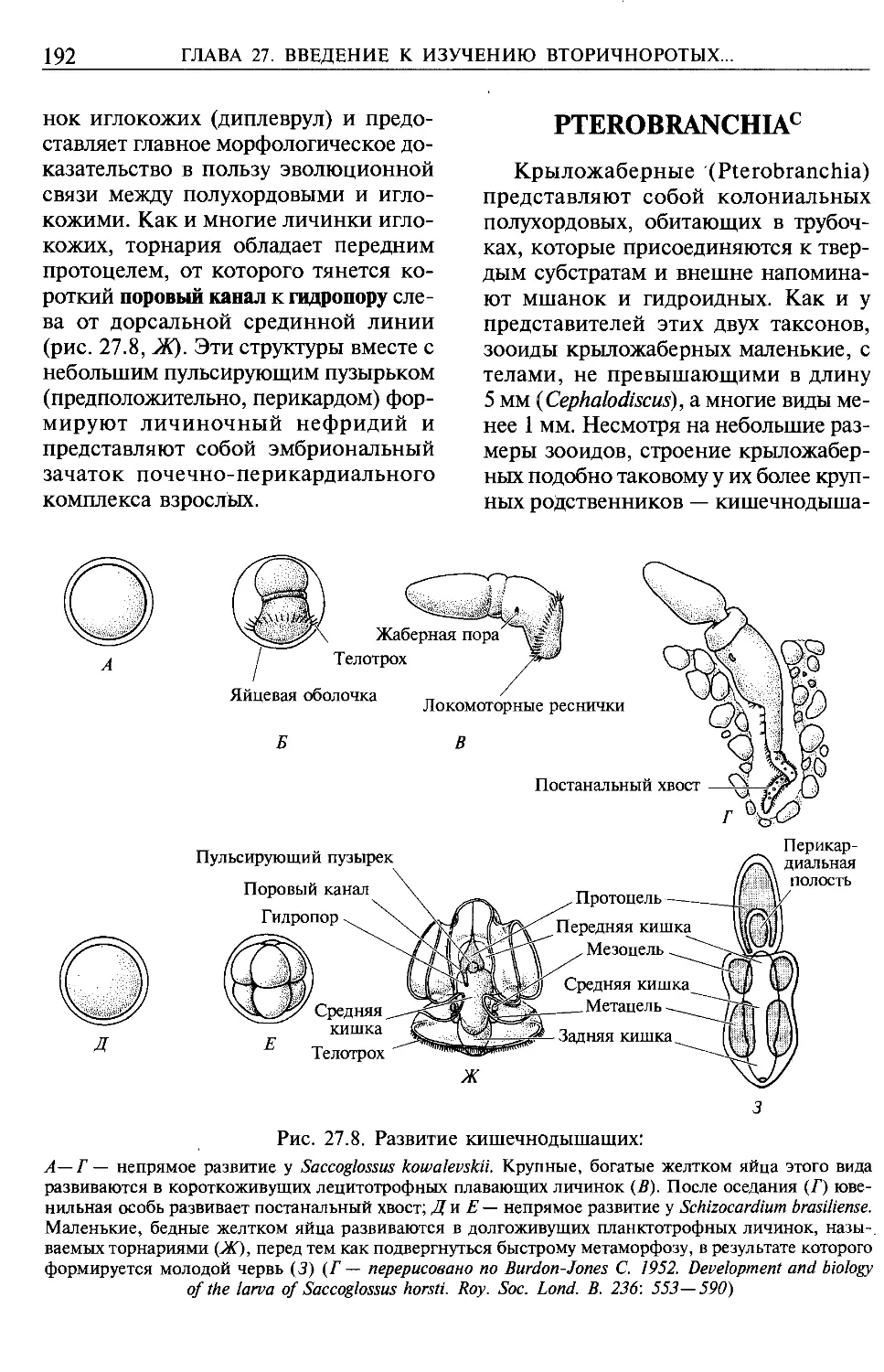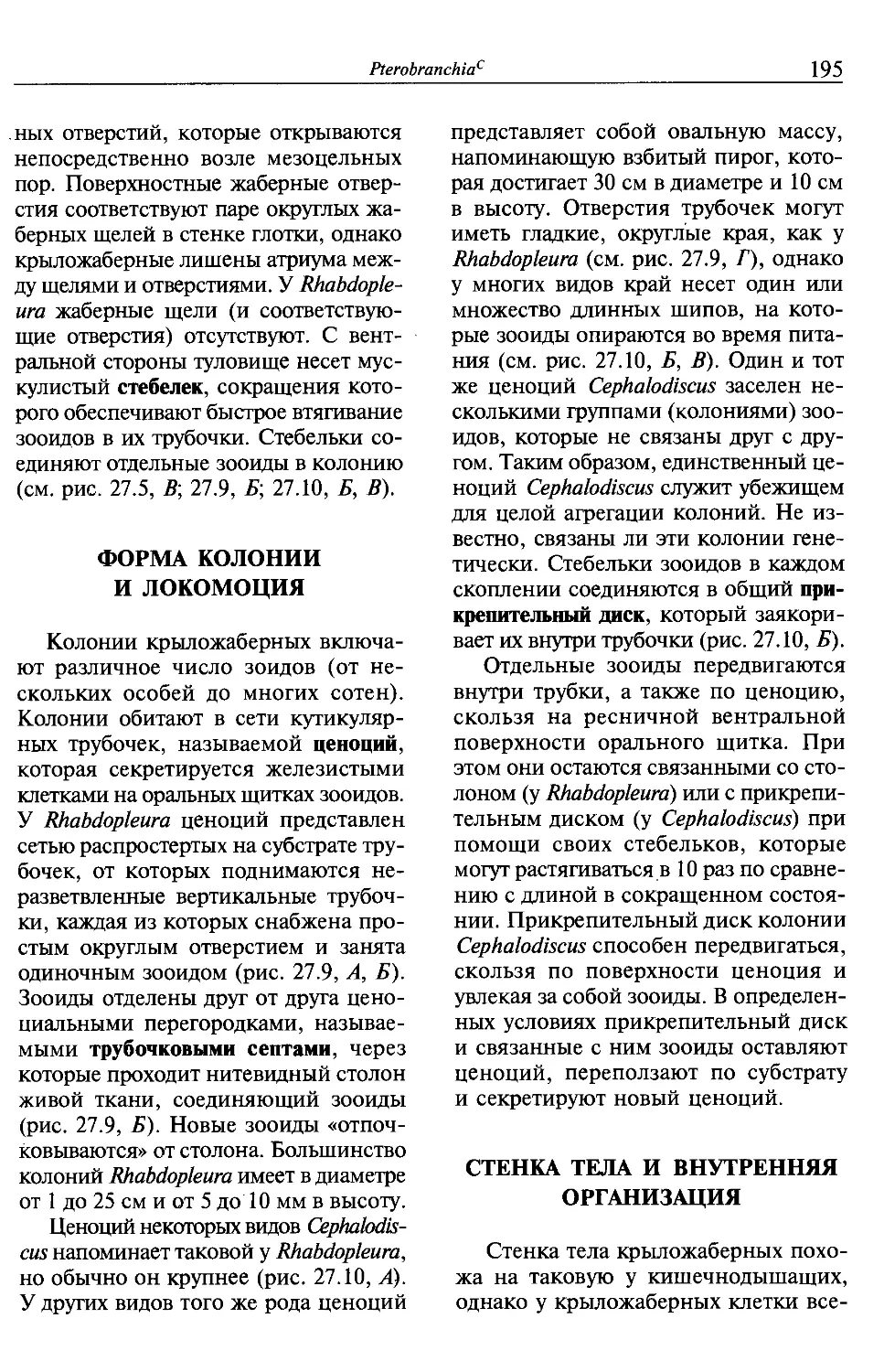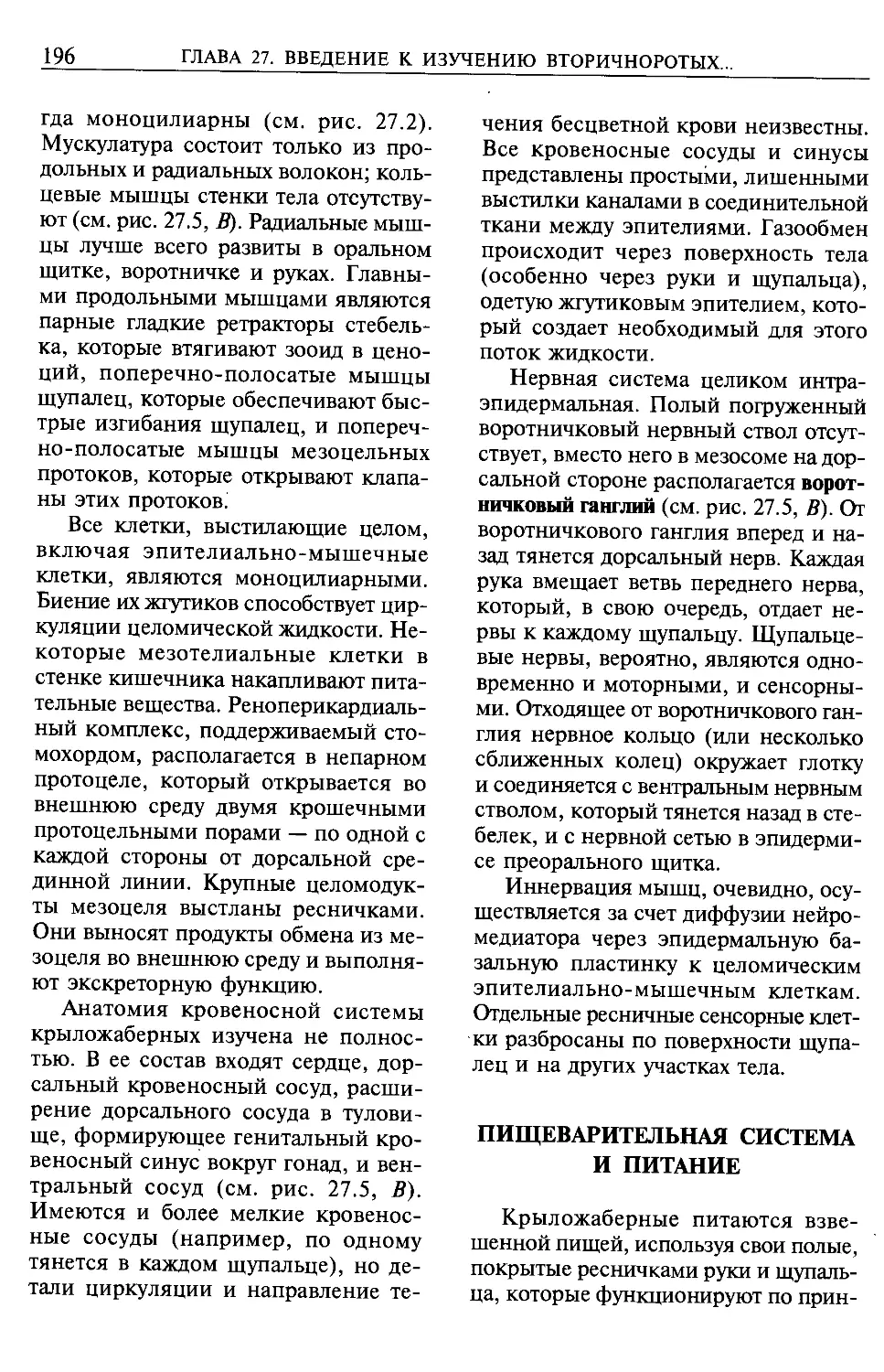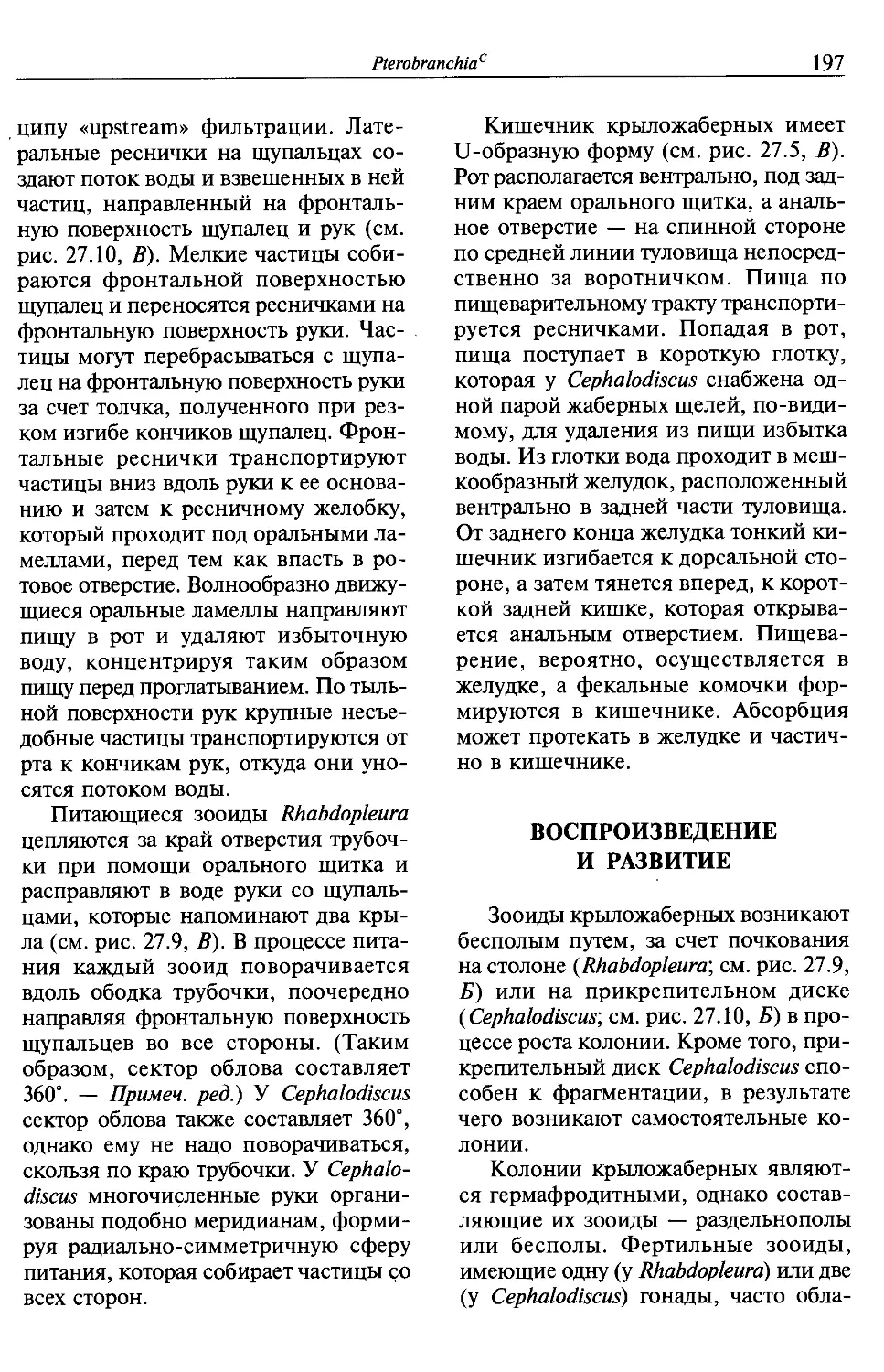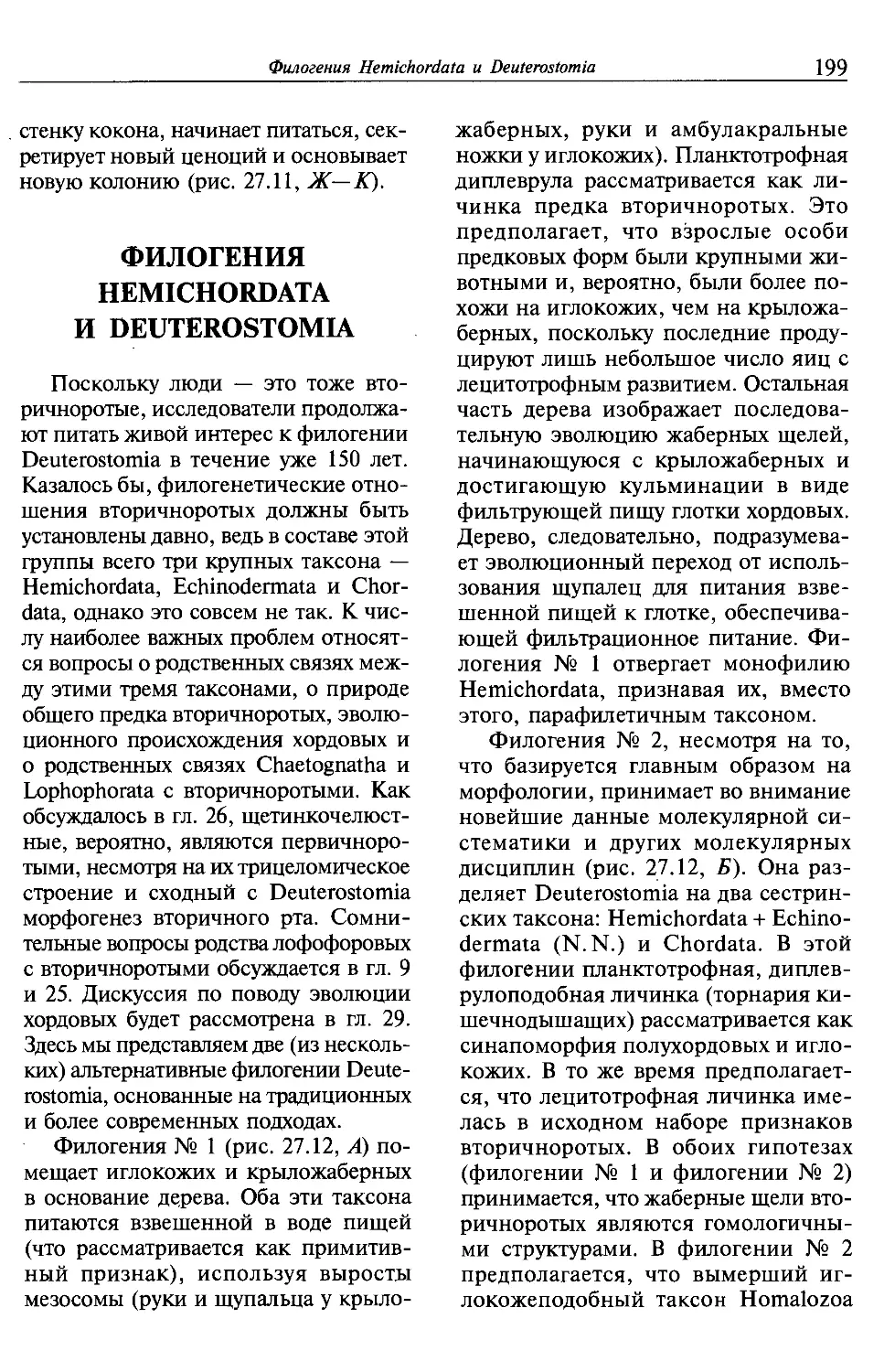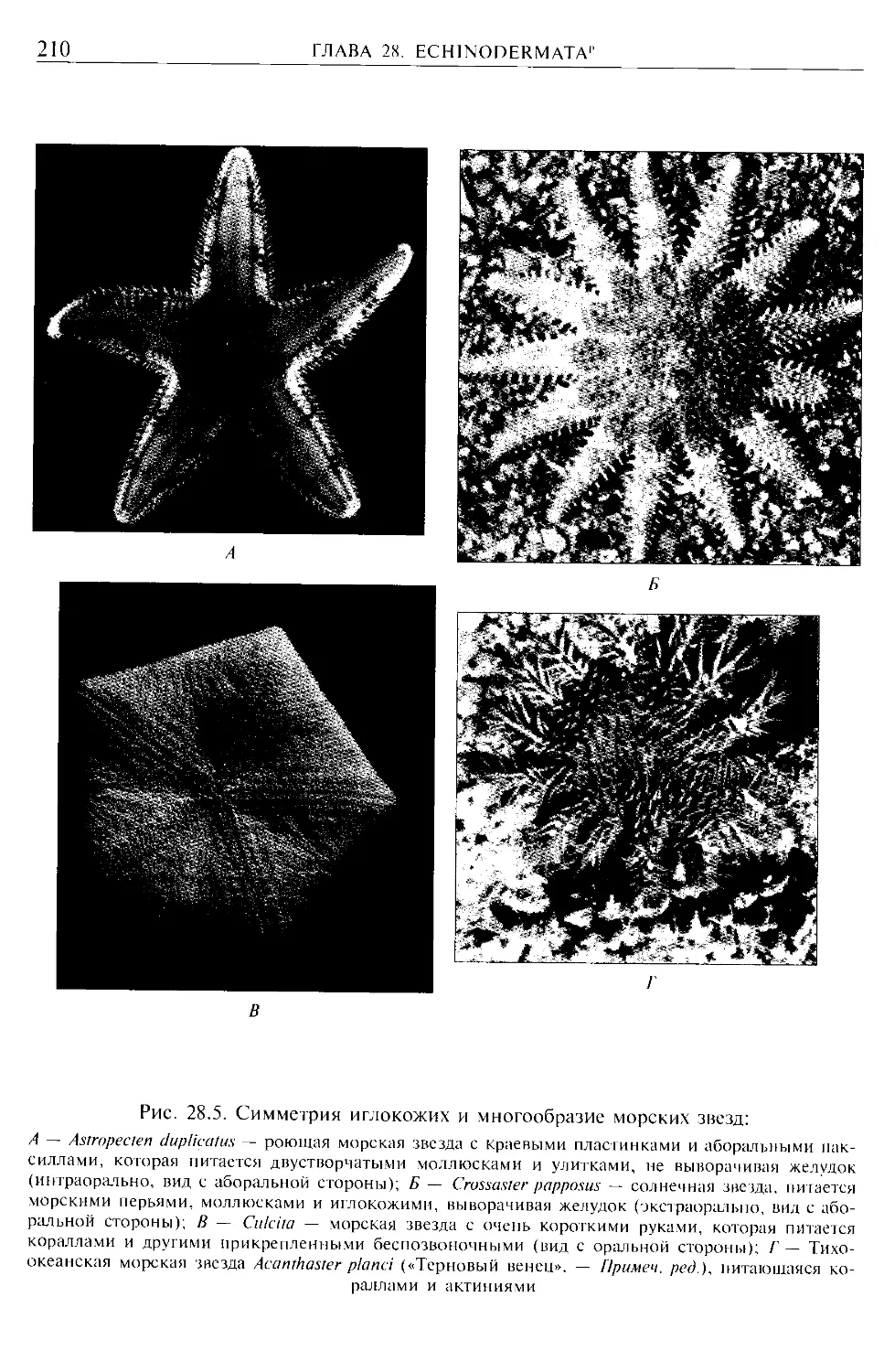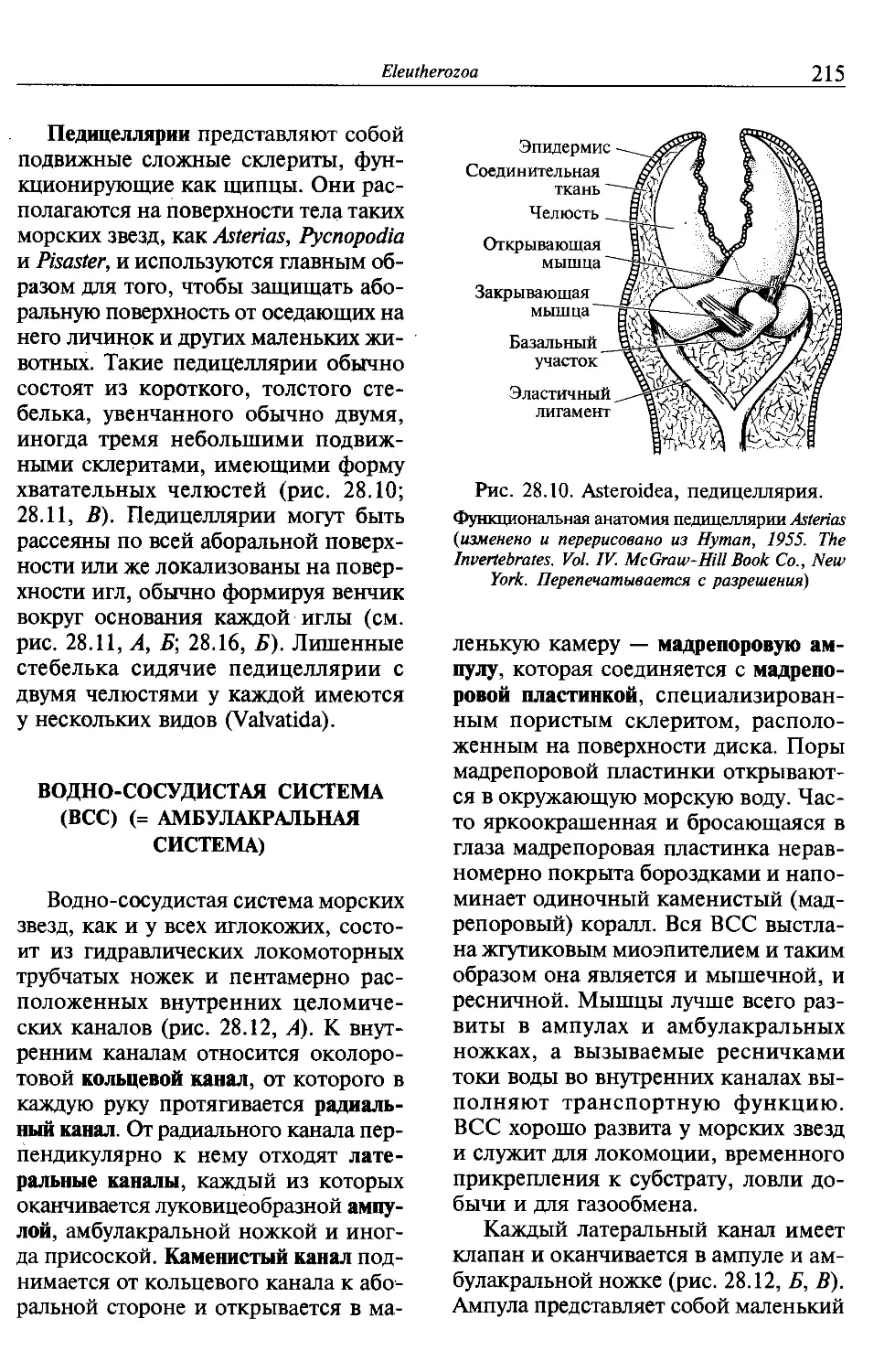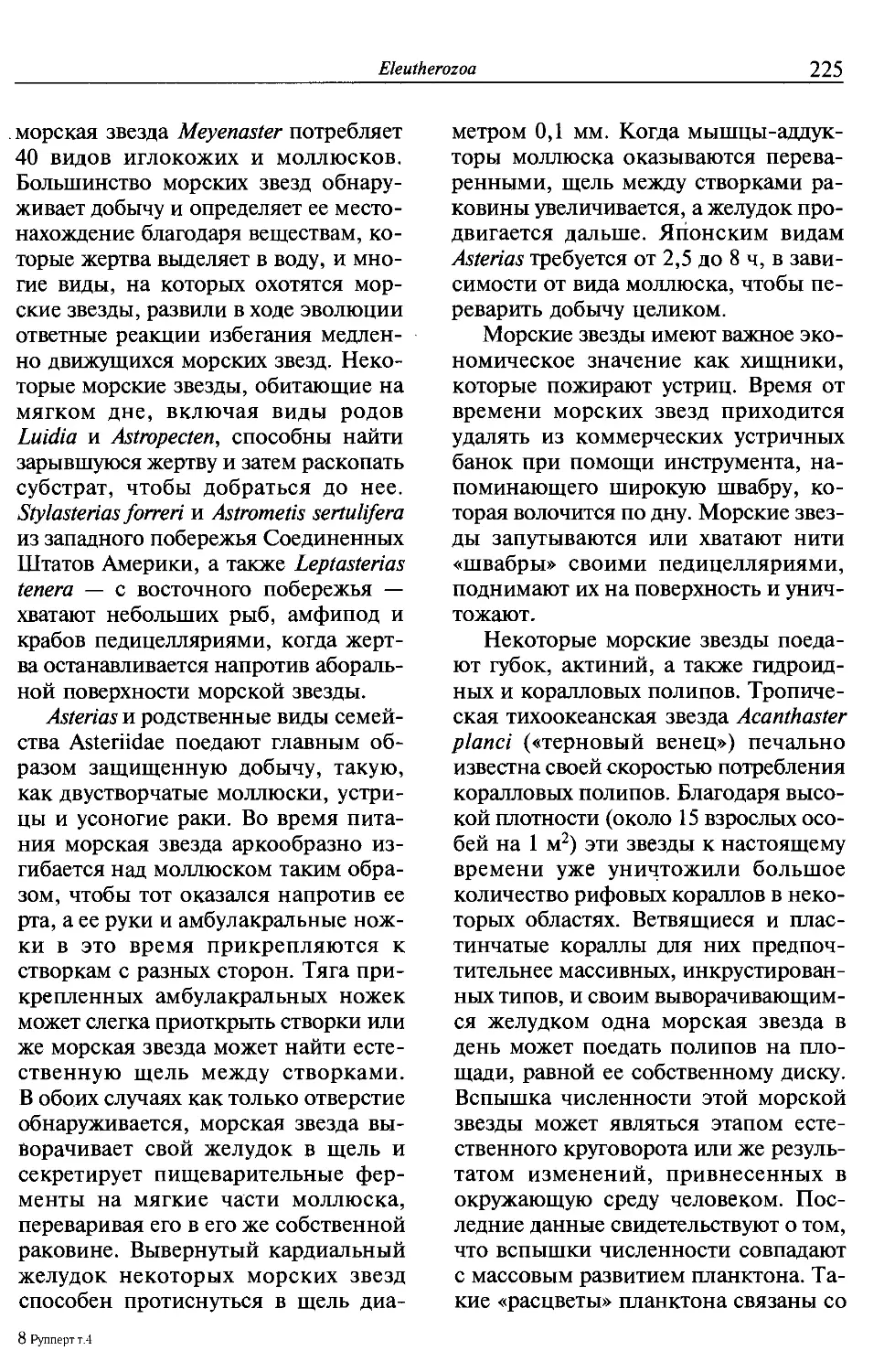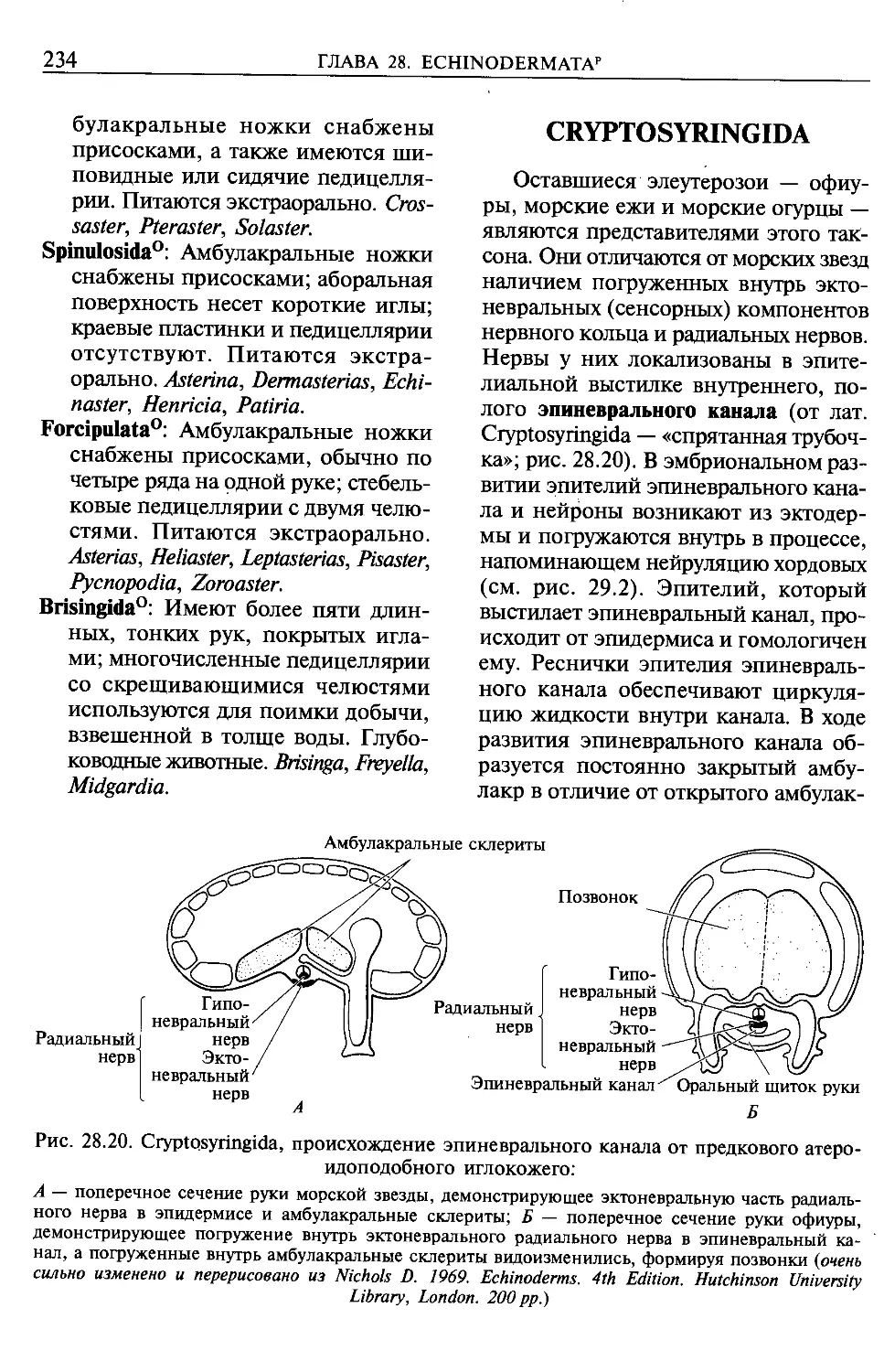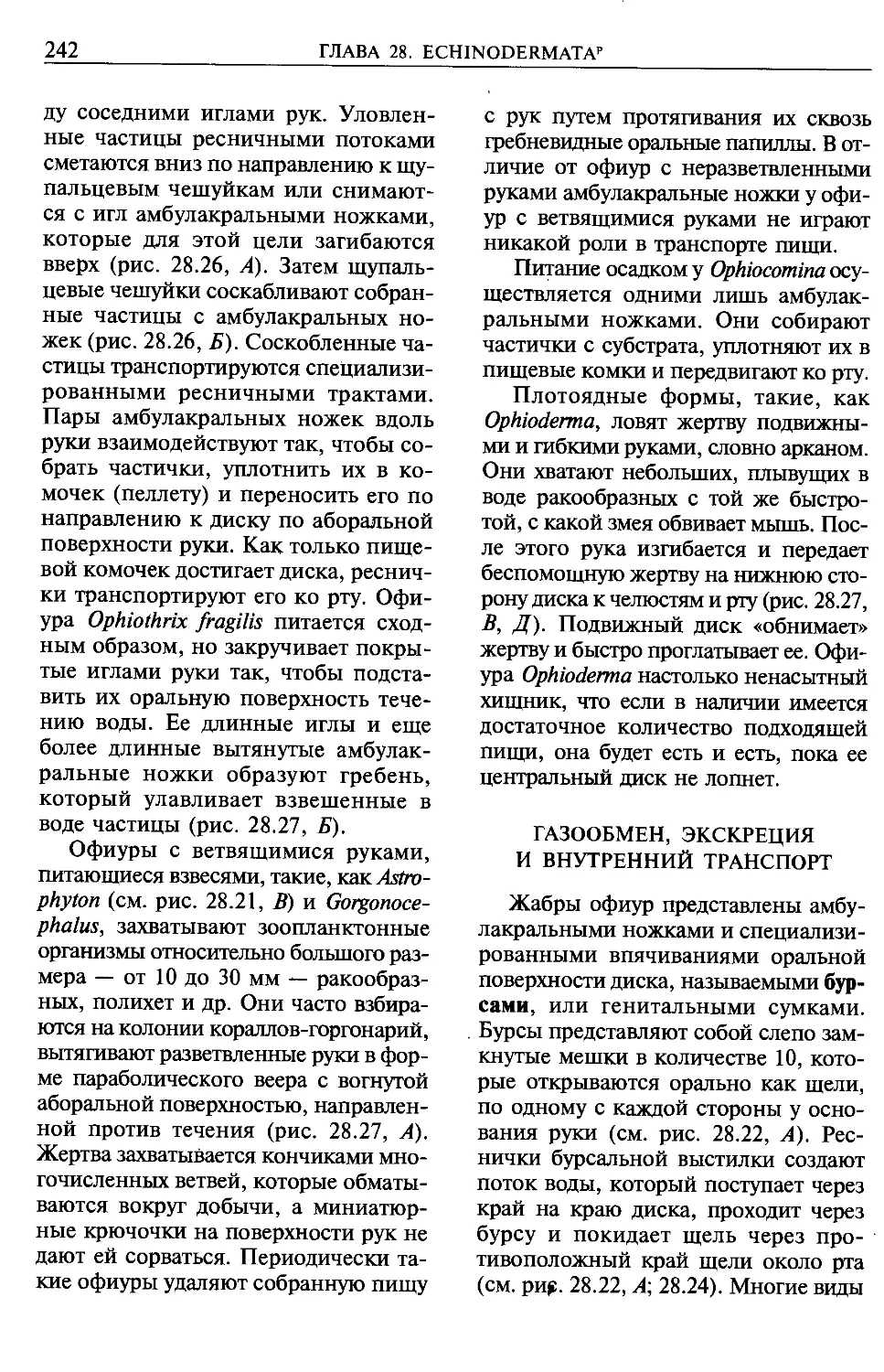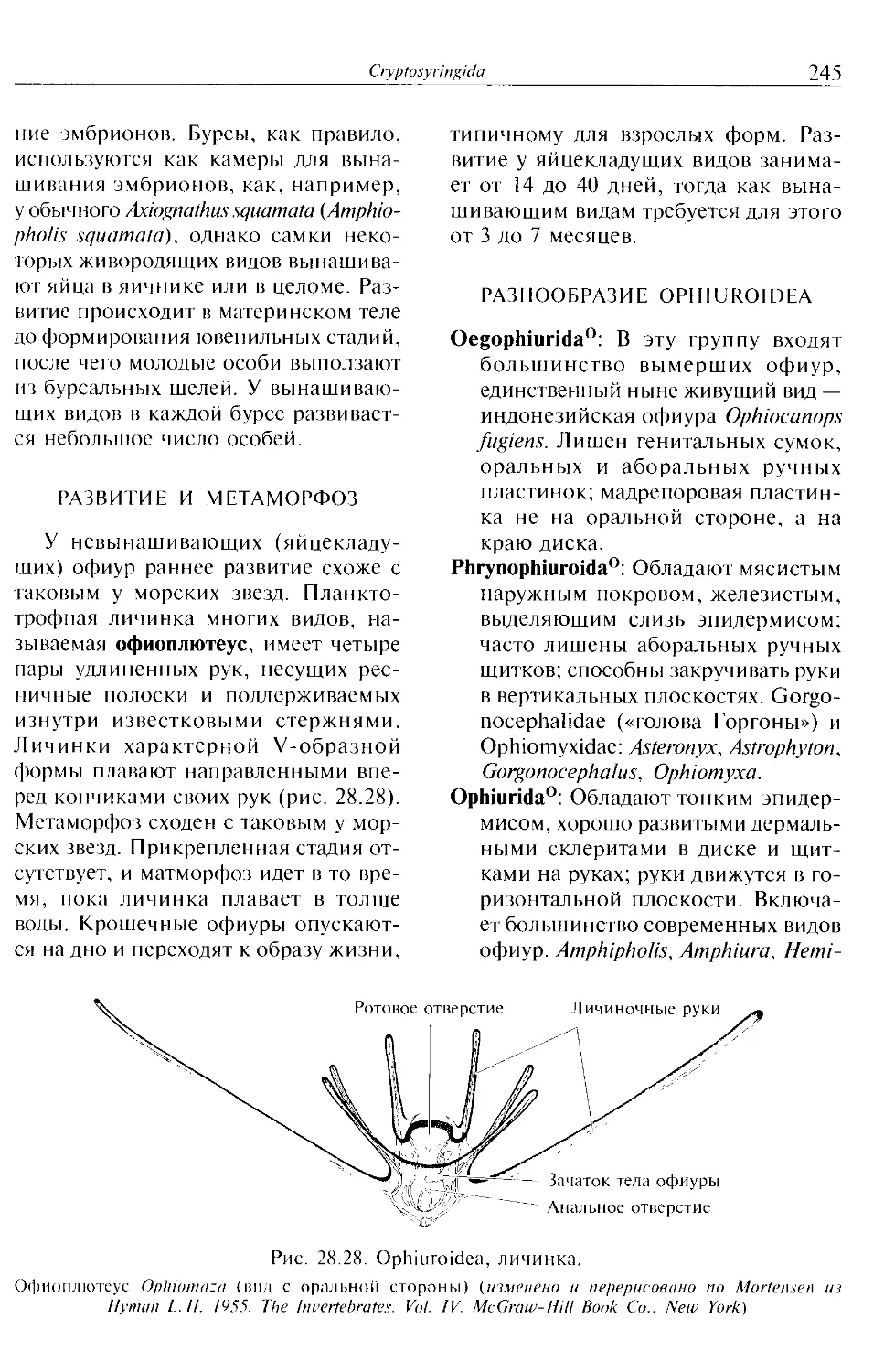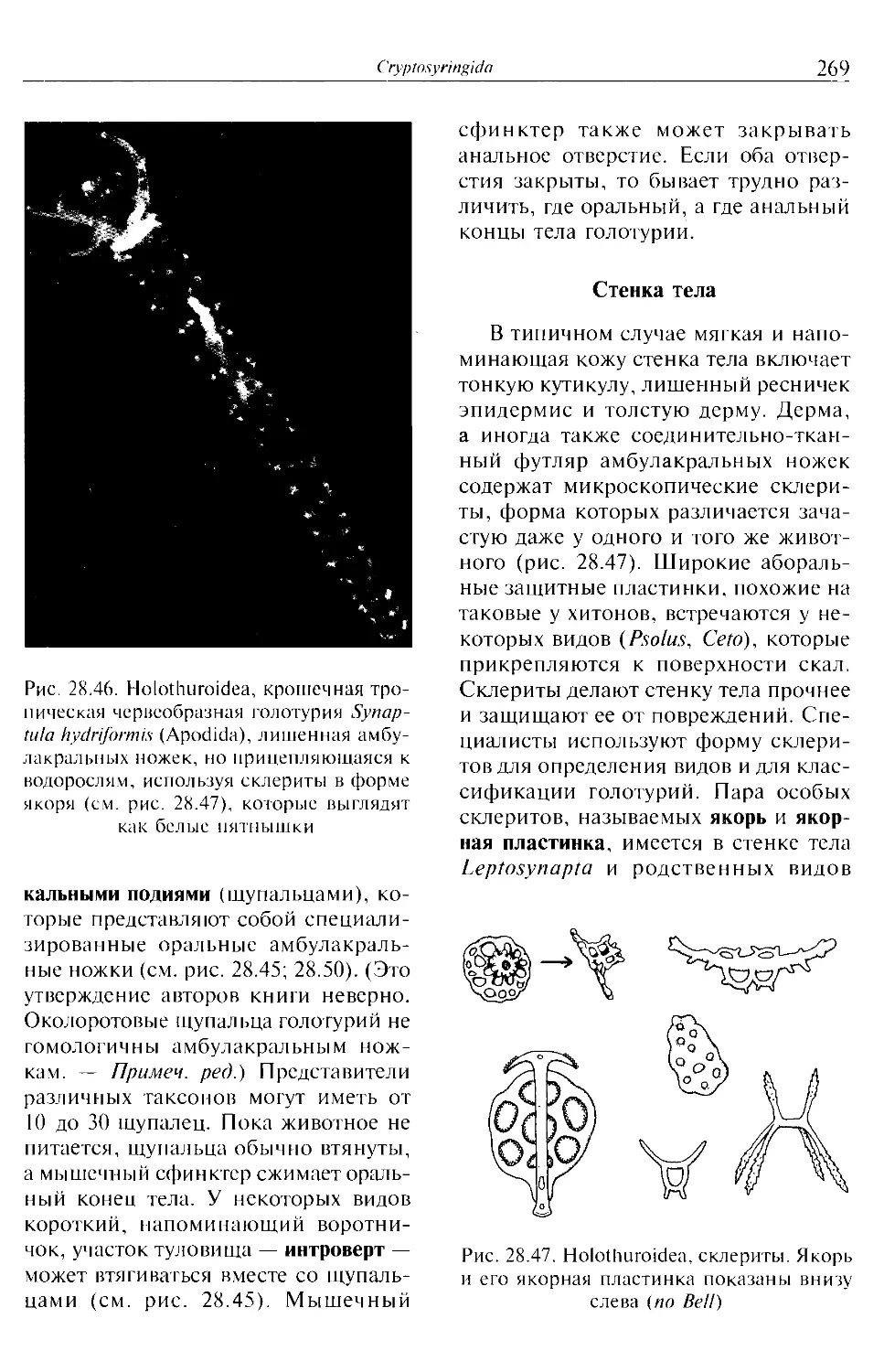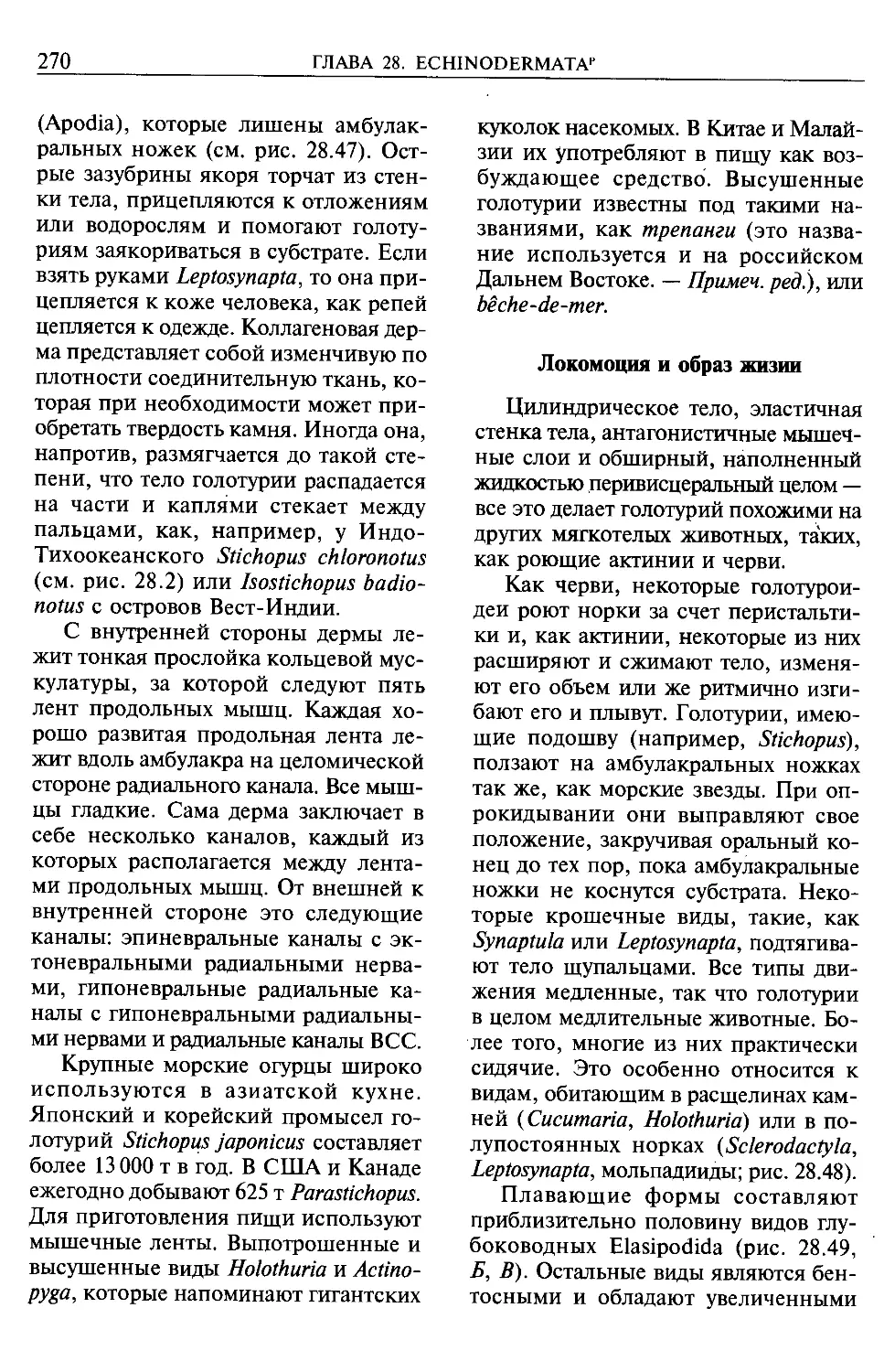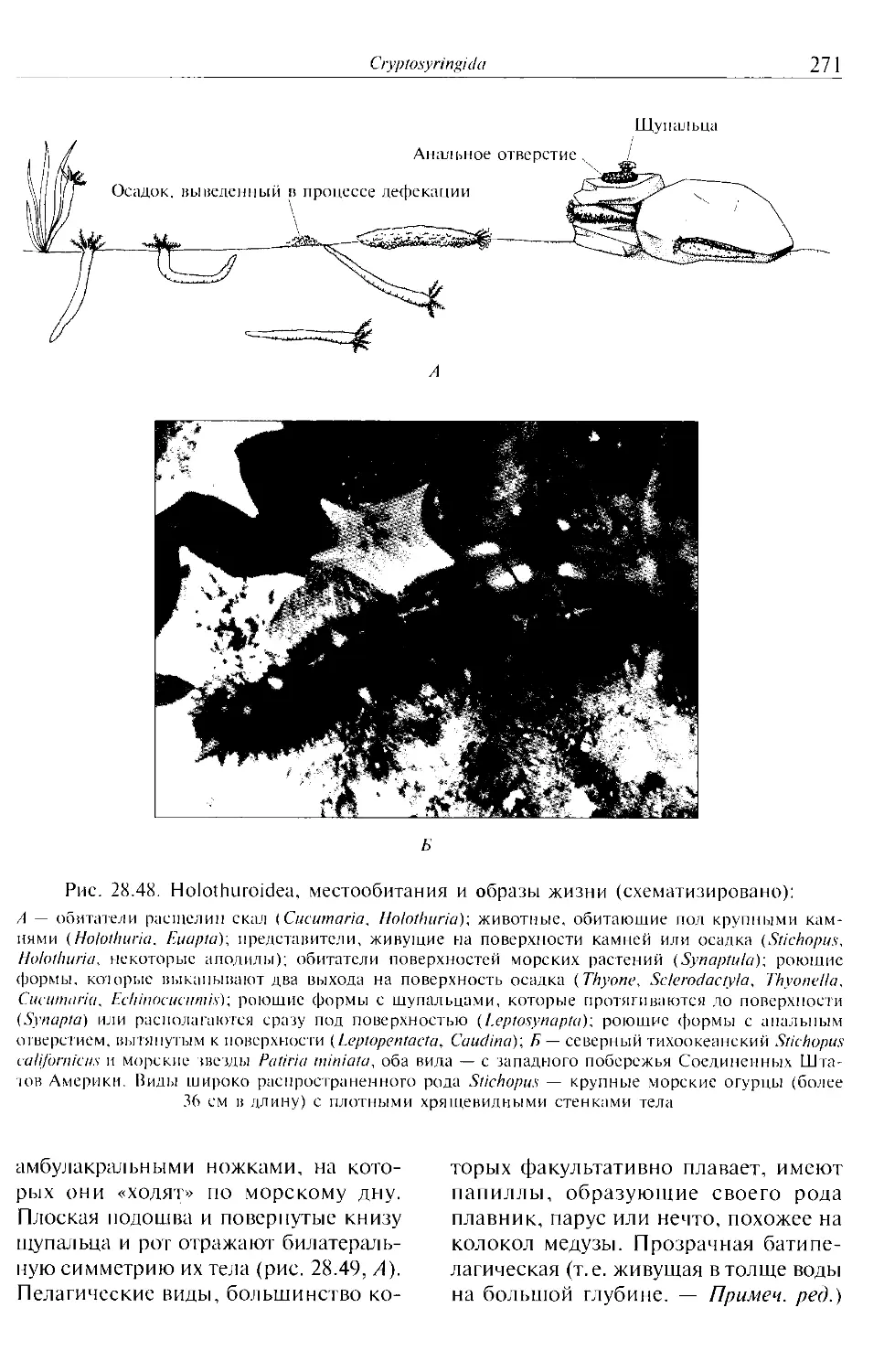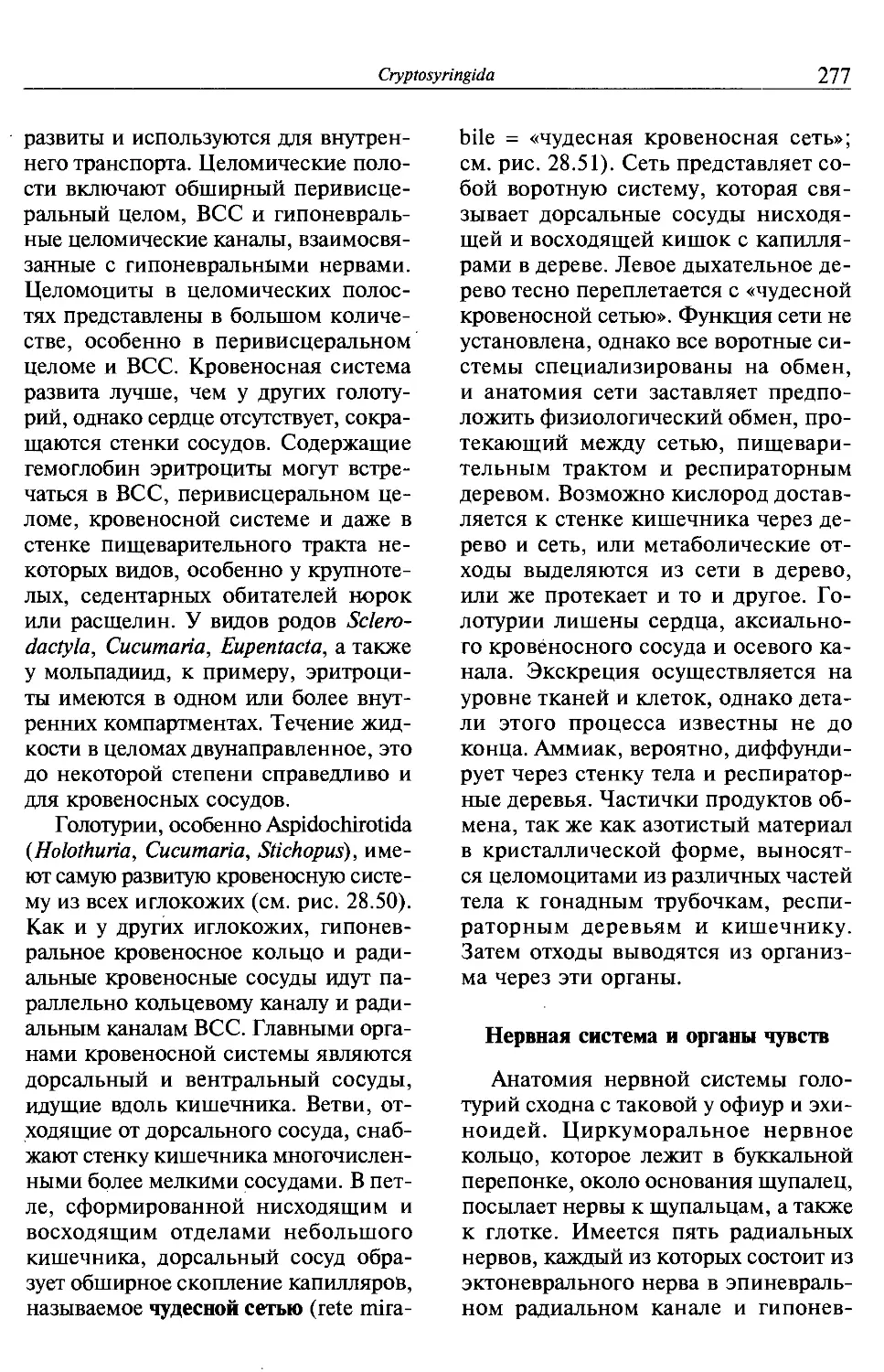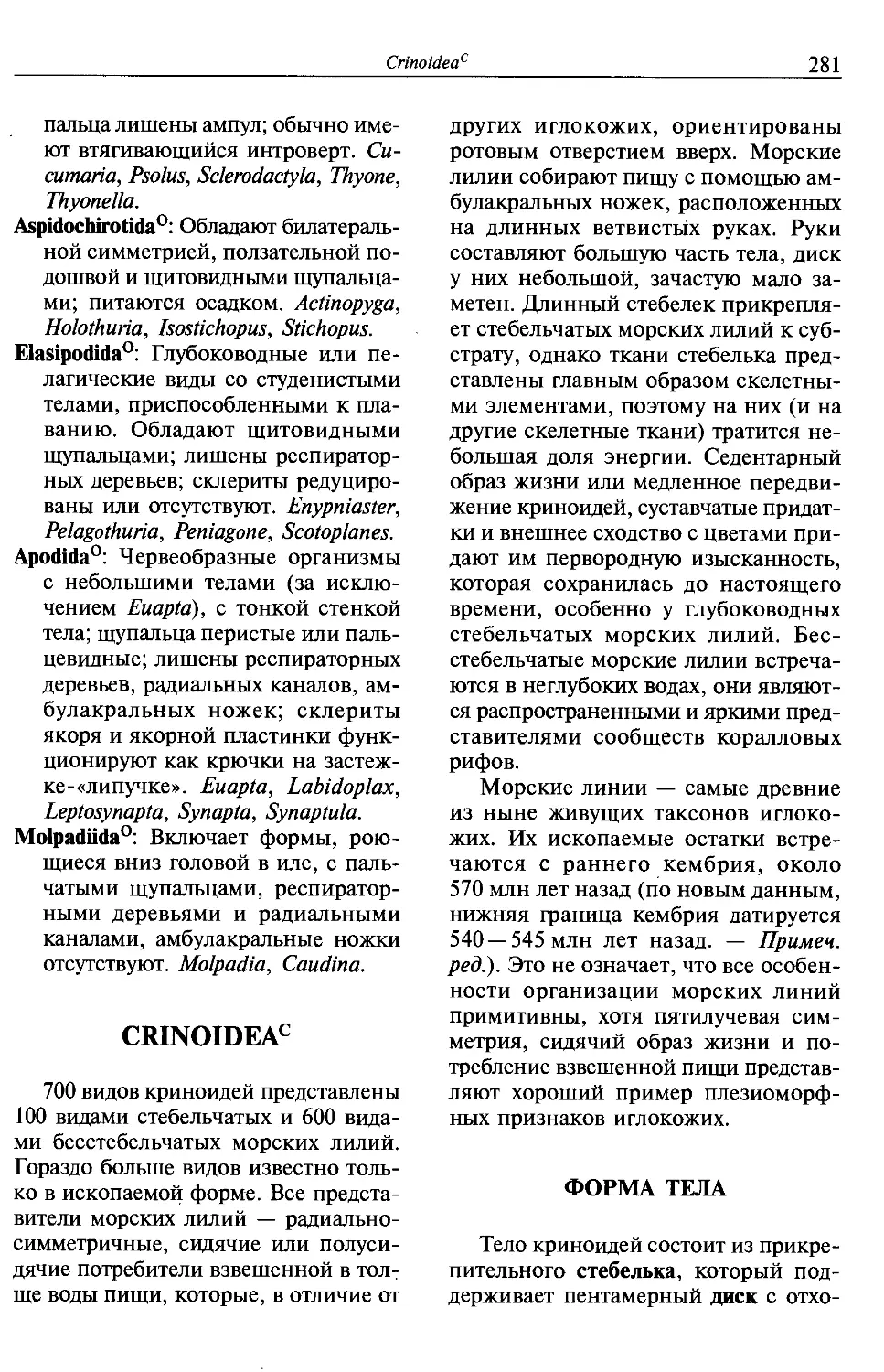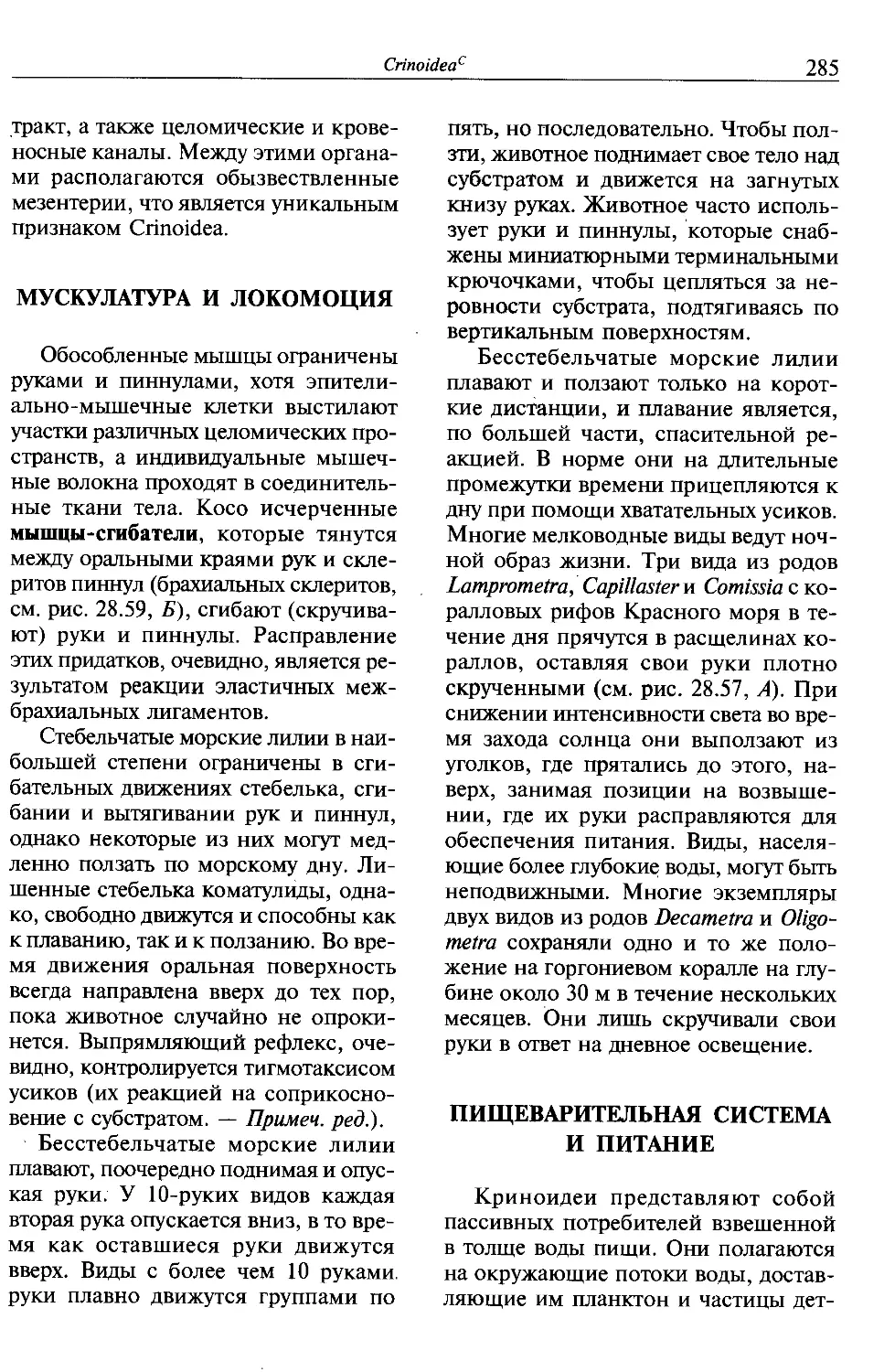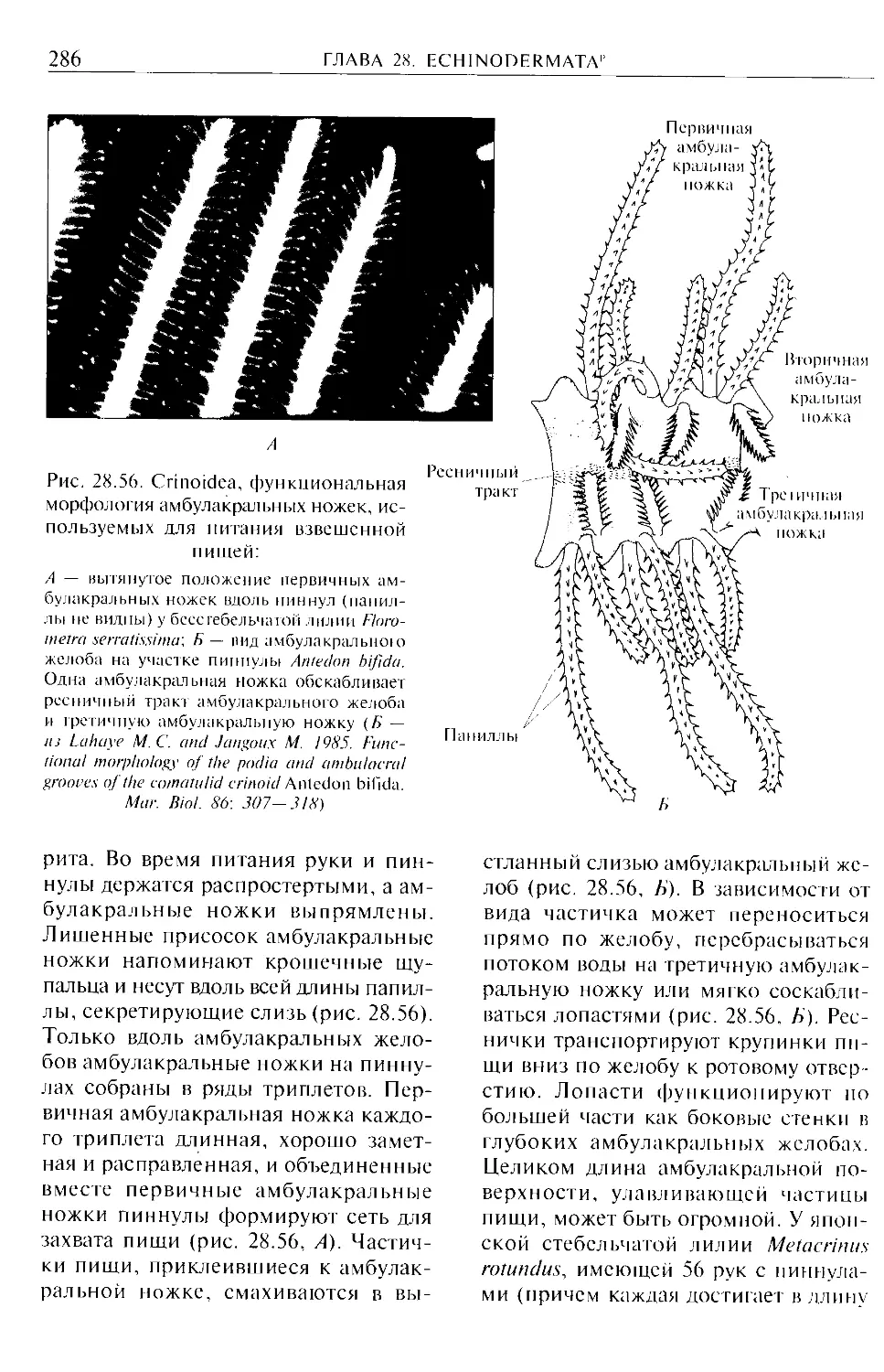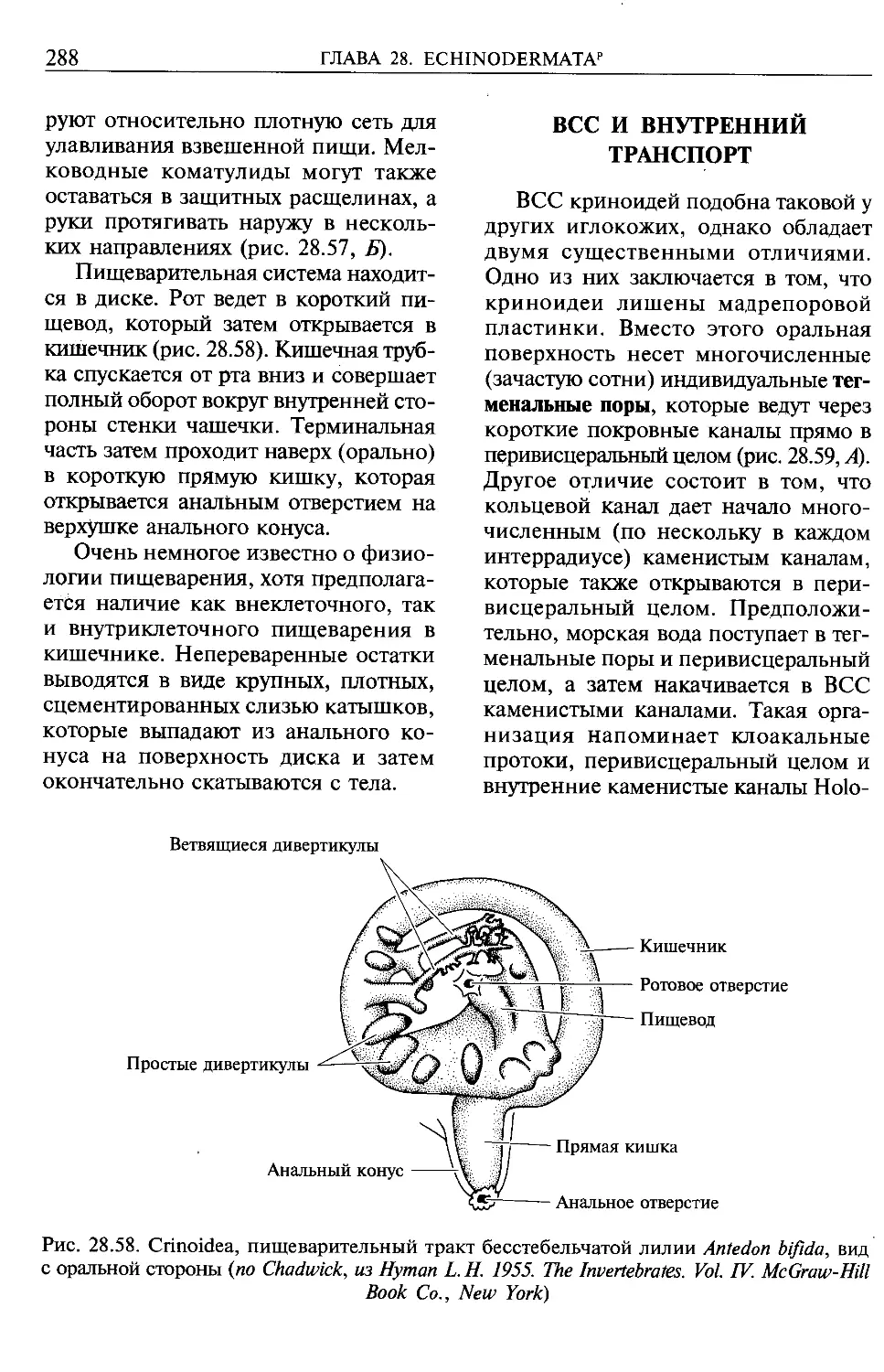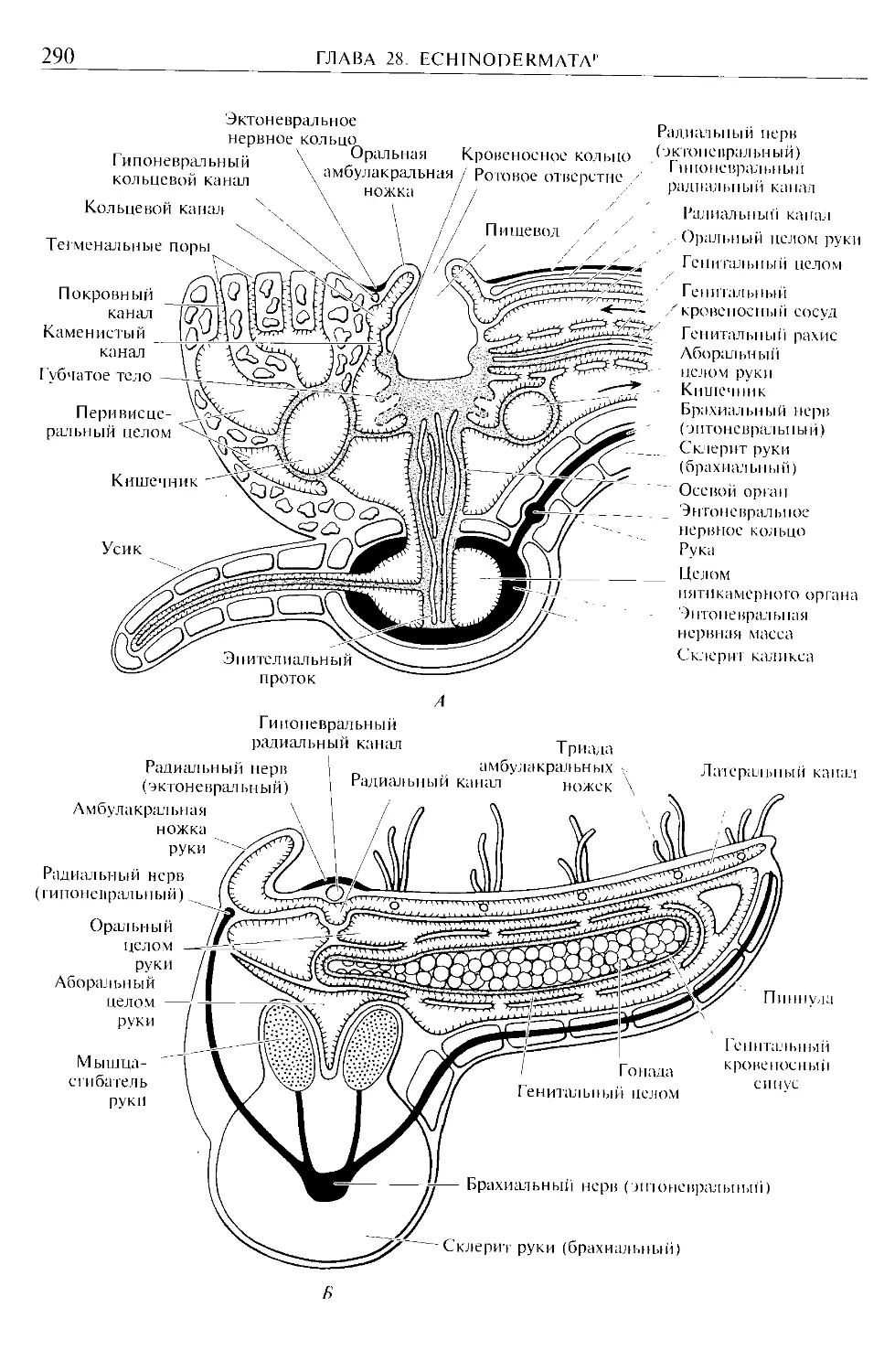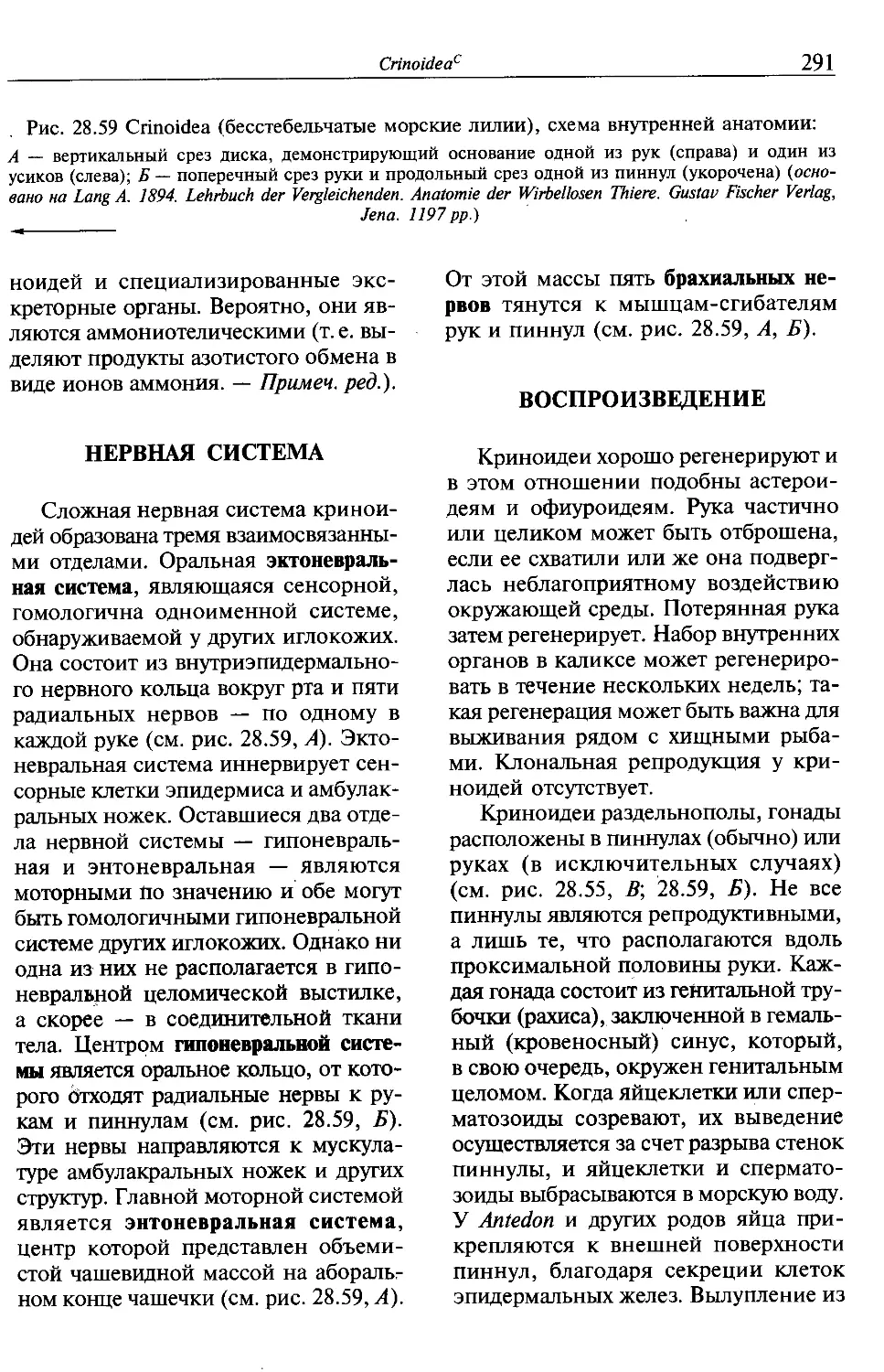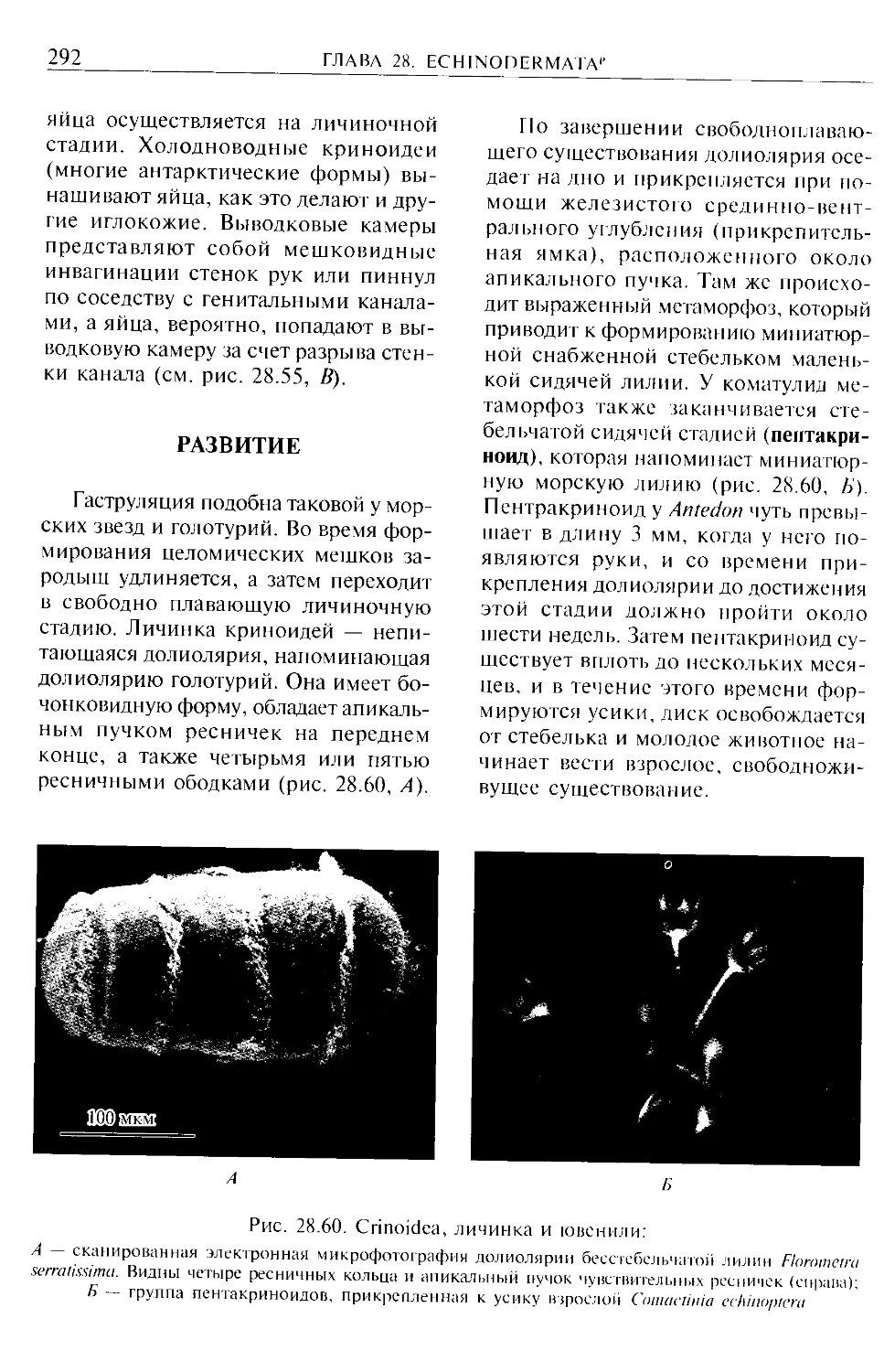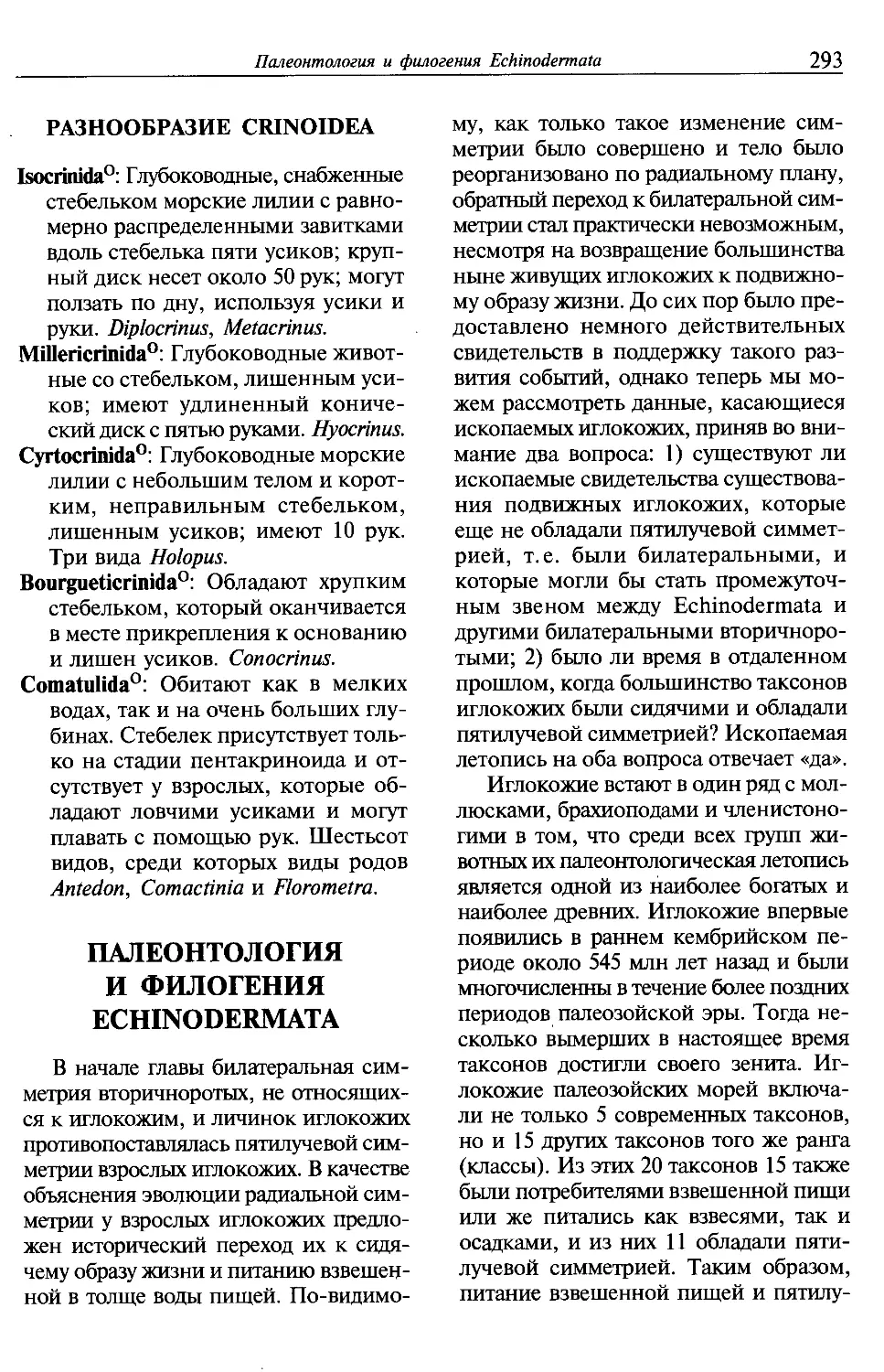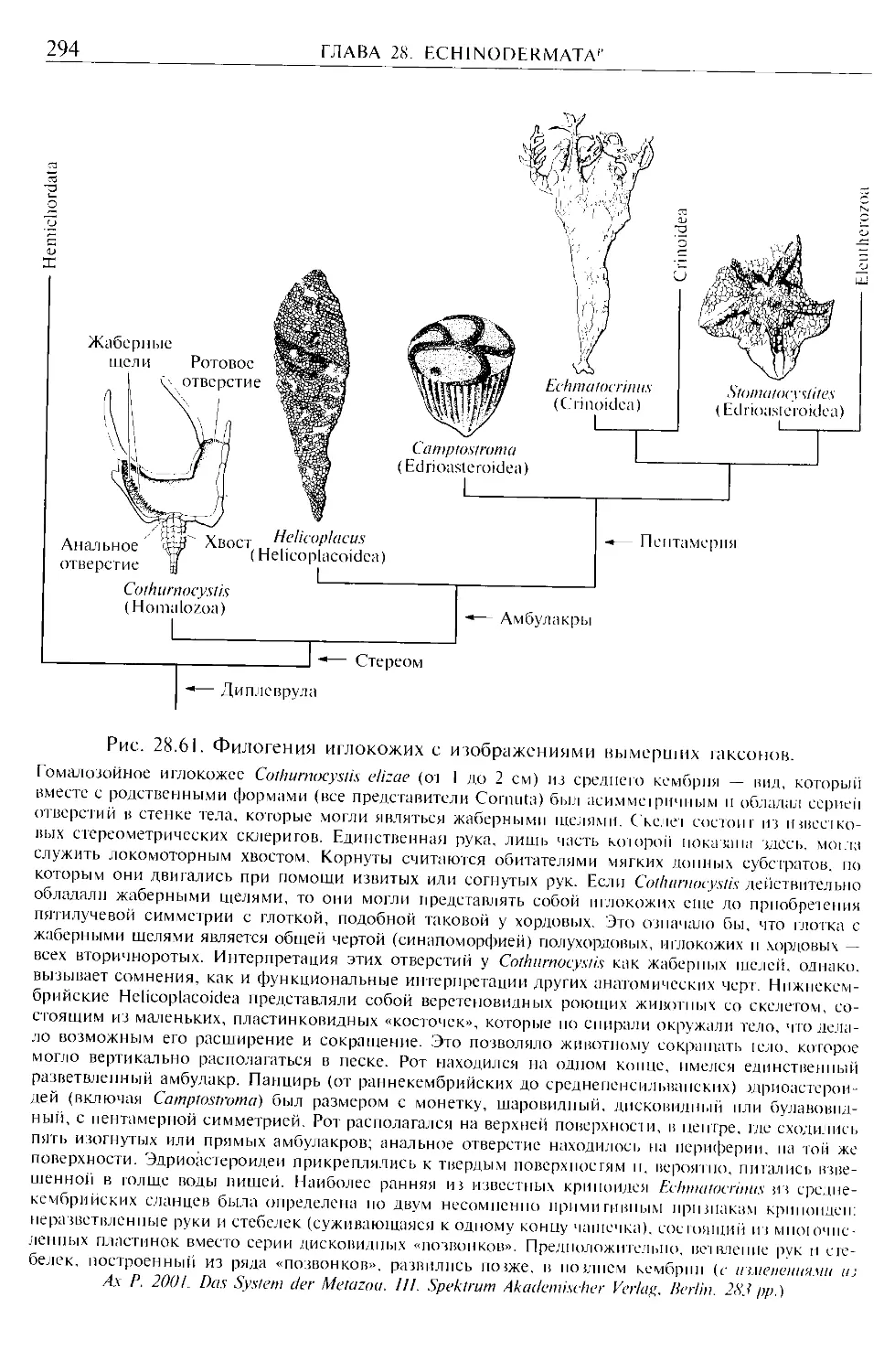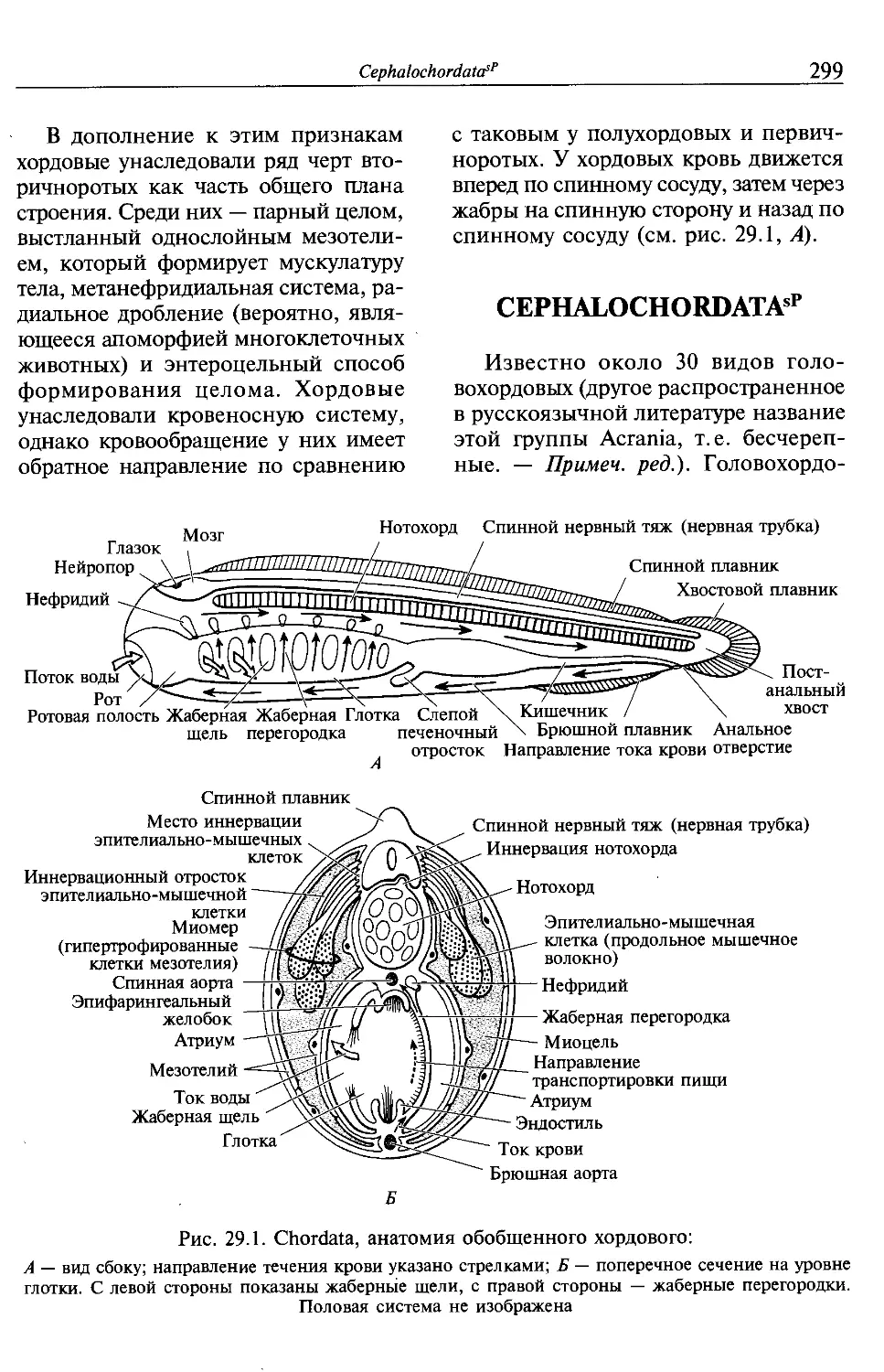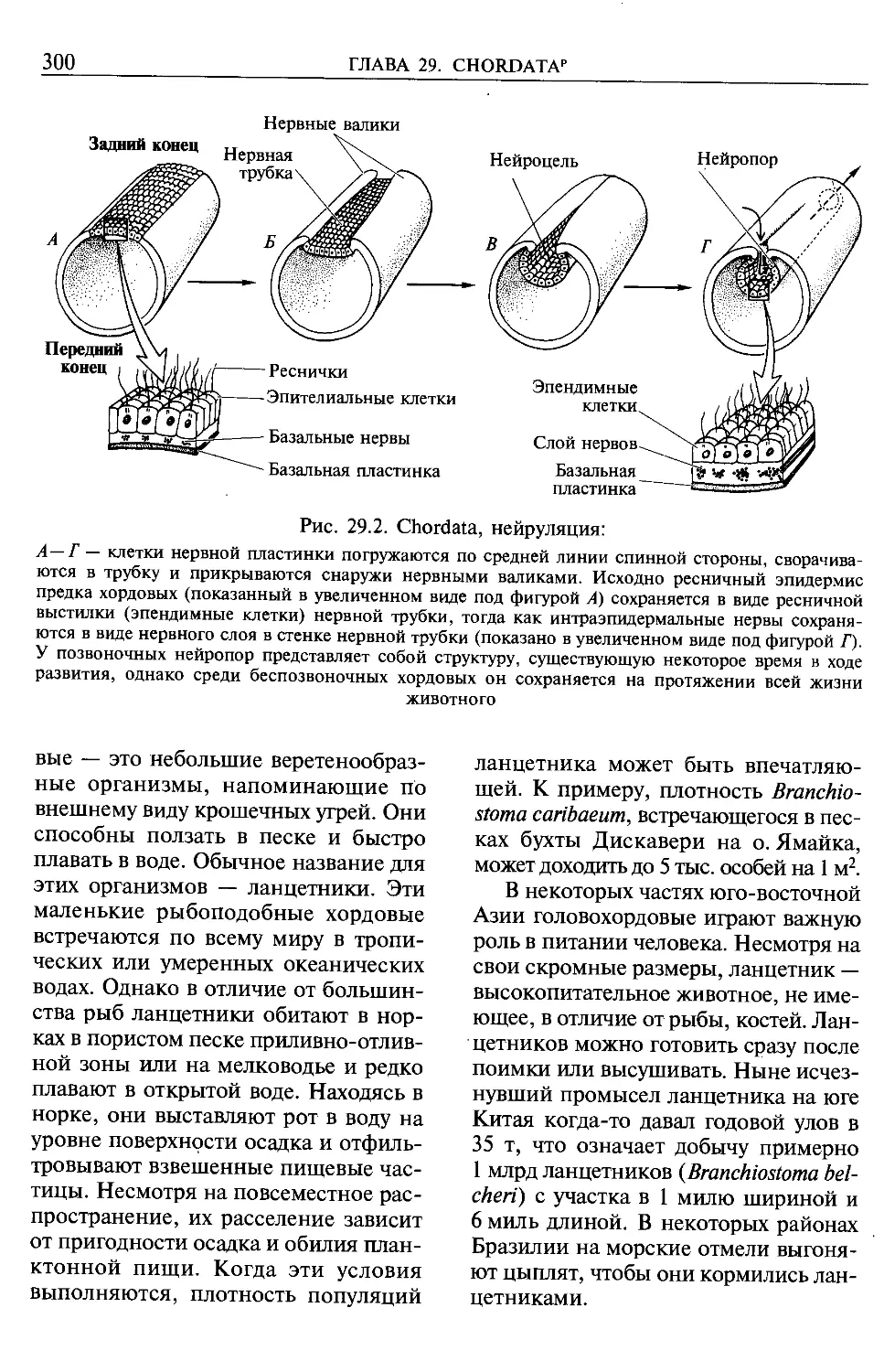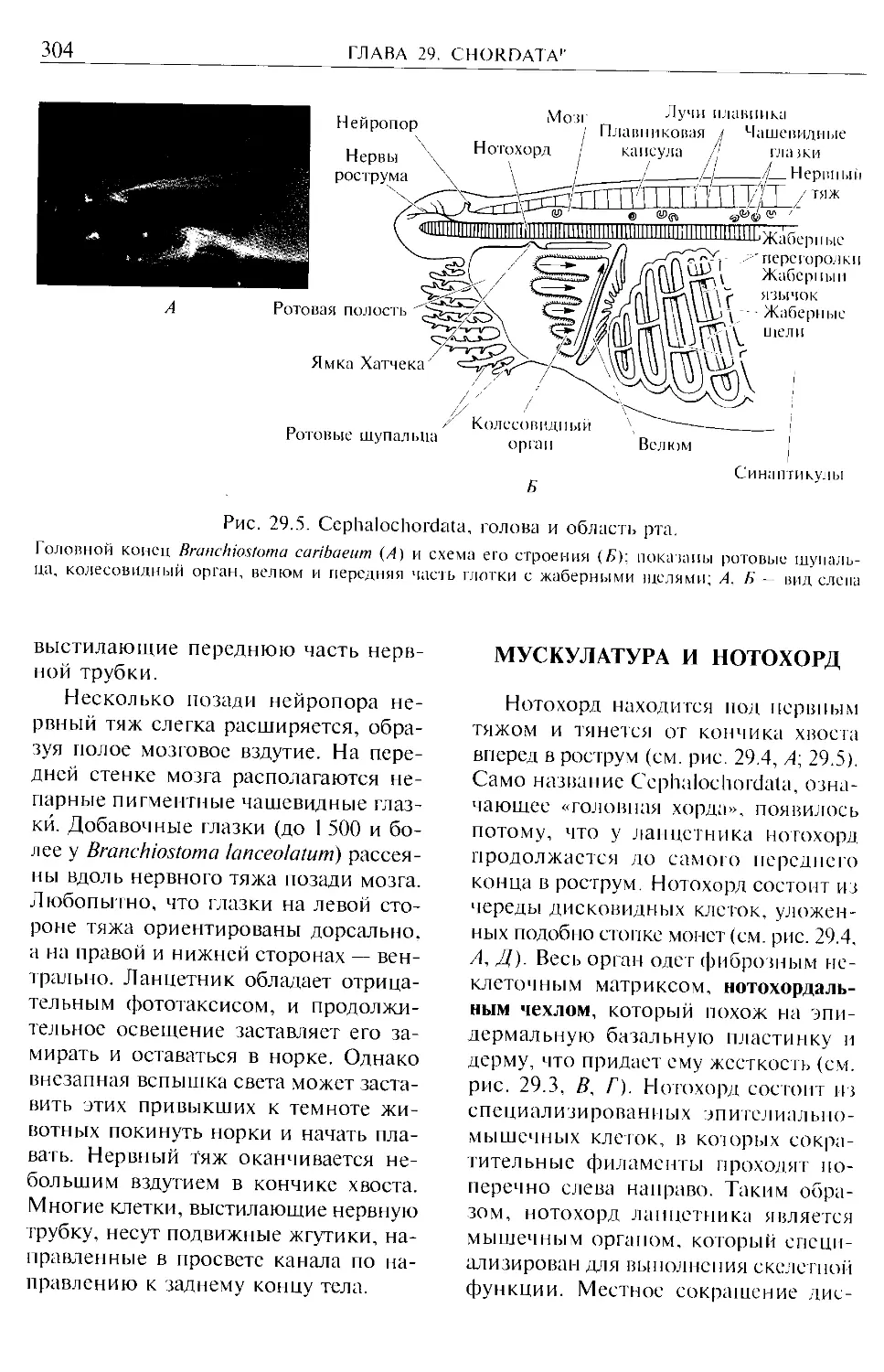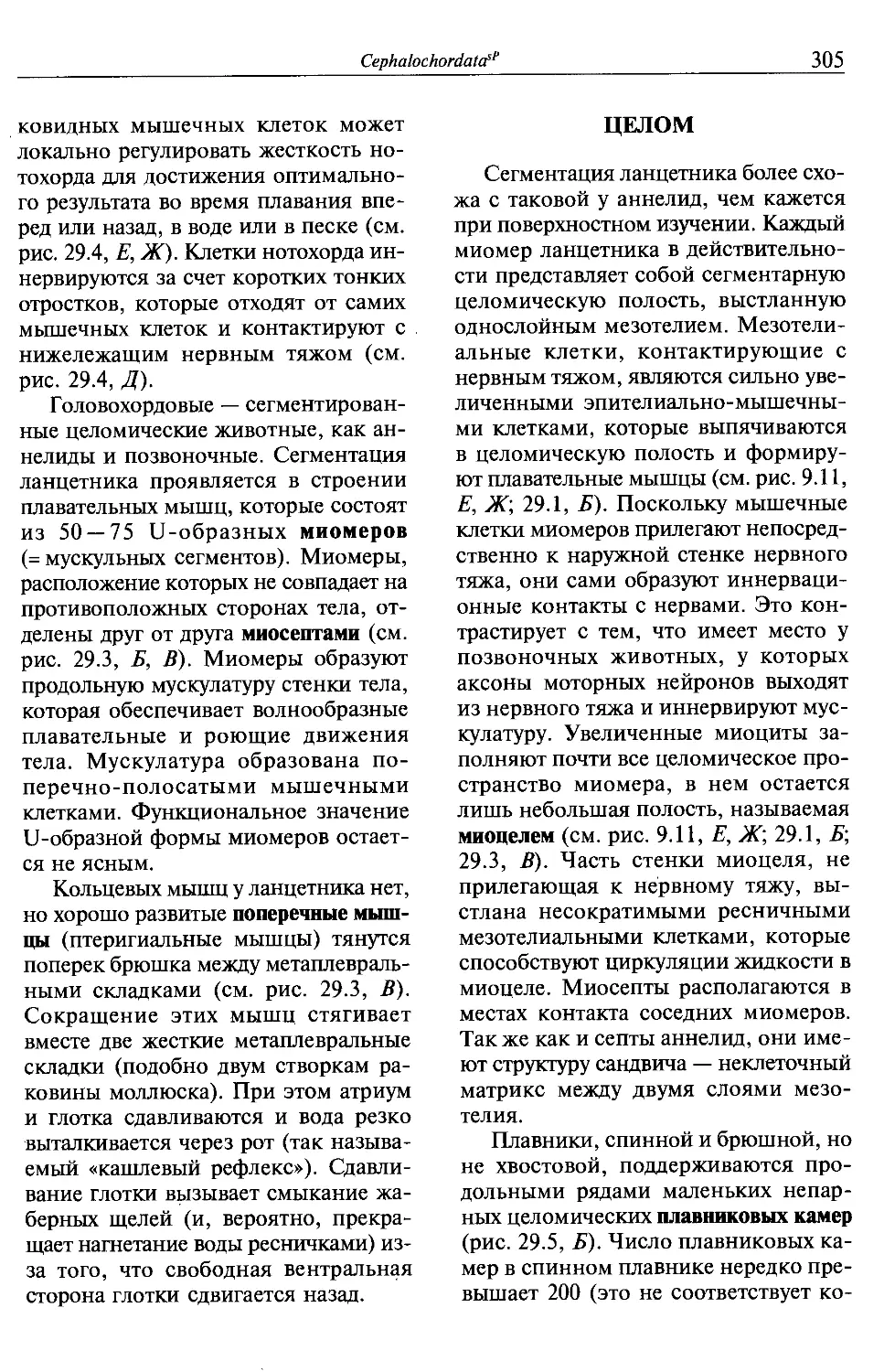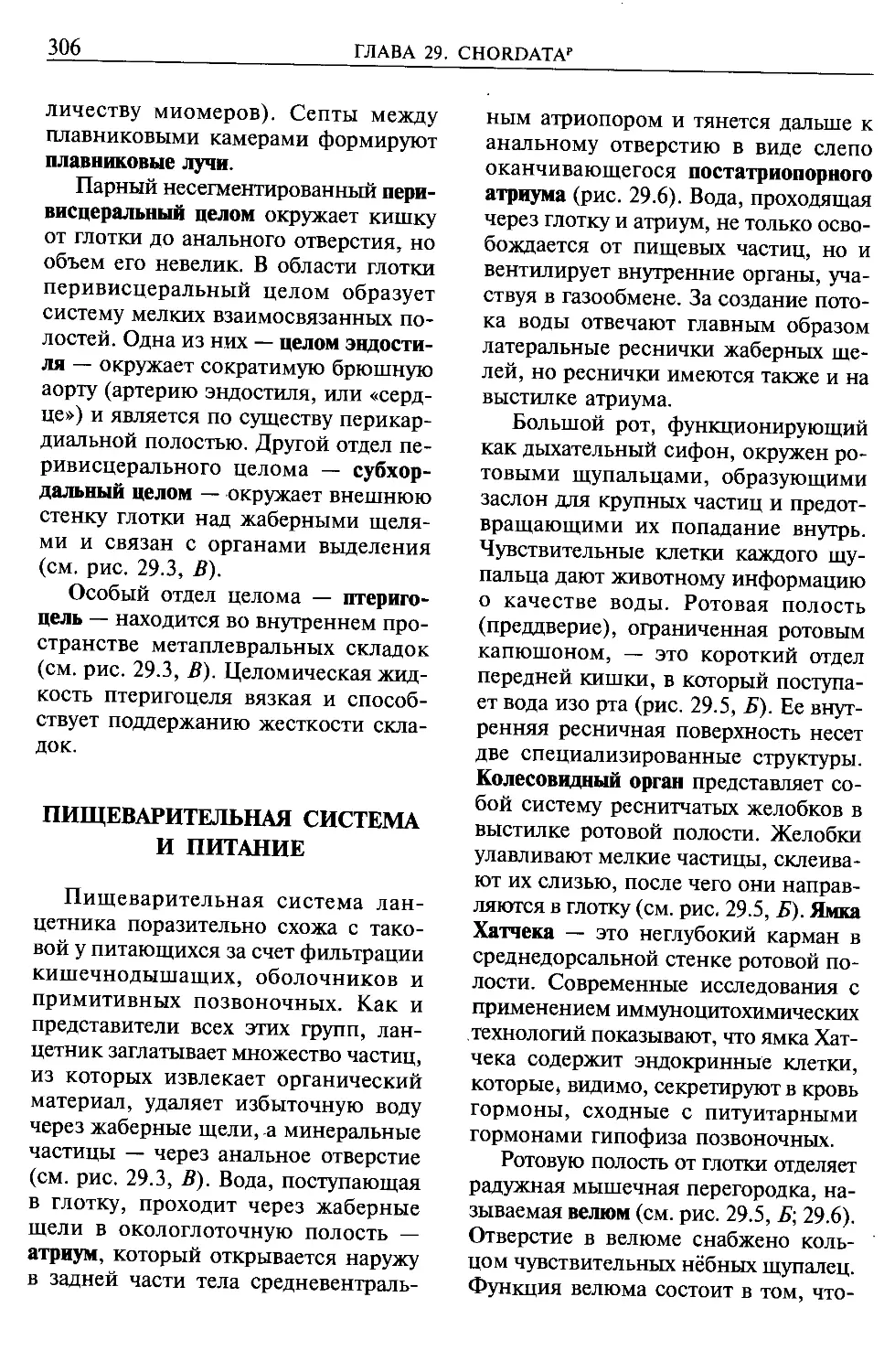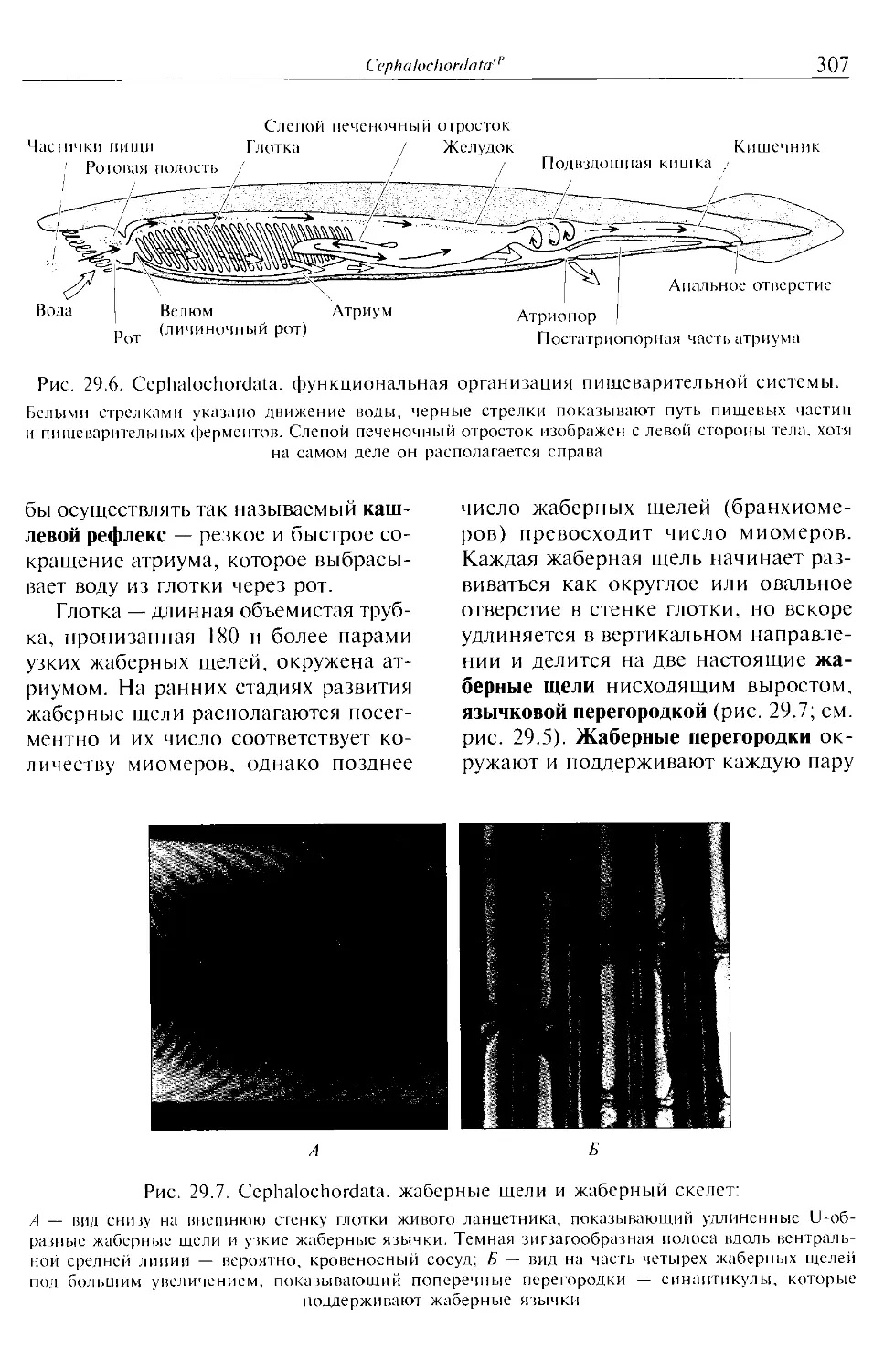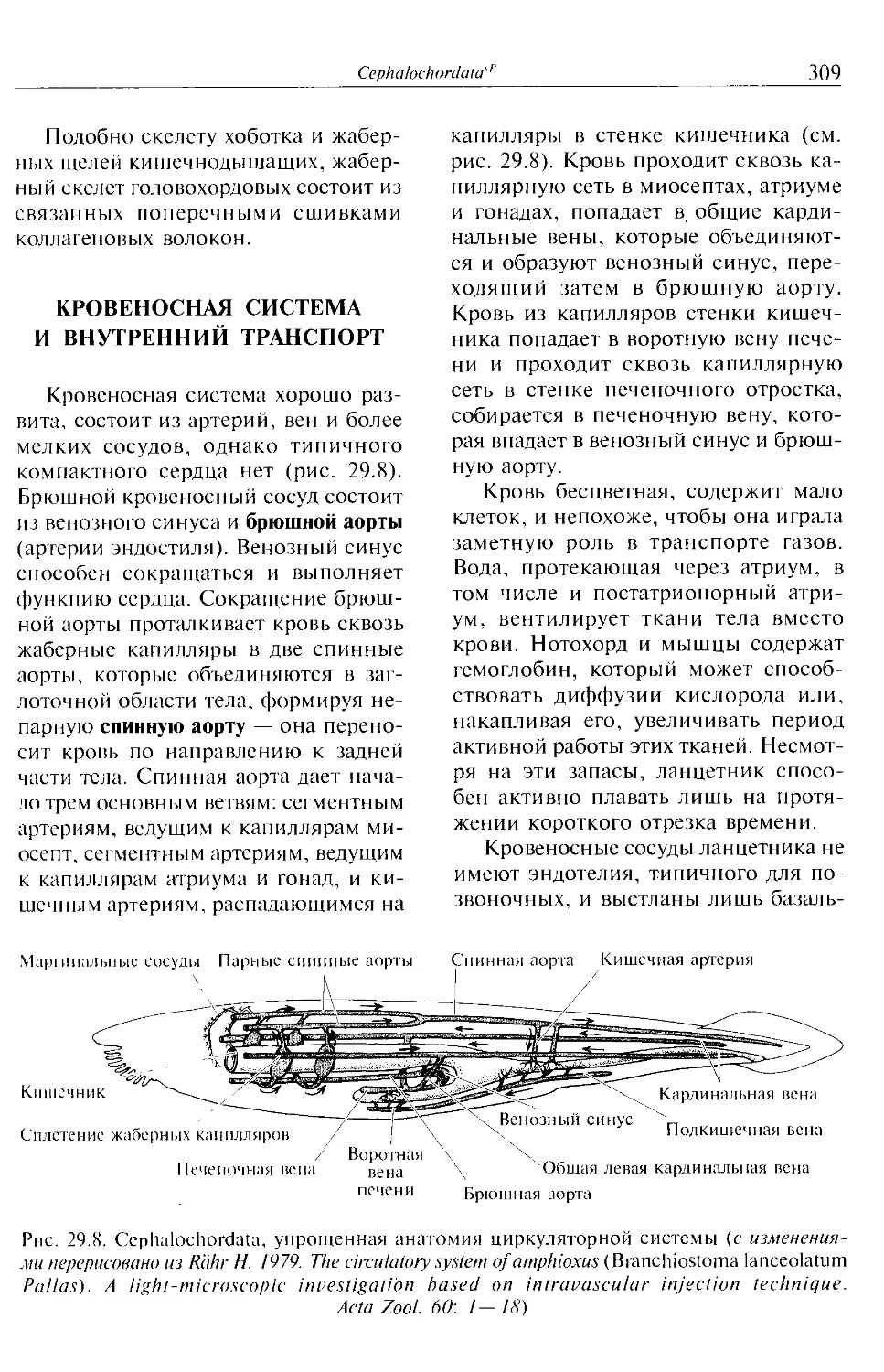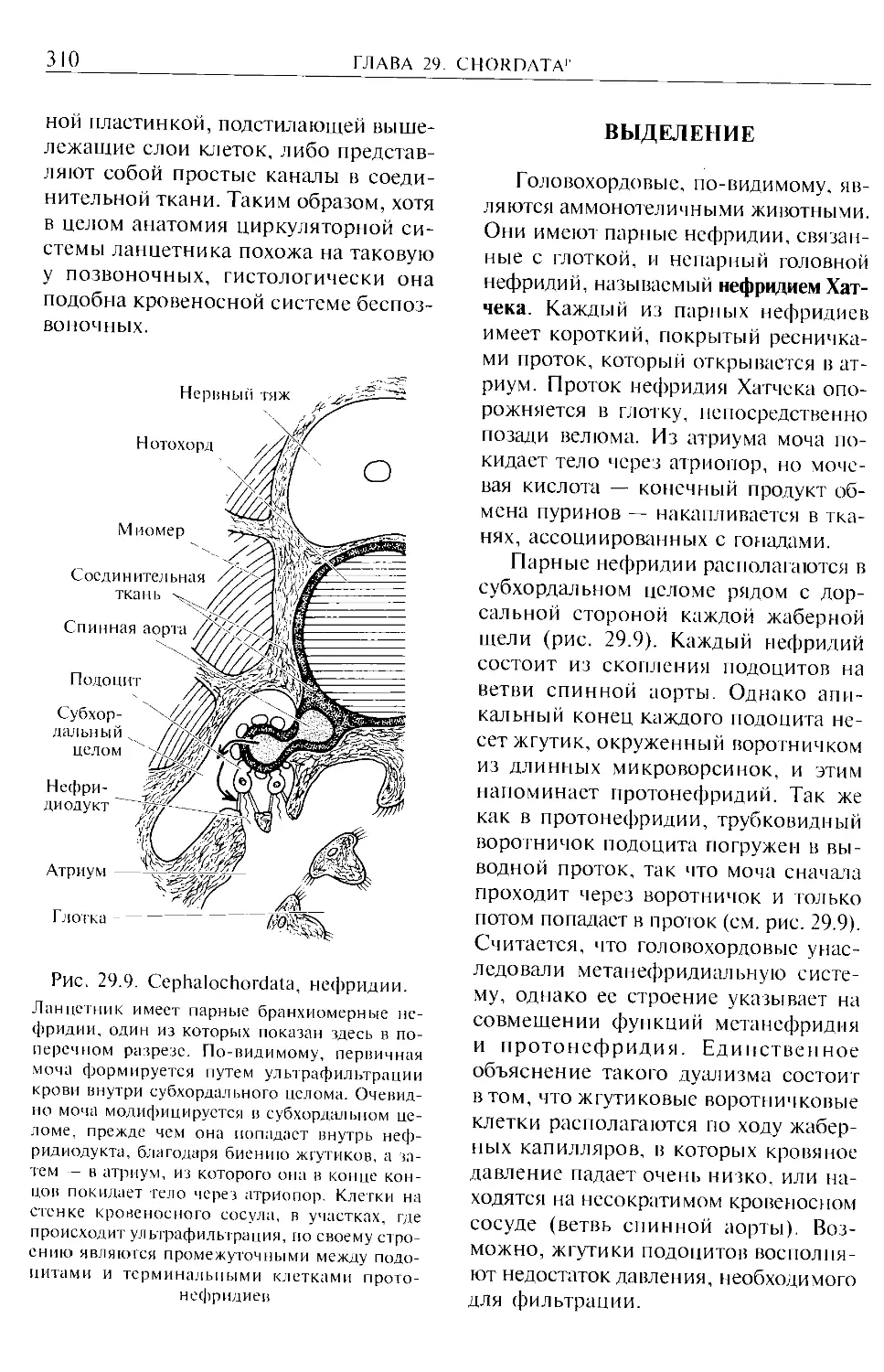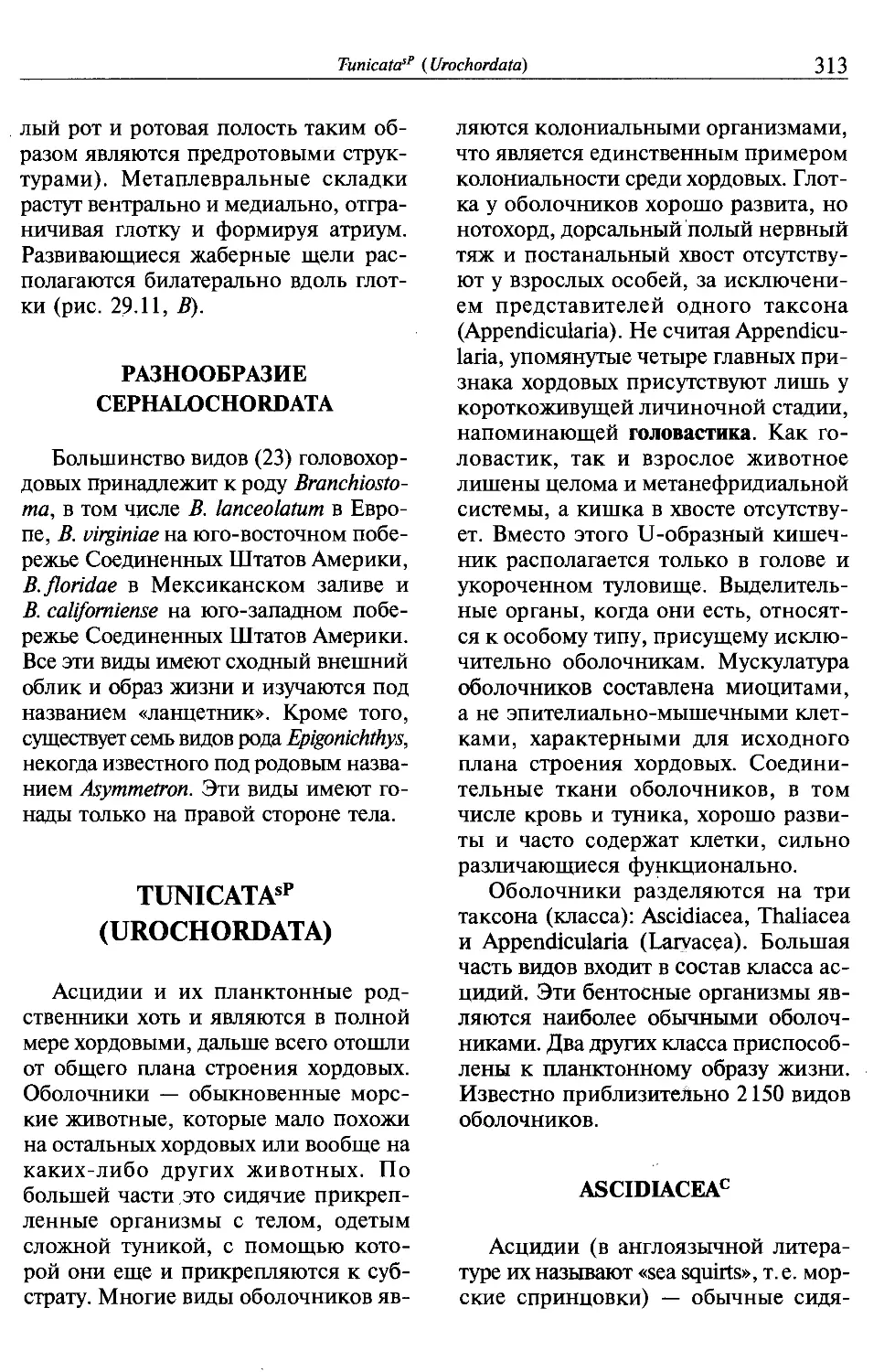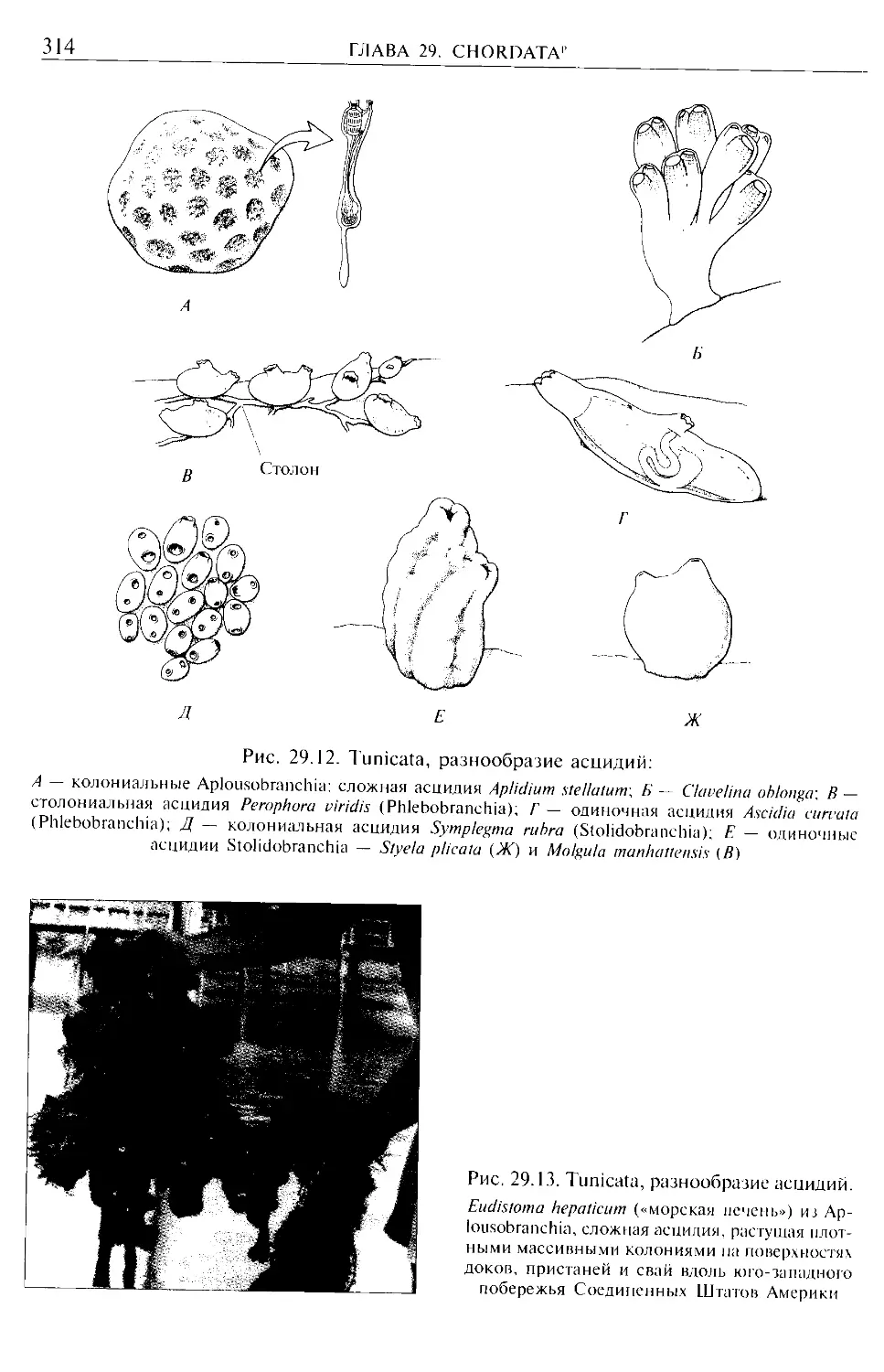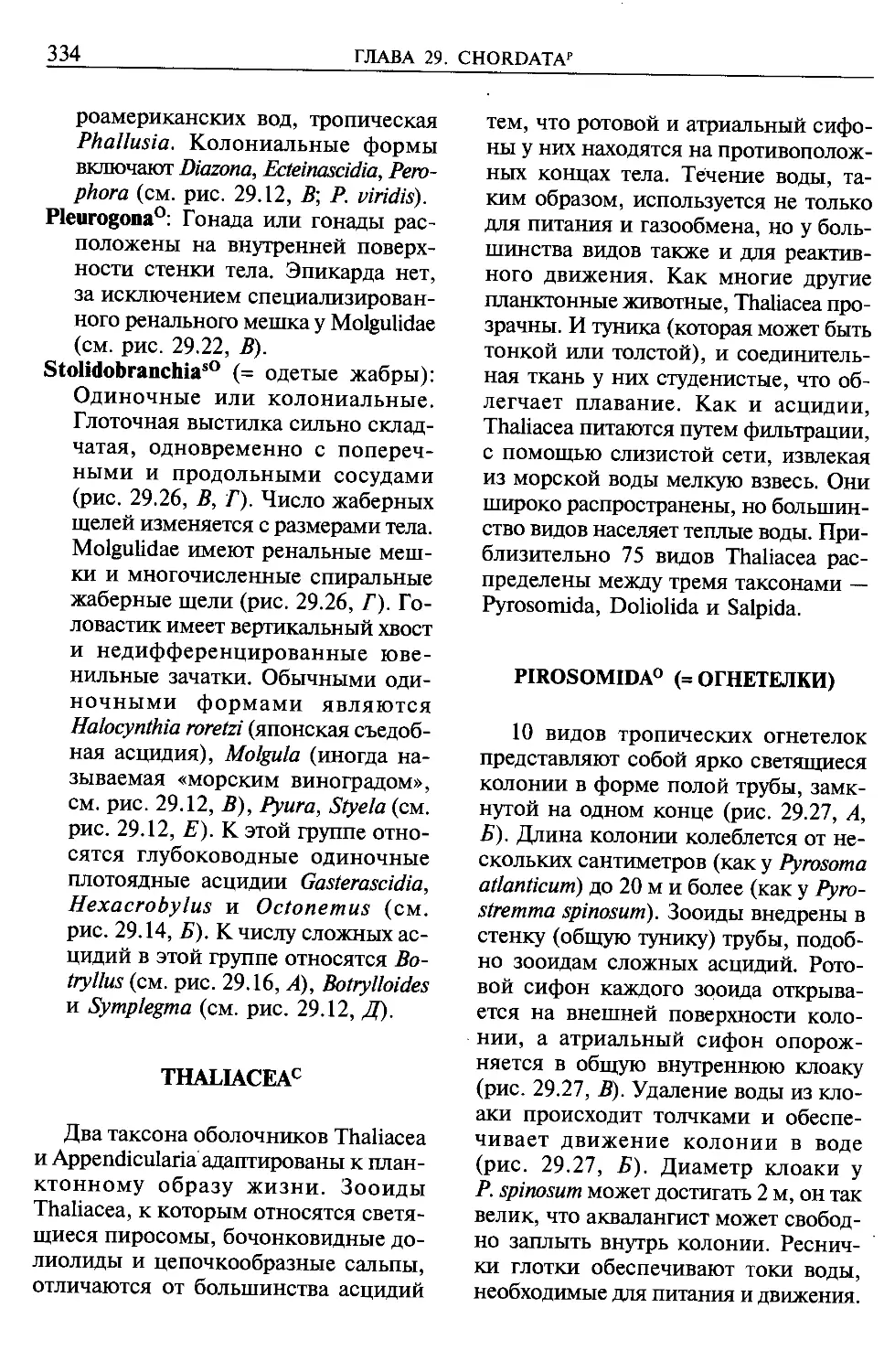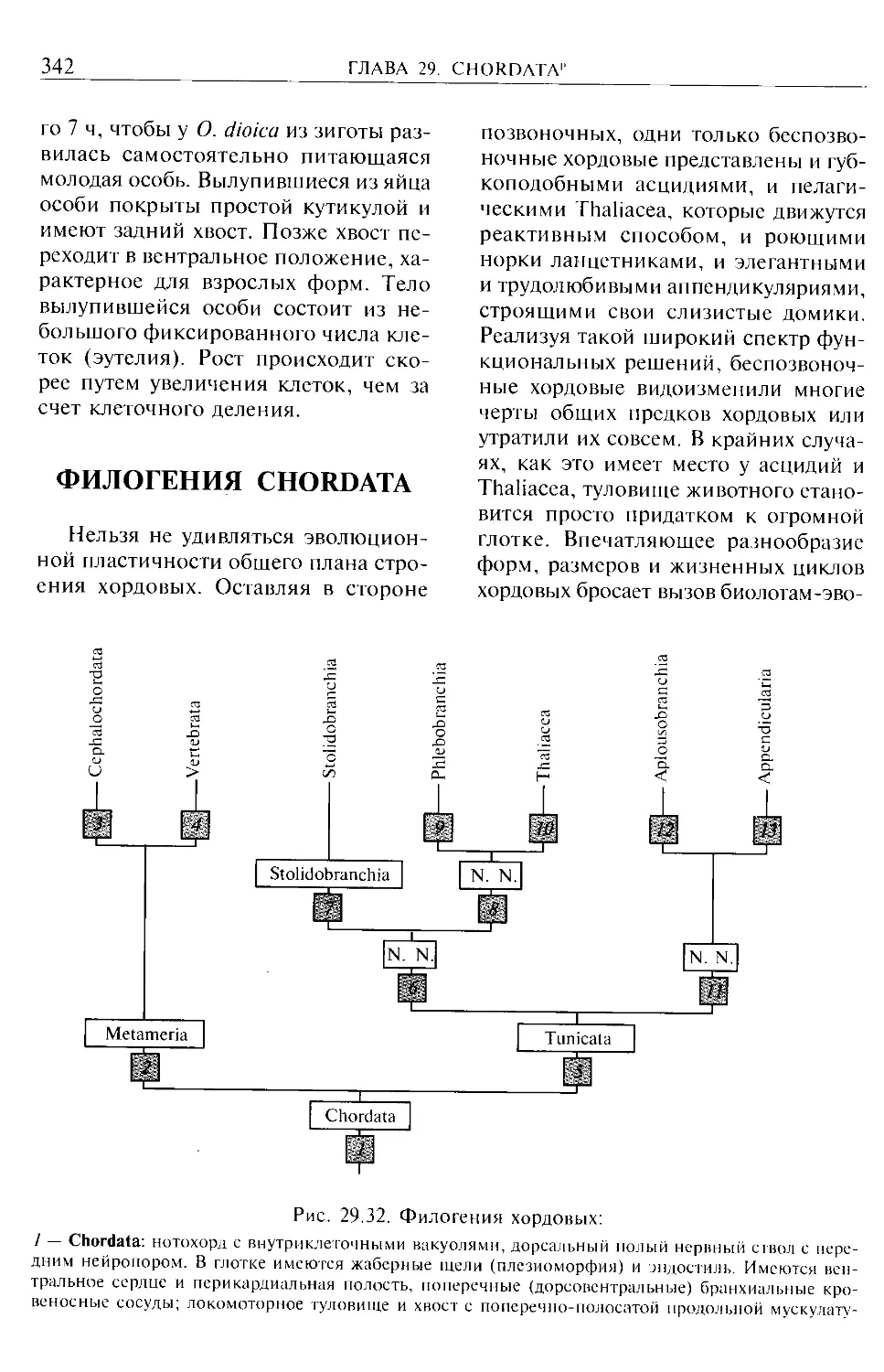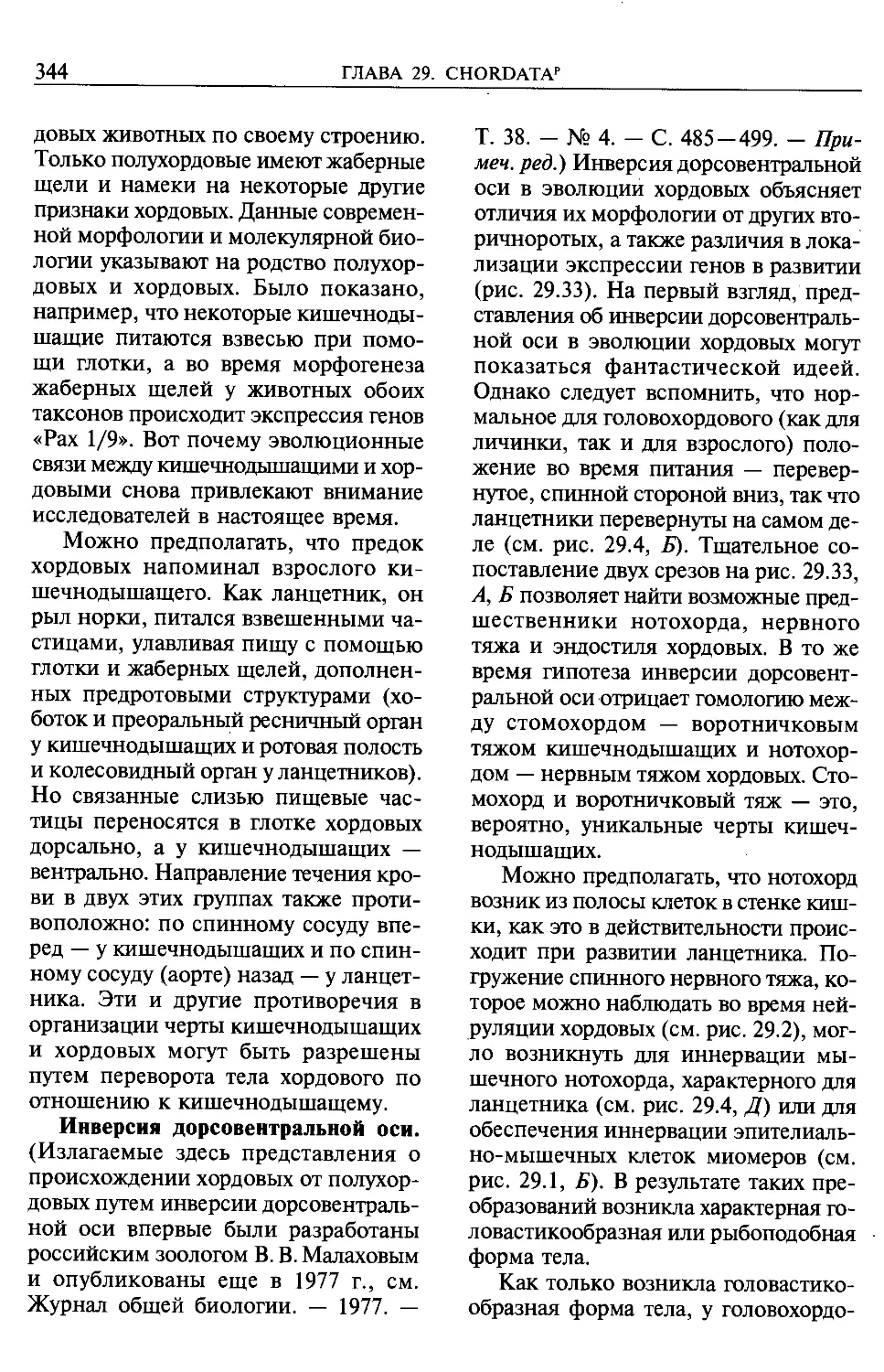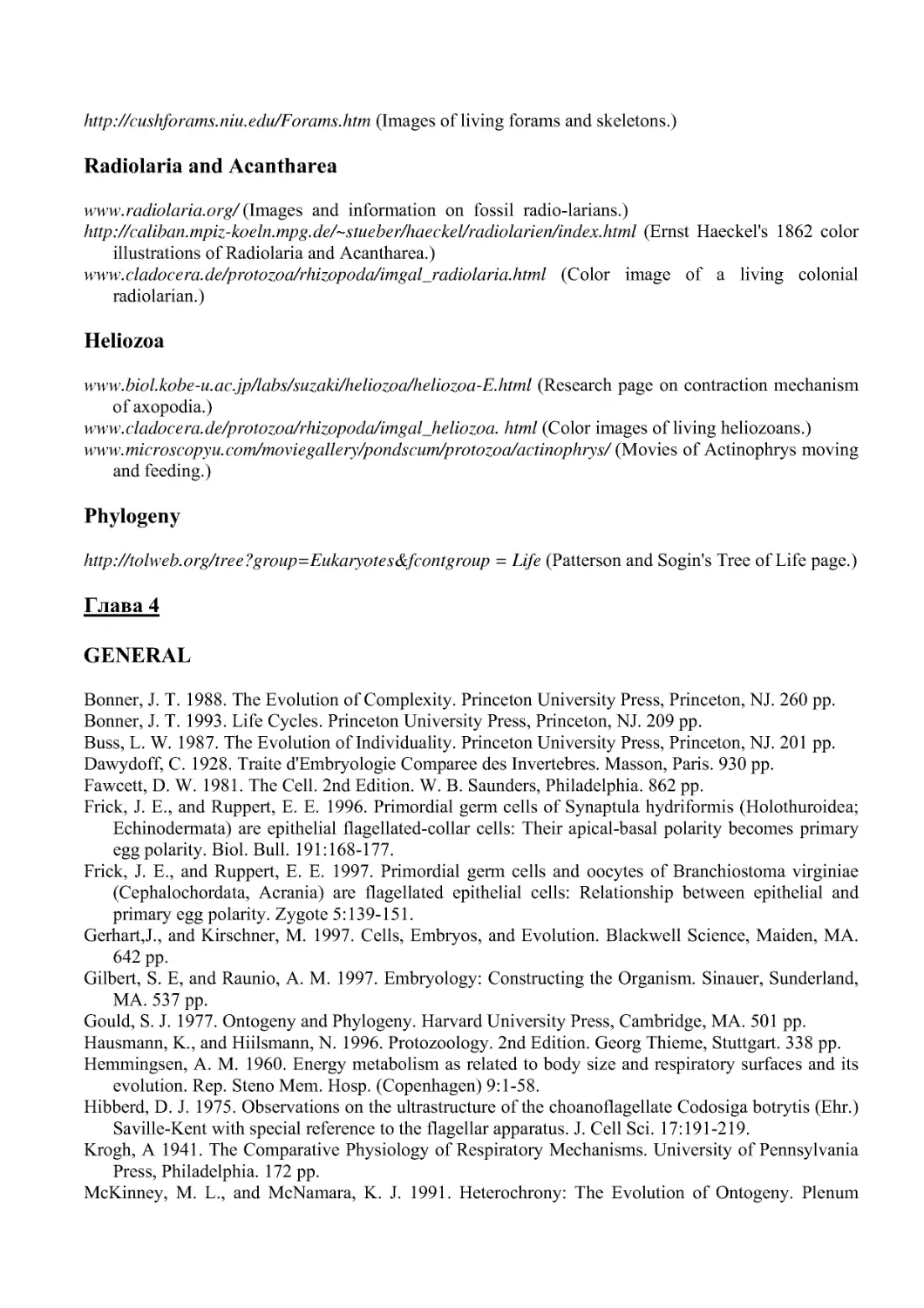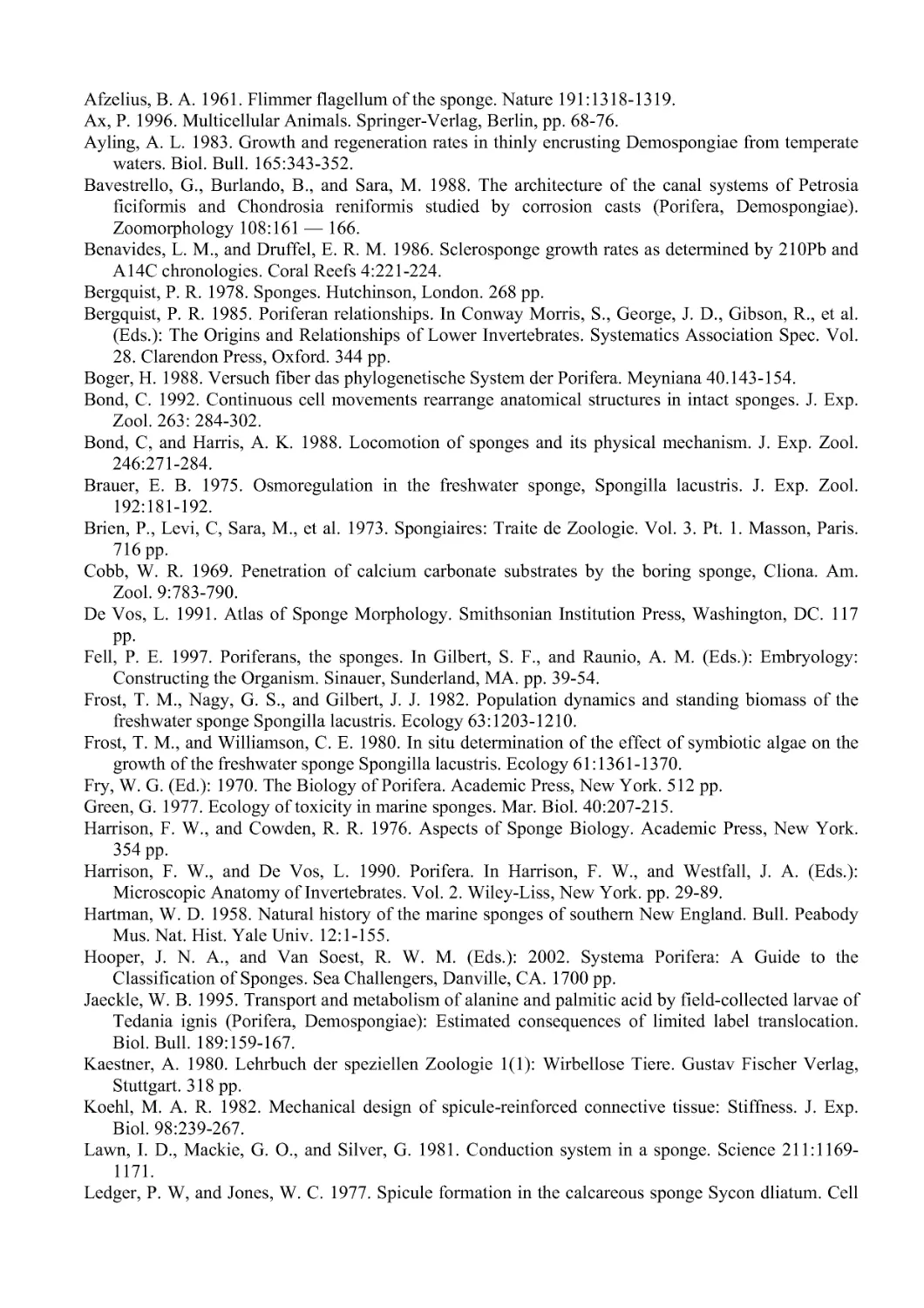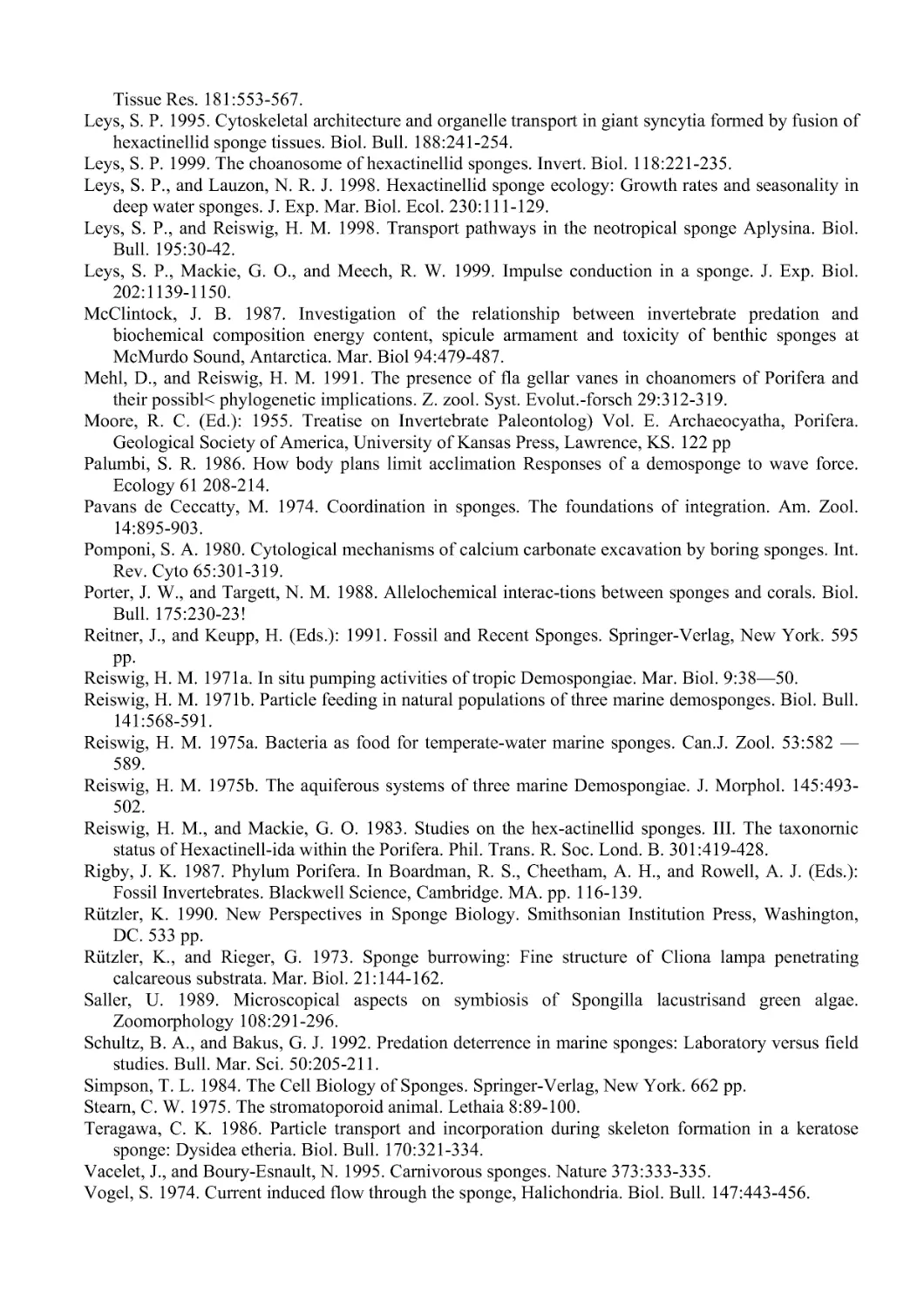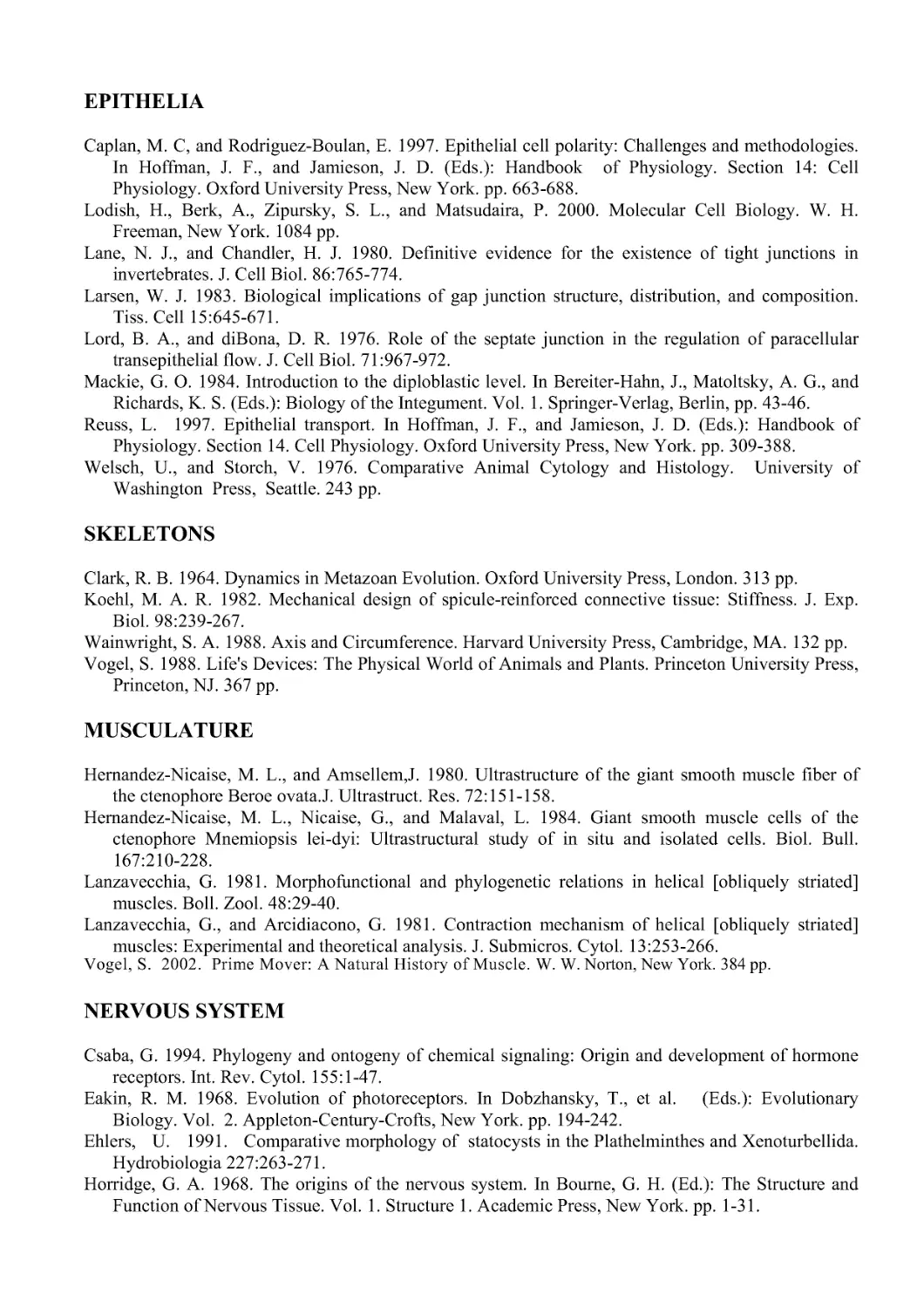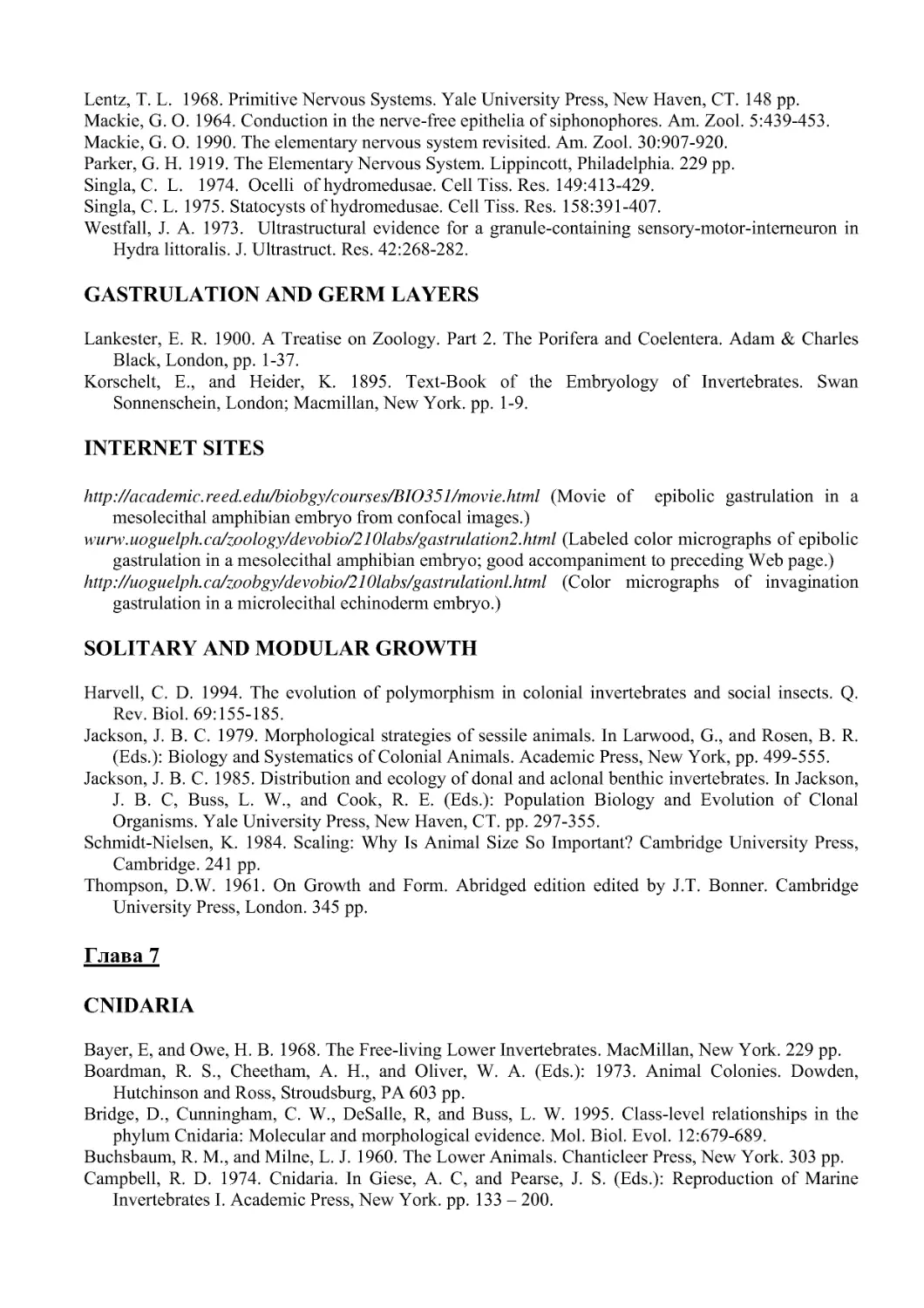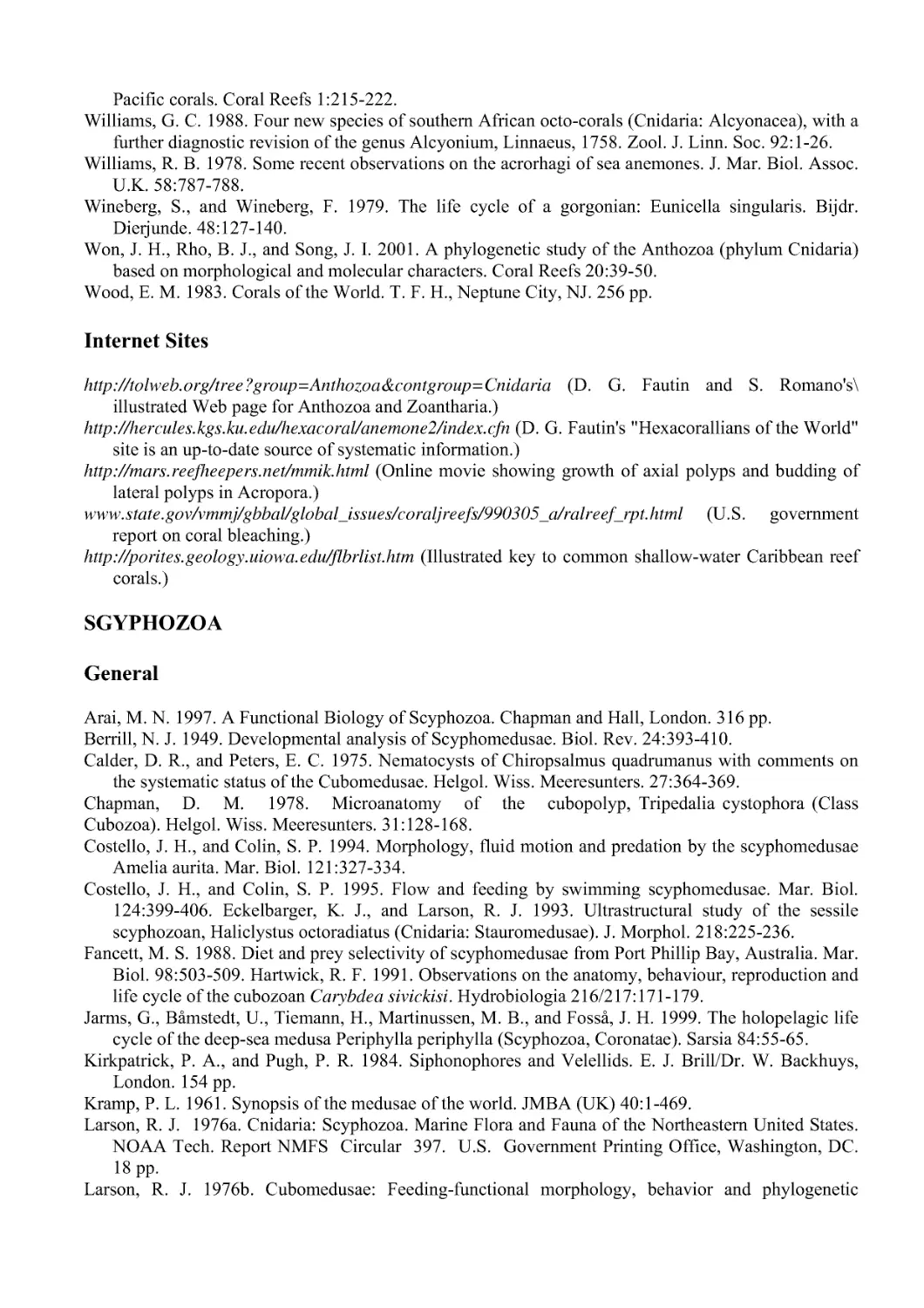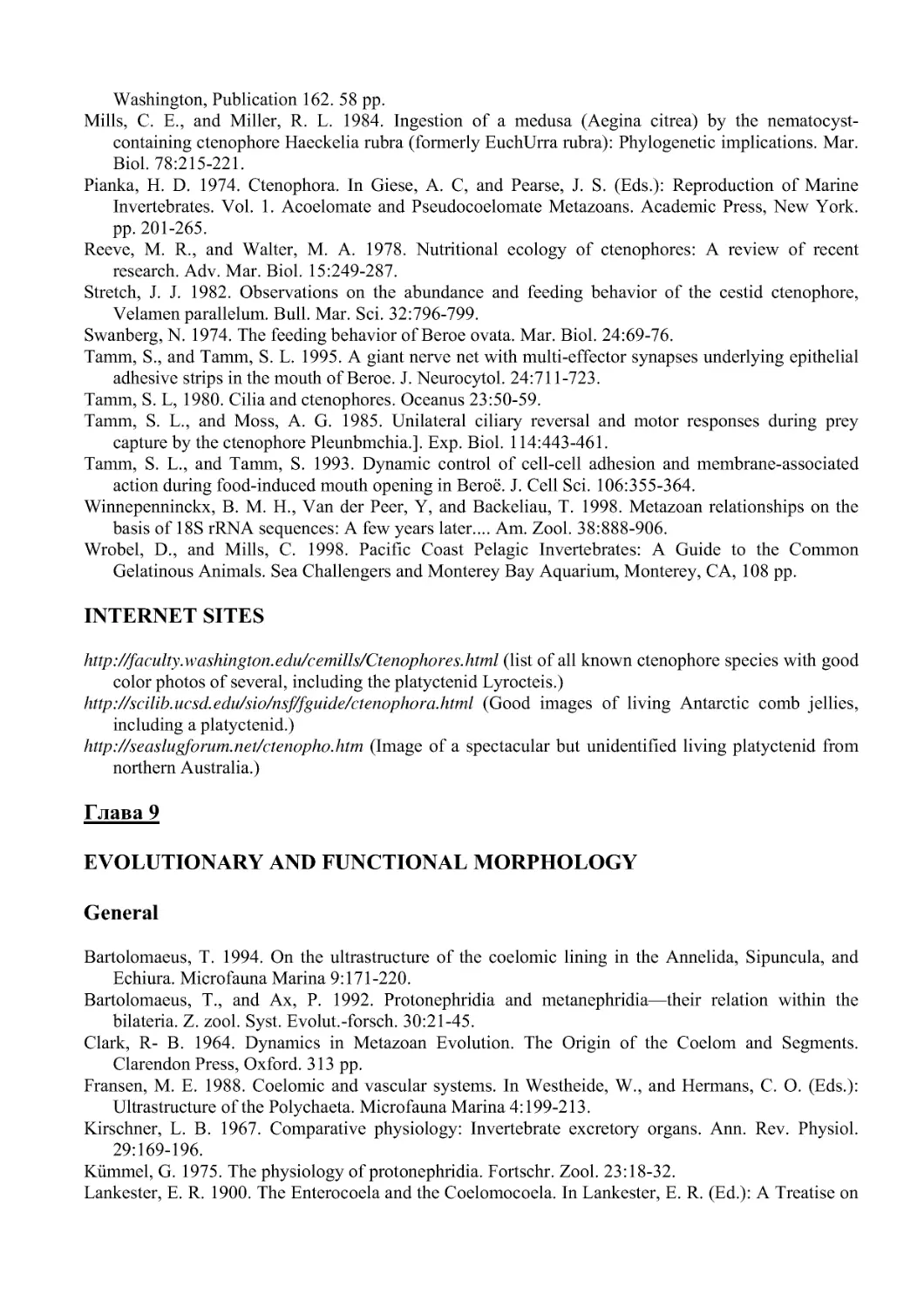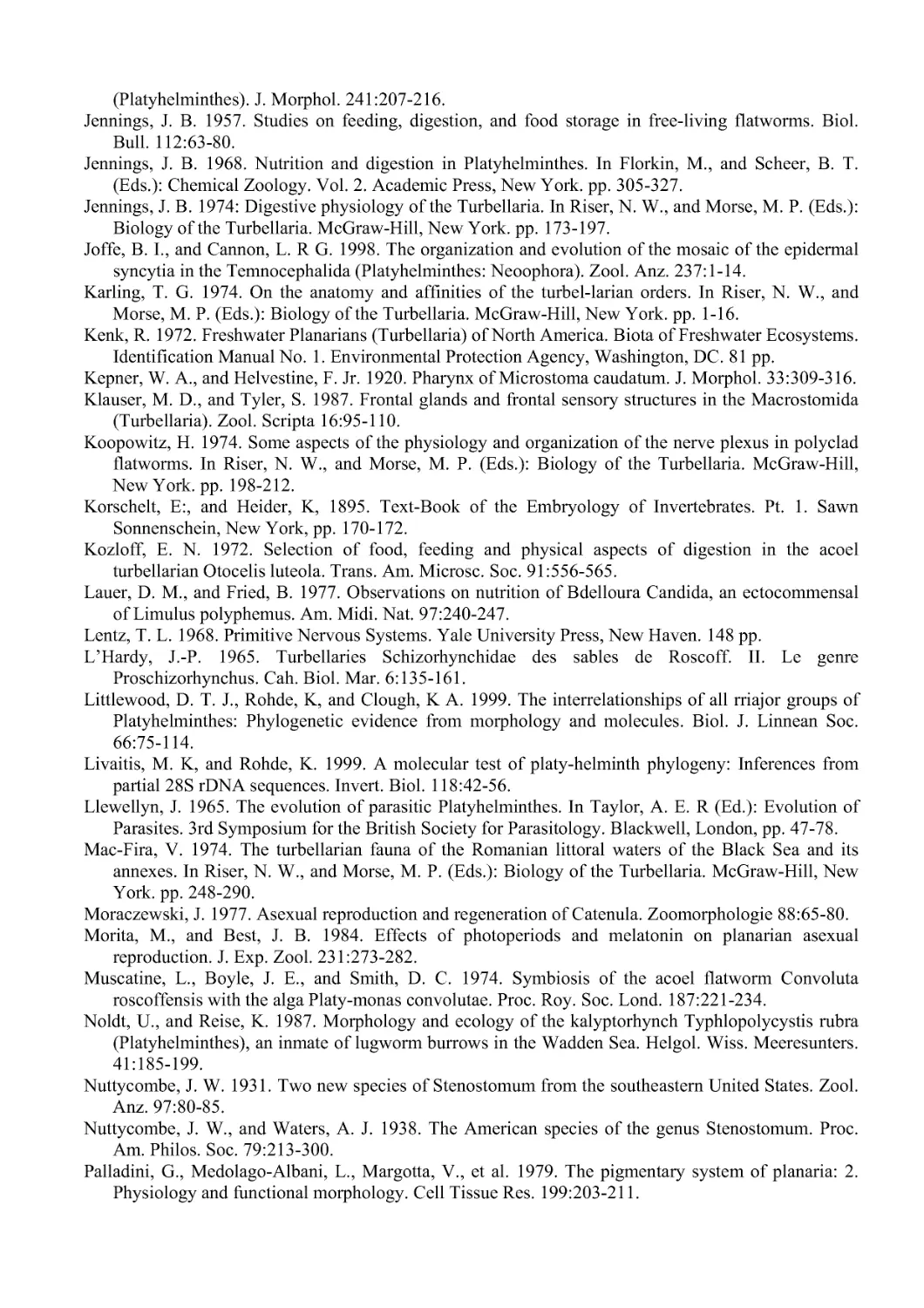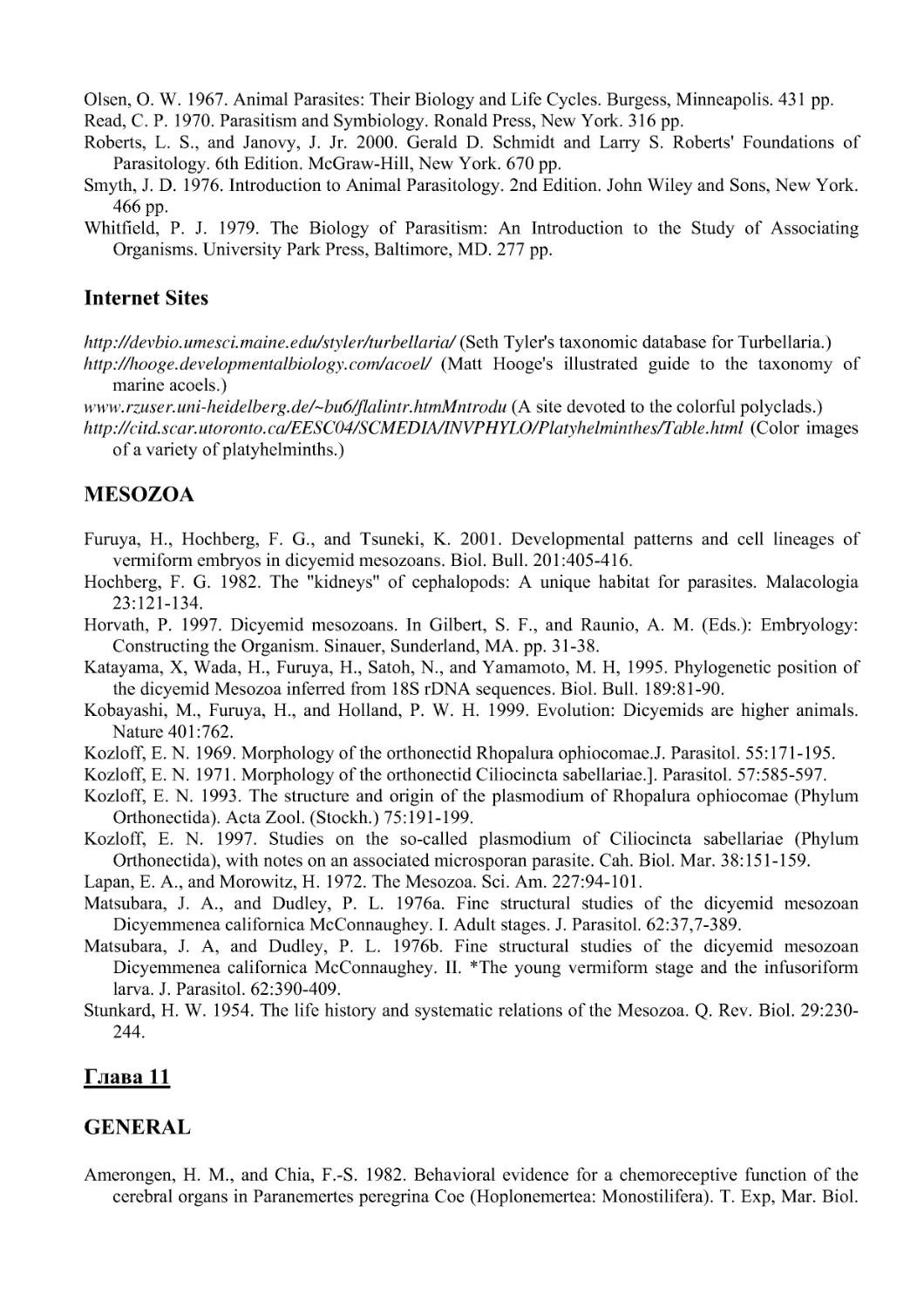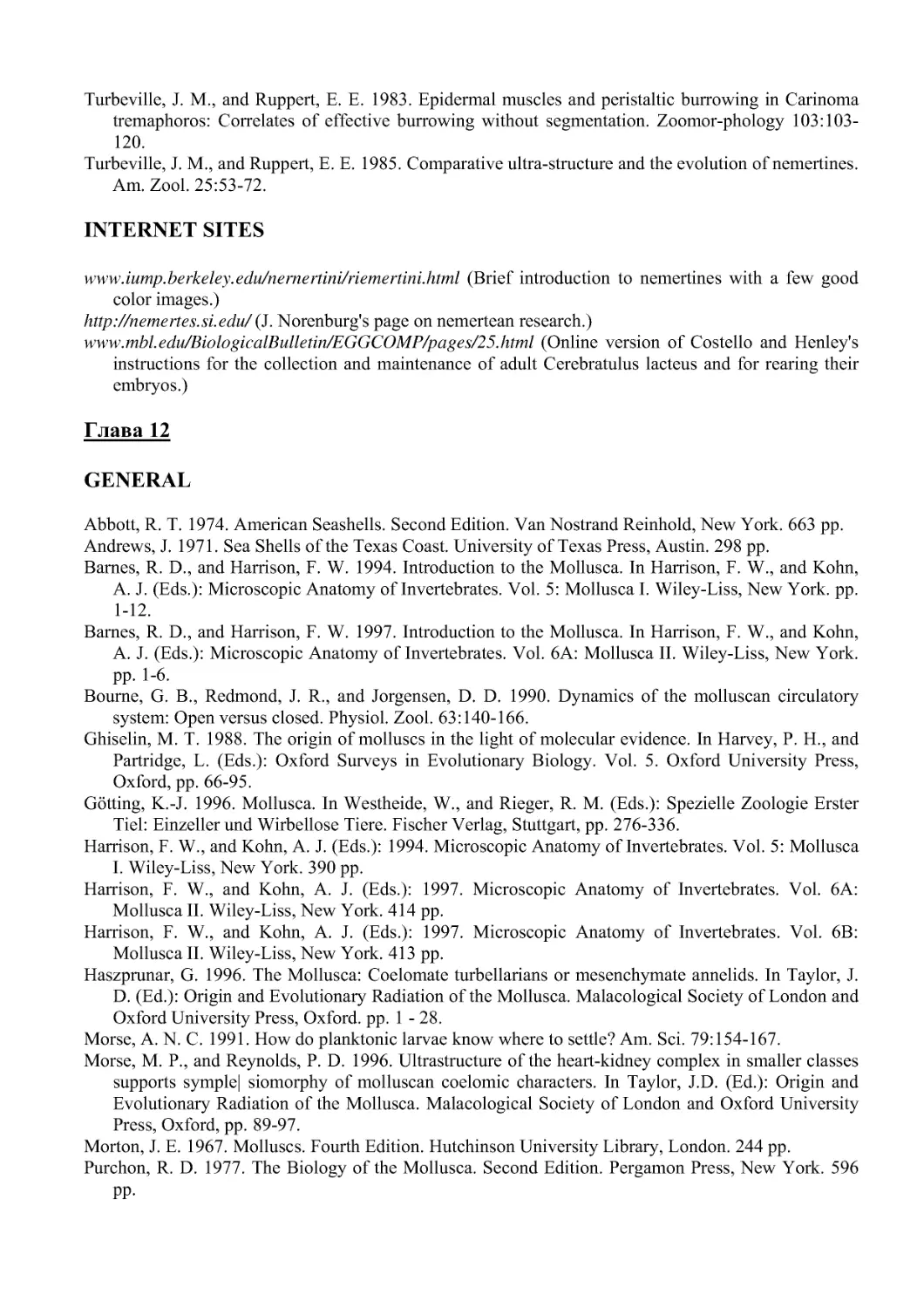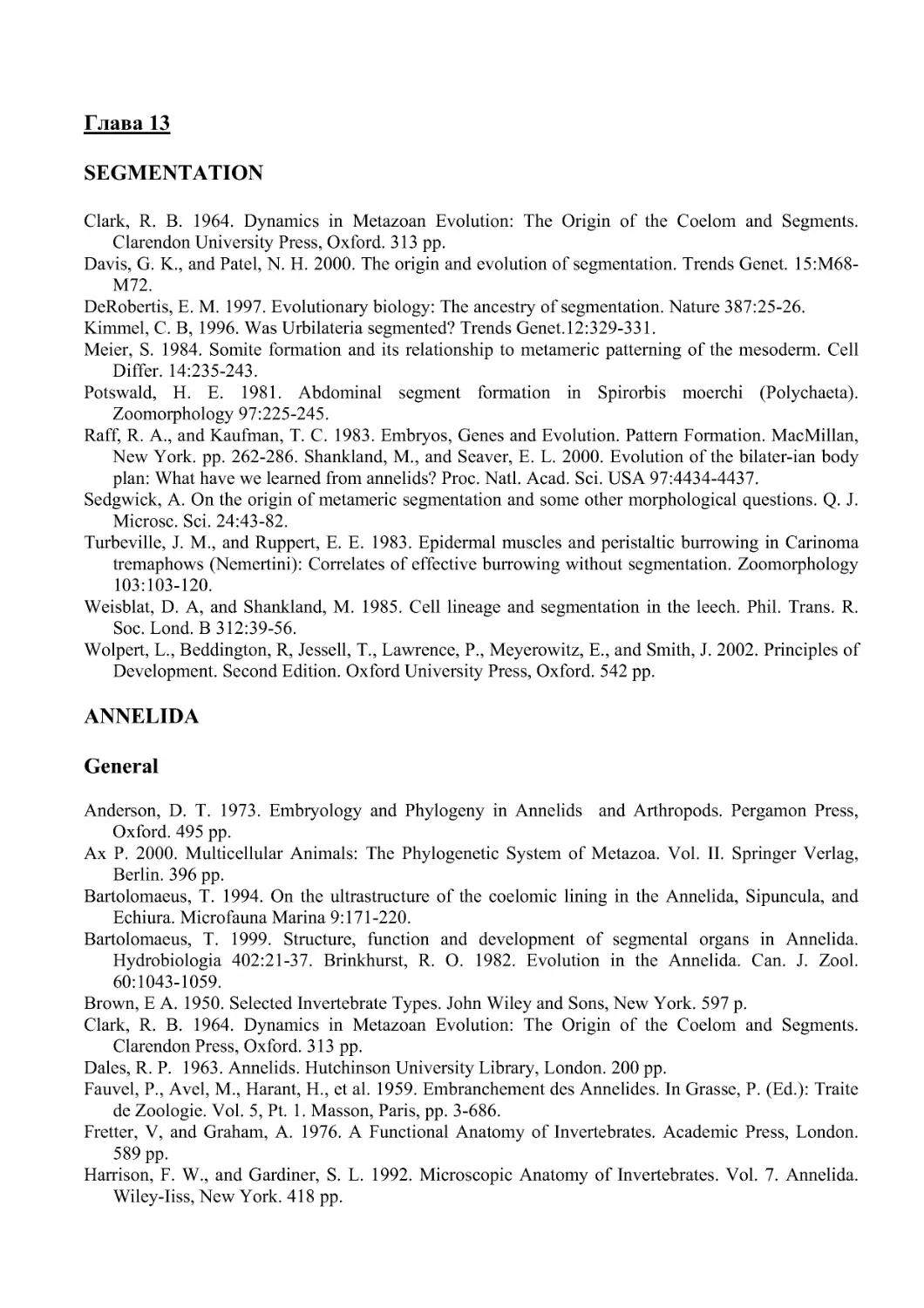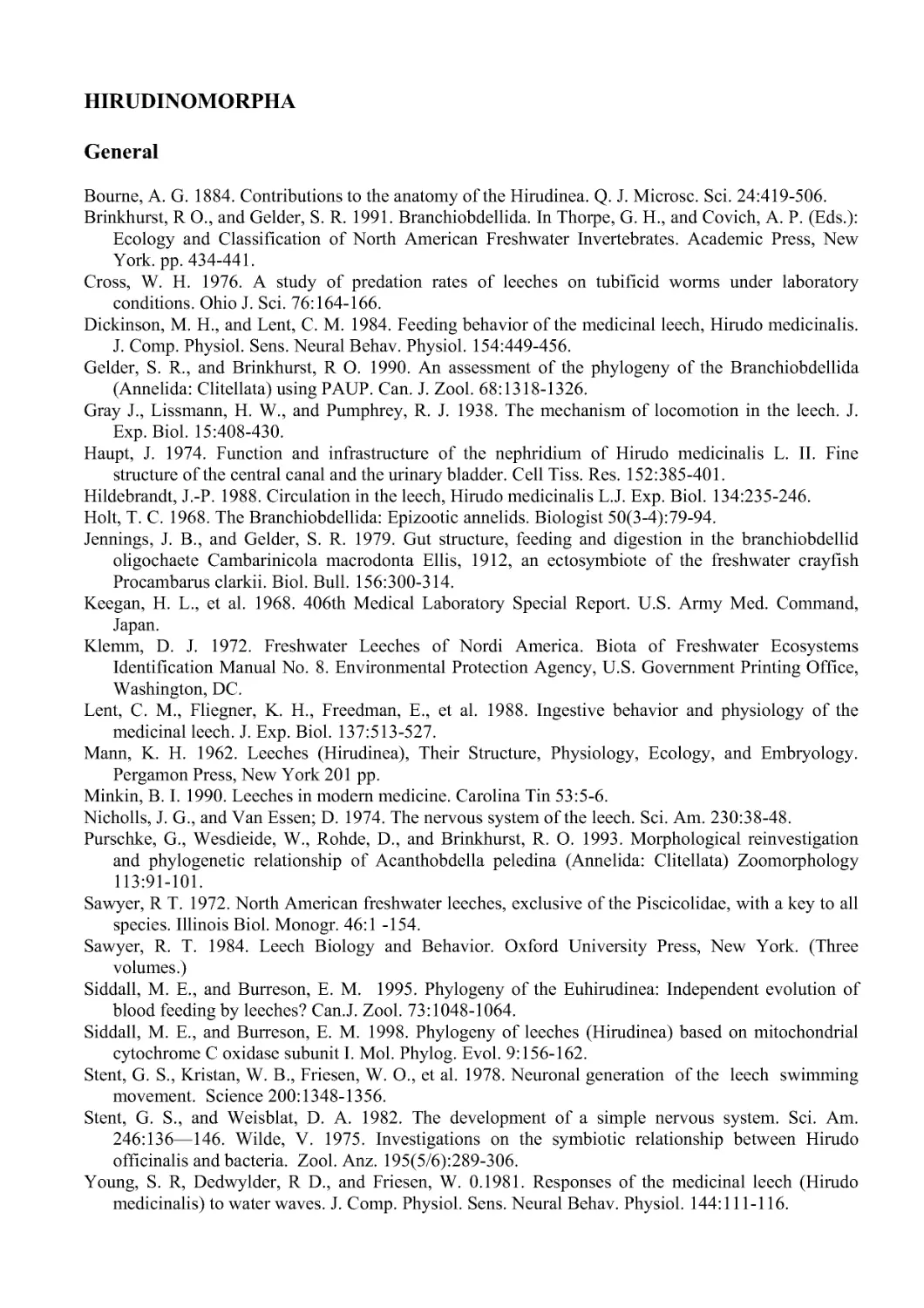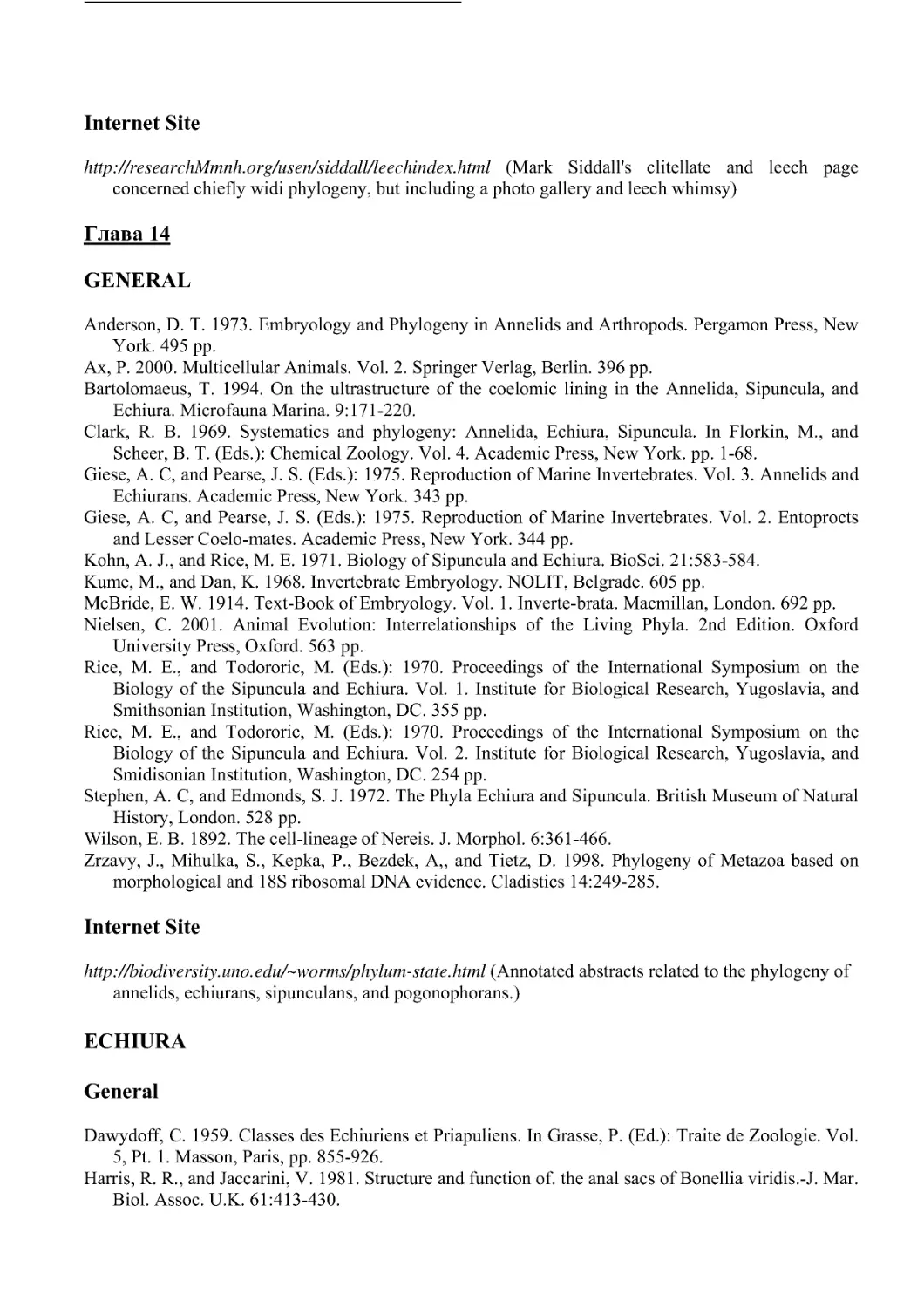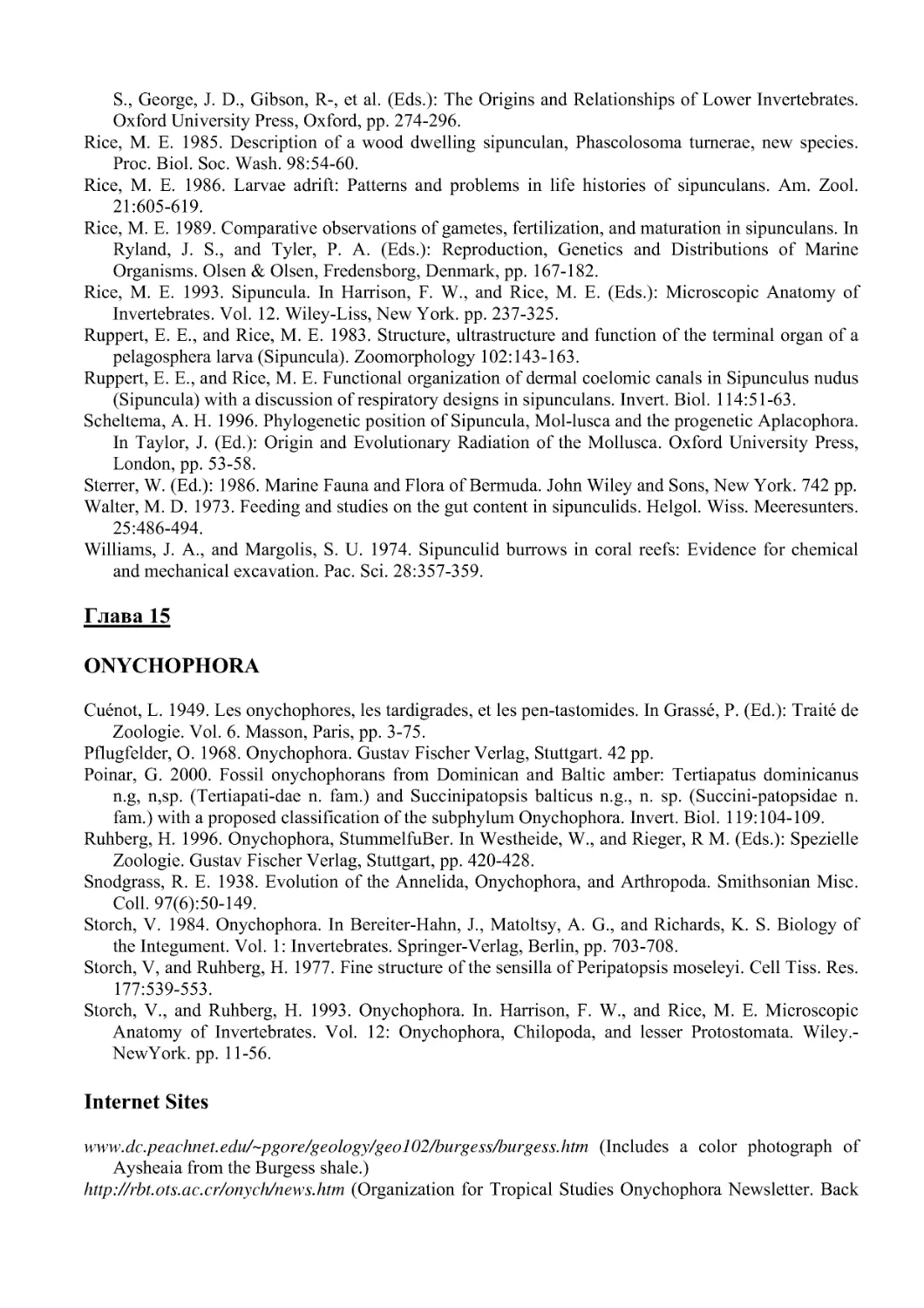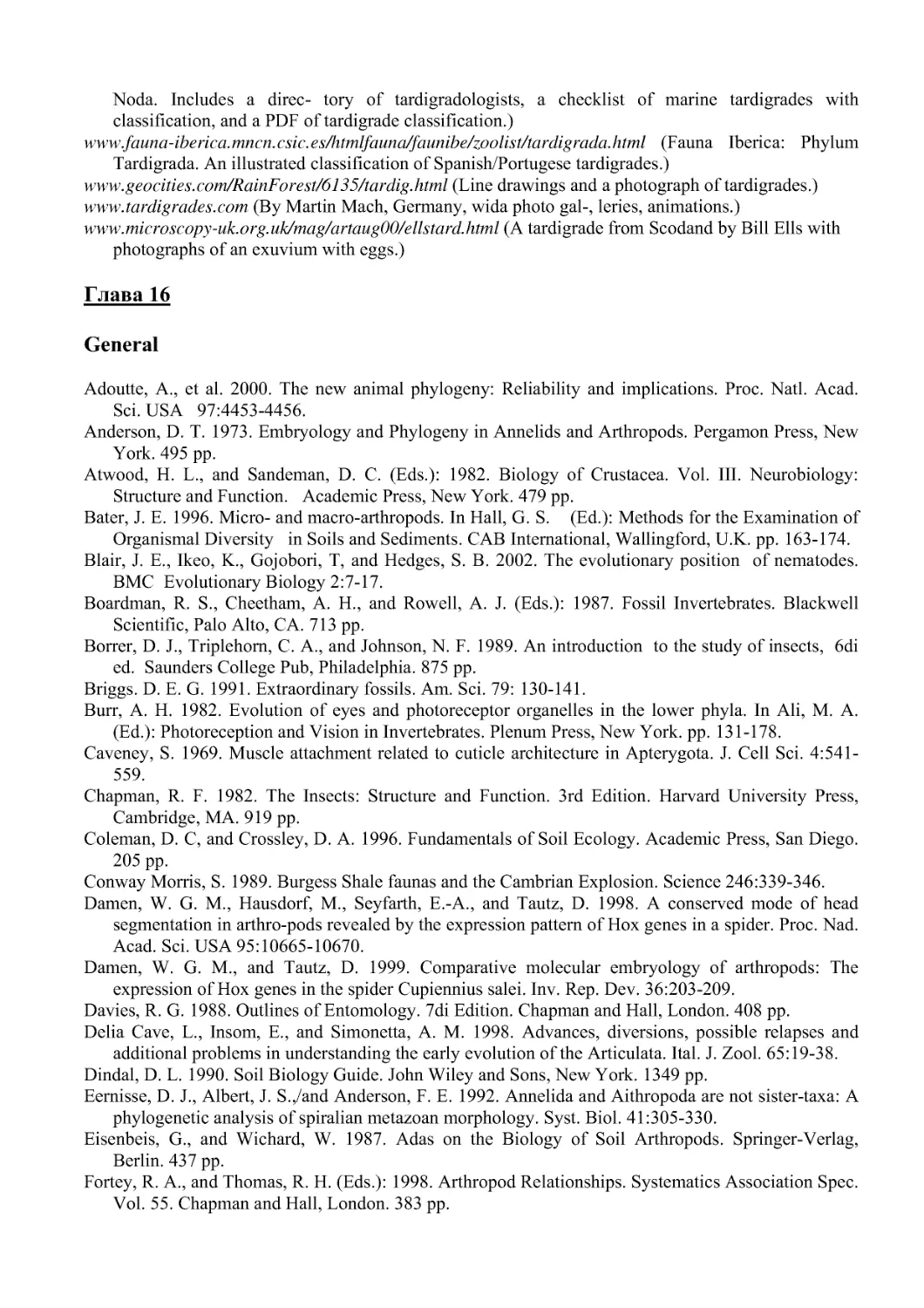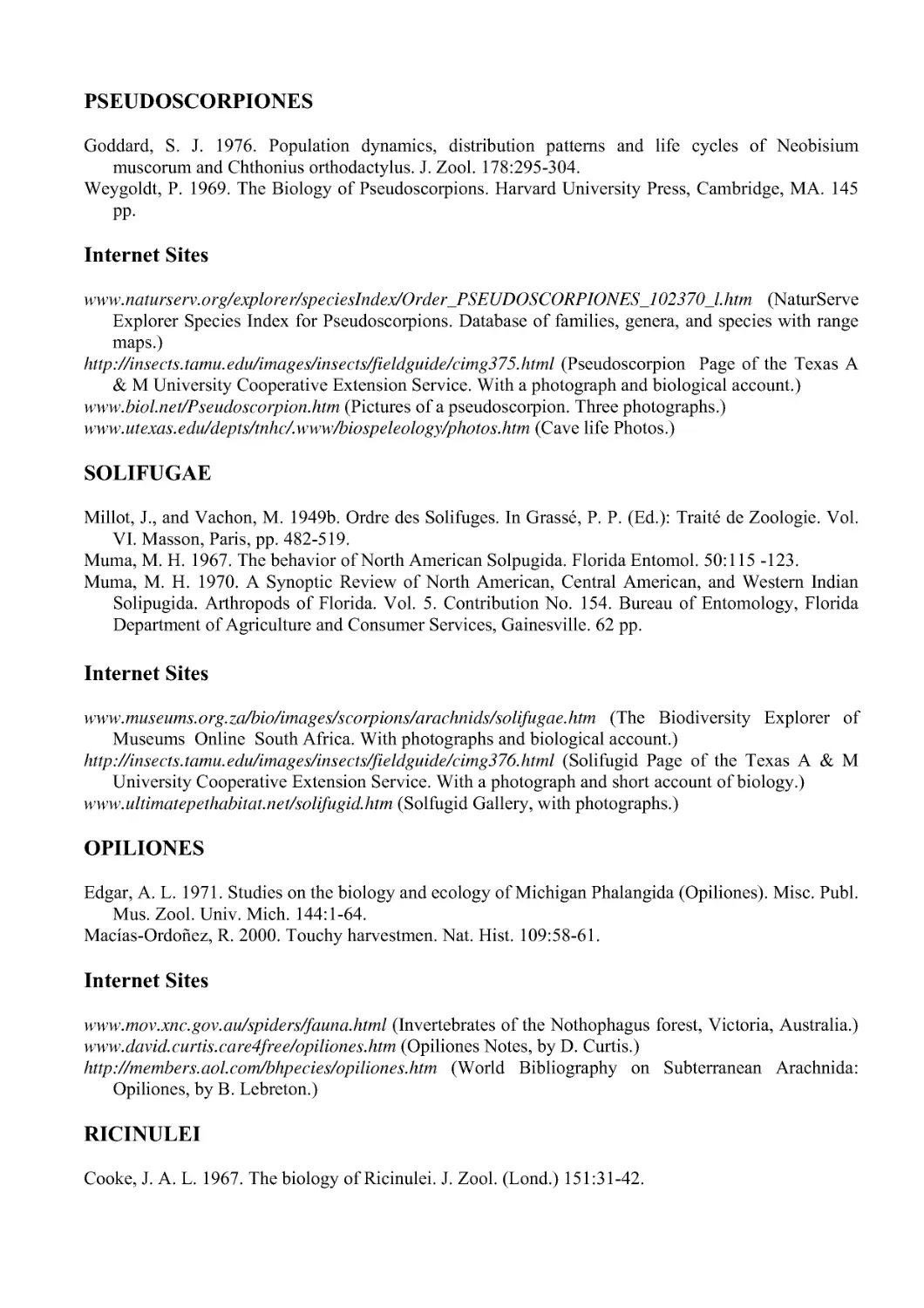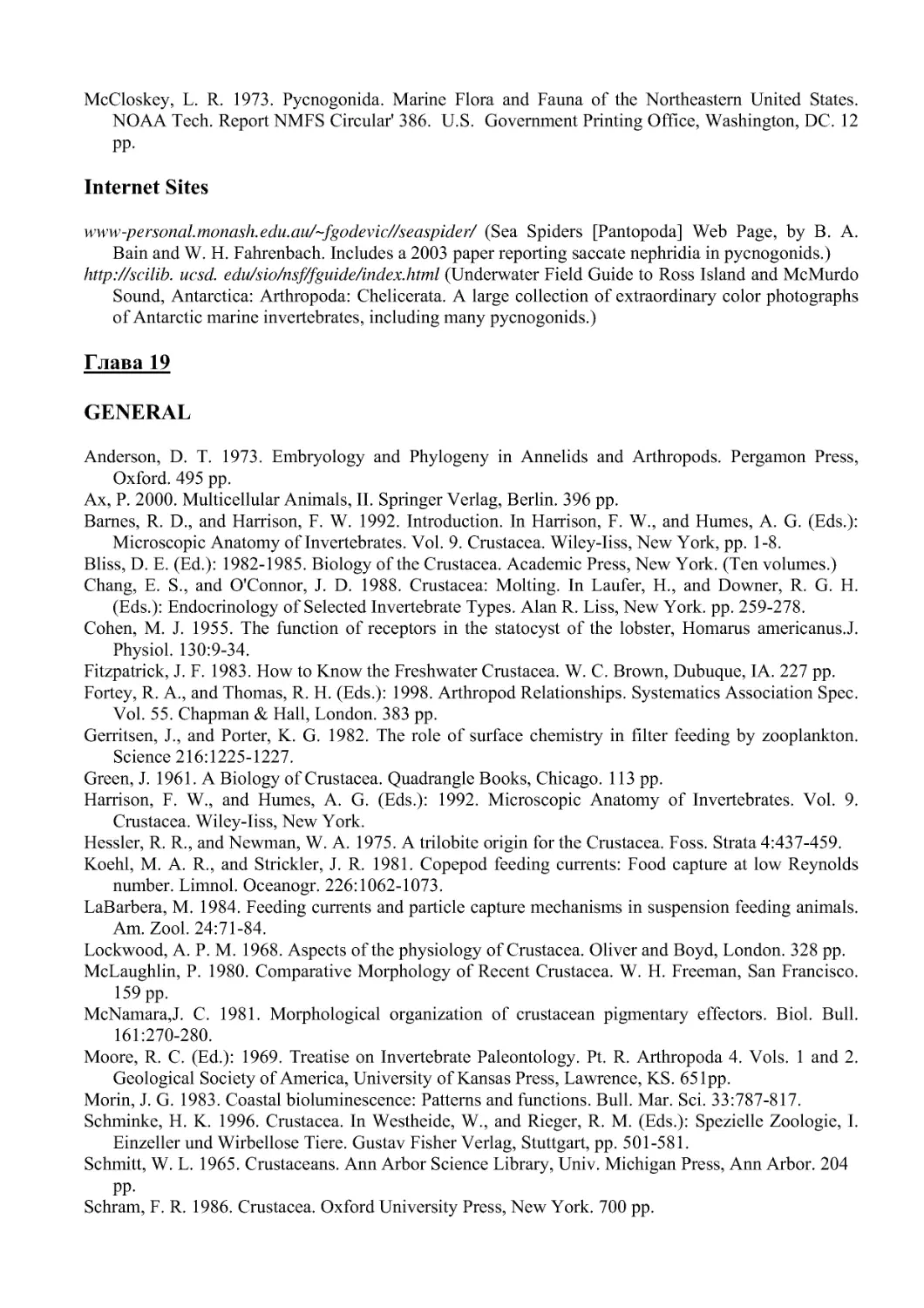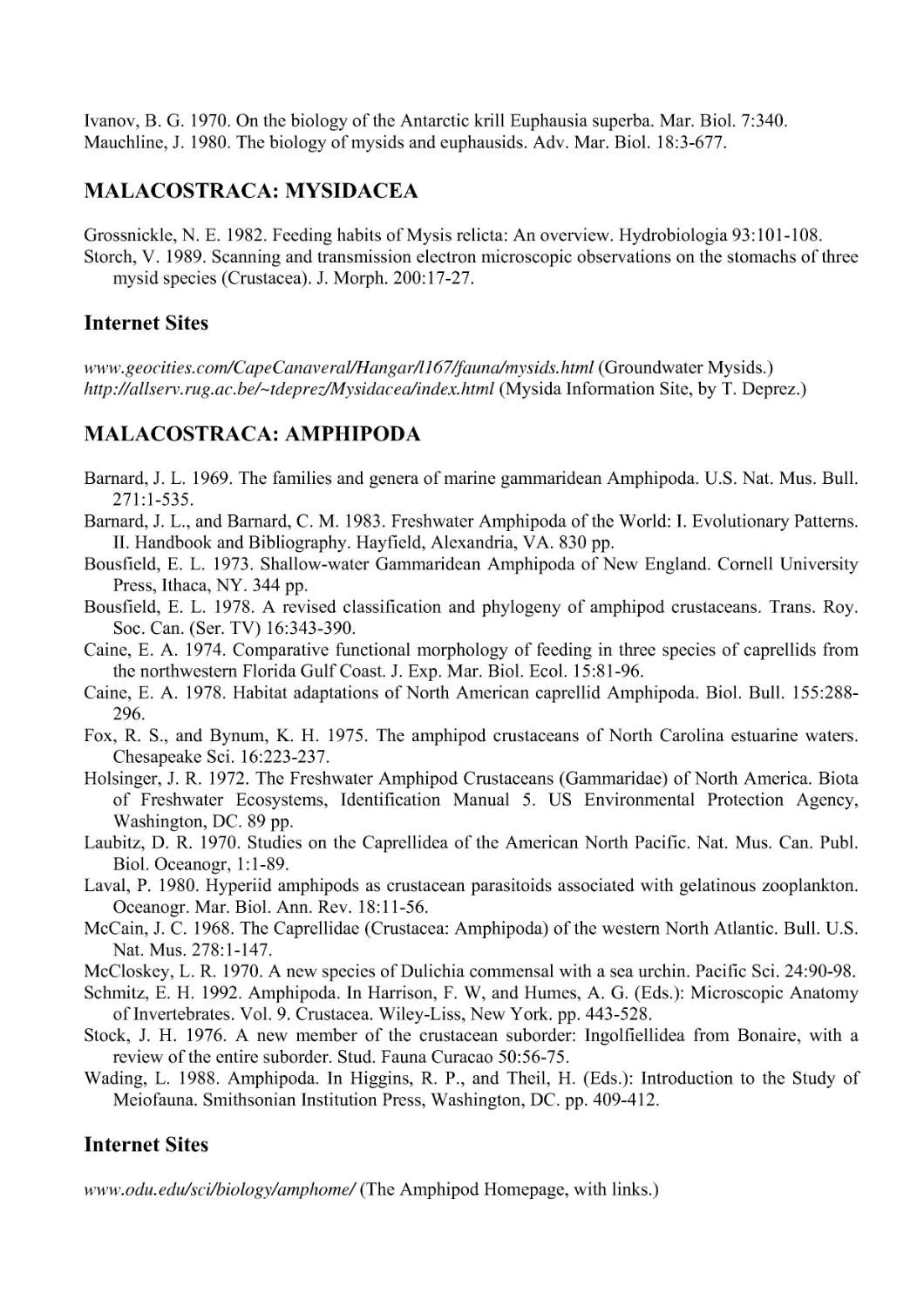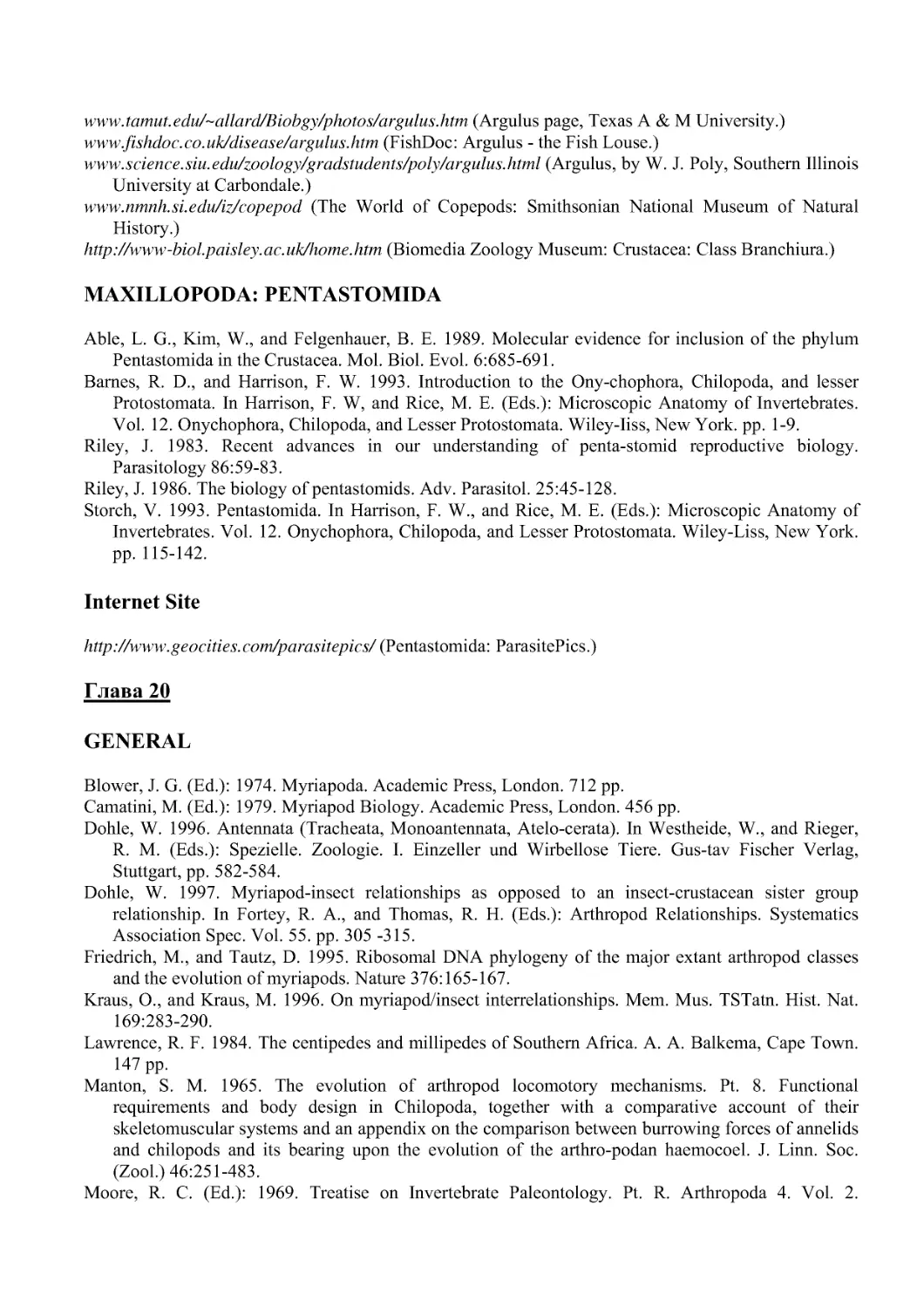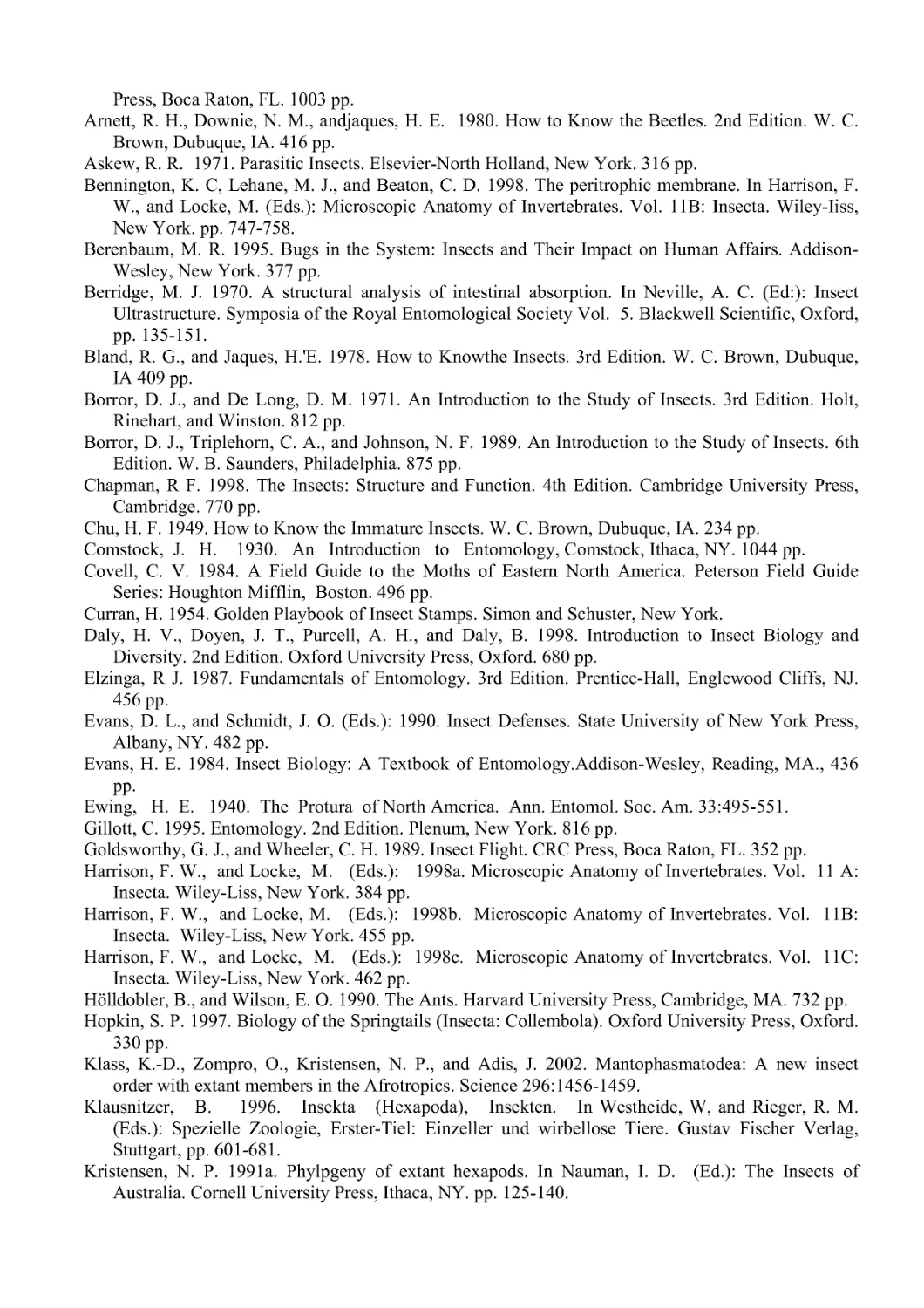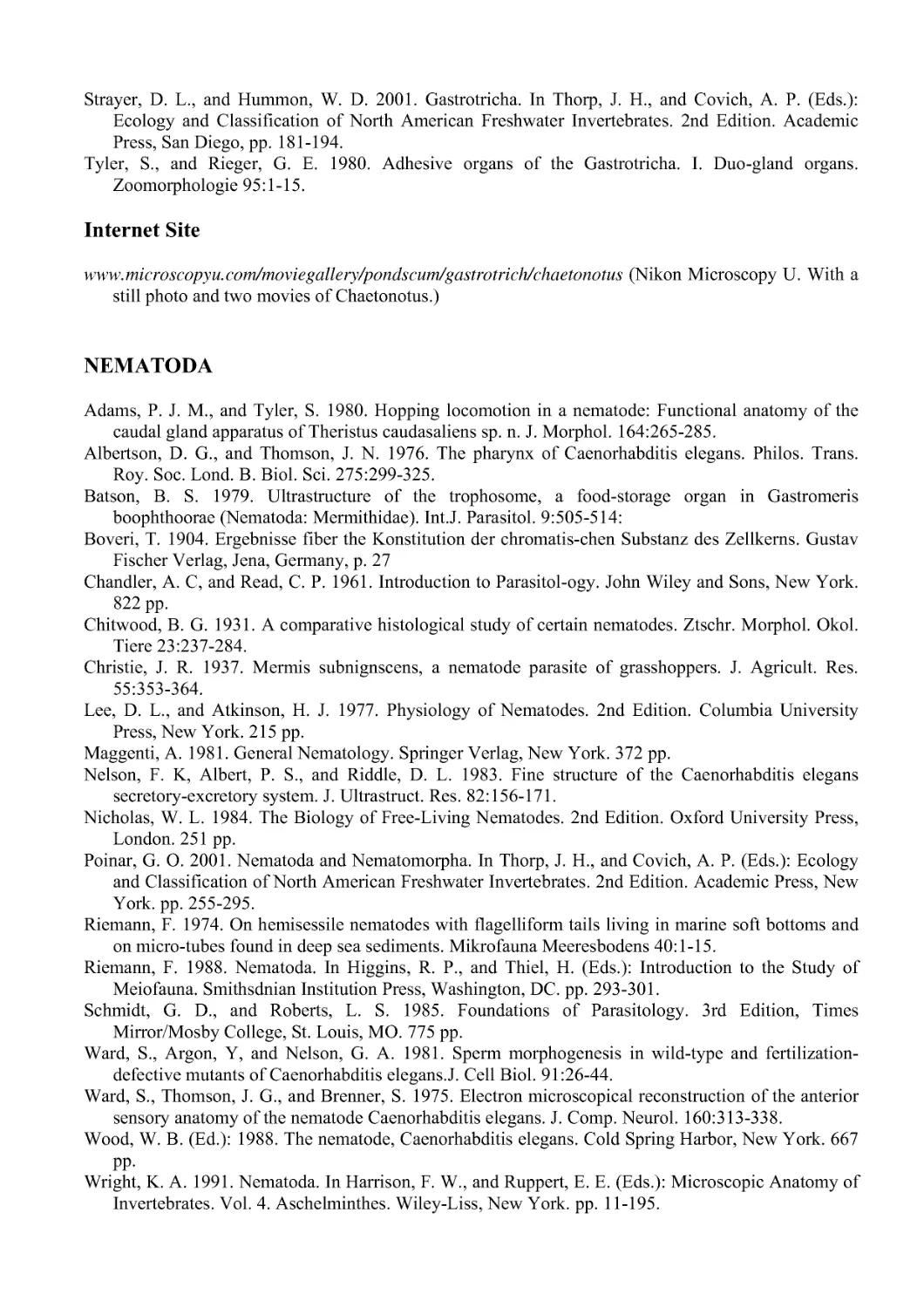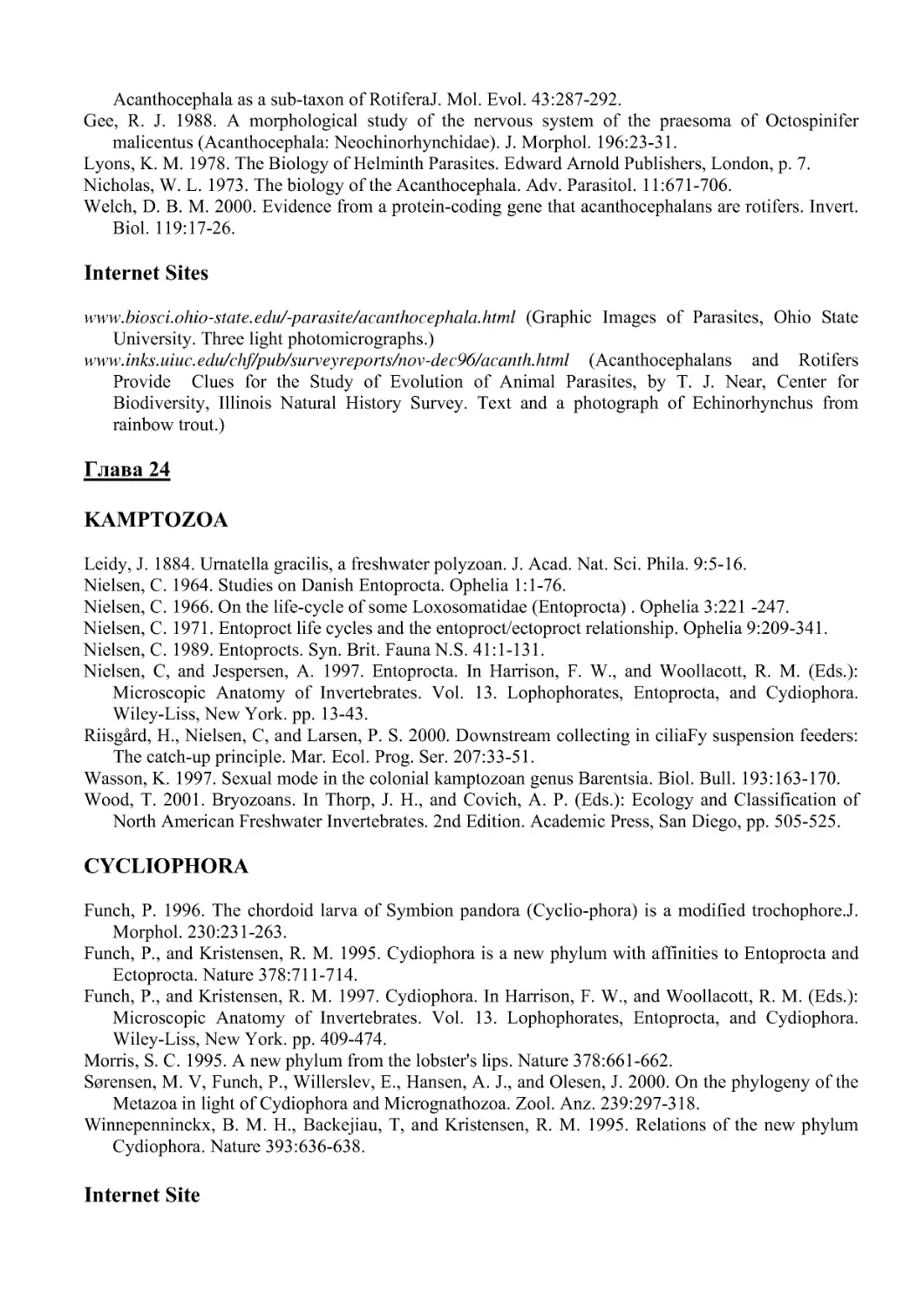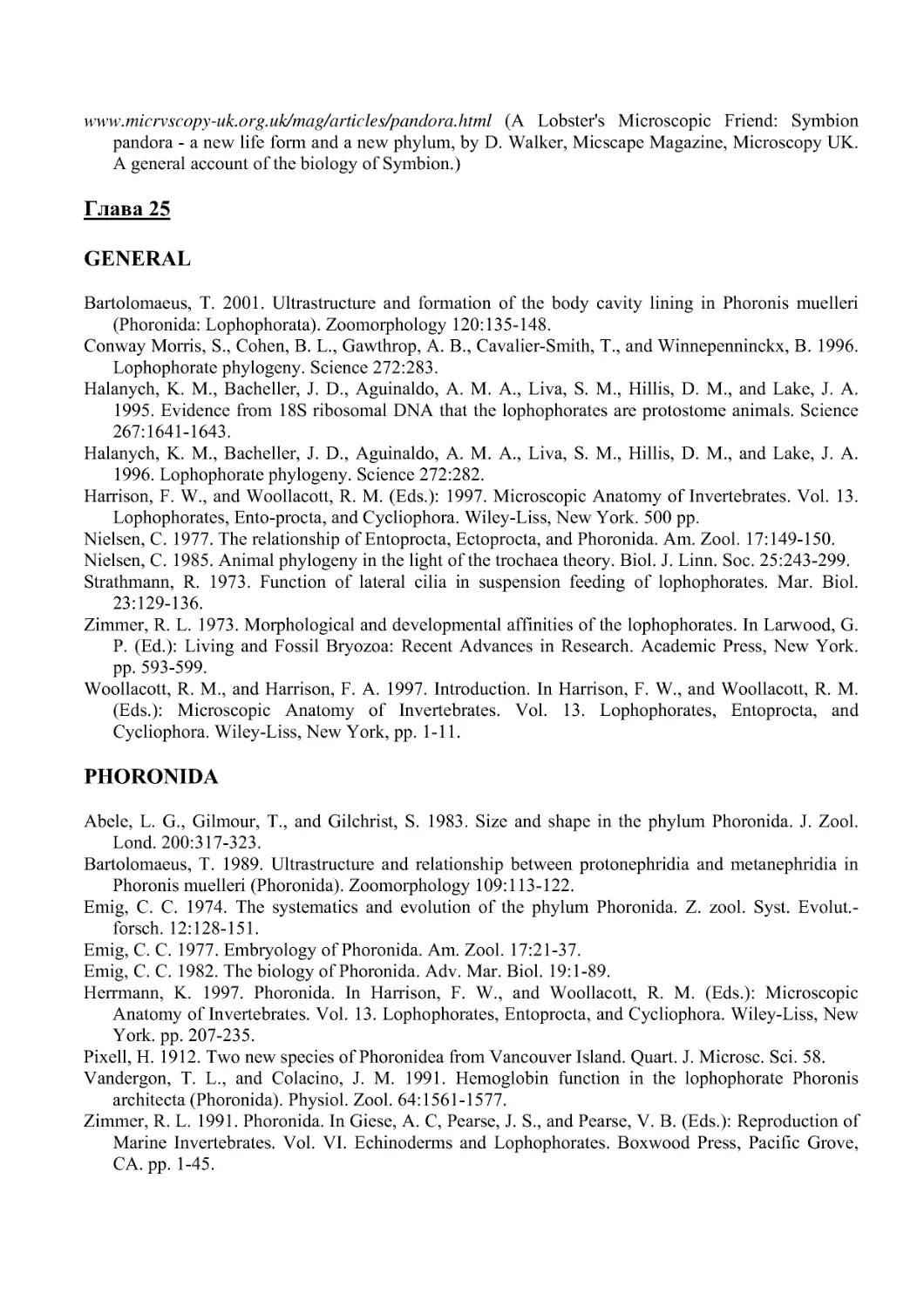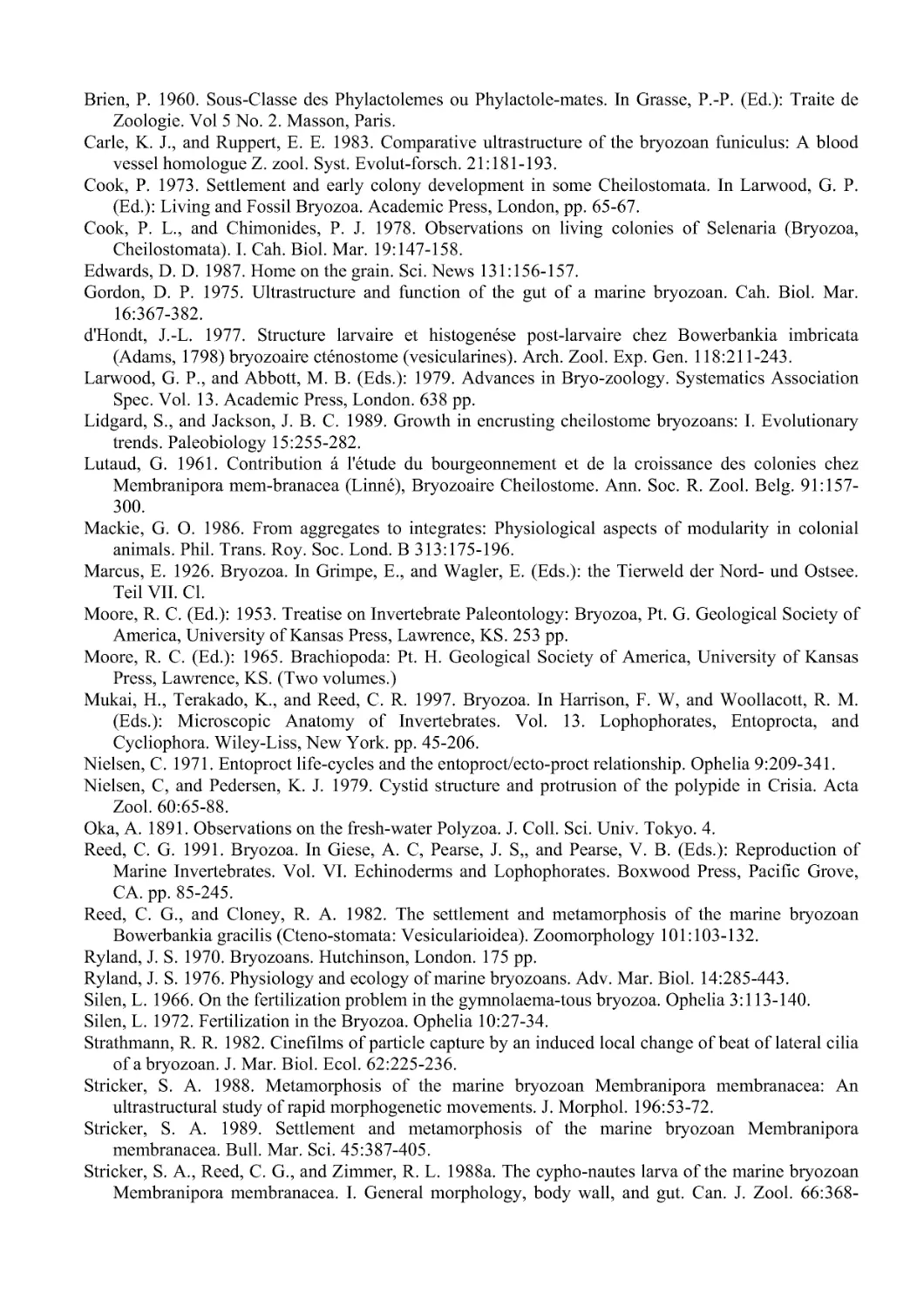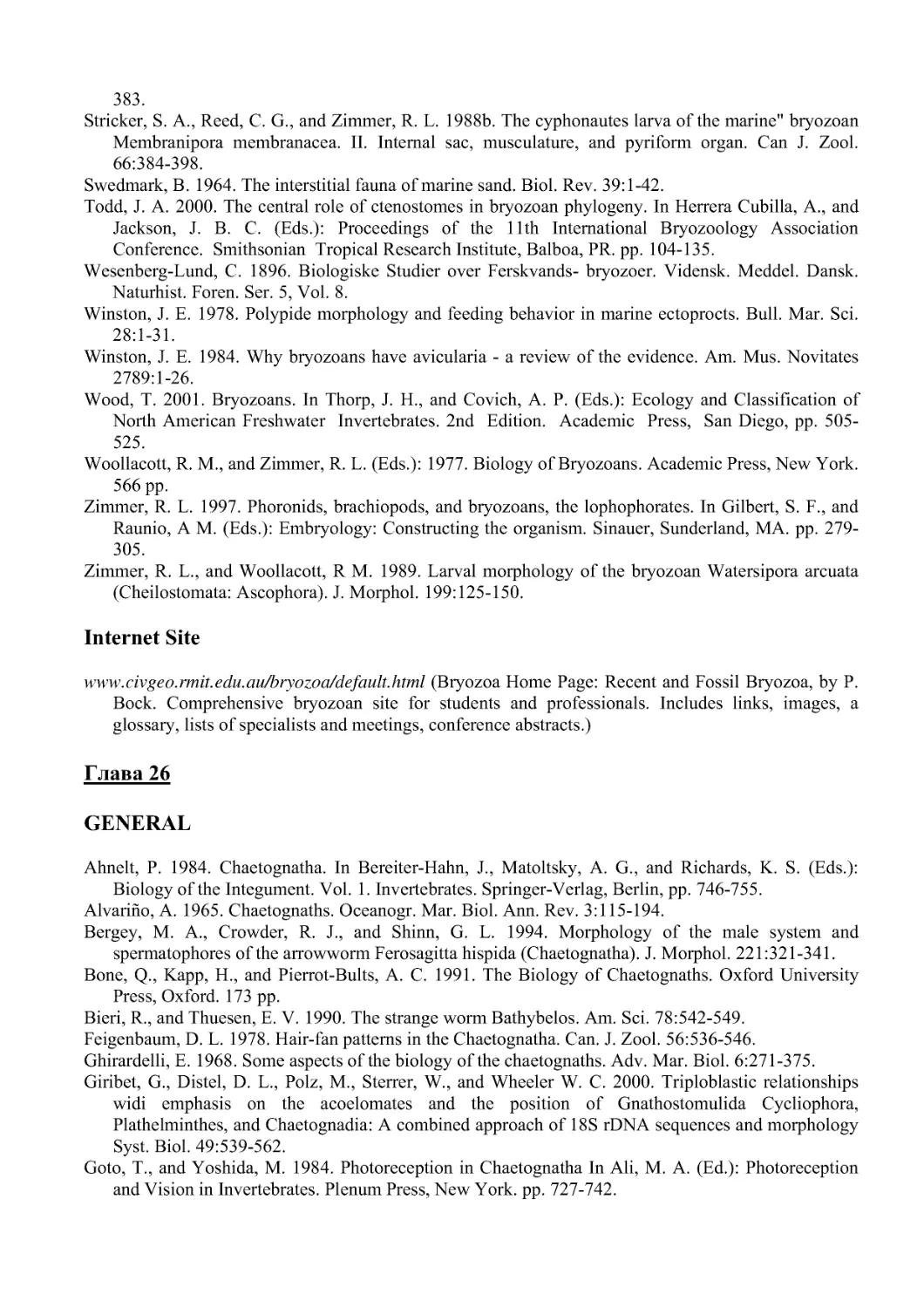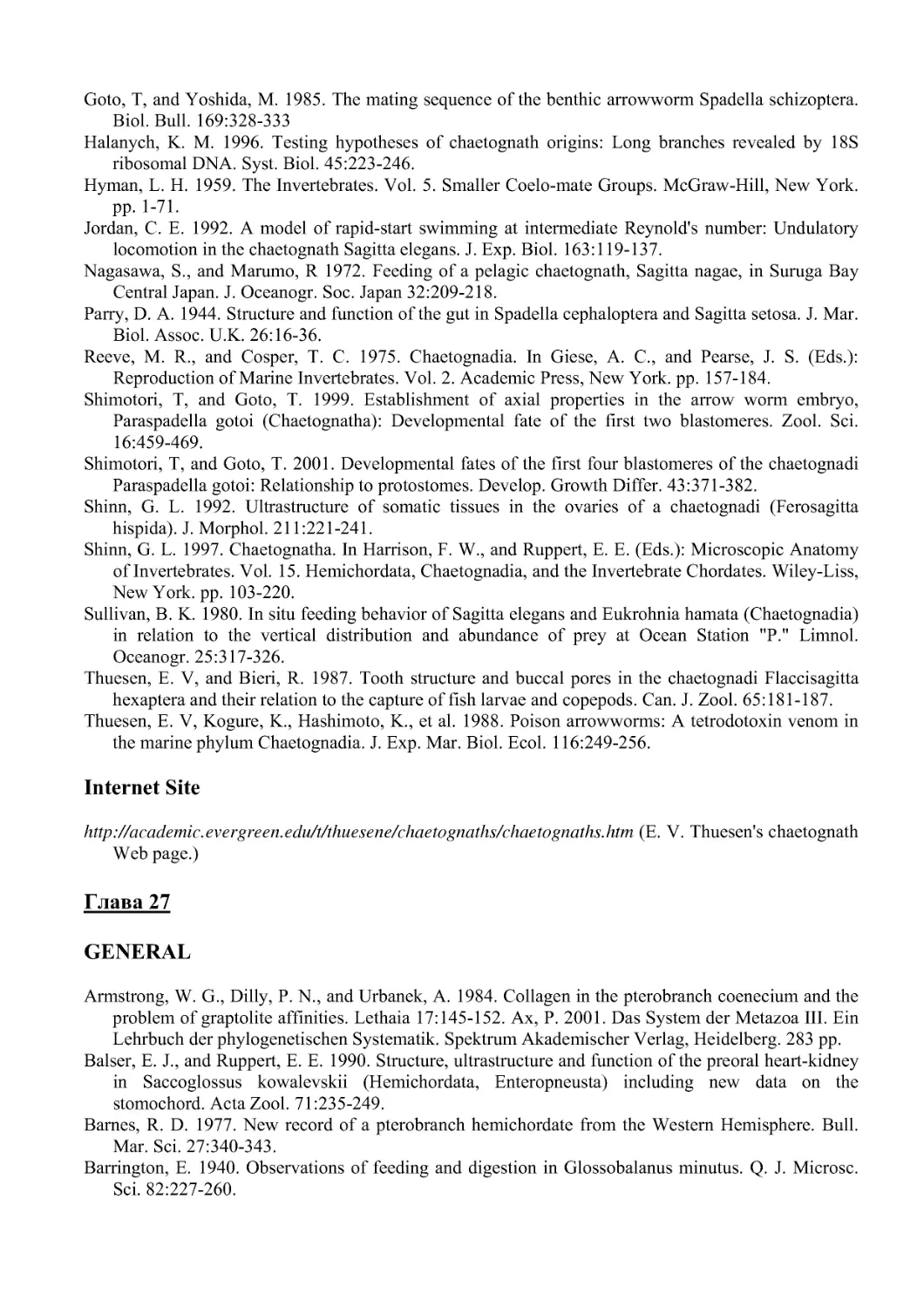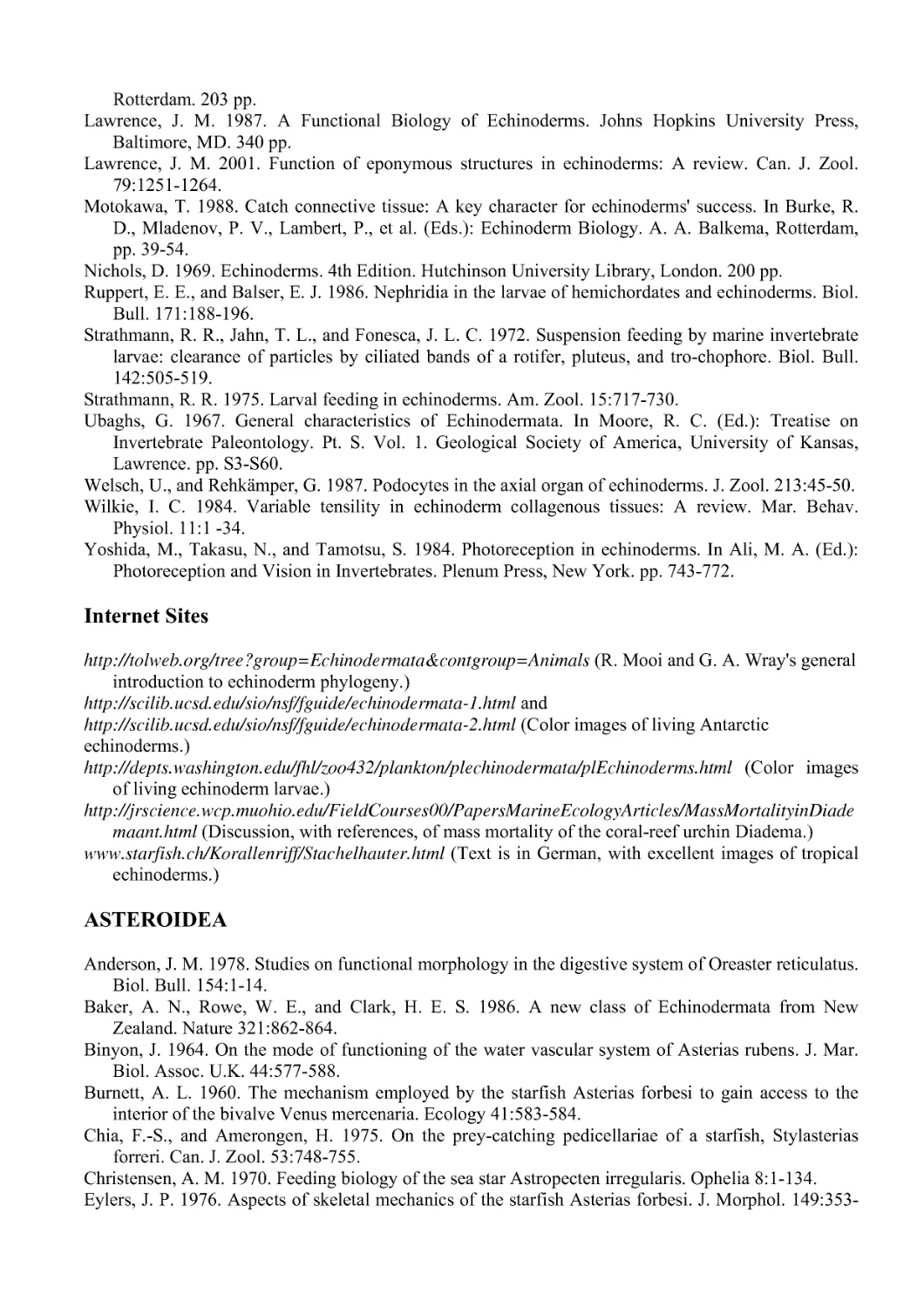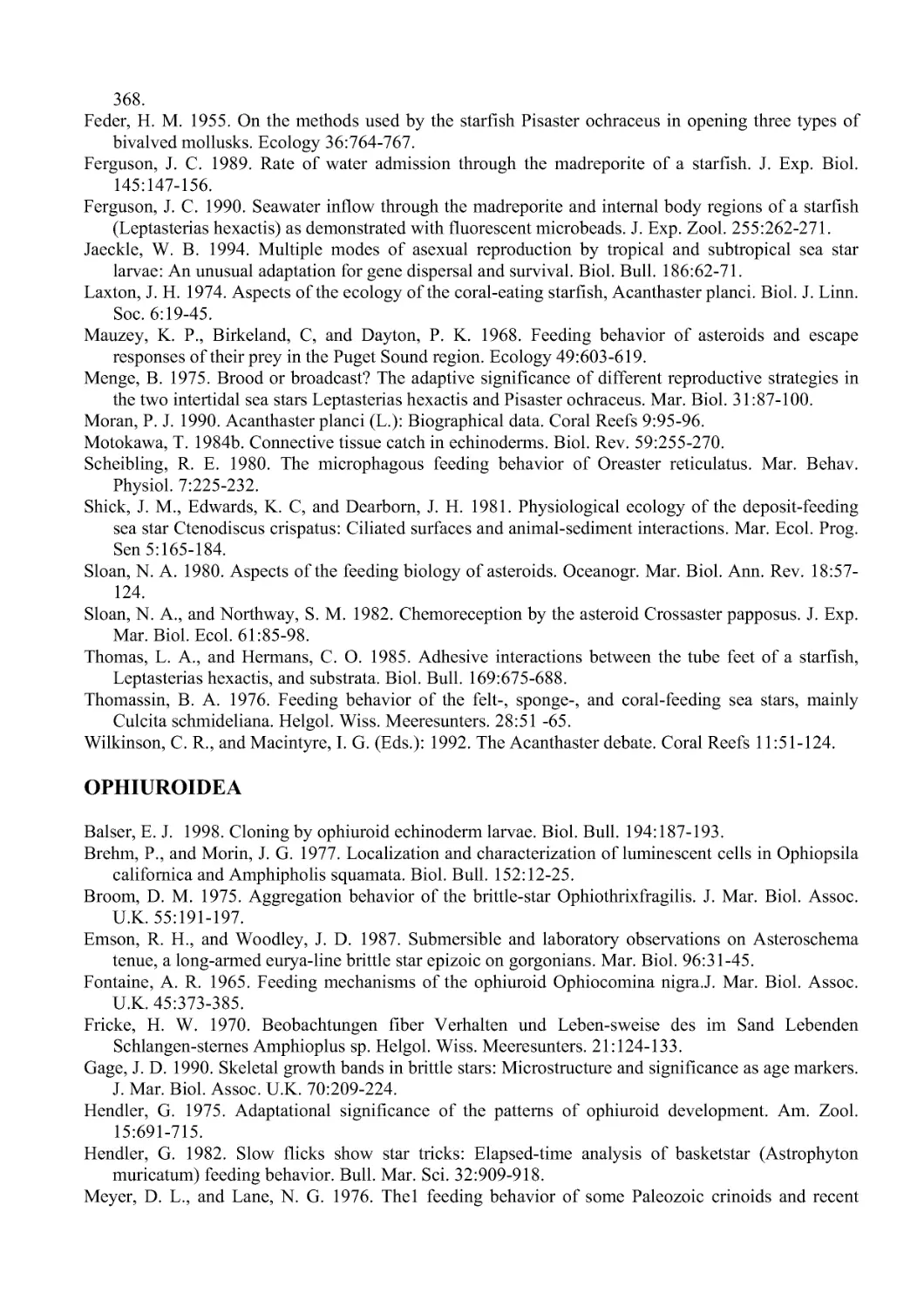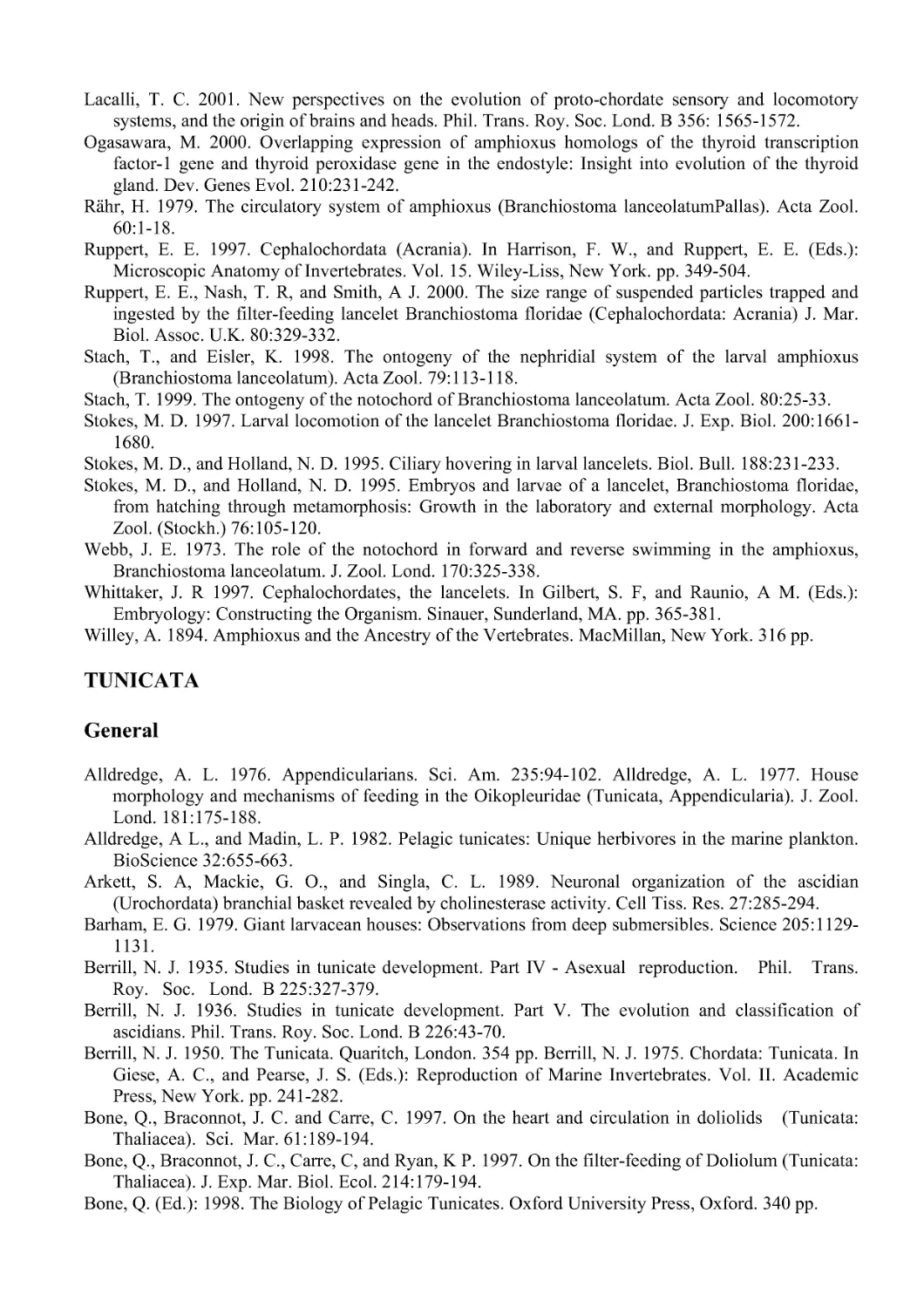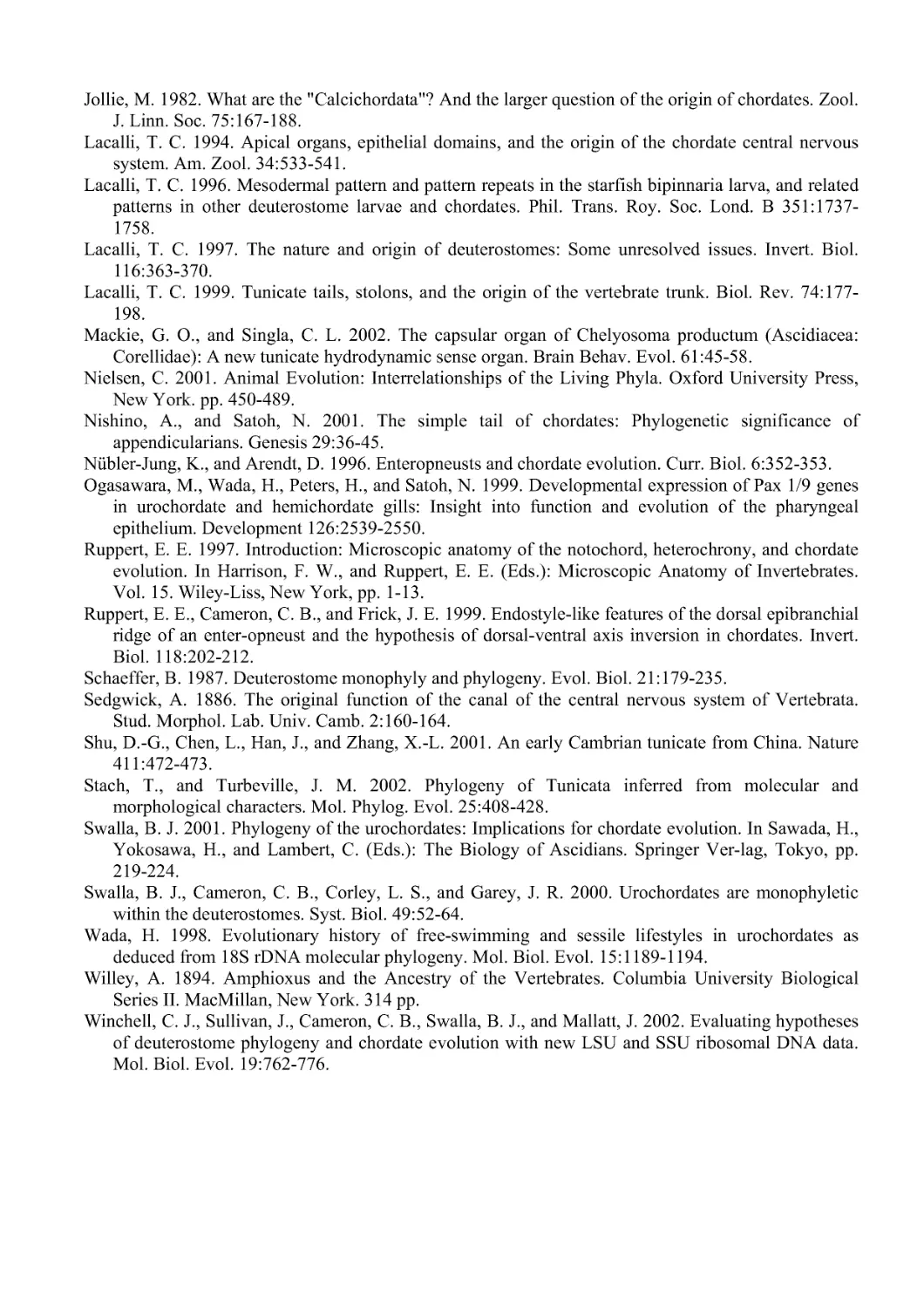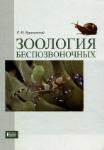Автор: Рупперт Э.Э. Фокс Р.С. Барнс Р.Д.
Теги: зоология систематика животных специальные зоологические науки биология беспозвоночные
ISBN: 978-5-7695-3493-5.
Год: 2008
Текст
Глава 1
BOOKS AND JOURNALS
Comprehensive
Beklemishev, V. N. 1969. Principles of Comparative Anatomy of Invertebrates. University of Chicago
Press, Chicago. (Two volumes.)
Bronn, H. G. (Ed.): 1866-. Klassen und Ordnungen des Tierreichs. C. F. Winter, Leipzig and
Heidelberg. (Many volumes; the series is incomplete.)
Fretter, V., and Graham, A. 1976. A Functional Anatomy of Invertebrates. Academic Press, London.
600 pp.
Grasse, P. (Ed.): 1948-1996. Traite de Zoologie. Masson, Paris. (Seventeen volumes.)
Harrison, F. W. (Ed.): 1991-1999. Microscopic Anatomy of Invertebrates. Wiley-Liss, New York.
(Fifteen volumes.)
Hyman, L. H. 1940. The Invertebrates. Vol. 1. Protozoa through Ctenophora. McGraw-Hill, New York.
726 pp.
Hyman, L. H. 1951. The Invertebrates. Vol. 2. Platyhelminthes and Rhynchocoela: The Acoelomate
Bilateria. McGraw-Hill, New York. 550 pp.
Hyman, L. H. 1951. The Invertebrates. Vol. 3. Acanthocephala, Aschelminthes and Entoprocta.
McGraw-Hill, New York. 572 pp.
Hyman, L. H. 1955. The Invertebrates. Vol. 4. The Echinodermata. McGraw-Hill, New York. 763 pp.
Hyman, L. H. 1959. The Invertebrates. Vol. 5. Smaller Coelomate Groups. McGraw-Hill, New York.
783 pp.
Hyman, L. H. 1967. The Invertebrates. Vol. 6. Mollusca I. McGraw-Hill, New York. 792 pp.
Kozloff, E. N. 1990. Invertebrates. Saunders, Philadelphia. 866 pp.
Parker, T. J., and Haswell, W. A. 1951. A Text-Book of Zoology. Vol. 1. MacMillan, London. 770 pp.
Parker, S. P. (Ed.): 1982. Synopsis and Classification of Living Organisms. Vol. 1. McGraw-Hill, New
York. 1166 pp.
Parker, S. P. (Ed.): 1982. Synopsis and Classification of Living Organisms. Vol. 2. McGraw-Hill, New
York. 1236 pp.
Pearse, V., Pearse,J., Buchsbaum, M., and Buchsbaum, R. 1987. Living Invertebrates. Blackwell
Scientific, Palo Alto, CA. 848 pp.
Russell-Hunter, W. D. 1979. A Life of Invertebrates. Macmillan, New York. 650 pp.
Westheide, W. and Rieger, R. M. (Eds.): 1996. Spezielle Zoologie. Erster Teil: Einzeller und
Wirbellose Tiere. Gustav Fischer Verlag, Stuttgart. 909 pp.
Lab Manuals
Brown, F. A., Jr. 1950. Selected Invertebrate Types. John Wiley and Sons, New York. 597 pp.
Dales, R. P. 1981. Practical Invertebrate Zoology. 2nd Edition. John Wiley and Sons, New York. 356
pp.
Freeman, W. H., and Bracegirdle, B. 1971. An Atlas of Invertebrate Structure. Heinemann Educational
Books, London. 129 pp.
Pierce, S. K., and Maugel, T. K. 1989. Illustrated Invertebrate Anatomy. Oxford University Press,
Oxford. 320 pp.
Sherman, I. W., and Sherman, V. G. 1976. The Invertebrates: Function and Form. 2nd Edition.
Macmillan, New York. 334 pp.
Wallace, R. L., Taylor, W. K., and Litton, J. R. 1988. Invertebrate Zoology. 4th Edition. Macmillan,
New York. 475 pp.
Morphology
Abbott, D. P. 1987. Observing Marine Invertebrates. Edited by G. H. Hilgard. Stanford University
Press, Stanford, CA. 380 pp.
Bereiter-Hahn, J., Matoltsy, A. G., and Richards, K. S. (Eds.): 1984. Biology of the Integument. Vol. 1:
Invertebrates. Springer-Verlag, Berlin. 841 pp.
Kennedy, G. Y. 1979. Pigments of marine invertebrates. Adv. Mar. Biol. 16:309-381.
Welsch, U., and Storch, V. 1976. Comparative Animal Cytology and Histology. University of
Washington Press, Seattle. 343 pp.
Functional Morphology and Physiology
Alexander, R. M. 1982. Locomotion of Animals. Chapman and Hall, London. 192 pp.
Atema, J., Fay, R. R., Popper, A. N., and Tavolga, W. N. (Eds.): 1987. Sensory Biology of Aquatic
Animals. Springer-Verlag, New York. 936 pp.
Bullock, T. H., and Horridge, G. A. 1965. Structure and Function of the Nervous System of
Invertebrates. W. H. Freeman, San Francisco. (Two volumes.)
Clark, R. B. 1964. Dynamics in Metazoan Evolution: The Origin of the Coelom and Segments.
Clarendon Press, Oxford. 313 pp.
Elder, H. Y, and Trueman, E. R. (Eds.): 1980. Aspects of Animal Movement. Cambridge University
Press, New York. 250 pp.
Highnam, K. C, and Hill, L. 1977. The Comparative Endocrinology of the Invertebrates. 2nd Edition.
University Park Press, Baltimore. 357 pp.
Hughes, R. N. 1989. A Functional Biology of Clonal Animals. Chapman and Hall, London. 331 pp.
Johnsen, S. 2000. Transparent animals. Sci. Am. Feb.:83-89.
Laufer, H., and Downer, R. G. H. (Eds.): 1988. Invertebrate Endocrinology. Vol. 2. Endocrinology of
Selected Invertebrate Types. Alan R. Liss, New York. 500 pp.
Rankin, J. C, and Davenport, J. A. 1981. Animal Osmoregula-tion. John Wiley and Sons, New York.
202 pp.
Russell, F. E. 1984. Marine toxins and venomous and poisonous marine plants and animals. Adv. Mar.
Biol. 21:60-233.
Schmidt-Nielsen, K. 1990. Animal Physiology: Adaptation and Environment. 4th Edition. Cambridge
University Press, Cambridge. 602 pp.
Trueman, E. R. 1975. The Locomotion of Soft-Bodied Animals. American Elsevier, New York. 200
pp.
Vernberg, F. J., and Vernberg, W. B. (Eds.): 1981. Functional Adaptations of Marine Organisms.
Academic Press, New York. 347 pp.
Vogel, S. 1988. Life's Devices: The Physical World of Animals and Plants. Princeton University Press,
Princeton, NJ. 384 pp.
Vogel, S. 1996. Life in Moving Fluids: The Physical Biology of Flow. Princeton University Press,
Princeton, NJ. 484 pp.
Wainwright, S. A. 1988. Axis and Circumference: The Cylindrical Shape of Plants and Animals.
Harvard University Press, Cambridge, MA. 176 pp.
Ecology
Carefoot, T. 1977. Pacific Seashores: A Guide to Intertidal Ecology. University of Washington Press,
Seattle. 208 pp.
Crawford, C. S. 1981. Biology of Desert Invertebrates. Springer-Verlag, New York. 314 pp.; Clarendon
Press, Oxford. 313 pp.
Daiber, F. C. 1982. Animals of the Tidal Marsh. Van Nostrand Reinhold, New York. 432 pp.
Eltringham, S. K. 1971. Life in Mud and Sand. Crane, Russak, New York. 218 pp.
Gage, J. D., and Tyler, P. A. 1991. Deep-Sea Biology: A Natural History of Organisms at the Deep-Sea
Floor. Cambridge University Press, Cambridge. 504 pp.
Halstead, B. W. 1988. Poisonous and Venomous Marine Animals of the World. 3rd Edition. Darwin
Press, Princeton, NJ. 1168 pp.
Hardy, A. C. 1956. The Open Sea. Houghton Mifflin, Boston. (Two volumes.)
Harris, V. A. 1990. Sessile Animals of the Seashore. Chapman and Hall, London. 379 pp.
Kerfoot, W. C. (Ed.): 1980. Evolution and Ecology of Zoo-plankton Communities. University Press of
New England, Hanover, NH. 794 pp.
MacGinitie, G. E., and MacGinitie, N. 1968. Natural History of Marine Animals. 2nd Edition.
McGraw-Hill, New York. 523 pp.
Marshall, N. B. 1979. Deep Sea Biology. Garland STPM Press, New York. 566 pp.
Newell, R. C. 1979. Biology of Intertidal Animals. 3rd Edition. Marine Ecological Surveys,
Faversham, Kent, U.K. 560 pp.
Nicol, J. A. C. 1967. The Biology of Marine Animals. 2nd Edition. Wiley-Interscience, New York. 699
pp.
Schaller, F. 1968. Soil Animals. University of Michigan Press, Ann Arbor. 114 pp.
Stephenson, T. A., and Stephenson, A. 1972. Life between Tide-marks on Rocky Shores. W. H.
Freeman, San Francisco. 425 pp.
Thorp, J. H., and Covich, A. P. (Eds.): 1991. Ecology and Classification of North American Freshwater
Invertebrates. Academic Press, New York. 911 pp.
Thorp, J. H., and Covich, A. P. (Eds.): 2001. Ecology and Classification of North American Freshwater
Invertebrates. 2nd Edition. Academic Press, New York. 1056 pp.
Yonge, C. M. 1949. The Seashore. Collins, London. 311 pp.
Reproduction, Development, Larvae, and Metamorphosis
Chia, E, and Rice, M. E. (Eds.): 1978. Setdement and Metamorphosis of Marine Invertebrate Larvae.
Elsevier North Holland, New York. 290 pp.
Giese, A. C, and Pearse, J. S. 1974-1991. Reproduction of Marine Invertebrates. Academic Press, New
York. (Six volumes.)
Harrison, F. W., and Cowden, R. R. (Eds.): 1982. Developmental Biology of Freshwater Invertebrates.
Alan R. Liss, New York. 588 pp.
Gilbert, S. E, and Raunio, A. M. 1997. Embryology. Constructing the organism. Sinauer, Sunderland,
MA. 537 pp.
Kume, M., and Dan, K. 1968. Invertebrate Embryology. Clearinghouse for Federal Scientific and
Technical Information, Springfield, VA. 605 pp.
Young, C. M., Sewell, M. A., and Rice, M. E. (Eds.): 2001. Atlas of Marine Invertebrate Larvae.
Academic Press, New York. 630 pp.
Cladistics and Evolution
Ax, P. 1996. Multicellular Animals. Vol. I. A New Approach to the Phylogenetic Order in Nature.
Springer, Berlin. 225 pp.
Ax, P. 2000. Multicellular Animals. Vol. II. The Phylogenetic System of the Metazoa. Springer, Berlin.
395 pp.
Ax, P. 2001. Der System der Metazoa III. Ein Lehrbuch der Phy-logenetischen Systematik. Spektrum
Akademischer Verlag, Heidelberg. 283 pp.
Conway Morris, S., George, J. D., Gibson, R., et al (Eds.): 1985. The Origins and Relationships of
Lower Invertebrates. Systematics Association Spec. Vol. 28. Clarendon Press, Oxford. 394 pp.
House, M. R. (Ed.): 1979. The Origin of Major Invertebrate - Groups. Systematics Association Spec.
Vol. 12. Academic Press, London. 515 pp.
Kitching, I. J. (Ed.): 1998. Cladistics: The Theory and Practice of Parsimony Analysis. 2nd Edition.
Oxford University Press, Oxford. 240 pp.
Nielsen, C. 2001. Animal Evolution: Interrelationships of the Living Phyla. Oxford University Press,
Oxford. 563 pp.
Wiens, J. J. (Ed.): 2000. Phylogenetic Analysis of Morphological Data. Smithsonian Institution Press,
Washington, DC. 272 pp.
Paleontology
Boardman, R. S., Cheetham, A. H., and Rowell, A. J. 1986. Fossil Invertebrates. Blackwell Scientific,
Boston. 713 pp.
Dyer, J. C, and Schram, F. R. 1983. A Manual of Invertebrate Paleontology. Stipes, Champaign, IL.
165 pp.
Moore, R. C. (Ed.): 1953-1966. Treatise on Invertebrate Paleontology. Geological Society of America,
University of Kansas Press, Lawrence, KS. (Eighteen volumes.)
Field Guides
Campbell, A. C. 1976. The Hamlyn Guide to the Seashore and Shallow Seas of Britain and Europe.
Hamlyn, London. 320 pp.
Colin, P. L. 1978. Caribbean Reef Invertebrates and Plants. T. F. H., Neptune City, NJ. 478 pp.
Fielding, A. 1998. Hawaiian Reefs and Tidepools. Booklines Hawaii, Mililani, HI. 103 pp.
Fotheringham, N., and Brunenmeister, S. L. 1975. Common Marine Invertebrates of the Northwestern
Gulf Coast. Gulf, Houston. 175 pp.
Gosner, K. L. 1979. Peterson Field Guide Series: A Field Guide to the Atlantic Seashore. Houghton
Mifflin, Boston. 329 pp.
Gunson, D. 1983. Collins Guide to the New Zealand Seashore. Collins, Auckland. 240 pp.
Hayward, P. J., and Ryland, J. S. (Eds.): 1991. The Marine Fauna of the British Isles and North-West
Europe. Vol. 1: Introduction and Protozoans to Arthropods. Oxford University Press, Oxford. 688
pp.
Hayward, P. J., and Ryland, J. S. (Eds.): 1991. The Marine Fauna of the British Isles and North-West
Europe. Vol. 2: Molluscs to Chordates. Oxford University Press, Oxford. 386 pp.
Hoover, J. P. 1999. Hawaii's Sea Creatures: A Guide to Hawaii's Marine Invertebrates. Mutual
Publishers, Honolulu. 366 pp.
Hurlbert, S. H., and Villalobos-Figueroa, A. (Eds.): 1982. Aquatic Biota of Mexico, Central America
and the West Indies. Aquatic Biota-SDSU Foundation, San Diego State University, San Diego. 529
pp.
Kaplan, E. H. 1982. Peterson Field Guide Series. A Field Guide to Coral Reefs of the Caribbean and
Florida. Houghton Mifflin, Boston. 289 pp.
Kerstitch, A. 1989. Sea of Cortez Marine Invertebrates. Sea Challengers, Monterey, CA. 120 pp.
Kozloff, E. N. 1983. Seashore Life of the Northern Pacific Coast: An Illustrated Guide to Northern
California, Oregon, Washington and British Columbia. Revised Edition. University of Washington
Press, Seattle. 370 pp.
Kozloff, E. N. 1988. Marine Invertebrates of the Pacific Northwest. University of Washington Press,
Seattle. 511 pp.
Meinkoth, N. A. 1981. The Audubon Society Field Guide to North American Seashore Creatures.
Alfred Knopf, New York. 799 pp.
Morris, R. H., Abbott, D. P., and Haderlie, E. C. 1980. Intertidal Invertebrates of California. Stanford
University Press, Palo Alto, CA. 690 pp.
Morton, B., and Morton, J. 1983. The Sea Shore Ecology of Hong Kong. Hong Kong University Press,
Hong Kong. 350 pp.
Morton, J., and Miller, M. 1973. The New Zealand Sea Shore. 2nd Edition. Collins, London. 653 pp.
Newell, G. E., and Newell, R. C. 1973. Marine Plankton: A Practical Guide. Hutchinson Educational,
London. 244 pp.
Peckarsky, B. L., Fraissinet, P. R., Penton, M. A., et al. 1990. Freshwater Macroinvertebrates of
Northeastern Nordi America. Comstock, Ithaca, NY. 442 pp.
Pennak, R. W. 1978. Fresh-Water Invertebrates of North America. 2nd Edition. John Wiley and Sons,
New York. 803 pp.
Pennak, R. W. 1989. Freshwater Invertebrates of the United States. Protozoa to Molluscs. 3rd Edition.
John Wiley and Sons, New York. 768 pp.
Ruppert, E., and Fox, R. 1988. Seashore Animals of the Southeast: A Guide to Common Shallow-
Water Invertebrates of the Southeastern Adantic Coast. University of South Carolina Press,
Columbia. 429 pp.
Smith, D. G. 2001. Pennak's Freshwater Invertebrates of the United States: Porifera to Crustacea. 4th
Edition. John Wiley and Sons, New York. 648 pp.
Smith, D. L., and Johnson, K. B. 1996. A Guide to Marine Coastal Plankton and Marine Invertebrate
Larvae. 2nd Edition. Kendall/Hunt, Dubuque, IA. 221 pp.
Smith, R. I. (Ed.): 1964. Keys to Marine Invertebrates of the Woods Hole Region. Contribution No. 11.
Systematics-Ecology Program, Marine Biology Laboratory, Woods Hole, MA. 208 pp.
Sterrer, W. E. (Ed.): 1986. Marine Fauna and Flora of Bermuda. Wiley-Interscience, New York.742 pp.
Wickstead,J. H. 1965. An Introduction to the Study of Tropical Plankton. Hutchinson, London. 160 pp.
Wrobel, D., and Mills, C. 1998. Pacific Coast Pelagic Invertebrates: A Guide to the Common
Gelatinous Animals. Sea Challengers, Monterey, CA. 108 pp.
INTERNET SITES
General
http://life.bio.sunysb.edu/marinebio/mbweb.html (State University of New York. Invertebrate images,
references, career opportunities, and news regarding marine biology.)
www.marine.stanford.edu/HMSweb/careers.html (Marine biology links, careers, and more.)
www.ucmp.berkeley.edu (University of California at Berkeley Museum of Paleontology. Explore their
invertebrate collections and follow links to impressive images of living invertebrates.)
www.ucmp.berkeley.edu/exhibit/phylogeny.html (Take the Web Lift to Taxa to discover the
relationships that connect all organisms.)
www.nmnh.si.edu/departments/invert.html (Smithsonian National Museum of Natural History. Good
coverage of certain groups of invertebrates, such as squids and their relatives.)
http://mbayaq.org (Monterey Bay Aquarium. The next best thing to being there. Explore their beach,
rocky intertidal pool, open water, and kelp forest exhibits, several of which are three-dimensional
and several that are interactive.)
www.bioimages.org.uk/index.htm (Biolmages. A U.K. virtual field guide.)
www.biosis.org/zrdocs/zoolinfo/gp_index.htm (BIOSIS Internet Resource Guide for Zoology.)
Lab Manual
www.lander.edu/rsfox/310labindex.html (Lander University OnLine Invertebrate Lab. Illustrated
anatomical descriptions of approximately 100 species in support of invertebrate teaching and
research.)
Professional Societies
www.invertebrates.org (American Microscopical Society. Publishes the international journal
Invertebrate Biology. The journal's Web site links to other sites on invertebrates and opportunities
in the field for research, jobs, and education.)
www.museum.unl.edu/asp (American Society of Parasitologists. Much useful information and many
images at their Web site.)
Cladistics
tolweb.org/tree/phylogeny.html (Tree of Life. Provides a phyloge-netic classification of all taxa of
living organisms based on molecular and morphological traits. Coverage is uneven and often
outdated, but new information is being added constantly. Good source of contemporary references
to invertebrate systematics.)
www.nhm.ukans.edu/downloads/CompkatCladist.pdf (An online version of Wiley, E. O., Siegel-
Causey, D., Brooks, D. R., and Funk, V. A. 1991. The Compleat Cladist: A Primer of Phybgenetk
Procedures. Special Publication No. 19. University of Kansas Museum of Natural History,
Lawrence, KS.)
www.gwu.edu/~clade/faculty/lipscomb/Cladistics.pdf (Diana Lip-scomb's 1998 workbook, Basics of
Cladistic Analysis [George Washington University, Washington, DC.])
erms.biol.soton.ac.uk (European Register of Marine Species.)
www.nhm.ac.uk/hosted_sites/uksf (V.K. Systematics Forum. A database of taxonomists and the Web of
Life.)
animaldiversity.ummz.umich.edu/index.html (University of Michigan Museum of Zoology Animal
Diversity Web.)
Глава 2
GENERAL
Alberts, B., Bray, D., Lewis, J., Raff, M., Roberts, K., and Watson, J. D. 2002. Molecular Biology
of the Cell. Garland Publishing, New York. 1616 pp.
Allen, R. D., and Naitoh, Y. 2002. Osmoregulation and contractile vacuoles of Protozoa. Int. Rev.
Cytol. 215:351-394.
Corliss, J. O. 1989. Protistan diversity and origins of multicellular/multitissued organisms. Boll. Zool.
56:227-234.
Fenchel, T., and Finlay, B. J. 1994. The evolution of life without oxygen. Am. Sci. 82:22.
Fukui, Y. 1993. Toward a new concept of cell motility: Cytoskeletal dynamics in amoeboid movement
and cell division. Int. Rev. Cytol. 144:85-127.
Grain, J. 1986. The cytoskeleton in protists: Nature, structure and functions. Int. Rev. Cytol. 104:153.
Grebecki, A. 1994. Membrane and cytoskeleton flow in motile cells with emphasis on the contribution
of free-living amoebae. Int. Rev. Cytol. 148:37-80.
Heppert, M., and Mayer, F. 1999. Prokaryotes. Am. Sci. 87:518-525.
Karsenti, E. 1999. Centrioles reveal their secrets. Nature Cell Biol. 1:E62-E64.
Lindemann, C. B., and Kanous, K. S. 1997. A model for flagellar motility. Int. Rev. Cytol. 173:1-72.
Lodish, H., Berk, A., Zipursky, S. L., Matsudaira, P., Baltimore, D., and Darnell, J. 2000. Molecular
Cell Biology. 4th Edition. W. H. Freeman, New York. 1084 pp.
Margulis, L. 1993. Symbiosis in Cell Evolution. 2nd Edition. W. H. Freeman, New York. 452 pp.
Margulis, L. 2000. Symbiotic Planet. Basic Books, New York. 160 pp.
Margulis, L., Sagan, D., Thomas, L. 1997. Microcosmos: Four Billion Years of Evolution from Our
Microbial Ancestors. University of California Press, Berkeley. 304 pp.
Patterson, D. J., and Sogin, M. L. 1993. Eukaryote origins and protistan diversity. In Hartman, H., and
Matsuno, K. (Eds.): The Origin and Evolution of the Cell. World Scientific Publishing, Singapore,
pp. 13-46.
Sikora, J. 1981. Cytoplasmic streaming in Paramecium. Protoplasma 109:57.
Sogin, M. L. 1991. Early evolution and the origin of eukaryotes. Curr. Opin. Genet. Devel. 1:457-463.
Weatherbee, R., Anderson, R. A., and Pickett-Heaps, J. D. (Eds.): 1994. The Protistan Cell Surface.
Springer Verlag, Vienna. 290 pp.
Whatley, J. M. 1993. The endosymbiotic origin of chloroplasts. Int. Rev. Cytol. 144:259-299.
INTERNET SITES
www.cco.caltech.edu/~brohawc/Demo1/BeadExpt.html (Image of micro-tubule sliding in an active
flagellum of a sea urchin sperm.)
http://cellbio.utmb.edu/ceUbio/cilia.htm (Transmission electron micrographs and diagrams of
cilia/centriole structure.)
http://cas.bellarmine.edu/tietjen/images/origin_of_mitochondria_in_eukary.htm (Concise description
of ideas and facts regarding the evolution of mitochondria.)
Глава 3
GENERAL
Additional references on protozoa can be found in the References section of Chapters 1 and 2.
Anderson, O. R. 1983. Radiolaria. Springer-Verlag, Berlin. 355 pp.
Anderson, O. R. 1987. Comparative Protozoology: Ecology, Physiology, Life History. Springer-
Verlag, Berlin. 482 pp.
Be, A. W. H. 1968. Shell Porosity of Recent Planktonic Foraminifera as a Climatic Index.
Science 161:881 -884.
Be, A. W. H. 1982. Biology of planktonic Foraminifera. Stud. Geol. 6:51-92.
Borror, A. C. 1973. Protozoa: Ciliophora. Marine Flora and Fauna of the Northeastern United States.
NOAA Tech. Report NMFS Circular 378. U.S. Government Printing Office. 62 pp.
Bouck, G. B., and Ngo, H. 1996. Cortical structure and function in euglenoids with reference to
trypanosomes, ciliates, and dinoflagellates. Int. Rev. Cytol. 169:267-318.
Boynton, J. E., and Small, E. B. 1984. Ciliates by the slice. Sci. Teach. Feb.:35-38.
Capriulo, G. M. (Ed.): 1990. Ecology of Marine Protozoa. Oxford University Press, 366 pp.
Coombs, G. H., Vickerman, K., Sleigh, M. A., and Warren, A. (Eds.): 1998. Evolutionary
Relationships among Protozoa. Kluwer Academic, Dordrecht, The Netherlands. 486 pp.
Corliss, J. O. 1979. The Ciliated Protozoa: Characterization, Classification, and Guide to the
Literature. 2nd Edition. Pergamon Press, New York. 455 pp.
Corliss, J. O. 1994. An interim utilitarian ("user-friendly") hierarchical classification and
characterization of the protists. Acta Protozool. 33:1-51.
Elliott, A. M. (Ed.): 1973. Biology of Tetrahymena. Dowden, Hutchinson, and Ross, Stroudsburg, PA.
508 pp.
Farmer, J. N. 1980. The Protozoa: Introduction to Protozoology. C. V. Mosby, St. Louis. 732 pp.
Fenchel, T. 1987. Ecology of Protozoa: Biology of Free-Living Phagotrophic Protists. Science Tech,
Madison, WI. 197 pp.
Galloway, J. 1987. A cause for reflection? Nature 330:204-205. (Discusses water temperature and
coiling direction in forams.)
Grell, K. G. 1973. Protozoology. Springer-Verlag, Berlin. 554 pp.
Hammond, D. M., and Long, P. L. (Eds.): 1973. The Coccidia. University Park Press, Baltimore, MD.
482 pp.
Harrison, R. W., and Corliss, J. O. (Eds.): 1991. Microscopic Anatomy of Invertebrates. Vol. 1.
Protozoa. Wiley-Liss, New York. 508 pp.
Harumoto, T., and Miyake, A. 1991. Defensive function of tri-chocysts in Paramecium.]. Exp. Zool.
260:84.
Hausmann, K., and Hulsmann, N. 1996. Protozoology. Georg Thieme, New York. 338 pp.
Haynes, J. R. 1981. Foraminifera. John Wiley and Sons, New York. 434 pp.
Kreier, J. P. 1991-1995. Parasitic protozoa. 2nd Edition. Academic Press, New York. (Ten volumes.)
Laybourn-Parry, J. 1984. A Functional Biology of Free-Living Protozoa. University of California
Press, Berkeley, CA. 218 pp.
Laybourn-Parry, J. 1992. Protozoan Plankton Ecology. Chapman and Hall, New York. 231 pp.
Leadbeater, B. S. 1983. Life-history and ultrastructure of a new marine species of Proterospongia. J.
Mar. Biol. Ass. U.K. 63:135-160.
Lee, J. J., and Anderson, O. R. 1991. Biology of Foraminifera. Academic Press, London. 384 pp.
Lee, J. J., Leedale, G. F., and Bradbury, P. (Eds.): 2000. An Illustrated Guide to the Protozoa. Vol. 1.
2nd Edition. Society of Protozoologists, Lawrence, KS. 683 pp.
Lee, J. J., Leedale, G. F., and Bradbury, P. (Eds.): 2000. An Illustrated Guide to the Protozoa. Vol. 2.
2nd Edition. Society of Protozoologists, Lawrence, KS. 1432 pp.
Leedale, G. F. 1967. Euglenoid Flagellates. Prentice-Hall, Engle-wood Cliffs, NJ. 242 pp.
Lynn, D. H. 1981. The organization and evolution of micro-tubular organelles in ciliated protozoa.
Biol. Rev. 56:243-292.
Margulis, L., Corliss, J. O., Melkonian, M., et al. (Eds.): 1990. Handbook of Protoctista. Jones and
Bartlett, Boston. 1024 pp.
Noble, E. R., and Noble, G. A. 1982. Parasitology. 5th Edition. Lea & Febiger, Philadelphia. 522 pp.
Ogden, C. G., and Hedley, R. H. 1980. An Atlas of Freshwater Testate Amoebae. British Museum,
Oxford University Press, Oxford. 222 pp.
Patterson, D. J. 1980. Contractile vacuoles and associated structures: Their organization and function.
Biol. Rev. 55:1-46.
Patterson, D. J., and Larsen, J. 1991. The Biology of Free-Living Heterotrophic Flagellates. Oxford
University Press, New York. 505 pp.
Prescott, D. M. 1994. The DNA of ciliated protozoa. Microbiol. Rev. 58:233-267.
Sarjeant, W. A. S. 1974. Fossil and Living Dinoflagellates. Academic Press, London. 1002 pp.
Sleigh, M. A. 1989. Protozoa and Other Protists. Edward Arnold, London. 342 pp.
Sleigh, M. A. 1991. Mechanisms of flagellar propulsion. A biologist's view of the relation between
structure, motion and fluid mechanics. Protoplasma 164:45-53.
Spoon, D. M., Chapman, G. B., Cheng, R. S., et al. 1976. Observations on the behavior and feeding
mechanisms of the suctorian Heliophyra erhardi (Reider) Matthes preying on Paramecium. Trans.
Am. Micros. Soc. 95:443-462.
Taylor, F. J. R. (Ed.): 1987. The Biology of Dinoflagellates. Black-well Scientific, Oxford. 785 pp.
Wichterman, R. 1986. The Biology of Paramecium. 2nd Edition. Plenum, New York. 599 pp.
INTERNET SITES
General
www.mdsg.umd.edu/pfiesteria/ (Maryland Sea Grant page on Pfies-teria.)
www.med.cmu.ac.th/dept/parasite/framepro.htm (Light microscope images of parasitic protozoa.)
http://megasun.bch.umontreal.ca/protists/gallery.html (Images of free-living protozoa.)
www.microscopy-uk.org.uk/mag/wimsmall/flagdr.html (Color images of living and preserved
protozoa.)
www.durr.demon.co.uk/ (Steve Durr's page of color images of living protozoa.)
www.uga.edu/~protozoa/ (Society of Protozoolgists home page.)
Euglenozoa
http://bio.rutgers.edu/euglena/ (The Euglenoid Project page.)
http://taxa.soken.ac.jp/WWW/PDB/Images/Mastigophora/Peranema/ (Color images of living
Peranema.)
www.microscopyu. com/moviegallery/pondscum/protozoa/peranema/ (Movies of living Peranema.)
http://tryps.rockefeller.edu/'crosslab_intro.html (Introduction to trypanosomes and disease.)
Retortamonada and Axostylata
www.geocities.com/CollegePark/Lab/4551/ (Giardia page.)
http://vm.cfsan.fda.gov/~mow/chap22.html (U.S. Food and Drug Administration page on Giardia.)
www.utoronto.ca/forest/termite/flagella.html (List of flagellate species found in the gut of termites.)
http://comenius.susqu.edu/bi/202/ProtistPix/parabasalotista/trichonympha.htm (Images
of
Trichonympha from a termite gut.)
Volvocida
http://megasun.bch.umontreal.ca/protists/chlamy/appearance.html (Image of living Chlamydomonas
and other information.)
http://taxa.soken.ac.jp/WWW/PDB/Images/Chlorophyta/Volvox/ (Color images of living Volvox.)
Choanoflagellata
http://thalassa.gso.uri.edu/rines/ecotogy/choanofl.htm (Image of living choanoflagellates.)
http://protist.i.hosei.ac.jp/taxonomy/Zoomastigophora/Choanoflagellida.html (Color images of living
choanoflagellates.)
Dinoflagellata
www.geo.ucalgary.ca/~macrae/palynology/dinoflagellates/dinoflagellates.html (Dinoflagellate images
and information.)
Ciliophora
www.uogwelph.ca/~ciliates/ (The Ciliate Resource Archive.)
www.micrographia.com/specbiol/protis/cili/peri0100.htm (Color images of peritrichs.)
http://members.magnet.at/p.eigner/ (Information on and images of hypotrichs.)
http://taxa.soken.ac.jp/WWW/PDB/images/Protista/Ciliophora.html (Color images of living ciliates.)
Apicomplexa
www.saxonet.de/coccidia/ (Life cycle of Eimeria.)
www.biosci.ohio-state.edu/~parasite/plasmodium.html (Malaria page.)
www-micro.msb.le.ac.uk/224/Bradley/Biology.html (Another malaria page with animation and images.)
Amebas
http://micro.magnet.fsu.edu/moviegallery/pondscum/protozoa/amoeba/ (Movies of ameboid motion.)
www.microscopy-uk.org.uk/intro/illu/dark.html (Images of living Amoeba proteus.)
http://taxa. soken .ac.jp/WWW/PDB/Images/Sarcodina/ap/intactcell2.html (Images of living Amoeba.)
http://taxa.soken.ac.jp/WWW/PDB/Galleries/Uruguayl999/Arcella/ (Color images of living Arcella.)
http://taxa. soken.ac.jp/WWW/PDB/Images/Sarcodina/Difflugia/ (Images of Difflugia.)
Foraminiferea
http://cushforams.niu.edu/Forams.htm (Images of living forams and skeletons.)
Radiolaria and Acantharea
www.radiolaria.org/ (Images and information on fossil radio-larians.)
http://caliban.mpiz-koeln.mpg.de/~stueber/haeckel/radiolarien/index.html (Ernst Haeckel's 1862 color
illustrations of Radiolaria and Acantharea.)
www.cladocera.de/protozoa/rhizopoda/imgal_radiolaria.html (Color image of a living colonial
radiolarian.)
Heliozoa
www.biol.kobe-u.ac.jp/labs/suzaki/heliozoa/heliozoa-E.html (Research page on contraction mechanism
of axopodia.)
www.cladocera.de/protozoa/rhizopoda/imgal_heliozoa. html (Color images of living heliozoans.)
www.microscopyu.com/moviegallery/pondscum/protozoa/actinophrys/ (Movies of Actinophrys moving
and feeding.)
Phylogeny
http://tolweb.org/tree?group=Eukaryotes&fcontgroup = Life (Patterson and Sogin's Tree of Life page.)
Глава 4
GENERAL
Bonner, J. T. 1988. The Evolution of Complexity. Princeton University Press, Princeton, NJ. 260 pp.
Bonner, J. T. 1993. Life Cycles. Princeton University Press, Princeton, NJ. 209 pp.
Buss, L. W. 1987. The Evolution of Individuality. Princeton University Press, Princeton, NJ. 201 pp.
Dawydoff, C. 1928. Traite d'Embryologie Comparee des Invertebres. Masson, Paris. 930 pp.
Fawcett, D. W. 1981. The Cell. 2nd Edition. W. B. Saunders, Philadelphia. 862 pp.
Frick, J. E., and Ruppert, E. E. 1996. Primordial germ cells of Synaptula hydriformis (Holothuroidea;
Echinodermata) are epithelial flagellated-collar cells: Their apical-basal polarity becomes primary
egg polarity. Biol. Bull. 191:168-177.
Frick, J. E., and Ruppert, E. E. 1997. Primordial germ cells and oocytes of Branchiostoma virginiae
(Cephalochordata, Acrania) are flagellated epithelial cells: Relationship between epithelial and
primary egg polarity. Zygote 5:139-151.
Gerhart,J., and Kirschner, M. 1997. Cells, Embryos, and Evolution. Blackwell Science, Maiden, MA.
642 pp.
Gilbert, S. E, and Raunio, A. M. 1997. Embryology: Constructing the Organism. Sinauer, Sunderland,
MA. 537 pp.
Gould, S. J. 1977. Ontogeny and Phylogeny. Harvard University Press, Cambridge, MA. 501 pp.
Hausmann, K., and Hiilsmann, N. 1996. Protozoology. 2nd Edition. Georg Thieme, Stuttgart. 338 pp.
Hemmingsen, A. M. 1960. Energy metabolism as related to body size and respiratory surfaces and its
evolution. Rep. Steno Mem. Hosp. (Copenhagen) 9:1-58.
Hibberd, D. J. 1975. Observations on the ultrastructure of the choanoflagellate Codosiga botrytis (Ehr.)
Saville-Kent with special reference to the flagellar apparatus. J. Cell Sci. 17:191-219.
Krogh, A 1941. The Comparative Physiology of Respiratory Mechanisms. University of Pennsylvania
Press, Philadelphia. 172 pp.
McKinney, M. L., and McNamara, K. J. 1991. Heterochrony: The Evolution of Ontogeny. Plenum
Press, New York. 437 pp.
McMahon, T. A., and Bonner, J. T. 1983. On Size and Life. Scientific American, New York. 255 pp.
McNamara, K, J. 1997. Shapes of Time. Johns Hopkins University Press, Baltimore, MD. 342 pp.
Peters, R. H. 1983. The Ecological Implications of Body Size. Cambridge University Press,
Cambridge. 329 pp.
Remane, A. 1963. The evolution of the Metazoa from colonial flagellates vs. plasmodial ciliates. In:
Dougherty, E. C. (Ed.): The Lower Metazoa. Berkeley University Press, Berkeley, GA. pp. 23-32.
Nielsen, C. 2001. Animal Evolution: Interrelationships of the Living Phyla. 2nd Edition. Oxford
University Press, New York. 563 pp.
Raff, R. A. 1996. The Shape of Life: Genes, Development, and the Evolution of Animal Form.
University of Chicago Press, Chicago. 520 pp.
Rice, S. H. 2001. The role of heterochrony in primate brain evolution. In Minugh-Purvis, N., and
McNamara, K. J. (Eds.): Human Evolution through Developmental Change. Johns Hopkins
University Press, Baltimore. 508 pp.
Rieger, G. E., and Rieger, R. M. 1977. Comparative fine structure of the gastrotrich cuticle and aspects
of cuticle evolution within the Aschelminthes. Z. zool. Syst. Evolut.-forsch. 15:81-124.
Rieger, R. M. 1976. Monociliated epidermal in Gastrotricha: Significance for concepts of early
metazoan evolution. Z. zool. Syst. Evolut.-forsch. 14:198-226.
Ruppert, E. E. 1991. Introduction to the aschelminth phyla: A consideration of mesoderm, body
cavities, and cuticle. In Harrison, F. W., and Ruppert, E. E. (Eds.): Microscopic Anatomy of
Invertebrates. Vol. 4. Aschelminthes. Wiley-Liss, New York. pp. 1-17.
Salvini-Plawen, L. V. 1978. On the origin and evolution of the lower metazoa. Z. zool. Syst. Evolut.-
forsch. 16:40-88.
Schmidt-Nielsen, K. 1984. Scaling: Why Is Animal Size So Important? Cambridge University Press,
Cambridge. 241 pp.
Vogel, S. 1992. Vital Circuits: On Pumps, Pipes, and the Workings of Circulatory Systems. Oxford
University Press, Oxford. 315 pp.
Vogel, S. 1996. Life in Moving Fluids: The Physical Biology of Flow. 2nd Edition. Princeton
University Press, Princeton, NJ. 484 pp.
Wainwright, S. A. 1988. Axis and Circumference: The Cylindrical Shape of Plants and Animals.
Harvard University Press, Cambridge, MA. 132 pp.
Westheide, W. 1987. Progenesis as a principle in meiofauna evolution. J. Nat. His. 21:843-854.
Willmer, P. 1990. Invertebrate Relationships: Patterns in Animal Evolution. Cambridge University
Press, Cambridge. 400 pp.
Wolpert, L. 1994. The evolutionary origin of development: Cycles, patterning, privilege and continuity.
Development (Suppl.):79-84.
Zeuthen, E. 1953. Oxygen uptake as related to body size in organisms. Q. Rev. Biol. 28:1-12.
INTERNET SITES
http://zygote.swarthmore.edu/germ8.html (Concise, illustrated discussion of egg-cell polarity.)
http://pantheon.yale. edu/~sean/hetero. html (Advanced, illustrated discussion of heterochrony.)
wxvw.neoteny.org (Provides access to a database of quotations and sources of information on
heterochrony.)
Глава 5
PORIFERA
General
Afzelius, B. A. 1961. Flimmer flagellum of the sponge. Nature 191:1318-1319.
Ax, P. 1996. Multicellular Animals. Springer-Verlag, Berlin, pp. 68-76.
Ayling, A. L. 1983. Growth and regeneration rates in thinly encrusting Demospongiae from temperate
waters. Biol. Bull. 165:343-352.
Bavestrello, G., Burlando, B., and Sara, M. 1988. The architecture of the canal systems of Petrosia
ficiformis and Chondrosia reniformis studied by corrosion casts (Porifera, Demospongiae).
Zoomorphology 108:161 --- 166.
Benavides, L. M., and Druffel, E. R. M. 1986. Sclerosponge growth rates as determined by 210Pb and
A14C chronologies. Coral Reefs 4:221-224.
Bergquist, P. R. 1978. Sponges. Hutchinson, London. 268 pp.
Bergquist, P. R. 1985. Poriferan relationships. In Conway Morris, S., George, J. D., Gibson, R., et al.
(Eds.): The Origins and Relationships of Lower Invertebrates. Systematics Association Spec. Vol.
28. Clarendon Press, Oxford. 344 pp.
Boger, H. 1988. Versuch fiber das phylogenetische System der Porifera. Meyniana 40.143-154.
Bond, C. 1992. Continuous cell movements rearrange anatomical structures in intact sponges. J. Exp.
Zool. 263: 284-302.
Bond, C, and Harris, A. K. 1988. Locomotion of sponges and its physical mechanism. J. Exp. Zool.
246:271-284.
Brauer, E. B. 1975. Osmoregulation in the freshwater sponge, Spongilla lacustris. J. Exp. Zool.
192:181-192.
Brien, P., Levi, C, Sara, M., et al. 1973. Spongiaires: Traite de Zoologie. Vol. 3. Pt. 1. Masson, Paris.
716 pp.
Cobb, W. R. 1969. Penetration of calcium carbonate substrates by the boring sponge, Cliona. Am.
Zool. 9:783-790.
De Vos, L. 1991. Atlas of Sponge Morphology. Smithsonian Institution Press, Washington, DC. 117
pp.
Fell, P. E. 1997. Poriferans, the sponges. In Gilbert, S. F., and Raunio, A. M. (Eds.): Embryology:
Constructing the Organism. Sinauer, Sunderland, MA. pp. 39-54.
Frost, T. M., Nagy, G. S., and Gilbert, J. J. 1982. Population dynamics and standing biomass of the
freshwater sponge Spongilla lacustris. Ecology 63:1203-1210.
Frost, T. M., and Williamson, C. E. 1980. In situ determination of the effect of symbiotic algae on the
growth of the freshwater sponge Spongilla lacustris. Ecology 61:1361-1370.
Fry, W. G. (Ed.): 1970. The Biology of Porifera. Academic Press, New York. 512 pp.
Green, G. 1977. Ecology of toxicity in marine sponges. Mar. Biol. 40:207-215.
Harrison, F. W., and Cowden, R. R. 1976. Aspects of Sponge Biology. Academic Press, New York.
354 pp.
Harrison, F. W., and De Vos, L. 1990. Porifera. In Harrison, F. W., and Westfall, J. A. (Eds.):
Microscopic Anatomy of Invertebrates. Vol. 2. Wiley-Liss, New York. pp. 29-89.
Hartman, W. D. 1958. Natural history of the marine sponges of southern New England. Bull. Peabody
Mus. Nat. Hist. Yale Univ. 12:1-155.
Hooper, J. N. A., and Van Soest, R. W. M. (Eds.): 2002. Systema Porifera: A Guide to the
Classification of Sponges. Sea Challengers, Danville, CA. 1700 pp.
Jaeckle, W. B. 1995. Transport and metabolism of alanine and palmitic acid by field-collected larvae of
Tedania ignis (Porifera, Demospongiae): Estimated consequences of limited label translocation.
Biol. Bull. 189:159-167.
Kaestner, A. 1980. Lehrbuch der speziellen Zoologie 1(1): Wirbellose Tiere. Gustav Fischer Verlag,
Stuttgart. 318 pp.
Koehl, M. A. R. 1982. Mechanical design of spicule-reinforced connective tissue: Stiffness. J. Exp.
Biol. 98:239-267.
Lawn, I. D., Mackie, G. O., and Silver, G. 1981. Conduction system in a sponge. Science 211:1169-
1171.
Ledger, P. W, and Jones, W. C. 1977. Spicule formation in the calcareous sponge Sycon dliatum. Cell
Tissue Res. 181:553-567.
Leys, S. P. 1995. Cytoskeletal architecture and organelle transport in giant syncytia formed by fusion of
hexactinellid sponge tissues. Biol. Bull. 188:241-254.
Leys, S. P. 1999. The choanosome of hexactinellid sponges. Invert. Biol. 118:221-235.
Leys, S. P., and Lauzon, N. R. J. 1998. Hexactinellid sponge ecology: Growth rates and seasonality in
deep water sponges. J. Exp. Mar. Biol. Ecol. 230:111-129.
Leys, S. P., and Reiswig, H. M. 1998. Transport pathways in the neotropical sponge Aplysina. Biol.
Bull. 195:30-42.
Leys, S. P., Mackie, G. O., and Meech, R. W. 1999. Impulse conduction in a sponge. J. Exp. Biol.
202:1139-1150.
McClintock, J. B. 1987. Investigation of the relationship between invertebrate predation and
biochemical composition energy content, spicule armament and toxicity of benthic sponges at
McMurdo Sound, Antarctica. Mar. Biol 94:479-487.
Mehl, D., and Reiswig, H. M. 1991. The presence of fla gellar vanes in choanomers of Porifera and
their possibl< phylogenetic implications. Z. zool. Syst. Evolut.-forsch 29:312-319.
Moore, R. C. (Ed.): 1955. Treatise on Invertebrate Paleontolog) Vol. E. Archaeocyatha, Porifera.
Geological Society of America, University of Kansas Press, Lawrence, KS. 122 pp
Palumbi, S. R. 1986. How body plans limit acclimation Responses of a demosponge to wave force.
Ecology 61 208-214.
Pavans de Ceccatty, M. 1974. Coordination in sponges. The foundations of integration. Am. Zool.
14:895-903.
Pomponi, S. A. 1980. Cytological mechanisms of calcium carbonate excavation by boring sponges. Int.
Rev. Cyto 65:301-319.
Porter, J. W., and Targett, N. M. 1988. Allelochemical interac-tions between sponges and corals. Biol.
Bull. 175:230-23!
Reitner, J., and Keupp, H. (Eds.): 1991. Fossil and Recent Sponges. Springer-Verlag, New York. 595
pp.
Reiswig, H. M. 1971a. In situ pumping activities of tropic Demospongiae. Mar. Biol. 9:38---50.
Reiswig, H. M. 1971b. Particle feeding in natural populations of three marine demosponges. Biol. Bull.
141:568-591.
Reiswig, H. M. 1975a. Bacteria as food for temperate-water marine sponges. Can.J. Zool. 53:582 ---
589.
Reiswig, H. M. 1975b. The aquiferous systems of three marine Demospongiae. J. Morphol. 145:493-
502.
Reiswig, H. M., and Mackie, G. O. 1983. Studies on the hex-actinellid sponges. III. The taxonornic
status of Hexactinell-ida within the Porifera. Phil. Trans. R. Soc. Lond. B. 301:419-428.
Rigby, J. K. 1987. Phylum Porifera. In Boardman, R. S., Cheetham, A. H., and Rowell, A. J. (Eds.):
Fossil Invertebrates. Blackwell Science, Cambridge. MA. pp. 116-139.
Rützler, K. 1990. New Perspectives in Sponge Biology. Smithsonian Institution Press, Washington,
DC. 533 pp.
Rützler, K., and Rieger, G. 1973. Sponge burrowing: Fine structure of Cliona lampa penetrating
calcareous substrata. Mar. Biol. 21:144-162.
Saller, U. 1989. Microscopical aspects on symbiosis of Spongilla lacustrisand green algae.
Zoomorphology 108:291-296.
Schultz, B. A., and Bakus, G. J. 1992. Predation deterrence in marine sponges: Laboratory versus field
studies. Bull. Mar. Sci. 50:205-211.
Simpson, T. L. 1984. The Cell Biology of Sponges. Springer-Verlag, New York. 662 pp.
Stearn, C. W. 1975. The stromatoporoid animal. Lethaia 8:89-100.
Teragawa, C. K. 1986. Particle transport and incorporation during skeleton formation in a keratose
sponge: Dysidea etheria. Biol. Bull. 170:321-334.
Vacelet, J., and Boury-Esnault, N. 1995. Carnivorous sponges. Nature 373:333-335.
Vogel, S. 1974. Current induced flow through the sponge, Halichondria. Biol. Bull. 147:443-456.
Wiedenmayer, F. 1977. Shallow-Water Sponges of the Western Bahamas. Birkhauser Verlag, Basel,
Switzerland. 287 pp.
Wielsputz, C, and Sailer, U. 1990. The metamorphosis of the parenchymula larva of Ephydatia
fluviatilis. Zoomorphology 109:173-177.
Willenz, P. 1980. Kinetic and morphological aspects of particle ingestion by the freshwater sponge
Ephydatia fluviatilis. In Smith, D. C, and Tiffon, Y. (Eds.): Nutrition in the Lower Metazoa.
Pergamon Press, Oxford, pp. 163-178.
Willenz, P., and Hartman, W. D. 1989. Micromorphology and ultrastructure of Caribbean
sclerosponges. I. Ceratoporella and Nicholsoni and Stromatospongia norae. Mar. Biol. 103:387-
401.
Woollacott, R. M. 1990. Structure and swimming behavior of the larva of Halichondria melandocia
(Porifera: Demospongiae). J. Morphol. 205:135-145.
Internet Sites
www.biology.ualberta.ca/facilities/multimedia/index.php?Page=252 (Animations of basic sponge
design; flows in asconoid, syconoid, and leuconoid sponges; and water flow and particle capture by
choanocytes.)
www.ucmp.berkeky.edu/porifera/porifera.html (General information, some photographs.)
PLACOZOA
General
Grell, K. G. 1981. Trichoplax adhaerens and the origin of the Metazoa. In Origine dei Grandi Phyla
dei Metazoi. Accad. Naz. Lincei Covegni Lincei 49:107-121.
Grell, K. G., and Ruthmann, A. 1991. Placozoa. In Harrison, F. W., and Westfall, J. A. (Eds.):
Microscopic Anatomy of Invertebrates. Vol. 2. Placozoa, Porifera, Cnidaria, and Ctenophora.
Wiley-Liss, New York. pp. 13-27.
Pearse, V. B. 1989. Growth and behavior of Trichoplax adhaerens: First record of the phylum Placozoa
in Hawaii. Pac. Sci. 43:117-121.
Ruthmann, A. 1977. Cell differentiation, DNA-content and chromosomes of Trichoplax adhaerens
F. E. Schulze. Cytobiologie 15:58-64.
Wenderoth, H. 1986. Transepithelial cytophagy by Trichoplax adhaerens F. E. Schulze (Placozoa)
feeding on yeast. Z. Naturforsch. 41:343-347.
Internet Sites
www.micmscopy-uk.org.uk/mag/artoct98/tricho.html (Richard Howey's observations of living
Trichoplax found in detritus from an aquarium shop.)
www.ucmp.berkeley.edu/phyla/placozoa/placozoa.html (Images and description of Trichoplax.)
Глава 6
EUMETAZOA
Ax, P. 1996. Multicellular Animals: A New Approach to the Phylogenetic Order in Nature. Vol. 1.
Springer, New York. pp. 80-82.
Nielsen, C. 2001. Animal Evolution: Interrelationships of the Living Phyla. 2nd Edition. Oxford
University Press, New York. pp. 51-58.
EPITHELIA
Caplan, M. C, and Rodriguez-Boulan, E. 1997. Epithelial cell polarity: Challenges and methodologies.
In Hoffman, J. F., and Jamieson, J. D. (Eds.): Handbook of Physiology. Section 14: Cell
Physiology. Oxford University Press, New York. pp. 663-688.
Lodish, H., Berk, A., Zipursky, S. L., and Matsudaira, P. 2000. Molecular Cell Biology. W. H.
Freeman, New York. 1084 pp.
Lane, N. J., and Chandler, H. J. 1980. Definitive evidence for the existence of tight junctions in
invertebrates. J. Cell Biol. 86:765-774.
Larsen, W. J. 1983. Biological implications of gap junction structure, distribution, and composition.
Tiss. Cell 15:645-671.
Lord, B. A., and diBona, D. R. 1976. Role of the septate junction in the regulation of paracellular
transepithelial flow. J. Cell Biol. 71:967-972.
Mackie, G. O. 1984. Introduction to the diploblastic level. In Bereiter-Hahn, J., Matoltsky, A. G., and
Richards, K. S. (Eds.): Biology of the Integument. Vol. 1. Springer-Verlag, Berlin, pp. 43-46.
Reuss, L. 1997. Epithelial transport. In Hoffman, J. F., and Jamieson, J. D. (Eds.): Handbook of
Physiology. Section 14. Cell Physiology. Oxford University Press, New York. pp. 309-388.
Welsch, U., and Storch, V. 1976. Comparative Animal Cytology and Histology. University of
Washington Press, Seattle. 243 pp.
SKELETONS
Clark, R. B. 1964. Dynamics in Metazoan Evolution. Oxford University Press, London. 313 pp.
Koehl, M. A. R. 1982. Mechanical design of spicule-reinforced connective tissue: Stiffness. J. Exp.
Biol. 98:239-267.
Wainwright, S. A. 1988. Axis and Circumference. Harvard University Press, Cambridge, MA. 132 pp.
Vogel, S. 1988. Life's Devices: The Physical World of Animals and Plants. Princeton University Press,
Princeton, NJ. 367 pp.
MUSCULATURE
Hernandez-Nicaise, M. L., and Amsellem,J. 1980. Ultrastructure of the giant smooth muscle fiber of
the ctenophore Beroe ovata.J. Ultrastruct. Res. 72:151-158.
Hernandez-Nicaise, M. L., Nicaise, G., and Malaval, L. 1984. Giant smooth muscle cells of the
ctenophore Mnemiopsis lei-dyi: Ultrastructural study of in situ and isolated cells. Biol. Bull.
167:210-228.
Lanzavecchia, G. 1981. Morphofunctional and phylogenetic relations in helical [obliquely striated]
muscles. Boll. Zool. 48:29-40.
Lanzavecchia, G., and Arcidiacono, G. 1981. Contraction mechanism of helical [obliquely striated]
muscles: Experimental and theoretical analysis. J. Submicros. Cytol. 13:253-266.
Vogel, S. 2002. Prime Mover: A Natural History of Muscle. W. W. Norton, New York. 384 pp.
NERVOUS SYSTEM
Csaba, G. 1994. Phylogeny and ontogeny of chemical signaling: Origin and development of hormone
receptors. Int. Rev. Cytol. 155:1-47.
Eakin, R. M. 1968. Evolution of photoreceptors. In Dobzhansky, T., et al. (Eds.): Evolutionary
Biology. Vol. 2. Appleton-Century-Crofts, New York. pp. 194-242.
Ehlers, U. 1991. Comparative morphology of statocysts in the Plathelminthes and Xenoturbellida.
Hydrobiologia 227:263-271.
Horridge, G. A. 1968. The origins of the nervous system. In Bourne, G. H. (Ed.): The Structure and
Function of Nervous Tissue. Vol. 1. Structure 1. Academic Press, New York. pp. 1-31.
Lentz, T. L. 1968. Primitive Nervous Systems. Yale University Press, New Haven, CT. 148 pp.
Mackie, G. O. 1964. Conduction in the nerve-free epithelia of siphonophores. Am. Zool. 5:439-453.
Mackie, G. O. 1990. The elementary nervous system revisited. Am. Zool. 30:907-920.
Parker, G. H. 1919. The Elementary Nervous System. Lippincott, Philadelphia. 229 pp.
Singla, C. L. 1974. Ocelli of hydromedusae. Cell Tiss. Res. 149:413-429.
Singla, C. L. 1975. Statocysts of hydromedusae. Cell Tiss. Res. 158:391-407.
Westfall, J. A. 1973. Ultrastructural evidence for a granule-containing sensory-motor-interneuron in
Hydra littoralis. J. Ultrastruct. Res. 42:268-282.
GASTRULATION AND GERM LAYERS
Lankester, E. R. 1900. A Treatise on Zoology. Part 2. The Porifera and Coelentera. Adam & Charles
Black, London, pp. 1-37.
Korschelt, E., and Heider, K. 1895. Text-Book of the Embryology of Invertebrates. Swan
Sonnenschein, London; Macmillan, New York. pp. 1-9.
INTERNET SITES
http://academic.reed.edu/biobgy/courses/BIO351/movie.html (Movie of epibolic gastrulation in a
mesolecithal amphibian embryo from confocal images.)
wurw.uoguelph.ca/zoology/devobio/210labs/gastrulation2.html (Labeled color micrographs of epibolic
gastrulation in a mesolecithal amphibian embryo; good accompaniment to preceding Web page.)
http://uoguelph.ca/zoobgy/devobio/210labs/gastrulationl.html (Color micrographs of invagination
gastrulation in a microlecithal echinoderm embryo.)
SOLITARY AND MODULAR GROWTH
Harvell, C. D. 1994. The evolution of polymorphism in colonial invertebrates and social insects. Q.
Rev. Biol. 69:155-185.
Jackson, J. B. C. 1979. Morphological strategies of sessile animals. In Larwood, G., and Rosen, B. R.
(Eds.): Biology and Systematics of Colonial Animals. Academic Press, New York, pp. 499-555.
Jackson, J. B. C. 1985. Distribution and ecology of donal and aclonal benthic invertebrates. In Jackson,
J. B. C, Buss, L. W., and Cook, R. E. (Eds.): Population Biology and Evolution of Clonal
Organisms. Yale University Press, New Haven, CT. pp. 297-355.
Schmidt-Nielsen, K. 1984. Scaling: Why Is Animal Size So Important? Cambridge University Press,
Cambridge. 241 pp.
Thompson, D.W. 1961. On Growth and Form. Abridged edition edited by J.T. Bonner. Cambridge
University Press, London. 345 pp.
Глава 7
CNIDARIA
Bayer, E, and Owe, H. B. 1968. The Free-living Lower Invertebrates. MacMillan, New York. 229 pp.
Boardman, R. S., Cheetham, A. H., and Oliver, W. A. (Eds.): 1973. Animal Colonies. Dowden,
Hutchinson and Ross, Stroudsburg, PA 603 pp.
Bridge, D., Cunningham, C. W., DeSalle, R, and Buss, L. W. 1995. Class-level relationships in the
phylum Cnidaria: Molecular and morphological evidence. Mol. Biol. Evol. 12:679-689.
Buchsbaum, R. M., and Milne, L. J. 1960. The Lower Animals. Chanticleer Press, New York. 303 pp.
Campbell, R. D. 1974. Cnidaria. In Giese, A. C, and Pearse, J. S. (Eds.): Reproduction of Marine
Invertebrates I. Academic Press, New York. pp. 133 -- 200.
Cook, C. B. 1983. Metabolic interchange in algae-invertebrate symbiosis. Int. Rev. Cytol. 14
(Suppl.):177-209.
Dorit, R. L., Walker, W. E, and Barnes, R. D. 1991. Zoology. Saun-ders, Philadelphia. 1009 pp.
Fautin, D. G. 1992. Cnidaria. In Adiyodi, K. G., and Adiyodi, R G. (Eds.): Reproductive Biology of
Invertebrates. Vol. 5. Sexual Differentiation and Behavior. Oxford and IBH, New Delhi-pp.31-52.
Finnerty, J. R., and Martindale, M. Q. 1999. Ancient origins of axial patterning genes: Hox genes and
ParaHox genes in the Cnidaria. Evol. Devel. 1:16-23.
Gladfelter, W. G. 1973. A comparative analysis of the locomotory system of medusoid Cnidaria.
Helgol. Wiss. Meeresunters. 25:228-272.
Grimmellikhuijzen, C. J. P., Leviev, I., and Carstensen, K. 1996 Peptides in the nervous system of
cnidarians: Structure. function, and biosynthesis. Int. Rev. Cytol. 167:37-89.
Hand, C. 1959. On the origin and phylogeny of coelenterates. Syst. Zool. 8:191-202.
Hargitt, G. T. 1919: Germ cells of coelenterates. VI. General considerations, discussion, conclusions. J.
Morphol. 33:1-59 (This paper debunks Weismann's idea that the germ cells of hydrozoans always
originate in ectoderm. As of 1919, research on 44 species indicated 23 with ectodermal gonads and
31 with endodermal gonads.)
Harrison, F. W. (Ed.): 1991. Microscopic Anatomy of Invertebrates, Vol. 2. Placozoa, Porifera,
Cnidaria, and Ctenophora. Alan Liss, New York. 436 pp. (This volume contains chapters on each
of the classes of cnidarians.)
Hessinger, D. A., and Lenhoff, H. M. (Eds.): 1988. The Biology of Nematocysts. Academic Press, San
Diego. 600 pp.
Holstein, T., and Tardent, P. 1984. An ultrahigh-speed analysis of exocytosis: Nematocyst discharge.
Science 223:830-833.
Johnsen, S. 2000. Transparent animals. Sci. Am. Feb.:80-89.
Kaestner, A. 1984. Lehrbuch der Speziellen Zoologie. 2 Teil. Gustav Fischer Verlag, Stuttgart. 621 pp.
Mackie, G. O. 1986. From aggregates to integrates: Physiological aspects of modularity in colonial
animals. Phil. Trans. Roy. Soc. Lond. (B) 313:175-196.
Mackie, G. O. 1990. The elementary nervous system revisited. Amer. Zool. 30:907-920.
Mackie, G. O. 1999a. Coelenterate organs. Mar. Freshwat. Behav. Physiol. 32:113-127.
Mackie, G. O. 1999b. Nerve nets. In Adelman, G., and Smith, B. H. (Eds.): Elsevier's Encyclopedia of
Neuroscience.. Elsevier Science B.V., Amsterdam, pp. 1299-1302.
Mackie, G. O. (Ed.): 1976. Coelenterate Ecology and Behavior. Plenum Press, New York. 744 pp.
Martin, V. 1997. Cnidarians. In Gilbert,S. F., and Raunio, A. M. (Eds.): Embryology: Constructing the
Organism. Sinauer, Sunderland, MA. pp. 57-86.
Muscatine, L., and Lenhoff, H. M. (Eds.): 1974. Coelenterate Biology. Academic Press, New York.
501 pp.
Rees, W. J. (Ed.): 1966. The Cnidaria and Their Evolution. Academic Press, New York. 449 pp.
Spencer, A. N. 1982. The physiology of a coelenterate neuro-muscular synapse. J. Comp. Physiol.
148:353-363.
Sterrer, W. (Ed.): 1986. Marine Fauna and Flora of Bermuda. John Wiley and Sons, New York. 742 pp.
Tardent, P., and Holstein, T. 1982. Morphology and morphody-namics of the stenotele nematocyst of
Hydra attenuata Pall. Cell Tiss. Res. 224:269-290.
Taylor, D. L. 1973. The cellular interactions of algal-invertebrate symbiosis. Adv. Mar. Biol. 11:1-56.
Watson, G. M., and Mire-Thibodeaux, P. 1994. The cell biology of nematocysts. Int. Rev. Cytol.
156:275-300.
Werner, B. 1973. New investigations on systematics and evolution of the class Scyphozoa and the
phylum Cnidaria. Proceedings of the Second International Symposium on Cnidaria. Publ. Seto Mar.
Biol. Lab. 20:35-61.
ANTHOZOA
General
Bayer, F. M. 1956. Octocorallia. In Moore, R. C. (Ed.): Treatise on Invertebrate Paleontology. Part F.
Coelenterata. Geological Society of America and University of Kansas Press, Lawrence, KS. pp.
166-230.
Bayer, F. M. 1961. The Shallow-Water Octocorallia of the West Indian Region. Martinus Nijhoff, The
Hague. 373 pp.
Bigger, C. H. 1982. The cellular basis of the aggressive acrorha-gial response of sea anemones. J.
Morph. 173:259-278.
Buddemeier, R. W., and Fautin, D. G. 1993. Coral bleaching as an adaptive mechanism. BioScience
43:320-326.
Cairns, S. 1976. Guide to the Commoner Shallow-Water Gorgoni-ans (sea whips, sea feathers, and sea
fans) of Florida, the Gulf of Mexico, and the Caribbean Region. Sea Grant Field Guide Series, no.
6. University of Miami, Miami, FL. 74 pp.
Chen, C. A., Odorico, D. M., ten Lohuis, M., Veron, J. E. N., and Miller, D. J. 1995. Systematic
relationships within the Anthozoa (Cnidaria: Anthozoa) using the 5'-end of the 28S rDNA. Mol.
Phylog. Evol. 4:175-183.
Clayton, W. S., Jr., and Lasker, H. R. 1982. Effects of light and dark treatment on feeding by the reef
coral PodUopora damicomis. J. Exp. Mar. Biol. Ecol. 63(3):269-280.
Cook, C. B., D'Elia, C. E, and Muller-Parker, G. 1988. Host feeding and nutrient sufficiency for
zooxanthellae in the sea anemone Aptasiapallida. Mar. Biol. 98:253-262.
Cook, C. B., Logan, A., Ward, J., et al. 1990. Elevated temperatures and bleaching on a high latitude
coral reef: The 1988 Bermuda event. Coral Reefs 9:45-49.
denHartog, J. C. 1977. Descriptions of two new Ceriantharia from the Caribbean region. Biol. Meded.
51:211-242.
Dunn, D. F. 1981. The clownfish sea anemones: Stichodactylidae (Coelenterata: Actiniaria) and other
sea anemones symbiotic with pomacentrid fishes. Trans. Amer. Phil. Soc. 71:1-115.
Dunn, D. F. 1982. Cnidaria. In Parker, S. P. (Ed.): Synopsis and Classification of Living Organisms,
Vol. 1. McGraw-Hill, New York. pp. 669-706.
Dunn, D. F., Devaney, D. M., and Roth, B. 1980. Stylobates: A shell-forming sea anemone
(Coelenterata, Anthozoa, Actiniidae). Pac. Sci. 34:379-388.
Fadlallah, Y. H. 1983. Sexual reproduction, development and larval biology in sderactinian corals. A
review. Coral Reefs 2:129-150.
Fautin, D. G. 1991. Developmental pathways of anthozoans. Hydrobiologia 216/217:143-149.
Fautin, D. G. 1992. A shell with a new twist. Nat. Hist. (4):50-57. (Sea anemone-hermit crab
symbiosis.)
Fautin, D. G., and Lowenstein, J. M. 1992. Phylogenetic relationships among scleractinians, actinians,
and corallimorpharians (Coelenterata: Anthozoa). Proc. 7th Int. Coral Reef Symp. 2:665-670.
Fautin, D. G., and Mariscal, R. N. 1991. Cnidaria: Anthozoa. In Harrison, F. W., and Westfall, J. A.
(Eds.): Microscopic Anatomy of Invertebrates. Vol. 2: Placozoa, Porifera, Cnidaria, and
Ctenophora. Wiley-Liss, New York. pp. 267-358.
Fautin, D. G., Spaulding.J. G., and Chia, F.-S. 1989. Cnidaria. In Adiyodi, K. G., and Adiyodi, R. G.
(Eds.): Reproductive Biology of Invertebrates. Vol. 4, Pt. A: Fertilization, Development, and
Parental Care. Oxford and LBH, New Delhi, pp. 43-62.
France, S. C, Rose, P. E., Agenbroad, J. E., Mullineaux, L; S., and Kocher, T. D. 1996. DNA sequence
variation of mito-chondrial large:subunit rRNA provides support for a two subclass organization of
the Anthozoa (Cnidaria). Mol. Mar. Biol. Biotech. 5:15-28.
Francis, L. 1973. Intraspecific aggression and its effect on the distribution of Anthopleura
elegantissima and some related sea anemones. Biol. Bull. 144:73-92.
Gattuso, J.-P., Allemand, D., and Frankignoulle, M. 1999. Photosynthesis and calcification at cellular,
organismal and community levels in coral reefs: A review on interactions and control by carbonate
chemistry. Am. Zool. 39:160-183.
Gladfelter, E. H., Monohan, R. K., and Gladfelter, W. G. 1978. Growth rates of five species of reef-
building corals in the northeastern Caribbean. Bull. Mar. Sci. 28(4):728-734.
Godknecht, A., and Tardent, P. 1988. Discharge and mode of action of the tentacular nematocysts of
Anemonia sulcata. Mar. Biol. 100:83-92.
Goldberg, W. M. 1976. Comparative study of the chemistry and structure of gorgonian and
antipatharian coral skeletons. Mar. Biol. 35:253-267.
Isdale, P. 1977. Variation in growth rate of hermatypic corals in a uniform environment. Proc. 3rd Int.
Coral Reef Symp. 2:403-408.
Kastendiek, J. 1976. Behavior of the sea pansy Renilla kollikeri Pfeffer and its influence on the
distribution and biological interactions of the species. Biol. Bull. 151:518-537.
Knutson, D. W., Buddemeier, R. W, and Smith, S. V. 1972. Coral chronometers: Seasonal growth
bands in reef corals. Science 177:270-272.
Lewis, D. H., and Smith, D. C. 1971. The autotrophic nutrition of symbiotic marine coelenterates with
special reference to hermatypic corals. Proc. Roy. Soc. Lond. Biol. 178:111-129.
Lewis, J. B., and Price, W. S. 1975. Feeding mechanisms and feeding strategies of Atlantic reef corals.
J. Zool. (Lond.) 176:527-544.
Lewis, J. B., and Price, W. S. 1976. Patterns of ciliary currents in Atlantic reef corals and their
functional significance. J. Zool. (Lond.) 178:77-89.
Manuel, R. L. 1981. British Anthozoa. Synopses of the British Fauna, no. 18. Academic Press, London.
250 pp.
Mariscal, R. N., Conklin, E. J., and Bigger, C. H. 1977. The pty-chocyst, a major new category of cnida
used in tube construction by a cerianthid anemone. Biol. Bull. 152:392-405.
Mariscal, R. N., McLean, R. B., and Hand, C. 1977. The form and function of cnidarian spirocysts. 3.
Ultrastructure of the thread and the function of spirocysts. Cell Tiss. Res. 178:427-433.
Opresko, D. M. 1972. Redescriptions and reevaluations of the antipatharians described by L. F.
Pourtales. Bull. Mar. Sci. 22:950-1017.
Ottaway, J. R. 1980. Population ecology of the intertidal anemone, Actinia tenebrosa: 4. Growth rates
and longevities. Aust. J. Mar. Freshwat. Res. 31(3):385-396.
Richardson, C. A., Dustan, P., and Lang, J. C. 1979. Maintenance of living space by sweeper tentacles
of Montastrea cavernosa, a Caribbean reef coral. Mar. Biol. 55:181-186.
Sebens, K. P. 1983. Morphological variability during longitudinal fission of the intertidal sea anemone,
Anthopleura elegantissima (Brandt). Pac. Sci. 37:121-132.
Shick, J. M. 1991. A Functional Biology of Sea Anemones. Chapman and Hall, London. 395 pp.
Schuchert, P. 1993. Phylogenetic analysis of the Cnidaria. Z. zool. Syst. Evolut.-forsch. 31:161-173.
Smith, F. G. W. 1971. Atlantic Reef Corals. University of Miami Press, Coral Gables, FL. 164 pp.
Song, J.-I., Kim, W., Kim, W. K., and Kim, J. 1994. Molecular phylogeny of anthozoans (phylum
Cnidaria) based on the nucleotide sequences of 18S rRNA gene. Kor. J. Zool. 37:343-351.
Song, J.-I., and Won, J. H. 1997. Systematic relationship of the anthozoan orders based on the partial
nuclear 18S rDNA sequences. Kor. J. Biol.. Sci. 1:43-52.
Stanley, G. D.,Jr., and Fautin, D. G. 2001. The origins of modern corals. Science 291:1913-1914.
Steele, R. D., and Goreau, N. I. 1977. The breakdown of symbiotic zooxanthellae in the sea anemone
Phyllactis osculifera. J. Zool. (Lond.) 181:421-437.
Strieker, S. A. 1985. An ultrastructural study of larval settlement in the sea anemone Urticina
crassicornis (Cnidaria, Actiniaria). J. Morphol. 186:237-253.
Thorington, G. U., and Hessinger, D. A. 1990. Control of cnida discharge: III. Spirocysts are regulated
by three classes of chemoreceptors. Biol. Bull. 178:74-83.
Van-Praet, M. 1985. Nutrition of sea anemones. Adv. Mar. Biol. 22:65-99.
Veron, J. E. N., Pichon, M., and Wijsman-Best, M. 1976-1984: Scleractinia of Eastern Australia. Pts. 1-
4. Australian Institute of Marine Science Monograph Series. Australian Institute of Marine Science,
Canberra.
Watson, G. M., and Hessinger, D. A. 1989. Cnidocyte mechanore-ceptors are tuned to the movements
of swimming prey by chemoreceptors. Science 243:1589-1591.
Wellington, G. M., and Glynn, P. W. 1983. Environmental influences on skeleton banding in eastern
Pacific corals. Coral Reefs 1:215-222.
Williams, G. C. 1988. Four new species of southern African octo-corals (Cnidaria: Alcyonacea), with a
further diagnostic revision of the genus Alcyonium, Linnaeus, 1758. Zool. J. Linn. Soc. 92:1-26.
Williams, R. B. 1978. Some recent observations on the acrorhagi of sea anemones. J. Mar. Biol. Assoc.
U.K. 58:787-788.
Wineberg, S., and Wineberg, F. 1979. The life cycle of a gorgonian: Eunicella singularis. Bijdr.
Dierjunde. 48:127-140.
Won, J. H., Rho, B. J., and Song, J. I. 2001. A phylogenetic study of the Anthozoa (phylum Cnidaria)
based on morphological and molecular characters. Coral Reefs 20:39-50.
Wood, E. M. 1983. Corals of the World. T. F. H., Neptune City, NJ. 256 pp.
Internet Sites
http://tolweb.org/tree?group=Anthozoa&contgroup=Cnidaria (D. G. Fautin and S. Romano's\
illustrated Web page for Anthozoa and Zoantharia.)
http://hercules.kgs.ku.edu/hexacoral/anemone2/index.cfn (D. G. Fautin's "Hexacorallians of the World"
site is an up-to-date source of systematic information.)
http://mars.reefheepers.net/mmik.html (Online movie showing growth of axial polyps and budding of
lateral polyps in Acropora.)
www.state.gov/vmmj/gbbal/global_issues/coraljreefs/990305_a/ralreef_rpt.html (U.S. government
report on coral bleaching.)
http://porites.geology.uiowa.edu/flbrlist.htm (Illustrated key to common shallow-water Caribbean reef
corals.)
SGYPHOZOA
General
Arai, M. N. 1997. A Functional Biology of Scyphozoa. Chapman and Hall, London. 316 pp.
Berrill, N. J. 1949. Developmental analysis of Scyphomedusae. Biol. Rev. 24:393-410.
Calder, D. R., and Peters, E. C. 1975. Nematocysts of Chiropsalmus quadrumanus with comments on
the systematic status of the Cubomedusae. Helgol. Wiss. Meeresunters. 27:364-369.
Chapman, D. M. 1978. Microanatomy of the cubopolyp, Tripedalia cystophora (Class
Cubozoa). Helgol. Wiss. Meeresunters. 31:128-168.
Costello, J. H., and Colin, S. P. 1994. Morphology, fluid motion and predation by the scyphomedusae
Amelia aurita. Mar. Biol. 121:327-334.
Costello, J. H., and Colin, S. P. 1995. Flow and feeding by swimming scyphomedusae. Mar. Biol.
124:399-406. Eckelbarger, K. J., and Larson, R. J. 1993. Ultrastructural study of the sessile
scyphozoan, Haliclystus octoradiatus (Cnidaria: Stauromedusae). J. Morphol. 218:225-236.
Fancett, M. S. 1988. Diet and prey selectivity of scyphomedusae from Port Phillip Bay, Australia. Mar.
Biol. 98:503-509. Hartwick, R. F. 1991. Observations on the anatomy, behaviour, reproduction and
life cycle of the cubozoan Carybdea sivickisi. Hydrobiologia 216/217:171-179.
Jarms, G., Båmstedt, U., Tiemann, H., Martinussen, M. B., and Fosså, J. H. 1999. The holopelagic life
cycle of the deep-sea medusa Periphylla periphylla (Scyphozoa, Coronatae). Sarsia 84:55-65.
Kirkpatrick, P. A., and Pugh, P. R. 1984. Siphonophores and Velellids. E. J. Brill/Dr. W. Backhuys,
London. 154 pp.
Kramp, P. L. 1961. Synopsis of the medusae of the world. JMBA (UK) 40:1-469.
Larson, R. J. 1976a. Cnidaria: Scyphozoa. Marine Flora and Fauna of the Northeastern United States.
NOAA Tech. Report NMFS Circular 397. U.S. Government Printing Office, Washington, DC.
18 pp.
Larson, R. J. 1976b. Cubomedusae: Feeding-functional morphology, behavior and phylogenetic
position. In Mackie, G. O. (Ed.): Coelenterate Ecology and Behavior. Plenum Press, New York. pp.
237-245.
Lesh-Laurie, G. E. and P. E. Suchy. 1991. Cnidaria: Scyphozoa and Cubozoa. In Harrison, F. W, and
Westfall, J. A. (Eds.): Microscopic Anatomy of Invertebrates. Vol. 2. Wiley-Iiss, New York. pp.
185-266.
Mayer, A. G. 1910. Medusae of the World. III. Scyphomedusae. Carnegie Institution, Washington, DC.
236 pp.
Olesen, N. J., Purcell, J. E., and Stoecker, D. K 1996. Feeding and growth by ephyrae of
scyphomedusae Chrysaora quinquecirrha. Mar. Ecol.Trogr.Ser. 137:149 -159.
Sandrini, L. R., and Avian, M. 1989. Feeding mechanism of Pelagia noctiluca, laboratory and open sea
observations. Mar. Biol. 102:49-55.
Shih, C. T. 1977. A Guide to the Jellyfish of Canadian Atlantic Waters. Natural History Museum of
Canada. University of Chicago Press, Chicago. 90 pp.
Southward, A. J. 1955. Observations on the ciliary currents of the jelly-fish Amelia aurita. JMBA (UK)
34:201-216.
Spangenberg, D. B. 1968. Recent studies of strobilation in jellyfish. Oceanogr. Mar. Biol. Ann. Rev.
6:231-247.
Thiel, H. 1966. The evolution of Scyphozoa. A review. In Rees, W. J. (Ed.): The Cnidaria and Their
Evolution. Academic Press, London, pp. 77-117.
Werner, B. 1973. New investigations on systematics and evolution of the class Scyphozoa and the
phylum Cnidaria. Proceedings of the 2nd International Symposium on Cnidaria. Publ. Seto Mar.
Biol. Lab. 20:35-61.
Werner, B. 1975. Structure and life history of the polyp of Tripedalia cystophora (Cubozoa, class, nov.,
Carybdeidae) and its importance for the evolution of the Cnidaria. Helgol. Wiss. Meeresunters.
27:461 -504.
Werner, B. 1979. Coloniality in the Scyphozoa: Cnidaria. In Lar-wood, G., and Rosen, B. R. (Eds.):
Biology and Systematics of Colonial Organisms. Academic Press, New York. pp. 81-103.
Internet Sites
www.biology.ualberta.ca/facilities/muUimedia/index.php?Page=252 (Animation of Amelia life cycle
by A. R. Palmer and H. Kroening.)
http://faculty.washington.edu/cemilh/Stauromedusae.html (C. E. Mills's photographs of living
stauromedusans and a list of the world's species.)
www.ucmp.berheley.edu/cnidaria/cubozoa.html (Introduction to Cubomedusae with excellent
photographs.)
www.pharmacology.unimelb.edu.au/PHARMWWW/avruweb/jettyfi.htm (Introduction to boxjelly
pharmacology with natural history information about several species.)
www.pbrc.hawaii.edu/bekesy/angel/video/ (Video of swimming cubo-medusan.)
http://thechesapeakebay.com/jellyfish_facts.shtml (Information about sea nettles in Chesapeake Bay.)
HYDROZOA
General
Benos, D. J., and Prusch, R. D. 1972. Osmoregulation in freshwater hydra. Comp. Biochem. Physiol.
43A:165-171.
Berrill, N. J., and Liu, C. K 1948. Germplasm, Weissmann, and Hydrozoa. Quart. Rev. Biol. 23:124-
132.
Biggs, D. C. 1977. Field studies of fishing, feeding and digestion in siphonophores. Mar. Behav.
Physiol. 4:261-274.
Calder, D. R. 1991. Shallow-water hydroids of Bermuda. The thecatae, exclusive of Plumularioidea.
Life Sci. Contri. Roy. Ontario Mus. 154:1-140.
Canning, E. U., Tops, S., Curry, A., Wood, T. S., and Okamura, B. 2002. Ecology, development and
pathogenicity of Budden-brockia plumatellae Schroder 1910 (Myxozoa, Malacosporea) (syn.
Tetracapsula bryozoides) and establishment of Tetracapsu-loides n. gen. for Tetracapsula
brysalmonae. J. Eukaryot. Microbiol. 49:280-295.
Christensen, H. E. 1967. Ecology of Hydractinia echinata. I. Feeding biology. Ophelia 4:245-275.
de Kruijf, H. A. M. 1975. General morphology and behavior of gastrozooids and dactylozooids in two
species of Millepora. Mar. Behav. Physiol. 3:181-192.
Fraser, C. 1954. Hydroids of the Atlantic Coast of North America. University of Toronto Press,
Toronto. 451 pp.
Gierer, A. 1974. Hydra as a model for the development of biological form. Sci. Am. 231:44-54.
Lange, R. G., and Muller, W. A. 1991. SIF, a novel morphogenetic inducer in Hydrozoa. Dev. Biol.
147:121-132.
Larson, R. J., Mills, C. E., and Harbison, G. R. 1989. In situ foraging and feeding behavior of
Narcomedusae (Cnidaria: Hydrozoa).JMBA (UK) 69:785-794.
Mackie, G. O., and Passano, L. M. 1968. Epithelial conduction in hydromedusae. J. Gen. Physiol.
52:600.
Mackie, G. O., Pugh, P. P., and Purcell, J. E. 1987. Siphonophore biology. Adv. Mar. Biol. 24:97-262.
Mills, C. E. 1981. Diversity of swimming behaviors in hydromedusae as related to feeding and
utilization of space. Mar. Biol. 64:185-189.
Okamura, B., Curry, A., Wood, T. S., and Canning, E. U. 2002. Ultrastructure of Buddenbrockia
identifies it as a myxozoan and verifies the bilaterian origin of the Myxozoa. Parasitology 124:215-
223.
Ostman, C. 1982. Nematocysts and taxonomy in Laomedea, Gonothyraea and Obelia. Zool. Scripta
11:227-241.
Pardy, R. L., and White, B. N. 1977. Metabolic relationships between green hydra and its symbiotic
algae. Biol. Bull. 153:228-236.
Petersen, K. W. 1990. Evolution and taxonomy in capitate hydroids and medusae (Cnidaria:
Hydrozoa). Zool. J. Linn. Soc. 100:101-231.
Purcell, J. E. 1981. Feeding ecology of Rhizophysa eysenhardti, a siphonophore predator of fish larvae.
Limnol. Oceanogr. 26:421-432.
Purcell, J. E. 1984. The functions of nematocysts in prey capture by epipelagic siphonophores. Biol.
Bull. 166:310-327.
Satterlie, R. A., and Spencer, A. D. 1983. Neuronal control of locomotion in hydrozoan medusae: A
comparative study. J. Comp. Physiol. 150:195-206.
Siddall, M. E., Martin, D. S., Bridge, D., Cone, D. K., and Desser S. S. 1995. The demise of a phylum
of protists: Myxozoa and other parasitic Cnidaria. J. Parasitol. 81:964-967.
Singla, C. L. 1975. Statocysts of hydromedusae. Cell Tiss. Res. 158:391-407.
Soong, K., and Cho, L. C. 1998. Synchronized release of medusa from three species of hydrozoan fire
corals. Coral Reefs 17:145-154.
Spadinger, R., and Maier, G. 1999. Prey selection and diel feeding of the freshwater jellyfish,
Craspedacusta sowerbyi. Freshwat. Biol. 41:567-573.
Stretch, J. J., and King, J. M. 1980. Direct fission: An undescribed reproductive method in
hydromedusae. Bull. Mar. Sci. 30:522-525.
Swedmark, B., and Teissier, G. 1966. The Actinulida and their evolutionary significance. In Rees, W. J.
(Ed.): The Cnidaria and Their Evolution. Symp. Zool. Soc. Lond. 16:119-133.
Thomas, M. B., and Edwards, N. C. 1991. Cnidaria: Hydrozoa. In Harrison, F. W., and Westfall, J. A.
(Eds.): Microscopic Anatomy of Invertebrates. Vol. 2. Wiley-Liss, New York. pp. 91-193.
Totton, A. K. 1965. A Synopsis of the Siphonophora. Trustees of the British Museum (Natural
History), London. 230 pp.
Internet Sites
www.biology.ualberta.ca/facilities/multimedia/index.php?Page=252 (Animation of life cycle of Obelia
by A. R. Palmer and H. Kroening.)
http://faculty.washington.edu/remills/Hydromedusae.html (C. E. Mills's Web page of photographs and
information about hydromedusae.)
www.mbari.org/~kraskoff/medusae2.htm (K. Raskoff's stunning photographs of midwater
hydromedusae from Monterey Bay.)
Глава 8
General
Anctil, M. 1985. Ultrastructure of the luminescent system of the ctenophore Mnemiopsis leidyi. Cell
Tiss. Res. 242:333-340.
Costello, J. H., and Case, J. F. 1998. Planktonic feeding and evolutionary significance of the lobate
body plan within the Ctenophora. Biol. Bull. 195:247-248.
Dawydoff, C. 1928. Traité d'Embryologie Comparée des Invertébrés. Masson, Paris. 930 pp.
Delage, Y., and Hérouard, E. 1901. Traité de Zoologie Concréte. Vol. 2. Les Coelentérés. Schleicher
Freres, Paris. 848 pp.
Fricke, H. W., and Plante, R. 1971. Contribution á l'étude de cténophores platycténides de Madagascar:
Ctenoplana (Diploctena n.s. gen.) neritica n. sp. et Coeloplana (Benthoplana n.s. gen.) meteoris
(Thiel 1968). Cah. Biol. Mar. 12:57-75.
Greve, W. 1976. Ctenophora. Publik. wiss. Film Gött. 9:53-62.
Harbison, G. R. 1985. On the classification and evolution of the Ctenophora. In Conway Morris, S., et
al. (Eds.): The origins and relationships of lower invertebrates. Systematics Association Spec. Vol.
28. Clarendon Press, Oxford, pp. 78-100.
Harbison, G. R., and Miller, R. L. 1986. Not all ctenophores are hermaphrodites: Studies on the
systematics, distribution, sexuality and development of two species of Ocyropsis. Mar. Biol.
90:413-424.
Hernandez-Nicaise, M.-L. 1991. Ctenophora. In Harrison, F. W., and Westfall, J. A. (Eds.):
Microscopic Anatomy of Invertebrates. Vol. 2. Placozoa, Porifera, Cnidaria, and Ctenophora.
Wiley-Iiss, New York. pp. 359-418.
Kaestner, A. 1984. Lehrbuch der Speziellen Zoologie. Wirbel-losen Tiere. Vol. 2. Gustav Fischer
Verlag, Stuttgart. 621 pp.
Larson, R. J. 1988. Feeding and functional morphology of the lobate ctenophore Mnemiopsis mccradyi.
Est. Coast. Shelf Sci. 27:495-502.
Mackie, G. O., Mills, C. E., and Singla, C. L. 1988. Structure and function of the prehensile tenulla of
Euplokamis (Ctenophora, Cydippida). Zoomorphology 107:319-337.
Mackie, G. O., Mills, C. E., and Singla, C. L. 1992. Giant axons and escape swimming in Euplokamis
dunlapae (Ctenophora: Cydippida). Biol. Bull. 182:248-256.
Martindale, M. Q., and Henry, J. 1997. Ctenophorans, the comb jellies. In Gilbert, S. F., and Raunio, A.
M. (Eds,): Embryology, Constructing the Organism. Sinauer, Sunderland, MA. pp. 87-111.
Martindale, M. Q., and Henry, J. Q. 1999. Intracellular fate mapping in a basal metazoan, the
ctenophore Mnemiopsis leidyi, reveals the origin of mesoderm and the existence of indeterminate
cell lineages. Dev. Biol. 214:243-257.
Matsumoto, G. I., and Hamner, W. M. 1988. Modes of water manipulation by the lobate ctenophore
Leucothea sp. Mar. Biol. 97:551-558.
Matsumoto, G. I., and Harbison, G. R. 1993. In situ observations of foraging, feeding, and escape
behavior in three orders of oceanic ctenophores: Lobata, Cestida, and Beroida. Mar. Biol. 117:279-
287.
Mayer, A. G. 1912. Ctenophores of the Atlantic Coast of North America. Carnegie Institution of
Washington, Publication 162. 58 pp.
Mills, C. E., and Miller, R. L. 1984. Ingestion of a medusa (Aegina citrea) by the nematocyst-
containing ctenophore Haeckelia rubra (formerly EuchUrra rubra): Phylogenetic implications. Mar.
Biol. 78:215-221.
Pianka, H. D. 1974. Ctenophora. In Giese, A. C, and Pearse, J. S. (Eds.): Reproduction of Marine
Invertebrates. Vol. 1. Acoelomate and Pseudocoelomate Metazoans. Academic Press, New York.
pp. 201-265.
Reeve, M. R., and Walter, M. A. 1978. Nutritional ecology of ctenophores: A review of recent
research. Adv. Mar. Biol. 15:249-287.
Stretch, J. J. 1982. Observations on the abundance and feeding behavior of the cestid ctenophore,
Velamen parallelum. Bull. Mar. Sci. 32:796-799.
Swanberg, N. 1974. The feeding behavior of Beroe ovata. Mar. Biol. 24:69-76.
Tamm, S., and Tamm, S. L. 1995. A giant nerve net with multi-effector synapses underlying epithelial
adhesive strips in the mouth of Beroe. J. Neurocytol. 24:711-723.
Tamm, S. L, 1980. Cilia and ctenophores. Oceanus 23:50-59.
Tamm, S. L., and Moss, A. G. 1985. Unilateral ciliary reversal and motor responses during prey
capture by the ctenophore Pleunbmchia.]. Exp. Biol. 114:443-461.
Tamm, S. L., and Tamm, S. 1993. Dynamic control of cell-cell adhesion and membrane-associated
action during food-induced mouth opening in Beroë. J. Cell Sci. 106:355-364.
Winnepenninckx, B. M. H., Van der Peer, Y, and Backeliau, T. 1998. Metazoan relationships on the
basis of 18S rRNA sequences: A few years later.... Am. Zool. 38:888-906.
Wrobel, D., and Mills, C. 1998. Pacific Coast Pelagic Invertebrates: A Guide to the Common
Gelatinous Animals. Sea Challengers and Monterey Bay Aquarium, Monterey, CA, 108 pp.
INTERNET SITES
http://faculty.washington.edu/cemills/Ctenophores.html (list of all known ctenophore species with good
color photos of several, including the platyctenid Lyrocteis.)
http://scilib.ucsd.edu/sio/nsf/fguide/ctenophora.html (Good images of living Antarctic comb jellies,
including a platyctenid.)
http://seaslugforum.net/ctenopho.htm (Image of a spectacular but unidentified living platyctenid from
northern Australia.)
Глава 9
EVOLUTIONARY AND FUNCTIONAL MORPHOLOGY
General
Bartolomaeus, T. 1994. On the ultrastructure of the coelomic lining in the Annelida, Sipuncula, and
Echiura. Microfauna Marina 9:171-220.
Bartolomaeus, T., and Ax, P. 1992. Protonephridia and metanephridia---their relation within the
bilateria. Z. zool. Syst. Evolut.-forsch. 30:21-45.
Clark, R- B. 1964. Dynamics in Metazoan Evolution. The Origin of the Coelom and Segments.
Clarendon Press, Oxford. 313 pp.
Fransen, M. E. 1988. Coelomic and vascular systems. In Westheide, W., and Hermans, C. O. (Eds.):
Ultrastructure of the Polychaeta. Microfauna Marina 4:199-213.
Kirschner, L. B. 1967. Comparative physiology: Invertebrate excretory organs. Ann. Rev. Physiol.
29:169-196.
Kümmel, G. 1975. The physiology of protonephridia. Fortschr. Zool. 23:18-32.
Lankester, E. R. 1900. The Enterocoela and the Coelomocoela. In Lankester, E. R. (Ed.): A Treatise on
Zoology. Part 2. The Porifera and Coelentera. Adam and Charles Black, London, pp. 1-37.
Mackie, G. O. 1984. Introduction to the diploblastic level. In Bereiter-Hahn, J., Matoltsky, A. G., and
Richards, K. S. (Eds.): Biology of the Integument. Vol. 1. Invertebrates. Springer-Verlag, Berlin,
pp. 43-46.
Nakao, T. 1974. An electron microscopic study of the circulatory system in Nereis japonica.J. Morphol.
144:217-236.
Oglesby, L. C. 1981. Volume regulation in aquatic invertebrates. J. Exp. Zool. 215:289-301.
Pantin, C. F. A. 1959. Diploblastic animals. Proc. Linn. Soc. Lond. 171:1-14.
Riedl, R. 1970. Water movement. Animals. In Kinne, O. (Ed.): Marine Ecology: A Comprehensive,
Integrated Treatise on Life in Oceans and Coastal Waters. Wiley-Interscience, London, pp. 1085-
1150.
Riegel, J. A. 1972. Comparative Physiology of Renal Excretion. Hafner, New York. 204 pp.
Rieger, R. M., and Lombardi, J. 1987. Ultrastructure of coelomic lining in echinoderm podia:
Significance for concepts in the evolution of muscle and peritoneal cells. Zoomorphol-ogy
107:191-208.
Rieger, R. M., Haszprunar, G., and Schuchert, P. 1989. On the origin of the Bilateria: Traditional views
and recent alternative concepts. In Simonetta, A., and Conway Morris, S. (Eds.): The Early
Evolution of Metazoa and the Significance of Problematic Taxa. Cambridge University Press,
Cambridge, pp. 107-112.
Ruppert, E. E. 1991. Introduction to the aschelminth phyla: A consideration of mesoderm, body
cavities, and cuticle. In Harrison, F. W., and Ruppert, E. E. (Eds.): Microscopic Anatomy of
Invertebrates. Vol. 4. Wiley-Liss, New York. pp. 1-17. Ruppert, E. E., and Carle, K. J. 1983.
Morphology of metazoan circulatory systems. Zoomorphology. 103:193-208. Ruppert, E. E., and
Smith, P. R. 1988. The functional organization of filtration nephridia. Biol. Rev. 63:231-258.
Schmidt-Nielsen, K. 1983. Animal Physiology: Adaptation and Environment. Cambridge University
Press, Cambridge. 619 pp.
Trueman, E. R., and Ansell, A. D. 1969. The mechanisms of burrowing into soft substrata by marine
animals. Oceanogr. Mar. Biol. Ann. Rev. 7:315-366.
Vogel, S. 1988. Life's Devices. The Physical World of Animals and/Plants. Princeton University Press,
Princeton, NJ. 367 pp.
Welsch, U., and Storch, V. 1976. Comparative Animal Cytology and Histology. University of
Washington Press, Seattle. 343 pp.
Willmer, P. 1990. Invertebrate Relationships. Patterns in Animal Evolution. Cambridge University
Press, Cambridge. 400 pp.
Wilson, R. A., and Webster, L. A. 1974. Protonephridia. Biol. Rev. 49:127-160.
Internet Site
www.biology.ualberta.ca/facilities/multimedia/index.php?Page = 252 (Animations by A. R. Palmer
and H. Kroening of ultrafiltration, transport, and resorption in a protonephrid-ium and
metanephridial system; also form and locomotion [burrowing] in an earthworm.)
DEVELOPMENT
General
Conklin, E. G. 1905. The organization and cell-lineage of the ascidian egg. J. Am. Nat. Soc. 13:1-119.
Costello, D. P., and Henley, C. 1976. Spiralian development: A perspective. Am. Zool. 16:277-291.
Gilbert, S. F., and Raunio, A. M. 1997. Embryology. Constructing the Organism. Sinauer, Sunderland,
MA. 537 pp. Korschelt, E., and Heider, K. 1895. Text-Book of the Embryology of Invertebrates.
Swan Sonnenschein, London. (Four volumes.)
Kume, M., and Dan, K. (Eds.): 1968. Invertebrate Embryology. NOLIT, Belgrade. 605 pp.
MacBride, E. W. 1914. Text-Book of Embryology. Vol. 1. Invertebrata. MacMillan, London. 692 pp.
Siewing, R. 1969. Lehrbuch der vergleichenden Entwicklungsgeschichte der Tiere. Verlag Paul Parey,
Hamburg. 531 pp.
Smith, P. R. 1986. Development of the blood vascular system in Sabellaria cementarium (Annelida,
Polychaeta): An ultrastructural investigation. Zoomorphology 105:67-74.
Strathmann, R. R. 1989. Existence and functions of argel filled primary body cavity in development of
echinoderms and hemichordates. Biol. Bull. 176:25-31.
Internet Site
www.luc.edu/depts/biologf/dev/radspirl.htm (Simple but effective animation contrasting spiral and
radial cleavage.)
RESPIRATORY PIGMENTS
Dickerson, R. E., and Geis, I. 1983. Hemoglobin. Benjamin Cummings, Menlo Park, NJ, 176 pp.
Klippenstein, G. L. 1980. Structural aspects of hemerythrin and myohemerythrin. Am. Zool. 20:39-51.
Linzen, B., et al., 1985. The structure of arthropod hemocyanins. Science 229:519-524.
Mangum, C. P. 1985. Oxygen transport in invertebrates. Am. J. Physiol. 248:R505-R514.
Mangum, C. P. 1992a. Respiratory function of the red blood cell hemoglobins of six animal phyla.
Adv. Comp. Environ. Physiol. 13:117-149.
Mangum, C. P. 1992b. Physiological function of the hemerythrins. Adv. Comp. Environ. Physiol.
13:173-192.
LIFE HISTORY, ECOLOGY, AND EVOLUTION
Jägersten, G. 1972. Evolution of the Metazoan life Cycle. A Comprehensive Theory. Academic Press,
New York. 282 pp.
Nielsen, C. 1998. Origin and evolution of animal life cycles. Biol. Rev. 73:125-155.
Pechenik, J. A. 1999. On the advantages and disadvantages of larval stages in benthic marine
invertebrate life cycles. Mar. Ecol. Progr. Sen 177:269-297.
Strathmann, R. R., and Strathmann, M. F. 1982. The relationship between adult size and brooding in
marine invertebrates. Am. Nat. 119:91-101.
Stearns, S. C. 1976. Life history tactics:. A review of the ideas. Q. Rev. Biol. 51:3-47.
PHYLOGENY
General
Aguinaldo, A. M. A., Turbeville, J. M., Iinford, L. S., Rivera, M. C, Garey, J. R, Raff, R, A., and Lake,
J. A. 1997. Evidence for a clade of nematodes, arthropods and other moulting animals. Nature
387:489-493.
Aguinaldo, A. M. A., and Lake, J. A. 1998. Evolution of the mul-ticellular animals. Am. Zool. 38:878-
887.
Ax, P. 1995-2001. Multicellular Animals: A New Approach to the Phylogenetic Order in Nature. Vol.
1-3. Springer-Verlag, Berlin.
Balavoine, G. 1997. The early emergence of platyhelminths is contradicted by the agreement between
18S rRNA and Hox genes data. Compt Rend. Acad. Sci. Paris Sci. Vie 320:83-94.
Balavoine, G. 1998. Are platyhelminthes coelomates without a coelom? An argument based on the
evolution of Hox genes Am. Zool. 38:843-858.
Conway Morris, S. 2000. Evolution: Bringing molecules into the fold. Cell 100:1-11.
Dewel, R. A. 2000. Colonial origin for eumetazoa: Major morphological transitions and the origin of
bilaterian complexity. J. Morphol. 243:35-74.
Eernisse, D. J., Albert, J. S., and Anderson, E E. 1992. Annelida and Arthopoda are not sister taxa: A
phylogenetic analysis of spiralian metazoan morphology. Syst. Biol. 41:305-330.
Jenner, R. A. 2000. Evolution of animal body plans: The role of metazoan phylogeny at the interface
between pattern and process. Evol. Devel. 2:208-221.
Jenner, R. A., and Schram, F. R. 1999. The grand game of metazoan phylogeny: Rules and strategies.
Biol. Rev. 74:121-142.
Nielsen, C. 2001. Animal Evolution. Interrelationships of the Living Phyla. 2nd Edition. Oxford
University Press, New York. 563 pp.
Peterson, K. J., and Eernisse, D. J. 2001. Animal phylogeny and the ancestry of bilaterians: Inferences
from morphology and 18S fRNAgene sequences. Evol. Devel. 3:170-205.
Schmidt-Rhaesa, A., Bartolomaeus, T., Lemburg, C, Ehlers, U., and Garey, J. R. 1998. The position of
the Arthropoda in the phylogenetic system. J. Morphol. 238:263-285.
Siewing, R. 1981. Problems and results of research on the phylogenetic origin of coelomata. Atti
Convegni Iincei 49:123-160.
Technau, U. 2001. Brachyury, the blastopore and the evolution of the mesoderm. BioEssays 23:788-
794.
Internet Sites
http://tohveb.cng/irm?grmip=Bilateria&contgrup=Animals (Tree of life: A more or less traditional
phylogeny, but extensive list of modern references to systematics of Metazoa and Bilateria.)
www.biology.ualberta.ca/courses.-hp/biol606/OMLecs/Lecture2K.09.Penney.html (Two critiques of
the Ecdysozoa.)
Глава 10
PLATYHELMINTHES
General
Apelt, G. 1969. Fortpflanzungsbiologie, Entwicklungszyklen und vergleichende Friihentwicklung
acoeler Turbellarien Mar Biol. 4:267-325.
Arne, C, and Pappas, P. W. (Eds.): 1983. Biology of the Euces-toda. Academic Press, London. (Two
volumes.)
Ax, P. 1963. Relationships and phylogeny of the Turbellaria In Dougherty, E. C. (Ed.): The Lower
Metazoa. University of California Press, Berkeley, pp. 191-224.
Ax, P. 1977. Life cycles of interstitial Turbellaria from the eulit-toral of the North Sea. Acta Zool.
Fennica 154:11-20.
Ax, P. 1996. Multicellular animals: A new approach to the phylogenetic order in nature. Vol. 1.
Springer Berlin. 225 pp.
Ax, P., and Ax, R 1977. Interstitielle Fauna von Galapagos.XIX.. Monocelididae (Turbellaria,
Proseriata). Mikrofauna Meeres bodens 64:1-40.
Ax, P., and Borkett, H. 1968. Organisation und Fortpflanz von Macrvstomum romanicum (Turbellaria,
Macrostomida Zool. Anz. Suppl. 32:344-347.
Ax, P., and Schilke, K 1971. Karkinorhynchus tetragnathus nov. specein Schizorhynchier mit
zweigeteilten Russelhaken (Turbellaria, Kalyptorhynchia). Mikrofauna Meeresbodens 5:1-10.
Baguña, J. 1998. Planarians. In Ferretti, P., and Geraudie, J. (Eds.): Cellular and Molecular Basis of
Regeneration: From Invertebrates to Humans. John Wiley and Sons, Chichester pp. 135-165.
Balavoine, G. 1998. Are Platyhelminuies coelomates without coelom? An argument based on the
evolution of Hoxgenes. Am. Zool. 38:843-858.
Benham, W. D. 1901. The Platyhelmia, Mesozoa, and Nemertini. In Lankester, E. R. (Ed.): A Treatise
on Zoology. Adam&Charles Black, London. pp. 204.
Bronsted, D. 1969. Planarian Regeneration. Pergamon Press, Oxford. 216 pp.
Brooks, D. R 1989. The phylogeny of tie Cercomeria (Platyhelminthes: Rhabdocoela) and general
evolutionary principies. J. Parasitol. 75:606-616.
Bush, L. 1975. Biology of Neochildia fusca n. gen., n. sp. the northeastern coast of the United States.
Biol. 148:35-48.
Costello, H. M., and Costello, D. P. 1938. Copulation in the acoelous turbellarian Polychoeras
carmelensis. Biol. Bull. 75:85-98.
Crezée, M. R. 1984. Turbellaria. In Parker, S. P. (Ed.): Synopsis and classification of living organisms.
Vol. 1. McGraw-Hill, New York. pp. 718-740.
de Beauchamp, P. 1961. Classe des Turbellaries. In Grasse, P.-P. (Ed.): Traite de Zoologie. Vol. 4.
Masson, Paris, pp. 35-213.
Doe, D. A. 1981. Comparative ultxastructure of the pharynx simplex in Turbellaria. Zoomorphologie
97:133 -193.
Ehlers, U. 1985a. Das phylogenetisches System der Plathelminthes. Verlag Paul Parey, Stuttgart.
317 pp.
Ehlers, U. 1985b. Phylogenetic relationships within the Plath-elminthes. In Gonway Morris, S.,
George, J. D., Gibson, R., et al. (Eds.): The Origins and Relationships of Lower Invertebrates.
Clarendon Press, Oxford, pp. 143-158.
Ehlers, U. 1986. Comments on a phylogenetic system of the Plathelminthes. Hydrobiologia 132:1-12.
Ehlers, U. 1995. The basic organization of the Plathelminthes. Hydrobiologia 305:21-26.
Ehlers, U., and Ax, P. 1974. Interstitielle Fauna von Galapagos. VIII. Trigonostominae (Turbellaria,
Typhloplanoida). Mikrofauna Meeresbodens 30:1-33.
Ehlers, U., and Dorjes, J. 1979. Interstitielle Fauna von Galapagos. XXIII. Acoela (Turbellaria).
Mikrofauna Meeresbodens 72:1-74.
Erasmus, D. A. 1972. The Biology of Trematodes. Crane, Russak, New York. 312 pp.
Ferguson, F. F. 1937. The morphology and taxonomy of Macrostomum virginianum n. sp. Zool. Anz.
119:25-32.
Fournier, A. 1984. Photoreceptors and photosensitivity in Platy-helminthes. In Ali, M. A. (Ed.):
Photoreception and Vision in Invertebrates. Plenum Press, New York. pp. 217-240.
Freeman, R 1973. Ontogeny of cestodes and its bearing on their phylogeny and systematics. Adv.
Parasitol. 11:481-557.
Goss, R. 1969. Principles of Regeneration. Academic Press, New York. 287 pp.
Harrison, F. W., and Bogitsh, B. J. (Eds.): 1991. Microscopic Anatomy of Invertebrates. Vol. 1.
Platyhelminthes and Nemertinea. Wiley-Liss, New York. pp. 1-347. Heitkamp, U. 1977. The
reproductive biology of Mesostoma ehrenbergii. Hydrobiologia 55:21-32.
Hendelberg, J. 1986. The phylogenetic significance of sperm morphology in the Platyhelminthes.
Hydrobiologia 132:53-58.
Henley, C. 1974. Platyhelminthes (Turbellaria). In Giese, A. C., and Pearse, J. S. (Eds.): Reproduction
of Marine Invertebrates. Vol. 1. Acoelomate and Pseudocoelomate Meta-zoans. Academic Press,
New York. pp. 267-343.
Hermans, C. O. 1983. The duo-gland adhesive system. Oceanogr. Mar. Biol. Ann. Rev. 21:283-339.
Highnam, K. C., and Hill, L. 1977. The Comparative Endocrinology of the Invertebrates. 2nd Edition.
University Park Press, Baltimore, MD. 357 pp.
Hooge, M. D. 2001. Evolution of body-wall musculature in the Platyhelminthes (Acoelomorpha,
Catenulida, Rhaditophora). J, Morphol. 249:171-194.
Hooge, M. D., Haye, P. A., Tyler, S., Iitvaitis, M. K., and Kornfield, I. 2002. Molecular systematics of
the Acoela (Acoelomorpha, Platyhelminthes) and its concordance with morphology. Mol. Phylog.
Evol. 24:333-342.
Hooge, M. D., and Tyler, S. 1999. Musculature of the facultative parasite Urostoma cyprinae
(Platyhelminthes). J. Morphol. 241:207-216.
Jennings, J. B. 1957. Studies on feeding, digestion, and food storage in free-living flatworms. Biol.
Bull. 112:63-80.
Jennings, J. B. 1968. Nutrition and digestion in Platyhelminthes. In Florkin, M., and Scheer, B. T.
(Eds.): Chemical Zoology. Vol. 2. Academic Press, New York. pp. 305-327.
Jennings, J. B. 1974: Digestive physiology of the Turbellaria. In Riser, N. W., and Morse, M. P. (Eds.):
Biology of the Turbellaria. McGraw-Hill, New York. pp. 173-197.
Joffe, B. I., and Cannon, L. R G. 1998. The organization and evolution of the mosaic of the epidermal
syncytia in the Temnocephalida (Platyhelminthes: Neoophora). Zool. Anz. 237:1-14.
Karling, T. G. 1974. On the anatomy and affinities of the turbel-larian orders. In Riser, N. W., and
Morse, M. P. (Eds.): Biology of the Turbellaria. McGraw-Hill, New York. pp. 1-16.
Kenk, R. 1972. Freshwater Planarians (Turbellaria) of North America. Biota of Freshwater Ecosystems.
Identification Manual No. 1. Environmental Protection Agency, Washington, DC. 81 pp.
Kepner, W. A., and Helvestine, F. Jr. 1920. Pharynx of Microstoma caudatum. J. Morphol. 33:309-316.
Klauser, M. D., and Tyler, S. 1987. Frontal glands and frontal sensory structures in the Macrostomida
(Turbellaria). Zool. Scripta 16:95-110.
Koopowitz, H. 1974. Some aspects of the physiology and organization of the nerve plexus in polyclad
flatworms. In Riser, N. W., and Morse, M. P. (Eds.): Biology of the Turbellaria. McGraw-Hill,
New York. pp. 198-212.
Korschelt, E:, and Heider, K, 1895. Text-Book of the Embryology of Invertebrates. Pt. 1. Sawn
Sonnenschein, New York, pp. 170-172.
Kozloff, E. N. 1972. Selection of food, feeding and physical aspects of digestion in the acoel
turbellarian Otocelis luteola. Trans. Am. Microsc. Soc. 91:556-565.
Lauer, D. M., and Fried, B. 1977. Observations on nutrition of Bdelloura Candida, an ectocommensal
of Limulus polyphemus. Am. Midi. Nat. 97:240-247.
Lentz, T. L. 1968. Primitive Nervous Systems. Yale University Press, New Haven. 148 pp.
L'Hardy, J.-P. 1965. Turbellaries Schizorhynchidae des sables de Roscoff. II. Le genre
Proschizorhynchus. Cah. Biol. Mar. 6:135-161.
Littlewood, D. T. J., Rohde, K, and Clough, K A. 1999. The interrelationships of all rriajor groups of
Platyhelminthes: Phylogenetic evidence from morphology and molecules. Biol. J. Linnean Soc.
66:75-114.
Livaitis, M. K, and Rohde, K. 1999. A molecular test of platy-helminth phylogeny: Inferences from
partial 28S rDNA sequences. Invert. Biol. 118:42-56.
Llewellyn, J. 1965. The evolution of parasitic Platyhelminthes. In Taylor, A. E. R (Ed.): Evolution of
Parasites. 3rd Symposium for the British Society for Parasitology. Blackwell, London, pp. 47-78.
Mac-Fira, V. 1974. The turbellarian fauna of the Romanian littoral waters of the Black Sea and its
annexes. In Riser, N. W., and Morse, M. P. (Eds.): Biology of the Turbellaria. McGraw-Hill, New
York. pp. 248-290.
Moraczewski, J. 1977. Asexual reproduction and regeneration of Catenula. Zoomorphologie 88:65-80.
Morita, M., and Best, J. B. 1984. Effects of photoperiods and melatonin on planarian asexual
reproduction. J. Exp. Zool. 231:273-282.
Muscatine, L., Boyle, J. E., and Smith, D. C. 1974. Symbiosis of the acoel flatworm Convoluta
roscoffensis with the alga Platy-monas convolutae. Proc. Roy. Soc. Lond. 187:221-234.
Noldt, U., and Reise, K. 1987. Morphology and ecology of the kalyptorhynch Typhlopolycystis rubra
(Platyhelminthes), an inmate of lugworm burrows in the Wadden Sea. Helgol. Wiss. Meeresunters.
41:185-199.
Nuttycombe, J. W. 1931. Two new species of Stenostomum from the southeastern United States. Zool.
Anz. 97:80-85.
Nuttycombe, J. W., and Waters, A. J. 1938. The American species of the genus Stenostomum. Proc.
Am. Philos. Soc. 79:213-300.
Palladini, G., Medolago-Albani, L., Margotta, V., et al. 1979. The pigmentary system of planaria: 2.
Physiology and functional morphology. Cell Tissue Res. 199:203-211.
Prusch, R. D. 1976. Osmotic and ionic relationships in the freshwater flatworm Dugesia dorotocephala.
Comp. Biochem. Physiol. 54A:287-290.
Reisinger, E. 1923. Turbellaria. Strudelwurmer. Biol. Tiere Deutsch. Lief. 6:1-64.
Reuter, M., and Halton, D. W. 2001. Comparative neurobiology of Platyhelminthes. In Littlewood, D.
T. J., and Bray, R. A. (Eds.): Interrelationships of the Platyhelminthes. Taylor & Francis, London,
pp. 239-249.
Reuter, M., Raikova, O. I., Jondelius, U., Gustafsson, M. K. S., Maule, A. G., and Halton, D. W. 2001.
Organization of the nervous system in the Acoela: An immunocytochemical study. Tissue Cell
33:119-128.
Reynoldson, T. B., and Sefton, A. D. 1976. The food of Planaria torva, a laboratory and field study.
Freshwat. Biol. 6:383-393.
Rieger, R. M. 1974. A new group of Turbellaria-Typhloplanoida with a proboscis and its relationship to
Kalyptorhynchia. In Riser, N. W., and Morse, M. P. (Eds.): Biology of the Turbellaria. McGraw-
Hill, New York. pp. 23-62.
Rieger, R. M. 1981. Morphology of the Turbellaria at the ultra-structural level. Hydrobiologia 84:213-
229.
Rieger, R M. 1985. The phylogenetic status of the acoelomate organization with the Bilateria: A
histological perspective. In Conway Morris, S., George, J. D., Gibson, R, et al. (Eds.): The Origins
and Relationships of Lower Invertebrates. Clarendon Press, Oxford, pp. 101-122.
Rieger, R. M., and Sterrer, W. 1973. New spicular skeletons in Turbellaria, and the occurrence of
spicules in marine meio-fauna. Z. zool. Syst. Evolut.-forsch. 13:207-248.
Rieger, R. M., Tyler, S., Smith, J. P. Ill, et al. 1991. Turbellaria. In Harrison, F. W., and Bogitsh, B. J.
(Eds.): Microscopic Anatomy of Invertebrates. Vol. 3. Platyhelminthes and Nemertinea. Wiley-
Liss, New York. pp. 7-140.
Riser, N. W., and Morse, M. P. (Eds.): 1974. Biology of the Turbellaria. McGraw-Hill, New York. 530
pp.
Ruppert, E. E. 1978. A review of metamorphosis of turbellarian larvae. In Chia, F. S., and Rice, M.
(Eds.): Settlement and Metamorphosis of Marine Invertebrate Larvae. Elsevier North Holland
Biomedical Press, New York. pp. 65-81.
Schell, S. C. 1970. How to Know the Trematodes. W. C. Brown, Dubuque, IA. 355 pp.
Schmidt, P., and Sopott-Ehlers, B. 1976. Interstitielle Fauna von Galapagos. XV. Macmstomum O.
Schmidt, 1848 und Siccomacrostomum triviale nov. gen. nov. spec. (Turbellaria, Macrostomida).
Mikrofauna Meeresbodens 57:1-44.
Schockaert, E. R., and Ball, I. R. (Eds.): 1981. The Biology of the Turbellaria. Dr. W. Junk, The
Hague. 300 pp.
Shinn, G. L. 1987. Phylum Platyhelminthes with emphasis on marine Turbellaria. In Strathmann, M. F.
(Ed.): Reproduction and Development of Marine Invertebrates of the Northern Pacific Coast.
University of Washington Press Seattle, pp. 114-128.
Shinn, G. L., and Christensen, A. M. 1985. Kronborgia pugettensis sp. nov. (Neorhabdocoela:
Fecampiidae), an endopara-sitic turbellarian infesting the shrimp Heptacarpus kincaidi (Rathbun),
with notes on its life history. Parasitoloey 91:431-447.
Shinn, G. L., and Cloney, R A. 1986. Egg capsules of a parasitic flatworm: Ultrastructure of hatching
sutures. J. Morphol 188:15-28.
Slais, J. 1973. Functional morphology of cestode larvae. Adv. Parasitol. 11:395-480.
Smith, J. P. S. Ill, and Tyler, S. 1985a. The acoel turbellarians: Kingpins of metazoan evolution or a
specialized offshoot? In Conway Morris, S., George, J. D., Gibson, R. et al. (Eds.): The Origins and
Relationships of Lower Invertebrates. Clarendon Press, Oxford, pp. 123-142.
Smith, J. P. S. III., and Tyler, S. 1985b. Fine-structure and evolutionary implications of the frontal
organ in Turbellaria Acoela. 1. Diopisthoporus gymnopharyngeus sp. n. Zool. Scripta 14:91-102.
Smith, J. P. S.III, Tyler, S., and Rieger, R. M. 1986. Is the Turbellaria polyphyletic? Hydrobiologia
132:13-21.
Smith, J. P. S. Ill, Tyler, S., Thomas, M. B., et al. 1982. The morphology of turbellarian rhabdites:
Phylogenetic implications. Trans. Amer. Micros. Soc. 101:209-228.
Smyth, J. D., and Halton, D. W. 1983. The Physiology of Trema-todes. 2nd Edition. Cambridge
University Press, Cambridge. 446 pp.
Sterrer, W. 1966. New polylithophorous marine Turbellaria. Nature 210:436.
Sterrer, W., and Rieger, R M. 1974. Retronectidae: A new cos-mopolitan marine family of Catenulida
(Turbellaria). In Riser, N. W, and Morse, M. P. (Eds.): Biology of the Turbel-laria. McGraw-Hill,
New York. pp. 63-82.
Stummer-Traunfels, R. V. 1933. Polycladida. In Bronns, H. G. (Ed.): Klassen und Ordrfungen des
Tierreichs. Vol. 4. Akademische Verlagsgesellschaft, Leipzig, pp. 3485-3596.
Tempel, D., and Westheide, W. 1980. Uptake and incorporation of dissolved amino acids by interstitial
Turbellaria and Polychaeta and their dependence on temperature and salinity. Mar. Ecol. Prog. Ser.
3:41-50.
Thomas, M. B. 1986. Embryology of the Turbellaria and its phylogenetic significance. Hydrobiologia
132:105-115
Tyler, S. 1973. An adhesive function for modified cilia in an interstitial turbellarian. Acta Zool. 54:139-
151.
Tyler, S. 1976. Comparative ultrastructure of adhesive systems in the Turbellaria. Zoomorphologie
84:1-76.
Tyler, S. 1984. Turbellarian platyhelminths. In Bereiter-Hahn, Matoltsky, A. G., and Richards, K. S.
(Eds.): Biology of the Integument. Vol. 1. Invertebrates. Springer-Verlag, Berlin. pp. 112-131.
Tyler, S. 1999. Platyhelminthes. In Knobil, E., and Neill, J., (Eds.): Encyclopedia of Reproduction.
Vol. 3. Press, San Diego, pp. 901-908.
Tyler, S. 1999. Systematics of the flatworms: Libbie Hyman's influence on current views of the
Platyhelminthes. American Museum Novitates No. 3277. American Museum of Natural History
New York. pp. 52-66.
Tyler, S. 2001. The early worm: Origins and relationships of the lower flatworms. In Littlewood, D. T.
J., and Bray, R. (Eds.): Interrelationships of the Platyhelminthes. London: Taylor & Francis, pp 3-
12.
Tyler, S. (Ed.): 1986. Advances in the biology of turbellarians and related platyhelminths.
Hydrobiologia 132:1-357.
Tyler. S. (Ed.): 1986. Advances in the Biology of Turbellarians . and Related Platyhelminths. Dr. W.
Junk, Dordrecht, The Netherlands. 357 pp.
Tyler, S. (Ed.): 1991. Turbellarian Biology. Dr. W. Junk, Dordrecht, Netherlands. 398 pp.
Tyler, S., and Rieger, R. M. 1975. Uniflagellate spermatozoa in Nemertoderma and their phylogenetic
significance. Science 188:730-732.
Tyler, S., and Rieger, R M. 1999. Functional morphology of musculature in the acoelomate worm
Convoluta pulchra (Platyhelminthes). Zoomorphology 119:127-141.
Tyler, S., and Tyler, M. S. 1997. Origin of the epidermis in parasitic platyhelminths. Int. J. Parasitol.
27:715-738.
Westheide, W., and Rieger, R M. (Eds.): 1996. Spezielle Zoolo-gie. Teil 1. Einzeller und Wirbellose
Tiere. Gustav Fischer Verlag, Stuttgart. 909 pp.
Williams, J. B. 1980. Morphology of a species of Temnocephala (Platyhelminthes) ectocommensal on
the isopod Phreatoicopsis terricola. J. Nat. Hist. 14:183-199.
Wright, C. A. 1971. Flukes and Snails. Science of Biology Series 4. Allen and Unwin, London. 168 pp.
Parasitology Textbooks
Baer, J. G. 1971. Animal Parasites. McGraw-Hill, New York. 256 pp.
Chappell, L. H. 1980. Physiology of Parasites. John Wiley and Sons, New York. 230 pp.
Cheng, T. C. 1973. General Parasitology. Academic Press, New York. 965 pp.
Cox, F. E. G. 1982. Modern Parasitology. Blackwell Scientific, Oxford. 346 pp.
Noble, E. R., and Noble, G. A. 1982. Parasitology. 5th Edition. Lea & Febiger, Philadelphia. 522 pp.
Olsen, O. W. 1967. Animal Parasites: Their Biology and Life Cycles. Burgess, Minneapolis. 431 pp.
Read, C. P. 1970. Parasitism and Symbiology. Ronald Press, New York. 316 pp.
Roberts, L. S., and Janovy, J. Jr. 2000. Gerald D. Schmidt and Larry S. Roberts' Foundations of
Parasitology. 6th Edition. McGraw-Hill, New York. 670 pp.
Smyth, J. D. 1976. Introduction to Animal Parasitology. 2nd Edition. John Wiley and Sons, New York.
466 pp.
Whitfield, P. J. 1979. The Biology of Parasitism: An Introduction to the Study of Associating
Organisms. University Park Press, Baltimore, MD. 277 pp.
Internet Sites
http://devbio.umesci.maine.edu/styler/turbellaria/ (Seth Tyler's taxonomic database for Turbellaria.)
http://hooge.developmentalbiology.com/acoel/ (Matt Hooge's illustrated guide to the taxonomy of
marine acoels.)
www.rzuser.uni-heidelberg.de/~bu6/flalintr.htmMntrodu (A site devoted to the colorful polyclads.)
http://citd.scar.utoronto.ca/EESC04/SCMEDIA/INVPHYLO/Platyhelminthes/Table.html (Color images
of a variety of platyhelminths.)
MESOZOA
Furuya, H., Hochberg, F. G., and Tsuneki, K. 2001. Developmental patterns and cell lineages of
vermiform embryos in dicyemid mesozoans. Biol. Bull. 201:405-416.
Hochberg, F. G. 1982. The "kidneys" of cephalopods: A unique habitat for parasites. Malacologia
23:121-134.
Horvath, P. 1997. Dicyemid mesozoans. In Gilbert, S. F., and Raunio, A. M. (Eds.): Embryology:
Constructing the Organism. Sinauer, Sunderland, MA. pp. 31-38.
Katayama, X, Wada, H., Furuya, H., Satoh, N., and Yamamoto, M. H, 1995. Phylogenetic position of
the dicyemid Mesozoa inferred from 18S rDNA sequences. Biol. Bull. 189:81-90.
Kobayashi, M., Furuya, H., and Holland, P. W. H. 1999. Evolution: Dicyemids are higher animals.
Nature 401:762.
Kozloff, E. N. 1969. Morphology of the orthonectid Rhopalura ophiocomae.J. Parasitol. 55:171-195.
Kozloff, E. N. 1971. Morphology of the orthonectid Ciliocincta sabellariae.]. Parasitol. 57:585-597.
Kozloff, E. N. 1993. The structure and origin of the plasmodium of Rhopalura ophiocomae (Phylum
Orthonectida). Acta Zool. (Stockh.) 75:191-199.
Kozloff, E. N. 1997. Studies on the so-called plasmodium of Ciliocincta sabellariae (Phylum
Orthonectida), with notes on an associated microsporan parasite. Cah. Biol. Mar. 38:151-159.
Lapan, E. A., and Morowitz, H. 1972. The Mesozoa. Sci. Am. 227:94-101.
Matsubara, J. A., and Dudley, P. L. 1976a. Fine structural studies of the dicyemid mesozoan
Dicyemmenea californica McConnaughey. I. Adult stages. J. Parasitol. 62:37,7-389.
Matsubara, J. A, and Dudley, P. L. 1976b. Fine structural studies of the dicyemid mesozoan
Dicyemmenea californica McConnaughey. II. *The young vermiform stage and the infusoriform
larva. J. Parasitol. 62:390-409.
Stunkard, H. W. 1954. The life history and systematic relations of the Mesozoa. Q. Rev. Biol. 29:230-
244.
Глава 11
GENERAL
Amerongen, H. M., and Chia, F.-S. 1982. Behavioral evidence for a chemoreceptive function of the
cerebral organs in Paranemertes peregrina Coe (Hoplonemertea: Monostilifera). T. Exp, Mar. Biol.
Ecol. 64:11-16.
Amerongen, H. M., and Chia, F.-S. 1987. Fine structure of the cerebral organs in hoplonemertines
(Nemertini) with a discussion of their function. Zoomorphology 107:145-159.
Bartolomaeus, T. 1984. Zur Fortpflanzungsbiologie von Lineus viridis (Nemertini). Helgol. Wiss.
Meeresunters. 38:185-188.
Bartolomaeus, T. 1985. Ultrastructure and development of the protonephridia of Lineus viridis
(Nemertini). Microfauna Marina 2:61-83.
Cantell, C. E. 1969. Morphology, development, and biology of the pilidium larvae from the Swedish
west coast. Zool. Bidrag fran Uppsala 38:61-111.
Coe, W. R. 1901. The nemerteans. Wash. Acad. Sci. Proc. 3:1-110.
Coe, W. R. 1926. The pelagic nemerteans. Mem. Mus. Comp. Zool. 49:1-244.
Coe, W. R. 1943. Biology of the nemerteans of the Adantic coast of North America. Trans. Conn.
Acad. Arts Sci. 35:129-328.
Coe, W. R. 1951. The nemertean faunas of the Gulf of Mexico and southern Florida. Bull. Mar. Sci.
1:149-186.
Feller, R. J., Roe, P., and Norenburg, J. L. 1998. Dietary immunoassay of pelagic nemerteans by
use of cross-reacting polydonal antibodies: Preliminary findings. Hydrobiologia 365:263-269.
Ferraris, J. D. 1985. Putative neuroendocrine devices in the Nemertina---An overview of structure and
function Am. Zool. 25:73-85.
Gibson, R. 1972. Nemerteans. Hutchinson University Library, London. 224 pp.
Gibson, R. 1974. Histochemical observations on the localization of some enzymes associated widi
digestion in four sPecies of Brazilian nemerteans. Biol. Bull. 147:352-368.
Gibson, R., and Moore, J. 1976. Freshwater nemerteans. Zool. Linn. Soc. 58:117-218.
Gibson, R. 1995. Nemerteaii genera and species of the world: An annotated checklist of original names
and description citations, synonyms, current taxonomic status, habits and recorded zoogeographic
distribution. J. Nat. Hist. 29:271-562.
Henry, J., and Martindale, M. Q. 1997. Nemertines, the ribbon worms. In Gilbert, S. F., and Rauni, A.
M. (Eds.): Embryology: Constructing the Organism. Sinauer, Sunderland, MA. pp. 151-166.
Henry, J. J-, and Martindale, M. Q. 1998. Conservation of the spiralian developmental program:
Cell lineage of the nemertean Cerebratulus lacteus. Devel. Biol. 201:253-269.
Iwata, F. 1985. Foregut formation of the nemerteans and its role in nemertean systematics. Am. Zool.
25:23-36.
Jespersen, A., and Lutzen, J. 1988. Ultrastructure and morphological interpretation of the circulatory
system of nemerteans (Phylum Rhynchocoela). Vidensk. Meddr. Dansk Naturh. Foren. 147:47-66.
Kozloff, E. N. 1991. Malacobdella siliquae sp. nov. and Malaco-bdella macomae sp. nov., commensal
nemerteans from bivalve molluscs on the Pacific coast of North America. Can.J. Zool. 69:1612-
1618.
McDermott, J. J. 1976a. Predation of the razor clam Ensis directus by the nemertean worm
Cerebratulus lacteus. Chesapeake Sci. 17:299-301.
McDermott, J. J. 1976b. Observations on the food and feeding behavior of estuarine nemertean worms
belonging to the order Hoplonemertea. Biol. Bull. 150:57-68.
McDermott, J. J. 1984. The feeding biology of Nipponemertes pulcher, with some ecological
implications. Ophelia 23:1-21.
McDermott, J. J. 2001. Status of Nemertea as prey in marine ecosystems. Hydrobiologia 456:7-20.
McDermott, J. J., and Roe, P. 1985. Food, feeding behavior and feeding ecology of nemerteans. Am.
Zool. 25:113-126.
Miyazawa, K., Higashiyama, M., Ito, K., Moguchi, T., Arakawa, O., Shida, Y., and Hashimoto, K.
1988. Tetrodotoxin in two species of ribbon worm (Nemertini), Linens viridis and Tubulanus
punctatus. Toxicon 26:867-874.
Mock, H. 1978. Ototyphlonemertes pallida (Keferstein, 1862). Mikrofauna Meeresbodens 67:559-570.
Moore, J., and Gibson, R. 1985. The evolution and comparative physiology of terrestrial and freshwater
nemerteans. Biol. Rev. 60:267-312.
Norenburg, J. L. 1985. Structure of the nemertine integument with consideration of its ecological and
phylogenetic significance. Am. Zool. 25:37-51.
Norenburg, J. L. 1988. Nemertina. In Higgins, R. P., and Thiel, H. (Eds.): Introduction to the Study of
Meiofauna. Smithsonian Institution Press, Washington, DC. pp. 287-292.
Norenburg, J. L., and Roe, P. 1998. Reproductive biology of several species of recently collected
pelagic nemerteans. Hydrobiologia 365:73-91.
Norenburg, J. L., and Roe, P. 1998. Unusual features of the musculature of pelagic nemerteans.
Hydrobiologia 365:109-120.
Norenburg, J. L., and Strieker, S. A. 2002. Phylum Nemertea. In Vbung, C. M., Rice, M., and Sewell,
M. A. (Eds.): Atlas of Marine Invertebrate Larvae. Academic Press, New York. 630 pp.
Riser, N. W. 1974. Nemertinea. In Giese, A. C, and Pearse, J. S. (Eds.): Reproduction of Marine
Invertebrates. Vol. 1. Academic Press, New York. pp. 359-389.
Roe, P. 1970. The nutrition of Paranemertes peregrina. I. Studies on food and feeding behavior. Biol.
Bull. 139:80-91.
Roe, P. 1976. Life history and predator-prey interactions of the nemertean Paranemertes peregrina.
Biol. Bull. 150:80-106.
Roe, P., and Norenburg, J. L. 1999. Observations on depth distribution, diversity and abundance of
pelagic nemerteans from the Pacific coast off California and Hawaii. Deep-Sea Res. 46:1201-1220.
Rowell, T. W., and Woo, P. 1990. Predation by the nemertean worm, Cerebratulus lacteus Verrill, on
the soft-shell clam Mya arenaria Linnaeus 1758, and its apparent role in the destruction of a clam
flat. J. Shellfish Res. 9:291-297.
Sterrer, W. 1986. Marine Fauna and Flora of Bermuda. John Wiley and Sons, New York. 742 pp.
Strieker, S. A. 1982. The morphology of Paranemertes sanjuanen-sis sp. n. (Nemertea, Monostilifera)
from Washington, U.S.A. Zool. Scripta 11:107-115.
Strieker, S. A. 1985. The stylet apparatus of monostiliferous hoplonemerteans. Am. Zool. 25:87---97.
Strieker, S. A. 1987. Phylum Nemertea. In Strathmann, M. F. (Ed.): Reproduction and Development of
Marine Invertebrates of the Northern Pacific Coast University of Washington Press, Seattle, pp.
129-137.
Strieker, S. A. 1986. An ultrastructural study of oogenesis, fertilization, and egg laying in a nemertean
ectosymbiont of crabs, Cardnonemertes epialti (Nemertea, Hoplonemertea). Can.J. Zool. 64:1256-
1269.
Strieker, S. A., and Cavey, M. J. 1986. An ultrastructural study of spermatogenesis and the morphology
of the testis in the nemertean worm Tetrastemma phyllospadicola (Nemertea, Hoplonemertea).
Can.J. Zool. 64:2187-2202.
Strieker, S. A., and Cloney, R. A., 1981. The stylet apparatus of the nemertean Paranemertes peregrina:
Its ultrastructure and role in prey capture. Zoomorphology. 97: 205-223.
Strieker, S. A., and Cloney, R A. 1982. Stylet formation in nemerteans. Biol. Bull. 162:387-403.
Strieker, S. A., Smythe, T. L.,.Miller, L., and Norenburg, J. L. 2001. Comparative biology of oogenesis
in nemertean worms. Acta Zool. 82:213-230.
Strieker, S. A., and Reed, C. G. 1981. Larval morphology of the nemertean Cardnonemertes epialti
(Nemertea, Hoplonemertea).J. Morphol. 169:61-70.
Sundberg, P., and Hylbom, R. 1994. Phylogeny of the nemertean subclass Palaeonemertea (Anopla,
Nemertea). Cladistics 10:347-402.
Turbeville, J. M. 1986. An ultrastructural analysis of coelomogen-esis in the hoplonemertine
Prosorhochmus americanus and the polychete Magebmasp.J. Morphol. 187:51-60.
Turbeville, J. M. 1991. Nemertinea. In Harrison, F. W, and Bogitsh, B. J. (Eds.): Microscopic Anatomy
of Invertebrates. Wiley-Liss, New York. pp. 285-328.
Turbeville, J. M. 1998. Nemertea. In Encyclopedia of Reproduction. Vol. 3. Academic Press, New
York. pp. 21-29.
Turbeville, J. M., Field, K. G., and Raff, R. A. 1992. Phylogenetic position of phylum Nemertini
inferred from 18S rRNA sequences: Molecular data as a test of morphological character homology.
Mol. Biol. Evol. 9:235-249.
Turbeville, J. M., and Ruppert, E. E. 1983. Epidermal muscles and peristaltic burrowing in Carinoma
tremaphoros: Correlates of effective burrowing without segmentation. Zoomor-phology 103:103-
120.
Turbeville, J. M., and Ruppert, E. E. 1985. Comparative ultra-structure and the evolution of nemertines.
Am. Zool. 25:53-72.
INTERNET SITES
www.iump.berkeley.edu/nernertini/riemertini.html (Brief introduction to nemertines with a few good
color images.)
http://nemertes.si.edu/ (J. Norenburg's page on nemertean research.)
www.mbl.edu/BiologicalBulletin/EGGCOMP/pages/25.html (Online version of Costello and Henley's
instructions for the collection and maintenance of adult Cerebratulus lacteus and for rearing their
embryos.)
Глава 12
GENERAL
Abbott, R. T. 1974. American Seashells. Second Edition. Van Nostrand Reinhold, New York. 663 pp.
Andrews, J. 1971. Sea Shells of the Texas Coast. University of Texas Press, Austin. 298 pp.
Barnes, R. D., and Harrison, F. W. 1994. Introduction to the Mollusca. In Harrison, F. W., and Kohn,
A. J. (Eds.): Microscopic Anatomy of Invertebrates. Vol. 5: Mollusca I. Wiley-Liss, New York. pp.
1-12.
Barnes, R. D., and Harrison, F. W. 1997. Introduction to the Mollusca. In Harrison, F. W., and Kohn,
A. J. (Eds.): Microscopic Anatomy of Invertebrates. Vol. 6A: Mollusca II. Wiley-Liss, New York.
pp. 1-6.
Bourne, G. B., Redmond, J. R., and Jorgensen, D. D. 1990. Dynamics of the molluscan circulatory
system: Open versus closed. Physiol. Zool. 63:140-166.
Ghiselin, M. T. 1988. The origin of molluscs in the light of molecular evidence. In Harvey, P. H., and
Partridge, L. (Eds.): Oxford Surveys in Evolutionary Biology. Vol. 5. Oxford University Press,
Oxford, pp. 66-95.
Götting, K.-J. 1996. Mollusca. In Westheide, W., and Rieger, R. M. (Eds.): Spezielle Zoologie Erster
Tiel: Einzeller und Wirbellose Tiere. Fischer Verlag, Stuttgart, pp. 276-336.
Harrison, F. W., and Kohn, A. J. (Eds.): 1994. Microscopic Anatomy of Invertebrates. Vol. 5: Mollusca
I. Wiley-Liss, New York. 390 pp.
Harrison, F. W., and Kohn, A. J. (Eds.): 1997. Microscopic Anatomy of Invertebrates. Vol. 6A:
Mollusca II. Wiley-Liss, New York. 414 pp.
Harrison, F. W., and Kohn, A. J. (Eds.): 1997. Microscopic Anatomy of Invertebrates. Vol. 6B:
Mollusca II. Wiley-Liss, New York. 413 pp.
Haszprunar, G. 1996. The Mollusca: Coelomate turbellarians or mesenchymate annelids. In Taylor, J.
D. (Ed.): Origin and Evolutionary Radiation of the Mollusca. Malacological Society of London and
Oxford University Press, Oxford. pp. 1 - 28.
Morse, A. N. C. 1991. How do planktonic larvae know where to settle? Am. Sci. 79:154-167.
Morse, M. P., and Reynolds, P. D. 1996. Ultrastructure of the heart-kidney complex in smaller classes
supports symple| siomorphy of molluscan coelomic characters. In Taylor, J.D. (Ed.): Origin and
Evolutionary Radiation of the Mollusca. Malacological Society of London and Oxford University
Press, Oxford, pp. 89-97.
Morton, J. E. 1967. Molluscs. Fourth Edition. Hutchinson University Library, London. 244 pp.
Purchon, R. D. 1977. The Biology of the Mollusca. Second Edition. Pergamon Press, New York. 596
pp.
Rosenberg, G. 1992. The Encyclopedia of Seashells. Dorset Press, New York. 224 pp.
Salvini-Piawen, L. v., and Steiner, G. 1996. Synapomorphies and plesiomorphies in higher
classification of Mollusca. In Taylor, J. D. (Ed.): Origin and Evolutionary Radiation of the
Mollusca. Malacological Society of London and Oxford University Press, Oxford, pp. 29-51.
Solem, A. 1974. The Shell Makers: Introducing Mollusks. John Wiley and Sons, New York. 289 pp.
Strathmann, R. R., Jahn, T. L., and Fonesca, J. R. 1972. Suspension feeding by marine invertebrate
larvae: Clearance of particles by ciliated bands of rotifer, pluteus, and trochophore. Biol. Bull.
142:505-519.
Taylor, J. D. (Ed.): 1996. Origin and Evolutionary Radiation of the Mollusca. Malacological Society of
London and Oxford University Press, Oxford. 392 pp.
Trueman, E. R. 1983. Locomotion in molluscs. In Saleud- din, A. S. M., and Wilbur, K. M. (Eds.): The
Mollusca. Vol. 4, Pt. 1. Physiology. Academic Press, New York. pp. 155-198
Vermeij, G. J. 1993. A Natural History of Shells. Princeton University Press, Princeton, NJ. 207 pp.
Wilbur, K M. (Ed.): 1983-1988. The Mollusca. Academic Press, New York. (Twelve volumes.)
Yonge, C. M. 1947. The pallial organs in the aspidobranch Gastropoda and their evolution throughout
the Mollusca. Phil. Trans. Roy. Soc. Lond. B 232:443-518.
Internet Sites
http://coa.acnatsci.org/conchnet/classify.html (Conchology 101: A Classification of the Mollusca, by
Gary Rosenberg, Academy of Natural Sciences, Philadelphia.)
www.conchology.uunethost.be (Conchology.be, by G. T. Poppe.)
www.sundedand.ac.uk/MalacSoc (Malacological Society of London.)
www.ucmp.berkeley.edu/mologis/molUa.html (Mollia: Information for Malacologists.)
www.molluscan.com/home.html (Southeast Asian Molluscan Pictures from C. Sow-Yan.)
APLACOPHORA
Reynolds, P. D., Morse, M. P., and Norenburg, J. 1993. Ultrastructure of the heart and pericardium of
an aplacophoran mollusc (Neomeniomorpha): Evidence for ultrafiltration of blood. Proc. Roy. Soc.
Lond. B 254:147-152.
Salvini-Plawen, L. v. 1972. Zur Morphologie und Phylogenie der Mollusken: the Beziehungen der
Caudofoveata und der Solenogastres als Aculifera, als Mollusca und als Spiralia. Z. wiss. Zool.
184:205-394.
Scheltema, A. H. 1978. Position of the class Aplacophora in the phylum Mollusca. Malacologia 17:99-
109.
Scheltema, A., Tscherakassy, M., and Kuzirian, A. M. 1994. Aplacophora. In Harrison, F. W., and
Kohn, A. J. (Eds.): Microscopic Anatomy of Invertebrates. Vol. 5: Mollusca I. Wiley-Liss, New
York. pp. 13-54.
Internet Site
www.whoi.edu/science/B/aplacophora (Aplacophora Home Page, maintained by C. Schander, Woods
Hole Oceanographic Institution.)
POLYPLACOPHORA
Boyle, P. R. 1974. The aesthetes of chitons. II. Fine structure in Lepidochiton cinereus. Cell Tiss. Res.
153:383-398.
Eernisse, D. J., and Reynolds, P. D. 1994. Polyplacophora. In Harrison, F. W., and Kohn, A. J. (Eds.):
Microscopic Anatomy of Invertebrates. Vol. 5: Mollusca I. Wiley-Iiss, New York, pp. 55-110.
Friedrich, S., Wanninger, A., Bruckner, M., and Haszprunar, G. 2002. Neurogenesis in the mossy
chiton, Mopalia muscosa (Gould) (Polyplacophora): Evidence against molluscan metamerism. J.
Morphol. 253:109-117.
Pierce, M. E. 1950. Chaetopleura apiculata. In Brown, F. A. (Ed.): Selected Invertebrate Types. John
Wiley and Sons, New York. pp. 318-319.
Yonge, C. M. 1939. On the mantle cavity and its contained organs in the Loricata. Quart. J. Micro. Sci.
81:367-390.
Internet Site
http://home. inreach. com/burghart (Chitons.com.)
MONOPLACOPHORA
Borradaile, L. A., and Potts, F. A. 1959. The Invertebrata: A Manual for the Use of Students.
Cambridge University Press, Cambridge. 795 pp.
Haszprunar, G., and Schaefer, K. 1997. Monoplacophora. In Harrison, E: W., and Kohn, A. J. (Eds.):
Microscopic Anatomy of Invertebrates. Vol. 6B: Mollusca II. Wiley-Liss, New York. pp. 415-457.
Lemche, H., and Wingstrand, K. G. 1959. The anatomy of Neopilina galatheae Lemche, 1957. Galathea
Rept. 3:9-71.
Stasek, C. R 1972. The molluscan framework. In Florkin, M., and Scheer, B. T. (Eds.): Chemical
Zoology. Vol. 3. Academic Press, New York. pp. 1-44.
Wingstrand, K. G. 1985. On the anatomy and relationships of recent Monoplacophora. Galathea Rep.
16:7-94.
GASTROPODA
Andrews, E. B., and Taylor, P. M. 1988. Fine structure, mechanism of heart function and
haemodynamics in the prosobranch gastropod mollusc Littorina littonea (L.). J. Comp. Physiol. B
158:247-262.
Beeman, R. D. 1970. An autoradiographic study of sperm exchange and storage in a sea hare,
Phyllaplysia taylmi, a hermaphroditic gastropod. J. Exp. Zool. 175:125-132.
Bevelander, G. 1988. Abalone: Gross and Fine Structure. Boxwood Press, Pacific Grove, CA. 80 pp.
Bieler, R. 1992. Gastropod phylogeny and systematics. Ann. Rev. Ecol. Syst. 23:318-338.
Branch, G. M. 1981. The biology of limpets: Physical factors, energy flow and ecological interactions.
Oceanogr. Mar. Biol. Ann. Rev. 19:235-380.
Carew, X, Pinkster, H. M., Rubinson, K., and Kandel, E. R. 1974. Physiological and biochemical
properties of neuromuscular transmission between identified motoneurons and gill muscle-in
Aplysia. J. Neurophysiol. 37:1020-1040.
Carriker, M. R. 1981. Shell penetration and feeding by natacean and muricacean predatory gastropods:
A synthesis. Mala-cologia 20:403-422.
Cox, L. R. 1960. Gastropoda. In Moore, R. C. (Ed.): Treatise on Invertebrate Paleontology. Vol. I, Pt.
1. Geological Society of America, University of Kansas Press, Lawrence, KS. pp. /84-/169.
Farmer, W. M. 1970. Swimming gastropods (Opisthobranchia and Prosobranchia). Veliger 13:73-89.
Fretter, V. 1951. Some observations on British cypraeids. Proc. Malacol. Soc. Lond. 29:14-20.
Fretter, V., and Graham, A. 1994. British Prosobranch Molluscs. Second Edition. Ray Society Vol.
161. Ray Society, London. 820 pp.
Gascoigne, T. 1975. Methods of mounting sacoglossan radulae. Microscopy 32:513.
Gascoigne, T., and Sartory, P. K. 1974. The teeth of three bivalved gastropods and three other species
of the order Sacoglossa. Proc. Malacol. Soc. Lond. 41:109-126.
Gilmer, R. W. 1972. Free-floating mucus webs: A novel feeding adaptation for the open ocean. Science
176:1239-1240.
Gosliner, T. M. 1994. Gastropoda: Opisthobranchian. In Harrison, F. W., and Kohn, A. J. (Eds.):
Microscopic Anatomy of Invertebrates. Vol. 5: Mollusca I. Wiley-Liss, New York. pp. 253-355.
Haszprunar, G. 1988. On the origin and evolution of major gastropod groups, with special reference to
the Streptoneura. J. Moll. Stud. 54:367-441.
Hoagland, K. E. 1979. The behavior of three sympatric species of Crepidula from the Atlantic, with
implications for evolutionary ecology. Nautilus 94:143-149.
Hughes, R. N. 1986. A Functional Biology of Marine Gastropods. Johns Hopkins Press, Baltimore,
MD. 245 pp.
Hughes, R. N., and Lewis, A. H. 1974. On title spatial distribution, feeding and reproduction of the
vermetid gastropod Dendropoma maximum. J. Zool. (Lond.) 172:531-548.
Kandel, E. R. 1979. Behavioral Biology of Aplysia. W. H. Freeman, San Francisco. 463 pp.
Knight, J. B., Cox, L. R., Keen, A. M., Batten, R. L., Yochelson, E. L., and Robertson, R. 1960.
Systematic descriptions. In Moore, R. C. (Ed.): Treatise on Invertebrate Paleontology. Vol. I, Pt. 1.
Geological Society of America, University of Kansas Press, Lawrence, KS. pp. JT69-/330.
Kohn, A. J., Nybakken, J. W., and VanMol, J.-J. 1972. Radula tooth structure of the gastropod Conns
imperialis elucidated by scanning electron microscopy. Science 176:49-51.
Lalli, C. M., and Gilmer, R. W. 1989. Pelagic Snails: The Biology of Holoplanktonic Gastropod
Mollusks. Stanford University Press, Stanford, CA. 289 pp.
Lindberg, D. R. 1988. The Patellogastropoda. Malacol. Rev. Suppl. 4:35-63.
Luchtel, D. L., Martin, AW., Deyrup-Olsen, I., and Boer, H. H. 1997. Gastropoda: Pulmonata. In
Harrison, F. W., and Kohn, A J. (Eds.): Microscopic Anatomy of Invertebrates. Vol. 6B: Mollusca
II. Wiley-Liss, New York. pp. 459-718.
Miller, S. L. 1974. The classification, taxonomic distribution, and evolution of locomotor types among
prosobranch gastropods. Proc. Malacol. Soc. Lond. 41:233-272.
Morton, J. E. 1964. Locomotion. In Wilbur, K. M., and Yon C. M. (Eds.): Physiology of Mollusca.
Vol. I. Academic Press, New York. pp. 383-423.
Nielsen, C. 1975, Observations on Buccinum undatum attackin bivalves and on prey responses, with a
short review on attack methods of other prosobranchs. Ophelia 13:87-108.
Ponder, W. F., and Lindberg, D. R..1996. Gastropod phylogen. Challenges for the 90s. In Taylor, J. D.
(Ed.): Origin and Evolutionary Radiation of the Mollusca. Malacological Society of London and
Oxford University Press, Oxford pp. 135-154.
Ponder, W. F, and Lindberg, D. R. 1997. Towards a phylogeny of gastropod molluscs. Zool. J. Linn.
Soc. 119:83-265.
Rees, W. J. 1964. A review of the breathing devices of operculate land snails. Proc. Malacol. Soc.
Lond. 36:55-67.
Rosenberg, G. 1992. Encyclopedia of Seashells. Dorsett Press New York. 224 pp.
South, A. 1992. Terrestrial Slugs. Chapman & Hall, London 428 pp.
Taylor, J. D., and Norris, N. J. 1988. Relationships of neogastropods. Malacol. Rev. Suppl. 4:167-179.
Thiriot-Quievreux, C. 1973. Heteropoda. Oceanogr. Mar. Biol Ann. Rev. 11:237-261.
Thompson, T. E. 1976. Biology of Opisthobranch Mollusca. Vol. I. Ray Society Vol. 151. Ray Society,
London. 206 pp.
Thompson, T. E., and Brown, G. H. 1976. British Opisthobranch Molluscs. Academic Press, London.
203 pp.
Thompson, T. E., and Brown, G. H. 1984. Biology of Opisthobranch Mollusca. Vol. II. Ray Society
Vol. 156. Ray Society, London. 229 pp.
Tillier, S. 1989. Comparative morphology, phylogeny and classification of land snails and slugs.
Malacologia 30:1-303.
Todd, C. D. 1981. The ecology of nudibranch molluscs. Oceanogr. Mar. Biol. Ann. Rev. 19:141-234.
Tompa, A. S. 1980. Studies on the reproductive biology of gastropods: Part III. Calcium provision and
the evolution of terrestrial eggs among gastropods. J. Conch. 30: 145-154.
Underwood, A. J. 1979. The ecology of intertidal gastropods. Oceanogr. Mar. Biol. Ann. Rev. 16:111-
210.
Voltzow, J. 1983. Flow through and around the abalone Hahotis kamtschatkana. Veliger 26(1):18-21.
Voltzow, J. 1994. Gastropoda: Prosobranchia. In Harrison, F. W., and Kohn, A J. (Eds.): Microscopic
Anatomy of Inverte- brates. Vol. 5: Mollusca I. Wiley-Liss, New York. pp. 111-252.
Internet Sites
http://grimivade.biochem.unimelb.edu.au/cone/indexl.html (Cone snails and conotoxins, from B. Iivett,
University of Melbourne.)
www.flmnh.ufl.edu/natsci/malacology/fl-snail/snails1.htm (Field Guide to the Freshwater Snails of
Florida: F. G. Thompson, Florida., Museum of Natural History.)
www.gastropods.com/ (Hardy's Internet Guide to Marine Gastropods.)
http://manandmollusc.net (Man and Mollusc resource site.)
www.applesnail.net (Apple Snails, by J. S. Ghesquiere.)
http://medslugs. de/E/Photographers/Wolfgang_Seifarth. htm#photo (Mediterranean nudibranch photos
from W. Seifarth.)
http://divegallery.com (Jeffs Nudibranch Site and Coral Gallery.)
http://rfbolland.com/okislugs/index.html (Okinawa Slug Site by R. Bolland.)
http://slugsite.tierranet.com (Slugsite, by S. Long.)
CEPHALOPODA
Berthold, T., and Engeser, T. 1987. Phylogenetic analysis and systematization of the Cephalopoda
(Mollusca). Verh. natur-wiss. Ver. Hamburg (NF) 29:187-220.
Budelmann, B. U., Schipp, R, and von Boletzky, S. 1997. Cephalopoda. In Harrison, F. W., and Kohn,
A. J. (Eds.): Microscopic Anatomy of Invertebrates. Vol. 6A: Mollusca II. Wiley-Liss, New York.
pp. 119-414.
Clark, M. R 1966. A review of the systematics and ecology of oceanic squids. Adv. Mar. Biol. 4:91-
300.
Ellis, R 1998. The Search for the Giant Squid. Penguin, New York. 322 pp.
Florey, E. 1969. Ultrastructure and function of cephalopod chro-matophores. Am. Zool. 9:429-442.
Gilbert, D. L., Adelman, W. J., and Arnold, J. M. (Eds.): 1990. Squid as Experimental Animals.
Plenum Press, New York. 516 pp.
Gosline, J. M., and DeMont, M. E. 1985. Jet-propelled swimming in squids. Sci. Am. 252:96-103.
Hanlon, R., and Messenger, J. B. 1996. Cephalopod Behaviour. Cambridge University Press, New
York. 232 pp.
Herring, P. J. 1977. Luminescence in cephalopods and fish. In Nixon, M., and Messenger, J. B. (Eds.):
The Biology of Cephalopods. Symposia of the Zoological Society of London, no. 38. Academic
Press, London, pp. 127-159.
Holme, N. A. 1974. The biology of Loligo forbesi Steenstrup in the Plymouth area. J. Mar. BiolrAssoc.
U.K. 54:481-503.
Lane, F. W. 1960. Kingdom of the Octopus. Sheridan House, New York. 300 pp.
Lehmann, U. 1981. The Ammonites. Cambridge University Press, Cambridge. 246 pp.
Mangold, K., and Bidder, A. M. 1989. L'appareil digestif et la digestion. In Mangold, K. (Ed.):
Cephalopodes. Traite de Zoologie, no. 5. Paris: Masson. pp. 321-373.
Moynihan, M., and Rodaniche, A. F. 1982. The Behavior and Natural History of the Caribbean Reef
Squid (Sepioteuthis sepioidea). Paul Parey, Hamburg. 150 pp.
Nesis, K. N. 1987. Cephalopods of the World. T.F.H. Publications, Inc., Neptune City, NJ. 351 pp.
Potts, W. T. W. 1965. Ammonia excretion in Octopus dofleini. Comp. Biochem. Physiol. 16:479-489.
Roper, C. F. E., and Boss, K. J. 1982. The giant squid. Sci. Am. 246:96-105.
Roper, C. E. E, and Brundage, W. L. 1972. Cirrate octopods with associated deep-sea organisms: New
biological data based on deep benthic photographs. Smithson. Contrib. Zool. 21:1-46.
Shrock, R, R, and Twenhofel, W. H. 1953. Principles of Invertebrate Paleontology. McGraw-Hill, New
York. 816 pp.
Solem, A., and Roper, C. F. E. 1975. Structures of Recent cephalopod radulae. Veliger 18:127-133.
Tompsett, D. H. 1939. Sepia. LiverpoorMarr Biol CommrMem. 32:1-184.
Voss, G. L. 1977. Classification of Recent cephalopods. In Nixon, M., and Messenger, J. B. (Eds.):
The Biology of Cephalopods. Symposia of the Zoological Society of London, no. 38. Academic
Press, London, pp. 75-579.
Ward, P. 1983. The extinction of the ammonites. Sci. Am. 249:136-147.
Ward, P. 1987. The natural history of Nautilus. Allen and Unwin, Boston. 267 pp.
Wells, M. J. 1961. What the octopus makes of it; our world from another point of view. Adv. Sci.
Lond. 20:461-471.
Young, J. Z. 1976. The nervous system oiLoligo. II. Suboesophageal centres. Phil. Trans. Roy. Soc.
Lond. B 274:101-167.
Internet Sites
http://is.dal.ca/~ceph/TCP/index.html (Cephalopod Page, by J. B. Wood, Dalhousie University.)
www.mnh.si.edu/cephs (Cephalopods at the National Museum of Natural History, by J. Felley, M.
Vecchione, C. Roper, M. Sweeney, and T. Christensen, NMNH.)
www.cephbase.utmb.edu (CephBase, by J. B. Wood.)
www.ammonite.ws (Fossils of the Gault Clay and Folkestone Beds of Kent, U.K., by J. Craig.)
www.nrcc.utmb.edu (National Resource Center for Cephalopods, University of Texas.)
BIVALVIA
Andrews, E. B., and Jennings, K. H. 1993. The anatomical and ultrastructural basis of primary urine
formation in bivalve molluscs. J. Moll. Stud. 59:223-257.
Atfcins, D. 1937. Oh the ciliary mechanisms and interrelationships of lamellibranchs. II. Sorting
devices on the gill. Quart. J. Microsc. Sci. 79:339-370.
Bender, K., and Davis, W. R 1984. The effect of feeding by Yoldia limatula on bioturbation. Ophelia
23:91-100.
Benninger, P. G., Auffret, M., and Le Pennec, M. 1990. Peribuccal organs of Placopecten magellanicus
and Chlamys varia: Structure, ultrastructure and implications for feeding. Mar. Biol. 107:215-223.
Bullock, T. H., and Horridge, G. A. 1965. Structure and Function in the Nervous Systems of
Invertebrates. Vol. n. W. H. Freeman, San Francisco. 1391 pp.
Childress, J. J., Fisher, C. R, Favuzzi, J. A., et al. 1991. Sulfide and carbon dioxide uptake by the
hydrothermal vent clam, Calyptogena magnifica, and its chcmoautotrophic symbionts. Physiol.
Zool. 64:1444-1470.
Galtsoff, P. S. 1964. The American Oyster. U.S. Fisheries Bull. 64:1-480.
Gilbert, S. F. 1988. Developmental Biology. Second Edition. Sinauer, Sunderland, MA. 726 pp.
Hughes, R. N. 1969. A study of feeding in Scrobicularia plana. J. Mar. Biol. Assoc. U.K. 49:805-823.
Jorgensen, C. B. 1966. Biology of Suspension Feeding. Perga-mon Press, New York. 357 pp.
Kennedy, W. J., et al. 1969. Environmental and biological controls on bivalve shell mineralogy. Biol.
Rev. 44: 499-530.
Lane, C. E. 1961. The teredo. Sci. Am. 204:132-140.
Mackie, G. L. 1984. Bivalves. In Tompa, A. S., Verdonk, N. H., and van den Biggelar, J. A. M. (Eds.):
The Mollusca. Vol. 7: Reproduction. Academic Press, Orlando, pp. 351-418.
Morse, M. P., and Zardus, J. D. 1997. Bivalvia. In Harrison, F. W., and Kohn, A. J. (Eds.): Microscopic
Anatomy of Invertebrates. Vol. 6A: Mollusca II. Wiley-Liss, NewYork. pp. 7-118.
Morton, B. 1981. Prey capture in the carnivorous septibranch Poromya granulata. Sarsia 66:241-256.
Morton, B. 1996. The evolutionary history of the Bivalvia. In Taylor, J. (Ed): Origins and Evolutionary
Radiation of the Mollusca. Malacological Society of London and Oxford University Press, Oxford,
pp. 337-359.
Owen, G. 1974. Feeding and digestion in the Bivalvia. Adv. Comp. Physiol. Biochem. 5:1-35.
Owen, G. 1978. Classification and the bivalve gill. Phil. Trans. Roy. Soc. Lond. B 284:377 - 386.
Parmalee, P. W., and Bogan, A. E. 1998. The Freshwater Mussels of Tennessee. University of
Tennessee Press, Knoxville, TN. 328 pp.
Purchon, R. D. 1990. Stomach structure, classification, and evolution of the Bivalvia. In Morton, B.
(Ed.): The Bivalvia: Proceedings of a Memorial Symposium in Honour of Sir Charles Maurice
Yonge, Edinburgh, 1986. Hong Kong University Press, Hong Kong. pp. 73-82.
Reid, R. G. B., and Reid, A. M. 1974. The carnivorous habit of members of the septibranch genus
Cuspidaria. Sarsia 56:47-56.
Roberts, L. 1990. Zebra mussel invasion threatens U.S. waters. Science 249:1370-1372.
Silvester, N. R., and Sleigh, M. A. 1984. Hydrodynamic aspects of particle capture by Mytilus. J.
Mar. Biol. Assoc. U.K. 64:859-879.
Stanley, S. M. 1970. Relation of Shell Form to life Habits of the Bivalvia (Mollusca). Geological
Society of America Memoir, no. 125. Geological Society of America, Boulder, CO. 296 pp.
Stanley, S. M. 1972. Functional morphology and evolution of byssally attached bivalve mollusks. J.
Paleontol. 46:165-212.
Tankersley, R. A., and Dimock, R. V. Jr. 1992. Quantitative analysis of the structure and function of
the marsupial gills of the freshwater mussel Anodonta cataracta. Biol. Bull. 182:145-154.
Trueman, E. R. 1966. Bivalve mollusks: Fluid dynamics of burrowing. Science 152:523-525.
Wilbur, K. H., and Saleuddin, A. S. M. 1983. Shell formation. In Saleuddin, A. S. M., and Wilbur, K.
M. (Eds.): The Mollusca. Vol. 4, Pt. 1. Physiology. Academic Press, New York pp. 235-287.
Yonge, C. M. 1939. The protobranchiate Mollusca, a functional interpretation of their structure and
evolution. Phil. Trans Roy. Soc. Lond. B 230:79-147.
Yonge, C. M. 1953. Form and habit in Pinna cornea Gmelin. Phil Trans. Roy. Soc. Lond. B 237:365-
374.
Yonge, C. M. 1975. Giant clams. Sci. Am. 232:96-105.
Internet Sites
www.inks.uiuc.edu/cbd/collections/mollusk/molluskintro.html (Illinois Natural History Survey Mollusk
Collection page.)
http://life.bio.sunysb.edu/marinebio/hotvent.html (Hot Vents, from the State University of New York at
Stony Brook.)
http://courses.smsu.edu/mcb095f/gallery (Unio Gallery, maintained by C. Barnhart, Southwest
Missouri State University.)
http://sun.science.wayne.edu/~jram/zmussel.htm (The Zebra Mussel Page, by J. L. Ram, Wayne State
University.)
SCAPHOPODA
Bilyard, G. R. 1974. The feeding habits and ecology of Dentalium entale stimpsoni. Veliger 17:126-
138.
Poon, P. 1987. The diet and feeding behavior of Cadulus tolmiei. Nautilus 101:88-91.
Reynolds, P. D. 2002. The Scaphopoda. Adv. Mar. Biol. 42:137-236.
Shimek, R. L., and Steiner, G. 1997. Scaphopoda. In Harrison, F. W, and Kohn, A. J. (Eds.):
Microscopic Anatomy of Invertebrates. Vol. 6B: Mollusca II. Wiley-Liss, New York. pp. 719-781.
Internet Sites
http://rshimek.com/Scaph1.htm (Scaphopods, by R. Shimek.)
http://academics.hamilton.edu/biotogy/preynold/Scaphopoda/default.html (The Scaphopod Page, by P.
D. Reynolds, Hamilton College.
Глава 13
SEGMENTATION
Clark, R. B. 1964. Dynamics in Metazoan Evolution: The Origin of the Coelom and Segments.
Clarendon University Press, Oxford. 313 pp.
Davis, G. K., and Patel, N. H. 2000. The origin and evolution of segmentation. Trends Genet. 15:M68-
M72.
DeRobertis, E. M. 1997. Evolutionary biology: The ancestry of segmentation. Nature 387:25-26.
Kimmel, C. B, 1996. Was Urbilateria segmented? Trends Genet.12:329-331.
Meier, S. 1984. Somite formation and its relationship to metameric patterning of the mesoderm. Cell
Differ. 14:235-243.
Potswald, H. E. 1981. Abdominal segment formation in Spirorbis moerchi (Polychaeta).
Zoomorphology 97:225-245.
Raff, R. A., and Kaufman, T. C. 1983. Embryos, Genes and Evolution. Pattern Formation. MacMillan,
New York. pp. 262-286. Shankland, M., and Seaver, E. L. 2000. Evolution of the bilater-ian body
plan: What have we learned from annelids? Proc. Natl. Acad. Sci. USA 97:4434-4437.
Sedgwick, A. On the origin of metameric segmentation and some other morphological questions. Q. J.
Microsc. Sci. 24:43-82.
Turbeville, J. M., and Ruppert, E. E. 1983. Epidermal muscles and peristaltic burrowing in Carinoma
tremaphows (Nemertini): Correlates of effective burrowing without segmentation. Zoomorphology
103:103-120.
Weisblat, D. A, and Shankland, M. 1985. Cell lineage and segmentation in the leech. Phil. Trans. R.
Soc. Lond. B 312:39-56.
Wolpert, L., Beddington, R, Jessell, T., Lawrence, P., Meyerowitz, E., and Smith, J. 2002. Principles of
Development. Second Edition. Oxford University Press, Oxford. 542 pp.
ANNELIDA
General
Anderson, D. T. 1973. Embryology and Phylogeny in Annelids and Arthropods. Pergamon Press,
Oxford. 495 pp.
Ax P. 2000. Multicellular Animals: The Phylogenetic System of Metazoa. Vol. II. Springer Verlag,
Berlin. 396 pp.
Bartolomaeus, T. 1994. On the ultrastructure of the coelomic lining in the Annelida, Sipuncula, and
Echiura. Microfauna Marina 9:171-220.
Bartolomaeus, T. 1999. Structure, function and development of segmental organs in Annelida.
Hydrobiologia 402:21-37. Brinkhurst, R. O. 1982. Evolution in the Annelida. Can. J. Zool.
60:1043-1059.
Brown, E A. 1950. Selected Invertebrate Types. John Wiley and Sons, New York. 597 p.
Clark, R. B. 1964. Dynamics in Metazoan Evolution: The Origin of the Coelom and Segments.
Clarendon Press, Oxford. 313 pp.
Dales, R. P. 1963. Annelids. Hutchinson University Library, London. 200 pp.
Fauvel, P., Avel, M., Harant, H., et al. 1959. Embranchement des Annelides. In Grasse, P. (Ed.): Traite
de Zoologie. Vol. 5, Pt. 1. Masson, Paris, pp. 3-686.
Fretter, V, and Graham, A. 1976. A Functional Anatomy of Invertebrates. Academic Press, London.
589 pp.
Harrison, F. W., and Gardiner, S. L. 1992. Microscopic Anatomy of Invertebrates. Vol. 7. Annelida.
Wiley-Iiss, New York. 418 pp.
Keil, T. A, 1998. The structure of integumental mechanoreceptors. In Harrison, F. W., and Locke, M.
(Eds.): Microscopic Anatomy of Invertebrates. Vol. 11B. Insecta. Wiley-Liss, New York. pp. 385-
404.
Klemm, D. J. 1985. A Guide to the Freshwater Annelida (Poly-chaeta, Naidid and Tubificid
Oligochaeta, and Hirudinea) of North America. Kendall/Hunt, Dubuque, IA. 226 pp.
Mangum, C. P. 1970. Respiratory physiology in annelids. Am. Sci. 58:641-647.
Mangum, C. P. 1976. Primitive respiratory adaptations. In Newell, R. C. (Ed.): Adaptation to
Environment. Butter-worth, Boston, pp. 191-278.
Mangum, C. P. 1977. Annelid hemoglobins: A dichotomy in structure and function. In Reish, D. J., and
Fauchald, K. (Eds.): Essays in Memory of Dr. Olga Hartman. Allan Hancock Foundation,
University of Southern California, Los Angeles, pp. 407-428.
Mangum, C. P. 1983. The function of gills in several groups of invertebrate animals. In Houlihan, D.
F., Rankin, J. C, and Shuttleworth, T. J. (Eds.): Gills. Society for Experimental Biology Seminar
Series No. 16. Cambridge University Press, Cambridge.
Mangum, C. P. 1985. Oxygen transport in invertebrates. Am. J. Physiol. 248:505-514.
McHugh, D. 2000. Molecular phylogeny of the Annelida. Can. J. Zool. 78:1873-1884.
Mill, P. J. (Ed.): 1978. Physiology of Annelids. Academic Press, London. 684 pp.
Newell, R. C. 1970. Biology of Intertidal Animals. American Elsevier, New York. 555 pp.
Olive, P. J. W., and Clark, R B. 1978. Physiology of reproduction. In Mill, P. J. (Ed.): Physiology of
Annelids. Academic Press, London, pp. 271-368.
Parker, S. P. (Ed.): 1982. Synopsis and Classification of Living Organisms. Vol. 2. McGraw-Hill, New
York. 1236 pp.
Pennak, R W. 1978. Fresh-Water Invertebrates of the United States. 2nd Edition. John Wiley and
Sons, New York. 803 pp.
Rieger, R. M. 1985. The phylogenetic status of the acoelomate organization within the Bilateria: A
histological perspective. In Conway Morris, S., et al. (Eds.): The Origins and Relationships of the
Lower Invertebrates. Systematics Association Spec. Vol. 28. Clarendon Press, Oxford, pp. 101-122.
Seaver, E. C, Paulson, D., Irvine, S. Q., and Martindale, M. Q. 2001. The spatial and temporal
expression of Ch-en, the engrailed gene in the polychaete Chaetopterus, does not support a role in
body segmentation. Dev. Biol. 236:195-209.
Trueman, E. R. 1975. The Locomotion of Soft-Bodied Animals. Edward Arnold, London. 200 pp.
Internet Sites
http://www.biology.ualberta.ca/facilities/multimedia/index.php?Page = 252 (Two animations of
annelid locomotion: "Form and Locomotion of a Nereid Worm," and "Form and Locomotion of an
Earthworm.")
http://www.kewah.hawaii.edu/labs/seaver/ (Home page of Elaine Seaver, a developmental biologist
studying annelid growth and segmentation.)
POLYCHAETA
General
Anderson, D. T. 1973. Embryology and Phylogeny in Annelids and Arthropods. Pergamon Press,
Oxford. 495 pp.
Arp, A. J., and Childress, J. J. 1983. Soffide binding by the blood'of the hydrothermal vent tube worm
Biftia pachyptila. Science 219:295-297.
Arp, A. J., Childress, J. J., and Fisher, C. R., Jr. 1985. Blood gas transport in Riftia pachyptila. In
Jones, M. L. (Ed.): Hydrothermal Vents of the Eastern Pacific: An Overview. Bull. Biol. Soc.
Wash. 6:289-300.
Ax, P. 1966. the Bedeutung der interstiellen Sandfauna fur allge-meine Probleme der Systematik,
Okologie und Biologie. Veroffendungen des Institut fur Meeresforschung Bremer-haven. Suppl. II.
pp. 15-66.
Bakke, T. 1976. The early embryos of Siboglinum fiordicum'Webb (Pogonophora) reared in the
laboratory. Sarsia. 60:1-11,
Bartolomaeus, T. 1995. Structure and formation of the uncini in Pectinaria koreni, Pectinaria auricoma
(Terebellida) and Spirorbis spirorbis (Sabellida): Implications for annelid phylogeny and the
position of Pogonophora. Zoomorphology 115:161-177.
Bartolomaeus, T. 1998. Chaetogenesis in polychaetous Annelida: Significance for annelid systematics
and the position of Pogonophora. Zool. Anal. Complex Syst. 100:348-364.
Baskin, D. G. 1976. Neurosecretion and the endocrinology of nereid polychaetes. Am. Zool. 16:107-
124.
Blake, J. D. 1975. The larval development of Polychaeta from the northern California coast. III.
Eighteen species of Errantia. Ophelia 14:23-84.
Blake, J. A., and Woodwick, K. H. 1981. The morphology of Tripolydora spinosa: An application of
scanning electron microscopy to polychaete systematics. Proc. Biol. Soc. Wash. 94:352-364.
Boilly, B., and Wissocq, J. C. 1977. Occurrence of striated muscle fibers in a contractile vessel of a
polychaete: The dorsal heart of Magelona papiUicomis. Biol. Cell 28:131-136.
Brenchley, G. A. 1976. Predator detection and avoidan Ornamentation of tube-caps of Diopatra spp.
Mar Bi l38:179-188.
Brown, S. C. 1975. Biomechanics of water-pumping by Chaetopten, variopedatus Renier.
Skeletomusculature and kinematics B' Bull. 148:136-150.
Caspers, H. 1984. Spawning periodicity and habitat of the paloj worm Eunice viridis in the Samoan
Islands. Mar. Biol 79:229-236.
Cavanaugh, C. M., Gardiner, S. L., Jones, M. L., et al. 1981 Prokaryotic cells in the hydrothermal vent
tube worm Riftia pachyptila Jones: Possible chemoautotropic symbionts Science 213:340-342.
Cazaux, C. 1967. Development of Glycera convoluta. Vie et Milieu A18:559-571. Chughtai, I., and
Knightjones, E. W. 1988. Burrowing into limestone by sabellid polychaetes. Zool. Scripta 17:231-
238.
Clark, L. B., and Hess, W. N. 1940. Swarming of the Atlantic palolo worm, Leodice fucato. Tortugas
Lab. Papers 33:21-70
Dales, R. P. 1957. The feeding mechanism and structure of the gut of Owenia fusiformis. J. Mar. Biol.
Assoc. U.K. 36:81-89
Dales, R. P., and Peter, G. 1972. A synopsis of the pelagic Polychaeta. J. Nat. Hist. 6:55-92.
Dauer, D. M. 1985. Functional morphology and feeding behav-ior of Paraprionospio pinnata
(Polychaeta: Spionidiae). Mar. Biol. 85:143-151.
Day, J. 1967a. A Monograph on the Polychaeta of Southern Africa. Pt. 1: Errantia. British Museum of
Natural History, London. 458 pp.
Day, J. 1967b. A Monograph on the Polychaeta of Southern Africa. Pt. 2: Sedentaria. British Museum
of Natural History, London. 420 pp.
Dykens, J. A., and Mangum, C. P. 1984. The regulation of body---fluid volume in the estuarine annelid
Nereis succinea. J. Comp. Physiol. B 154:607-617.
Eernisse, D. J. 1998. Arthropod and annelid relationships reex-amined. In Fortey, R. A., and Thomas,
R. H. (Eds.): Arthropod Relationships. Systematics Association Spec. Vol. 55. Chapman and Hall,
London, pp. 43-56.
Eernisse, D. J., Alberts, J. S., and Anderson, F. E. 1992. Annelida and Arthropoda are not sister taxa: A
phylogenetic analysis of spiralian metazoarr phylogeny. Syst. Biol. 41:305-330.
Eckelbarger, K. J. 1976. Larval development and population aspects of the reef-building polychaete
Phragmatopom lapidosa from the east coast of Florida. Bull. Mar. Sci. 26:117-132.
Eckelbarger, K. J. 1983. Evolutionary radiation in polychaete ovaries and vitellogenic mechanisms:
Their possible role in life history patterns. Can.J. Zool. 61:487-504.
Fauchald, K 1977. The polychaete worms: Definitions and keys to the orders, families and genera. Nat.
Hist. Mus. Los Angeles Co. Sci. Ser. 28:1-190.
Fauchald, K. 1983. Life diagram patterns in benthic polychaetes. Proc. Biol. Soc. Wash. 96:160-177.
Fauchald, K., and Jumars, P. A. 1979. The diet of worms: A study of polychaete feeding guilds.
Oceanogr. Mar. Biol. Ann. Rev. 17:193-284.
Fauchald, K., and Rouse, G. W. 1997. Polychaete systematics: Past and present. Zool. Scripta 26:71-
138.
Felbeck, H., and Childress, J. J. 1988. Biftia pachyptile: A highly. integrated symbiosis. In Laubier, L.
(Ed.): Actes du Colloque "Les Sources Hydrothermales de la Ride du Pacifique Oriental: Biologie
et Ecologie." Institut Oceanographique, Paris, 4-7 Novembre 1985. Oceanolog. Acta Spec. Vol. 8.
Montrouge: Gauthiers-Villars. pp. 131-138.
Fischer, A., and Fischer, U. 1995. On the life-style and life-cycle of the luminescent polychaete
Odontosyllis enopla (Annelida: Polychaeta). Invert. Biol. 114:236-247.
Flood, P. R. and Fiala-Medioni, A. 1982. Structure of the mucous feeding filter of Chaetopterus
variopedatus. Mar. Biol. 72:27-34.
Fransen, M. E. 1980. Ultrastructure of coelomic organization in annelids. I. Archiannelids and other
small polychaetes. Zoomorphologie 95:235-249.
Gaill, F., and Hunt, S. 1986. Tubes of deep sea hydrothermal vent worms Riftia pachyptila
(Vestimentifera) and Alvinella pompejana (Annelida). Mar. Ecol. Prog. Ser. 34:267-274.
Gardiner, S. L. 1975. Errant polychaete annelids from North Carolina. J. Elisha Mitchell Sci. Soc.
91:77-220.
Gardiner, S. L., and Jones, M. L. 1993. Vestimentifera. In Harrison, F. W., and Rice, M. E. (Eds.):
Microscopic Anatomy of Invertebrates. Vol. 12. Onychophora, Chilopoda, and Lesser
Protostomata. Wiley-Liss,, New York. pp. 371-460.
George, J. D., and Southward, E.1 C. 1973. A comparative study of the setae of Pogonophora and
polychaetous Annelida. J. Mar. Biol. Assoc. U.K. 53:403-424.
Goerke, H. 1971. Die Ernährungweise der Nereis-Arten der deutschen Küsten. Veröff. Inst.
Meeresforsch. Bremerh. 13:1-50.
Goodnight, C. J. 1973. The use of aquatic macroinvertebrates as indicators of stream pollution. Trans.
Am. Microsc. Soc. 92:1-13.
Gray, J. 1939. Studies in animal locomotion. VIII. The kinetics of locomotion of Nereis diversicolor.J.
Exp. Biol. 16:9-17.
Grassle, J. F. 1985. Hydrotiiermal vent animals: Distribution and biology. Science. 229:713-717.
Gupta, B. L., and Litde, C. 1975. Ultrastructure, phylogeny and Pogonophora. Z. zool. Syst. Evolut-
forsch. 1975:43-63.
Hartman, O. 1959. Catalog of title Polychaetous Annelids of the World. Allan Hancock Found. Occas.
Papers Vol. 23. 628 pp.
Hartman, O. 1965. Supplement and Index: Catalog of the Polychaetous Annelids of the World. Allan
Hancock Found. Occas. Papers Vol. 23. 197 pp.
Hermans, C. O. 1969. The systematic position of the Archiannelida. Syst. Zool. 18:85-102.
Hermans, C. O., and Eakin, R. M. 1974. Fine structure of the eyes of an alciopid polychaete Vanadis
tagensis. Z. Morphol. Tiere. 79:245-267.
Ivanov, A. V. 1963. Pogonophora. Academic Press, New York. 479 pp.
Kay, D. G. 1974. The distribution of the digestive enzymes in the gut of the polychaete Neanthes
virens. Comp. Biochem. Physiol. 47(A):573-582.
Knight-Jones, P., and Thorp, C. H. 1984. The opercular brood chambers of Spirorbidae. Zool. J. Linn.
Soc. 80:121-133.
Kojima, S. 1998. Paraphyletic status of Polychaeta suggested by phylogenetic analysis based on the
amino acid sequences of elongation factor-1 alpha. Mol. Phylog. Evol. 9:255-261.
Kudenov, J. D. 1977. The functional morphology of feeding in three species of maldanid polychaetes.
Zool. J. Linn. Soc. 60:95-109.
Kuper, M., and Purshke, G. 2001. The excretory organs in Sphaerodorumflavum (Phyllodocida,
Sphaerodoridae): A rare case of co-occurrence of protonephridia, coelom, and blood vascular
system .in Annelida. Zoomorphology 120:191-203.
Jones, M. L. 1981. Riftia pachyptila Jones: Observations on the vestimentiferan worm from the
Galapagos rift. Science 213:333-336.
Jones, M. L. 1984. The giant tube worms. Oceanus 27:47-52.
Jones, M. L. 1985. On the Vestimentifera, a new phylum: Six new species, and otiier taxa, from
hydrodiermal vents and elsewhere. Bull. Biol. Soc. Wash. 6:117-158.
Jones, M. L., and Gardiner, S. L. 1988. Evidence for a transient digestive tract in Vestimentifera. Proc.
Biol. Soc. Wash. 101:423-433.
Jones, M. L., and Gardiner, S. L. 1989. On the early development of the vestimentiferan tube worm
Ridgeia sp. and observations on the nervous system and trophosome of Ridgeia sp. and Riftia
pachyptila. Biol. Bull. 177:254-276.
MacGinitie, G. E. 1939. The mediod of feeding of Chaetopterus. Biol. Bull. 77:115-118.
Mangum, C. P. 1976. The oxygenation of hemoglobin in lug-worms. Physiol. Zool. 49:85-99.
Mangum, C. P., Woodin, B. R., Bonaventura, C, et al. 1975. The role of coelomic and vascular
hemoglobin in the annelid family Terebellidae. Comp. Biochem. Physiol. 51A:281-294.
Martin, N., and Anctil, M. 1984. Luminescence control in the tubeworm Chaetopterus variopedatus:
Role of nerve cord and photogenic gland. Biol. Bull. 166:583-593.
McConnaughey, B., and Fox, D. L. 1949. The anatomy and biology of the marine polychaete
Thoracophelia mucronata. Univ. Calif. Publ. Zool. 47:319-339.
McHugh, D. 1997. Molecular evidence tiiat echiurans and pogonophorans are derived annelids. Proc.
Nad. Acad. Sci. USA 94:8006-8009.
Morin, J. G. 1983. Coastal bioluminescence: Patterns and functions. Bull. Marine Sci. 33:787-817.
Nakao, T. 1974. An electron microscopic study of the circulatory system in Nereis japonica.J. Morphol.
144:217-236.
Newell, R. C. 1970. Biology of Intertidal Animals. American Elsevier, New York. 555 pp.
Nicol, E. A. T. 1931. The feeding mechanism formation of the tube, and physiology of digestion in
Sabella pavonina. Trans. R. Soc. Edinburgh 56:537-598.
Nørrevang, A. 1970a. The position of Pogonophora in the phylogenetic system. Z. zool. Syst. Evolut.-
forsch. 3:161-172.
Nørrevang, A. 1970b. On the embryology of Siboglinum and its implications for the systematic
position of the Pogonophora. Sarsia 42:7-16.
Nørrevang, A. (Ed.): 1975. The Phylogeny and Systematic Position of Pogonophora. Z. zool. Syst.
Evolut.-forsch. Sonder-heft. 143 pp.
Nott, J. A., and Parkes, K. R. 1975. Calcium accumulation and secretion in the serpulid polychaete
Spirorbis spirorbis at set-dement. J. Mar. Biol. Assoc. U.K. 55:911-923.
Ockelmann, K. W, and Vahl, O. 1970. On the biology of the polychaete Glycera alba, especially its
burrowing and feeding. Ophelia 8:275-294.
O'Clair, R. M., and Cloney, R. A. 1974. Patterns of morphogenesis mediated by dynamic microvilli:
Chaetogenesis in Nereis vexillosa. Cell Tiss. Res. 151:141-157.
Pawlik, J. R. 1983. A spong^eating worm from Bermuda: Bran-chiosyllis oculata (Polychaeta,
Syllidae). Mar. Ecol. 4:65-79.
Pietsch, A,, and Westheide, W. 1987. Protonephridial organs in Myzostoma cirriferum (Myzostomida).
Acta Zool. (Stockh.) 68:195-203.
Purschke, G. 1997. Ultrastructure of nuchal organs in polychaetes (Annelida): New results and review.
Acta Zool. (Stockh.) 78:123-143.
Purschke, G. 1999. Terrestrial polychaetes: Models for the evolution of the Clitellata (Annelida)?
Hydrobiologia 406:87-99.
Purschke, G., and Tzetlin, A. B. 1996. Dorsolateral ciliary folds in the polychaete foregut: Structure,
prevalence and phylo-genetic significance. Acta Zool. (Stockh.) 77:33-49.
Renaud, J. C. 1956. A report on some polychaetous annelids from the Miami-Bimini area. Am. Mus.
Novit. 1812:1-40.
Rice, S. A. 1980. Ultrastructure of the male nephridium and its role in spermatophore formation in
spionid polychaetes. Zoomorphologie 95:181-194.
Rice, S. A. 1987. Reproductive biology, systematics, and evolution in the polychaete family
Alciopidae. Biol. Soc. Wash. Bull. 7:114-127.
Roe, P. 1975. Aspects of life history and of territorial behavior in young individuals of Platynereis
bicanaliculata and Nereis vex-illosa. Pac. Sci. 29:341-348.
Rose, S. M. 1970. Regeneration: Key to Understanding Normal and Abnormal Growth and
Development. Appleton-Century-Crofts, New York. 264 pp.
Rouse, G. W. 1999. Trochophore concepts: Ciliary bands and the evolution of larvae in spiralian
Metazoa. Biol. J. linn. Soc. 66:411-464.
Rouse, G. W., and Fauchald, K. 1995. The articulation of annelids. Zool. Scripta 24:269-301.
Rouse, G. W., and Fauchald, K. 1997. Cladistics and polychaetes. Zool. Scripta 26:139-204.
Rouse, G. W., and Fauchald, K. 1998. Recent views of the status, delineation and classification of the
Annelida. Am. Zool. 38:953-964.
Ruby, E. G., and Fox, D. L. 1976. Anefobic respiration in the polychaete Euzonus (Thoracophelia)
mucronata. Mar. Biol. 35:149-153.
Ruppert, E. E., and Fox, R. S. 1988. Seashore Animals of the Soudieast. University of Soudi Carolina
Press, Columbia. 429 pp.
Santos, S. L., and Simon, J. L. 1974. Distribution and abundance of the polychaetous annelids in a
soudi Florida estuary. Bull. Mar. Sci. 24:669-689.
Schroeder, P. C. 1984. Chaetae. In Bereiter-Hahn, J., Matoltsy, A. G., and Richards, K. D. (Eds.):
Biology of the Integument. I. Invertebrates. Springer-Verlag, Berlin, pp. 297-309.
Schroeder, P. C, and Hermans, C. O. 1975. Annelida: Polychaeta. In Giese, A. G, and Pearse, J. S.
(Eds.): Reproduction of Marine Invertebrates. Vol. 3. Academic Press, New York. pp. 1-205.
Smith, P. R. 1992. Polychaeta: Excretory system. In Harrison, F.W., and Gardiner, S. L. (Eds.):
Microscopic Anatomy of Invertebrates. Vol. 7: Annelida. Wiley-Iiss, New York. pp. 71-108.
Smith, P. R., and Ruppert, E. E. 1988. Nephridia. In Wesdieide, W., and Hermans, C. O. (Eds.):
Ultrastructure of Polychaeta. Microfauna Marina 4:231-262.
Smith, P. R., Ruppert, E. E., and Gardiner, S. L. 1987. A deutero. stome-like nephridium in the
mitraria larva of Owenia fusiformis (Polychaeta, Annelida). Biol. Bull. 172:315-323
Southward, A. J, 1975. On the evolutionary significance of the mode of feeding of Pogonophora. Z.
zool. Syst Evolut forsch. 1975:77-85.
Southward, A. J., and Soudiward, E. C. 1980. The significance of dissolved organic compounds in the
nutrition of Siboglinum ekmani and odier small species of Pogonophora. J. Mar. Biol. Assoc. U.K
60:1005-1034.
Southward, A. J., Southward, E. C, Dando, P. R., et al. 1981 Bacterial symbionts and low C/C ratios in
tissues of Pogonophora indicate unusual nutrition and metabolism. Nature 293:616-620.
Southward, E. C. 1971a. Pogonophora of the Northwest Atlantic Nova Scotia to Florida. Smidison.
Contrib. Zool. No. 88 29 pp.
Southward, E. C. 1971b. Recent researches on the Pogonophora. Oceangr. Mar. Biol. Ann. Rev. 9:193-
220.
Southward, E. C. 1982. Bacterial symbionts in Pogonophora J. Mar. Biol. Assoc. U.K 62:889-906.
Southward, E. C. 1988. Development of the gut and segmentation of newly setded stages of Ridgeia
(Vestimentifera): Implications for relationship between Vestimentifera and Pogonophora. J. Mar.
Biol. Assoc. U.K 68:465-487.
Southward, E. C. 1993. Pogonophora. In Harrison, F. W., and Rice, M. E. (Eds.): Microscopic
Anatomy of Invertebrates. Vol. 12. Onychophora, Chilopoda, and Lesser Protosto-mata. Wiley-
Liss, New York. pp. 327-369.
Storch, U., and Alberti, G. 1978. Ultrastructural observations on the gills of polychaetes. Helgol.
Wiss. Meeresunters. 31:169-179.
Uebelacker, J. M., and Johnson, P. G. (Eds.): 1984. Taxonomic Guide to the Polychaetes of the
Northern Gulf of Mexico. NOAA Tech. Report NMFS Circular 375. U.S. Government Printing
Office, Washington, DC. (Seven volumes.)
Warren, L. M. 1976. A population study of the polychaete Capitella capitata at Plymoutii. Mar. Biol.
38:209-216.
Waxman, L. 1971. The hemoglobin of Arenicola cristata. J. Biol. Chem. 246:7318-7327. Weber, R. E.
1978. Respiration. In Mill, P.J. (Ed.): Physiology of Annelids. Academic Press, London, pp. 369-
446.
Wells, G. P. 1950. Spontaneous activity cycles in Polychaeta worms. Symp. Soc. Exp. Biol. 4:127-
142.
Wells, G. P. 1959. Worm autobiographies. Sci. Am. 200:132-141.
Westheide, W. 1984. The concept of reproduction in polychaetes widi small body size: Adaptations
in interstitial species. Fortschr. Zool. 29:265-287.
Westheide, W. 1997. The direction of evolution widiin the Polychaeta. J. Nat. Hist. 31:1-15.
Westheide, W, and Hermans, C. O. (Eds.): 1988. The Ultra-structure of Polychaeta. Microfauna Marina
Vol. 4. Gustav Fischer Verlag, Stuttgart. 494 pp.
Westheide, W., McHugh, D., Purshke J.G.,.and Rouse, G. 1999. Systematization of the Annelida:
Different approaches. Hydrobiologia 402:291-307.
Whitlatch, R. B. 1974. Food-resource partitioning in the deposit feeding polychaete Pectinaria
gouldii. Biol. 147:227-235.
Wilson, D. P. 1974. Sabellaria colonies at Duckpool, North Cornwall, 1971-1972, with a note for May
1973. J. Mar. Biol. Assoc. U.K. 54:393-436.
Woodin, S. A., and Merz, R. A. 1987. Holding on by their hooks: Anchors for worms. Evolution
41:427-432.
Zottoli, R. A., and Carriker, M. R. 1974. Burrow morphology, tubeformation, and microarchitecture of
shell dissolution by the spionid polychaete Polydora websteri. Mar. Biol. 27:307-316.
Zrzavy, J., Hypsa, V, and Tietz, D. F. 2001. Myzostomida are not annelids: Molecular and
morphological support for a dade of animals with anterior sperm flagella. Cladistics 17:170-198.
Internet Sites
http://biodiversity.uno.edu/~worms/pc-fam.html (G. B. Read's annotated list of polychaete families
wordwide.)
http://biodiversity.uno.edu/~worms/pc-order.html (G. B. Read's annotated table of polychaete higher
classification.)
OLIGOCHAETA
General
Bolton, P. J., and Phillipson, J. 1976. Burrowing, feeding, egestion and energy budgets of
Allolobophom rosea. Oecologia 23:225-245.
Brinkhurst, R. O. 1994. Evolutionary relationships within the Clitellata: An update. Megadrilogica
5:109-112.
Brinkhurst, R. O. 1999. Lumbriculids, branchiobdellidans and leeches: An overview of recent progress
in phylogenetic research on clitellates. Hydrobiologia 406:281-290.
Brinkhurst, R. O., and Cook, D. G. 1979. Aquatic Oligochaete Biology. Plenum Press, New York. 529
pp. Brinkhurst, R. O., and Jamieson, B. G. M. 1972. Aquatic Oligochaete of the World. Toronto
University Press, Toronto. 860 pp.
Brinkhurst, R. O., and Gelder, S. R. 2001. Annelida: Oligochaeta and Branchiobdellida. In Thorp, J.
H., and Covich, A. P. (Eds.): Ecology and Classification of North American Freshwater
Invertebrates. Second Edition. Academic Press, New York. pp. 431-463.
Darwin, C. R. 1881. The Formation of Vegetable Mould through the Action of Worms with
Observations on their Habits. John Murray, London.
Davies, R. W. 1991. Annelida: Leeches, polychaetes, and acan- thobdellids. In Thorp, J. H., and
Covich, A. P. (Eds.): Ecology and Classification of North American Freshwater Invertebrates.
Academic Press, New York. pp. 437-479.
Drewes, C. D. 1996. Those wonderful worms. Carolina Tips 59:17-20.
Edwards, C. A., and Bolen, P. G. 1996. Biology and Ecology of Earthworms. Third Edition. Chapman
and Hall, London. 448 pp.
Edwards C. A., and Lofty, J. R. 1972. Biology of Earthworms, apman and Hall, London. 283 pp.
Friendlander, B. 1888. Ober das Kriechen der itegenwurmer. Biol. Zbl. 8:363-366.
Giere, O., and Pfannkuche, O. 1982. Biology and ecology of marine Oligochaeta, a review. Oceanog.
Mar. Biol. Ann. Rev. 20:173-308.
Gray, J., and Lissmann, H. W. 1938. Studies in animal locomotion. VII. Locomotory reflexes in the
earthworm. J. Exp. Biol. 15:506-517.
Jamieson, B. G. M. 1981. The Ultrastructure of the Oligochaeta. Academic Press, New York. 462 pp.
Jamieson, B. G. M. 1988a. Oligochaete ultrastructure: Some comparisons widi the Polychaeta.
Microfauna Marina 4:397-428.
Jamieson, B. G. M. 1988b. On the phylogeny and higher classification of the Oligochaeta. Cladistics
4:367-410.
Jamieson, B. G. M. 1992. Oligochaeta. In Harrison, F. W, and Gardiner, S. L. (Eds.): Microscopic
Anatomy of Invertebrates. Vol. 7. AnneUda. Wiley-Liss, New York. pp. 217-322.
Lasserre, P. 1975. Clitellata. In Giese, A. C, and Pearse, J. S. (Eds.): Reproduction of Marine
Invertebrates. Vol. III. Academic Press, New York. pp. 215-275.
Laverack, M. S. 1963. The Physiology of Earthworms. Pergamon Press, New York. 205 pp.
Learner, M. A. 1972. Laboratory studies on the life histories of four enchytraeid worms which inhabit
sewage percolating filters. Ann. Appl. Biol. 70:251-266.
Martin, N. A. 1982. The interaction between organic matter in soil and the burrowing activity of diree
species of earthworms. Pedobiologia 24:185-190.
Meinhardt, U. 1974. Comparative observations on the laboratory biology of endemic earthworm
species: II. Biology of bred species. Z. Angew. Zool. 61:137-182.
Peters, W. 1977. Possible sites of ultrafiltration in Tubifex tubifex Mueller (Annelida, Oligochaeta).
Cell Tiss. Res. 179:367-375.
Peters, W, and Walldorf, V. 1986. Endodermal secretion of chitin in the "cuticle" of the earthworm
gizzard. Tiss. Cell 18:361-374.
Pierce, T. G. 1983. Functional morphology of lumbricid earthworms, widi special reference to
locomotion. J. Nat. Hist. 17:95-111.
Purschke, G., Hessling, R., and Westheide, W. 2000. The phylogenetic position of the Clitellata and the
Echiura: On the problematic assessment of absent characters. J. Zool. Syst. Evol. Research 38:165-
173.
Rieger, R. M. 1980. A new group of interstitial worms, Lobato-cerebridae nov. fam. (Annelida) and its
significance for metazoan phylogeny. Zoomorphologie 95:41-84.
Satchell, J. E. (Ed.): 1983. Earthworm Ecology. Chapman and Hall, New York. 512 pp.
Seymour, M. K. 1969. Locomotion and coelomic pressure in Lumbricus.J. Exp. Biol. 51:47-58.
Singer, R. 1978. Suction-feeding in Aeolosoma. Trans. Am. Microsc. Soc. 97:105-111.
Tynen, M. J. 1970. The geographical distribution of ice worms (Oligochaeta: Enchytraeidae). Can. J.
Zool. 48:1363-1367.
Wesdieide, W., and Muller, M. 1996. Cinematographic documentation of enchytraeid morphology and
reproductive biology. Hydrobiologia 334:263-267.
Internet Sites
www.microscopyu.com/moviegallery/pondscum/annelida/chaetogaster/ (Movies of Chaetogaster.)
www.microscopyu.com/moviegallery/pondscum/annelida/aeolosomas/ (Movies of Aeolosoma.)
HIRUDINOMORPHA
General
Bourne, A. G. 1884. Contributions to the anatomy of the Hirudinea. Q. J. Microsc. Sci. 24:419-506.
Brinkhurst, R O., and Gelder, S. R. 1991. Branchiobdellida. In Thorpe, G. H., and Covich, A. P. (Eds.):
Ecology and Classification of North American Freshwater Invertebrates. Academic Press, New
York. pp. 434-441.
Cross, W. H. 1976. A study of predation rates of leeches on tubificid worms under laboratory
conditions. Ohio J. Sci. 76:164-166.
Dickinson, M. H., and Lent, C. M. 1984. Feeding behavior of the medicinal leech, Hirudo medicinalis.
J. Comp. Physiol. Sens. Neural Behav. Physiol. 154:449-456.
Gelder, S. R., and Brinkhurst, R O. 1990. An assessment of the phylogeny of the Branchiobdellida
(Annelida: Clitellata) using PAUP. Can. J. Zool. 68:1318-1326.
Gray J., Lissmann, H. W., and Pumphrey, R. J. 1938. The mechanism of locomotion in the leech. J.
Exp. Biol. 15:408-430.
Haupt, J. 1974. Function and infrastructure of the nephridium of Hirudo medicinalis L. II. Fine
structure of the central canal and the urinary bladder. Cell Tiss. Res. 152:385-401.
Hildebrandt, J.-P. 1988. Circulation in the leech, Hirudo medicinalis L.J. Exp. Biol. 134:235-246.
Holt, T. C. 1968. The Branchiobdellida: Epizootic annelids. Biologist 50(3-4):79-94.
Jennings, J. B., and Gelder, S. R. 1979. Gut structure, feeding and digestion in the branchiobdellid
oligochaete Cambarinicola macrodonta Ellis, 1912, an ectosymbiote of the freshwater crayfish
Procambarus clarkii. Biol. Bull. 156:300-314.
Keegan, H. L., et al. 1968. 406th Medical Laboratory Special Report. U.S. Army Med. Command,
Japan.
Klemm, D. J. 1972. Freshwater Leeches of Nordi America. Biota of Freshwater Ecosystems
Identification Manual No. 8. Environmental Protection Agency, U.S. Government Printing Office,
Washington, DC.
Lent, C. M., Fliegner, K. H., Freedman, E., et al. 1988. Ingestive behavior and physiology of the
medicinal leech. J. Exp. Biol. 137:513-527.
Mann, K. H. 1962. Leeches (Hirudinea), Their Structure, Physiology, Ecology, and Embryology.
Pergamon Press, New York 201 pp.
Minkin, B. I. 1990. Leeches in modern medicine. Carolina Tin 53:5-6.
Nicholls, J. G., and Van Essen; D. 1974. The nervous system of the leech. Sci. Am. 230:38-48.
Purschke, G., Wesdieide, W., Rohde, D., and Brinkhurst, R. O. 1993. Morphological reinvestigation
and phylogenetic relationship of Acanthobdella peledina (Annelida: Clitellata) Zoomorphology
113:91-101.
Sawyer, R T. 1972. North American freshwater leeches, exclusive of the Piscicolidae, with a key to all
species. Illinois Biol. Monogr. 46:1 -154.
Sawyer, R. T. 1984. Leech Biology and Behavior. Oxford University Press, New York. (Three
volumes.)
Siddall, M. E., and Burreson, E. M. 1995. Phylogeny of the Euhirudinea: Independent evolution of
blood feeding by leeches? Can.J. Zool. 73:1048-1064.
Siddall, M. E., and Burreson, E. M. 1998. Phylogeny of leeches (Hirudinea) based on mitochondrial
cytochrome C oxidase subunit I. Mol. Phylog. Evol. 9:156-162.
Stent, G. S., Kristan, W. B., Friesen, W. O., et al. 1978. Neuronal generation of the leech swimming
movement. Science 200:1348-1356.
Stent, G. S., and Weisblat, D. A. 1982. The development of a simple nervous system. Sci. Am.
246:136---146. Wilde, V. 1975. Investigations on the symbiotic relationship between Hirudo
officinalis and bacteria. Zool. Anz. 195(5/6):289-306.
Young, S. R, Dedwylder, R D., and Friesen, W. 0.1981. Responses of the medicinal leech (Hirudo
medicinalis) to water waves. J. Comp. Physiol. Sens. Neural Behav. Physiol. 144:111-116.
Internet Site
http://researchMmnh.org/usen/siddall/leechindex.html (Mark Siddall's clitellate and leech page
concerned chiefly widi phylogeny, but including a photo gallery and leech whimsy)
Глава 14
GENERAL
Anderson, D. T. 1973. Embryology and Phylogeny in Annelids and Arthropods. Pergamon Press, New
York. 495 pp.
Ax, P. 2000. Multicellular Animals. Vol. 2. Springer Verlag, Berlin. 396 pp.
Bartolomaeus, T. 1994. On the ultrastructure of the coelomic lining in the Annelida, Sipuncula, and
Echiura. Microfauna Marina. 9:171-220.
Clark, R. B. 1969. Systematics and phylogeny: Annelida, Echiura, Sipuncula. In Florkin, M., and
Scheer, B. T. (Eds.): Chemical Zoology. Vol. 4. Academic Press, New York. pp. 1-68.
Giese, A. C, and Pearse, J. S. (Eds.): 1975. Reproduction of Marine Invertebrates. Vol. 3. Annelids and
Echiurans. Academic Press, New York. 343 pp.
Giese, A. C, and Pearse, J. S. (Eds.): 1975. Reproduction of Marine Invertebrates. Vol. 2. Entoprocts
and Lesser Coelo-mates. Academic Press, New York. 344 pp.
Kohn, A. J., and Rice, M. E. 1971. Biology of Sipuncula and Echiura. BioSci. 21:583-584.
Kume, M., and Dan, K. 1968. Invertebrate Embryology. NOLIT, Belgrade. 605 pp.
McBride, E. W. 1914. Text-Book of Embryology. Vol. 1. Inverte-brata. Macmillan, London. 692 pp.
Nielsen, C. 2001. Animal Evolution: Interrelationships of the Living Phyla. 2nd Edition. Oxford
University Press, Oxford. 563 pp.
Rice, M. E., and Todororic, M. (Eds.): 1970. Proceedings of the International Symposium on the
Biology of the Sipuncula and Echiura. Vol. 1. Institute for Biological Research, Yugoslavia, and
Smithsonian Institution, Washington, DC. 355 pp.
Rice, M. E., and Todororic, M. (Eds.): 1970. Proceedings of the International Symposium on the
Biology of the Sipuncula and Echiura. Vol. 2. Institute for Biological Research, Yugoslavia, and
Smidisonian Institution, Washington, DC. 254 pp.
Stephen, A. C, and Edmonds, S. J. 1972. The Phyla Echiura and Sipuncula. British Museum of Natural
History, London. 528 pp.
Wilson, E. B. 1892. The cell-lineage of Nereis. J. Morphol. 6:361-466.
Zrzavy, J., Mihulka, S., Kepka, P., Bezdek, A,, and Tietz, D. 1998. Phylogeny of Metazoa based on
morphological and 18S ribosomal DNA evidence. Cladistics 14:249-285.
Internet Site
http://biodiversity.uno.edu/~worms/phylum-state.html (Annotated abstracts related to the phylogeny of
annelids, echiurans, sipunculans, and pogonophorans.)
ECHIURA
General
Dawydoff, C. 1959. Classes des Echiuriens et Priapuliens. In Grasse, P. (Ed.): Traite de Zoologie. Vol.
5, Pt. 1. Masson, Paris, pp. 855-926.
Harris, R. R., and Jaccarini, V. 1981. Structure and function of. the anal sacs of Bonellia viridis.-J. Mar.
Biol. Assoc. U.K. 61:413-430.
Hessling, R., and Westheide, W. 2002. Are Echiura derived from a segmented ancestor?
Immunohistochemical analysis of the nervous system in developmental stages of Bonellia viridis.J.
Morphol. 252:100-113.
Jaccarini, V, Agius, L., Schembri, P. J., et al. 1983. Sex deternai nation and larvae sexual interaction in
BoneUia viridis J. Exp. Mar. Biol. Ecol. 66:25-40.
Jaccarini, V., and Schembri, P. J. 1977. Feeding and particl selection in the echiuran worm Bonellia
viridis. J. Exp. Mar. Biol. Ecol. 28:163-181.
MacGinitie, G. E., and MacGinitie, N. 1968. Natural History of Marine Animals. McGraw-Hill, New
York. 523 pp.
McHugh, D. 1997. Molecular evidence that echiurans and pogonophorans are derived annelids. Proc.
Nad. Acad Sci 94:8006-8009.
McHugh, D. 1999. Phylogeny of Annelida: Siddall et al. (1998) rebutted. Cladistics 15:85-89.
Pilger, J. F. 1978. Setdement and metamorphosis in the Echiura-A review. In Chia, F.-S., and Rice, M.
E. (Eds.): Settlement and Metamorphosis of Marine Invertebrate Larvae. Elsevier North Holland,
New York. pp. 103-112.
Pilger, J. F. 1993. Echiura. In Harrison, F. W., and Rice, M. E (Eds.): Microscopic Anatomy of
Invertebrates. Vol. 12. Liss, New York. pp. 185-236.
Purschke, G., Hessling, R., and Wesdieide, W. 2000. The phylo-genetic position of Clitellata and the
Echiura: On the problematic assessment of absent characters. J. Zool. Syst Evol. Res. 38:165-173.
Schembri, P. J., and Jaccarini, V. 1977. Locomotory and other movements of the trunk of Bonellia
viridis. J. Zool. 182: 477-494.
Schuchert, P. 1990. The nephridium of the Bonellia viridis male (Echiura). Acta Zool. (Stockh.) 71:1-4.
Schuchert, P., and Rieger, R. M. 1990. Ultrastructural observations on the dwarf male of- Bonellia
viridis. Acta Zool. Stockh. 71:5-16.
Internet Site
www.ibss.iuf.net/people/murina/echiura.html (Introduction to Echiura by V. Murina widi a list of major
taxa and all species.)
SIPUNCULA
Boone, J. L., and Staton, J. L. 2002. The mitochondrial genome of the sipunculid Phascobpsis gouldii
supports its association widi Annelida radier dian Mollusca. Mol. Biol. Evol. 19:127-137.
Cuder, E. B. 1994. The Sipuncula. Their Systematics, Biology, and Evolution. Cornell University
Press, Idiaca, NY. 453 pp.
Gibbs, P. E. 1977. British Sipunculans. Synopses, of the British Fauna, no. 12. Academic Press,
London. 35 pp.
Mangum, C. P., and Burnett, L. E. 1987. Response of sipunculid hemerythrins to inorganic ions and
CO2. J. Exp. 244:59-65.
Moya, J., and Serrano, T. 1984. Podocyte-like cells in the nephridial tube of sipunculans. Cuad. Invest.
Biol. (Bilbao) 5:33-37.
Pilger, J. F. 1982. Ultrastructure of the tentacles of Themise lageniformis (Sipuncula). Zoomorphology
100:143-156. Purschke, G., Wolfrath, E, and Wesdieide, W. 1997. Ultrastructure of the nuchal
organ and cerebral organ in Onchnesoma squamatum (Sipuncula, Phascolionidae).
Zoomorphology 117:23-31.
Rice, M. E. 1969. Possible boring structures of sipunculids. Am. Zool. 9:803-812.
Rice, M. E. 1970. Asexual reproduction in a sipunculan worm. Science 167:1618-1620.
Rice, M. E. 1978. Morphological and behavioral changes at metamorphosis in the Sipuncula. In Chia,
F.-S., and Rice, M. E. (Eds.): Settlement and Metamorphosis of Marine Invertebrate Larvae.
Elsevier North Holland, New York. pp. 83-102.
Rice, M. E. 1985. Sipuncula: Developmental evidence for phylo-genetic inference. In Conway Morris,
S., George, J. D., Gibson, R-, et al. (Eds.): The Origins and Relationships of Lower Invertebrates.
Oxford University Press, Oxford, pp. 274-296.
Rice, M. E. 1985. Description of a wood dwelling sipunculan, Phascolosoma turnerae, new species.
Proc. Biol. Soc. Wash. 98:54-60.
Rice, M. E. 1986. Larvae adrift: Patterns and problems in life histories of sipunculans. Am. Zool.
21:605-619.
Rice, M. E. 1989. Comparative observations of gametes, fertilization, and maturation in sipunculans. In
Ryland, J. S., and Tyler, P. A. (Eds.): Reproduction, Genetics and Distributions of Marine
Organisms. Olsen & Olsen, Fredensborg, Denmark, pp. 167-182.
Rice, M. E. 1993. Sipuncula. In Harrison, F. W., and Rice, M. E. (Eds.): Microscopic Anatomy of
Invertebrates. Vol. 12. Wiley-Liss, New York. pp. 237-325.
Ruppert, E. E., and Rice, M. E. 1983. Structure, ultrastructure and function of the terminal organ of a
pelagosphera larva (Sipuncula). Zoomorphology 102:143-163.
Ruppert, E. E., and Rice, M. E. Functional organization of dermal coelomic canals in Sipunculus nudus
(Sipuncula) with a discussion of respiratory designs in sipunculans. Invert. Biol. 114:51-63.
Scheltema, A. H. 1996. Phylogenetic position of Sipuncula, Mol-lusca and the progenetic Aplacophora.
In Taylor, J. (Ed.): Origin and Evolutionary Radiation of the Mollusca. Oxford University Press,
London, pp. 53-58.
Sterrer, W. (Ed.): 1986. Marine Fauna and Flora of Bermuda. John Wiley and Sons, New York. 742 pp.
Walter, M. D. 1973. Feeding and studies on the gut content in sipunculids. Helgol. Wiss. Meeresunters.
25:486-494.
Williams, J. A., and Margolis, S. U. 1974. Sipunculid burrows in coral reefs: Evidence for chemical
and mechanical excavation. Pac. Sci. 28:357-359.
Глава 15
ONYCHOPHORA
Cuénot, L. 1949. Les onychophores, les tardigrades, et les pen-tastomides. In Grassé, P. (Ed.): Traité de
Zoologie. Vol. 6. Masson, Paris, pp. 3-75.
Pflugfelder, O. 1968. Onychophora. Gustav Fischer Verlag, Stuttgart. 42 pp.
Poinar, G. 2000. Fossil onychophorans from Dominican and Baltic amber: Tertiapatus dominicanus
n.g, n,sp. (Tertiapati-dae n. fam.) and Succinipatopsis balticus n.g., n. sp. (Succini-patopsidae n.
fam.) with a proposed classification of the subphylum Onychophora. Invert. Biol. 119:104-109.
Ruhberg, H. 1996. Onychophora, StummelfuBer. In Westheide, W., and Rieger, R M. (Eds.): Spezielle
Zoologie. Gustav Fischer Verlag, Stuttgart, pp. 420-428.
Snodgrass, R. E. 1938. Evolution of the Annelida, Onychophora, and Arthropoda. Smithsonian Misc.
Coll. 97(6):50-149.
Storch, V. 1984. Onychophora. In Bereiter-Hahn, J., Matoltsy, A. G., and Richards, K. S. Biology of
the Integument. Vol. 1: Invertebrates. Springer-Verlag, Berlin, pp. 703-708.
Storch, V, and Ruhberg, H. 1977. Fine structure of the sensilla of Peripatopsis moseleyi. Cell Tiss. Res.
177:539-553.
Storch, V., and Ruhberg, H. 1993. Onychophora. In. Harrison, F. W., and Rice, M. E. Microscopic
Anatomy of Invertebrates. Vol. 12: Onychophora, Chilopoda, and lesser Protostomata. Wiley.-
NewYork. pp. 11-56.
Internet Sites
www.dc.peachnet.edu/~pgore/geology/geo102/burgess/burgess.htm (Includes a color photograph of
Aysheaia from the Burgess shale.)
http://rbt.ots.ac.cr/onych/news.htm (Organization for Tropical Studies Onychophora Newsletter. Back
issues of the Ony-chophoran Newsletter and a gallery of color photographs.)
www.mnhn.fr/assoc/myriapoda/ONYLIST.HTM (World Checklist of the Onychophora.)
www.mnhn.fr/assoc/myriapoda/GAONYCHO.HTM (Gallery Onychophora.)
www.sciref.org/onychophora (Scientific References Resources Onychophora Homepage.)
www.jcu.edu.au/school/tbiol/zoobgy/peripat.htm (Tropical Australian Onychophora Research.)
TARDIGRADA
Crowe, J. H., and Cooper, A. F. 1971. Cryptobiosis. Sci. Am. 225:30-36.
Dewel, R. A., and Dewel, W. C. 1998. The place of tardigrades in arthropod evolution. In Fortey, R.
A., and Thomas, R. H. (Eds.): Arthropod Relationships. Systematics Association Spec. Vol. 55.
Chapman and Hall, London, pp. 109-123.
Dewel, R. A., Nelson, D. R., and Dewel, W. C. 1993. Tardigrada. In Harrison, F. W., and Rice, M. E.
Microscopic Anatomy of Invertebrates. Vol. 12: Onychophora, Chilopoda, and lesser Protostomata.
Wiley-Liss, New York. pp. 143-183.
Dewel, R. A., Nelson, D. R, and Dewel, W. C. 1996. The brain of Echiniscus veridissimus Peterfi,
1956 (Heterotardigrada): A key to understanding the phylogenetic position and the evolution of the
arthropod head. Zool. J. Linn. Soc. 116:35-49.
Eibye-Jacobsen, J. 1997. New observations on the embryology of the Tardigrada. Zool. Anzeiger
235:201-216.
Garey, J. R., Nelson, D. R., Mackey, L. Y, and Li, L. 1999. Tardigrade phylogeny: Congruency of
morphological and molecular evidence. Zool. Anzeiger 238:205-210.
Greven, H. 1971. On the morphology of Tardigrades: A ste-reoscan study of Macrobiotus hufelandi
and Echiniscus testudo. Forma Functio 4:283-302.
Kinchin, I. M. 1994. The biology of tardigrades. Portland Press, London. 186 pp.
Kristensen, R. M. 1976. On the fine structure of Batillipes noer-revangi Kristensen 1976. Zool.
Anzeiger 197:129-150.
Kristensen, R M. 1981. Sense organs of two marine arthrotardi grades (Heterotardigrada, Tardigrada). Acta
Zool. 62:27-41
Kristensen, R. M. 1982. The first record of cyclomorphosis in Tardigrada- based on a new genus and
species from Arctic meiobenthos. Z. zool. Syst. Evolut.-forsch. 20:249-270.
Kristensen, R. M., and Neuhaus, B. 1999. The ultrastructure of the tardigrade cuticle with special
attention to marine species. Zool. Anzeiger 238:261-281.
Marcus, E. 1929. Tardigrada. In Bronn, H. G. (Ed.): Klassen und Ordnungen des Tierreichs. Bd. 5, Abt.
IV. Akademische Verlagsgesellschaft, Frankfurt, pp. 1-608.
McKirdy, D., Schmidt, P., and McGinty-Bayly, M. 1976. Intersti. tielle Fauna von Galapagos. XVI.
Tardigrada. Mikrofauna Meeresbodens 58:1 -43.
Nelson, D. R. 1982a. Developmental biology of the Tardigrada In Harrison, F. W., and Cowden, R. R.
(Eds.): Developmental Biology of Freshwater Invertebrates. Alan R. Liss, New York. pp. 363-398.
Nelson, D. R. 2001. Tardigrada. In Thorp, J. H., and Covich, A. P. (Eds.): Ecology and Classification
of North American Freshwater Invertebrates. 2nd Edition. Academic Press New York. pp. 527-550.
Nelson, D. R (Ed.): 1982b. Proceedings of the Third International Symposium on the Tardigrada. East
Tennessee State University Press, Johnson City. 235 pp.
Pollock, L. W. 1976. Tardigrada. Marine Flora and Fauna of the Northeastern United States. NOAA
Tech. Report NMFS Circular 394 U.S. Government Printing Office, Washington, DC. 25 pp.
Ramazzotti, G. 1972. II phylum Tardigrada. 2nd Edition. Mem. Inst. Ital. Idrobiol. 28:1-732.
Renaud-Mornant J. 1988. Tardigrada. In Higgins, R. P., andThiel, H. (Eds.): Introduction to the Study
of Meiofauna. Smithsonian Institution Press, Washington, DC. pp. 357-364.
Internet Sites
http://member.nifty.ne.jp/angursa/tardigrada (Marine Tardigrada [Heterotardigrada], by Hirokuni
Noda. Includes a direc- tory of tardigradologists, a checklist of marine tardigrades with
classification, and a PDF of tardigrade classification.)
www.fauna-iberica.mncn.csic.es/htmlfauna/faunibe/zoolist/tardigrada.html (Fauna Iberica: Phylum
Tardigrada. An illustrated classification of Spanish/Portugese tardigrades.)
www.geocities.com/RainForest/6135/tardig.html (Line drawings and a photograph of tardigrades.)
www.tardigrades.com (By Martin Mach, Germany, wida photo gal-, leries, animations.)
www.microscopy-uk.org.uk/mag/artaug00/ellstard.html (A tardigrade from Scodand by Bill Ells with
photographs of an exuvium with eggs.)
Глава 16
General
Adoutte, A., et al. 2000. The new animal phylogeny: Reliability and implications. Proc. Natl. Acad.
Sci. USA 97:4453-4456.
Anderson, D. T. 1973. Embryology and Phylogeny in Annelids and Arthropods. Pergamon Press, New
York. 495 pp.
Atwood, H. L., and Sandeman, D. C. (Eds.): 1982. Biology of Crustacea. Vol. III. Neurobiology:
Structure and Function. Academic Press, New York. 479 pp.
Bater, J. E. 1996. Micro- and macro-arthropods. In Hall, G. S. (Ed.): Methods for the Examination of
Organismal Diversity in Soils and Sediments. CAB International, Wallingford, U.K. pp. 163-174.
Blair, J. E., Ikeo, K., Gojobori, T, and Hedges, S. B. 2002. The evolutionary position of nematodes.
BMC Evolutionary Biology 2:7-17.
Boardman, R. S., Cheetham, A. H., and Rowell, A. J. (Eds.): 1987. Fossil Invertebrates. Blackwell
Scientific, Palo Alto, CA. 713 pp.
Borrer, D. J., Triplehorn, C. A., and Johnson, N. F. 1989. An introduction to the study of insects, 6di
ed. Saunders College Pub, Philadelphia. 875 pp.
Briggs. D. E. G. 1991. Extraordinary fossils. Am. Sci. 79: 130-141.
Burr, A. H. 1982. Evolution of eyes and photoreceptor organelles in the lower phyla. In Ali, M. A.
(Ed.): Photoreception and Vision in Invertebrates. Plenum Press, New York. pp. 131-178.
Caveney, S. 1969. Muscle attachment related to cuticle architecture in Apterygota. J. Cell Sci. 4:541-
559.
Chapman, R. F. 1982. The Insects: Structure and Function. 3rd Edition. Harvard University Press,
Cambridge, MA. 919 pp.
Coleman, D. C, and Crossley, D. A. 1996. Fundamentals of Soil Ecology. Academic Press, San Diego.
205 pp.
Conway Morris, S. 1989. Burgess Shale faunas and the Cambrian Explosion. Science 246:339-346.
Damen, W. G. M., Hausdorf, M., Seyfarth, E.-A., and Tautz, D. 1998. A conserved mode of head
segmentation in arthro-pods revealed by the expression pattern of Hox genes in a spider. Proc. Nad.
Acad. Sci. USA 95:10665-10670.
Damen, W. G. M., and Tautz, D. 1999. Comparative molecular embryology of arthropods: The
expression of Hox genes in the spider Cupiennius salei. Inv. Rep. Dev. 36:203-209.
Davies, R. G. 1988. Outlines of Entomology. 7di Edition. Chapman and Hall, London. 408 pp.
Delia Cave, L., Insom, E., and Simonetta, A. M. 1998. Advances, diversions, possible relapses and
additional problems in understanding the early evolution of the Articulata. Ital. J. Zool. 65:19-38.
Dindal, D. L. 1990. Soil Biology Guide. John Wiley and Sons, New York. 1349 pp.
Eernisse, D. J., Albert, J. S.,/and Anderson, F. E. 1992. Annelida and Aithropoda are not sister-taxa: A
phylogenetic analysis of spiralian metazoan morphology. Syst. Biol. 41:305-330.
Eisenbeis, G., and Wichard, W. 1987. Adas on the Biology of Soil Arthropods. Springer-Verlag,
Berlin. 437 pp.
Fortey, R. A., and Thomas, R. H. (Eds.): 1998. Arthropod Relationships. Systematics Association Spec.
Vol. 55. Chapman and Hall, London. 383 pp.
Giribet, G, Edgecombe, G. D., and Wheeler, W. G. 2001. Arthropod phylogeny based on eight
molecular loci and morphology. Nature 413:157-160.
Gould, S. J. 1989. Wonderful life: The Burgess Shale and the Nature of History. W. W. Norton, New
York. 347 pp.
Grenier, J. K., Garber, T. L. Warren, R., Whittington, P. M., and Carroll, S. 1997. Evolution of the
entire arthropod Hox gene set predated the origin and radiation of the onychophoran/arthropod
taxon. Curr. Biol. 7:547-553.
Grosberg, R. K. 1990. Out on a limb: Arthropod appendages. Science 250:632-633.
Hackman, R. H. 1971. In Florkin. M., and Scheer, B. T. (Eds): Chemical Zoology. Vol. VI. Academic
Press, New York.
Harrison, F. W., and Foelix, R F. (Eds.): 1999. Microscopic Anatomy of Invertebrates. Vol. 8A.
Chelicerate Arthropoda. Wiley-Liss, New York. 266 pp.
Kaestner, A. 1968. Invertebrate Zoology. Vol. II. John Wiley and Sons, New York. 472 pp.
Klausnitzer, B. 1996. Insecta. In Westfieide, W, and Rieger, R. M. (Eds.): Spezielle Zoologie I.
Einzeller und Wirbellose Tiere. Gustav Fisher Verlag, Stuttgart, pp. 601-681.
Kümmel, G. 1968. the Podocyten. Zool. Beitr. N. F. 13:245-263.
Locke, M. 1984. Epidermal cells (Arthropoda). In Bereiter-Hahn, J., Matoltsky, A. G., and Richards, K.
S. (Eds.): Biology of the Integument. Vol.. 1. Invertebrates. Springer-Verlag, Berlin, pp. 502-522.
Lockwood, A. P. M. 1968. Aspects of the Physiology of Crustacea. Oliver & Boyd, London. 328 pp.
Mangum, C. P. 1985. Oxygen transport in invertebrates. Am. J. Physiol: 248:505-514.
Manton, S. M. 1978. The Arthropoda: Habits, Functional Morphology and Evolution. Oxford
University Press, London. 527 pp.
Osorio, D., Averof, M., and Bacon, J. P. 1995. Arthropod evolution: Great brains, beautiful bodies.
Trends Ecol. Evol. 10:449-454.
Parry, G. 1960. Excretion. In Waterman, T. H. (Ed.): The Physiology of Crustacea. Vol. I. Metabolism
and Growth. Academic Press, New York. pp. 341-366.
Paulus, H. 1996a. Arthropoda. In Westheide, W., and Rieger, R. M. (Eds.): Spezielle Zoologie. I.
Einzeller und Wirbellose Tiere. Gustav Fisher Verlag, Stuttgart, pp. 411-419.
Paulus, H. 1996b. Euarthropoda. In Westheide, W, and Rieger, R. M. (Eds.): Spezielle Zoologie. I.
Einzeller und Wirbellose Tiere. Gustav Fisher Verlag, Stuttgart, pp. 435-444.
Peterson, K. J., and Eernisse, D. J. 2001. Animal phylogeny and the ancestry of; bilaterians: Inferences
from morphology and 18S rDNA gene sequences. Evol. Devel. 3:170-205.
Popadic, A., Panganiban, G., Rusch, D., Shear, W. A., and Kaufman, T. C. 1998. Molecular evidence
for the gnathobase derivation of arthropod mandibles and for the appendicular origin of the labrum
and other structures. Devel. Genes Evol. 208:142-150.
Shear, W. A. 1999. Introduction to the Arthropoda and ' Cheliceriformes. In Harrison, F. W,
and Foelix, R. F. (Eds.): Microscopic Anatomy of Invertebrates. Vol. 8A. Chelicerate Arthropoda.
Wiley-Liss, New York. pp. 1-19.
Snodgrass, R. E. 1935. Principles of Insect Morphology. McGraw-Hill, New York. 667 pp.
Snodgrass, R. E. 1952. A Textbook of Arthropod Anatomy. Cornell University Press, Idiaca, NY. 363
pp.
Steinbrecht, R. A. 1984. Arthropoda: Chemo-, hygro-, and thermoreceptors. In Bereiter-Hahn, J.,
Matoltsky, A. G., and Richards, K. S. (Eds.): Biology of the Integument. Vol. 1. Invertebrates.
Springer-Verlag, Berlin, p. 523-553.
Tjønneland, A., Økland, S., and Nylund, A. 1987. Evolutionary aspects of the arthropod heart. Zool.
Scr. 16:167-175.
Wills, M. A, Briggs, D. E.'G., Fortey, R. A., Wilkinson, M., and Sneath, P. H. A. 1998. An arthropod
phylogeny based on fossil and recent taxa. In Edgecombe, G. D. (Ed.): Arthropod Fossils and
Phylogeny. Columbia University Press, New York pp. 33-105.
Zrzavy, J., and Stys, P. 1997. The basic body plan of arthropods-Insights from evolutionary
morphology and developmental biology. J. Evol. Biol. 10:352-367.
INTERNET SITES
www.museums.org.za/bio/arthrop.htm (Arthropoda page from the South African Museum.)
http://biosys-serv.biologie.uni-ulm.de/sektion/dieter/dieter.html ("Orsten" Research and Dieter
Waloszek's View of Arthropod and Crustacean Phylogeny.)
http://www.geometry.net/science/arthropoda.php Geometry, the Online Learning Center, a searchable
index to arthropods.
www.biol.paisley.ac.uk/biomedia/text/txt_arthro.htm (Biomedia Museum, University of Paisley.)
www.geo.ucalgary.ca/~macrae/Burgess_Shale (Photos and short descriptions of Burgess Shale
fossils from A. MacRae, University of Calgary.)
www.fao.org/landandwater/agll/soilbiod/soilbtxt.htm (Soil Biodiversity page from the United Nations'
Food and Agriculture Organization.)
www.hope.edu/academic/biology/leaflitterarthropods (Hope College Leaf Litter Arthropod Pictorial
Key.)
http://web.missouri.edu/~bioscish/ (A Pictographic Key to Leaf Litter Arthropods from the Missouri
Ozark Forest Ecosystem Project.)
www.cals.ncsu.edu/course/ent591k/kwikey1.html (North Carolina State University Kwik-Key to Soil-
Dwelling Invertebrates.)
http://www.cvm.missouri.edu/cvm/courses/vm556/Arthropods/Arthropo.htm (Parasitic arthropods, by
R. M. Corwin and J. Nahm, University of Missouri, Columbia. This is a part of a Veterinary
Parasitology Site.)
Глава 17
REFERENCES
Bergström.J. B. 1973. Organization, life, and systematics of trilo-bites. Foss. Strata 2:1-69.
Briggs, D. E. G., Erwin, D. H., and Collier, F. J. 1994. The Fossils of the Burgess Shale. Smithsonian
Institution Press, Washington, DC. 238 pp.
Chen, J., and Zhou, G. 1997. Biology of the Chengjiang fauna. Bull. Natl. Mus. Nat. Sci. 10:11-105.
Cisne, J. L. 1974. Trilobites and the origin of arthropods. Science 186:13-18.
Cisne, J. L. 1975. Anatomy of Triarthrus and the relationships of the Trilobita. Foss. Strata 4:45-63.
Conway Morris, S. 1989. Burgess Shale faunas and the Cambrian Explosion. Science 246:339-346.
Fortey, R. 2000. Trilobite! Eyewitness to Evolution. Vintage, New York. 284 pp.
Fortey, R. 2001. Trilobite systematics, the last 75 years. J. Palaeontol. 75:1141-1151.
Gould, S. J. 1989. Wonderful Life: The Burgess Shale and the Nature of History. W. W. Norton, New
York. 347 pp.
Harrington, H. J., et al. 1959. Systematic descriptions. In Moore, R. C. (Ed.): Treatise on Invertebrate
Paleontology: Pt. O, Arthropoda 1. Geological Society of America, University of Kansas Press,
Lawrence, KS. pp. 0170-0539.
Kaesler, R. L. (Ed.): 1997. Treatise on Invertebrate Paleontology. Pt. O, Revised: Arthropoda 1.
Geological Society of America, University of Kansas Press, Lawrence, KS. 530 pp.
Levi-Setti, R. 1975. Trilobites: A Photographic Adas. University of Chicago Press, Chicago. 214 pp.
Moore, R. C. (Ed.): 1959. Treatise on Invertebrate Paleontology. Pt. O: Arthropoda 1. Geological
Society of America, University of Kansas Press, Lawrence, KS. 560 pp.
Müller, K. J., and Walossek, D. 1987. Morphology, ontogeny, and life habit of Agnostus pisiformis
from Upper Cambrian of Sweden. Foss. Strata 19:1-124.
Stürmer, W, and Bergstrom, J. 1973. New discoveries on trilobites by X-rays. Palaont. Z. 47:104-141.
Whiteley, T. E., Kloc, G. J., and Brett, C. E. 2002. Trilobites of New York: An Illustrated Guide.
Cornell University Press, Ithaca. 203 pp.
Whittington, H. B. 1959. Ontogeny of Trilobita. In Moore, R. C. (Ed.): Treatise on Invertebrate
Paleontology. Pt. O: Arthropoda 1. Geological Society of America, University of Kansas Press,
Lawrence, KS. pp. O127-O144.
Whittington, H. B. 1975. Trilobites with appendages from the middle Cambrian, Burgess Shale, British
Columbia. Foss. Strata 4:97-136.
Глава 18
General
Dunlop, J. A. and Selden, P. A. 1998. The early history and phylogeny of the chelicerates. In Fortey, R.
A., and Thomas, R. H. (Eds.): Arthropod Relationships. Systematics Association Spec. Vol. 55. pp.
221-235.
Dunlop, J. A., and Webster, M. 1999. Fossil evidence, terrestrialization and arachnid phylogeny. J.
Arachnol. 27:86-93.
Kovoor, J. 1977. Silk and the silk glands of Arachnida. Annee Biol. 16:97-172.
Merrett, P. (Ed.): 1978. Arachnology. Symposia of the Zoological Society of London, no. 42.
Academic Press, London. 530 pp.
Millot, J. 1949a. Classe des arachnides I: Morphologie general et anatomie interne. In Grasse, P. P.
(Ed.): Traite de Zoologie. Vol. VI. Masson, Paris, pp. 263-349.
Moritz, M. 1993. Arachnata. In Gruner, H.-E. (Ed.): Lehrbuch der Speziellen Zoologie. 4 Aufl. Band I,
4 Teil. Gustav Fischer Verlag, Jena. pp. 64-442.
Savory, T. 1977. Arachnida. Academic Press, London. 340 pp.
Schultz, J. W. 1990. Evolutionary morphology and phylogeny of Arachnida. Cladistics 6:1-38.
Shear, W. A. 1999. Introduction to Arthropoda and Cheliceri-formes. In Harrison, F. W., and Foelix, R.
F. (Eds.): Microscopic Anatomy of Invertebrates. Vol. 8A: Chelicerate Arthropoda. Wiley-Liss,
New York. pp. 1-19.
Telford, M. J., and Thomas, R. H. 1998. Expression of homeobox genes shows chelicerate arthropods
retain their deu-tocerebral segment. Proc. Natl. Acad. Sci. USA 95: 10671-10675.
Van der Hammen, L. 1989. An Introduction to Comparative Arachnology. SPB Academic, The Hague.
576 pp.
Wegerhoff, R., and Breidbach, O. 1995. Comparative aspects of the chelicerate nervous system. In
Breidbach, O., and Kutsch, W. (Eds.): The Nervous System of Invertebrates: An Evolutionary and
Comparative Approach. Birkhauser, Basel, pp. 159-179.
Weygoldt, P. 1996. Chelicerata, Spinnentiere. In Wesdieide, W., and Rieger, R. (Eds.): Spezielle
Zoologie: I. Einzeller und Wirbellose Tiere. Gustav Fischer Verlag, Stuttgart. pp. 449-497.
Weygoldt, P. 1998. Evolution and systematics of the Chelicerata. Exp. Appl. Acarol. 22:63-79.
Weygoldt, P., and Paulus, H. F. 1979. Untersuchungen zür Morphologie, Taxonomie und Phylogenie
der Chelicerata. 1. Morphologische Untersuchungen. Z. Zool. Syst. Evolut.-forsch. 17:85-116.
Weygoldt, P., and Paulus, H. F. 1979. Untersuchungen zür Morphologie, Taxonomie und
Phylogenie der Chelicerata. 2. Cladogramme und the Entfaltung der Chelicerata. Z. Zool.
Syst. Evolut.-forsch. 17:177-200.
Wheeler, W. 1998. Molecular systematics and arthropods. In Edgecombe, G. D. (Ed.): Arthropod
Fossils and Phylogeny. Columbia University Press, New York. pp. 9-32.
Wheeler, W. C, and Hayashi, C. Y 1998. The phylogeny of the extant chelicerate orders. Cladistics
14:173.
Internet Sites
http://medent.usyd.edu.au/ (University of Sydney, Department of Medical Entomology.)
www.arachnologj.org/ (Select "Arachnology Pages" from the left-hand menu to go to the Arachnology
Home Page.)
www.museums.org.za/bio/arachnids (South African Museum Biodiversity Explorer, Class: Arachnida.)
www.utexas.edu/depts/tnhc/.www/biospeleology/photos.htm (Cave Life Photos.)
www.mov.vic.gov.au/spiders/arach.html (A few photos of arachnid orders.)
XIPHOSURA
Barlow, R. B., Powers, M. K, Howard, H., et al. 1986. Migration of Limulus for mating: Relation to
lunar phase, tide height, and sunlight. Biol. Bull. 171:310-329.
Bolton, M. L., and Ropes, J. W. 1989. Feeding ecology of horseshoe crabs on the continental shelf,
New Jersey to North Carolina. Bull. Mar. Sci. 45:637-647.
Bonaventura, J., Bonaventura, C, and Tesh, S. (Eds.): 1982. Physiology and Biology of Horseshoe
Crabs: Studies on Normal and Environmentally Stressed Animals. Alan R. Liss, New York.
334 pp.
Fahrenbach, W. H. 1999. Merostomata. In Harrison, F. W., and Foelix, R. F. (Eds.): Microscopic
Anatomy of Invertebrates. 8A: Chelicerate Arthropoda. Wiley-Liss, New York. pp. 21-115.
Owen, R. 1873. On the anatomy of the American king-crab (Limulus polyphemus, Latr.). Trans.
Linn. Soc. Lond. 28:459-506.
Sekiguchi, K. 1988. Biology of Horseshoe Crabs. Science House, Tokyo. 428 pp.
Tanacredi, J. T. 2001. Limulus in the Limelight: A Species 350 Million Years in the Making and
in Peril? Kluwer Academic/Plenum, New York. 178 pp.
Internet Sites
www.palaeos.com/Invertebrates/Arthropods/Xiphosura/Xiphosura.htm (Fossil Xiphosurans.)
http://members.tripod.co.uk/Lyall/xipho.html (Fossil Horseshoe Crabs.)
SCORPIONES
Brownell, P. H. 1984. Prey detection by the sand scorpion. Sci. Am. 251:86-97.
Farley, R. D. 1999. Scorpiones. In Harrison, F. W., and Foelix, R. F. (Eds.): Microscopic Anatomy of
Invertebrates. Vol. 8A: Chelicerate Arthropoda. Wiley-Liss, New York. pp. 117-222.
Millot, J., and Vachon, M. 1949a. Ordre des Scorpions. In Grassé, P. P. (Ed.): Traité de Zoologie. Vol.
VI. Masson, Paris, pp. 386-436.
Polis, G. A. (Ed.): 1990. The Biology of Scorpions. Stanford University Press, Stanford, CA. 587 pp.
Internet Sites
www.science.marshall.edu/fet/euscorpius/INDEX.HTM (Euscorpius: Occasional Publications in
Scorpiology, with publications, links, gallery.)
www.ub.ntnu.no/scorpion-files (Scorpion Files, byj. O. Rein.)
http://wrbu.si.edu/www/stockwell/photos/photos.html (Scorpion Photographs, by S. A. Stockwell.)
UROPYGI
Eisner, T., Meinwald, J., Monro, A., and Ghent, R. 1961. Defense mechanisms of arthropods. I. The
whipscorpion, Mastigq-proctus giganteus (Lucas) (Arachnida, Pedipalpida). J. Insect Physiol.
6:272-298.
Millot, J. 1949b. Ordre des Uropyges. In Grassé, P. P. Traité de Zoologie. Vol. VI. Masson, Paris, pp.
533-562.
Sekiguchi, K., and Yamasaki, T. 1972. A redescription of "Trithyreus sawadai"from the Bonin Islands.
Acta Arachnol. 24:73-81.
Internet Sites
http://entowww.tamu.edu/images/insects/fieldguide/cimg365.html (Vinegaroons page, Texas
Cooperative Extension Service.)
www.key-net.net/users/swb/WE.jpg (Photo of female Mastigoproctus with egg case.)
AMBLYPYGI
Millot, J. 1949c. Ordre des Amblypyges. In Grassé, P. P. (Ed.): Traité de Zoologie. Vol. VI. Masson,
Paris, pp. 563-588.
Weygoldt, P. 1977. Agonistic and mating behaviour, sper-matophore morphology andfemale
genitaliain neotropical whip spiders (Amblypygi). Zoomorphologie 86:271-286.
Internet Sites
www.evergreen.edu/ants//alastaxa/amblypygi/genuskey.html (Amblypygi of La Selva Biological
Station, Costa Rica.)
www.arachnology.org/Arachnology/Pages/Amblypygi.html (Arachnology: Amblypygi. With gallery
and links.)
ARANEAE
Averof, M. 1998. Origin of the spider's head. Nature 395:436-437.
Barth, F. G. (Ed.): 1985. Neurobiology of Arachnids. Springer-Verlag, Berlin. 385 pp.
Buchsbaum, R., and Milne, L. 1960. Lower Animals: Living Invertebrates of the World. Doubleday,
New York. 303 pp.
Burgess, J. W. 1976. Social spiders. Sci. Am. 234.101-106.
Coddington, J. A., and Levi, H. W. 1991. Systematics and evolution of spiders (Araneae). Ann. Rev.
Ecol. Syst. 22:565-592.
Comstock, J. H. 1940. The Spider Book. Doubleday, New York. 729 pp.
Damen, W. G. M., Hausdorf, M., Seyfarth, E.-A., and Tautz, D. 1998. A conserved mode of head
segmentation in arthropods revealed by the expression pattern of Hox genes in a spider. Proc. Natl.
Acad. Sci. USA 95:10665-10670.
Damen, W. G. M., and Tautz, D. 1999. Comparative molecular embryology of arthropods: The
expression of Hox genes in the spider Cupiennius salei. Inv. Rep. Dev. 36:203-209.
Felgenhauer, B. E. 1999. Araneae. In Harrison, F. W., and Foelix, R. F. (Eds.): Microscopic Anatomy
of Invertebrates Vol. 8A: Chelicerate Arthropoda. Wiley-Liss, New York pp. 223-266.
Foelix, R. F. 1970. Chemosensitive hairs in spiders. J. 132:313-334.
Foelix, R. F. 1982. Biology of Spiders. Harvard University Press Cambridge, MA. 306 pp.
Foelix, R..F. 1996. Biology of Spiders. 2nd Edition. Oxford University Press, Oxford. 330 pp.
Forster, L. M. 1979. Visual mechanisms of hunting behavior Triteplaniceps, ajumping spider. N.Z.J.
Zool. 6:79-93
Gertsch, W. J. 1979. American Spiders. 2nd Edition. Van Nostrand Reinhold, New York. 274 pp.
Görner, P. 1965. A proposed transducing mechanism for a multiply-innervated mechanoreceptor
(trichobothrium) in spide Cold Spring Harbor Symp. Quant Biol. 30:69-73.
Harwood, R. H. 1974. Predatory behavior of Argiope aurantia. Am. Midi. Nat. 91:130-138.
Homann, H. 1971. the Augen der Araneae. Anatomie, Ontogenie, und Bedeutung fur the Systematik
(Chelicerata: Arachlnida). Z. Morphol. Tiere. 69:201-273.
Kaston, B.J. 1948. Spiders of Connecticut. State Geol. Nat. Hist. Surv. Bull. 70:1-874.
Kaston, B. J. 1970. Comparative biology of American black widow spiders. Trans. San Diego Soc.
Nat. Hist. 16:33-82
Kaston, B.J. 1978. How to Know the Spiders. 3rd Edition. W. C. Brown, Dubuque, IA. 272 pp.
Kaston, B.J. 1981. Spiders of Connecticut. Rev. Edition. Geol. Nat. Hist. Surv. Bull. 70:1-1020.
Land, M. F. 1969a. Structure of the retinae of the. principal eyes of jumping spiders (Salticidae:
Dendryphantinae) in relation to visual optics. J. Exp. Biol. 51:443-470.
Land, M. F. 1969b. Movements of the retinae of jumping spiders (Salticidae: Dendryphantinae) in
response to visual stimuli. J. Exp. Biol. 51:471-493.
Levi, H. W. 1978. Orb-weaving spiders and their webs. Am. Sci. 66:734-742.
Levi, H. W, and Levi, L. R. 1968. A Guide to Spiders and Their Kin. A Golden Nature Guide. Golden
Press, NewYork 160 pp.
Millot, J. 1949d. Ordre des Araneides. In Grasse, P. P. (Ed.): Traite de Zoologie. Vol. VI. Masson,
Paris, pp. 589-743.
Opell, B. D. 1979. Revision of the genera and tropical American species of the spider family
Uloboridae. Bull. Mus. Comp. Zool. 148:443-549.
Platnick, N. I., and Gertsch, W. J. 1976. The suborders of spiders: A cladistic analysis. Am. Mus.
Novit. 2607:l-15.
Robinson, M. H., and Robinson, B. 1980. Comparative Studies of the Courtship and Mating Behavior
of Tropical Araneid Spiders. Pacific Insects Monographs, no. 36. Bishop Museum Press, Honolulu,
HI. 218 pp.
Roth, V. 1985. Spider Genera of North America. American Arachnological Society, Gainesville, FL.
Savory, T. 1928. The Biology of Spiders. Sidgwick & Jackson, London. 376 pp.
Shear, W. A. (Ed.): 1986. Spiders: Webs, Behavior and Evolution. Stanford University Press, Stanford,
CA. 492 pp.
Wilson, R S. 1969. Control of drag-line spinning in certain spiders. Am. Zool. 9:103-111.
Witt, P. N., and Rovner, J. S. (Eds.): 1982. Spider Communication: Mechanisms and Ecological
Significance. Princeton University Press, Princeton, NJ. 440 pp.
Internet Sites
www.amonline.net.au/spiders (Australian Museum Online.)
www.angelfire.com/tx4/arachnids (Brent's arachnids, tarantulas, and scorpions.)
www.nhm.arg/spiders/article.htm (Common Spiders of Los Angeles, by Blaine Herbert.)
www.xs4all.nl/~ednieuw/Spiders/spidhome.htm (Araneae: Spiders of North-West Europe, by E.
Nieuwenhuys.)
www.,xs4all.nl/~ednieuw/index.html (Spiders and Immunology, by E. Nieuwenhuys.)
www.xs4all.nl/~ednieuw/australian/Spidaus.html (Spiders of Australia, with links.)
http://research.amnh.org/entomology/spiders/catahg81-87/index.html (World Spider Catalog, by
N. I. Platnick, American Museum of Natural History.)
PALPIGRADI
Kovác, L., Mock, A., L'uptácik, P., and Palacios-Vargas, J. G. 2002. Distribution of Eukoenenia
spelaea (Peyerimhoff, 1902) (Arachnida, Palpigradida) in the Western Carpathians with remarks on
its biology and behavior. In Studies on Soil Fauna in Central Europe. Proceedings of the 6th
Central European Workshop. Institute of Soil Biology, České Budéjovice, Czechoslovakia, pp. 93-
99.
Millot, J. 1949e. Ordre des Palpigrades. In Grassé, P. P. (Ed.): Traité de Zoologie. Vol. VI. Masson,
Paris, pp. 520-532.
Internet Site
www.arachnology.org/Arachnology/Pages/Palpigradi.html (Arachnology Home Page palpigrade page.
With links.)
PSEUDOSCORPIONES
Goddard, S. J. 1976. Population dynamics, distribution patterns and life cycles of Neobisium
muscorum and Chthonius orthodactylus. J. Zool. 178:295-304.
Weygoldt, P. 1969. The Biology of Pseudoscorpions. Harvard University Press, Cambridge, MA. 145
pp.
Internet Sites
www.naturserv.org/explorer/speciesIndex/Order_PSEUDOSCORPIONES_102370_l.htm (NaturServe
Explorer Species Index for Pseudoscorpions. Database of families, genera, and species with range
maps.)
http://insects.tamu.edu/images/insects/fieldguide/cimg375.html (Pseudoscorpion Page of the Texas A
& M University Cooperative Extension Service. With a photograph and biological account.)
www.biol.net/Pseudoscorpion.htm (Pictures of a pseudoscorpion. Three photographs.)
www.utexas.edu/depts/tnhc/.www/biospeleology/photos.htm (Cave life Photos.)
SOLIFUGAE
Millot, J., and Vachon, M. 1949b. Ordre des Solifuges. In Grassé, P. P. (Ed.): Traité de Zoologie. Vol.
VI. Masson, Paris, pp. 482-519.
Muma, M. H. 1967. The behavior of North American Solpugida. Florida Entomol. 50:115 -123.
Muma, M. H. 1970. A Synoptic Review of North American, Central American, and Western Indian
Solipugida. Arthropods of Florida. Vol. 5. Contribution No. 154. Bureau of Entomology, Florida
Department of Agriculture and Consumer Services, Gainesville. 62 pp.
Internet Sites
www.museums.org.za/bio/images/scorpions/arachnids/solifugae.htm (The Biodiversity Explorer of
Museums Online South Africa. With photographs and biological account.)
http://insects.tamu.edu/images/insects/fieldguide/cimg376.html (Solifugid Page of the Texas A & M
University Cooperative Extension Service. With a photograph and short account of biology.)
www.ultimatepethabitat.net/solifugid.htm (Solfugid Gallery, with photographs.)
OPILIONES
Edgar, A. L. 1971. Studies on the biology and ecology of Michigan Phalangida (Opiliones). Misc. Publ.
Mus. Zool. Univ. Mich. 144:1-64.
Macías-Ordoñez, R. 2000. Touchy harvestmen. Nat. Hist. 109:58-61.
Internet Sites
www.mov.xnc.gov.au/spiders/fauna.html (Invertebrates of the Nothophagus forest, Victoria, Australia.)
www.david.curtis.care4free/opiliones.htm (Opiliones Notes, by D. Curtis.)
http://members.aol.com/bhpecies/opiliones.htm (World Bibliography on Subterranean Arachnida:
Opiliones, by B. Lebreton.)
RICINULEI
Cooke, J. A. L. 1967. The biology of Ricinulei. J. Zool. (Lond.) 151:31-42.
Internet Sites
www.arachnology.org/Arachnology/Pages/Ricinulei.html (The Arachnology Home Page ricinuleid
page. With links.)
ACARI
Alberti, G., and Coons, L. B. 1999. Acari: Mites. In Harrison, F. W, and Foelix, R. E (Eds.):
Microscopic Anatomy of Invertebrates. Vol. 8B: Chelicerate Arthropoda. Wiley-Iiss, New York,
pp. 515-1215.
Barr, D. 1973. Methods for the collection, presentation and study of water mites. Royal Ontario
Museum of Life Sciences Miscellaneous Publications. Royal Ontario Museum, Toronto. 28 pp.
Binns, E. S. 1983. Phoresy as migration: Some functional aspects of phoresy in mites. Bid. Rev.
57:571-620.
Coons, L. B., and Alberti, G. 1999. Acari: Ticks. In Harrison, F. W., and Foelix, R F. (Eds.):
Microscopic Anatomy of Invertebrates. Vol. 8B: Chelicerate Arthropoda. Wiley-Iiss, New York.
pp. 267-514.
Evans, G. O. 1992. Principles of Acarology. CAB International, Cambridge. 576 pp.
Krantz, G. W. 1978. A Manual of Acarology. 2nd Edition. Oregon State University Bookstores,
Corvallis, OR. 509 pp.
McDaniel, B. 1979. How to Know the Mites and Ticks. W. C. Brown, Dubuque, IA. 335 pp.
Ostfeld, R. S., Jones, C. G., and Wolff, J. O. 1996. Of mice and mast. BioScience 46:323-330.
Sauer, J. R., and Hair, J. A. (Eds.): 1986. Morphology, Physiology, and Behavioral Biology of Ticks.
Halsted Press, New York. 510 pp.
Schultz, J. W. 1990. Evolutionary morphology and phylogeny of Arachnida. Cladistics 6:1-38.
Smith, I. M, Smith, B. P., and Cook, D. R. 2001. Water mites (Hydracarina) and other arachnids. In
Thorp, J. H., and Covich, A. P. (Eds.):'Ecology and Classification of North American Freshwater
Invertebrates. Academic Press, San Diego, pp. 551-659.
Walter, D. E., and Procter, H. C. 1999. Mites: Ecology, Evolution, and Behaviour. New South Wales
Press, Sydney, Australia. 322 pp.
Woolley, T. A. 1988. Acarologyr Mites and Human Welfare. Wiley-Interscience, New York. 484 pp.
Internet Sites
www.lubi.edu.lv/acarihtml (Acarology Web Guide. A valuable resource with extensive links.)
www.nhm.ac.uk/hosted_sites/acanlogy (Acarology Home Page.)
www.fsca-dpi.org/Acari/AcariImages.htm (Images of Acari.)
www.geocities.com/HotSprings/oasis/6455/lyme-links.html (Lots of Links on Lyme Disease.)
www.rothamsted.bbsrc.ac.uk/pie/BrianGrp/VarroaHub.html (Varroa Hub.)
http://medent.usyd.edu.au/fact/dustmite.html (University of Sydney, Department of Medical
Entomology, Dust Mite fact sheet.)
PYCNOGONIDA
Arnaud, F., and Bamber, R N. 1987. The biology of Pycnogonida. Adv. Mar. Biol. 24:1-96.
Fahrenbach, W. H. 1994. Microscopic anatomy of Pycnogonida: 1. Cuticle, epidermis, and muscle. J.
Morphol. 222:33-48.
Fry, W G. (Ed.): 1978. Sea spiders (Pycnogonida). Zool. J. Linn Soc. Lond. 63:1-238.
Hedgpeth, J. W. 1948. The Pycnogonida of the western North Atlantic and the Caribbean. Proc. U.S.
Nat. Mus. 97:157-342.
King, P. E. 1973. Pycnogonids. St. Martin's Press, New York. 144 pp.
McCloskey, L. R. 1973. Pycnogonida. Marine Flora and Fauna of the Northeastern United States.
NOAA Tech. Report NMFS Circular' 386. U.S. Government Printing Office, Washington, DC. 12
pp.
Internet Sites
www-personal.monash.edu.au/~fgodevic//seaspider/ (Sea Spiders [Pantopoda] Web Page, by B. A.
Bain and W. H. Fahrenbach. Includes a 2003 paper reporting saccate nephridia in pycnogonids.)
http://scilib. ucsd. edu/sio/nsf/fguide/index.html (Underwater Field Guide to Ross Island and McMurdo
Sound, Antarctica: Arthropoda: Chelicerata. A large collection of extraordinary color photographs
of Antarctic marine invertebrates, including many pycnogonids.)
Глава 19
GENERAL
Anderson, D. T. 1973. Embryology and Phylogeny in Annelids and Arthropods. Pergamon Press,
Oxford. 495 pp.
Ax, P. 2000. Multicellular Animals, II. Springer Verlag, Berlin. 396 pp.
Barnes, R. D., and Harrison, F. W. 1992. Introduction. In Harrison, F. W., and Humes, A. G. (Eds.):
Microscopic Anatomy of Invertebrates. Vol. 9. Crustacea. Wiley-Iiss, New York, pp. 1-8.
Bliss, D. E. (Ed.): 1982-1985. Biology of the Crustacea. Academic Press, New York. (Ten volumes.)
Chang, E. S., and O'Connor, J. D. 1988. Crustacea: Molting. In Laufer, H., and Downer, R. G. H.
(Eds.): Endocrinology of Selected Invertebrate Types. Alan R. Liss, New York. pp. 259-278.
Cohen, M. J. 1955. The function of receptors in the statocyst of the lobster, Homarus americanus.J.
Physiol. 130:9-34.
Fitzpatrick, J. F. 1983. How to Know the Freshwater Crustacea. W. C. Brown, Dubuque, IA. 227 pp.
Fortey, R. A., and Thomas, R. H. (Eds.): 1998. Arthropod Relationships. Systematics Association Spec.
Vol. 55. Chapman & Hall, London. 383 pp.
Gerritsen, J., and Porter, K. G. 1982. The role of surface chemistry in filter feeding by zooplankton.
Science 216:1225-1227.
Green, J. 1961. A Biology of Crustacea. Quadrangle Books, Chicago. 113 pp.
Harrison, F. W., and Humes, A. G. (Eds.): 1992. Microscopic Anatomy of Invertebrates. Vol. 9.
Crustacea. Wiley-Iiss, New York.
Hessler, R. R., and Newman, W. A. 1975. A trilobite origin for the Crustacea. Foss. Strata 4:437-459.
Koehl, M. A. R., and Strickler, J. R. 1981. Copepod feeding currents: Food capture at low Reynolds
number. Limnol. Oceanogr. 226:1062-1073.
LaBarbera, M. 1984. Feeding currents and particle capture mechanisms in suspension feeding animals.
Am. Zool. 24:71-84.
Lockwood, A. P. M. 1968. Aspects of the physiology of Crustacea. Oliver and Boyd, London. 328 pp.
McLaughlin, P. 1980. Comparative Morphology of Recent Crustacea. W. H. Freeman, San Francisco.
159 pp.
McNamara,J. C. 1981. Morphological organization of crustacean pigmentary effectors. Biol. Bull.
161:270-280.
Moore, R. C. (Ed.): 1969. Treatise on Invertebrate Paleontology. Pt. R. Arthropoda 4. Vols. 1 and 2.
Geological Society of America, University of Kansas Press, Lawrence, KS. 651pp.
Morin, J. G. 1983. Coastal bioluminescence: Patterns and functions. Bull. Mar. Sci. 33:787-817.
Schminke, H. K. 1996. Crustacea. In Westheide, W., and Rieger, R. M. (Eds.): Spezielle Zoologie, I.
Einzeller und Wirbellose Tiere. Gustav Fisher Verlag, Stuttgart, pp. 501-581.
Schmitt, W. L. 1965. Crustaceans. Ann Arbor Science Library, Univ. Michigan Press, Ann Arbor. 204
pp.
Schram, F. R. 1986. Crustacea. Oxford University Press, New York. 700 pp.
Schram, F. R. (Ed.): 1983. Crustacean Phylogeny. A. A. Balkema, Rotterdam. 372 pp.
Walossek, D. 1999. On the Cambrian diversity of Crustacea. In Schram, F. R., and von Vaupel Klein, J.
C. (Eds.): Crustaceans and the Biodiversity Crisis. Proceedings of the 4th International
Crustacean Conference, Amsterdam, 1998. Vol. 1. E. J. Brill, Leiden, Netherlands, pp. 3-27.
Waterman, T. H., and Chase, F. A. 1960. General crustacean biology. In Waterman, T. H. (Ed.): The
Physiology of Crustacea I. Metabolism and Growth. Academic Press, New York. pp. 1-33.
Waterman, T. H. (Ed.): 1960. The Physiology of Crustacea I. Metabolism and Growth. Academic
Press, New York. 670 pp.
Waterman, T. H. (Ed.): 1961. The Physiology of Crustacea II. Sense Organs, Integration and Behavior.
Academic Press, New York. 681 pp.
Welsh, J. H. 1961. Neurohumors and neurosecretion. In Waterman, T. H. (Ed.): The Physiology of
Crustacea II. Sense Organs, Integration and Behavior. Academic Press, New York, pp. 281-311.
White, K. N., and Walker, G. 1981. The barnacle excretory organ. J. Mar. Biol. Assoc. UK 61:529-547.
Internet Sites
www.bio.uva.nl/onderzoek/cepa (Animal Evolution Pattern Analysis home page.)
http://bromeliadbiota.ifas.ufl.edu/crbrom.htm (Crustacea in Bromeliad Phytotelmata, by W. Janetzky.)
www.zoomschool.com/painting/crustaceans.shtml (Crustaceans to Color Online.)
www.vims.edu/tcs (The Crustacean Society.)
http://biosys-serv.biologie.uni-ulm.de/sektion/dieter/dieter.html ("Orsten" Research and Dieter
Waloszek's View of Arthropod and Crustacean Phylogeny.)
www.geocities.com/mediaq/fauna/ (Groundwater Fauna of Italy, by G. L. Pesce.)
www.mov.vic.gov.au/crust/page1a.html (Marine Crustaceans of Southern Australia, Museum Victoria.)
REMIPEDIA
Felgenhauer, B. E., Abele, L. G., and Felder, D. L. 1992. Remipedia. In Harrison, F. W., and
Humes, A. G. (Eds.): Microscopic Anatomy of Invertebrates. Vol. 9. Crustacea. Wiley-Liss, New
York. pp. 225-247.
Yager, J. 1981. Remipedia, a new class of Crustacea from a marine cave in the Bahamas. J. Crust.
Biol. 1:328-333.
CEPHALOCARIDA
Hessler, R. R. 1964. The Cephalocarida: Comparative skeleto-musculature. Mem. Conn. Acad. Arts
Sci. 16:1-97.
Hessler, R. R., and Elofsson, R. 1992. Cephalocarida. In Harrison, F. W., and Humes, A. G. (Eds.):
Microscopic Anatomy of Invertebrates. Vol. 9. Crustacea. Wiley-Liss, New York. pp. 9-24.
Sanders, H. L. 1955. The Cephalocarida, a new subclass of Crustacea from Long Island Sound. Proc.
Nat. Acad. Sci. USA 41:61-66.
Sanders, H. L. 1963. The Cephalocarida. Mem. Conn. Acad. Arts Sci. 15:1-180.
ANOSTRACA AND PHYLLOPODA
Dodson, S. I., and Frey, D. G. 2001. Cladocera and other Brachiopoda. In Thorp, J. H., and Covich, A.
P. (Eds.): Ecology and Classification of North American Freshwater Inverte-brates. Academic
Press, San Diego, pp. 849-913.
Frye F., G. 1987. A new classification of the branchiopod .Crustacea. Zool. J. Linn. Soc. Lond. 91:27-
124.
Martin, J. 1992. Branchiopoda. In Harrison, F. W., and Humes A. G. (Eds.): Microscopic Anatomy of
Invertebrates, Vol. 9 Crustacea. Wiley-Liss, New York. pp. 25-224.
Martin, J. W, Felgenhauer, B. E., and Abele, L. G. 1986. Redescription of the clam shrimp Lynceus
gracilicomis from Florida, with notes on its biology. Zool. Scripta 15:221-232.
Internet Sites
www.cladocera.fsnet.co.uk (Cladocera: A Short Course by C. Duigan, University College, London.)
www.cladocera.uoguelph.ca (Cladocera, by C. L. Rowe and P. D. N. Hebert, University of Guelph.)
www.natureserve.org/getData/dataSets/animalDataSets/shrimpus.htm (Fairy, Clam, and Tadpole
Shrimp of the United States, by NatureServe.)
http://mailbox.univie.ac.at/erich.eder/UZK/index2.html (Large Branchiopods, by E. Eder.)
http://perso.wanadoo.fr/nicolas.rabet (Les Grands Branchiopodes, by N. Rabet.)
www.microscopy-uk.org.uk/mag/artjun99/wflea.html (Water Fleas, by Parmentier and W. van
Egmond.)
http://royal.okanagan.be.ca/newsletr/v2nl/ggindex.html (Water Fleas, by G. Green, Royal British
Columbia Museum.)
www.homepages.ucl.ac.uk/~ucfagls/thewaterflea/ (The Water Flea, by G. Simpson.)
MALACOSTRACA: STOMATOPODA
Caldwell, R. L., and Dingle, H. 1976. Stomatepods. Sci. Am. 234:80-89.
Manning, R. B. 1974. Crustacea: Stomatopoda. Marine Flora and Fauna of the Northeastern United
States. NOAA Tech. Report NMFS Circular 386. U.S. Government Printing Office, Washington,
DC. 6 pp.
Internet Sites
www.blueboard.com/mantis (The Lurker's Guide to Stomatopods, by A. San Juan.)
www.mov.vic.gov.au/crust/stombiol.html (Marine Crustaceans of Southern Australia: Mantis Shrimps,
Museum Victoria.)
http://dmoz.org/Science/Biology/Flora_and_Fauna/Animalia/Arthrpoda/'Crustacea/'Stomatopoda/
(Stomatopoda: DMOZ Open Directory Project.)
MALACOSTRACA: DECAPODA
Barnes, R. D., and Harrison, F. W. 1992. Introduction to the Decapoda. In Harrison, F. W., and Humes,
A. G. (Eds.): Microscopic Anatomy of Invertebrates. Vol. 10. Decapod Crustacea. Wiley-Liss, New
York. pp. 1-6.
Bauer, R. T. 1976. Mating behaviour and spermatophore transfer in the shrimp Heptacarpus pictus. J.
Nat. Hist. 10:415-440.
Bliss, D. E., van Montfrans, J., van Montfrans, M., et al. 1978. Behavior and growdi of the land crab
Cecarcinus lateralis (Freminville) in southern Florida. Bull. Am. Mus. Nat. Hist. 160:113-151.
Bruce, A. J. 1976. Shrimps and prawns of coral reefs, with pecial reference to commensalism. In
Jones, O. A., and Endean, R. (Eds.): Biology and Geology of Coral Reefs. Vol. Ill: Biology 2.
Academic Press, New York. pp. 37-94.
Cameron, J. N. 1985. Molting in the blue crab. Sci. Am. 252:105-109.
Crane, J. 1975. Fiddler Crabs of the World. Princeton University Press, Princeton, NJ, 660 pp.
Felgenhauer, B. E. 1992a.,External anatomy and integumentary structures. In Harrison, F. W., and
Humes, A. G. (Eds.): Microscopic Anatomy of Invertebrates. Vol. 10. Decapod Crustacea. Wiley-
Iiss, New York. pp. 7-43.
Felgenhauer, B. E. 1992b. Internal anatomy of the Decapoda: An overview. In Harrison, F. W., and
Humes, A. G. (Eds.): Microscopic Anatomy of Invertebrates. Vol. 10. Decapod Crustacea. Wiley-
Iiss, New York. pp. 45-75.
Fingerman, M. 1992. Glands and secretion. In Harrison, F. W, and Humes, A. G. (Eds.): Microscopic
Anatomy of Invertebrates. Vol. 10. Decapod Crustacea. Wiley-Iiss, New York. pp. 345-394.
Glaessner, M. F. 1969. Decapoda. In Moore, R. C. (Ed.): Treatise on Invertebrate Paleontology. Pt. R
Arthropoda 4. Vol. 2. Geological Society of America, University of Kansas Press, Lawrence, pp.
R400-R532.
Gurney, R. 1942. Larvae of Decapod Crustacea. Ray Society Vol. 129. Ray Society, London. 306 pp.
Harrison, F. W., and Humes, A G. (Eds.): 1992. Microscopic Anatomy of Invertebrates. Vol. 10.
Decapod Crustacea. Wiley-Liss, New York. 459 pp.
Hobbs, H. H. 2001. Decapods. In Thorp, J. H., and Covich, A. P. (Eds.): Ecology and Classification of
North American Freshwater Invertebrates. Academic Press, San Diego, pp. 955-1001.
Icely, J. D., and Nott, J. A. 1992. Digestion and absorption: Digestive system and associated organs. In
Harrison, F. W, and Humes, A. G. (Eds.): Microscopic Anatomy of Invertebrates. Vol. 10.
Decapod Crustacea. Wiley-Liss, New York. pp. 147-201.
Johnson, P. T. 1980. The Histology of the Blue Crab, Callinectes sapidus. Praeger, New York. 440 pp.
Martin, G. G., and Hose, J. E. 1992. Vascular elements and blood (hemolymph). In Harrison F. W., and
Humes, A. G. (Eds.).Micfoscopic anatomy of Invertebrates, 10. Decapod Crustacea. Wiley-Liss,
New York. pp. 117-146.
McGaw, I. J., and Reiber, C. L. 2002. Cardiovascular system of the blue crab, Callinectes sapidus.J.
Morphol. 251:1-21.
Omori, M. 1974. The biology of pelagic shrimps in the ocean. Adv. Mar. Biol. 12:233-324.
Peterson, D. R., and Loizzi, R. F. 1974. Ultrastructure of the crayfish kidney-coelomosac, labyrinth,
nephridial canal. J. Morphol. 142:241-263.
Powell, P. R. 1974. The functional morphology of the foreguts of the thalassinid crustaceans,
Callianassa caUforniensis and Upogebiapugettensis. Univ. Calif. Publ. Zool. 102:1-41.
Prosser, C. L. 1973. Comparative Animal Physiology. W. B. Saun-ders, Philadelphia. 924 pp.
Salmon. M. 1967. Coastal distribution, display and sound production by Florida fiddler crabs (genus
Uca). Anim. Behav. 15:449-459.
Taylor, H. H., and Taylor, E. W. 1992. Gills and lungs: The exchange of gasses and ions. In Harrison,
F. W, and Humes, A. G. (Eds.): Microscopic Anatomy of Invertebrates. Vol. 10. Decapod
Crustacea. Wiley-Liss, New York, pp. 203-293.
Warner, G. F. 1977. The Biology of Crabs. Van Nostrand Rein-hold, New York. 202 pp.
Wicksten, M. K 1980. Decorator crabs. Sci. Am. 242:146-154.
Williams, A. B. 1965. Marine decapod crustaceans of the Carolinas. U.S. Fish. Bull. 65:1-298.
Williams, A. B. 1984. Shrimps, Lobsters, and Crabs of the Adantic Coast of the Eastern United States,
Maine to Florida. Smidisonian Institution Press, Washington, DC. 550 pp.
Wolcott, T. G. 1984. Uptake of interstitial water from soil: mechanisms and ecological significance in
the ghost crab Ocypode quadrata and two gecarcinid land crabs. Physiol. Zool. 57:161-184.
Internet Sites
http://crayfish.byu.edu/crayhome.htm (Crayfish Home Page, by K. A. Crandall and J.W. Fetzner Jr.)
www.denison.edu/~stocker/crayfish.html (Crayfish Page, by G. W. Stocker.)
www.kheper.auz.com/gaia/biosphere/arthropods/malacostraca/Decapoda.html (Order Decapoda:
Crabs, Lobsters, Shrimps, etc.)
www.tin.edu/academics/departments/biology/aquatic/Decapoda/decapod.html (Decapods.)
www.biology.ualberta.ca/facilities/multimedia/index.php?Page=252 (Decapod Claw Form and
Function, animation by H. Kroening, University of Alberta.)
www.fiddlercrab.info/ (Fiddler Crabs, by M. S. Rosenberg.)
MALACOSTRACA: EUPHAUSIACEA
Ivanov, B. G. 1970. On the biology of the Antarctic krill Euphausia superba. Mar. Biol. 7:340.
Mauchline, J. 1980. The biology of mysids and euphausids. Adv. Mar. Biol. 18:3-677.
MALACOSTRACA: MYSIDACEA
Grossnickle, N. E. 1982. Feeding habits of Mysis relicta: An overview. Hydrobiologia 93:101-108.
Storch, V. 1989. Scanning and transmission electron microscopic observations on the stomachs of three
mysid species (Crustacea). J. Morph. 200:17-27.
Internet Sites
www.geocities.com/CapeCanaveral/Hangar/l167/fauna/mysids.html (Groundwater Mysids.)
http://allserv.rug.ac.be/~tdeprez/Mysidacea/index.html (Mysida Information Site, by T. Deprez.)
MALACOSTRACA: AMPHIPODA
Barnard, J. L. 1969. The families and genera of marine gammaridean Amphipoda. U.S. Nat. Mus. Bull.
271:1-535.
Barnard, J. L., and Barnard, C. M. 1983. Freshwater Amphipoda of the World: I. Evolutionary Patterns.
II. Handbook and Bibliography. Hayfield, Alexandria, VA. 830 pp.
Bousfield, E. L. 1973. Shallow-water Gammaridean Amphipoda of New England. Cornell University
Press, Ithaca, NY. 344 pp.
Bousfield, E. L. 1978. A revised classification and phylogeny of amphipod crustaceans. Trans. Roy.
Soc. Can. (Ser. TV) 16:343-390.
Caine, E. A. 1974. Comparative functional morphology of feeding in three species of caprellids from
the northwestern Florida Gulf Coast. J. Exp. Mar. Biol. Ecol. 15:81-96.
Caine, E. A. 1978. Habitat adaptations of North American caprellid Amphipoda. Biol. Bull. 155:288-
296.
Fox, R. S., and Bynum, K. H. 1975. The amphipod crustaceans of North Carolina estuarine waters.
Chesapeake Sci. 16:223-237.
Holsinger, J. R. 1972. The Freshwater Amphipod Crustaceans (Gammaridae) of North America. Biota
of Freshwater Ecosystems, Identification Manual 5. US Environmental Protection Agency,
Washington, DC. 89 pp.
Laubitz, D. R. 1970. Studies on the Caprellidea of the American North Pacific. Nat. Mus. Can. Publ.
Biol. Oceanogr, 1:1-89.
Laval, P. 1980. Hyperiid amphipods as crustacean parasitoids associated with gelatinous zooplankton.
Oceanogr. Mar. Biol. Ann. Rev. 18:11-56.
McCain, J. C. 1968. The Caprellidae (Crustacea: Amphipoda) of the western North Atlantic. Bull. U.S.
Nat. Mus. 278:1-147.
McCloskey, L. R. 1970. A new species of Dulichia commensal with a sea urchin. Pacific Sci. 24:90-98.
Schmitz, E. H. 1992. Amphipoda. In Harrison, F. W, and Humes, A. G. (Eds.): Microscopic Anatomy
of Invertebrates. Vol. 9. Crustacea. Wiley-Liss, New York. pp. 443-528.
Stock, J. H. 1976. A new member of the crustacean suborder: Ingolfiellidea from Bonaire, with a
review of the entire suborder. Stud. Fauna Curacao 50:56-75.
Wading, L. 1988. Amphipoda. In Higgins, R. P., and Theil, H. (Eds.): Introduction to the Study of
Meiofauna. Smithsonian Institution Press, Washington, DC. pp. 409-412.
Internet Sites
www.odu.edu/sci/biology/amphome/ (The Amphipod Homepage, with links.)
www.kbinirsnb.be/general/sections/amphi/carciliens.htm (Amphipod links.)
www.inw.uit.no/ommuseet/enheter/zoo/wim/amp_main.html (Database on Amphipod Literature.)
http://web.odu.edu/sci/biology/amphome/anmain.htm (Amphipod Newsletter.)
www.imv.uit.no/ommuseet/enheter/zoo/wim/amp_main.html (Amphipod Page, Tromso Museum, Wim
Vader. Includes a Database on Amphipod Literature and the Amphipod Newsletter.)
www.krapp.org/flohkrapp/amphi.html (Amphipod Resources by T.Krapp.)
www.bio.uva.nl/onderzoek/cepa//IngolfiellideorumCatalogus.html (World Catalogue and Bibliography
of the Ingolfiellidea by F. R. Schram and R. Vonk.)
www.odu.edu/sci/biology/amphipod/index.html (Subterranean Arnphipod Database, byj. R. Holsinger,
Old Dominion University.)
MALACOSTRACA: CUMACEA
Alfonso, M. I., Bandera, M. E., López-González, P. J., and García Gómez, J. C. 1998. The cumacean
community associa with a seaweed as a bioindicator of environmental cond tions in the Algeciras
Bay (Strait of Gibraltar). Cahiers Biol. Mar. 39:197-205.
Valentin, C, and Anger, K. 1977. In situ studies on the life cycle of Diastylis rathkei. Mar. Biol. 39:71 -
76.
Watling, L. 1979. Crustacea: Cumacea. Marine Flora and Fauna of the Northeastern United States.
NOAA Tech. Report NMFS Circular 423. U.S. Government Printing Office, Washington, DC. 22
pp.
Internet Sites
www.ims.usm.edu/cumacean/index.html (Cumacean Newsletter.)
http://nature.umesci.maine.edu/Cumacea/key.html (Key to Families of Cumacea, by P. Haye.)
http://nature.umesci.maine.edu/cumacea.html (Cumacean Page, by I. Kornfield and L. Watling.)
www.rrz.uni-hamburg.de/biologie/zim/niedere2/Uteengl.htm (Taxonomy, Phylogeny,
and
Zoogeography of Cumacea and Mysidacea, by U. Muhlenhardt-Siegel.)
MALACOSTRACA: TANAIDACEA
Bird, G. 1999. A new species of Pseudotanais (Crustacea, Tanaidacea) from cold seeps in the
deep Caribbean, collected by the French submersible Nautile. Zoosystema 21:445-451.
Johnson, S. B., arffl Attramadal, Y. G. 1982a. Reproductive behaviour and larval development of
Tanais cavolinii. Mar. Biol. 71:11-16.
Johnson, S. B., and Attramadal, Y. G. 1982b. A functional-morphological model of Tanais cavolinii
adapted to a tubicolous life-strategy. Sarsia 67:29-42.
Larsen, K. 2001. Morphological and molecular investigathions of polymorphism and cryptic species in
tanaid crustaceans: Implications for tanaid systematics and biodivercity estimates. Zool. J. Linn.
Soc. 131:353-379.
Mendoza, J. A. 1982. Some aspects of the autecology of Leptochelia dubia. Crustaceana 43:225-240.
Internet Site
http://tidepool.st.usm.edu/tanaids (Tanaidacea Home Page, by R. W. Heard, G. Anderson, and K.
Larsen, University of Southern Mississippi.)
MALACOSTRACA: ISOPODA
Brusca, R. C, and Wilson,. G. D. F. 1991. A phylogenetic analysis of the Isopoda with some
classificatory recommendations. Mem. Queensland Mus. 31:143-204.
Schultz, G. A. 1969. How to Know the Marine Isopod Crus-Itaceans. W. C. Brown, Dubuque, IA. 359
pp.
Sutton, S. L., and Holdich, D. M. (Eds.): 1984. The Biology of Terrestrial Isopods. Oxford University
Press, Oxford. 518 pp.
Van Name, W. G. 1936. The American land and freshwater isopod crustaceans. Am. Mus. Bull. 71:1-
535.
Wägele, J.-W. 1992. Isopoda. In Harrison, F. W., and Humes, A. G. (Eds.): Microscopic Anatomy of
Invertebrates. Vol. 9. Crustacea. Wiley-Liss, New York. pp. 529-617.
Williams, W. D. 1972. Freshwater Isopods (Asellidae) of North America. Biota of Freshwater
Ecosystems, Identification Manual 7. US Environmental Protection Agency, Washington,
DC. 45 pp.
Yonge, C. M. 1949. The Seashore. Collins, London. 311 pp.
Internet Sites
www.mov.vic.gov.au/crust/isopogal.html (Isopods of Southern Australia, Museum Victoria.)
http://mavicka.ru/directory/rus/17802.html (MavicaNet Isopod Page vith links.)
www.vims.edu/~jeff/isopod.htm (Epicaridea: The Parasitic Isopods of Crustacea.)
www.nmnh.si.edu/iz/isopod (World List of Marine, Freshwater and Terrestrial Isopod Crustaceans,
Smithsonian National Museum of Natural History.)
OTHER MALACOSTRACA
Boutin, C. 1998. Thermosbaenacea. In Juberthie, C, and Decu, V. (Eds.): Encyclopedia
Biospeleologica II. Société de Biospéologie, Moulis. pp. 887-888.
Bowman, T. E., Garner, S. P., Hessler, R. R., Iliffe, T. M., and Sanders, H. L. 1985. Mictacea, a new
order of Crustacea Peracarida. J. Crust. Biol. 5:74-78.
Brooks, H. K. 1962. On the fossil Anaspidacea, with a revision of the classification of the Syncarida.
Crustaceana 4:229-242.
Fryer, G. 1964. Studies on the functional morphology and feeding mechanism of Monodella argentarii.
Trans. Roy. Soc. Edinb. 64:49-90.
Martin, J. W., and Christiansen, J. C. 1995. A morphological com-parison of the phyllopodous thoracic
limbs of a lep-tostracan (Nebalia) and a spinicaudate chonchostracan (Lep-testheria), with
comments on the use of the term Phyllopoda as a taxonomic category. Can. J. Zool. 73:2283-2291.
Martin, J. W., Vetter, E. W, and Cash-Clark, C. E. 1996. Description, external morphology, and natural
history observations of Nebalia hessleri, new species (Phyllocarida, Leptostraca), from soudiern
California, with a key to the extant families and genera of the Leptostraca. J. Crust. Biol. 16:347-
372. Noodt, W. 1965. Naturliches System und Biogeographie der Syncarida: Gewasser und
Abwasser. 37-38:77-186.
Schminke, H. K, 1981. Adaptation of Badiynellacea to life in the interstitial ("Zoea Theory"). Int. Rev.
ges. Hydrobiol. 66 575-637.
Wagner, H. P. 1994. A monographic review of the Thermosbaenacea (Crustacea: Peracarida). Zool.
verhand. Leiden 291:1-388.
Internet Sites
http://crustacea.nhm.org/peet/leptostraca/index.html (The Leptostraca: NSF PEET Program, by T.
Haney.)
www.tamug.tamu.edu/cavebiology/fauna/thermosbaenaceans/T_unidens.htm
(Caribbean
Thermosbaenaceans: Tulumella unidens Bowman & Iliffe, 1988, by G. L. Pesce, University
of L'Aquila.)
www.univaq.it/~sc_amb/syncarid.html (Groundwater Fauna of Italy: Syncarids, by G. L. Pesce.)
www.geocities.com/CapeCanaveral/Hangar/1167/thermo.html (Groundwater Biology Home Page:
Thermosbaenaceans.)
www.geocities.com/~mediaq/fauna/therm.html (Thermosbaenaceans, by G. L. Pesce.)
MAXILLOPODA: COPEPODA
Boxshall, G. A. 1977. The depth distributions and community organization of the planktonic cyclopods
of the Cape Verde Islands region. J. Mar. Biol. Assoc. UK 57: 543-562.
Boxshall, G. A. 1983. A comparative functional analysis of the major maxillopodan groups. In Schram,
F. R. (Ed.): Crustacean Issues 1: Crustacean Phylogeny. A. A. Balkema, Rotterdam, pp. 121-143.
Boxshall, G. A. 1992. Copepoda. In Harrison, F. W, and Humes, A. G. (Eds.): Microscopic Anatomy
of Invertebrates. Vol. 9. Crustacea. Wiley-Liss, New York. pp. 347-384.
Boxshall, G. A., Ferrari, F. D., and Tiemann, H. 1984. The ancestral copepod: Towards a consensus of
opinion at the First International Conference on Copepoda 1981. Crustaceana Suppl. 7:68-84.
Boxshall, G. A., and Jaume, D. 2000. Making waves: The repeated colonization of fresh water by
copepod crustaceans. Adv. Ecolog. Res. 31:61-79.
Carter, M. E., and Bradford, J. M. 1972. Postembryonic development of diree species of harpacticoid
Copepoda. Smithson. Contrib. Zool. 119:1-26.
Corkett, C. J., and McLaren, I. A. 1978. The biology of Pseudo-calanus. Adv. Mar. Biol. 15:1-231.
Coull, B. C. 1977. Copepoda: Harpacticoida. Marine Flora and Fauna of the Northeastern United
States. NOAA Tech. Report NMFS Circular 399. U.S. Government Printing Office, Washington,
DC. 48 pp.
Gruner, H.-E. 1993. Klass'e Crustacea, Krebse. In Gruner, H.-E. (Ed.): Lehrbuch der Speziellen
Zoologie. 4. Aufl. Band I. 4. Tiel: Arthropoda (ohne Insecta). Gustav Fischer Verlag, Jena. pp. 448-
1030.
Hicks, G. F., and Coull, B. C. 1983. The ecology of marine meiobendiic harpacticoid copepods.
Oceanogr. Mar. Biol. Ann, Rev. 21:67-l75.
Huys, R., and Boxshall, G. A. 1991. Copepod Evolution. Ray Society Vol. 159. Ray Society, London.
468 pp.
Roe, H. S. J. 1972. The vertical distributions and diurnal migrations of calanoid copepods collected on
the Sond Cruise, 1965, pt. II. J. Mar. Biol, Assoc. UK52:315-343.
Williamson, C. E., and Reid, J. W. 2001. Copepoda. In Thorp, J. H., and Govich, A. P. (Eds.): Ecology
and Classification of North Arnerican Freshwater Invertebrates. Academic Press, San Diego, pp.
915-954.
Internet Sites
http://copepods.interfree.it/index.html (Copepods Web Portal, by G. L. Pesce, University of L'Aquila.)
http://copepods.interfree.it/ground.htm (Groundwater Copepods, by G. L. Pesce.)
www.uni-oldenburg.de/zoomorphology/Biology.html (Zoosystematics and Morphology Section:
Copepod Biology, Carl von Ossietzky University of Oldenberg.)
www.uni-oldenburg.de/monoculus/ (Monoculus Copepod Newsletter.)
www.meiofauna.org/ (International Association of Meiobentho-logists.)
http://jaffeweb.ucsd.edu/pages/celeste/copepods.html (Virtual Copepod Page, by C. Fowler, J. Yen, and
J. Jaffe, Scripps Institution of Oceanography.)
http://members.aol.com/blspecies/copepoda.htm (World Bibliography on Subterranean Crustacea,
Copepoda, by B. Lebreton and D. Defaye.)
www.nmnh.si.edu/iz/copepod (The World of Copepods, Smithsonian National Museum of Natural
History.)
MAXILLOPODA: MYSTACOGARIDA
Lombardi, J., and Ruppert, E. E. 1982. Functional morphology of locomotion in Derocheilocaris typica.
Zoomorphology 100:1-10.
Pennak, R. W., and Zinn, D. J. 1943. Mystacocarida, a new order of Crustacea from intertidal beaches
in Massachusetts and Connecticut. Smithson. Misc. Collect. 103:1-11.
MAXILLOPODA: TANTULOCARIDA
Boxshall, G. A. 1991. A review on the biology and phylogenetic relationships of the Tantulocarida, a
subclass of Crustacea recognized in 1983. Verh. Dtsch. Zool. Ges. 84:271-279.
Boxshall, G. A., and Lincoln, R. J. 1983. Tantulocarida, a new class of Crustacea ectoparasitic on other
crustaceans. J. Crust. Biol. 3:1-16.
Boxshall, G. A., and Lincoln, R. J. 1987. The life cycle of the Tantulocarida (Crustacea). Phil. Trans.
Roy. Soc. Lond. B. Biol. Sci. 315:267-303.
Huys, R. 1991. Tantulocarida (Crustacea: Maxillopoda): A new taxon from the temporary
meiobenthos. Mar. Ecol. 12:1-34.
Huys, R., Boxshall, G. A., and Lincoln, R. J. 1993. The tantulocaridan life cycle: The circle closed? J.
Crust. Biol. 13:432-442.
MAXILLOPODA: ASCOTHORACIDA
Vagin, V. L. 1946. Ascothorax ophioctenis and the position of Ascothoracida in the system of the
Entomostraca. Acta Zool. 27:155-267.
MAXILLOPODA: CIRRIPEDIA
Anderson, D. T. 1994. Barnacles: Structure, function, development, and evolution. Chapman and Hall,
London. 357
Crisp, D. J., and Bourget. E. 1985. Growth in Barnacles. Adv. Mar. Biol. 22:199-244.
Darwin, C. 1851-1854. A Monograph on the Subclass Cirripedia. Ray Society, London. (Two
volumes.)
Glenner, H. 2001. Cypris metamorphosis, injection and earliest internal development of the
rhizocephalan Loxothylacus panopaei (Gissler). Crustacea: Cirripedia: Rhizocephala: Sacculinidae.
J. Morphol. 249:43-75.
Høeg, J. T. 1992. Rhizocephala. In Harrison, F. W, and Humes, A. G. (Eds.): Microscopic Anatomy of
Invertebrates. Vol. 9 Crustacea. Wiley-Liss, New York. pp. 313-345.
Høeg, J. T., and Lutzen, J. 1995. Life cycle and reproduction in the Cirripedia Rhizocephala. Oceanogr.
Mar. Biol. Ann. Rev. 33:427-485.
Newman, W. A. 1989. Juvenile ontogeny and metamorphosis in die most primitive living sessile
barnacle, Nepverruca, from abyssal hydrothermal springs. Bull. Mar. Sci. 45:467-477.4
Newman, W. A., and Ross, A. 1976. Revision of the balanomorph barnacles; including a catalog
of the species. San Diego Soc. Nat. Hist. Mem. 9:1-108.
Perez-Losada, M., Hoeg, J. T., Kolbasov, G. A., and Crandall, K. A. 2002. Reanalysb of the
relationships among the Cirripedia and the Ascothoracida and the phylogenetic position of the
Facetotecta (Maxillopoda: Thecostraca) using 18S rDNA sequences. J. Crust. Biol. 22:661- 669.
Ritchie, L. E., and Høeg, J. T. 1981. The life history of Lemaeodiscus porcellanae and
coevolution with its porcellanid host. J. Crust. Biol. 1:334-347.
Stubbings, H. G. 1975. Balanus balanoides. LMBC Memoirs on Typical British Marine Plants and
Animals, no. 37. Liverpool University Press, Liverpool. 174 pp.
Tomlinson, J. T. 1969. The burrowing barnacles (Cirripedia: Order Acrothoracica). Bull. U.S. Nat.
Mus. 269:1-162.
Walker, G. 1992. Cirripedia. In Harrison, F. W., and Humes, A. G. (Eds.): Microscopic Anatomy of
Invertebrates. Vol. 9. Crustacea. Wiley-Liss, New York. pp. 249-311.
Walley, L. J. 1969. Studies on the larval structure and metamorphosis of the cypris larva of Balanus
balanoides. Phil. Trans. Roy. Soc. Lond. B 256:237-280.
Wells, H. W, and Tomlinson, J. T. 1966. A new burrowing barnacle from the Western Adantic. Q. J.
Florida Acad. Sci. 29:27-37.
Internet Sites
www.vattenkikawn.gu.se/fakta/arter/crustace/drriped/cirrnaup/cirrnae.html (Aquascope: Cirripedia
Nauplius Larvae, Tjärnö Marine Biological Laboratory.)
www.museum.vic.gov.au/crust/barngall.html (Barnacles of Southern Australia. With a photo gallery.)
www.bamacle.com (Barnacle Dive Center: About Barnacles: Moacir Apolinário: Brief History.)
www2.adm.ku.dk/kutes//puf_www3.forf_pub_personid?p_person_id=4767 (Bibliography of J. T. Hoeg,
University of Copenhagen.)
www2.adm.ku.dk/kutest/puf_www3.forf_pub_personid?p_person_id=8035 (Bibliography of J. G.
Lytzen, University jf Copenhagen.)
MAXILLOPODA: OSTRACODA
Cohen, A. C. 1982. Ostracoda. In Parker, P. (Ed.): Synopsis and Classification of Living Organisms.
Vol. 2. McGraw-Hill, New York. pp. 191-192.
Delorme, L. D. 2001. Ostracoda. In Thorp, J. H., and Covich, A. P. (Eds.): Ecology and Classification
of North American Freshwater Invertebrates. Academic Press, San Diego, pp. 811-848.
Maddocks, R. F. 1992. Ostracoda. In Harrison, F. W., and Humes, A. G. (Eds.): Microscopic Anatomy
of Invertebrates. Vol. 9. Crustacea. Wiley-Iiss, New York. pp. 415-441.
Internet Sites
www.uh.edu/~rmaddock/IRGO/irgohome.html (International Research Group on Ostracoda, by R F.
Maddocks, University of Houston.)
www.gre.ac.uk/schools/nri/earih/ostracod/introduction.html (Introduction to Ostracoda, by the
Ostracod Research Group.)
www.ru.ac.za/academic/departments/zooento/Martin/aostracoda.html (The Non-Marine, Ostracods
(Ostracoda) of Southern Africa, by K. Martens, Royal Belgian Institute of Natural Sciences.)
MAXILLOPODA: BRANGHIURA
Cressey, R F. 1972. The genus Argulus (Crustacea: Branchiura) of the United States. Biota of
Freshwater Ecosystems, Identification Manual 2. U.S. Environmental Protection Agency,
Washington, DC. 14 pp.
Cressey, R F. 1978. Crustacea: Branchiura. Marine Flora and Fauna of the Northeastern United States.
NOAA Tech. Report NMFS Circular 414. U.S. Government Printing Office, Washington, DC. 10
pp.
Mikheev, V. N., Mikheev, A. V., Pasternak, A. E, and Valtonen, E. T. 2000. Light-mediated host
searching strategies in a fish ectoparasite, Argulus foliaceus L. (Crustacea: Branchiura). Par-
asitology 120:409-416.
Overstreet, R. M., Dykova, I., and Hawkins, W. E. 1992. Branchiura. In Harrison, F. W., and Humes,
A. G. (Eds.): Microscopic Anatomy of Invertebrates. Vol. 9. Crustacea. Wiley-Liss, New York. pp.
385-413.
Internet Sites
www.tamut.edu/~allard/Biobgy/photos/argulus.htm (Argulus page, Texas A & M University.)
www.fishdoc.co.uk/disease/argulus.htm (FishDoc: Argulus - the Fish Louse.)
www.science.siu.edu/zoology/gradstudents/poly/argulus.html (Argulus, by W. J. Poly, Southern Illinois
University at Carbondale.)
www.nmnh.si.edu/iz/copepod (The World of Copepods: Smithsonian National Museum of Natural
History.)
http://www-biol.paisley.ac.uk/home.htm (Biomedia Zoology Museum: Crustacea: Class Branchiura.)
MAXILLOPODA: PENTASTOMIDA
Able, L. G., Kim, W., and Felgenhauer, B. E. 1989. Molecular evidence for inclusion of the phylum
Pentastomida in the Crustacea. Mol. Biol. Evol. 6:685-691.
Barnes, R. D., and Harrison, F. W. 1993. Introduction to the Ony-chophora, Chilopoda, and lesser
Protostomata. In Harrison, F. W, and Rice, M. E. (Eds.): Microscopic Anatomy of Invertebrates.
Vol. 12. Onychophora, Chilopoda, and Lesser Protostomata. Wiley-Iiss, New York. pp. 1-9.
Riley, J. 1983. Recent advances in our understanding of penta-stomid reproductive biology.
Parasitology 86:59-83.
Riley, J. 1986. The biology of pentastomids. Adv. Parasitol. 25:45-128.
Storch, V. 1993. Pentastomida. In Harrison, F. W., and Rice, M. E. (Eds.): Microscopic Anatomy of
Invertebrates. Vol. 12. Onychophora, Chilopoda, and Lesser Protostomata. Wiley-Liss, New York.
pp. 115-142.
Internet Site
http://www.geocities.com/parasitepics/ (Pentastomida: ParasitePics.)
Глава 20
GENERAL
Blower, J. G. (Ed.): 1974. Myriapoda. Academic Press, London. 712 pp.
Camatini, M. (Ed.): 1979. Myriapod Biology. Academic Press, London. 456 pp.
Dohle, W. 1996. Antennata (Tracheata, Monoantennata, Atelo-cerata). In Westheide, W., and Rieger,
R. M. (Eds.): Spezielle. Zoologie. I. Einzeller und Wirbellose Tiere. Gus-tav Fischer Verlag,
Stuttgart, pp. 582-584.
Dohle, W. 1997. Myriapod-insect relationships as opposed to an insect-crustacean sister group
relationship. In Fortey, R. A., and Thomas, R. H. (Eds.): Arthropod Relationships. Systematics
Association Spec. Vol. 55. pp. 305 -315.
Friedrich, M., and Tautz, D. 1995. Ribosomal DNA phylogeny of the major extant arthropod classes
and the evolution of myriapods. Nature 376:165-167.
Kraus, O., and Kraus, M. 1996. On myriapod/insect interrelationships. Mem. Mus. TSTatn. Hist. Nat.
169:283-290.
Lawrence, R. F. 1984. The centipedes and millipedes of Southern Africa. A. A. Balkema, Cape Town.
147 pp.
Manton, S. M. 1965. The evolution of arthropod locomotory mechanisms. Pt. 8. Functional
requirements and body design in Chilopoda, together with a comparative account of their
skeletomuscular systems and an appendix on the comparison between burrowing forces of annelids
and chilopods and its bearing upon the evolution of the arthro-podan haemocoel. J. Linn. Soc.
(Zool.) 46:251-483.
Moore, R. C. (Ed.): 1969. Treatise on Invertebrate Paleontology. Pt. R. Arthropoda 4. Vol. 2.
Geological Society of America, University of Kansas Press, Lawrence, KS. 651 pp.
Schaller, F. 1968. Soil Animals. University of Michigan Press, Ann Arbor, MI. 144 pp.
Snodgrass, R. E. 1952. A Textbook of Arthropod Anatomy. Cornell University Press, Ithaca, NY 363
pp.
Stys, P., and Zrzavy, J. 1994. Phylogeny and classification of extant Arthropoda: Review of hypotheses
and nomenclature. Eur.J. Entomol. 91:257-275.
Turbeville, J. M., Pfeifer, D. M., Field, K. G., and Raff, R. A. 1991. The phylogenetic status of
arthropods, as inferred from 18S rRNA sequences. Mol. Biol. Evol. 8:669-686.
Wheeler, W. C, Cartwright, P., and Hayashi, C. 1993. Arthropod phylogeny: A combined approach.
Cladistics 9:1-39.
Internet Sites
www.mnhn.fr/assoc/myriapoda/WELCOME.HTM (Centre International de Myriapodologie.)
www.biosis.org/zrdocs/zoolinfo/grp_arac.htm#Myriapoda (Myriapoda: Zoological Record Resource
Guide for Zoology.)
CHILOPODA
Albert, A.M. 1983. Life cycle of Lithobiidae, with a discussion of the r- and K-selection theory.
Oecologia 56:272 - 279. Borucki, H. 1996. Evolution und Phylogenetisches System der Chilopoda
(Mandibulata, Tracheata). Verh. nafurwiss. Ver. Hamburg 35:95-226.
Curry, A. 1974. The spiracle structure and resistance to desiccation of centipedes. In Blower, J. G.
(Ed.): Myriapoda. Academic Press, London.
Edgecombe, G. D. 2002. Centipedes: The great Australian bite. Nature Australia 26: 42 - 51.
Edgecombe, G. D., Giribet, G., and Wheeler, W. 1999. Phylogeny of Chilopoda: Combining 18S and
28S rRNA sequences and morphology. Bol. Soc. Entomol. Aragonesa 26: 293-331.
Giribet, G., Carranza, S., Riutort, M., Baguna, J., and Ribera, C. 1999. Internal phylogeny of the
Chilopoda (Myriapoda, Arthropoda) using complete 18S rDNA and partial 28S rDNA sequences.
Phil. Trans. Roy. Soc. Lond. B Biol. Sci. 354:215-222.
Klingel, H. 1960. the Paarung des Lithobius forficatus. Verh. Dtsch. Zool. Ges. 23:326-332.
Lewis, J. G. E. 1981. The Biology of Centipedes. Cambridge University Press, London. 476 pp.
Littlewood, H. 1991. The water relations of Lithobius forficatus and the role of the coxal organs. J.
Zool. 223:653-665.
Littlewood, H., and Blower, J. G. 1987. The chemosensory behavior of Lithobius forficatus. 1.
Evidence for a pheromone released by the coxal organs. J. Zool. 211:65-82.
Minelli, A. 1993. Chilopoda. In Harrison, F. W., and Rice, M. E. (Eds.): Microscopic Anatomy of
Invertebrates. Vol. 12. Ony-chophora, Chilopoda, and Lesser Protostomata. Wiley-Liss, New York.
pp. 57-114.
Rilling, G. 1968. Lithobius forficatus. Grosses Zoologisches Prak-tikum, Pt. 13b. Gustav Fischer
Verlag, Stuttgart. 136 pp.
Shear, W. A., and Bonamo, P. M. 1988. Devonobiomorpha, a new order of centipedes from the Middle
Devonian of Gilboa, New York State, USA, and the phylogeny of centipede orders. Am. Mus.
Novitates 2927:1-30.
Shelley, R. M. 1999. Centipedes and millipedes with emphasis on North American fauna. Kansas
School Naturalist 45:1-16.
Internet Sites
www.bioimages.org.uk/HTML/T2810.HTM (Bioimages, the Virtual Field Guide [UK]: Chilopoda.)
www.palaeos.com/Invertebrates/Arthropods/Chilopoda/Chilopoda.htm (Class Chilopoda: M. Alan
Kazlev.)
www.ento.csiro.au/Ecowatch/Insects_Invertebrates/chilopoda.htm (Chilopoda: CSIRO Ecowatch.)
http://insects.tamu.edu/images/insects/fieldguide/cimg379.html (Chilopoda Images: Texas A & M
University.)
http://earthlife.net/insects/chilopod.html (Chilopoda (Centipedes), by G. Ramel.)
www.ipm.iastate.edu/ipm/iiin/housece.html (House Centipede: Iowa Insect Information Notes, Iowa
State University.)
SYMPHYLA
Manton, S. M. 1966. Body design in Symphyla and Pauropoda. J. Linn. Soc. Lond. 46:103-141.
Michelbacher, A. E. 1938. The biology of the garden centipede, Scutigerella immaculata. Hilgardia
11:55-148.
Scheller, U. 1982. Symphyla. In Parker, S. (Ed.): Synopsis and Classification of Living Organisms.
Vol. 2. McGraw-Hill, New York. pp. 688-689.
Internet Site
www.ent3.orst.edu/kgphoto/imagedisplay.asp?Order=Symphyla (Sym-phyla.Images, by K. Gray.)
DIPLOPODA
Buck, J. B., and Keister, M. L. 1950. Spirobolus marginatus. In Brown, F. A. (Ed.): Selected
Invertebrate Types. John Wiley and Sons, New York. pp. 462-475.
Cloudsley-Thompson, J. L. 1958. Spiders, Scorpions, Centipedes and Mites. Pergamon Press, New
York. 228 pp.
Enghoff, H. 1984. Phylogeny of millipedes: A dadistic approach. Z. zool. Syst. Evolut.-forsch 22:8-26.
Enghoff, H., Dohle, W., and Blower, J. G. 1993. Anamorphosis in millipedes (Diplopoda): The present
state of knowledge with some developmental and phylogenetic considerations. Zool.J. Linn. Soc.
109:103-234.
Hopkin, S. P., and Read, H. J. 1992. The Biology of Millipedes. Oxford Science, Oxford. 233 pp.
Shear, W. A. 1999. Millipedes. Am. Sci. 87:232-239.
Internet Site
www.ento.csiro.au/Ecowatch/Insects_Invertebrates/diplopoda.htm (Diplopoda: Millipedes: CSIRO
Ecowatch.)
PAUROPODA
Starling, J. H. 1943. Pauropoda from Duke Forest. Proc. Entomol. Soc. Wash. 45:183-200.
Internet Site
www.kheper.auz.com/gaia/biosphere/arthropods/myriapoda/Pauropoda.htm (Class Pauropoda, by K.
Heper, University of Sydney.)
Глава 21
Adis, J., Zompro, O., Moombolah-Goagoses, E., and Marais, E. 2002. Gladiators: A new order of
insects. Sci. Am. Nov: 60-64.
Arnett, R. H. 2000. American Insects: A Handbook of the Insectsof North America. 2nd Edition. CRC
Press, Boca Raton, FL. 1003 pp.
Arnett, R. H., Downie, N. M., andjaques, H. E. 1980. How to Know the Beetles. 2nd Edition. W. C.
Brown, Dubuque, IA. 416 pp.
Askew, R. R. 1971. Parasitic Insects. Elsevier-North Holland, New York. 316 pp.
Bennington, K. C, Lehane, M. J., and Beaton, C. D. 1998. The peritrophic membrane. In Harrison, F.
W., and Locke, M. (Eds.): Microscopic Anatomy of Invertebrates. Vol. 11B: Insecta. Wiley-Iiss,
New York. pp. 747-758.
Berenbaum, M. R. 1995. Bugs in the System: Insects and Their Impact on Human Affairs. Addison-
Wesley, New York. 377 pp.
Berridge, M. J. 1970. A structural analysis of intestinal absorption. In Neville, A. C. (Ed:): Insect
Ultrastructure. Symposia of the Royal Entomological Society Vol. 5. Blackwell Scientific, Oxford,
pp. 135-151.
Bland, R. G., and Jaques, H.'E. 1978. How to Knowthe Insects. 3rd Edition. W. C. Brown, Dubuque,
IA 409 pp.
Borror, D. J., and De Long, D. M. 1971. An Introduction to the Study of Insects. 3rd Edition. Holt,
Rinehart, and Winston. 812 pp.
Borror, D. J., Triplehorn, C. A., and Johnson, N. F. 1989. An Introduction to the Study of Insects. 6th
Edition. W. B. Saunders, Philadelphia. 875 pp.
Chapman, R F. 1998. The Insects: Structure and Function. 4th Edition. Cambridge University Press,
Cambridge. 770 pp.
Chu, H. F. 1949. How to Know the Immature Insects. W. C. Brown, Dubuque, IA. 234 pp.
Comstock, J. H. 1930. An Introduction to Entomology, Comstock, Ithaca, NY. 1044 pp.
Covell, C. V. 1984. A Field Guide to the Moths of Eastern North America. Peterson Field Guide
Series: Houghton Mifflin, Boston. 496 pp.
Curran, H. 1954. Golden Playbook of Insect Stamps. Simon and Schuster, New York.
Daly, H. V., Doyen, J. T., Purcell, A. H., and Daly, B. 1998. Introduction to Insect Biology and
Diversity. 2nd Edition. Oxford University Press, Oxford. 680 pp.
Elzinga, R J. 1987. Fundamentals of Entomology. 3rd Edition. Prentice-Hall, Englewood Cliffs, NJ.
456 pp.
Evans, D. L., and Schmidt, J. O. (Eds.): 1990. Insect Defenses. State University of New York Press,
Albany, NY. 482 pp.
Evans, H. E. 1984. Insect Biology: A Textbook of Entomology.Addison-Wesley, Reading, MA., 436
pp.
Ewing, H. E. 1940. The Protura of North America. Ann. Entomol. Soc. Am. 33:495-551.
Gillott, C. 1995. Entomology. 2nd Edition. Plenum, New York. 816 pp.
Goldsworthy, G. J., and Wheeler, C. H. 1989. Insect Flight. CRC Press, Boca Raton, FL. 352 pp.
Harrison, F. W., and Locke, M. (Eds.): 1998a. Microscopic Anatomy of Invertebrates. Vol. 11 A:
Insecta. Wiley-Liss, New York. 384 pp.
Harrison, F. W., and Locke, M. (Eds.): 1998b. Microscopic Anatomy of Invertebrates. Vol. 11B:
Insecta. Wiley-Liss, New York. 455 pp.
Harrison, F. W., and Locke, M. (Eds.): 1998c. Microscopic Anatomy of Invertebrates. Vol. 11C:
Insecta. Wiley-Liss, New York. 462 pp.
Hölldobler, B., and Wilson, E. O. 1990. The Ants. Harvard University Press, Cambridge, MA. 732 pp.
Hopkin, S. P. 1997. Biology of the Springtails (Insecta: Collembola). Oxford University Press, Oxford.
330 pp.
Klass, K.-D., Zompro, O., Kristensen, N. P., and Adis, J. 2002. Mantophasmatodea: A new insect
order with extant members in the Afrotropics. Science 296:1456-1459.
Klausnitzer, B. 1996. Insekta (Hexapoda), Insekten. In Westheide, W, and Rieger, R. M.
(Eds.): Spezielle Zoologie, Erster-Tiel: Einzeller und wirbellose Tiere. Gustav Fischer Verlag,
Stuttgart, pp. 601-681.
Kristensen, N. P. 1991a. Phylpgeny of extant hexapods. In Nauman, I. D. (Ed.): The Insects of
Australia. Cornell University Press, Ithaca, NY. pp. 125-140.
Kristensen, N. P. 1991b. The groundplan and basal diversification of the hexapods. In Fortey, R A., and
Thomas, R. H. (Eds.): Arthropod Relationships. Chapman and Hall, London, pp. 281-293.
Paclt, J. 1957. Diplura. Gen. Insect. 212:1-123.
Romoser, W. S., and Stoffolano, J. G. 1997. The Science of Entomology. 4th Edition. McGraw-Hill,
New York. 624 pp.
Ross, H. H. 1965. A Textbook of Entomology. 3rd Edition. John Wiley and Sons, New York. 539 pp.
Ross, H. H., Ross, J. R. P., and Ross, C. A. 1982. A Textbook of Entomology. 4th Edition. John Wiley
and Sons, New York. 666 pp.
Schmidt-Ott, U., Gonzalez-Gaitan, M.Jackie, H., and Technau, G. M. 1994. Number, identity, and
sequence of the Dwsophila head segments as revealed by neural elements and then-deletion
patterns in mutants. Proc. Natl. Acad. Sci. USA 91:8363-8367.
Snodgrass, R. E. 1935. Principles of Insect Morphology. McGraw-Hill, New York. 667 pp.
Stehr, F. W. 1987. Immature Insects. Vol. 1. Kendall/Hunt, Dubuque. IA. 754 pp.
Stehr, F. W. 1991. Immature Insects. Vol. 2. Kendall/Hunt, Dubuque, IA. 974 pp.
Sullivan, D. J. 1987. Insect hyperparasitism. Ann. Rev. Entomol. 32:49-70.
Terra, W. R. 1990. The evolution of digestive systems of insects. Ann. Rev. Entomol. 35:181-200.
Wheeler, W. C, Whiting, M., Wheeler, Q. D., and Carpenter, J. M. 2001. The phylogeny of the extant
hexapod orders. Cladistics 17:113-169.
Wilson, E. O. 1971. The Insect Societies. Harvard University Press, Cambridge, MA. 548 pp.
Wooton, R. J. 1990. The mechanical design of insect wings. Sci. Am. 263:114-120.
Internet Sites
http://web.missouri.edu/~bioscish/coll.html (The Collembola, by S. Heyman and J. Weaver, University
of Missouri.)
www.ent.iastate.edu/imagegallery (Iowa State University Entomology Image Gallery.)
http://entweb.clemson.edu/entsites (Entomology and Related Web Sites, Clemson University.)
http://insects.ummz.lsa.umich.edu (Insects: University of Michigan Museum of Zoology.)
www.sungaya.de/oz/gladiator (Mantophasmatodea page, by O. Zompro and J. Ardis.)
www.museums.org.za/bio/insects/mantophasmatodea/index.htm (Biodiversity Explorer of Museums
OnLine South Africa, with many photographs and extensive biological account of
Mantophasmatodea.)
http://medent.usyd.edu.au (Department of Medical Entomology Web site, by R. Russell and S. Doggett,
University of Sydney.)
http://entowww.tamu.edu/research/collection/hallan/all.txt (Synopsis of the Described Taxa of the
World, Texas A & M University.)
Глава 22
GASTROTRICHA
d'Hondt, J. L. 1971. Gastrotricha. Oceanogr. Mar. Biol. Ann. Rev. 9:141-192.
Remane, A. 1936. Gastrotxicha. In Bronn, H. G. (Ed.): Klassen Ordn. Tierreichs. 4:1-242.
Rieger, G. E., and Rieger, R. M. 1977. Comparative fine structure study of the gastrotrich cuticle and
aspects of cuticle evolution within the Aschelminthes. Z. Zool. Syst. Evolut-forsch. 15:81-124.
Ruppert, E. E. 1970. On Pseudostomella Swedmark 1956 with descriptions of P. plumosa nov. spec, P.
cataphracta nov. spec. and a form of P. roscovita Swedmark 1956 from the West Adantic coast.
Cah. Biol. Mar. 11:121-143.
Ruppert, E. E. 1988. Gastrotricha. In Higgins, R. P., and Thiel, H. (Eds.): Introduction to the Study of
Meiofauna. Smithsonian Institution Press, Washington, DC. pp. 302-311.
Ruppert, E. E. 1991. Gastrotricha. In Harrison, F. W., and Ruppert, E. E. (Eds.): Microscopic Anatomy
of Invertebrates. Vol. 4. Aschelminthes. Wiley-Liss, New York. pp. 41-109.
Strayer, D. L., and Hummon, W. D. 2001. Gastrotricha. In Thorp, J. H., and Covich, A. P. (Eds.):
Ecology and Classification of North American Freshwater Invertebrates. 2nd Edition. Academic
Press, San Diego, pp. 181-194.
Tyler, S., and Rieger, G. E. 1980. Adhesive organs of the Gastrotricha. I. Duo-gland organs.
Zoomorphologie 95:1-15.
Internet Site
www.microscopyu.com/moviegallery/pondscum/gastrotrich/chaetonotus (Nikon Microscopy U. With a
still photo and two movies of Chaetonotus.)
NEMATODA
Adams, P. J. M., and Tyler, S. 1980. Hopping locomotion in a nematode: Functional anatomy of the
caudal gland apparatus of Theristus caudasaliens sp. n. J. Morphol. 164:265-285.
Albertson, D. G., and Thomson, J. N. 1976. The pharynx of Caenorhabditis elegans. Philos. Trans.
Roy. Soc. Lond. B. Biol. Sci. 275:299-325.
Batson, B. S. 1979. Ultrastructure of the trophosome, a food-storage organ in Gastromeris
boophthoorae (Nematoda: Mermithidae). Int.J. Parasitol. 9:505-514:
Boveri, T. 1904. Ergebnisse fiber the Konstitution der chromatis-chen Substanz des Zellkerns. Gustav
Fischer Verlag, Jena, Germany, p. 27
Chandler, A. C, and Read, C. P. 1961. Introduction to Parasitol-ogy. John Wiley and Sons, New York.
822 pp.
Chitwood, B. G. 1931. A comparative histological study of certain nematodes. Ztschr. Morphol. Okol.
Tiere 23:237-284.
Christie, J. R. 1937. Mermis subnignscens, a nematode parasite of grasshoppers. J. Agricult. Res.
55:353-364.
Lee, D. L., and Atkinson, H. J. 1977. Physiology of Nematodes. 2nd Edition. Columbia University
Press, New York. 215 pp.
Maggenti, A. 1981. General Nematology. Springer Verlag, New York. 372 pp.
Nelson, F. K, Albert, P. S., and Riddle, D. L. 1983. Fine structure of the Caenorhabditis elegans
secretory-excretory system. J. Ultrastruct. Res. 82:156-171.
Nicholas, W. L. 1984. The Biology of Free-Living Nematodes. 2nd Edition. Oxford University Press,
London. 251 pp.
Poinar, G. O. 2001. Nematoda and Nematomorpha. In Thorp, J. H., and Covich, A. P. (Eds.): Ecology
and Classification of North American Freshwater Invertebrates. 2nd Edition. Academic Press, New
York. pp. 255-295.
Riemann, F. 1974. On hemisessile nematodes with flagelliform tails living in marine soft bottoms and
on micro-tubes found in deep sea sediments. Mikrofauna Meeresbodens 40:1-15.
Riemann, F. 1988. Nematoda. In Higgins, R. P., and Thiel, H. (Eds.): Introduction to the Study of
Meiofauna. Smithsdnian Institution Press, Washington, DC. pp. 293-301.
Schmidt, G. D., and Roberts, L. S. 1985. Foundations of Parasitology. 3rd Edition, Times
Mirror/Mosby College, St. Louis, MO. 775 pp.
Ward, S., Argon, Y, and Nelson, G. A. 1981. Sperm morphogenesis in wild-type and fertilization-
defective mutants of Caenorhabditis elegans.J. Cell Biol. 91:26-44.
Ward, S., Thomson, J. G., and Brenner, S. 1975. Electron microscopical reconstruction of the anterior
sensory anatomy of the nematode Caenorhabditis elegans. J. Comp. Neurol. 160:313-338.
Wood, W. B. (Ed.): 1988. The nematode, Caenorhabditis elegans. Cold Spring Harbor, New York. 667
pp.
Wright, K. A. 1991. Nematoda. In Harrison, F. W., and Ruppert, E. E. (Eds.): Microscopic Anatomy of
Invertebrates. Vol. 4. Aschelminthes. Wiley-Liss, New York. pp. 11-195.
Zmoray, I., and Guttekova, A. 1969. Ecological conditions for the occurrence of cilia in intestines of
nematodes. Biol. Bratisl. 24:97-112.
Internet Sites
http://elegans.swmed.edu (Caenorhabditis elegans WWW Server, by L. Avery. A resource for
Caenorhabditis researchers. Includes links.)
www.nyu.edu/projects/fitch/index.html (Fitch Nematode Lab page, by D. H. A. Fitch, New York
University. Molecular systematics. Includes links.)
http://flnem.ifas.ufl.edu/nemadoc.htm (Florida Nematology, by K. B. Nguyen, University of Florida.)
www.ucmp.berkeley.edu/phyla/ecdysozoa/nematoda.html (Introduction to the Nematoda: The
Roundworms. Museum of Paleontology, University of California at Berkeley. A short, general
account with an SEM photo.)
http://nematode.unl.edu/wormgen.htm (What Are Nematodes? University of Nebraska. Includes
identification aids, literature, and links.)
www.life.sci.qut.edu.au/LIFESCI/darben/paramast.htm (Parasitology Images List, by P. Darben,
Queensland University of Technology. A collection of clinically oriented parasite photographs.)
http://nematode.unl.edu/ (Plant and Insect Parasitic Nematodes . Home Page. University of Nebraska.
Includes links, biological control, literature, projects, and more.)
www.barc.usda.gov/psi/nem/home-pg.html (USDA Nematode Lab. Includes links, collections, plant
parasite list, and laboratory techniques.)
NEMATOMORPHA
Bresciani, J. 1991. Nematomorpha. In Harrison, F. W., and Ruppert, E. E. (Eds.): Microscopic
Anatomy of Invertebrates. Vol. 4. Aschelminthes. Wiley-Liss, New York. pp. 197-218.
May, H. G. 1919. Contributions to the life histories of Gordius robustus Leidy and Paragordius varius
(Leidyi). 111. Biol. Moriogr. 5:l-119.
Montgomery, T. 1904. Development and structure of the larva of Paragordius. Proc. Acad. Nat. Sci.
Phila. 56.
Mühldorf, A. 1914. Beiträge zur Entwicklungsgeschichte der Gordius larve. Ztschr. Wiss. Zool. 111.
Poinar, G. O. 2001. Nematoda and Nematomorpha. In Thorp, J. H., and Covich, A. P. (Eds.): Ecology
and Classification of North American Freshwater Invertebrates. 2nd Edition. Academic Press, New
York. pp. 255-295.
Schmidt-Rhaesa, A. 1998. Phylogenetic relationships of the Nematomorpha: A discussion of current
hypotheses. Zool. Anz. 236:203-216.
Internet Site
www.inhs.uiuc.edu/chf/pub/surveyreports/mar-apr95/page4.html (Horsehair worms in Illinois, by M. J.
Wetzel and D. J. Watermolen, Illinois Natural History Survey. General account with a photograph.)
PRIAPULIDA
Aarnio, K., Bonsdorff, E., and Norkko, A. 1998. Role of Halicryptus spinuhsus (Priapulida) in
structuring meiofauna and settling macrofeuna. Mar. Ecol. Prog. Ser. 163:145-153.
Adrianov, A. V., and Malakhov, V. V. 1996. Priapilida (Priapulida): Structure, development,
phylogeny, and classification. KMR Scientific Press, Moscow. 266 pp. (In Russian with English
summary.)
Calloway, C. B. 1982. Priapulida. In Parker, S. P. (Ed.): Synopsis and Classification of Living
Organisms. McGraw-Hill, New York. pp. 941-944.
Elder, H. Y, and Hunter, R D. 1980. Burrowing of Priapulus caudatus (Vermes) and the significance of
the direct peristaltic wave. J. Zool. Lond. 191:333-351.
Higgins, R P., and Storch, V. 1991. Evidence for direct development in Meiopriapulus fijiensis
(Priapulida). Trans. Am. Microsc. Soc. 110:37-46.
Por, F. D. 1972. Priapulida from deep bottoms near Cyprus. Israel J. Zool. 21:525-528.
Shirley, T. C, and Storch, V. 1999. Halicryptus higginsi n. sp. (Priapulida): A giant new species from
Barrow, Alaska. Invert. Biol. 118:404-413.
Storch, V. 1991. Priapulida. In Harrison, F. W., and Ruppert, E.E. (Eds.): Microscopic Anatomy of
Invertebrates. Wiley-Liss, New York. pp. 333-350.
Storch, V., Higgins, R P., Anderson, P., and Svavarsson, J. 1995. Scanning and transmission electron
microscopic analysis of the introvert of Priapulopsis australis and Priapulopsis bicaudatus
(Priapulida). Invert Biol. 114:64-72.
Storch, V., Higgins, R P., and Morse, M. P. 1989. Internal anatomy of Meiopriapulus fijiensis
(Priapulida). Trans. Am. Microsc. Soc. 108:245-261.
Internet Site
www.gwdg.de/~clembur/prialifr.htm (Literature List for Priapulida, by C. Lemburg. An extensive
bibliography of priapulids. Backtrack to home page for more priapulid information.)
LORICIFERA
Higgins, R. P., and Kristensen, R M. 1986. New Loricifera from southeastern United States coastal
waters. Smithson. Cont. Zool. 438:1-70.
Higgins, R. P., and Kristensen, R. M. 1988. Loricifera. In Higgins, R. P., and Thiel, H. (Eds):
Introduction to the Study of Meiofauna. Smithsonian Institution Press, Washington, DC. pp. 319-
321.
Kristensen, R. M. 1983. Loricifera, a new phylum with Aschel-minthes characters from the
meiobenthos. Z. zool. Syst. Evolut.-forsch. 21:163-180.
Kristensen, R. M. 1991. Loricifera. In Harrison, F. W., and Ruppert, E. E. (Eds.): Microscopic
Anatomy of Invertebrates. Vol. 4. Aschelminthes. Wiley-Iiss, New York. pp. 351-375.
Internet Site
www.gwdg.de/~clembur/lorlitfr.htm (Literature List for Loricifera, by C. Lemburg. An extensive
bibliography of loriciferans.)
KINORHYNCHA
Higgins, R P. 1971. A historical overview of kinorhynch research. In Hulings, N. C. (Ed.): Proceedings
of the First International Conference on Meiofauha. Smithson. Contrib. Zool. 76:25-31.
Kristensen, R. M., and Higgins, R. P. 1991. Kinorhyncha. In Harrison, F. W., and Ruppert, E. E.
(Eds.): Microscopic Anatomy of Invertebrates. Vol. 4. Aschelminthes. Wiley-Liss, New York. pp.
377-404.
Müller, C. M. and Schmidt-Rhaesa, A. 2003. Reconstruction of the muscle system in Antygomonas
sp. (Kinorhyncha, Cyclorhagida) by means of phalloidin labeling and cLSM. J. Morphol. 256:103-
110.
Nebelsick, M. 1993. Nervous system, introvert, and mouth cone of Echinoderes capitatus and
phylogenetic relationships of the Kinorhyncha. Zoomorphology 113:211-232.
Neuhaus, B. 1994. Ultrastructure of the alimentary canal and body cavity, ground pattern, and
phylogenetic relationships of the Kinorhyncha. Microfauna Marina 9:61-156.
Neuhaus, B. and Higgins, R. P. 2002. Ultrastructure, biology, and phylogenetic relationships of
Kinorhyncha. Integ. Comp. Biol. 42:619-632.
Internet Sites
www.gwdg.de/~clembur/kinlitfr.htm (Literature list for Kinorhyncha, by C. Lemburg. An extensive
bibliography of kinorhynchs.)
www.nat.ku.dk/as/ASdk-RMK26.htm (Pycnophyes groenlandicus photomicrograph by R. M.
Kristensen.)
www.inhs.uiuc.edu/chf/pub/surveyreports/mar-apr95/page4.html (Horsehair worms in Illinois, by M. J.
Wetzel and D. J. Watermolen, Illinois Natural History Survey. General account with a photograph.)
Глава 23
GNATHOSTOMULIDA
Herlyn, H., and Ehlers, U. 1997. Ultrastructure and function of the pharynx of Gnathostomula paradoxa
(Gnathostomulida). Zoomorphology 117:135-145.
Lammert, V. 1991. Gnathostomulida. In Harrison, F. W., and Ruppert, E. E. (Eds.): Microscopic
Anatomy of Invertebrates. Vol. 4. Aschelminthes. Wiley-Liss, New York. pp. 19-39.
Rieger, R. M., and Tyler, S. 1995. Sister-group relationship of Gnathostomulida and Rotifer-
Acanthocephala. Invert. Biol. 114:186-188.
Sorenson, M. V., Funch, P., Willerslev, E., Hansen, A. J., and Olesen, J. 2000. On the phylogeny of the
Metazoa in light of Cycliophora and Micrognathozoa. Zool. Anz. 239: 297-318.
Sterrer, W. 1972. Systematics and evolution widiin the Gnathostomulida. Syst. Zool. 21:151-173.
Sterrer, W., and Farris, R. A, 1975. Problognathia minima n.g., n.sp., a representative of a new family
of Gnathostomulida, Problognathiidae n. fam. from Bermuda. Trans. Am. Micros. Soc. 94:357-367.
MICROGNATHOZOA
Harrison, F. W. 2000. A note from the editor. J. Morphol. 246:50-52.
Kristensen, R. M., and Funch, P. 2000. Micrognathozoa: A new class with complicated jaws like those
of Rotifera and Gnathostomulida. J. Morphol. 246:1-49.
Internet Site
www.zmuc.dk/InverWeb/Dyr/Limnognathia/Limno_intro_UK.htm (Micrognathozoa: A new
microscopic animal from Greenland, by R. M. Kristensen, Zoological Museum, University of
Copenhagen. Includes literature, information on ecology, morphology, and phylogeny, and a color
reconstruction of the jaw apparatus of Limnognathia.)
SEISONIDA
Aldrich, W. H. 1993. On the protonephridia of Seison annulatus (Rotifera). Zoomorphology 113:245-
251.
Aldrich, W. H. 1997. Epidermal ultrastructural of Seison nebaliae and Seison annulatus, and a
comparison of epidermal structures within the Gnathifera. Zoomorphology 117:41-48.
Aldrich, W. H. 1998. Spermatogenesis and ultrastructure of the spermatozoa of Seison nebaliae
(Syndermata). Zoomorphology 118:255-261.
Ricci, C., Melone, G., and Sotiga, C. 1993. Old and new data on Seisonidea (Rotifera). Hydrobiologia
255/256:495-511.
ROTIFERA
Beauchamp P. de. 1965. Classe des Rotiferes. In Grasse, P.-P. (Ed.): Traite de Zoologie. Vol. 4.
Masson, Paris, p. 1235.
Bentfield, M. E. 1971. Studies of oogenesis in the rotifer Asplanchna. I. Fine structure of the female
reproductive system. Z. Zellforsch. 115:165-183.
Brakenhof, H. 1937; Zur Morphologie der Bdelloidea. Zool. Jahb. Abt. Anat. 63.
Clément, P. 1993. The phylogeny of rotifers: Molecular, ultra-structural, and behavioural data.
Hydrobiologia 255/256: 527-544.
Clément, P., and Wurdak, E. 1991. Rotifera. In Harrison, F. W., and Ruppert, E. E. (Eds.): Microscopic
Anatomy of Invertebrates. Vol. 4. Aschelminthes. Wiley-Liss, New York. pp. 219-297.
Gilbert, J. J. 1985. Escape response of the rotifer Polyarthra: A high-speed cinematographic analysis.
Oecologia 66: 322-331.
Koste, W. 1978. Rotatoria. the Rädertiere Mitteleuropas. Gebrüder Bornträger, Berlin. (Two volumes.)
Pourriot, R. 1979. Soil rotifers. Rev. Ecol. Biol. Sol. 16:279-312.
Remane, A. 1929-33. Rotatoria. Klassen Ordn. Tierreichs 2: 1-576.
Rieger, R. M., and Tyler, S. 1995. Sister-group relationship of Gnathostomulida and Rotifer-
Acanthocephala. Invert. Biol. 114:186-188.
Ruppert, E. E. 1991. Introduction to the aschelminth phyla: A consideration of mesoderm, body
cavities and cuticle. In Harrison, F. W., and Ruppert, E. E. (Eds.): Microscopic Anatomy of
Invertebrates. Vol. 4. Aschelminthes. Wiley-Liss, New York. pp. 1-17.
Ruttner-Kolisko, A. 1974. Plankton rotifers: Biology and taxonomy. Binnengewasser 26 (Suppl.):l-146.
Wallace, R. L. 1980. Ecology of sessile rotifers. Hydrobiologia 73:181-193.
Wallace, R. L., and Snell, T. W. 1991. Rotifera. In Thorp, J. H., and Covich, A. P. (Eds.): Ecology and
Classification of North American Freshwater Invertebrates. Academic Press, San Diego, pp. 187-
248.
Welch, D. B. M. 2000. Evidence from a protein coding gene that acantfiocephalans are rotifers. Invert.
Biol. 119:17-26.
Zrsavý, J., Mihulka, S., Kepka, P., Bezdek, A., and Tietz, D. 1998. Phylogeny of the Metazoa based on
morphological and 18S ribosomal RNA evidence. Cladistics 14:249-285.
Internet Sites
www.microscopy-uk.org.uk/mag/wimsmall/extra/rotif.html (Gallery of Rotifers, by W. van Egmond.
Excellent color images.)
www.gate.net/~hltcompr (Rotifer Study Methods, by H. L. Taylor. Offers access to print rotifer study
procedures.)
http://dmc.utep.edu/rotifer/main.html (Rotifer Systematic Database, by E. Walsh, University of Texas,
El Paso. A well-organized, comprehensive site with, among other features, an extensive database of
images, classifications, and references for rotifer species.)
www.microscopy-uk.org.uk/mag/artnov99/rotih.html (Wonderfully Weird World of Rotifers, by R. L.
Howey and W. van Egmond. Text and images.)
ACANTHOCEPHALA
Conway Morris, S., and Crompton, D. W. T. 1982. The origins and evolution of the Acanthocephala. Biol.
Rev. 57:85-115.
Crompton, D. W. T., and Nichol, B. B. (Eds.): 1985. Biology of Acanthocephala. Cambridge
University Press, New York. 500 pp.
.
Dunagan, T. T., and Miller, D. M. 1991. Acanthocephala. In Harrison, F. W., and Ruppert, E. E. (Eds.):
Microscopic Anatomy of Invertebrates. Vol. 4. Aschelmintb.es. Wiley-Liss, New York. pp. 299-
332.
Garey, J. R, Near, T. J., Nonnemacher, M. R, and Nadler, S. A. 1996. Molecular evidence for
Acanthocephala as a sub-taxon of RotiferaJ. Mol. Evol. 43:287-292.
Gee, R. J. 1988. A morphological study of the nervous system of the praesoma of Octospinifer
malicentus (Acanthocephala: Neochinorhynchidae). J. Morphol. 196:23-31.
Lyons, K. M. 1978. The Biology of Helminth Parasites. Edward Arnold Publishers, London, p. 7.
Nicholas, W. L. 1973. The biology of the Acanthocephala. Adv. Parasitol. 11:671-706.
Welch, D. B. M. 2000. Evidence from a protein-coding gene that acanthocephalans are rotifers. Invert.
Biol. 119:17-26.
Internet Sites
www.biosci.ohio-state.edu/-parasite/acanthocephala.html (Graphic Images of Parasites, Ohio State
University. Three light photomicrographs.)
www.inks.uiuc.edu/chf/pub/surveyreports/nov-dec96/acanth.html (Acanthocephalans and Rotifers
Provide Clues for the Study of Evolution of Animal Parasites, by T. J. Near, Center for
Biodiversity, Illinois Natural History Survey. Text and a photograph of Echinorhynchus from
rainbow trout.)
Глава 24
KAMPTOZOA
Leidy, J. 1884. Urnatella gracilis, a freshwater polyzoan. J. Acad. Nat. Sci. Phila. 9:5-16.
Nielsen, C. 1964. Studies on Danish Entoprocta. Ophelia 1:1-76.
Nielsen, C. 1966. On the life-cycle of some Loxosomatidae (Entoprocta) . Ophelia 3:221 -247.
Nielsen, C. 1971. Entoproct life cycles and the entoproct/ectoproct relationship. Ophelia 9:209-341.
Nielsen, C. 1989. Entoprocts. Syn. Brit. Fauna N.S. 41:1-131.
Nielsen, C, and Jespersen, A. 1997. Entoprocta. In Harrison, F. W., and Woollacott, R. M. (Eds.):
Microscopic Anatomy of Invertebrates. Vol. 13. Lophophorates, Entoprocta, and Cydiophora.
Wiley-Liss, New York. pp. 13-43.
Riisgård, H., Nielsen, C, and Larsen, P. S. 2000. Downstream collecting in ciliaFy suspension feeders:
The catch-up principle. Mar. Ecol. Prog. Ser. 207:33-51.
Wasson, K. 1997. Sexual mode in the colonial kamptozoan genus Barentsia. Biol. Bull. 193:163-170.
Wood, T. 2001. Bryozoans. In Thorp, J. H., and Covich, A. P. (Eds.): Ecology and Classification of
North American Freshwater Invertebrates. 2nd Edition. Academic Press, San Diego, pp. 505-525.
CYCLIOPHORA
Funch, P. 1996. The chordoid larva of Symbion pandora (Cyclio-phora) is a modified trochophore.J.
Morphol. 230:231-263.
Funch, P., and Kristensen, R. M. 1995. Cydiophora is a new phylum with affinities to Entoprocta and
Ectoprocta. Nature 378:711-714.
Funch, P., and Kristensen, R. M. 1997. Cydiophora. In Harrison, F. W., and Woollacott, R. M. (Eds.):
Microscopic Anatomy of Invertebrates. Vol. 13. Lophophorates, Entoprocta, and Cydiophora.
Wiley-Liss, New York. pp. 409-474.
Morris, S. C. 1995. A new phylum from the lobster's lips. Nature 378:661-662.
Sørensen, M. V, Funch, P., Willerslev, E., Hansen, A. J., and Olesen, J. 2000. On the phylogeny of the
Metazoa in light of Cydiophora and Micrognathozoa. Zool. Anz. 239:297-318.
Winnepenninckx, B. M. H., Backejiau, T, and Kristensen, R. M. 1995. Relations of the new phylum
Cydiophora. Nature 393:636-638.
Internet Site
www.micrvscopy-uk.org.uk/mag/articles/pandora.html (A Lobster's Microscopic Friend: Symbion
pandora - a new life form and a new phylum, by D. Walker, Micscape Magazine, Microscopy UK.
A general account of the biology of Symbion.)
Глава 25
GENERAL
Bartolomaeus, T. 2001. Ultrastructure and formation of the body cavity lining in Phoronis muelleri
(Phoronida: Lophophorata). Zoomorphology 120:135-148.
Conway Morris, S., Cohen, B. L., Gawthrop, A. B., Cavalier-Smith, T., and Winnepenninckx, B. 1996.
Lophophorate phylogeny. Science 272:283.
Halanych, K. M., Bacheller, J. D., Aguinaldo, A. M. A., Liva, S. M., Hillis, D. M., and Lake, J. A.
1995. Evidence from 18S ribosomal DNA that the lophophorates are protostome animals. Science
267:1641-1643.
Halanych, K. M., Bacheller, J. D., Aguinaldo, A. M. A., Liva, S. M., Hillis, D. M., and Lake, J. A.
1996. Lophophorate phylogeny. Science 272:282.
Harrison, F. W., and Woollacott, R. M. (Eds.): 1997. Microscopic Anatomy of Invertebrates. Vol. 13.
Lophophorates, Ento-procta, and Cycliophora. Wiley-Liss, New York. 500 pp.
Nielsen, C. 1977. The relationship of Entoprocta, Ectoprocta, and Phoronida. Am. Zool. 17:149-150.
Nielsen, C. 1985. Animal phylogeny in the light of the trochaea theory. Biol. J. Linn. Soc. 25:243-299.
Strathmann, R. 1973. Function of lateral cilia in suspension feeding of lophophorates. Mar. Biol.
23:129-136.
Zimmer, R. L. 1973. Morphological and developmental affinities of the lophophorates. In Larwood, G.
P. (Ed.): Living and Fossil Bryozoa: Recent Advances in Research. Academic Press, New York.
pp. 593-599.
Woollacott, R. M., and Harrison, F. A. 1997. Introduction. In Harrison, F. W., and Woollacott, R. M.
(Eds.): Microscopic Anatomy of Invertebrates. Vol. 13. Lophophorates, Entoprocta, and
Cycliophora. Wiley-Liss, New York, pp. 1-11.
PHORONIDA
Abele, L. G., Gilmour, T., and Gilchrist, S. 1983. Size and shape in the phylum Phoronida. J. Zool.
Lond. 200:317-323.
Bartolomaeus, T. 1989. Ultrastructure and relationship between protonephridia and metanephridia in
Phoronis muelleri (Phoronida). Zoomorphology 109:113-122.
Emig, C. C. 1974. The systematics and evolution of the phylum Phoronida. Z. zool. Syst. Evolut.-
forsch. 12:128-151.
Emig, C. C. 1977. Embryology of Phoronida. Am. Zool. 17:21-37.
Emig, C. C. 1982. The biology of Phoronida. Adv. Mar. Biol. 19:1-89.
Herrmann, K. 1997. Phoronida. In Harrison, F. W., and Woollacott, R. M. (Eds.): Microscopic
Anatomy of Invertebrates. Vol. 13. Lophophorates, Entoprocta, and Cycliophora. Wiley-Liss, New
York. pp. 207-235.
Pixell, H. 1912. Two new species of Phoronidea from Vancouver Island. Quart. J. Microsc. Sci. 58.
Vandergon, T. L., and Colacino, J. M. 1991. Hemoglobin function in the lophophorate Phoronis
architecta (Phoronida). Physiol. Zool. 64:1561-1577.
Zimmer, R. L. 1991. Phoronida. In Giese, A. C, Pearse, J. S., and Pearse, V. B. (Eds.): Reproduction of
Marine Invertebrates. Vol. VI. Echinoderms and Lophophorates. Boxwood Press, Pacific Grove,
CA. pp. 1-45.
Internet Site
www.com.univ-mrs.fr/DlMAR/Phoro/PhoEng.htm (Phoronid@2003, by C. C. Emig. Bibliographies,
systematics and evolution, biology.)
BRACHIOPODA
Atkins, D. 1959. The growth stages of the lophophore and loop of the brachiopod Terebratalia
transversa (Sowerby). J. Morphol. 105:401-426.
Beauchamp, P. de. 1960. Classe des Brachiopodes. In Grasse P. P. (Ed.): Traite de Zoologie. Vol. 5, Pt.
2. Masson et Cie, Paris.
Davidson, T. 1887. A monograph of recent Brachiopoda, II. Trans. Linn. Soc. Lond. Zool. Ser. 2, Vol.
4.
Emig, C. C. 1981. Observations on the ecology of Lingula reevei. J. Exp. Mar. Biol. Ecol. 52:47-62.
François, P. 1891. Observations biologiques sur les lingues. Arch. Zool. Exp. Gén. Ser. 2, Vol. 9.
Gould, S. J., and Calloway, C. B^ 1980. Clams and brachiopods - ships that pass in the night.
Paleobiology 6:383-396.
Gustus, R. M., and Cloney, R. A. 1972. Ultrastructaral similarities between the setae of brachiopods
and polychaetes. Acta Zool. 53:229-233.
James, M. A. 1997. Brachiopoda: Internal anatomy, embryology, and development. In Harrison, F. W.,
and Woollacott, R. M. (Eds.): Microscopic Anatomy of Invertebrates. Vol. 13. Lophophorates,
Entoprocta, and Cycliophora. Wiley-Liss, New York. pp. 297-407.
James, M. A., Ansell, A D., Curry, G. B., Collins, M. J., Peck, L. S., and Rhodes, M. C. 1992. The
biology of living brachiopods. Adv. Mar. Biol. 28:175-387.
LaBarbera, M. 1977. Brachiopod orientation to water movement. 1. Theory, laboratory behavior, and
field observations. Paleobiology 3:270-287.
Long, J. A., and Strieker, S. A. 1991. Brachiopoda. In Giese, A. C., Pearse, J. S., and Pearse, V. B.
(Eds.): Reproduction of Marine Invertebrates. VI. Echinoderms and Lophophorates. Boxwood
Press, Pacific Grove, CA. pp. 47-84.
Morse, E. 1902. Observations on living Brachiopoda. Mem. Boston Nat. Hist. Soc. 5.
Nielsen, C. 1991. The development of the brachiopod Crania (Neocrania) anomala (O. F. Mueller) and
its phylogenetic significance. Acta Zool. 72:7-28.
Paine, R. T. 1963. Ecology of the brachiopod Glottidia pyramidata. Ecol. Monogr. 33:187-213.
Rudwick, M. J. S. 1970. Living and Fossil Brachiopods. Hutchinson, London. 199 pp.
Trueman, E. R., and Wong, T. M. 1987. The role of the coelom as a hydrostatic skeleton in lingulid
brachiopods. J. Zool. Lond. 213:221-232.
Williams, A. 1997. Brachiopoda: Introduction and integumentary system. In Harrison, F. W, and
Woollacott, R. M. (Eds.): Microscopic Anatomy of Invertebrates. Vol. 13. Lophophorates,
Entoprocta, and Cycliophora. Wiley-Liss, New York, pp. 237-296.
Williams, A., and Rowell, A. J. 1965. Brachiopod anatomy. In Williams, A., and Brunton, C. H. C.
(Eds.): Treatise on Invertebrate Paleontology. Vol. H. Brachiopoda. Geological Society of America,
University of Kansas Press, Lawrence, KS. pp. H6-H57.
Internet Site
http://paleopolis.rediris.es/BrachNet/ (BrachNet, by C. C. Emig and M. V. Pardo. With annual
bibliographies, classificatio images, and links.)
BRYOZOA
Bobin, G. 1977. Interzooecial communications and the funicular system. In Woollacott, R. M., and
Zimmer, R. L. (Eds.): Biology of Bryozoans. Academic Press, New York. pp. 307-333
Brien, P. 1960. Sous-Classe des Phylactolemes ou Phylactole-mates. In Grasse, P.-P. (Ed.): Traite de
Zoologie. Vol 5 No. 2. Masson, Paris.
Carle, K. J., and Ruppert, E. E. 1983. Comparative ultrastructure of the bryozoan funiculus: A blood
vessel homologue Z. zool. Syst. Evolut-forsch. 21:181-193.
Cook, P. 1973. Settlement and early colony development in some Cheilostomata. In Larwood, G. P.
(Ed.): Living and Fossil Bryozoa. Academic Press, London, pp. 65-67.
Cook, P. L., and Chimonides, P. J. 1978. Observations on living colonies of Selenaria (Bryozoa,
Cheilostomata). I. Cah. Biol. Mar. 19:147-158.
Edwards, D. D. 1987. Home on the grain. Sci. News 131:156-157.
Gordon, D. P. 1975. Ultrastructure and function of the gut of a marine bryozoan. Cah. Biol. Mar.
16:367-382.
d'Hondt, J.-L. 1977. Structure larvaire et histogenése post-larvaire chez Bowerbankia imbricata
(Adams, 1798) bryozoaire cténostome (vesicularines). Arch. Zool. Exp. Gen. 118:211-243.
Larwood, G. P., and Abbott, M. B. (Eds.): 1979. Advances in Bryo-zoology. Systematics Association
Spec. Vol. 13. Academic Press, London. 638 pp.
Lidgard, S., and Jackson, J. B. C. 1989. Growth in encrusting cheilostome bryozoans: I. Evolutionary
trends. Paleobiology 15:255-282.
Lutaud, G. 1961. Contribution á l'étude du bourgeonnement et de la croissance des colonies chez
Membranipora mem-branacea (Linné), Bryozoaire Cheilostome. Ann. Soc. R. Zool. Belg. 91:157-
300.
Mackie, G. O. 1986. From aggregates to integrates: Physiological aspects of modularity in colonial
animals. Phil. Trans. Roy. Soc. Lond. B 313:175-196.
Marcus, E. 1926. Bryozoa. In Grimpe, E., and Wagler, E. (Eds.): the Tierweld der Nord- und Ostsee.
Teil VII. Cl.
Moore, R. C. (Ed.): 1953. Treatise on Invertebrate Paleontology: Bryozoa, Pt. G. Geological Society of
America, University of Kansas Press, Lawrence, KS. 253 pp.
Moore, R. C. (Ed.): 1965. Brachiopoda: Pt. H. Geological Society of America, University of Kansas
Press, Lawrence, KS. (Two volumes.)
Mukai, H., Terakado, K., and Reed, C. R. 1997. Bryozoa. In Harrison, F. W, and Woollacott, R. M.
(Eds.): Microscopic Anatomy of Invertebrates. Vol. 13. Lophophorates, Entoprocta, and
Cycliophora. Wiley-Liss, New York. pp. 45-206.
Nielsen, C. 1971. Entoproct life-cycles and the entoproct/ecto-proct relationship. Ophelia 9:209-341.
Nielsen, C, and Pedersen, K. J. 1979. Cystid structure and protrusion of the polypide in Crisia. Acta
Zool. 60:65-88.
Oka, A. 1891. Observations on the fresh-water Polyzoa. J. Coll. Sci. Univ. Tokyo. 4.
Reed, C. G. 1991. Bryozoa. In Giese, A. C, Pearse, J. S,, and Pearse, V. B. (Eds.): Reproduction of
Marine Invertebrates. Vol. VI. Echinoderms and Lophophorates. Boxwood Press, Pacific Grove,
CA. pp. 85-245.
Reed, C. G., and Cloney, R. A. 1982. The settlement and metamorphosis of the marine bryozoan
Bowerbankia gracilis (Cteno-stomata: Vesicularioidea). Zoomorphology 101:103-132.
Ryland, J. S. 1970. Bryozoans. Hutchinson, London. 175 pp.
Ryland, J. S. 1976. Physiology and ecology of marine bryozoans. Adv. Mar. Biol. 14:285-443.
Silen, L. 1966. On the fertilization problem in the gymnolaema-tous bryozoa. Ophelia 3:113-140.
Silen, L. 1972. Fertilization in the Bryozoa. Ophelia 10:27-34.
Strathmann, R. R. 1982. Cinefilms of particle capture by an induced local change of beat of lateral cilia
of a bryozoan. J. Mar. Biol. Ecol. 62:225-236.
Stricker, S. A. 1988. Metamorphosis of the marine bryozoan Membranipora membranacea: An
ultrastructural study of rapid morphogenetic movements. J. Morphol. 196:53-72.
Stricker, S. A. 1989. Settlement and metamorphosis of the marine bryozoan Membranipora
membranacea. Bull. Mar. Sci. 45:387-405.
Stricker, S. A., Reed, C. G., and Zimmer, R. L. 1988a. The cypho-nautes larva of the marine bryozoan
Membranipora membranacea. I. General morphology, body wall, and gut. Can. J. Zool. 66:368-
383.
Stricker, S. A., Reed, C. G., and Zimmer, R. L. 1988b. The cyphonautes larva of the marine" bryozoan
Membranipora membranacea. II. Internal sac, musculature, and pyriform organ. Can J. Zool.
66:384-398.
Swedmark, B. 1964. The interstitial fauna of marine sand. Biol. Rev. 39:1-42.
Todd, J. A. 2000. The central role of ctenostomes in bryozoan phylogeny. In Herrera Cubilla, A., and
Jackson, J. B. C. (Eds.): Proceedings of the 11th International Bryozoology Association
Conference. Smithsonian Tropical Research Institute, Balboa, PR. pp. 104-135.
Wesenberg-Lund, C. 1896. Biologiske Studier over Ferskvands- bryozoer. Vidensk. Meddel. Dansk.
Naturhist. Foren. Ser. 5, Vol. 8.
Winston, J. E. 1978. Polypide morphology and feeding behavior in marine ectoprocts. Bull. Mar. Sci.
28:1-31.
Winston, J. E. 1984. Why bryozoans have avicularia - a review of the evidence. Am. Mus. Novitates
2789:1-26.
Wood, T. 2001. Bryozoans. In Thorp, J. H., and Covich, A. P. (Eds.): Ecology and Classification of
North American Freshwater Invertebrates. 2nd Edition. Academic Press, San Diego, pp. 505-
525.
Woollacott, R. M., and Zimmer, R. L. (Eds.): 1977. Biology of Bryozoans. Academic Press, New York.
566 pp.
Zimmer, R. L. 1997. Phoronids, brachiopods, and bryozoans, the lophophorates. In Gilbert, S. F., and
Raunio, A M. (Eds.): Embryology: Constructing the organism. Sinauer, Sunderland, MA. pp. 279-
305.
Zimmer, R. L., and Woollacott, R M. 1989. Larval morphology of the bryozoan Watersipora arcuata
(Cheilostomata: Ascophora). J. Morphol. 199:125-150.
Internet Site
www.civgeo.rmit.edu.au/bryozoa/default.html (Bryozoa Home Page: Recent and Fossil Bryozoa, by P.
Bock. Comprehensive bryozoan site for students and professionals. Includes links, images, a
glossary, lists of specialists and meetings, conference abstracts.)
Глава 26
GENERAL
Ahnelt, P. 1984. Chaetognatha. In Bereiter-Hahn, J., Matoltsky, A. G., and Richards, K. S. (Eds.):
Biology of the Integument. Vol. 1. Invertebrates. Springer-Verlag, Berlin, pp. 746-755.
Alvariño, A. 1965. Chaetognaths. Oceanogr. Mar. Biol. Ann. Rev. 3:115-194.
Bergey, M. A., Crowder, R. J., and Shinn, G. L. 1994. Morphology of the male system and
spermatophores of the arrowworm Ferosagitta hispida (Chaetognatha). J. Morphol. 221:321-341.
Bone, Q., Kapp, H., and Pierrot-Bults, A. C. 1991. The Biology of Chaetognaths. Oxford University
Press, Oxford. 173 pp.
Bieri, R., and Thuesen, E. V. 1990. The strange worm Bathybelos. Am. Sci. 78:542-549.
Feigenbaum, D. L. 1978. Hair-fan patterns in the Chaetognatha. Can. J. Zool. 56:536-546.
Ghirardelli, E. 1968. Some aspects of the biology of the chaetognaths. Adv. Mar. Biol. 6:271-375.
Giribet, G., Distel, D. L., Polz, M., Sterrer, W., and Wheeler W. C. 2000. Triploblastic relationships
widi emphasis on the acoelomates and the position of Gnathostomulida Cycliophora,
Plathelminthes, and Chaetognadia: A combined approach of 18S rDNA sequences and morphology
Syst. Biol. 49:539-562.
Goto, T., and Yoshida, M. 1984. Photoreception in Chaetognatha In Ali, M. A. (Ed.): Photoreception
and Vision in Invertebrates. Plenum Press, New York. pp. 727-742.
Goto, T, and Yoshida, M. 1985. The mating sequence of the benthic arrowworm Spadella schizoptera.
Biol. Bull. 169:328-333
Halanych, K. M. 1996. Testing hypotheses of chaetognath origins: Long branches revealed by 18S
ribosomal DNA. Syst. Biol. 45:223-246.
Hyman, L. H. 1959. The Invertebrates. Vol. 5. Smaller Coelo-mate Groups. McGraw-Hill, New York.
pp. 1-71.
Jordan, C. E. 1992. A model of rapid-start swimming at intermediate Reynold's number: Undulatory
locomotion in the chaetognath Sagitta elegans. J. Exp. Biol. 163:119-137.
Nagasawa, S., and Marumo, R 1972. Feeding of a pelagic chaetognath, Sagitta nagae, in Suruga Bay
Central Japan. J. Oceanogr. Soc. Japan 32:209-218.
Parry, D. A. 1944. Structure and function of the gut in Spadella cephaloptera and Sagitta setosa. J. Mar.
Biol. Assoc. U.K. 26:16-36.
Reeve, M. R., and Cosper, T. C. 1975. Chaetognadia. In Giese, A. C., and Pearse, J. S. (Eds.):
Reproduction of Marine Invertebrates. Vol. 2. Academic Press, New York. pp. 157-184.
Shimotori, T, and Goto, T. 1999. Establishment of axial properties in the arrow worm embryo,
Paraspadella gotoi (Chaetognatha): Developmental fate of the first two blastomeres. Zool. Sci.
16:459-469.
Shimotori, T, and Goto, T. 2001. Developmental fates of the first four blastomeres of the chaetognadi
Paraspadella gotoi: Relationship to protostomes. Develop. Growth Differ. 43:371-382.
Shinn, G. L. 1992. Ultrastructure of somatic tissues in the ovaries of a chaetognadi (Ferosagitta
hispida). J. Morphol. 211:221-241.
Shinn, G. L. 1997. Chaetognatha. In Harrison, F. W., and Ruppert, E. E. (Eds.): Microscopic Anatomy
of Invertebrates. Vol. 15. Hemichordata, Chaetognadia, and the Invertebrate Chordates. Wiley-Liss,
New York. pp. 103-220.
Sullivan, B. K. 1980. In situ feeding behavior of Sagitta elegans and Eukrohnia hamata (Chaetognadia)
in relation to the vertical distribution and abundance of prey at Ocean Station "P." Limnol.
Oceanogr. 25:317-326.
Thuesen, E. V, and Bieri, R. 1987. Tooth structure and buccal pores in the chaetognadi Flaccisagitta
hexaptera and their relation to the capture of fish larvae and copepods. Can. J. Zool. 65:181-187.
Thuesen, E. V, Kogure, K., Hashimoto, K., et al. 1988. Poison arrowworms: A tetrodotoxin venom in
the marine phylum Chaetognadia. J. Exp. Mar. Biol. Ecol. 116:249-256.
Internet Site
http://academic.evergreen.edu/t/thuesene/chaetognaths/chaetognaths.htm (E. V. Thuesen's chaetognath
Web page.)
Глава 27
GENERAL
Armstrong, W. G., Dilly, P. N., and Urbanek, A. 1984. Collagen in the pterobranch coenecium and the
problem of graptolite affinities. Lethaia 17:145-152. Ax, P. 2001. Das System der Metazoa III. Ein
Lehrbuch der phylogenetischen Systematik. Spektrum Akademischer Verlag, Heidelberg. 283 pp.
Balser, E. J., and Ruppert, E. E. 1990. Structure, ultrastructure and function of the preoral heart-kidney
in Saccoglossus kowalevskii (Hemichordata, Enteropneusta) including new data on the
stomochord. Acta Zool. 71:235-249.
Barnes, R. D. 1977. New record of a pterobranch hemichordate from the Western Hemisphere. Bull.
Mar. Sci. 27:340-343.
Barrington, E. 1940. Observations of feeding and digestion in Glossobalanus minutus. Q. J. Microsc.
Sci. 82:227-260.
Barrington, E. 1965. The Biology of Hemichordata and Protochordata. W. H. Freeman, San Francisco.
176 pp.
Benito, J., and Pardos, F. 1997. Hemichordata. In Harrison, F. W., and Ruppert, E. E. (Eds.):
Microscopic Anatomy of Invertebrates. Wiley-Liss, New York. pp. 15-101.
Burdon-Jones, C. 1952. Development and biology of the larvae Saccoglossus horsti (Enteropneusta).
Proc. Roy. Soc. Lond. B Biol. Sci. 236:553-589.
Burdon-Jones, C. 1956. Observations on the enteropneust, Protoglossus kohleri (Caullery and Mesnil).
Proc. Zool. Soc. Lond. 127:35-59.
Burdon-Jones, C. 1962. The feeding mechanism of Balanoglossus gigas. Bol. Fac. Filos. Cienc. Letr.
Univ. Sao Paulo, No 261. Zoologia 24:255-280.
Cameron, C. B. 2002. Particle retention and flow in the pharynx of the enteropneust worm Harrimania
planktophilus: The filter-feeding pharynx may have evolved before the chordates. Biol. Bull.
202:192-200.
Cameron, C. B. 2002. The anatomy, life habits, and later development of a new species of
enteropneust, Harrimania planktophilus (Hemichordata: Harrimaniidae) from Barkley Sound. Biol.
Bull. 202:182-191.
Cameron, C. B., Garey, J. R, and Swalla, B. J. 2000. Evolution of the chordate body plan: New insights
from phylogenetic analyses of deuterostome phyla. Proc. Natl. Acad. Sci. USA 97:4469-4474.
Cameron, C. B., and Mackie, G. O. 1996. Conduction pathways in the nervous system of Saccoglossus
sp. (Enteropneusta) Can.J. Zool. 74:15-19.
Colwin, A. C, and Colwin, L. H. 1953. The normal embryology of Saccoglossus kowalevskii
(Enteropneusta). J. Morphol. 92:401-453.
Corgiat, J., Dobbs, F. C, Burger, M., and Scheuer, P. 1993. Organohalogen constituents of the acorn
worm Ptychodera bahamensis. Comp. Biochem. Physiol. 106B:83-86.
Dawydoff, C. 1948. Embranchement des Stomocordes. In Grassé, P. (Ed.): Traité de Zoologie. Vol. 11.
Echinodermes, Stomocordes, Procordes. Masson, Paris, pp. 367-551.
Dilly, P. N., Welsch, U., and Rehkämper, G. 1986a. Fine structure of heart, pericardium and glomerular
vessel in Cephalodis-cus gracilis M'Intosh, 1882 (Pterobranchia, Hemichordata). Acta Zool.
67:173-179.
Dilly, P. N., Welsch, U., and Rehkämper, G. 1986b. Fine structure of the tentacles, arms and associated
coelomic structures of Cephalodiscus gracilis (Pterobranchia, Hemichordata). Acta Zool. 67:181-
191.
Dilly, P. N., Welsch, U., and Rehkamper, G. 1986c. On the fine structure of the alimentary tract of
Cephalodiscus gracilis (Pterobranchia, Hemichordata). Acta Zool. 67:87-95.
Dobbs, F. C, and Guckert, J. B. 1988. Microbial food resources of the macrofaunal deposit feeder
Ptychodera bahamensis (Hemichordata: Enteropneusta). Mar. Ecol. Prog. Sen 45:127-136.
Duncan, P. B. 1987. Burrow structure and burrowing activity of the funnel-feeding enteropneust
Balanoglossus aurantiacus in Bogue Sound, North Carolina, USA. PSZNI Mar. Ecol. 8:75-95.
Gilmour, T. H. J. 1979. Feeding in pterobranch hemi-chordates and the evolution of gill slits. Can. J.
Zool. 57:1136-1142.
Hadfield, M. G. 1975. Hemichordata. In Giese, A. C, and Pearse, J. S. (Eds.): Reproduction of Marine
Invertebrates. Vol. II. Academic Press, New York. pp. 185-240.
King, G. M., Giray, C, and Kornfield, I. 1995. Biogeographical, biochemical, and genetic
differentiation among North American saccoglossids (Hemichordata; Enteropneusta;
Harimaniidae). Mar. Biol. 123:369-377.
Knight-Jones, E. W. 1952. On the nervous system of Saccoglossus cambrensis. Philos. Trans. Roy.
Soc. Lond. B 236:315-354.
Lester, S. M. 1985. Cephalodiscus sp. [gracilis] (Hemichordata: Pterobranchia): Observations of
functional morphology, behav ior and occurrence in shallow water around Bermuda. Mar. Biol.
85:263-268.
Lester, S. M. 1988a. Ultrastructure of adult gonads and development and structure of the larva of
Rhabdopleura normani (Hemichordata: Pterobranchia). Acta Zool. 69:95-109.
Lester, S. M. 1988b. Settlement and metamorphosis of Rhabdopleura normani (Hemichordata:
Pterobranchia). Acta Zool. 69:111-120.
Morgan, T. H. 1891. The growth and metamorphosis of tornaria. J. Morphol. 5:407-458.
Ogasawara, M., Wada, H., Peters, H., and Satoh, N. 1999. Developmental expression of Pax 1/9 genes
in urochordate and hemichordate gills: Insight into the function and evolution of the pharyngeal
epithelium. Development 126: 2539-2550.
Okai, N., Tagawa, K., Humphreys, T., Satoh, N., and Ogasawara, M. 2000. Characterization of gill-
specific genes of the acorn worm Ptychodera flava. Dev. Dyn. 217:309-319.
Pardos, F. 1988. Fine structure and function of pharynx cilia in Glossobalanus minutus Kowalewsky
(Enteropneusta). Acta Zool. 69:1-12.
Pardos, F, and Benito, J. 1988. Blood vessels and related structures in the gill bars of Glossobalanus
minutus (Enteropneusta). Acta Zool. 69:87-94.
Petersen, J. A., and Ditadi, A. S. F. 1971. Asexual reproduction in Glossobalanus crozieri
(Ptychoderidae, Enteropneusta, Hemichordata). Mar. Biol. 9:78-85.
Romero-Wetzel, M. B. 1989. Branched burrow-systems of the enteropneust Stereobalanus canadensis
(Spengel) in deep-sea sediments of the Vöring-Plateau, Norwegian Sea. Sarsia 74:85-89.
Ruppert, E. E., and Fox, R. S. 1988. Seashore Animals of the Southeast University of South Carolina
Press, Columbia. 429 pp.
Spengel, J. W. 1909. Pelagisches Vorkommen von Enteropneusten. Zool. Anz. 34:54-59.
van der Horst, C. J. 1939. Hemichordata. Kl. Ord. Tierreichs. 4:1-735.
Welsch, U., Dilly, P. N., and Rehkämper, G. 1987. Fine structure of the stomochord in Cephalodiscus
gracilis M'Intosh 1882 (Hemichordata, Pterobranchia). Zool. Anz. 218:209-218.
Internet Sites
http://faculty.washington.edu/bjswalla/Hemichordata/Enteropneusta/class%20enteropneusta.html (B.J.
Swalla's color images of living hemichordates.)
http://cluster3.biosci.utexas.edu/faculty/cameronc/Images.htm (C. B. Cameron's taxonomic key,
classification, and color images of living hemichordates.)
Глава 28
ECHINODERMATA
General
Binyon, J. 1972. Physiology of Echinoderms. Pergamon Press, Oxford. 264 pp.
Cuénot, L. 1948. Echinodermes. In Grassé, P. (Ed.): Traité de Zoologie. Vol. XI. Masson et Cie, Paris,
pp. 1-363.
Emson, R. H., and Wilkie, I. C. 1980. Fission and autotomy in echinoderms. Oceanogr. Mar. Biol. Ann.
Rev. 18:155-250.
Harrison, F. W., and Chia, F.-S. (Eds.): 1994. Microscopic Anatomy of Invertebrates. Vol. 14.
Echinodermata. Wiley-Liss, New York. 510 pp.
Hendler, G., Miller, J. E., Pawson, D. L., and Kier, P. M. 1995. Sea Stars, Sea Urchins and Allies.
Echinoderms of Florida and the Caribbean. Smithsonian Institution Press, Washington and London.
390 pp.
Jangoux, M. (Ed.): 1980. Echinoderms: Present and Past. Proceedings of the European Colloquium on
Echinoderms, Brussels, 3-8 September 1979. A. A. Balkema, Rotterdam. 480 pp.
Jangoux, M., and Lawrence, J. M. (Eds.): 1982. Echinoderm Nutrition.-A. A. Balkema, Rotterdam. 654
pp.
Jangoux, M., and Lawrence, J. M. (Eds.): 1983. Echinoderm Studies. Vol. I. A. A. Balkema,
Rotterdam. 203 pp.
Lawrence, J. M. 1987. A Functional Biology of Echinoderms. Johns Hopkins University Press,
Baltimore, MD. 340 pp.
Lawrence, J. M. 2001. Function of eponymous structures in echinoderms: A review. Can. J. Zool.
79:1251-1264.
Motokawa, T. 1988. Catch connective tissue: A key character for echinoderms' success. In Burke, R.
D., Mladenov, P. V., Lambert, P., et al. (Eds.): Echinoderm Biology. A. A. Balkema, Rotterdam,
pp. 39-54.
Nichols, D. 1969. Echinoderms. 4th Edition. Hutchinson University Library, London. 200 pp.
Ruppert, E. E., and Balser, E. J. 1986. Nephridia in the larvae of hemichordates and echinoderms. Biol.
Bull. 171:188-196.
Strathmann, R. R., Jahn, T. L., and Fonesca, J. L. C. 1972. Suspension feeding by marine invertebrate
larvae: clearance of particles by ciliated bands of a rotifer, pluteus, and tro-chophore. Biol. Bull.
142:505-519.
Strathmann, R. R. 1975. Larval feeding in echinoderms. Am. Zool. 15:717-730.
Ubaghs, G. 1967. General characteristics of Echinodermata. In Moore, R. C. (Ed.): Treatise on
Invertebrate Paleontology. Pt. S. Vol. 1. Geological Society of America, University of Kansas,
Lawrence. pp. S3-S60.
Welsch, U., and Rehkämper, G. 1987. Podocytes in the axial organ of echinoderms. J. Zool. 213:45-50.
Wilkie, I. C. 1984. Variable tensility in echinoderm collagenous tissues: A review. Mar. Behav.
Physiol. 11:1 -34.
Yoshida, M., Takasu, N., and Tamotsu, S. 1984. Photoreception in echinoderms. In Ali, M. A. (Ed.):
Photoreception and Vision in Invertebrates. Plenum Press, New York. pp. 743-772.
Internet Sites
http://tolweb.org/tree?group=Echinodermata&contgroup=Animals (R. Mooi and G. A. Wray's general
introduction to echinoderm phylogeny.)
http://scilib.ucsd.edu/sio/nsf/fguide/echinodermata-1.html and
http://scilib.ucsd.edu/sio/nsf/fguide/echinodermata-2.html (Color images of living Antarctic
echinoderms.)
http://depts.washington.edu/fhl/zoo432/plankton/plechinodermata/plEchinoderms.html (Color images
of living echinoderm larvae.)
http://jrscience.wcp.muohio.edu/FieldCourses00/PapersMarineEcologyArticles/MassMortalityinDiade
maant.html (Discussion, with references, of mass mortality of the coral-reef urchin Diadema.)
www.starfish.ch/Korallenriff/Stachelhauter.html (Text is in German, with excellent images of tropical
echinoderms.)
ASTEROIDEA
Anderson, J. M. 1978. Studies on functional morphology in the digestive system of Oreaster reticulatus.
Biol. Bull. 154:1-14.
Baker, A. N., Rowe, W. E., and Clark, H. E. S. 1986. A new class of Echinodermata from New
Zealand. Nature 321:862-864.
Binyon, J. 1964. On the mode of functioning of the water vascular system of Asterias rubens. J. Mar.
Biol. Assoc. U.K. 44:577-588.
Burnett, A. L. 1960. The mechanism employed by the starfish Asterias forbesi to gain access to the
interior of the bivalve Venus mercenaria. Ecology 41:583-584.
Chia, F.-S., and Amerongen, H. 1975. On the prey-catching pedicellariae of a starfish, Stylasterias
forreri. Can. J. Zool. 53:748-755.
Christensen, A. M. 1970. Feeding biology of the sea star Astropecten irregularis. Ophelia 8:1-134.
Eylers, J. P. 1976. Aspects of skeletal mechanics of the starfish Asterias forbesi. J. Morphol. 149:353-
368.
Feder, H. M. 1955. On the methods used by the starfish Pisaster ochraceus in opening three types of
bivalved mollusks. Ecology 36:764-767.
Ferguson, J. C. 1989. Rate of water admission through the madreporite of a starfish. J. Exp. Biol.
145:147-156.
Ferguson, J. C. 1990. Seawater inflow through the madreporite and internal body regions of a starfish
(Leptasterias hexactis) as demonstrated with fluorescent microbeads. J. Exp. Zool. 255:262-271.
Jaeckle, W. B. 1994. Multiple modes of asexual reproduction by tropical and subtropical sea star
larvae: An unusual adaptation for gene dispersal and survival. Biol. Bull. 186:62-71.
Laxton, J. H. 1974. Aspects of the ecology of the coral-eating starfish, Acanthaster planci. Biol. J. Linn.
Soc. 6:19-45.
Mauzey, K. P., Birkeland, C, and Dayton, P. K. 1968. Feeding behavior of asteroids and escape
responses of their prey in the Puget Sound region. Ecology 49:603-619.
Menge, B. 1975. Brood or broadcast? The adaptive significance of different reproductive strategies in
the two intertidal sea stars Leptasterias hexactis and Pisaster ochraceus. Mar. Biol. 31:87-100.
Moran, P. J. 1990. Acanthaster planci (L.): Biographical data. Coral Reefs 9:95-96.
Motokawa, T. 1984b. Connective tissue catch in echinoderms. Biol. Rev. 59:255-270.
Scheibling, R. E. 1980. The microphagous feeding behavior of Oreaster reticulatus. Mar. Behav.
Physiol. 7:225-232.
Shick, J. M., Edwards, K. C, and Dearborn, J. H. 1981. Physiological ecology of the deposit-feeding
sea star Ctenodiscus crispatus: Ciliated surfaces and animal-sediment interactions. Mar. Ecol. Prog.
Sen 5:165-184.
Sloan, N. A. 1980. Aspects of the feeding biology of asteroids. Oceanogr. Mar. Biol. Ann. Rev. 18:57-
124.
Sloan, N. A., and Northway, S. M. 1982. Chemoreception by the asteroid Crossaster papposus. J. Exp.
Mar. Biol. Ecol. 61:85-98.
Thomas, L. A., and Hermans, C. O. 1985. Adhesive interactions between the tube feet of a starfish,
Leptasterias hexactis, and substrata. Biol. Bull. 169:675-688.
Thomassin, B. A. 1976. Feeding behavior of the felt-, sponge-, and coral-feeding sea stars, mainly
Culcita schmideliana. Helgol. Wiss. Meeresunters. 28:51 -65.
Wilkinson, C. R., and Macintyre, I. G. (Eds.): 1992. The Acanthaster debate. Coral Reefs 11:51-124.
OPHIUROIDEA
Balser, E. J. 1998. Cloning by ophiuroid echinoderm larvae. Biol. Bull. 194:187-193.
Brehm, P., and Morin, J. G. 1977. Localization and characterization of luminescent cells in Ophiopsila
californica and Amphipholis squamata. Biol. Bull. 152:12-25.
Broom, D. M. 1975. Aggregation behavior of the brittle-star Ophiothrixfragilis. J. Mar. Biol. Assoc.
U.K. 55:191-197.
Emson, R. H., and Woodley, J. D. 1987. Submersible and laboratory observations on Asteroschema
tenue, a long-armed eurya-line brittle star epizoic on gorgonians. Mar. Biol. 96:31-45.
Fontaine, A. R. 1965. Feeding mechanisms of the ophiuroid Ophiocomina nigra.J. Mar. Biol. Assoc.
U.K. 45:373-385.
Fricke, H. W. 1970. Beobachtungen fiber Verhalten und Leben-sweise des im Sand Lebenden
Schlangen-sternes Amphioplus sp. Helgol. Wiss. Meeresunters. 21:124-133.
Gage, J. D. 1990. Skeletal growth bands in brittle stars: Microstructure and significance as age markers.
J. Mar. Biol. Assoc. U.K. 70:209-224.
Hendler, G. 1975. Adaptational significance of the patterns of ophiuroid development. Am. Zool.
15:691-715.
Hendler, G. 1982. Slow flicks show star tricks: Elapsed-time analysis of basketstar (Astrophyton
muricatum) feeding behavior. Bull. Mar. Sci. 32:909-918.
Meyer, D. L., and Lane, N. G. 1976. The1 feeding behavior of some Paleozoic crinoids and recent
basket stars. J. Paleon-tol. 50:472-480.
Pentreath, R. J. 1970. Feeding mechanisms and the functional morphology of podia and spines in some
New Zealand ophiuroids (Echinodermata).J. Zool. 161:395-429.
Sides, E. M., and Woodley, J. D. 1985. Niche separation in three species of Ophiocoma in Jamaica,
West Indies. Bull. Mar. Sci. 36:701-715.
Tyler, P. A. 1980. Deep-sea ophiuroids. Oceanogr. Mar. Biol. Ann. Rev. 18:125-153.
Warner, G. F., and Woodley, J. D. 1975. Suspension-feeding in the brittle star Ophiothrix fragilis. J.
Mar. Biol. Assoc. U.K. 55:199-210.
Wilkie, I. C., Emson, R. H., and Mladenov, P. V. 1984. Morphological and mechanical aspects of
fission in Ophiocomella ophiactoides (Echinodermata, Ophiuroidea). Zoomorphol-ogy 104:310-
322.
Woodley, J. D. 1975. The behavior of some amphiurid brittle stars. J. Exp. Mar. Biol. Ecol. 18:29-46.
ECHINOIDEA
Chia, F.-S. 1969. Some observations of the locomotion and feeding of the sand dollar, Dendraster
excentricus. J. Exp. Mar. Biol. Ecol. 3:162-170.
De Ridder, C, and Lawrence, J. M. 1982. Food and feeding mechanisms: Echinoidea. In Jangoux, M.,
and Lawrence, J. M. (Eds.): Echinoderm Nutrition. A. A. Balkema, Rotterdam, pp. 57-115.
Ebert, T. A., and Dexter, D. M. 1975. A natural history study of Encope grandis and Mellita grantii,
two sand dollars in the northern Gulf of California. Mar. Biol. 32:397-407.
Ellers, O., and Telford, M. 1984. Collection of food by oral surface tube feet in the sand dollar,
Echinarachnius parma. Biol. Bull. 166:574-582.
Fenner, D. H. 1973. The respiratory adaptations of the podia and ampullae of echinoids. Biol. Bull.
145:323-339.
Ferber, I., and Lawrence, J. M. 1976. Distribution, substratum preference, and burrowing behavior of
Lovenia elongata in the Gulf of Elat and Red Sea. J. Exp. Mar. Biol. Ecol 22:207-225.
Ghiold, J. 1979. Spine morphology and its significance in feeding and burrowing in the sand dollar,
Mellita quinquiesperforata Bull. Mar. Sci. 29:481-490.
Greenway, M. 1976. The grazing of Thalassia testudinum in Kingston Harbor, Jamaica. Aquat. Bot.
2:117-126.
Hidaka, M., and Takahashi, K. 1983. Fine structure and mechanical properties of the catch apparatus of
the sea-urchin spine, a collagenous connective tissue with muscle-like holding capacity. J. Exp.
Biol. 103:1-14.
Lawrence, J. M. 1975. On the relationship between marine plants and sea urchins. Oceanogr. Mar. Biol.
Ann. Rev. 13:213-286.
Lewin, R. 1988. Sea urchin massacre is a natural experiment. Science 239:867.
Lewis, J. B. 1968. The function of the sphaeridia of sea urchins. Can. J. Zool. 46:1135-1138.
Millott, N. 1975. The photosensitivity of echinoids. Adv. Mar. Biol. 13:1-52.
Ogden, J. C, Brown, R. A., and Salesky, N. 1973. Grazing by the echinoid Diadema antillarum
Philippi: Formation of halos around West Indian patch reefs. Science 182:715-717.
Reid, W. M. 1950. Arbacia punctulata. In Brown, F. A. (Ed.): Selected Invertebrate Types. John Wiley
and Sons, New York. pp. 528-538.
Smith, D. S., Wainwright, S. A., Baker, J., et al. 1981. Structural features associated with movement
and "catch" of sea-urchin spines. Tiss. Cell 13:299-320.
Telford, M. 1983. An experimental analysis of lunule function in the sand dollar Mellita
quinquiesperforata. Mar. Biol. 76:125-134.
Telford, M., Mooi, R, and Ellers, O. 1985. A new model of podial deposit feeding in the sand dollar,
Mellita quinquiesperforata: The sieve hypothesis challenged. Biol. Bull. 69:431 - 448.
Timko, P. 1976. Sand dollars as suspension feeders: A new description of feeding in Dendraster
excentricus. Biol. Bull. 151:247-259.
HOLOTHUROIDEA
Baker, S. M., and Terwilliger, N. B. 1993. Hemoglobin structure and function in the rat-tailed sea
cucumber, Paracaudina chilensis. Biol. Bull. 185:115-122.
Bakus, G. J. 1973. The biology and ecology of tropical holothuri-ans. In Jones, O. A., and Endean, R.
(Eds.): Biology and Geology of Coral Reefs. Vol. II. Biology 1. Academic Press, New York. pp.
326-368.
Byrne, M. 1985. Evisceration behaviour and the seasonal incidence of evisceration in the holothurian
Eupentacta quinque-semita. Ophelia 24:75-90.
Eylers, J. P. 1982. Ion-dependent viscosity of holothurian body wall and its implications for the
functional morphology of echinoderms.J. Exp. Biol. 99:1-8.
Fankboner, P. V. 1981. A re-examination of mucus feeding by the sea cucumber Leptopentacta
(Cucumaria) elongata. J. Mar. Biol. Assoc. U.K. 61:679-683.
Fankboner, P. V., and Cameron, J. L. 1985: Seasonal atrophy of the visceral organs in a sea cucumber.
Can. J. Zool. 63:2888-2892.
Fish, J. D. 1967. Biology of Cucumaria elongata. J. Mar. Biol. Assoc. U.K. 47:129-143.
Feral, J.-R, and Massin, C. 1982. Digestive systems: Holo-thuroidea. In Jangoux, M., and Lawrence, J.
M. (Eds.): 1982. Echinoderm Nutrition. A. A. Balkema, Rotterdam. pp. 191-212.
Hansen, B. 1972. Photographic evidence of a unique type of walking in deep-sea holothurians. Deep
Sea Res. 19:461 -462. . Herreid, C. F., La Russa, V. F., and DeFesi, C. R. 1976. Blood vascular
system of the sea cucumber, Stichopus moebii. J. Mor-phol. 150:423-451.
Miller, J. E., and Pawson, D. L. 1990. Swimming sea cucumbers (Echinodermata: Holothuroidea): A
survey, with analysis of swimming behavior in four bathyal species. Smithson. Contr. Mar. Sci.
35:1-18.
Shinn, G. L., Strieker, S. A., and Cavey, M. J. 1990. Ultrastructure of transrectal coelomoducts in the
sea cucumber Parasticho-pus californicus. Zoomorphology 109:189-199.
Smith, G. N., Jr., and Greenberg, M. J. 1973. Chemical control of the evisceration process in Thyone
briareus. Biol. Bull. 144:421-436.
Strieker, S. A. 1985. The ultrastructure and formation of the calcareous ossicles in the body wall of the
sea cucumber Lep-tosynapta clarhi (Echinodermata, Holodiuroida). Zoomorphology 105:209-222.
VandenSpiegel, D., and Jangoux, M. 1987. Cuvierian tubules of the holothuroid Holothuria forskali
(Echinodermata): A morphofunctional study. Mar. Biol. 96:263-275.
CRINOIDEA
Balser, E. J. 2002. Phylum Echinodermata: Crinoidea. In Young, C. M., Sewell, M., and Rice, M. E.
(Eds.): Atlas of Marine Invertebrate Larvae. Academic Press, New York. pp. 463-482.
Balser, E. J., and Ruppert, E. E. 1993. Ultrastructure of axial vascular and coelomic organs in
comasterid feather-stars (Echinodermata: Crinoidea). Acta Zool. (Stockh.) 74:87-101.
Byrne, M., and Fontaine, A. R. 1981. The feeding behaviour of Florometra serratissima. Can.J. Zool.
59:11-18.
Fishelson, L. 1974. Ecology of the northern Red Sea crinoids and their epi- and endozoic fauna. Mar.
Biol. 26:183-192.
LaHaye, M. C, and Jangoux, M. 1985. Functional morphology of the podia and ambulacra! grooves of
the comatulid crinoid Antedon bifida. Mar. Biol. 86:307-318.
La Touche, R. W. 1978. The feeding behavior of the feadierstar Antedon bifida.]. Mar. Biol. Assoc.
U.K. 58:877-890.
La Touche, R. W., and West, A. B. 1980. Observations on the food of Antedon bifida. Mar. Biol.
61:39-46.
Macurda, D. B., and Meyer, D. L. 1974. Feeding posture of modern stalked crinoids. Nature 247:394-
396.
Macurda, D. B., and Meyer, D. L. 1976. The identification and interpretation of stalked crinoids from
deep-water photographs. Bull. Mar. Sci. 26:205-215.
Macurda, D. B., and Meyer, D. L. 1983. Sea lilies and feather stars. Am. Sci. 71:354-364.
Meyer, D. L., LaHaye, C. A., Holland, N. D., et al. 1984. Time-lapse cinematography of feadier stars
on the Great Barrier Reef, Australia: Demonstrations of posture changes, locomotion, spawning and
possible predation by fish. Mar. Biol. 78:179-184.
Meyer, D. L., and Lane, N. G. 1976. The feeding behavior of some Paleozoic crinoids and recent
basket stars. J. Paleon-tol. 50:472-480.
Mladenov, P. V, and Chia, F.-S. 1983. Development, setding behaviour, metamorphosis and
pentacrinoid feeding and growdi of the feather star Florometra serratissima. Mar. Biol. 73:309-323.
Rutman, J., and Fishelson, L. 1969. Food composition and feeding behavior of shallow water crinoids
at Eilat (Red Sea). Mar. Biol. 3:46-57.
PALEONTOLOGY AND EVOLUTION
Durham, J. W., and Caster, K. E. 1963. Helicoplacoidea, a new class ofechinoderms. Science 140:820-
822.
Fell, H. B. 1965. The early evolution of the Echinozoa. Breviora 219:1-19.
Fell, H. B. 1966. Ancient echinoderms in modern seas. Oceanogr. Mar. Biol. Ann. Rev. 4:233-245.
Janies, D. 2001. Phylogenetic relationships of extant echinoderm classes. Can.J. Zool. 79:1232-1250.
Jefferies, R. P. S. 1986. The Ancestry of the Vertebrates. British Museum (Natural History), London.
376 pp.
Littlewood, D. T. J., Smith, A. B., Clough, K A., and Emson, R. H. 1997. The interrelationships of the
echinoderm classes: Morphological and molecular evidence. Biol. J. Linn. Soc. 61: 409-438.
Nichols, D. 1967. The origin of echinoderms. In Millott, N. (Ed.): Echinoderm Biology. Academic
Press, New York, pp. 209-229.
Paul, C. R. C, and Smith, A. B. (Eds.): 1988. Echinoderm Phy-logeny and Evolutionary Biology.
Clarendon Press, Oxford. 373 pp.
Smith, A. B., Paterson, G. L. J., and Lafay, B. 1095. Ophiuroid phylogeny and higher taxonomy:
Morphological, molecular, and paleontological perspectives. Zool. J. Linn. Soc. 114:213-243.
Wada, H., and Satoh, N. 1994. Phylogenetic relationships among extant classes of echinoderms as
inferred from sequences of 18S rDNA coincide with relationships deduced from the fossil record. J.
Mol. Evol. 38:41-49.
Глава 29
CEPHALOCHORDATA
Conklin, E. G. 1932. The embryology of amphioxus. J. Morphol. 54:69-151.
Flood, P. 1970. The connection between spinal cord and noto-chord in amphioxus (Branchiostoma
lanceolatum). Z. Zellforsch. 103:115-128.
Flood, P. 1975. Fine structure of the notochord of amphioxus. Symp. Zool. Soc. Lond. 36:81-104.
Frick, J. E., and Ruppert, E. E. 1997. Primordial germ cells and oocytes of Branchiostoma virginiae
(Cephalochordata, Acrania) are flagellated epithelial cells: Relationship between epithelial and
primary egg polarity. Zygote 5: 139-151.
Frick, J. E., and Ruppert, E. E. 2001. Preliminary nutritional analysis of lancelets, a promising seafood
with aquacultural potential. J. Aquat. Food Prod. Technol. 10:63-75.
Gans, C, Kemp, N., and Poss, S. (Eds.): 1996. The lancelets (Cephalochordata): A new look at some
old beasts. Israel J. Zool. 42 (Suppl.):Sl-S446.
Gilmour, T. 1996. Feeding methods of cephalochordate larvae. Israel J. Zool. 42 (Suppl.):S87-S95.
Holland, N. D., and Holland, L. Z. 1991. The histochemistry and fine structure of the nutritional
reserves in the fin rays of a lancelet, Branchiostoma lanceolatum (Cephalochordata = Acrania).
Acta Zool. 72:203-207.
Lacalli, T. C. 2001. New perspectives on the evolution of proto-chordate sensory and locomotory
systems, and the origin of brains and heads. Phil. Trans. Roy. Soc. Lond. B 356: 1565-1572.
Ogasawara, M. 2000. Overlapping expression of amphioxus homologs of the thyroid transcription
factor-1 gene and thyroid peroxidase gene in the endostyle: Insight into evolution of the thyroid
gland. Dev. Genes Evol. 210:231-242.
Rähr, H. 1979. The circulatory system of amphioxus (Branchiostoma lanceolatumPallas). Acta Zool.
60:1-18.
Ruppert, E. E. 1997. Cephalochordata (Acrania). In Harrison, F. W., and Ruppert, E. E. (Eds.):
Microscopic Anatomy of Invertebrates. Vol. 15. Wiley-Liss, New York. pp. 349-504.
Ruppert, E. E., Nash, T. R, and Smith, A J. 2000. The size range of suspended particles trapped and
ingested by the filter-feeding lancelet Branchiostoma floridae (Cephalochordata: Acrania) J. Mar.
Biol. Assoc. U.K. 80:329-332.
Stach, T., and Eisler, K. 1998. The ontogeny of the nephridial system of the larval amphioxus
(Branchiostoma lanceolatum). Acta Zool. 79:113-118.
Stach, T. 1999. The ontogeny of the notochord of Branchiostoma lanceolatum. Acta Zool. 80:25-33.
Stokes, M. D. 1997. Larval locomotion of the lancelet Branchiostoma floridae. J. Exp. Biol. 200:1661-
1680.
Stokes, M. D., and Holland, N. D. 1995. Ciliary hovering in larval lancelets. Biol. Bull. 188:231-233.
Stokes, M. D., and Holland, N. D. 1995. Embryos and larvae of a lancelet, Branchiostoma floridae,
from hatching through metamorphosis: Growth in the laboratory and external morphology. Acta
Zool. (Stockh.) 76:105-120.
Webb, J. E. 1973. The role of the notochord in forward and reverse swimming in the amphioxus,
Branchiostoma lanceolatum. J. Zool. Lond. 170:325-338.
Whittaker, J. R 1997. Cephalochordates, the lancelets. In Gilbert, S. F, and Raunio, A M. (Eds.):
Embryology: Constructing the Organism. Sinauer, Sunderland, MA. pp. 365-381.
Willey, A. 1894. Amphioxus and the Ancestry of the Vertebrates. MacMillan, New York. 316 pp.
TUNICATA
General
Alldredge, A. L. 1976. Appendicularians. Sci. Am. 235:94-102. Alldredge, A. L. 1977. House
morphology and mechanisms of feeding in the Oikopleuridae (Tunicata, Appendicularia). J. Zool.
Lond. 181:175-188.
Alldredge, A L., and Madin, L. P. 1982. Pelagic tunicates: Unique herbivores in the marine plankton.
BioScience 32:655-663.
Arkett, S. A, Mackie, G. O., and Singla, C. L. 1989. Neuronal organization of the ascidian
(Urochordata) branchial basket revealed by cholinesterase activity. Cell Tiss. Res. 27:285-294.
Barham, E. G. 1979. Giant larvacean houses: Observations from deep submersibles. Science 205:1129-
1131.
Berrill, N. J. 1935. Studies in tunicate development. Part IV - Asexual reproduction. Phil. Trans.
Roy. Soc. Lond. B 225:327-379.
Berrill, N. J. 1936. Studies in tunicate development. Part V. The evolution and classification of
ascidians. Phil. Trans. Roy. Soc. Lond. B 226:43-70.
Berrill, N. J. 1950. The Tunicata. Quaritch, London. 354 pp. Berrill, N. J. 1975. Chordata: Tunicata. In
Giese, A. C., and Pearse, J. S. (Eds.): Reproduction of Marine Invertebrates. Vol. II. Academic
Press, New York. pp. 241-282.
Bone, Q., Braconnot, J. C. and Carre, C. 1997. On the heart and circulation in doliolids (Tunicata:
Thaliacea). Sci. Mar. 61:189-194.
Bone, Q., Braconnot, J. C., Carre, C, and Ryan, K P. 1997. On the filter-feeding of Doliolum (Tunicata:
Thaliacea). J. Exp. Mar. Biol. Ecol. 214:179-194.
Bone, Q. (Ed.): 1998. The Biology of Pelagic Tunicates. Oxford University Press, Oxford. 340 pp.
Brien, P. 1948. Embranchement des Tuniciers. In Grasse, P. (Ed.): Traite de Zoologie. Vol. 11.
Echinodermes, Stomocordes, Procordes. Masson, Paris, pp. 553-930.
Bullough, W. S.- 1958. Practical Invertebrate Anatomy. 2nd Edition. Macmillan, New York. 483 pp.
Burighel, P., and Cloney, R. A. 1997. Urochordata: Ascidiacea. In Harrison, F. W., and Ruppert, E. E.
(Eds.): Microscopic Anatomy of Invertebrates. Vol. 15. Hemichordata, Chae-tognatha, and the
Invertebrate Chordates. Wiley-Liss, New York. pp. 221-347.
Burighel, P., Brena, C, Martinucci, G. B., and Cima, F. 2001. Gut ultrastructure of the appendicularian
Oihopleura dioica (Tunicata). Invert. Biol. 120: 278-293.
Burighel, P., Sorrentino, M., Zaniolo, G., Thorndyke, M. C., and Manni, L. 2001. The peripheral
nervous system of an ascid-ian, Botryllus schbsseri, as revealed by cholinesterase activity. Invert.
Biol. 120:185-198.
Cloney, R. A. 1982. Ascidian larvae and the events of metamorphosis. Am. Zool. 22:817-826.
Deibel, D. 1986. Feeding mechanism and house of the appendicularian Oikopleura vanhoeffeni. Mar.
Biol. 93:429-436.
Fenaux, R. 1985. Rhythm of secretion of oikopleurid's houses. Bull. Mar. Sci. 37:498-503.
Fenaux, R. 1986. The house of Oikopleura dioica (Tunicata, Appendicularia): Structure and function.
Zoomorphology 106:224-231.
Flood, P. R. 1982. Transport speed of the mucous feeding filter in Clavelina lepadiformis
(Aplousobranchia, Tunicata). Acta Zool. 63:17-23.
Flood, P. R. 1990. Visualization of the transparent, gelatinous house of the pelagic tunicate Oikopleura
vanhoeffeni using Sepia ink. Biol. Bull. 178:118-125.
Flood, P. R. 1991. A simple technique for preservation and staining of the delicate houses of
oikopleurid tunicates. Mar. Biol. 108:105-110.
Flood, P. R. 1991. Architecture of, and water circulation and flow rate in, the house of the planktonic
tunicate Oikopleura labradoriensis. Mar. Biol. 111:95-111.
Flood, P. R., and Fiala-Medioni, A. 1979. Filter characteristics of ascidian food trapping mucous films.
Acta Zool. 60:271.
Gibson, D. M., and Paffenhofer, G. A. 2000. Feeding and growth rates of the doliolid, Dolioletta
gegenbauri Uljanin (Tunicata, Thaliacea). 22:1485-1500.
Godeaux, J. E. A. 1989. Functions of the endostyle in the tunicates. Bull. Mar. Sci. 45:228-242.
Goodbody, I. 1974. The physiology of ascidians. Adv. Mar. Biol. 12:1-149.
Harbison, G. R., and McAlister, V. L. 1979. The filter-feeding rates and particle retention efficiencies
of three species of Cyclosalpa. Limnol. Oceanogr. 24:875-892.
Heron, A. C. 1975. Advantages of heart reversal in pelagic tunicates. J. Mar. Biol. Assoc. U.K. 55:959-
963.
Heron, A. C. 1976. A new type of excretory mechanism in the tunicates. Mar. Biol. 36:191-197.
Holland, L. Z. 1989. Fine structure of spermatids and sperm of Dolioletta gegenbauri and Doliolum
nationalis (Tunicata: Thaliacea): Implications for tunicate phytogeny. Mar. Biol. 101:83-95.
Holland, L. Z., and Holland, N. D. 2001. Evolution of neural crest and placodes: Amphioxus as a
model for the ancestral vertebrate? J. Anat. 199:85-98.
Jeffery, W. R. 1997. Evolution of ascidian development BioScience 47:417-425.
Jeffery, W. R., and Swalla, B. J. 1997. Tunicates. In Gilbert, S., and Raunio, A. M. (Eds.):
Embryology: Constructing the Organism. Sinauer, Sunderland, MA. pp. 331-364.
Jones, J. C. 1971. On the heart of the orange tunicate, Ecteinascidia turbinata. Biol. Bull. 141:130-
145.
Katz, M. J. 1983. Comparative anatomy of the tunicate tadpole, Ciona intestinalis. Biol. Bull. 164:1-27.
Kott, P. 1984. Prokaryotic symbionts with a range of ascidian hosts. Bull. Mar. Sci. 34:308-312.
Kott, P. 1989. Form and function in the Ascidiacea. Bull. Mar. Sci. 45:253-276.
Lambert, C. C, Lambert, G., Crundwell, G., and Kantardjieff, K. 1998. Uric acid accumulation in the
solitary ascidian Corella inflata.J. Exp. Zool. 282:323-331.
Lambert, G. 1998. Spicule formation in the solitary ascidian Bathypera feminalba (Ascidiacea,
Pyuridae). Invert. Biol. 117:341-349.
Lambert, G., Lambert, C. C, and Waaland, J. R. 1996. Algal symbionts in the tunics of six New
Zealand ascidians (Chordata, Ascidiacea). Invert. Biol. 115:67-78.
Lane, D. J. W., and Wilkes, S. L. 1988. Localisation of vanadium, sulfur and bromine within the
vandocytes of Ascidia mentula Muller: A quantitative electron probe X-ray microanalytical study.
Acta Zool. 69:135-145.
Macara, I. G. 1980. Vanadium---An element in search of a role. Trends Biochem. Sci. 5:92-94.
Mackie, G. O. 1978. Luminescence and associated effector activity in Pyrosoma (Tunicata:
Pyrosomida). Proc. Roy. Soc. Lond. B 202:483-495.
Mackie, G. O. 1983. Coordination of compound ascidians by epithelial conduction in the colonial
blood vessels. Biol. Bull. 165:209-220.
Mackie, G. O. 1986. From aggregates to integrates: Physiological aspects of modularity in colonial
animals. Phil. Trans. Roy. Soc. Lond. B 313:175-196.
Markus, J. A., and Lambert, C. C. 1983. Urea and ammonia excretion by solitary ascidians. J. Exp.
Mar. Biol. Ecol. 66:1-10.
McHenry, M. J. 2001. Mechanisms of helical swimming: Asymmetries in the morphology, movement
and mechanics of larvae of the ascidian DistapUa occidentalis. J. Exp. Biol. 204:2959-2973.
Meinertzhagen, I. A., and Okamura, Y. 2001. The larval ascidian nervous system: The chordate
brain from its small beginnings. Trends Neurosci. 24:401-410.
Millar, R. H. 1970. British Ascidians. Synopses of the British Fauna, no. 1. Academic Press, London.
92 pp.
Millar, R. H. 1971. The biology of ascidians. Adv. Mar. Biol. 9:1-100.
Monniot, C., and Monniot, F. 1975. Abyssal tunicates: An ecological paradox. Ann. Inst. Oceanogr.
51:99-129.
Monniot, C., and Monniot, F. 1978. Recent work on the deep-sea tunicates. Oceanogr. Mar. Biol.
Ann. Rev. 16:181-228.
Nishida, H. 1987. Cell lineage in ascidian embryos by intracellular injection of a tracer enzyme. III. Up
to the tissue restricted stage. Dev. Biol. 121:526-541.
Nishino, A., Satou, U., Morisawa, M., and Satoh, N. 2001. Brachyury (T) gene expression and
notochord development in Oikopleura Umgicauda (Appendicularia, Urochordata). Dev. Genes
Evol. 211:219-231.
Oliphant, L. W., and Cloney, R. A. 1972. The ascidian myocardium: Sarcoplasmic reticulum and
excitation -contraction coupling. Z. Zellforsch. 129:395-412.
Olsson, R. 1965. Comparative morphology and physiology of the Oikopleura notochord. Israel J. Zool.
14:213-220.
Olson, R. R. 1983. Ascidian-Pwchloron symbiosis: The role of larval photoadaptations in midday larval
release and settlement. Biol. Bull. 165:221 - 240.
Parry, D. L., and Kott, P. 1988. Co-symbiosis in the Ascidiacea. Bull. Mar. Sci. 42:149-153.
Pennachetti, C. A 1984. Functional morphology of the branchial basket of Asddia paratropa (Tunicata,
Ascidiacea). Zoomorphology 104:216-222.
Petersen, J. K., and Svane, I. 2002. Filtration rate in seven Scandinavian ascidians: Implications of the
morphology of the gill sac. Mar. Biol. 140:397-402.
Pine, B. J. S., and Bell, M. V. 1984. The localization of inorganic elements, particularly vanadium and
sulfur, in haemolymph from the ascidians Asddia mentula (Muller) and Ascidiella aspersa (Muller).
J. Exp. Mar. Biol. Ecol. 74:187-194.
Rinehart, K. L. 2000. Antitumor compounds from tunicates. Med. Res. Rev. 20:1-27.
Rinkevich, B., Shlemberg, Z., and Fishelson, L. 1995. Whole-body protochordate regeneration from
totipotent blood cells. Proc. Natl. Acad. Sci. USA 92:7695-7699.
Ruppert, E. E. 1990. Structure, ultrastructure and function of the neural gland complex of Asddia
interrupta (Chordata, Ascidiacea): Clarification of hypotheses regarding the evolution of the
vertebrate anterior pituitary. Acta Zool. 71:135-149.
Saffo, M. B. 1981. The enigmatic protist Nephrtmyces. BioSystems 14:487-490.
Saffo, M. B., and Nelson, R. 1983. The cells of Nephromyces: Developmental stages of a single life
cycle. Can. J. Bot. 61:3230-3239.
Satoh, N. 1994. Developmental Biology of Ascidians. Cambridge University Press, New York. 234 pp.
Sawada, H., Yokosawa, H., and Lambert, C. C. 2001. The Biology of Ascidians. Springer Verlag,
Tokyo. 465 pp.
Stoecker, D. 1978. Resistance of a tunicate to fouling. Biol. Bull. 155:615-626.
Stoecker, D. 1980. Chemical defenses of ascidians against predators. Ecology 61:1327-1334.
Takamura, K., Fujimura, M., and Yamaguchi, Y. 2002. Primordial germ cells originate from the
endodermal strand cells in the ascidian Ciona intestinalis. Dev. Genes Evol. 212:11-18.
Thompson, E. M., Kallesoe, T, and Spada, F. 2001. Diverse genes expressed in distinct regions of the
trunk epithelium define a monolayer cellular template for construction of the oikopleurid house.
Dev. Biol. 238:260-273.
Young, C. M., and Bingham, B. L. 1987. Chemical defense and aposematic coloration in larvae of the
ascidian Ecteinasddia turbinata. Mar. Biol. 96:539-544.
Young, C. M., and Braidiwaite, L. F. 1980. Orientation and current-induced flow in the stalked ascidian
Styela mon-tenyensis. Biol. Bull. 159:428-440.
Internet Sites
http://nsm.fullerton.edu/~lamberts/ascidian/ (Home page of the Ascidian News, a valuable source of
current publications and research on tunicates by G. and C. Lambert.)
www.biology.ualberta.ca/facilities/multimedia/index.php?Page=252 (Click on "Sea Squirt Anatomy
and Feeding" for an excellent animation by H. Kroening.)
CHORDATE PHYLOGENY
Arendt, D., and Nubler-Jung, K. 1997. Dorsal or ventral: Similarities in fate maps and gastrulation
patterns in annelids, ardiropods, and chordates. Mech. Dev. 61:7-21.
Bateson, W. 1886. The ancestry of the Chordata. Q. J. Microsc. Sci. 26:535-571.
Berrill, N. J. 1955. The Origin of Vertebrates. Clarendon Press, Oxford. 257 pp.
Berrill, N. J. 1987. Early chordate evolution. Part 1. Amphioxus, the riddle of the sands. Int. J. Invert.
Reprod. Dev. 11:1-14.
Bone, Q. 1960. The origin of the chordates. J. linn. Soc. Lond. 44:252-269.
Bone, Q. 1972. The Origin of Chordates. Oxford Biology Readers, no. 18. Oxford University Press,
London. 16 pp.
Bone, Q. 1981. The neotenic origin of chordates. Atti Conv. Iincei 49:465-486.
Gans, C, and Northcutt, R. G. 1983. Neural crest and the origin of vertebrates: A new head. Science
220:268-274.
Garstang, W. 1928. The morphology of the Tunicata and its bearing on the phylogeny of the Chordata.
Q. J. Microsc. Sci. 72:51-187.
Gee, H. 1996. Before the Backbone: Views on the Origin of Vertebrates. Chapman and Hall, London.
346 pp.
Gerhart, J., and Kirschner, M. 1997. Cells, Embryos, and Evolution. Blackwell Science, Maiden, MA
642 pp.
Gislen, T. 1930. Affinities between the Echinodermata, Enter-opneusta, and Chordonia. Zool. Bidrag.
Uppsala 12:199-304.
Holland, L. Z., Gorsky, G., and Fenaux, R. 1988. Fertilization in Oikopleura dioica (Tunicata,
Appendicularia): Acrosome reaction, cortical reaction and sperm-egg fusion. Zoomorphology
108:229-243.
Holland, L. Z., and Holland, N. D. 2001. Evolution of neural crest and placodes: Amphioxus as a
model for the ancestral vertebrate? J. Anat. 99:85-98.
Jefferies, R P. S. 1986. The Ancestry of the Vertebrates. Cambridge University Press, Melbourne. 376
pp.
Jollie, M. 1982. What are the "Calcichordata"? And the larger question of the origin of chordates. Zool.
J. Linn. Soc. 75:167-188.
Lacalli, T. C. 1994. Apical organs, epithelial domains, and the origin of the chordate central nervous
system. Am. Zool. 34:533-541.
Lacalli, T. C. 1996. Mesodermal pattern and pattern repeats in the starfish bipinnaria larva, and related
patterns in other deuterostome larvae and chordates. Phil. Trans. Roy. Soc. Lond. B 351:1737-
1758.
Lacalli, T. C. 1997. The nature and origin of deuterostomes: Some unresolved issues. Invert. Biol.
116:363-370.
Lacalli, T. C. 1999. Tunicate tails, stolons, and the origin of the vertebrate trunk. Biol. Rev. 74:177-
198.
Mackie, G. O., and Singla, C. L. 2002. The capsular organ of Chelyosoma productum (Ascidiacea:
Corellidae): A new tunicate hydrodynamic sense organ. Brain Behav. Evol. 61:45-58.
Nielsen, C. 2001. Animal Evolution: Interrelationships of the Living Phyla. Oxford University Press,
New York. pp. 450-489.
Nishino, A., and Satoh, N. 2001. The simple tail of chordates: Phylogenetic significance of
appendicularians. Genesis 29:36-45.
Nübler-Jung, K., and Arendt, D. 1996. Enteropneusts and chordate evolution. Curr. Biol. 6:352-353.
Ogasawara, M., Wada, H., Peters, H., and Satoh, N. 1999. Developmental expression of Pax 1/9 genes
in urochordate and hemichordate gills: Insight into function and evolution of the pharyngeal
epithelium. Development 126:2539-2550.
Ruppert, E. E. 1997. Introduction: Microscopic anatomy of the notochord, heterochrony, and chordate
evolution. In Harrison, F. W., and Ruppert, E. E. (Eds.): Microscopic Anatomy of Invertebrates.
Vol. 15. Wiley-Liss, New York, pp. 1-13.
Ruppert, E. E., Cameron, C. B., and Frick, J. E. 1999. Endostyle-like features of the dorsal epibranchial
ridge of an enter-opneust and the hypothesis of dorsal-ventral axis inversion in chordates. Invert.
Biol. 118:202-212.
Schaeffer, B. 1987. Deuterostome monophyly and phylogeny. Evol. Biol. 21:179-235.
Sedgwick, A. 1886. The original function of the canal of the central nervous system of Vertebrata.
Stud. Morphol. Lab. Univ. Camb. 2:160-164.
Shu, D.-G., Chen, L., Han, J., and Zhang, X.-L. 2001. An early Cambrian tunicate from China. Nature
411:472-473.
Stach, T., and Turbeville, J. M. 2002. Phylogeny of Tunicata inferred from molecular and
morphological characters. Mol. Phylog. Evol. 25:408-428.
Swalla, B. J. 2001. Phylogeny of the urochordates: Implications for chordate evolution. In Sawada, H.,
Yokosawa, H., and Lambert, C. (Eds.): The Biology of Ascidians. Springer Ver-lag, Tokyo, pp.
219-224.
Swalla, B. J., Cameron, C. B., Corley, L. S., and Garey, J. R. 2000. Urochordates are monophyletic
within the deuterostomes. Syst. Biol. 49:52-64.
Wada, H. 1998. Evolutionary history of free-swimming and sessile lifestyles in urochordates as
deduced from 18S rDNA molecular phylogeny. Mol. Biol. Evol. 15:1189-1194.
Willey, A. 1894. Amphioxus and the Ancestry of the Vertebrates. Columbia University Biological
Series II. MacMillan, New York. 314 pp.
Winchell, C. J., Sullivan, J., Cameron, C. B., Swalla, B. J., and Mallatt, J. 2002. Evaluating hypotheses
of deuterostome phylogeny and chordate evolution with new LSU and SSU ribosomal DNA data.
Mol. Biol. Evol. 19:762-776.

































































































































































































































































































































































































































































































































































































































